Mecanoquímica y Reactividad de Materiales
Grupos de Investigación:
- Materiales Avanzados.
Responsable del Grupo: Dr. Pedro José Sánchez Soto
- Propiedades mecánicas, modelización y caracterización de cerámicos avanzados.
Responsable del Grupo: Dr. Diego Gómez García
- Reactividad de Sólidos.
Responsable del Grupo: Dr. Luis Allan Pérez Maqueda
Profesores de Investigación
Pérez Maqueda, Luis AllanProfesor de Investigación CSIC ✉ maqueda@icmse.csic.es ☎ 954 48 96 32 ✆ 446132 ORCID 0000-0002-8267-3457 Reactividad de Sólidos |
Catedráticos
Gómez García, DiegoCatedrático Universidad de Sevilla ✉ dgomez@us.es ☎ 954 13 92 16 ✆ 446122 ORCID 0000-0002-5639-4796 Propiedades Mecánicas, Procesado y Modelización de Cerámicas Avanzadas |
Investigadores Científicos
Gotor Martínez, Francisco JoséInvestigador Científico CSIC ✉ francisco.gotor@icmse.csic.es ☎ 954 48 95 40 ✆ 446140 ORCID 0000-0002-8943-5291 Reactividad de Sólidos |
Sánchez Soto, Pedro JoséInvestigador Científico CSIC ✉ pedroji@icmse.csic.es ☎ 954 48 95 35 ✆ 446135 ORCID 0000-0002-2901-2975 Materiales Avanzados |
Científicos Titulares
Poyato Galán, RosalíaCientífica Titular CSIC ✉ rosalia.poyato@icmse.csic.es ☎ 954 48 96 28 ✆ 446156 ORCID 0000-0003-4376-6615 Reactividad de Sólidos |
Sánchez Jiménez, Pedro EnriqueCientífico Titular CSIC ✉ pedro.enrique@icmse.csic.es ☎ 954 13 92 15 ✆ 446119 ORCID 0000-0001-6982-1411 Reactividad de Sólidos |
Sayagués De Vega, María JesúsCientífica Titular CSIC ✉ mjsayagues@icmse.csic.es ☎ 954 48 96 29 ✆ 446157 ORCID 0000-0002-5555-310X Reactividad de Sólidos |
Profesores Titulares
Ayala Espinar, ReglaProfesora TitularUniversidad de Sevilla ✉ rae@icmse.csic.es ☎ 954 55 43 66 ORCID 0000-0003-4058-0727 Reactividad de Sólidos |
Perejón Pazo, AntonioProfesor TitularUniversidad de Sevilla ✉ antonio.perejon@icmse.csic.es ☎ 954 48 95 76 ORCID 0000-0002-5525-2227 Reactividad de Sólidos |
Doctores Contratados
Gil González, EvaDoctora ContratadaUniversidad de Sevilla ✉ eva.gil@icmse.csic.es ORCID 0000-0001-8464-8653 Reactividad de Sólidos |
Manchón Gordón, Alejandro FernandoDoctor ContratadoCSIC ✉ alejandro.manchon@icmse.csic.es ORCID 0000-0002-8320-5575 Reactividad de Sólidos |
Personal Investigador en Formación
Castro Chincho, AnaInvestigadora en FormaciónCSIC ✉ ana.castro@icmse.csic.es ✆ 446111 Reactividad de Sólidos |
Molina Molina, SandraInvestigadora en FormaciónUS ✉ sandra.molina@icmse.csic.es ORCID 0000-0001-9318-6585 Reactividad de Sólidos |
Robles Solano, EstherInvestigadora en FormaciónCSIC ✉ esther.robles@icmse.csic.es ☎ 954139207 ✆ 446111 Reactividad de Sólidos |
Diseño de cerámicas avanzadas con nanomateriales 2D para dispositivos electroquímicos de alta temperatura

Investigador Principal: Ana Morales Rodríguez / Rosalía Poyato Galán
Periodo: 01-09-2023 / 31-08-2027
Organismo Financiador: Ministerio de Ciencia e Innovación
Código: PID2022-140191NB-I00
Componentes: Ángela Gallardo López, Felipe Gutiérrez Mora, Rocío del Carmen Moriche Tirado
Grupo de Investigación: Reactividad de Sólidos
El avance en el conocimiento en el campo de los materiales compuestos de matriz cerámica con segunda fase de nanomateriales bidimensionales es fundamental de cara a su uso futuro en aplicaciones tecnológicas, como son los dispositivos electroquímicos de alta temperatura. Así, es muy necesaria una comprensión profunda de las bases de sus nuevas funcionalidades y su desempeño optimizado.
La presente propuesta presenta un estudio sistemático de composites con matriz de circona estabilizada con 8 %mol de itria y una segunda fase de nanomateriales laminares bidimensionales -grafeno o nanoláminas de nitruro de boro- pensados para su utilización en celdas de combustible de óxido sólido, con el objetivo de profundizar en la comprensión de los mecanismos que controlan su comportamiento térmico, mecánico y eléctrico.
Se llevará a cabo un estudio de procesado con el objetivo de obtener composites con una microestructura optimizada, siempre persiguiendo una distribución homogénea del nanomaterial 2D en toda la matriz cerámica y una alta densidad. En un primer paso, se optimizará la rutina de procesado del polvo para mejorar la dispersión de la nanoestructura 2D en el polvo compuesto. En un segundo paso, se realizará un estudio de sinterización a diferentes temperaturas y presiones con el objetivo de obtener composites totalmente densos. Se analizará el efecto de la incorporación de la nanoestructura 2D sobre la microestructura del composite cerámico, para lo cual se evaluarán las fases cristalinas y la distribución, tamaño e integridad estructural de los nanomateriales 2D.
Se realizarán medidas de difusividad y conductividad térmica en función de la temperatura bajo diferentes atmósferas con el fin de analizar el efecto de la incorporación de la segunda fase, así como la posible orientación preferencial. Se realizarán ensayos de deformación a alta temperatura controlando las condiciones de tensión, temperatura y ambiente de trabajo, persiguiendo la identificación de los mecanismos microscópicos responsables del comportamiento de fluencia así como la comprensión de los mecanismos de fractura y plasticidad de los composites.
Se realizarán medidas de conductividad eléctrica en función de la temperatura para evaluar el efecto de la incorporación de las diferentes nanoestructuras 2D sobre el comportamiento eléctrico de los composites. Se identificará el tipo de conducción -iónica, mixta o electrónica- para los composites con diferentes contenidos de nanoláminas de grafeno.
Diseño e impresión 3D de implantes bifásicos porosos personalizados para el tratamiento de defectos osteocondrales

Investigador Principal: Dr. Yadir Torres Hernández (US) y Dra. Ana Alcudia Cruz (US)
Periodo: 01-09-2023 / 31-08-2026
Organismo Financiador: Ministerio de Ciencia e Innovación
Código: PID2022-137911OB-I00
Componentes: Dr. Francisco José Gotor Martínez, Dr. Manuel de Miguel Rodríguez (US), Dra. Ana Isabel Raya Bermúdez (Universidad de Córdoba), Dr. Juan Morgaz Rodríguez (Universidad de Córdoba), Dra. María José Montoya García (US), Dr. Eugenio Velasco Ortega (US), Dra. Mercedes Giner García (US), Dra. Loreto Monsalve Guil (US), Dra. Belén Begines Ruiz (US), Dr. Francisco José García García (US)
Grupo de Investigación: Reactividad de Sólidos
Actualmente, el número de lesiones musculoesqueléticas que requieren el reemplazo de tejido óseo y cartilaginoso está aumentando drásticamente. Estas condiciones, denominadas defectos osteocondrales (OCD), se derivan de diferentes enfermedades. La Comisión Lancet estimó que únicamente en 2020, más de 500 millones de personas se han visto afectadas por la osteoartritis, con un coste médico asociado entre el 1 % y el 2,5 % del producto interno bruto en países con alto nivel de vida.La mayoría de los tratamientos aplicados para el OCD solo se dirigen al tejido cartilaginoso, por lo que actualmente se está investigando el uso de implantes bifásicos para tratar simultáneamente ambos tejidos. Estos implantes están formados por una sección rígida que sustituye al tejido óseo subcondral y una sección blanda que imita el cartílago. En este proyecto se propone la novedosa fabricación de implantes bifásicos personalizados para el tratamiento del OCD en regiones articulares. El uso de la impresión 3D-Direct Ink Writing (DIW) para ambos tejidos permitirá una fabricación a medida completa del implante. Por un lado, se optimizará la impresión de una aleación de β-Ti para obtener una pieza 3D con equilibrio biomecánico y biofuncional mejorado, según la experiencia previa de nuestro grupo en la fabricación de implantes a base de Ti por diferentes metodologías. Esta tecnología permite el control de la porosidad del objeto cuya optimización, junto con el uso de la aleación de β-Ti, conducirá a un sustituto óseo con un módulo de Young cercano al tejido óseo huésped, reduciendo el problema de estrés sin comprometer el rendimiento mecánico.La impresora DIW utilizada incluirá dos depósitos, para imprimir simultáneamente dos tintas diferentes y un eje rotatorio para la impresión en la parte superior de la superficie curva del implante. Además, la inclusión de un composite a base de quitosano con vidrios bioactivos en la sección metálica potenciará la osteointegración y reducirá la proliferación bacteriana debido a la actividad antimicrobiana. Las piezas impresas más prometedoras se evaluarán in vitro, utilizando hOB, e in vivo en conejos blancos de Nueva Zelanda. Los resultados obtenidos con la aleación β-Ti impresa se compararán con los obtenidos a partir de sustratos de Ti comercialmente puro y diferentes aleaciones de Ti preparados previamente por el grupo de investigación con la técnica space-holder para seleccionar el sustituto óseo con mejores prestaciones. Por otro lado, se optimizará un biomaterial del tipo Red de Polímeros Interpenetrados (IPN), para generar un hidrogel con las propiedades para ser impreso y funcionar como el tejido del cartílago. Esta IPN contendrá 2 materiales poliméricos diferentes. El principal con carácter antibiofouling, (demostrad en equipo), y un crosslinker de carbohidratos hidrofílicos (mejora biocompatibilidad). El segundo polímero es ácido hialurónico reticulado con
una diamina hidrofílica derivada de azúcar (mejorara adhesión/proliferación condrocitos). Se evaluará la proporción componentes y porosidad obtenida con la estrategia de impresión para mantener el comportamiento antibiofouling pero ofreciendo el desempeño requerido en términos de viscoelasticidad y resistencia que mimetizan el cartílago. Además, se evaluará in vitro su comportamiento celular
y génico. Así, el implante bifásico final se fabricará utilizando los sustitutos de tejidos más prometedores y se probará in vivo en conejos blancos NZ.
Materiales para sistema híbrido de almacenamiento de energía térmica de alto rendimiento basado en sales fundidas y carbonatos

Investigador Principal: Luis Allan Pérez Maqueda / Antonio Perejón Pazo
Periodo: 01-09-2023 / 31-08-2026
Organismo Financiador: Ministerio de Ciencia e Innovación
Código: PID2022-140815OB-C22
Componentes: Pedro Enrique Sánchez Jiménez, José Manuel Valverde Millán (US)
Grupo de Investigación: Reactividad de Sólidos
El objetivo principal del proyecto HIPERTES es el desarrollo de un nuevo concepto de almacenamiento termoquímico de energía de alta temperatura basado en un sistema híbrido de carbonatos y sales fundidas en un único reactor. El subproyecto 2 se centra principalmente en los aspectos relacionados con el desarrollo de materiales adecuados a estas nuevas condiciones de operación, así como a la optimización de las mismas y el estudio del comportamiento de los materiales durante los ciclos termoquímicos.
Si bien existen soluciones basadas en el uso de aditivos sólidos para intentar mejorar la ciclabilidad y el rendimiento de procesos termoquímicos basados en reacciones de carbonatación/calcinación, estas soluciones tienen un límite, pues siempre se observa un decaimiento de la actividad con el número de ciclos que se hace más evidente a manera que aumenta el número de éstos. En este proyecto se propone una solución novedosa basada en sistemas híbridos de carbonatos con sales fundidas. Las sales aportaran un incremento de la reactividad tanto de calcinación como de carbonatación, mejorando sobre todo las cinéticas de los procesos difusivos.
Así, se espera que las sales aporten (i) cinéticas rápidas de calcinación y carbonatación para que los procesos de carga y descarga sean lo más rápidos posibles y (ii) alta estabilidad multicíclica evitando los procesos de desactivación por sinterizado y bloqueo de poros. Se proponen dos tipos de sistemas, uno basado en pellets porosos que se impregnarían con las sales y otro basado en baños de sales fundidas donde se dispersarían las partículas de carbonato. Para la primera solución se usarán técnicas de peletizado que permitan obtener pellets porosos a partir de suspensiones acuosas de partículas de carbonatos tanto minerales como sintéticas. Los pellets obtenidos se impregnarán con sales de alta temperatura. En la segunda solución, se seleccionarán mezclas de sales de alta estabilidad térmica en las que se dispersarán partículas o pellets de carbonatos. Para la preparación de los pellets porosos se usarán técnicas de “freeze granulation” que permiten obtener pellets porosos y estables a partir de suspensiones de partículas. Todos los materiales preparados se caracterizarán en cuanto a sus propiedades termofísicas y a su comportamiento multicíclico. Se establecerán las condiciones óptimas de funcionamiento, así como los rangos máximos de trabajo. Estos resultados se usarán como parámetros para el subproyecto 1.
El subproyecto 2 cuenta con la participación de un equipo multidisciplinar con experiencia en química, reactividad de sólidos, cinética heterogénea, física y ciencia de materiales para completar los objetivos propuestos. Tienen experiencia y solvencia avalada en la ejecución de proyectos nacionales e internacionales, además de proyectos industriales, en el campo del diseño y caracterización de materiales para el almacenamiento de energía térmica.
Técnicas innovadoras basadas en campos eléctricos para la preparación de baterías de estado sólido

Investigador Principal: Eva Gil González
Periodo: 01-09-2023 / 31-08-2026
Organismo Financiador: Ministerio de Ciencia e Innovación
Código: PID2022-141199OA-I00 (Proyectos Investigación Orientada)
Componentes: Xin Li, Sandra Molina Molina, Ahmed Taibi
Grupo de Investigación: Reactividad de Sólidos
El desarrollo de las tecnologías de almacenamiento energético es fundamental para la transición hacia una economía climáticamente neutra. Las Baterías de Estado Sólido (BES) se presentan como candidatas prometedoras para solventar los graves problemas que presentan las baterías de ion litio que dominan el mercado tecnológico actual. Las BES reemplazan el electrolito líquido, orgánico e inflamable, de estos dispositivos por un sólido no inflamable, lo que aumenta la seguridad de estos dispositivos, entre muchas otras ventajas. Así, en las últimas décadas los electrolitos sólidos han experimentado un gran avance, donde un grupo muy importante lo conforman los electrolitos cerámicos tipo óxidos y fosfatos, por sus altas conductividades iónica, amplia venta de potencial electroquímico y compatibilidad con litio metálico. Sin embargo, las altas temperaturas (por tiempo prolongado) que se requieren para su síntesis y procesado conllevan un gran consumo energético, lo que limita su competitividad económica y, además, favorece la volatilización de los iones litios, deteriorando de manera inevitable sus propiedades. También, el proceso de co-sinterizado con los demás elementos activos de la celda (ánodo y cátodo) es bastante complicado por la aparición de fases secundarias y grandes resistencias interfaciales que merman la vida útil de las BES. Precisamente esta problemática es uno de los grandes retos a abordar para impulsar el desarrollo de estos dispositivos. INNOBEC propone un enfoque innovador para abordar este desafío mediante el empleo de las técnicas de sinterizado Flash (FS) a las BES. El FS consiste en aplicar simultáneamente un campo eléctrico y calor a una muestra cerámica, de tal forma que la densificación del material se consigue de manera casi instantánea y a temperaturas muchos menores que las empleadas en métodos convencionales. Con ello, no solo se reduce el gasto energético, sino que también se facilita el procesado de materiales cuya estabilidad térmica es limitada, como son los electrolitos sólidos. Además, las técnicas de FS son consideradas de “no equilibrio”, lo posibilita la obtención de materiales con propiedades mejoras, tales como superplasticidad en cerámicas o conductividades iónicas superiores, por la generación de una gran cantidad de defectos. Asimismo, las técnicas de FS son altamente versátil ya que también se ha demostrado que mediante la sinterización reactiva Flash (RFS) se puede inducir la reacción química y densificación de materiales cerámicos en un solo paso, lo que mejora aún más la eficiencia del proceso y aumenta las posibilidades brindadas por la técnica.
INNOBEC pretende usar las ventajas competitivas ofrecidas por las técnicas de FS y RFS de menores tiempos y temperaturas de procesado para obtener materiales con propiedades optimizadas para BES, específicamente electrolitos sólidos cerámicos, tipo óxidos y fosfatos, y composites cerámicos con conducción mixta iónica-electrónica para cátodos o ánodos. El objetivo final de INNOBEC es el co-sinterizado en un solo paso de estructuras multicapas tipo BES y la evaluación de su rendimiento electroquímico. INNOBEC es un proyecto novedoso, que fusiona la experiencia previa de la IP tanto en el ámbito de las BES como FS, donde se apuesta por una nueva metodología altamente eficiente que facilite la preparación y procesado de los electrolitos sólidos y, además, palíe los graves problemas derivados del co-sinterizado que frenan el desarrollo de las BES.
Técnicas Flash para la obtención de óxidos de alta entropía con propiedades magnéticas (FOMAG)

Investigador Principal: Alejandro Fernando Manchón Gordón
Periodo: 01-02-2023 / 31-08-2025
Organismo Financiador: Junta de Andalucía
Código: ProyExcel_00360
Componentes:
Grupo de Investigación: Reactividad de Sólidos
El proyecto FOMAG se centra en la aplicación de novedosas técnicas de sinterizado rápido, como el Sinterizado Flash (FS), el Sinterizado Flash Reactivo (SFR) y el Sinterizado Flash Multifásico (MPFS), para la síntesis de óxidos de alta entropía (HEOs) con propiedades magnéticas de interés tecnológico. A pesar de que la técnica FS se propuso por primera vez en 2010, la SFR en 2018 y la MPFS en 2022, el interés por este proceso ha experimentado un notable crecimiento en diversas áreas científicas debido a su gran potencial científico y tecnológico.
Estas técnicas permiten la fabricación de materiales cerámicos a temperaturas y tiempos considerablemente inferiores a los requeridos por los métodos de sinterización convencionales, mediante la aplicación de una pequeña corriente eléctrica a través de la muestra. Además, las condiciones experimentales particulares de las técnicas Flash hacen posible la obtención de materiales cerámicos densos y nanoestructurados, lo cual resulta desafiante mediante métodos convencionales. De manera significativa, el sinterizado Flash no solo reduce de forma drástica el consumo energético necesario para el procesamiento de materiales cerámicos, sino que también amplía sus aplicaciones a nuevos materiales con fines tecnológicos. En este contexto, los HEOs son una clase emergente de materiales cerámicos que contienen cinco o más cationes en composiciones equimolares. La singularidad de estos sistemas, propuestos por primera vez en 2015, radica en su extrema complejidad química, combinada con su simplicidad cristalográfica, ya que los átomos se ordenan en una única estructura cristalina relativamente sencilla, superando las separaciones de fases típicas de sistemas altamente dopados. En términos de la estructura local, estos materiales constan de un número excepcionalmente alto de combinaciones diferentes de enlaces metal-oxígeno-metal, lo que afecta de manera inherente las interacciones magnéticas en función de factores como la geometría de coordinación, la valencia y el tipo de cationes metálicos circundantes. Esto da lugar a una diversidad de respuestas magnéticas muy interesantes.
FOMAG propone la aplicación de las técnicas FS, RFS y MPFS en la producción de HEOs con propiedades magnéticas, aprovechando las ventajas intrínsecas de estas técnicas, especialmente en la obtención de una alta densidad en sistemas donde esto resulta especialmente desafiante.
Desarrollo de Nanogeneradores Piezoeléctricos Flexibles y de alta Eficiencia basados en Nanocompuestos Perovskita/PVDF (NANOGEN)

Investigador Principal: Rocio Moriche Tirado
Periodo: 01-12-2022 / 30-11-2024
Organismo Financiador: Ministerio de Ciencia e Innovación
Código: TED2021-131458A-I00
Componentes: Francisco José Gotor Martínez (ICMS), María Jesús Sayagués de Vega (ICMS), Rosalía Poyato Galán (ICMS), Ana Morales Rodríguez (US), Felipe Gutiérrez Mora (US), Ángela Gallardo López (US)
Grupo de Investigación: Reactividad de Sólidos
Materiales termoquímicos para almacenamiento de energía mejorados mediante control microestructural

Investigador Principal: Luis Allan Pérez Maqueda / Pedro Enrique Sánchez Jiménez
Periodo: 01-09-2022 / 30-11-2024
Organismo Financiador: Ministerio de Ciencia e Innovación
Código: TED2021-131839B-C22
Componentes: Joaquín Ramírez Rico, José Manuel Valverde Millán, Antonio Perejón Pazo
Grupo de Investigación: Materiales de Diseño para la Energía y Medioambiente, Reactividad de Sólidos
El objetivo principal del proyecto MOTHERESE es el desarrollo de un nuevo concepto de almacenamiento termoquímico de energía basado en el proceso de “Calcium-Looping”. La novedad del concepto radica en disminuir la escala del componente de almacenamiento y dotarlo de un carácter modular, fácilmente integrable en plantas de generación de energía de diversa naturaleza, almacenable y móvil. El subproyecto 2 se se centra en los aspectos relacionados con el desarrollo de materiales adecuados a estas nuevas condiciones de operación, así como a la optimización de las mismas a esta nueva escala.
Se pretende abordar el desarrollo de estos materiales haciendo hincapié en técnicas de preparación que favorezcan morfologías y microestructuras que optimicen (i) la cinética de las reacciones sólido-gas, con el objeto de reducir los tiempos de residencia, (ii) estabilidad multicíclica, minimizando la desactivación por sinterizado y bloqueo de poros, y (iii) superficie activa, maximizando la cantidad de reactivo disponible para conversión en cada ciclo. Esto se conseguirá utilizando las técnicas de freeze casting y freeze granulation, especialmente adecuadas para la fabricación de estructuras cerámicas con porosidad abierta y morfología dirigida. También se plantea el uso de aditivos que mejoren el rendimiento del material. Finalmente, se contempla la integración del material activo y aditivos de alta conductividad térmica en estructuras tridimensionales estables, que no solo mejoren la ciclabilidad y eficiencia del material activo sino también asegure transferencias de calor rápidas y eficientes, necesarias para el sistema modular. Finalmente, se van a explorar nuevas condiciones de operación compatibles con la nueva escala, desde presiones reducidas hasta altas presiones de hasta 5 bares, manteniendo siempre un ciclo cerrado que evite la necesidad de separación de gases.
MOTHERESE apuesta por la economía circular, por lo que apunta al uso, como fuente de los aditivos e incluso del propio material activo, CaO, de subproductos y residuos procedentes de otras industrias, favoreciendo el aprovechamiento de residuos. Entre los planteados, escoria de acería, carbonatos biogénicos (moluscos), materiales celulósicos y cascarilla de arroz (fuente de SiO2).
Para abordar estos objetivos, el subproyecto cuenta con un equipo multidisciplinar de químicos, ingenieros, físicos y especialistas en materiales con experiencia en la gestión y participación en proyectos de investigación nacionales e internacionales, incluyendo proyectos relevantes centrados en almaceamiento termoquímico de energía. Además, el equipo tiene una red internacional de colaboradores tanto académicos como industriales que permitiría en la explotación de los resultados obtenidos y la propuesta de nuevos proyectos internacionales en esta misma línea.
Diseño y selección de materiales novedosos para fabricar pilas de combustible de óxido sólido reversibles de alto rendimiento (Layered rSSOCs)

Investigador Principal: Francisco José García García (US) / Juan Gabriel Lozano Suárez (US)
Periodo: 01-12-2022 / 30-11-2024
Organismo Financiador: Ministerio de Ciencia e Innovación
Código: TED2021-132057B-I00
Componentes: Francisco José Gotor Martínez (ICMS), María Jesús Sayagués de Vega (ICMS), Yadir Torres Hernández (US), Isabel Montealegre Meléndez (US), Cristina María Arévalo Mora (US), Ana María Beltrán Custodio (US), Eva María Pérez Soriano (US), Paloma Trueba Muñoz (US)
Grupo de Investigación: Reactividad de Sólidos
Fabricación de materiales porosos de base hierro con características refractarias para sistemas de purificación, uso y almacenaje de hidrógeno (FePoMat2)

Investigador Principal: Ranier Enrique Sepúlveda Ferrer (US) / Ernesto Chicardi Augusto (US)
Periodo: 01-09-2022 / 31-08-2026
Organismo Financiador: Ministerio de Ciencia e Innovación "Generación de Conocimiento"
Código: PID2021-123010OB-I00
Componentes: Dr. Antonio Gabriel Paúl Escolano (US), Dr. Jesús Hernández Saz (US), Dr. Krishnakumar Balu (US) ICMS: Dr. Francisco José Gotor Martínez
Grupo de Investigación: Reactividad de Sólidos
Nuevos scaffolds piezoeléctricos de compuestos nanoestructurados para la regeneración ósea mediante fabricación aditiva (PIZAM)

Investigador Principal: Mario Monzón / Rubén Paz
Periodo: 01-09-2021 / 31-08-2024
Organismo Financiador: Ministerio de Ciencia e Innovación
Código: PID2020-117648RB-I00. Plan Estatal 2017-2020 Retos Proyectos I+D+i
Componentes: Óscar Martel, Alberto Cuadrado, María Jesús Sayagués, Rocío Moriche, Ricardo Donate, M. Elena Alemán, Pablo Bordón, Paula Fiorucci, Francisco J. Rodríguez, Joaquín M. Antunes, Chaozong Liu
Grupo de Investigación: Reactividad de Sólidos
A pesar del drástico cambio que la ingeniería de tejidos o las terapias con células madre han introducido en las estrategias terapéuticas actuales, todavía existe una falta de funcionalidades en los biomateriales disponibles para el desarrollo de scaffolds para diversas patologías (grandes defectos osteocondrales, osteoporosis, etc.) que afectan a una gran parte de la población. PIZAM aborda este reto aportando scaffolds piezoeléctricos innovadores mediante Fabricación Aditiva (FA) basada en extrusión de material para mejorar la regeneración ósea. Los scaffolds con piezoelectricidad apropiada son capaces de influir positivamente en el proceso de proliferación y diferenciación de células mesenquimales para la regeneración de hueso, ya que existe evidencia científica de la relevancia que tienen las cargas eléctricas superficiales en el proceso de mecanotransducción por el cual las cargas mecánicas influyen sobre la respuesta biomolecular en el tejido óseo (material piezoeléctrico).
Para ello, PIZAM desarrollará materiales innovadores basados en compuestos nanoestructurados conteniendo Ba(Ti,Zr)O3-(Ba,Ca)TiO3 (nanopartículas de óxido cerámico sin plomo con estructura de perovskita). Estos materiales piezoeléctricos se suelen sintetizar mediante una reacción de estado sólido a alta temperatura o métodos basados en disoluciones, que son complejos, costosos y poco respetuosos con el medio ambiente. En PIZAM, la cerámica piezoeléctrica nanoestructurada se obtendrá por mecanosíntesis, una alternativa ecológica con menores costos de producción, desechos y consumo de energía. Las nanopartículas producidas se dispersarán en dos matrices poliméricas: PVDF (biocompatible y con elevada piezoelectricidad) y PLA (biocompatible, biorreabsorbible, baja toxicidad, alto rendimiento mecánico y con cristalinidad/piezoelectricidad ajustable).
Los materiales desarrollados serán procesados para obtener pellets/polvos que se utilizarán como materia prima para la producción de filamentos por extrusión. Estos filamentos se someterán a pruebas de procesabilidad en un equipo de FA de extrusión de material para optimizar los parámetros del proceso mediante algoritmos genéticos e interpolación Kriging. Durante las etapas de fabricación, se llevarán a cabo diferentes caracterizaciones para analizar el efecto de estos procesos en las propiedades fisicoquímicas/piezoeléctricas.
A continuación, se llevará a cabo un proceso de optimización del diseño de los scaffolds para la regeneración del tejido óseo mediante análisis por elementos finitos y algoritmos genéticos. Las estructuras óptimas se producirán por FA y se caracterizarán (propiedades mecánicas y piezoeléctricas). En el caso de scaffolds basados en PLA, se evaluará la evolución de estas propiedades a lo largo del tiempo de degradación. Aprovechando el efecto piezoeléctrico, se realizará una evaluación de las capacidades de los scaffolds para la monitorización en tiempo real.
Por último, el rendimiento biológico de los scaffolds se confirmará mediante un modelo in vitro con células mesenquimales y diferentes estímulos mecánicos para activar el efecto piezoeléctrico: una evaluación inicial sin estimulación (control); estimulación por ultrasonidos; y estimulación en un biorreactor de perfusión. Se analizará la proliferación, viabilidad y diferenciación de las células madre para comprender la relación en el proceso de mecanotransducción y su efecto en la respuesta biológica de los scaffolds.
Demostración en entorno relevante del uso de reacciones de calcinación-solar/carbonatación para almacenamiento de energía térmica

Investigador Principal: Luis A. Pérez Maqueda / Pedro Enrique Sánchez Jiménez
Periodo: 01-12-2021 / 30-11-2023
Organismo Financiador: Ministerio de Ciencia e Innovación
Código: PDC2021-121552-C21 - Proyectos I+D+i "Prueba de Concepto"
Componentes:
Grupo de Investigación: Reactividad de Sólidos
España es uno de los países europeos con mayor irradiación solar media y lider mundial en implantación de Energía Solar Concentrada (CSP). Una ventaja de la tecnología CSP es su capacidad de almacenar energía térmica y usarla cuando no hay irradiación. La plantas CSP de última generación incluyen sistemas de almacenamiento en sales fundidas (calor sensible) que pesentan limitaciones: temperatura máxima limitada por degradación térmica, almacenaje a alta temperatura para evitar solidificación, corrosión y coste. En nuestro proyecto CTQ2017 se investigó el almacenamiento termoquímico mediante reacciones de calcinación/carbonatación, proceso calcium-lopping (CaL), usando caliza natural, que es abundante, barata, no corrosiva y permite operar a alta temperatura aumentando la eficiencia de conversión termoeléctrica. Su densidad energética (~1 MWhr/m3) es superior al de las sales (0.25-0.40 MWhr/m3). Un problema del CaL para almacenamiento termoquímico es la desactivación del CaO con el número de ciclos. En nuestro proyecto CTQ2017 se propusieron diversas estrategias de mejora con las que se consiguieron rendimientos muy altos incluso después de muchos ciclos: (i) cambio de condiciones de calcinación-carbonatación (reducción de la temperatura de calcinación e incrementar la de carbonatación para mejorar el rendimiento tanto del proceso como de la planta) y (ii) propuesta de otros carbonatos diferentes de la caliza, uso de aditivos, uso de residuos (escorias) y materiales sintéticos de bajo coste. Estos resultados de laboratorio son de extraordinario interés para su aplicación a plantas de CSP, pero para su transferencia se requiere de validación en entorno relevante. En este proyecto se propone escalar los resultados de laboratorio mediante ensayos en planta piloto, el desarrollo y ensayo de un nuevo calcinador solar, así como la evaluación de la viabilidad técnico-económica de la tecnología a escala industrial. En este proyecto se desarrollará una prueba de concepto de un novedoso reactor/intercambiador de calor de tipo ciclón basado en energía solar. La radiación solar concentrada alcanzará el calcinador solar tipo ciclón mediante un sistema beam-down (concentrador solar secundario) desde el campo solar, formado por 14 heliostatos con una superficie total de 30 m2 de la planta piloto construida en el marco del proyecto H2020 SOCRATCES, en el que han participado la mayor parte de los miembros del equipo de investigación del proyecto coordinado. El estudio y desarrollo de esta prueba de concepto permitirá establecer la viabilidad del diseño y demostrar su interés a empresas del sector energético y del cemento de cara a una futura integración de energía solar, en busca de una reducción de costes y emisiones de CO2. Se parte de estudios a nivel de concepto desarrollados en el proyecto CTQ2017 con nivel de madurez tecnológica TRL 4, y se estima que se avanzará hasta niveles TRL 5-6. Se realizará un análisis de la viabilidad económica de la implantación de los nuevos conceptos propuestos en el marco del proyecto CTQ2017 y se elaborará un plan de transferencia. Este plan recogerá las acciones a llevar a cabo para favorecer una transferencia efectiva al sector industrial. Además, dado el potencial de patentabilidad de la tecnología objeto del proyecto, una vez probada en escala relevante (prueba de concepto), se desarrollará un plan de explotación y protección de derechos intelectuales.
Cerámicas en un Flash: La La nueva ruta para un procesado energética y medioambientalmente eficiente

Investigador Principal: Luis A. Pérez Maqueda
Periodo: 01-01-2021 / 31-12-2022
Organismo Financiador: Junta de Andalucia
Código: P18-FR-1087 "Frontera"
Componentes: M. Jesús Diánez Millán, Pedro Enrique Sánchez Jiménez
Grupo de Investigación: Reactividad de Sólidos
El proyecto CeramFLASH propone la utilización de las novedosas técnicas de Sinterizado Flash (FS) y Sinterizado Flash Reactivo (SFR) para la síntesis y preparación de cerámicas con interés tecnológico tales como electrolitos sólidos, piezoeléctricos o cerámicas duras electromecanizables. Estas técnicas permiten preparar materiales cerámicos en segundos a temperaturas significativamente más bajas que las requeridas por las técnicas de sinterizado convencional simplemente haciendo circular por la pieza una muy pequeña intensidad de corriente eléctrica (de unos pocos miliamperios). Esta ventaja permite reducir de forma significativa el elevado consumo energético necesario en el procesado de materiales cerámicos.
Adicionalmente, se posibilita la preparación en forma densa y nanoestructurada de cerámicas muy difíciles de preparar mediante métodos convencionales, tales como compuestos de baja estabilidad térmica o compuestos que requieren temperaturas de sinterizado muy elevadas.
Finalmente, CeramFLASH pretende utilizar campos alternos con frecuencia de oscilación variable y métodos de control inteligente basados en la respuesta de la muestra al campo para conseguir un mejor control de las características microestructurales en las cerámicas resultantes. A pesar de que la técnica de FS se propuso por vez primera hace solo 8 años, y la SFR fue introducida en 2018 por nuestro grupo, el interés por este proceso está creciendo de forma importante por su gran potencial científico y tecnológico. CeramFLASH cuenta con la implicación de personal con experiencia en la técnica y la colaboración activa del investigador pionero en su propuesta, por lo que su financiación permitirá establecer una línea de investigación a largo plazo que permita consolidar en Andalucía un grupo de referencia a nivel internacional en este ámbito.
Diseño y selección de materiales novedosos para fabricar pilas de combustible de óxido sólido de alto rendimiento

Investigador Principal: Francisco José García García (US)
Periodo: 01-02-2020 / 31-01-2022
Organismo Financiador: Junta de Andalucía
Código: US-15382 "Emergente"
Componentes: Francisco J. Gotor Martínez
Grupo de Investigación: Reactividad de Sólidos
Las pilas de combustible de óxido sólido (SOFCs) son una de las tecnologías más prometedoras y respetuosas con el medio ambiente para la generación de energía eléctrica de forma eficiente a partir de gas natural y otros combustibles fósiles (hidrocarburos). Las SOFCs evitan la combustión directa del combustible, lo que resulta en unas eficiencias de conversión mucho mayores que las que se obtienen mediante métodos termo-mecánicos. Sin embargo, diversas dificultades técnicas relacionadas con el envenenamiento de los ánodos frente a hidrocarburos, problemas de estabilidad química e integridad mecánica de los electrolitos y la alta temperatura de funcionamiento, que reduce la selección de materiales y encarece la tecnología, han impedido la explotación a larga escala de las SOFCs. Un componente de vital importancia es el ánodo, en donde tienen lugar las reacciones electro-catalíticas que convierten la energía química del combustible en corriente eléctrica. Los principales problemas a los que se enfrenta el ánodo están relacionados con (i) su durabilidad, (ii) la difusión del gas y el transporte eléctrico y (iii) la resistencia al envenenamiento químico por carbono y azufre presentes en hidrocarburos. Otro componente crítico es el electrolito, que permite la difusión de iones óxido desde el cátodo hasta el ánodo. Las principales características que debe presentar el electrolito están relacionadas con (i) una elevada conductividad iónica, pero despreciable conductividad electrónica, (ii) unas buenas propiedades mecánicas y (iii) una estabilidad en atmósfera reductora y oxidante. Por ello, si queremos que se generalice la aplicación y el uso de esta tecnología limpia, es necesario que los materiales que se usan como ánodos y electrolitos en SOFCs presenten unas propiedades fisicoquímicas y mecánicas que permitan superar las limitaciones actuales. El proyecto propuesto tiene como objetivo abordar algunos de los problemas expuestos con anterioridad mediante el desarrollo de nuevos ánodos resistentes al envenenamiento en presencia de hidrocarburos y el uso de electrolitos con mejoradas propiedades mecánicas gracias a nuevas arquitecturas. Para ello, vamos a sintetizar por métodos mecano-químicos de una forma barata, versátil y simple nuevos ánodos basados en perovskitas dobles de composición PrBaMn2-jXjO5+δ (PBMXO), con X = Mn, Co, Ni, o Fe y 0 < j < 0.5, a la vez que se diseñarán y fabricarán electrolitos laminados que permitan aumentar su fiabilidad mecánica, sin menoscabo de las propiedades conductoras.
Nuevos materiales para el almacenamiento de Energía Solar Concentrada mediante Calcium-Looping (SOLACAL)

Investigador Principal: Antonio Perejón Pazo / José Manuel Valverde Millán (US)
Periodo: 01-02-2020 / 30-04-2022
Organismo Financiador: Junta de Andalucía
Código: US-1262507
Componentes: María Jesús Diánez Millán, Luis A. Pérez Maqueda, Virginia Moreno García
Grupo de Investigación: Reactividad de Sólidos
En este proyecto se estudia el comportamiento de nuevos materiales basados en CaO durante ciclos de calcinación/carbonatación (Ca-Looping) en condiciones realistas de almacenamiento de energía en centrales de energía solar concentrada (CSP).
Para simular las condiciones realistas se utilizan equipos termogravimétricos capaces de emplear elevadas velocidades de calentamiento y enfriamiento y diferentes atmósferas de gases. De esta forma, los resultados obtenidos son realmente representativos y podrán ser extrapolados a las condiciones prácticas de operación en plantas CSP.
Se estudia la reactividad multicícilica de muestras de caliza y dolomita, a las que se les realizan tratamientos mecánicos y con ácido acético que pueden mejorar su actividad. Además, se ha demostrado que la presencia de MgO en la dolomita calcinada estabiliza térmicamente el CaO, por lo que se preparan dolomitas sintéticas con distinto contenido en MgO mediante tratamientos mecánicos y coprecipitación con el objeto de encontrar la cantidad óptima de MgO que mejore la actividad multicíclica del CaO. Se estudian asimismo otros materiales con los que se pueda aumentar la temperatura de carbonatación, como el SrCO3 y el BaCO3, lo que permitiría incrementar aún más la eficiencia termoeléctrica de las plantas CSP con almacenamiento termoquímico.
Un aspecto relevante de SOLACAL es que los resultados obtenidos serán transferidos de manera directa a la planta CSP-CaL de demostración que se está construyendo en Sevilla dentro del proyecto H2020 SOCRATCES iniciado en 2018 y coordinado por la Universidad de Sevilla.
Procesado y Caracterización de Composites Cerámicos con Nanomateriales Laminados Bidimensionales

Investigador Principal: Angela Gallardo López (UEI) / Rosalía Poyato Galán
Periodo: 01-01-2019 / 31-12-2022
Organismo Financiador: Ministerio de Ciencia, Innovación y Universidades
Código: PGC2018-101377-B-I00 "Generación de Conocimiento"
Componentes: Felipe Gutiérrez Mora (UEI), Ana Morales Rodríguez (UEI), Antonio Muñoz Bernabé (UEI), Rocío del Carmen Moriche Tirado (UEI)
Grupo de Investigación: Reactividad de Sólidos
La incorporación de nanomateriales bidimensionales en materiales compuestos de matriz cerámica está aumentando en un esfuerzo para superar la inherente fragilidad de las cerámicas y para conferirles nuevas funcionalidades. Aún existen cuestiones abiertas en este campo en cuanto a resistencia mecánica, tenacidad a la fractura, cinética de crecimiento de fisuras, comportamiento tribológico, papel de fases interfaciales o idoneidad para el electromecanizado, entre otras. Aunque las nanoláminas de grafeno (NLG) se han mostrado como una segunda fase muy adecuada, los nanomateriales inorgánicos análogos al grafeno podrían extender el rango de aplicabilidad de los materiales con grafeno. El uso de nanoláminas de nitruro de boro (NLNB) en estos compuestos es muy prometedor y está prácticamente inexplorado.
Este proyecto propone un estudio sistemático de materiales compuestos con usos en aplicaciones estructurales y funcionales, con dos matrices de circona estabilizada con itria y dos tipos diferentes de nanomateriales 2D -nanoláminas de grafeno o de nitruro de boro- para profundizar en la comprensión de sus comportamientos mecánico y eléctrico. Con este fin, se fabricarán materiales con matrices de circona tetragonal dopada con 3 %mol de itria y circona cúbica dopada con itria, persiguiendo una microestuctura óptima con una distribución homogénea de los nanomateriales 2D en ambas matrices cerámicas. Se investigarán en profundidad materiales con NLG para dar respuesta a cuestiones abiertas en el conocimiento de estos materiales. La distribución, tamaño e integridad estructural de las NLG se caracterizarán mediante difracción de rayos X, microscopía electrónica de barrido y espectroscopía Raman, y las intercaras entre las NLG y la matriz se caracterizarán mediante microscopía electrónica de transmisión. La resistencia mecánica, resistencia a la rotura, mecanismos de refuerzo y cinética de crecimiento de grano en estos materiales se examinará en profundidad, y se establecerá la mejor combinación de ruta de procesado y contenido de NLG en términos de refuerzo a la matriz. Se realizarán medidas de conductividad eléctrica en materiales con diferentes contenidos de NLG y se evaluará la respuesta al electromecanizado de los materiales eléctricamente conductores. Se realizarán también medidas de conductividad eléctrica en función de la temperatura para describir las posibles variaciones en el tipo de conducción al aumentar el contenido en NLG. Por otra parte, se investigarán materiales con NLNB con el objetivo de obtener una primera aproximación a la comprensión de este sistema. Con este fin, tras la síntesis de las NLNB usando una estrategia de mezcla de disolventes para la exfoliación en fase líquida de nanoláminas a partir de polvo de BN hexagonal, se prepararán polvos con diferentes contenidos de NLNB usando técnicas de procesado de polvo en medio húmedo. La caracterización microestructural de los materiales sinterizados mediante Spark Plasma Sintering" se realizará mediante microscopía electrónica de barrido y de transmisión, difracción de rayos X y espectroscopía Raman. Se estudiarán propiedades como dureza, resistencia a la flexión y resistencia al desgaste, y se realizarán ensayos mecánicos a alta temperatura. Se analizar la conductividad eléctrica en función de la temperatura para esclarecer el efecto de la incorporación de una segunda fase aislante en las fronteras de grano sobre el comportamiento eléctrico de un conductor iónico.
Integración de la tecnología “calcium looping” en plantas solares para el almacenamiento termoquímico de energía

Investigador Principal: Luis A. Pérez Maqueda
Periodo: 01-01-2018 / 30-09-2021
Organismo Financiador: Uniòn Europea
Código: H2020-ENERGY/0373 "Research & Innovation Action"
Componentes: María Jesús Diánez Millán, Pedro Enrique Sánchez Jiménez
Grupo de Investigación: Reactividad de Sólidos

El almacenamiento de energía es uno de los mayores desafíos para aumentar la viabilidad a corto plazo de las plantas de energía solar concentrada (CSP), que generalmente se caracterizan por su intermitencia en la producción de energía. El proceso Ca-Looping (CaL) basado en la reacción reversible de carbonatación/calcinación del CaO es una de las tecnologías más prometedoras para el almacenamiento termoquímico de energía (TCES). La amplia disponibilidad en la naturaleza de piedra caliza (CaCO3) y su bajo precio (<10 € / ton) son factores clave para el despliegue comercial de la tecnología CaL.
SOCRATCES tiene como objetivo demostrar la viabilidad de la integración CSP-CaL mediante la construcción de una planta a escala piloto que utiliza materiales baratos, abundantes y no tóxicos, así como tecnologías actualmente en uso en la industria, como los reactores de lecho fluidizado y los intercambiadores de calor.
El objetivo global de SOCRATCES es desarrollar un prototipo que reduzca los riesgos a la hora de ampliar la tecnología CaL a escala global y resuelva cuestiones abiertas; comprender mejor y optimizar las eficiencias operativas que podrían obtenerse, con el objeto de habilitar plantas de CSP altamente competitivas y sostenibles.
Integración del proceso Ca-looping en centrales de energía solar concentrada para el almacenamiento termo-químico de energía

Investigador Principal: Luis A. Pérez Maqueda
Periodo: 01-01-2018 / 30-09-2022
Organismo Financiador: Ministerio de Ciencia e Innovación
Código: CTQ2017-83602-C2-1-R "Retos de la Sociedad"
Componentes: Pedro Enrique Sánchez Jiménez, María Jesús Diánez Millán
Grupo de Investigación: Reactividad de Sólidos
El proyecto solicitado se enmarca dentro del reto general de encontrar nuevas tecnologías de almacenamiento de energía baratas y no contaminantes que permitan superar una de las limitaciones mayores de las fuentes renovables que es la intermitencia en la generación de electricidad. En particular, en este proyecto se propone realizar una integración de la tecnología de Ca-looping en una planta termosolar de concentración. La tecnología de Ca-looping, originariamente propuesta para procesos de captura de CO2, se basa en procesos de carbonatación-descarbonatación (o calcinación) de óxido de calcio-carbonato cálcico repetidos de forma cíclica. Nuestro grupo de investigación ha trabajado durante varios años en esta tecnología, con el objeto de comprender los mecanismos de desactivación conforme se incrementa el número de ciclos. Así, hemos estudiado los mecanismos cinéticos de estos procesos y los cambios microestructurales que tienen lugar a medida que se ciclan los compuestos. En un proyecto coordinado que concluye a finales de año (SOLARTEQH, Retos 2014) hemos realizado ya una propuesta de integración de Ca-Looping para almacenamiento de energía solar. Este proyecto ha dado lugar a una propuesta H2020 (SOCRATCES) aprobada y que comenzará a comienzos del año próximo. En el proyecto CALSOLAR que ahora presentamos se pretende avanzar más en esta idea de integración para incrementar los valores de eficiencia termoeléctrica. El subproyecto 1 realizará las tareas de coordinación de todo el proyecto. Además, en el subproyecto 1 se realizará la selección, preparación y caracterización de los compuestos a utilizar en el proyecto. En este sentido, se trabajará con empresas mineras que nos facilitarán distintas materias primas (principalmente calizas y dolomitas) con diverso grado de pureza y cristalinidad. Se prepararán compuestos con sílicas nanoestructuradas obtenidas a partir de cascarilla de arroz (suministradas por arroceras del valle del Guadalquivir). Se investigarán compuestos preparados a partir de escorias de acerías (suministrados por dos empresas del sector afincadas en Andalucía) que son ricos en calcio para su aplicación en ciclos de almacenamiento termoquímico. En el subproyecto, se diseñará y construirá un equipo termogravimétrico que permita realizar experimentos en las condiciones realistas de los ciclos de almacenamiento térmico. Así el equipo permitirá trabajar en condiciones de presión absoluta controlada de CO2 y en vapor sobrecalentado. En dicho instrumento se realizarán los ciclos de almacenamiento y se estudiarán las condiciones óptimas de dichos ciclos. Se investigarán los mecanismos cinéticos de carbonatación y descarbonatación y se estudiarán los cambios microestructurales durante el ciclado. El equipo de investigación está compuesto por personal con gran experiencia en las tareas propuestas y se cuenta con la participación de investigadores extranjeros con gran experiencia en reacciones sólido-gas y en caracterización microestructural por microscopía de alta resolución. Además, participa una investigadora de la empresa Abengoa con extensa experiencia en almacenamiento termoquímico en plantas solares. Se trabajará en este subproyecto de forma totalmente coordinada con los investigadores del subproyecto 2 con idea de establecer conjuntamente las condiciones de proceso óptimas. Finalmente, los resultados obtenidos del proyecto podrán demostrarse en la planta piloto que se construye en el marco del proyecto H2020 SOCRATCES
Cerámicas Nanoestructuradas a Base de Carburo de Boro y Nitruro de Titanio para Aplicaciones Estructurales
Investigador Principal: Diego Gómez García / Arturo Domínguez Rodríguez
Periodo: 01-01-2016 / 31-12-2020
Organismo Financiador: Ministerio de Economía y Competitividad
Código: MAT2015-71411-R
Componentes: Francisco L. Cumbreras Hernández, Felipe Gutíerrez Mora, Ana Morales Rodríguez
Grupo de Investigación: Propiedades mecánicas, modelización y caracterización de cerámicos avanzados
El proyecto tiene como misión la fabricación de forma controlada científicamente de nanocerámicos de carburo de boro y de nitruro de titanio mediante la técnica de chispa de plasma. Se estudiarán las propiedades mecánicas de ambos cerámicos a temperatura ambiente (dureza y tenacidad), así como su plasticidad a alta temperatura (resistencia a la fluencia, deformación a velocidad constante).
Se pretende estudiar la influencia de la microestructura en la respuesta mecánica, así como dilucidar los mecanismos que controlan la plasticidad (particularmente la interacción de dislocaciones con maclas). Los resultados se modelarán analíticamente o mediante simulación a escala mesoscópica (vía modelos de campos de fases).
Procesado y caracterización microestructural, mecánica y eléctrica de compuestos cerámica-grafeno
Investigador Principal: Angela Gallardo López (UEI) / Rosalía Poyato Galán
Periodo: 01-01-2016 / 31-12-2018
Organismo Financiador: Ministerio de Ciencia e Innovación
Código: MAT2015-67889-P
Componentes: Antonio Muñoz Bernabé, Felipe Gutiérrez Mora, Ana Morales Rodríguez
Grupo de Investigación: Propiedades mecánicas, modelización y caracterización de cerámicos avanzados
En la actualidad se plantean interesantes expectativas sobre los compuestos cerámica/grafeno, propuestos para aplicaciones en catálisis, almacenamiento y conversión de energía, protección del medio ambiente y biotecnología. Pero aún se requieren importantes esfuerzos para dar respuesta a cuestiones abiertas. Hay que incidir en aspectos como la resistencia a la cizalla de las intercaras cerámica-grafeno -esencial para asegurar la transferencia de carga efectiva sobre las láminas de grafeno-, la distribución homogénea del grafeno en la matriz cerámica y la relación de tamaños entre matriz y refuerzo, para maximizar el aumento de tenacidad y de conductividad eléctrica, así como también explorar sus propiedades mecánicas a alta temperatura.
En este proyecto se plantea un estudio sistemático de compuestos de matrices cerámicas con grafeno, desde la fabricación hasta la caracterización microestructural, mecánica y eléctrica, con el objetivo de mejorar la comprensión de los mecanismos que controlan estas propiedades al incorporar nanoestructuras de grafeno a una matriz cerámica. Se procesarán compuestos de dos matrices cerámicas diferentes, de alúmina y de circona tetragonal dopada con óxido de itrio (3YTZP), con grafeno mediante técnicas coloidales, prestando especial atención a la dispersión del grafeno en la matriz cerámica, aspecto no exento de dificultades y que es clave para conseguir la mejora de las propiedades. La sinterización se realizará en un horno de descarga de plasma (SPS, spark plasma sintering) de última generación, optimizando las condiciones para conseguir compuestos densos y de tamaño de grano nanométrico. Para el análisis microestructural se utilizarán técnicas como la difracción de rayos X, la espectroscopía Raman, y la microscopía electrónica de barrido y transmisión. Con ellas se evaluarán las fases cristalográficas presentes, el tamaño de grano, la distribución de las nanoestructuras de grafeno, etc.
Desde el punto de vista del diseño de materiales avanzados, es fundamental investigar la relación entre microestructura y propiedades mecánicas y eléctricas. Las propiedades mecánicas a temperatura ambiente (dureza, tenacidad a la fractura y resistencia a flexión) se abordarán mediante indentación y ensayos de flexión, a escalas macro y microscópica. A alta temperatura, se estudiará la deformación plástica de los compuestos cerámica-grafeno mediante ensayos de fluencia en atmósferas controladas. También se estudiará el comportamiento tribológico de los compuestos y se evaluará su conductividad eléctrica, una de las propiedades más interesantes ya que se modifica de forma notoria como resultado de la incorporación del grafeno a estos sistemas cerámicos. La respuesta eléctrica se analizará en un amplio rango de temperaturas, bien mediante espectroscopía de impedancia compleja, bien mediante medidas de conductividad en corriente continua en el caso de los compuestos menos resistivos.
Desarrollo de cermets con aleaciones de alta entropía de mezcla como fase ligante para aplicaciones de mecanizado
Investigador Principal: Francisco José Gotor Martínez
Periodo: 01-01-2015 / 31-12-2018
Organismo Financiador: Ministerio de Economía y Competitividad
Código: MAT2014-52407-R
Componentes: José Manuel Córdoba Gallego, María Dolores Alcalá González, Pedro José Sánchez Soto, Concepción Real Pérez, María Jesús Sayagués de Vega
Grupo de Investigación: Materiales Avanzados, Reactividad de Sólidos
El mecanizado es parte esencial de los procesos de fabricación empleados en muchos sectores industriales y posee una importante implicación económica, al representar una proporción significativa del coste total de fabricación. El éxito del mecanizado depende de múltiples factores, entre los que destaca la herramienta de corte utilizada. El mecanizado de alta velocidad y de los materiales denominados difíciles de mecanizar, como las superaleaciones empleadas en la fabricación de motores a reacción, imponen unas condiciones extremas de trabajo caracterizadas por altas temperaturas, presiones y tensiones, que pueden provocar el fallo prematuro en servicio de la herramienta de corte. Además, el deterioro de la herramienta, debido a un excesivo desgaste y deformación, hace que resulte difícil mantener las tolerancias y la integridad de la superficie mecanizada, lo que compromete seriamente las propiedades de fatiga de la pieza y, por tanto, su aplicabilidad y vida útil. La importante implicación económica de este tipo de mecanizados hace que la industria europea se haya marcado como objetivo primordial mejorar la productividad de estos procesos e incrementar su precisión y calidad, promoviendo la búsqueda de nuevos materiales para herramienta que se adapten mejor a estos nuevos requerimientos.
De los materiales para herramienta que se emplean en la actualidad, los cermets son los que mejor se adaptarían a las exigencias de estos mecanizados, ya que poseen una alta resistencia al desgaste, una estabilidad química elevada y una resistencia mecánica que se mantiene a alta temperatura. Pero, sería necesario mejorar ostensiblemente la tenacidad de fractura y la tolerancia al daño hasta valores próximos a los que presentan los carburos cementados. Durante los últimos años se ha producido un continuado proceso de optimización de los cermets, modificando principalmente la microestructura y la composición química de las fases cerámicas empleadas. En el proyecto MAT2011-22981 demostramos que los cermets denominados de solución sólida completa, caracterizados por poseer una única fase cerámica homogénea formada por un carbonitruro complejo, permiten alcanzar una buena combinación de dureza y tenacidad y una alta resistencia a la oxidación.
En el presente proyecto, que puede considerarse como complementario al MAT2011-22981, se pretende mejorar aún más las propiedades de los cermets, pero actuando en este caso sobre la fase ligante, que es en última instancia la principal causante de la cohesión y la tenacidad del material. Las aleaciones de alta entropía de mezcla se postulan como candidatas idóneas para sustituir a las fases ligantes actuales, ya que presentan una alta resistencia, una buena ductilidad y un excelente comportamiento mecánico a elevadas temperaturas. El objetivo general del presente proyecto se centra en el desarrollo de cermets de solución sólida completa con una fase metálica ligante formada por aleaciones de alta entropía de mezcla. Los materiales que se desarrollarán poseerán una microestructura sencilla, similar a la que presentan los actuales carburos cementados, pero con una elevada complejidad composicional, ya que ambas fases constituyentes (cerámica y metálica) serán soluciones sólidas con un número importante de componentes, al menos cinco. Con estos nuevos cermets, se pretenden mantener las propiedades óptimas que presentan actualmente y mejorar aquellas que limitan su uso potencial en los mecanizados más exigentes.
Almacenamiento TErmoQuímico Híbrido de energía SOLAR concentrada SOLARTEQH
Investigador Principal: Luis Allan Pérez Maqueda
Periodo: 01-01-2015 / 31-12-2017
Organismo Financiador: Ministerio de Economía y Competitividad
Código: CTQ2014-52763-C2-1-R
Componentes: María Jesús Diánez Millán, José Manuel Criado Luque
Grupo de Investigación: Reactividad de Sólidos
Actualmente existen proyectos dentro de los prgramas Sunshot (USA) y FP7 (UE) en los que se analiza la viabilidad de lechos fluidizados de sólidos granulados para el almacenamiento químico de energía solar concentrada. Uno de los materiales considerados es la caliza natural (CaCO3), abundante y barata. Usando una mezcla CO2/aire en porcentajes relativos adecuados a las temperaturas de trabajo (600ºC-900ºC) se descarbonataría el CaCO3 mediante reacción endotérmica en períodos de elevada irradiación o se carbonataría el CaO liberando calor cuando la temperatura descendiese por debajo de un cierto valor. Mediante la variación del %CO2 en el gas de fluidización se provocarían las reacciones de descarbonatación-carbonatación según se desee reducir o aumentar la temperatura del lecho en función de la intensidad de radiación solar y de la demanda. Este control ayudaría a paliar el efecto de la variabilidad de la intensidad de radiación solar sobre la transferencia de calor al ciclo de vapor para la producción de corriente eléctrica. Además de tratarse de un almacenamiento de energía sin pérdidas, la densidad energética del CaCO3 (~1 MWhr/m3) es mayor que la de las sales fundidas actualmente empleadas en plantas comerciales (0.25-0.40 MWhr/m3), siendo además la caliza un material no corrosivo, no degradable y que permitiría operar a mayores temperaturas y aumentar así la eficiencia de conversión termoeléctrica. No obstante, la fluidización de la caliza es altamente heterogénea, formándose canales de gas y agregados no fluidizables en el lecho que reducirían en gran medida la transferencia térmica, la eficacia de contacto sólido/gas y por tanto el grado de conversión. Por otra parte, se han puesto en marcha plantas piloto basadas en almacenamiento térmico en lechos fluidizados de sólidos granulados inertes de alta capacidad calorífica como la arena o el carburo de silicio que presentan un estado de fluidización uniforme con alta transferencia térmica. Estos sistemas poseen inevitables pérdidas térmicas y son necesarios grandes volúmenes para garantizar el suministro de calor al ciclo de vapor en períodos de baja radiación. Nuestro proyecto se basa en complementar de manera sinérgica las ventajas del almacenamiento térmico en lechos fluidizados de sólidos inertes con el químico mediante lechos fluidizados de mezclas de sólidos inertes fluidizables con otros basados en CaO (arena y caliza naturales por ejemplo). En nuestro trabajo evaluaremos la transferencia y almacenamiento de energía solar concentrada de estos sistemas híbridos. El plan de trabajo contemplará acotar las condiciones óptimas de concentración de CO2 en el gas de fluidización y proporción de arena/caliza en función de la temperatura para las que la eficacia de almacenamiento se viera optimizada. Estudiaremos las propiedades físicas y químicas de mezclas de arena/caliza y los parámetros físicos que favorezcan la transferencia y almacenamiento de calor en función de la intensidad de la radiación solar. Así mismo se explorarán métodos de estabilización térmica del CaO con el objeto de incrementar la reversibilidad de carbonatación/calcinación en condiciones prácticas. De manera paralela se desarrollará un modelo termodinámico que incluya aquellos procesos que afectan a la eficiencia energética del mismo y sirva para establecer parámetros óptimos de operación con el objetivo final de transferencia al sector tecnológico para lo que se contará con el apoyo de Abengoa Solar.
Nanogeneradores ferroeléctricos basados en polímeros para aplicaciones en generación de energía y sensores

Investigador Principal: Pedro E. Sánchez Jiménez
Periodo: 01-10-2014 / 30-09-2016
Organismo Financiador: Junta de Andalucia
Código: TAPOST-134. Programa Talent HUB
Componentes:
Grupo de Investigación: Reactividad de Sólidos
La generación de energía a partir de fuentes ambientales ha generado un enorme interés pues ofrece una slución energética para aplicaciones de bajo consumo tales como sensores inalámbricos, dispositivos portátiles, implantes biomédicos o dispositivos de monitorización estructural o medioambiental. Por ejemplo, se considera que el número de dispositivos de uso diario conectados a internet se estima 50.000 millones para el año 2020. La mayoría de estos dispositivos (“internet of things”) son de un tamaño muy reducido o se encuentran integrados en otros equipos mayores. La manera más sostenible de proporcionar energía a estos dispositivos es la autogeneración, de tal manera que no sea necesario recargarlos durante toda su vida útil. En este sentido, la generación de energía a partir de vibraciones ambientales es particularmente atractiva pues es una fuente de disponibilidad casi ilimitada y extraordinariamente barata al producirse por fuentes tales como las partes móviles de equipos, fluidos o incluso personas. Los generadores piezoeléctricos de escala nanométrica, también conocidos como nanogeneradores, son capaces de convertir vibraciones a pequeña escala en energía eléctrica, y por tanto son candidatos para reemplazar baterías que requieran una recarga constante, las cuales no se redimensionan con facilidad a muy pequeño tamaño La generación de energía mediante nanogeneradores piezoeléctricos es una tecnología emergente y esta propuesta se basa en la preparación de materials novedosos polímero-cerámica con propiedades piezoeléctricas que puedan utilizarse para diseñar dispositivos baratos, medioambientalmente limpios y que se puedan integrar fácilmente como nanogeneradores en dispositivos electrónicos.
Síntesis y caracterización de materiales cerámicos no oxídicos obtenidos por descomposición de precursores poliméricos

Investigador Principal: Pedro E. Sánchez Jiménez
Periodo: 16-05-2014 / 15-05-2016
Organismo Financiador: Junta de Andalucia
Código: TEP-1900
Componentes: Antonio Perejón Pazo, Cristina García Garrido
Grupo de Investigación: Reactividad de Sólidos
En los últimos años se ha incrementado sustancialmente el interés por las cerámicas derivadas de polímeros debido al amplísimo abanico de potenciales propiedades que presentan. Este tipo de cerámicas son más conocidas por las siglas PDC (polymer derived ceramics). Estos materiales se obtienen como producto de la descomposición térmica de un precursor polimérico, que deja como residuo una cerámica, habitualmente de naturaleza no oxídica, de tipo SiC, Si3N4, BN, etc. Las PDCs presentan una serie de propiedades termomecánicas y eléctricas de gran interés, así como una elevada resistencia a la temperatura y a la oxidación que los hacen muy adecuados para aplicaciones en condiciones extremas. Así, se han propuesto numerosas aplicaciones que abarcan desde la nanotecnología a la aeronáutica. Una importante ventaja es que dichas propiedades dependen en gran medida de las características químicas del precursor polimérico de partida así como del procedimiento de conversión en cerámica. Por tanto, es posible dirigir las propiedades de la cerámica final seleccionando cuidadosamente el precursor y las condiciones experimentales de ceramización. Además, las temperaturas necesarias para obtener materiales cerámicas por esta vía son relativamente suaves si se comparan con las necesarias mediante procesado cerámico convencional por consolidación de polvos cerámicos. Sin embargo, estos materiales presentan una limitación para ciertas aplicaciones debido a que durante la transformación en cerámica se producen defectos o fracturas que pueden llegar a hacer inservible el material. A pesar de su importancia, existen pocos estudios sistemáticos en los que se haya abordado la influencia de las condiciones de preparación en las propiedades finales de las cerámicas. En concreto, se planea utilizar los métodos de control inteligente de temperatura para el procesado de estos precursores poliméricos precerámicos. Esta metodología permite controlar con gran precisión las condiciones experimentales y ha demostrado ser muy útil para de controlar la estructura y microestructrura de productos preparados a partir de transformaciones térmicas de precursores. Así mediante el uso de los métodos de control inteligente de temperatura pretendemos obtener PDC libres de defectos, estudiar la influencia de las condiciones de la preparación en la nanoestructura de los productos y ahondar en el conocimiento de los procesos de conversión polímero-cerámica. Los productos obtenidos se caracterizarán en cuanto a su nanoestructura y propiedades, en particular la piezoresistividad, porosidad, capacidad de inserción de litio y la resistencia a la oxidación.
Preparación por molienda reactiva de nanocomposites de interés tecnológico

Investigador Principal: Luis A. Pérez Maqueda
Periodo: 16-05-2013 / 31-03-2018
Organismo Financiador: Junta de Andalucía
Código: P11-TEP-7858 (Proyecto de Excelencia)
Componentes: José Manuel Criado Luque, María Jesús Diánes Millán, José Luís Pérez Rodríguez, Juan Poyato Ferrera, Pedro Enrique Sánchez Jiménez, Antonio Perejón Pazo
Grupo de Investigación: Reactividad de Sólidos
Los materiales compuestos nanométricos o nanocomposites presentan un gran interés tecnológico y académico. Estos materiales están constituidos por dos o más fases diferentes con un grado de interacción nanométrico pues una de las fases presenta al menos una dimensión menor de 100 nm. Ello les confiere unas propiedades que no se pueden conseguir con composites o materiales convencionales. En el presente proyecto se propone el uso de la molienda reactiva para obtener nanocomposites de diversa naturaleza. Esta estrategia es sostenible desde el punto de vista medioambiental a la vez que sencilla de aplicar y escalar. Para este propósito se pretende desarrollar, con la imprescindible colaboración de la empresa andaluza de ingeniería mecánica MC2, un molino planetario de alta energía con características específicas y únicas con respecto a los equipos actualmente disponibles en el mercado. Dicha empresa llevará a cabo además un estudio de las fuerzas que operan sobre la muestra en función de las variables operacionales del molino, lo que contribuirá a una mjor comprensión del mecanismo de las reacciones mecanoquímicas. Se llevará a cabo la síntesis por molienda reactiva de dos tipos de nanocomposites: a) nanocomposites de cobre reforzado tanto con inclusiones cerámicas como por precipitación a partir de aleaciones en base de cobre preparadas por aleado mecánico y b) nanocomposites tanto de zirconia parcialmente estabilizada (PSZ) como de zirconia totalmente estabilizada (TSZ) reforzada con alúmina. En este último caso, se propone para la sinterización de los polvos cerámicos, preparados por molienda reactiva, un método novedoso que implica calentar la muestra a la vez que se somete a un campo eléctrico. Con este procedimiento se espera una reducción drástica de la temperatura requerida para la compactación total de la zirconia. El estudio de la cinética de sinterización bajo los efectos de un campo eléctrico se llevará a cabo mediante un equipo a desarrollar en el proyecto a partir de un dilatómetro que se modificará de modo que permita seguir la evolución de la dimensión de la muestra en función de la temperatura estando ésta sometida a un campo eléctrico.
Diseño por procedimientos mecanoquímicos de materiales estructurales para aplicaciones tecnológicas de alta temperatura

Investigador Principal: Francisco José Gotor Martínez
Periodo: 01-01-2012 / 31-12-2014
Organismo Financiador: Ministerio de Ciencia e Innovación
Código: MAT2011-22981
Componentes: M. Jesús Sayagués de Vega, Concepción Real Pérez, M. Dolores Alcalá González, Pedro José Sánchez Soto, José Manuel Córdoba Gallego, Ernesto Chicardi Augusto
Grupo de Investigación: Reactividad de Sólidos
Los carburos, nitruros y boruros de los metales de transición son componentes esenciales de un gran número de materiales compuestos empleados para fines estructurales y de protección a altas temperaturas. Esto es debido a una excelente combinación de propiedades físicas y químicas que les confiere una buena resistencia mecánica, al desgaste, a la oxidación y a la corrosión. Los materiales basados en estos compuestos refractarios se vienen diseñando con un importante carácter multifásico, condicionado por la alta multifuncionalidad que se les exige y por la imposibilidad de alcanzar las propiedades requeridas a partir de un único compuesto.
Durante el procesado de estos materiales es frecuente observar importantes gradientes de composición e interacciones entre las distintas fases constitutivas que dificultan alcanzar las propiedades deseadas. En el presente proyecto, pretendemos abordar un nuevo diseño para este tipo de materiales consistente en incorporar la mayor parte de sus componentes esenciales como soluciones sólidas complejas. Esto permitirá reducir el número final de fases en el material y obtener con mayor garantía de éxito las propiedades preestablecidas para las diversas aplicaciones tecnológicas. Para ello, planteamos una nueva ruta de síntesis basada en el proceso mecanoquímico denominado reacción de auto-propagación inducida mecánicamente (MSR), ya que nuestro grupo ha demostrado que este método permite obtener de manera sencilla soluciones sólidas pertenecientes a los sistemas MT-B-C-N con un elevado control de la estequiometría. El objetivo principal del presente proyecto consiste en incorporar el método MSR a la metodología empleada para el desarrollo de materiales constituidos por soluciones sólidas que puedan ser utilizados en aplicaciones de alta temperatura. Se pretende caracterizar adecuadamente las propiedades de los materiales obtenidos y compararlas con aquellos fabricados con la metodología hasta ahora empleada.
Procesado de cerámicas avanzadas a partir de precursores poliméricos (PDC) por métodos de control inteligente de la temperatura

Investigador Principal: Luis Pérez Maqueda
Periodo: 01-01-2012 / 31-12-2014
Organismo Financiador: Ministerio de Ciencia e Innovación
Código: CTQ2011-27626
Componentes: Maria Jesús Diánez Millán, José Manuel Criado Luque, Pedro E. Sánchez Jiménez, Antonio Perejón Pazo
Grupo de Investigación: Reactividad de Sólidos
Los materiales cerámicos preparados a partir de precursores poliméricos, más conocidos por las siglas PDC (polymer derived ceramics), constituyen un tema de gran interés actual. Estos materiales se preparan a partir de un polímero, que se somete a un proceso de curado previo a su descomposición térmica a temperaturas relativamente suaves si se comparan con las requeridas en un procesado cerámico convencional a partir de precursores en polvo. Este método presenta la ventaja de conducir directamente al producto final consolidado sin requerir el complejo proceso de compactación requerida por los métodos convencionales de procesado cerámico. Es por lo tanto un método "near-net shape". Estos materiales presentan propiedades eléctricas, termomecánicas y de resistencia a la oxidación muy interesantes que le confieren un amplio potencial de aplicaciones que abarcan desde la nanotecnología a la aeronáutica. Sin embargo, una limitación importante en la síntesis de estos materiales radica en la dificultad de controlar la velocidad de descomposición térmica de la pieza precerámica polimérica de modo que no se produzcan defectos, tales como fracturas, que hacen inservible el material. En este proyecto se propone el uso de los métodos de control inteligente de temperatura para el procesado de estos precursores poliméricos precerámicos. En estudios previos hemos puesto de manifiesto las ventajas de esta metodología para controlar la estructura y microestructrura de productos preparados a partir de transformaciones térmicas de precursores y para estudios cinéticos de reacciones en estado sólido. Así mediante el uso de los métodos de control inteligente de temperatura pretendemos obtener PDC libres de defectos, estudiar la influencia de las condiciones de la preparación en la nanoestructura de los productos y ahondar en el conocimiento de los procesos de conversión polímero-cerámica, con especial hincapié en el estudio de las cinéticas de los procesos involucrados. Los productos obtenidos se caracterizarán en cuanto a su nanoestructura y propiedades, en particular el coeficiente piezoeléctrico, la capacidad de inserción de litio y la resistencia a la oxidación.
Mecanosíntesis de materiales de interés tecnológico

Investigador Principal: Francisco José Gotor Martínez
Periodo: 01-01-2011 / 31-12-2011
Organismo Financiador: Ministerio de Ciencia e Innovación
Código: MAT2010-17046
Componentes: M. Jesús Sayagués de Vega, Concepción Real Pérez, M. Dolores Alcalá González, José Manuel Córdoba Gallego, Ernesto Chicardi Augusto
Grupo de Investigación: Reactividad de Sólidos
Los molinos de bolas de alta energía, planetarios, vibratorios y en menor medida los de atrición, son capaces de transferir a un sólido (ó una mezcla) cantidades importantes de energía mecánica. Los efectos de esta acción mecánica no se reducen sólo a una gradual disminución del tamaño de las partículas, sino que es posible inducir reacciones químicas en estado sólido. Como los procesos repetidos de fractura y soldadura de las partículas aumentan el área de contacto de los reactivos y se generan sin cesar superficies frescas, los procesos continuados de interdifusión hacen que la reacción ocurra a temperatura ambiente. La nueva fase formada posee, en general, un carácter nanoestructurado y presenta un gran número de defectos, lo que incide positivamente en la posterior etapa (si fuera necesaria) de sinterización. Estos procesos denominados mecanoquímicos constituyen una vía atractiva y alternativa en la síntesis de materiales nanocristalinos. Se trata de un método muy versátil que permite obtener un gran número de materiales en forma masiva, a temperatura ambiente y con un equipamiento relativamente sencillo. Este tipo de procesos es muy competitivo en término de costes y no genera ningún tipo de residuo, lo que le confiere un extraordinario valor añadido. Es un método especialmente prometedor en la obtención de soluciones sólidas complejas y de materiales compuestos tanto por su preparación con un carácter nanométrico como por la excelente homogeneidad y dispersión de los distintos constituyentes. En el presente proyecto, se pretende demostrar con ejemplos concretos que la aplicación de los procesos mecanoquímicos al campo de la síntesis de materiales permite desarrollar productos de manera más simple o que no serían posible de obtener por otros procedimientos. Los sistemas seleccionados como objeto de estudio son los siguientes: (i) carburos, nitruros y boruros de metales de transición, y (ii) óxidos mixtos con estructura perovskita de fórmula general (A1-xA’x)(B1-yB’y)O3-z (A/A’=La, Sr; B/B’=Mn, Cr, Mg, Ga). En el primer caso, se pretenden desarrollar materiales compuestos para fines estructurales basados en soluciones sólidas complejas de los compuestos refractarios especificados. En el segundo caso, se pretenden desarrollar los distintos componentes de las pilas cerámicas de combustible de forma que todos tengan la misma estructura perovskita y gran similitud composicional. Por último, indicar que se intentarán estudiar y modelizar los procesos mecanoquímicos de alta energía con el fin de realizar con mayor garantía de éxito su posible escalado.
Acoplamiento dinámica de fronteras de grano - segregación de impurezas en policristales nanoestructurados: aplicación a la circonia tetragonal dopada con itrio policristalina (YTZP)

Investigador Principal: Diego Gómez García
Periodo: 01/01/2010 – 31/12/2012
Organismo Financiador: Ministerio de Educación y Ciencia
Código: MAT2009-14351-C02-01
Componentes: Francisco Luis Cumbrera Hernández (USE), Arturo Domínguez Rodríguez (USE), Robert Luis González Romero (becario AECID)
Grupo de Investigación: Propiedades mecánicas, modelización y caracterización de cerámicos avanzados
El proyecto que se presenta estudiará, mediante simulación por ordenador a distintas escalas, la evolución microestructural de un policristal a temperatura constante y bajo la apli-cación de un campo de tensiones mecánicas; en particular, se prestará especial atención a los sistemas nanométricos. Para abordar con rigor este problema es indispensable conocer la ley de movilidad de las fronteras de grano en función de la temperatura y de las tensiones locales. En presencia de impurezas, esta ley depende crucialmente de la concentración de especies atómicas segregadas en dichas fronteras y su evolución durante el régimen dinámico (i. e. durante la deformación). A su vez, la segregación se ve alterada por el propio movimiento de la frontera de grano, de modo que ambos fenómenos están acoplados entre sí. El estudio de la segregación se realizará mediante simulación por Dinámica Molecular (DM); asimismo, se utilizará la DM para caracterizar la movilidad de una única frontera de grano conteniendo impurezas. Estos datos serán empleados en un modelo mesoscópico que se usará para estudiar la dinámica de un conjunto de granos de tamaño nanométrico y, por ende, la plasticidad de este sistema policristalino modelo. El objetivo último de este proyecto es el de determinar la ley de evolución de los cen-tros de masas de los granos para obtener, previo tratamiento estadístico, la ley constitutiva para la plasticidad en un policristal nanométrico. Esta ley macroscópica se contrastará final-mente con resultados experimentales en el sistema itria-zirconia policristalino (YTZP) nanométrico, en el que el equipo ha adquirido amplia experiencia en los últimos años.
Estudio de los procesos de degradación de los materiales utilizados en la construcción de Órganos Históricos

Investigador Principal: Angel Justo Erbez
Periodo: 2010 / 2013
Organismo Financiador: Ministerio de Ciencia e Innovación
Código: MAT2010-20660
Componentes: Adolfo Iñigo Iñigo, Juan Poyato Ferrera, José Luis Pérez Rodríguez, Liz Karen Herrera Quintero, Angel Justo Estebaranz, Adrián Durán Benito, M. Carmen Jiménez de Haro, Belinda Sigüenza Carballo
Grupo de Investigación:
El principal objetivo del proyecto es conocer la composición, microestructura y propiedades mecánicas de las aleaciones estaño-plomo de tubos de órganos históricos españoles. Además se estudiarán los procesos de degradación y corrosión sobre los tubos, así como los productos generados por dichos procesos. Los análisis se realizarán en diferentes Institutos Científicos y Tecnológicos españoles (ICMSE, AIMEN, IRNASA) y grandes instalaciones europeas (ESRF, C2RMF). Se persigue conocer los vectores que provocan los procesos de corrosión, como son los compuestos volátiles desprendidos de las maderas y otros materiales orgánicos utilizados en la construcción de órganos, vapor de agua y/o anhídrido carbónico. Los trabajos se realizarán en materiales con diferentes grados de corrosión tomados en los propios instrumentos, incluyendo principalmente aleaciones metálicas y maderas. Además, se prepararán aleaciones en el taller de organería Grenzing con distintas proporciones estaño-plomo, y con trazas de otros elementos como As o Bi. Estas aleaciones se someterán a ensayos de corrosión acelerada y se correlacionarán los resultados de la composición y los ensayos de resistencia a la tracción y de fluencia con la velocidad de corrosión. Se compararán los resultados obtenidos en el laboratorio (aleaciones preparadas) con las muestras procedentes de los órganos y se sacarán conclusiones acerca de las posibles causas de alteración, las composiciones idóneas para las restauraciones y las aleaciones más resistentes a la corrosión para aplicarlas a la construcción de órganos nuevos.
Estructura, empaquetamiento y propiedades tribológicas de monocapas autoensambladas de alquilaminas lineales de cadena larga

Investigador Principal: José Jesús Benítez Jiménez
Periodo: 01-01-2009 / 31-12-2011
Organismo Financiador: Ministerio de Ciencia y Tecnología
Código: CTQ2008-00188
Componentes: Miguel Salmerón, Eduardo Garzón Garzón, Pedro J. Sánchez Soto, J. Alejandro Heredia Guerrero
Grupo de Investigación: Materiales de Diseño para la Energía y Medioambiente, Materiales Avanzados
El presente proyecto se encuadra en la línea de investigación que analiza las propiedades tribológicas de monocapas autoensamblas. Más concretamente en la contribución de eventos a escala molecular en la propiedades fricciónales de sistemas modelos a base de monocapas autoensambladas de moléculas alquílicas. La información de que se dispone para sistemas modelo a base de tioles sobre oro y alquisilanos sobre mica empleando técnicas de sonda de proximidad, fundamentalmente AFM (atomic force microscopy), es muy amplia. La aportación que proporciona este proyecto es más novedosa y parte del empleo de otro sistema modelo, alquilaminas de cadena larga sobre mica. La interacción del grupo funcional amino con el soporte mica es considerablemente menor que la propia del tiol-oro y el silano-mica lo que se traduce en una menor calidad del empaquetamiento molecular. El control de la calidad del empaquetamiento mediante el ajuste de las condiciones de preparación permitiría disponer de un sistema con gran contenido de defectos sobre el que establecer la influencia de éstos en las propiedades friccionales. La consistencia mecánica de las capas de alquilaminas sobre mica impide su resolución estructural a nivel molecular empleando el microscopio AFM en modo de contacto, por lo que se propone una metodología que englobe y complemente el característico análisis friccional y la microscopia SPFM (scanning polarization force microsco-py). La técnica SPFM se basa en la medida de la fuerza electrostática que se establece entre una sonda polarizada y las cargas, dipolos permanentes o inducidos a nivel superficial. Dadas las marcadas diferencias entre las magnitudes dieléctricas de la mica y la monocapa alquílica, la metodología propuesta parte del análisis del efecto de pantalla de la capa autoensamblada sobre la señal en polarización del soporte y su relación con el grado de compactación de ésta. La técnica SPFM es especialmente sensible a la presencia de agua dado su elevada constante dieléctrica por lo que resulta muy adecuada para la detección de vacantes o intersticios sus-ceptibles de adsorber agua en el seno de la capa autoensamblada. En último extremo, el pro-yecto tiene por objeto la correlación de las propiedades friccionales con la evaluación SPFM del grado de empaquetamiento de las capas preparadas.
Preparación de materiales multiferroicos por métodos mecano-químicos y térmicos con control inteligente de temperatura

Investigador Principal: Luis A. Pérez Maqueda
Periodo: 01-01-2009 / 31-12-2011
Organismo Financiador: Ministerio de Ciencia y Tecnología
Código: MAT2008-06619
Componentes: Maria Jesús Diánez Millán, José Manuel Criado Luque
Grupo de Investigación: Reactividad de Sólidos
Los materiales multiferroicos, aquellos que presentan simultaneamente dos o mas propiedades ferroicas, tienen un gran interés en la actualidad debido al gran número de apli-caciones que pueden derivarse de sus propiedades. A pesar del interés suscitado por estos materiales, Su dificultad de preparación por métodos convencionales como fases puras de estequiometria controlada y pureza adecuada limita sus aplicaciones. En este proyecto se propone el uso de dos métodos alternativos para la preparación de materiales multiferroicos con composición, estructura y microestructura controlada: a) la síntesis mecanoquímica directa y b) la descomposici6n de precursores mediante métodos térmicos con control inteligente de la temperatura. EI primer método implica la utilización de un molino planetario de alta energía de molienda, diseñado por nosotros en colaboración con la empresa MC2, Ingeniería y Sistemas, que permite controlar la atmósfera durante la mecanosíntesis hasta presiones de 20 atmósferas de cualquier gas inerte o reactivo seleccionado. EI método alternativo al propuesto anteriormente implica la preparación de diversos precursores y su posterior descomposición mediante el método de control inteligente de la temperatura. En este método, el propio proceso es quien determina, automáticamente, la progresión de la temperatura según una función de evolución del grado de avance del proceso con el tiempo, a diferencia de los convencionales, donde el operador predetermina una función temperatura-tiempo. En publicaciones previas hemos puesto de manifiesto que este método permite un control muy preciso de la textura y microestructura del producto, que no es posible empleando métodos convencionales de calentamiento. Las muestras preparadas se caracterizaran en cuanto al estado de oxidaci6n de las especies, estructura, microestructura y propiedades.
Mecanosíntesis de hidruros metálicos y perowskitas multiferróicas en un molino planetario de alta energía de molienda bajo presiónes elevadas

Investigador Principal: Luis Allan Pérez Maqueda
Periodo: 01-02-2008 / 31-03-2011
Organismo Financiador: Junta de Andalucía
Código: TEP-03002
Componentes: Gotor, F.J., Diánez, M.J., Criado, J.M., Alcalá, M.D., Poyato, J., Pérez Rodríguez, J.L., Sánchez Jiménez, P.E.
Grupo de Investigación: Reactividad de Sólidos
El objetivo principal del proyecto implica la utilización de un molino planetario de alta energía de molienda, diseñado en colaboración con la empresa andaluza MC2, Ingeniería y Sistemas, S.L., que permite controlar la atmósfera durante la mecanosíntesis hasta presiones de 20 atmósferas de cualquier gas inerte o reactivo seleccionado, para la síntesis mecanoquí-mica directa de dos tipos de materiales: hidruros de magnesio modificados de interés en el almacenamiento de hidrógeno y cerámicas multiferróicas. En este proyecto se propone por primera vez la preparación de cerámicas multiferróicas con estructura perowskita mediante molienda reactiva en atmósfera controlada a temperatura ambiente. Proponer nuevos métodos de síntesis para estos materiales es de gran interés pues su uso está limitado por sus dificultades de preparación, que requieren el uso de temperaturas relativamente elevadas y presiones de varios GPa. Las cerámicas preparadas se caracterizarán mediante la medida de sus propiedades eléctricas y magnéticas, correlacionándolas con su estructura y microestructura. Los hidruros de magnesio modificados se prepararán por reacción mecanoquímica directa sólido-gas bajo elevadas presiones de hidrógeno. Los materiales obtenidos se caracterizarán en cuanto a su estructura, microestructura y comportamiento como sistemas para el almacenamiento de hidrógeno; realizando una evaluación de las cinéticas de deshidrogenación e hidrogenación. También se propone el uso de los métodos de control inteligente de temperatura para optimizar el intercambio de hidrógeno.
2025
2025
Reactividad de Sólidos
Plasma-flash sintering: Metastable phase stabilization and evidence of ionized species
Gil-González, E; Taibi, A; Perejón, A; Sánchez-Jiménez, PE; Pérez-Maqueda, LAJournal of the American Ceramic Society, 108 (2025) e20105

The first demonstration of plasma-flash sintering (PFS) is presented in this work. PFS is performed under a low-pressure atmosphere that consecutively generates plasma and flash events. It is shown, by using several combined characterization techniques, that PFS stabilizes metastable phases on the surface of the material, which may be partially, but not solely, attributed to the generation of oxygen vacancies, and induces the absorption of ionized species, if a reactive atmosphere is employed. Even though additional research is required to understand the fundamentals of PFS, it is evidenced its potential to be used as a material surface engineering tool, which may widen the technological capabilities of flash sintering.
Cover Photograph: Plasma-Flash Sintering (PFS) is performed under low-pressure atmosphere that consecutively generates plasma and flash events. This study shows that PFS stabilizes metastable phases on the surface of the material and enables absorption of ionized species generated in the plasma, giving this technique potential to be used as a surface engineering tool. Read more in the rapid communication in this issue,
Enero, 2025 | DOI: 10.1111/jace.20105
2024
2024
Reactividad de Sólidos
Alloy exsolution in co-doped PrBaMn2-xTMxO5+δ (TM = Co and/or Ni) obtained by mechanochemistry
Gotor, FJ; Sayagués, MJ; Zamudio-García, J; Marrero-Löpez, D; García-García, FJJournal of Power Sources, 623 (2024) 235395

Doped-PrBaMn2-xTMxO5+delta samples with TM = Co and/or Ni were synthesized by a mechanochemical route from stoichiometric oxide precursor mixtures (Pr6O11, BaO2, MnO, NiO and CoO) using a planetary mill at 600 rpm for 150 min. A disordered ABO(3) pseudocubic perovskite phase was obtained after the milling process that was transformed, as established by XRD, into the double layered AA'B2O5+delta perovskite phase after annealing at 900 degrees C in a reducing atmosphere (10%H-2/Ar). The microstructural characterization by SEM, TEM, and HRTEM ascertained that this reducing treatment induced the exsolution of Ni and Co metallic nanoparticles from the doped samples. Ni-Co alloys were even exsolved when the layered manganite phase was co-doped with both transition metals. It was confirmed that the exsolution process was reversible by switching the working atmosphere from reducing to oxidizing. Polarization resistance values of the doped samples determined in symmetrical cells in air and H-2, as well as the electrochemical performance of electrolyte LSGM-supported planar cells suggested that these samples can be used as symmetrical electrodes in SOFCs.
Diciembre, 2024 | DOI: 10.1016/j.jpowsour.2024.235395
Reactividad de Sólidos
Stability and performance of BTC-based MOFs for environmental applications
Rodríguez-Esteban, C; Ayala, R; López-Cartes, CJournal of Solid State Chemistry, 339 (2024) 124956

Two series of open metal site MOFs, HKUST-1 and MIL-100(Fe), have been successfully prepared using different methods of synthesis. Their features depend on the synthetic route as well as their role play in different environmental applications. The stability and performance of these BTC-based MOFs have been tested bearing in mind Congo Red (CR) removal, humidity adsorption and iodine capture and release. HKUST-1 and MIL-100(Fe) samples could offer a remarkable role in the adsorption of CR from aqueous solutions. However, the lability of HKUST-1 in water is revealed as a drawback for its reutilization in both static and agitation conditions. The former contrasts to the stability under ambient moisture. MIL-100(Fe) shows promising properties in both CR adsorption in aqueous solutions and humidity adsorption. Nonetheless, the performance largely depends on the synthesis conditions. Although CR removal is based on surface interaction, there is a relation between the adsorpted quantity and the specific surface area. The size and nature of iodine allows the diffusion in the pores of both HKUST-1 and MIL-100(Fe) MOFs. This way, the uptake of iodine is driving by the porosity and surface area of samples rather than their inherent nature. As a rule, the results of this work indicate that not only is it important the specific nature of the MOF chosen for a given application but also the way in which it has been synthesized and the conditions in which they are used. MIL-100(Fe)-R is revealed as the best suitable candidate to be used as a sorbent for CR in aqueous solutions, moisture and I2 gas.
Noviembre, 2024 | DOI: 10.1016/j.jssc.2024.124956
Reactividad de Sólidos - Tribología y Protección de Superficies
BN nanosheets reinforced zirconia composites: An in-depth microstructural and mechanical study
Muñoz-Ferreiro, C; Reveron, H; Rojas, TC; Reyes, DF; Cottrino, S; Moreno, P; Prada-Rodrigo, J; Morales-Rodriguez, A; Chevalier, J; Gallardo-López, A; Poyacto, RJournal of the European Ceramic Society, 44(10) (2024) 5846-5860
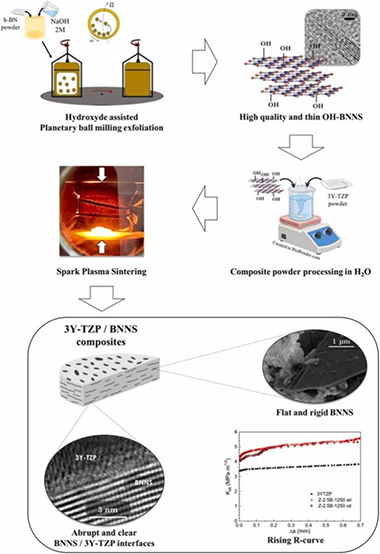
This paper deals with the effect of hydroxylated boron nitride nanosheets (BNNS) incorporation on the microstructural and mechanical features of zirconia ceramics. Few-layered BNNS were synthesized via a simple hydroxide-assisted planetary ball milling exfoliation technique. 3 mol% yttria tetragonal zirconia polycrystal (3Y-TZP) with 2.5 vol% BNNS powders were prepared by an environmentally friendly process in water, and spark-plasma sintered at three temperatures to explore the in-situ reduction of the functionalized BNNS. An exhaustive study by (S)TEM techniques was performed to elucidate the influence of the sintering temperature on the matrix and the 3Y-TZP/BNNS interfaces, revealing that BNNS were homogeneously distributed throughout the matrix with an abrupt transition at 3Y-TZP/BNNS interfaces. BNNS effectively hindered slow crack growth, thus increasing the composite's crack growth resistance by about 30 %. A 1 MPa·m1/2 rising R-curve was also induced by crack bridging.
Agosto, 2024 | DOI: 10.1016/j.jeurceramsoc.2024.02.002
Reactividad de Sólidos
On the athermal origin of flash sintering: Separating field-induced effects from Joule heating using a current ramp approach
Molina-Molina, S; Perejón, A; Pérez-Maqueda, LA; Sánchez-Jiménez, PEScripta Materialia, 247 (2024) 116086

Joule heating is generally acknowledged as the main driving force behind Flash Sintering. However, this view is challenged by the presence of athermal phenomena and the similarities between the flash process and dielectric breakdown. This work offers new insights into flash as an electrical runaway. Using current ramps to perform flash experiments on zinc oxide, two distinct stages within the process were revealed by electrical, thermal and microstructural measurements: a field-dominated regime where the flash event is triggered and a subsequent current-dominated regime associated with power dissipation. The contribution of each regime to the whole flash process was found to be determined by the initial resistivity of the sample. Furthermore, impedance spectroscopy data confirmed field-induced enhancement of conductivity at the flash-onset without significant Joule heating.
Julio, 2024 | DOI: 10.1016/j.scriptamat.2024.116086
Reactividad de Sólidos
In situ study on enhanced plastic deformability of Lanthanum-doped Bismuth ferrite processed by flash sintering
Yang, B; Sánchez-Jiménez, PE; Niu, TJ; Sun, TY; Shang, ZX; Cho, J; Perejón, A; Shen, C; Pérez-Maqueda, LA; Tsakalakos, T; Wang, HY; Zhang, XHJournal of the European Ceramic Society, 44 (2024) 3985-3994
BiFeO3 is a promising multiferroic material for versatile device applications due to its co-existence of magnetic (i.e., antiferromagnetic) and ferroelectric ordering at room temperature. While its functional properties have been extensively investigated, the exploration of its mechanical behavior was limited mostly to the thin-film form of BiFeO3. In this work, we conducted in situ micropillar compression experiments to investigate the deformation behavior of La-doped BiFeO3 (La-BFO) samples processed by both conventional and flash sintering methods. The conventionally sintered La-BFO exhibited limited deformability at room temperature and 450 degrees C. In contrast, the deformability of the flash-sintered La-BFO specimens was substantially improved by nearly 100% at both testing temperatures. Detailed post-mortem studies suggest that preexisting dislocations and wide anti-phase boundaries introduced during flash sintering can toughen flash-sintered La-BFO by easing dislocation migration and ferroelastic domain switching. This study provides a fresh perspective to design an advanced multifunctional system with improved mechanical properties.
Junio, 2024 | DOI: 10.1016/j.jeurceramsoc.2023.12.099
Reactividad de Sólidos
Ca-based materials derived from calcined cigarette butts for CO2 capture and thermochemical energy storage
Amghar, N; Moreno, V; Sánchez-Jiménez, PE; Perejón, A; Pérez-Maqueda, LAJournal of Environmental Sciences, 140 (2024) 230-241
Cigarette butts (CBs) are one of the most common types of litter in the world. Due to the toxic substances they contain, the waste generated poses a harmful risk to the environment, and therefore there is an urgent need for alternative solutions to landfill storage. Thus, this work presents a possible revalorization of this waste material, which implies interesting environmental benefits. CBs were used as sacrificial templates for the preparation of CaO-based materials by impregnation with calcium and magnesium nitrates followed by flaming combustion. These materials presented enhanced porosity for their use in the Calcium Looping process applied either to thermochemical energy storage or CO2 capture applications. The influence of the concentration of Ca and Mg in the impregnating solutions on the multicycle reactivity of the samples was studied. An improved multicycle performance was obtained in terms of conversion for both applications.
Junio, 2024 | DOI: 10.1016/j.jes.2023.07.028
Reactividad de Sólidos
Influence of graphene-based nanostructures processing routes and aspect ratio in flexural strength and fracture mechanisms of 3Y-TZP-matrix composites
Moriche, R; Guisado-Arenas, E; Muñoz-Ferreiro, C; López-Pernía, C; Morales-Rodríguez, A; Jiménez-Piqué, E; Gallardo-López, A; Poyato, RCeramics International, 50(11) (2024) 19217-19227
In this work, the influence of the aspect ratio of graphene-based nanostructures (GBNs) and content on the mechanical properties of 3 mol% yttria tetragonal zirconia polycrystalline 3Y-TZP matrix composites was analysed. The influence of the dispersion method and sintering parameters on the flexural strength and elastic modulus of the composites was studied, and the fracture surfaces were characterized to determine the fracture mechanisms that occur. The results showed that small amounts of exfoliated graphene nanoplatelets, with reduced lateral size, and few layer graphene, up to 1.0 and 2.5 vol%, respectively, slightly increase the 3Y-TZP flexural strength. This has been attributed to the tortuosity of the crack propagation pathways and strengthening mechanisms. Higher contents cause a decrease in flexural strength and stiffness because of overlapped GBNs, which can promote the crack propagation. The pull-out of GBN was more significant in composites with non-exfoliated graphene nanoplatelets, where no increase on the flexural or biaxial strength was measured.
Junio, 2024 | DOI: 10.1016/j.ceramint.2024.03.021
Reactividad de Sólidos
Sodium acetate-based thermochemical energy storage with low charging temperature and enhanced power density
Arcenegui-Troya, J; Lizana, J; Sánchez-Jiménez, PE; Perejón, A; Vañes-Vallejo, A; Pérez-Maqueda, LAJournal of Energy Storage, 86 (2024) 111310
The electrification of heat necessitates the development of innovative domestic heat batteries to effectively balance energy demand with renewable power supply. Thermochemical heat storage systems show great promise in supporting the electrification of heating, thanks to their high thermal energy storage density and minimal thermal losses. Among these systems, salt hydrate-based thermochemical systems are particularly appealing. However, they do suffer from slow hydration kinetics in the presence of steam, which limits the achievable power density. Additionally, their relatively high dehydration temperature hinders their application in supporting heating systems. Furthermore, there are still challenges regarding the appropriate thermodynamic, physical, kinetic, chemical, and economic requirements for implementing these systems in heating applications. This study analyzes a proposal for thermochemical energy storage based on the direct hydration of sodium acetate with liquid water. The proposed scheme satisfies numerous requirements for heating applications. By directly adding liquid water to the salt, an unprecedented power density of 5.96 W/g is achieved, nearly two orders of magnitude higher than previously reported for other salt-based systems that utilize steam. Albeit the reactivity drops as a consequence of deliquescence and particle aggregation, it has been shown that this deactivation can be effectively mitigated by incorporating 10 % silica, achieving lower but stable energy and power density values. Furthermore, unlike other salts studied previously, sodium acetate can be fully dehydrated at temperatures within the ideal range for electrified heating systems such as heat pumps (40 °C – 60 °C). The performance of the proposed scheme in terms of dehydration, hydration, and multicyclic behavior is determined through experimental analysis.
Mayo, 2024 | DOI: 10.1016/j.est.2024.111310
Reactividad de Sólidos
Al2O3/Y3Al5O12 (YAG)/ZrO2 composites by single-step powder synthesis and spark plasma sintering
Vakhshouri, M; Najafzadehkhoee, A; Talimian, A; López-Pernia, C; Poyato, R; Gallardo-López, A; Gutiérrez-Mora, F; Prnova, A; Galusek, DJournal of the European Ceramic Societ (2024)
Alumina-yttrium aluminum garnet (YAG)-zirconia composites are often produced by the melt solidification method. In the present study, we investigated the fabrication of α-Al2O3/Y3Al5O12 (YAG)/ZrO2 composite by Spark Plasma Sintering (SPS) of powders synthesized by Pechini’s sol-gel method. The ternary composites with homogenous microstructure and high density were produced by SPS at 1300 °C for 15 min. The addition of ZrO2 promoted the sintering of composites, resulting in a higher density and, in turn, higher hardness. A change in the indentation fracture behavior as the result of ZrO2 addition was observed.
Mayo, 2024 | DOI: 10.1016/j.jeurceramsoc.2024.05.004
Reactividad de Sólidos
Expanding the scope of multiphase-flash sintering: Multi-dogbone configurations and reactive processes
Manchón-Gordón, AF; Molina-Molina, S; Perejón, A; Alcalde-Conejo, A; Sánchez-Jiménez, PE; Pérez-Maqueda, LACeramics International, 50 (2024) 25210-25215
In this work, we have expanded the possibilities of the multiphase-flash sintering (MPFS) technique by investigating several configurations that involve multiple dogbone specimens (ranging from 1 to 3) and multiple phases (also ranging from 1 to 3). Unlike the traditional MPFS approach using complex 3D or cylindrical samples, this new method allows for a direct comparison with the established conventional flash sintering technique. Our experimental results with dense 8-mol% Yttria-stabilized zirconia demonstrate a significant reduction in the onset temperature as the number of phases and dogbones increases. Building on these findings, we achieved the preparation of pure bulk specimens of SrFe12O19 for the first time through reactive multiphase-flash sintering.
Mayo, 2024 | DOI: 10.1016/j.ceramint.2024.04.250
Reactividad de Sólidos
Flash Joule Heating-Boro/Carbothermal Reduction (FJH-BCTR): An approach for the instantaneous synthesis of transition metal diborides
Taibi, A; Gil-González, E; Sánchez-Jiménez, PE; Perejón, A; Pérez-Maqueda, LACeramics International (2024)
Transition metal diborides (TMB2), such as ZrB2 and HfB2, are a class of ultra-high-temperature ceramics (UHTCs) that have attracted considerable attention due to their performance in extreme environments. Their implementation is burdened by the high energetic requirement of traditional synthetic procedures. Here, we report a novel methodology, termed as Flash Joule Heating-Boro/Carbothermal Reduction (FJH-BCTR), for the instantaneous synthesis of phase-pure sub-micron powders of several TMB2 and composite within seconds and without any external source of heating. The immediate synthesis is attributed to the Joule heat generated by the current, enabling extremely fast heating and cooling rates and, therefore, avoiding excessive grain growth. The advantages of FJH-BCTR are thoroughly displayed and can be summarized as; highly efficient, it allows a dramatic drop in terms of energy and time; universal, several TMB2 and composite can be prepared; and flexible, different experimental parameters can be tuned to achieve the desired phase.
Mayo, 2024 | DOI: 10.1016/j.ceramint.2024.01.144
Reactividad de Sólidos
Complex TiC-Ni-based composites joined to steel support by thermal explosion under load: synthesis, microstructure and tribological behavior
Lemboub, S; Boadebane, A; Boudebane, S; Bourbia, A; Mezrag, S; Gotor, FJComposites Interfaces, 31(5) (2024) 537-557

The combustion in thermal explosion mode of reactive mixtures of Ti-Ni-graphite(carbides, borides, oxides), under load, was used to produce complex composite materials, densified and joined to a C55 carbon steel support. The ignition of the exothermic reaction, carried out thanks to the rapid high-frequency heating of a green compact up to 1573 K, was followed by an isothermal holding at 1373 K for 360 s. This procedure ensured a perfect mechanical assembly between the composite material and the steel substrate. SEM analysis and concentration profiles carried out at the interface testified to the interdiffusion of iron and titanium atoms between the two materials. The maximum combustion temperature (T-max.) exceeding 2200 K induced the appearance of a liquid phase that assisted densification and joining, and in which a part of the additions was dissolved before cooling. The starting chemical composition of reactive mixtures largely determined the microstructure, hardness and tribological behavior of the composites after the process. Thereby, the maximum hardness (1235 HV0.15) and the lowest wear rate (1.824 x 10(-6) mm(3).N-1.m(-1)) were obtained in the sample containing TiC, Al2O3 and TiB2 hard phases. The manufactured samples exhibit no deterioration of the composite by spalling, regardless of the starting composition.
Mayo, 2024 | DOI: 10.1080/09276440.2023.2268968
Reactividad de Sólidos
Ultraslow calorimetric studies of the martensitic transformation of NiFeGa alloys: detection and analysis of avalanche phenomena
Martín-Olalla, JM; Vidal-Crespo, A; Romero, FJ; Manchón-Gordón, A; Ipus, JJ; Blázquez, JS; Gallardo, MC; Conde, CFJournal of Thermal Analysis and Calorimetry, 149 (2024) 5165-5176
We study the thermal properties of a bulk Ni55Fe19Ga26 Heusler alloy in a conduction calorimeter. At slow heating and cooling rates (∼1Kh-1), we compare as-cast and annealed samples. We report a smaller thermal hysteresis after the thermal treatment due to the stabilization of the 14 M modulated structure in the martensite phase. In ultraslow experiments (40mKh-1), we detect and analyze the calorimetric avalanches associated with the direct and reverse martensitic transformation from cubic to 14 M phase. This reveals a distribution of events characterized by a power law with exponential cutoff p(u)∝u-εexp(-u/ξ) where ε∼2 and damping energies ξ=370μJ (direct) and ξ=27μJ (reverse) that characterize the asymmetry of the transformation.
Mayo, 2024 | DOI: 10.1007/s10973-024-13206-4
Reactividad de Sólidos
Magnesium calcites for CO2 capture and thermochemical energy storage using the calcium-looping process
Perejón, A; Arcenegui-Troya, J; Sánchez-Jiménez, PE; Diánez, MJ; Pérez-Maqueda, LAEnvironmental Research, 246 (2024) 118119
In this study, a precipitation-based synthesis method has been employed to prepare magnesium calcites with the general formula Ca1-xMgxCO3, with the objective of use them in the calcium looping (CaL) process for CO2 capture (CaL-CCS) and thermochemical energy storage (CaL-CSP). The structure and microstructure of the samples have been characterized. It has been found by X-ray diffraction that the samples with a Ca:Mg molar ratio of 0.5:0.5 and 0.55:0.45 are phase pure, while the samples with molar ratios of 0.7:0.3 and 0.8:0.2 are composed by two phases with different stoichiometry. In addition, the sample prepared with calcium alone shows the aragonite phase. The microstructure of the magnesium-containing samples is composed of nanocrystals, which are aggregated in spherical particles whereas the aragonite sample presents a typical rod-like morphology. The multicycle tests carried out under CaL-CCS conditions show that an increase on the MgO content in the calcined samples results in a reduced value of effective conversion when compared to aragonite. On the other hand, under CaL-CSP conditions, the samples with the higher MgO content exhibit nearly stable effective conversion values around 0.5 after 20 cycles, which improve the results obtained for aragonite and those reported for natural dolomite tested under the same conditions.
Abril, 2024 | DOI: 10.1016/j.envres.2024.118119
Materiales Avanzados
Preparation of Geopolymeric Materials from Industrial Kaolins, with Variable Kaolinite Content and Alkali Silicates Precursors
Martínez-Martínez, S; Bouguermouh, K; Bouzidi, N; Mahtout, L; Sánchez-Soto, PJ; Pérez-Villarejo, LMaterials, 17 (2024) 1839
In the present work, the development of geopolymeric materials with Na or K based on industrial kaolin samples, with variable kaolinite content and alkaline silicates, is studied. XRF, XRD, FTIR and SEM-EDS have been used as characterization techniques. Three ceramic kaolin samples, two from Algeria and one from Charente (France), have been considered. In particular, chemical and mineralogical characterization revealed elements distinct of Si and Al, and the content of pure kaolinite and secondary minerals. Metakaolinite was obtained by grinding and sieving raw kaolin at 80 mu m and then by thermal activation at 750 degrees C for 1 h. This metakaolinite has been used as a base raw material to obtain geopolymers, using for this purpose different formulations of alkaline silicates with NaOH or KOH and variable Si/K molar ratios. The formation of geopolymeric materials by hydroxylation and polycondensation characterized with different Si/Al molar ratios, depending on the original metakaolinite content, has been demonstrated. Sodium carbonates have been detected by XRD and FTIR, and confirmed by SEM-EDS, in two of these geopolymer materials being products of NaOH carbonation.
Abril, 2024 | DOI: 10.3390/ma17081839
Reactividad de Sólidos
A generalized interface reaction kinetic model for describing heterogeneous processes driven by contracting mechanisms
Arcenegui-Troya, J; Sánchez-Jiménez, PE; Rodríguez-Laguna, MR; Perejón, AJournal of Thermal Analysis and Calorimetry, 149(6) (2024) 2653-2663
The correct determination of the kinetic model and the kinetic parameters that describe a heterogeneous process is key to accurately predicting its progress within a wide range of conditions, which is one of the main purposes of kinetic analysis. Albeit ideal kinetic models continue to be used to gain insight about the process mechanism, they are constrained by certain assumptions that are rarely met in real experiments and limit their applicability. This is the case of contracting (or interface) kinetic models, which are one of the most commonly used. Thus, the ideal kinetic model R2 is derived by assuming a cylindrical contraction in the radial direction but not contemplating the possibility of a contraction in the direction of the axis of the cylinder. Moreover, in the case of the ideal model R3, it is assumed that contraction takes place simultaneously in particles of identical dimensions in all three directions of space (spheres or cubes). Here, it is revisited this type of model, and it is considered the contraction of particles with different geometries, namely cylinders with different aspect ratios and rectangular cuboids. Besides, a novel generalized interface reaction model is proposed, which covers all the studied cases and broadens the range of applicability to more complex situations involving different geometries and inhomogeneous particle sizes. Finally, the proposed model is applied to the analysis of the experimental thermal dissociation of ammonium nitrate, previously described in the literature as a sublimation process. It is proved that the novel kinetic model provides a more accurate description of the kinetics of the reaction and better prediction capabilities.
Marzo, 2024 | DOI: 10.1007/s10973-023-12835-5
Materiales Avanzados
Effect of olive-pruning fibres as reinforcements of alkali-activated cements based on electric arc furnace slag and biomass bottom ash
Gómez-Casero, MA; Sánchez-Soto, PJ; Castro, E; Eliche-Quesada, DArchives of Civil and Mechanical Engineering, 24(2) (2024) 84
In this work, alkali-activated composites using electric arc furnace slag (50 wt%) and biomass bottom ash (50 wt%) were manufactured, adding olive-pruning fibres as reinforcement. The objective of adding fibres is to improve the flexural strength of composites, as well as to prevent the expansion of cracks as a result of shrinkage. For this reason, composites reinforced with olive-pruning fibres (0.5-2 wt%) untreated and treated with three different solutions to improve matrix-fibre adhesion were manufactured. Treatments developed over fibres were a 10 wt% Na2SiO3 solution, 3 wt% CaCl2 solution and 5 wt% NaOH solution. Mechanical properties, physical properties, thermal properties and the microstructure of composites by Fourier transform infrared spectroscopy (FTIR), X-ray diffraction (XRD) and scanning electron microscopy (SEM) were studied to demonstrate the improvement. Alkaline treatment degraded fibre surface, increasing the matrix-fibre adhesion, and as a consequence, flexural strength increased up to 20% at 90 days of curing. Optimal results were obtained with composites reinforced with 1 wt% of olive-pruning fibre treated by a 10 wt% Na2SiO3 solution. Higher quantity of olive-pruning fibre leads to local agglomeration, which weakens the matrix-fibre adhesion. The effect on the compressive strength is less evident, since the addition of fibres produces an admissible decrease (between 0 and 9% using 0.5 or 1 wt% of fibres), except in composites that use olive pruning treated with 10 wt% Na2SiO3 solution, where values remain stable, similar or better to control paste. A greater ductility of the matrix in all composites was observed. Furthermore, the alkali-activated cement matrix was bonded to olive-pruning fibre better than untreated fibre, as it is shown in SEM images. Thus, the results showed that olive-pruning fibres could be used as reinforcement in the manufacturing of alkali-activated materials when they are treated with alkali solutions.
Marzo, 2024 | DOI: 10.1007/s43452-024-00882-0
Materiales Avanzados
Synthesis and characterization of porous and photocatalytic geopolymers based on natural clay: Enhanced properties and efficient Rhodamine B decomposition
Ettahiri, Y; Bouna, L: Brahim, A; Benlhachemi, A; Bakiz, B; Sánchez-Soto, PJ; Eliche-Quesada, D; Pérez-Villarejo, LApplied Materials Today, 36 (2024) 102048
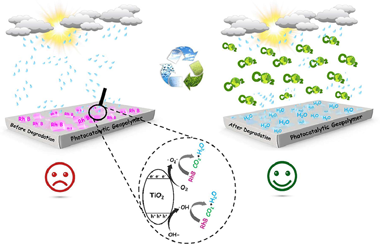
In this work, the incorporation of anatase TiO2 semiconductor in the geopolymer matrix as catalytic materials has been studied. The most noteworthy results obtained from the synthesis of a novel TiO2/geopolymer nanocomposite as an effective ecological catalyst with high thermal stability and significant porosity is presented. The porous and photocatalytic geopolymers based natural clay rich in pyrophyllite and kaolinite minerals were prepared by simple method, the geopolymerization reaction was able to successfully load TiO2 nanoparticles into the geopolymer surface. Furthermore, the results indicate that the prepared catalyst achieved the best performance to degrade Rhodamine B (RhB) molecules present in aqueous solution under UV light irradiation. The geopolymer matrix proved to be a reusable support for TiO2 nanoparticles during the photocatalytic process, efficiently facilitating the separation of photogenerated charges. Finally, the physicochemical and morphological properties of the samples was characterized by several techniques, namely X-ray Fluorescence (XRF), X-ray diffraction (XRD), Fourier Transform Infrared spectroscopy (FTIR), Thermogravimetric and Differential Thermal Analysis (TGA/DTA), N2 adsorption/desorption isotherm analysis (BET and BJH methods), UV–Vis Diffuse Reflectance Spectroscopy (DRS), Scanning Electron Microscopy (SEM) coupled to an Energy Dispersive X-ray Spectroscopy (EDS) analyzer and Transmission Electron Microscopy (TEM).
Febrero, 2024 | DOI: 10.1016/j.apmt.2023.102048
Fotocatálisis Heterogénea: Aplicaciones - Reactividad de Sólidos
Investigating the room- and cryo-milling impact in lignocellulosic biomass and its consequence over pyrolysis and oxidative treatments
Pérez, CR; González, MDA; Sarria, FR; López, MDH; Gallego, JMCJournal of Cleaner Production, 437 (2024) 140761
The lignocellulosic biomass recalcitrance is the uppermost factor for the utilization of this renewable resource. The development of new pre -treatments, addressed to enhance performance in lignocellulosic biomass conversion into biofuels, fine chemicals, and as potential sources of building blocks for materials, must be focus in two main areas: effectiveness (cost-effective and chemical effective) and green chemistry. In this research, a set of different biomass sources (farmer, harvested wild trees and secondary products) were studied to evaluate the high efficiency of the non -liquid nitrogen (LN) and LN-treated biomass samples' planetary ball milling performance. The samples have been characterized by particle size distribution, thermogravimetric, FT-IR, statistical chemometric and chemical oxidation analysis. The results have shown a high level on the rupture of the crystallinity and depolymerization degrees of the cellulose and the lignin, for both, non-LN and LN-treated samples. The thermogravimetric analysis showed a clear diminishing in temperature degradation, and a larger amount of biomass degraded at lower temperature, as well as, a high chemical oxidation degree than not milled samples. Finally, the LN-treated samples even exhibited a lower degradation temperature, a larger amount of biomass degraded at lower temperature and a higher oxidation degree, than those non-LN milled.
Enero, 2024 | DOI: 10.1016/j.jclepro.2024.140761
2023
2023
Reactividad de Sólidos
Efficient SrO-based thermochemical energy storage using a closed-loop pressure swing
Amghar, N; Sánchez-Jiménez, PE; Ortiz, C; Pérez-Maqueda, LA; Perejón, AApplied Thermal Engineering, 235 (2023) 121411
The SrCO3/SrO system has recently attracted interest for thermochemical energy storage due to the high energy densities potentially attainable. However, the high temperatures needed to promote calcination involve a sintering-induced deactivation of SrO to carbonation. In this work, SrO-based samples have been tested using a closed-loop pressure swing approach involving calcinations and carbonations at absolute pressures of 0.01 bar and 1 bar CO2, respectively. Using low CO2 absolute pressure for calcination decreases the reaction temperature to 900 degrees C, thus reducing the deactivation of SrO. Moreover, the use of additives further improves the reactivity of the samples. The addition of ZrO2 and MgO by mechanical mixing and acetic acid treatment, respectively, results in samples with very high multicycle performance, yielding material energy storage densities after twenty cycles above 5.0 GJ/m3. These results significantly improve those obtained for similar samples in which calcinations and carbonations were carried out at an absolute pressure of 1 bar CO2. Regarding the integration of the thermochemical energy storage into concentrating solar power plants, calcining SrO-based materials at low pressure increases the net thermal-to-electric efficiencies by up to 6 % points compared to CaO-based materials calcined at the same conditions. The importance of experimental conditions and precursors in the multicycle behaviour of SrO-based materials for thermochemical energy storage is emphasized.
Noviembre, 2023 | DOI: 10.1016/j.applthermaleng.2023.121411
Reactividad de Sólidos
Integration of calcium looping and calcium hydroxide thermochemical systems for energy storage and power production in concentrating solar power plants
Carro, A; Chacartegui, R; Ortiz, C; Arcenegui-Troya, J; Perez-Maqueda, LA; Becerra, JAEnergy, 283 (2023) 128388
Energy storage is a key factor in the development of renewables-based electrical power systems. In recent years, the thermochemical energy storage system based on calcium-looping has emerged as an alternative to molten salts for energy storage in high-temperature concentrated solar power plants. This technology still presents some challenges that could be solved by integrating the thermochemical energy storage system based on calcium hydroxide. This work studies a novel concentrated solar power system integrating calcium-looping and calcium hydroxide thermochemical energy storage systems. The results show that the combined use of hydration -dehydration cycles in the calcination-carbonation processes of the calcium looping for energy storage could partially solve the issue related to the multicyclic deactivation of calcium oxide. The improvement in the con-version of calcium oxide during carbonation is demonstrated experimentally when hydration-dehydration cycles are combined. Numerical simulations demonstrate the technical feasibility of the integrated process, with effi-ciencies ranging between 38-46%, improved with the increase in calcium oxide conversion in the carbonator, showing the potential of the proposed integration.
Noviembre, 2023 | DOI: 10.1016/j.energy.2023.128388
Reactividad de Sólidos
Metal- based eggshell particles prepared via successive incipient wetness impregnation method as a promoted sorbent for CO2 capturing in the calcium looping process
Imani, M; Tahmasebpoor, M; Sanchez-Jimenez, PEJournal of Environmental Chemical Engineering, 11 (2023) 110584

Cyclic adsorption by using of bio-waste eggshell particles as a cheap, accessible and environmentally friendly CaCO3 source has been considered as one of the important methods to decrease or remove CO2 from the flue gas. However, deactivation of eggshell particles and CO2 capture capacity decaying with increasing the cycle's number remained as an important challenge. Using metal nitrates as one of the modification methods has been proposed by the researchers to overcome this problem. Current study investigates the influence of three metal nitrates of Al, La and Mg added to the eggshell particles via successive incipient wetness impregnation (SIWI) method to improve their adsorption performance. The TGA results at the end of the 20th carbonation/calcination cycle revealed a meaningful relationship between CaO molar conversion of eggshell modified with metal nitrates and their crystallite size as well as the surface area of the sorbents, so that the smaller the crystal size and the larger the surface area, the higher the molar conversion of CaO could be achieved. Due to the highest conversion obtained for Mg-containing sample, the effect of different weight percentages of this additive was also investigated. Results showed that 5 wt% MgO contained eggshell particles could be reported as the most outstanding sample for its improved molar conversion, capture capacity at the end of 20th carbonation/calcination cycle and BET surface area, which were 30.18%, 0.23 gr CO2/gr adsorbent and 3.5 m2/g while the corresponding amounts for raw eggshell were 17.26%, 0.11 gr CO2/gr adsorbent and 1.63 m2/g, respectively.
Octubre, 2023 | DOI: 10.1016/j.jece.2023.110584
Reactividad de Sólidos
Negative emissions power plant based on flexible calcium-looping process integrated with renewables and methane production
Ortiz, C; García-Luna, S; Carro, A; Chacartegui, R; Pérez-Maqueda, LRenewable & Sustainable Energy Reviews, 185 (2023) 113614

This paper provides a review of negative carbon capture technologies. Based on these technologies, here it is proposed an innovative negative emissions power plant combining the generation and storage of energy from biomass, photovoltaic, and concentrated solar power, capturing and recovering CO2 by producing H2 or CH4 as green energy carriers. The main features of the system are i) large-scale energy production system with negative CO2 emissions; ii) 100% renewable system based on biomass and solar energy with the possibility of integrating other renewables; iii) synergistic integration of processes and systems; iv) recovery of O2 generated by photovoltaic-driven electrolysis within the process of partial biomass oxycombustion and v) solar-driven limestone calcination. A detailed model of the entire plant is developed to evaluate the integration of the process. The model performance is assessed on an hourly basis throughout the whole year. The base case results show an energy consumption from 1 to 2.1 MJ/kg CO2 to capture 60–77% of CO2 emitted from the biomass plant and green methane production of more than 7500 tons/year. The negative emissions associated with the process are -612 kg CO2/MWh. It justifies the interest in the proposed negative emissions power plant.
Octubre, 2023 | DOI: 10.1016/j.rser.2023.113614
Reactividad de Sólidos
Influence of Long-Term CaO Storage Conditions on the Calcium Looping Thermochemical Reactivity
Amghar, N; Perejón, A; Ortiz, C; Maqueda, LAP; Sánchez-Jiménez, PEEnergy & Fuels, 37 (2023) 16904-16914
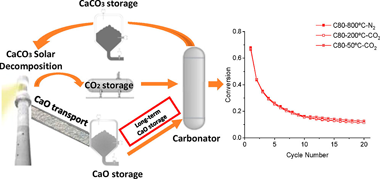
Long-term storage capability is often claimed as one of the distinct advantages of the calcium looping process as a potential thermochemical energy storage system for integration into solar power plants. However, the influence of storage conditions on the looping performance has seldom been evaluated experimentally. The storage conditions must be carefully considered as any potential carbonation at the CaO storage tank would reduce the energy released during the subsequent carbonation, thereby penalizing the round-trip efficiency. From lab-scale to conceptual process engineering, this work considers the effects of storing solids at low temperatures (50–200 °C) in a CO2 atmosphere or at high temperatures (800 °C) in N2. Experimental results show that carbonation at temperatures below 200 °C is limited; thus, the solids could be stored during long times even in CO2. It is also demonstrated at the lab scale that the multicycle performance is not substantially altered by storing the solids at low temperatures (under CO2) or high temperatures (N2 atmosphere). From an overall process perspective, keeping solids at high temperatures leads to easier heat integration, a better plant efficiency (+2–4%), and a significantly higher energy density (+40–62%) than considering low-temperature storage. The smooth difference in the overall plant efficiency with the temperature suggests a proper long-term energy storage performance if adequate energy integration is carried out.
Octubre, 2023 | DOI: 10.1021/acs.energyfuels.3c02652
Fotocatálisis Heterogénea: Aplicaciones - Reactividad de Sólidos
Effect of Alkaline Salts on Pyrolyzed Solid Wastes in Used Edible Oils: An Attenuated Total Reflectance Analysis of Surface Compounds as a Function of the Temperature
Romero-Sarria, F; Real, C; Córdoba, JM; Hidalgo, C; Alcalá, MDSpectroscopy Journal, 1 (2023) 98-110
Biochars obtained via the pyrolysis of biomass are very attractive materials from the point of view of their applications and play key roles in the current energy context. The characterization of these carbonaceous materials is crucial to determine their field of application. In this work, the pyrolysis of a non-conventional biomass (solid wastes in used edible oils) was investigated. The obtained biochars were characterized using conventional techniques (TG, XRD, and SEM-EDX), and a deep analysis via ATR-FTIR was performed. This spectroscopic technique, which is a rapid and powerful tool that is well adapted to study carbon-based materials, was employed to determine the effect of temperature on the nature of functional groups on the surface. Moreover, the water washing of the raw sample (containing important quantities of inorganic salts) before pyrolysis evidenced that the inorganic salts act as catalysts in the biomass degradation and influence the degree of condensation (DOC) of PAH. Moreover, it was observed that these salts contribute to the retention of oxygenated compounds on the surface of the solid.
Septiembre, 2023 | DOI: 10.3390/spectroscj1020009
Reactividad de Sólidos
Touch-free reactive flash sintering of dense strontium hexaferrite permanent magnet
Jalali, SIA; Manchon-Gordon, AF; Chacartegui, R; Sanchez-Jimenez, PE; Blazquez, JS; Perejon, A; Raj, R; Pérez-Maqueda, LAJournal of the American Ceramic Society (2023)
This work presents an extension of the touch-free flash sintering technique. In the proposed technique, chemical reaction and sintering occur in a single step, without the use of electrodes, in the presence of electric and magnetic fields. We show that a dense, single-phase strontium hexaferrite magnet can be produced from a mixture of commercial carbonate and oxide powders in a single step in a little more than a minute. This new technique implies significant reduction in energy and time consumption (primarily because of ultrafast processing) relative to conventional sintering.
Agosto, 2023 | DOI: 10.1111/jace.19389
Reactividad de Sólidos
Thermochemical energy storage using calcium magnesium acetates under low CO2 pressure conditions
Amghar, N; Jimenez, PES; Maqueda, LAP; Perejon, AJournal of Energy Storage, 63 (2023) 106958
The calcium looping multicycle performance of CaO-based materials, derived from calcium magnesium acetates with different Mg content were tested under experimental conditions compatible with thermochemical energy storage. In order to reduce the sintering-induced decay in performance, calcination at an absolute CO2 pressure of 0.1 bar and 0.01 bar is implemented. CaO carbonation is performed at standard 1 bar CO2 conditions. The samples can be fully calcined in short residence times. Samples with MgO present high cycling stability, even when the MgO content is as low as 5 mol%. The effective conversion values lie within the range 0.88-0.84 over ten calcination/carbonation cycles, which provides an accumulated energy storage density of 90.9 GJ/m3. This outstanding reactivity is related with the microstructure of the sample after calcination composed of CaO nanoparticles that are highly reactive for carbonation.
Julio, 2023 | DOI: 10.1016/j.est.2023.106958
Materiales Avanzados
Influence of firing temperature on the ceramic properties of illite-chlorite-calcitic clays
Martinez-Martinez, S; Perez-Vilarejo, L; Garzon, E; Sanchez-Soto, PJCeramics International, 49 (2023) 24541-24557
The influence of firing temperature on the ceramic properties of illite-chlorite-calcitic clays has been investigated. Three samples of the same clay deposit have been selected. Weight loss, dimensional changes, water absorption, bulk density, open porosity, flexural and compressive strengths, initial capillary water absorption rate and thermal conductivity have been determined as a function of firing temperature in the range 900-1200 degrees C with 1 h of soaking time. The microstructures of the fired samples have been examined by SEM and the phase evolution studied by XRD. The water absorption capacity decreased from similar to 22% at 900 degrees C/1 h to a maximum of 12% at 1200 degrees C/1 h with a maximum linear shrinkage of similar to 2.7%. The open porosities decreased from similar to 22% at 900 degrees C/1 h up to similar to 20% at 1200 degrees C/1 h as an effect of progressive sintering with higher densification degree of the ceramic bodies. The flexural strength reached a maximum value of similar to 34 MPa at 1200 degrees C/1 h. In contrast, the compressive strengths increased by firing up to a maximum of similar to 114 MPa at 1200 degrees C/1 h. The thermal conductivity increased slightly as increasing firing temperature with a maximum value of 0.582 W/m.K in samples fired at 1200 degrees C/1 h. The Ryshkevitch-Duckworth equation was applied and the results indicated that compressive strength is related linearly with open porosity. A linear correlation was found between thermal conductivity and open porosity. The microstructural evolution by SEM indicated that there is a change of the fired samples at 1100 degrees C as compared to SEM observations at 900 and 1000 degrees C. There is an increase of contacts between particles and layered structures associated to dehydroxylated clay minerals (illite and chlorite), quartz particles and pores developed by firing. At 1200 degrees C/1 h, the microstructures have changed associated to the higher degree of vitrification in the fired sample, with consolidation of the material, interparticle and neck contacts with formation of vitrified bridges. The formation of closed and large open pores of several sizes has been achieved by firing. Small particles were observed as a fine precipitation of crystals in the vitrified structures associated to anorthite, hematite and quartz relicts. This change in microstructure allowed deduce that the compressive strength increased upon firing, with maximum values of this ceramic property at 1200 degrees C. The ceramic bodies were more sintered by firing and the open porosity decreased progressively. Brickmaking is the main application of these fired illite-chlorite calcitic clays. These clays fired at 900-1100 degrees C, with 1 h of soaking time, could be applied in the fabrication of clay roofing tiles, tiles and even porous ceramic supports with small variations on shrinkage and porosity, good flexural strengths and high compressive strengths. Samples fired at higher temperatures, 1100 degrees C/1 h, could be applied as ceramic bricks showing a medium porosity (similar to 20%). They show almost the same bulk density when they are fired at lower temperatures (900 degrees C). Samples fired at higher temperatures (1150-1200 degrees C/1 h) could be applied as dark ceramic products. This investigation was interesting because a better knowledge of illite-chlorite-calcitic clays applied as ceramic raw materials has been achieved.
Julio, 2023 | DOI: 10.1016/j.ceramint.2022.11.077
Reactividad de Sólidos
Seville history insight through their construction mortars
Perez-Rodriguez, JL; Perez-Maqueda, LA; Franquelo, ML; Duran, AJournal of Thermal Analysis and Calorimetry, (2023)
Seville is intimately linked to its historic role and extensive cultural heritage. The city has been occupied by Romans, Arabs and Christians, who built important historical buildings. Roman (first-second centuries) and Arabic (eleventh century) buildings, medieval Shipyard (thirteenth century), San Isidoro and Santa Maria de las Cuevas monasteries (fifteenth century), Santa Maria de las Cuevas (fifteenth century modified in eighteenth century), El Salvador Church (eighteenth century), the Royal Ordnance building (eighteenth century) and Santa Angela de la Cruz convent (twentieth century) performed with lining mortars, and mortars used in building stones (City Hall and Marchena Gate), all of them located in Seville (Spain), have been studied. Ninety-four mortar samples (employed as structural, plaster, coating) originally used or applied in restoration processes have been collected to perform an archaeometry study. The ratio of CO2 mass loss to hydraulic water (H2O) mass loss, and the mineralogical characterization by X-ray diffraction has been used to compare the mortars used in the different historical periods. Mainly hydraulic mortars were widely used in all these studied monuments as most mortars showed CO2/H2O ratios within the 4-10 range. Moreover, the thermal analysis curves also showed a broad temperature range for the thermal decomposition of the carbonate fraction of the mortars.
Julio, 2023 | DOI: 10.1007/s10973-023-12313-y
Reactividad de Sólidos
An overview of polymeric composite scaffolds with piezoelectric properties for improved bone regeneration
Donate, R; Paz, R; Moriche, R; Sayagués, MJ; Alemán-Domínguez, ME; Monzón, MMaterials & Design, 231 (2023) 112085
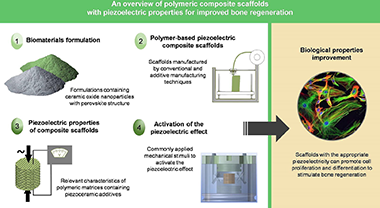
Despite the dramatic change that Tissue Engineering or stem cell therapies have brought to current therapeutic strategies, there is a lack of functionalities in the available biomaterials for manufacturing scaffolds to treat several highly prevalent osseous diseases (osteochondral defects, osteoporosis, etc.). One promising approach to fill this gap involves the development of innovative piezoelectric scaffolds for improved bone regeneration. Scaffolds with the appropriate piezoelectricity can positively influence the proliferation and differentiation of mesenchymal stem cells to regenerate bone tissue, since surface electrical charges play a key role in the mechanotransduction process. In this work, polymeric-based composite scaffolds with piezoelectric properties intended for bone tissue engineering are reviewed. Special attention is paid to biocompatible, piezoelectric polymers that show suitable properties to be pro-cessed by additive manufacturing techniques. Previous works on composite scaffolds based of these poly-meric matrices and containing piezoceramic additives are summarized. The use of piezoelectric nanostructured composite formulations containing lead-free ceramic oxide nanoparticles with per-ovskite structure is highlighted. Also, different commonly applied mechanical stimuli to activate the piezoelectric effect of the developed materials are presented. Finally, other applications of such scaffolds are mentioned, including their capabilities for real-time monitoring
Julio, 2023 | DOI: 10.1016/j.matdes.2023.112085 http://hdl.handle.net/10261/355426
Reactividad de Sólidos
R-curve evaluation of 3YTZP/graphene composites by indirect compliance method
Lopez-Pernia, C; Munoz-Ferreiro, C; Prada-Rodrigo, J; Moreno, P; Reveron, H; Chevalier, J; Morales-Rodriguez, A; Poyato, R; Gallardo-Lopez, AJournal of the European Ceramic Society, 43 (2022) 3486-3497
This work addresses the crack growth resistance of 3 mol% Yttria-doped Tetragonal Zirconia Polycrystalline (3YTZP) spark-plasma sintered (SPS) composites containing two types of graphene-based nanomaterials (GBN): exfoliated graphene nanoplatelets (e-GNP) and reduced graphene oxide (rGO). The crack growth resistance of the composites is assessed by means of their R-Curve behavior determined by three-point bending tests on single edge "V" notched beams (SEVNB), in two different orientations of the samples: with the crack path perpendicular or parallel to the pressure axis during the SPS sintering. The sharp edge notches were machined by ultrashort laser pulsed ablation (UPLA). The compliance and optical-based methods for evaluating the crack length are compared on the basis of the experimental R-Curve results in composites with 2.5 vol% rGO tested in the perpendicular orientation. Moreover, the activation of reinforcement mechanisms is evaluated by both the fracture surface inspection by Scanning Electron Microscopy and a compliance analysis. It is shown that the indirect compliance method is relevant and reliable for calculating the R-Curve of 3YTZP/GBN composites. The effect of the type and content of GBN on the crack growth resistance of the composites is also discussed.
Julio, 2023 | DOI: 10.1016/j.jeurceramsoc.2023.02.002
Reactividad de Sólidos
A practical analysis for decelerated growth processes to get physically meaningful kinetic parameters from classical nucleation and growth theory despite of overgrowth
Blazquez, JS; Caballero-Flores, R; Manchon-Gordon, AF; Borrego, JM; Conde, CFJournal of Non-Crystalline Solids, 610 (2023) 122305
We have analyzed the overgrowth problem arising in decelerated growth processes of spherical crystals in the frame of classical nucleation and growth theory developed by Kolmogorov, Johnson and Mehl, and Avrami (KJMA). To do that, simulations of decelerated growth transformations with a constant nucleation rate have been performed, changing the linear growth rate of spherically shaped nuclei from null (instantaneous growth rate) to constant (characteristic of interface controlled growth processes). We propose the determination of the actual kinetic parameters through the analysis of the inflection point of time evolution of transformed fraction. The correlations found between the effective kinetic parameters from direct KJMA analysis and the actual ones make it possible obtaining physically meaningful parameters. The proposed analysis has been applied to the nano-crystallization of amorphous FINEMET-type compositions.
Junio, 2023 | DOI: 10.1016/j.jnoncrysol.2023.122305 http://hdl.handle.net/10261/356185
Reactividad de Sólidos
Partial oxycombustion-calcium looping hybridisation for CO2 capture in waste-to-energy power plants
Ortiz, C; García-Luna, S; Chacartegui, R; Valverde, JM; Pérez-Maqueda, LJournal of Cleaner Production, 403 (2023) 136776
Integrating bioenergy and carbon capture and storage (BECCS) presents a great opportunity for power produc-tion with negative global CO2 emissions. This work explores a novel synergetic system that integrates mem-branes, partial biomass oxycombustion and the calcium looping (CaL) process. Polymeric membranes generate oxygen-enriched air (OEA) with an O2 concentration of 39%v/v, which is used for partial oxycombustion of biomass waste. The CO2-enriched flue gas evolves from the waste-to-energy plant to the CaL unit, where CO2 concentration is increased up to 90-95%v/v, ready for purification and sequestration. Compared to only oxy-combustion systems, the proposed concept presents fewer technological challenges in retrofitting boilers to waste-to-energy plants. Moreover, this new approach is highly efficient as integrating membranes to produce OEA instead of cryogenic distillation systems significantly reduces energy consumption. A novel integration concept is modelled to evaluate the whole process efficiency and the effect of key parameters on the system performance, such as the temperature of the reactors, the membrane surface area, and the partial oxy-combustion degree. The results show that the so-called mOxy-CaL system has an energy consumption associ-ated with CO2 capture below 4 MJ/kg CO2 (a 31% lower than that for a conventional CaL process), with a higher CO2 capture efficiency than oxycombustion and the CaL process separately. On the other hand, the economic analysis shows a higher CO2 capture cost for the novel configuration than for the typical CaL configuration due to the additional investment cost of the membrane system. Improvements in membrane performance by increasing its permeance and diminishing the required surface area would significantly reduce the economic cost of this novel integration. Using membranes with permeance over 400 GPU would boost the system's competitiveness.
Junio, 2023 | DOI: 10.1016/j.jclepro.2023.136776
Reactividad de Sólidos
Reversibility and thermal dependence of the martensitic transformation in a melt-spun Ni55Fe17Ga26Co2 Heusler alloy
Manchon-Gordon, AF; Vidal-Crespo, A; Blazquez, JS; Kowalczyk, M; Ipus, JJ; Kulik, T; Conde, CFJournal of Alloys and Compounds, 946 (2023) 169484
An almost single phase 14 M modulated martensite is obtained in melt spun ribbon of Ni55Fe17Ga26Co2 Heusler alloy. The effect of thermal treatments on the stability of the reverse martensitic transformation from 14 M modulated martensite to austenite phase in this system has been investigated by both non -isothermal and isothermal treatments. Heating above martensitic transformation promotes a continuous reduction of the martensitic transformation temperature, which stabilizes the austenite phase at room temperature and induces the precipitation of the gamma phase. However, thermal treatments at tem-peratures between the austenite start and finish temperatures induce the decoupling of the austenite formation in a subsequent heating. The two successive reverse martensitic transformations could be as-cribed to the untransformed martensite in the previous interrupted heating and to the new martensite formed during cooling.
Junio, 2023 | DOI: 10.1016/j.jallcom.2023.169484
Reactividad de Sólidos
Effect of thermal treatments below devitrification temperature on the magnetic and magnetocaloric properties in mechanically alloyed Fe70Zr30 powders
Manchon-Gordon, AF; Blazquez, JS; Kowalczyk, M; Ipus, JJ; Kulik, T; Conde, CFJournal of Non-Crystalline Solids, 609 (2023) 122267
In this work, the relaxation of the amorphous structure of mechanically alloyed Fe70Zr30 powders has been analyzed through interrupted heating ramps below the devitrification temperature. As a result of such thermal treatment, Curie temperature and temperature at maximum magnetic entropy change curves shift to higher temperatures as the temperature of heating treatment increases. This effect can be attributed to both the release of the stress accumulated in the amorphous powder during the milling process and to the initiation of nucleation of alpha-Fe crystallites, as it has been shown by Mo center dot ssbauer spectroscopy.
Junio, 2023 | DOI: 10.1016/j.jnoncrysol.2023.122267
Reactividad de Sólidos
Limits of powder metallurgy to fabricate porous Ti35Nb7Zr5Ta samples for cortical bone replacements
Rodriguez-Albelo, LM; Navarro, P; Gotor, FJ; de la Rosa, JE; Mena, D; Garcia-Garcia, FJ; Beltran, AM; Alcudia, A; Torres, YJournal of Materials Research and Technology-JMR&T, 24 (2023) 6212-6226
The use of 13-Titanium alloys to fabricate metal implants with Young's modulus that re-sembles bone tissues is presented as an alternative to commercially pure titanium or a- Titanium alloys, although it is still necessary to introduce proper implant porosity to reach the Young's modulus of cortical bones. In this work, porous samples were fabricated by loose sintering (0 MPa) and compared to samples manufactured at 1000 MPa, both sintered under the same conditions. Raw powders and sintered samples of the 13-Titanium alloy, Ti35Nb7Zr5Ta, were characterized in detail in terms of both physicochemical and micro-structural properties. Moreover, the tribo-mechanical behavior of sintered samples was evaluated by performing ultrasound technique, instrumented micro-indentation (P-h curves), and scratch tests. The bio-functional behavior was studied by impedance spec-troscopy and contact angle measurements. The results allowed the evaluation of the limits of conventional powder metallurgy (percentage of porosity, size, and morphology of pores), as well as the influence of the porosity and chemical composition to achieve a better biomechanical and bio-functional behavior that would guarantee bone requirements. The Ti35Nb7Zr5Ta alloy showed relatively high electrical impedance values compared to commercially pure titanium, indicating an improved bio-corrosion behavior. Furthermore, wettability measurements indicated that porous disks fabricated by loose sintering exhibit higher hydrophilicity, often associated with a better antibacterial response
Mayo, 2023 | DOI: 10.1016/j.jmrt.2023.04.212
Reactividad de Sólidos
Influence of AC fields and electrical conduction mechanisms on the flash-onset temperature: Electronic (BiFeO3) vs. ionic conductors (8YSZ)
Molina-Molina, S; Perejón, A; Pérez-Maqueda, LA; Sánchez-Jiménez, PECeramics International, 49 (2023) 14834-14843
This work aims to clarify the influence of AC (up to 50 kHz) vs DC fields on the flash-onset temperature, emphasizing the role of the electrical conduction mechanism. BiFeO3 (BFO) is used as an example of electronic conductor while 8-mol % Yttria-stabilized zirconia (8YSZ) is used as an example of ionic conductor. For 8YSZ, a frequency dependence of the flash-onset temperature and flash-induced heating is observed. This is consistent with the different contributions found in the total electrical response of 8YSZ as characterized by impedance spectroscopy measurements. Estimations based on the blackbody radiation model suggest that 8YSZ samples attain higher temperatures under AC fields due to a more efficient heating. Moreover, a noticeable decrease in the activation energy for the electrical conduction after the flash is triggered is attributed to electronic conduction. Meanwhile, the lack of frequency response and insensitiveness to the type of electrical field found in the case of BFO can be attributed to its mainly electronic bulk conduction.
Mayo, 2023 | DOI: 10.1016/j.ceramint.2022.06.242
Reactividad de Sólidos
Direct comparison of surface crystal growth kinetics in chalcogenide glass measured by microscopy and DSC
Shanelova, J; Honcova, P; Malek, J; Perejon, A; Perez-Maqueda, LAJournal of the American Ceramic Society, 106 (2023) 6051-6061
Surface crystallization in fine powder Se70Te30 chalcogenide glass was studied by differential scanning calorimetry (DSC) and optical microscopy. A complex kinetic analysis of these experimental data reveals that the contracting sphere mechanism (R3 model) is the rate determining step of crystal growth, and the conventional Johnson-Mehl-Avrami-Kolmogorov model cannot be used in this case. Moreover, it is clearly shown that the particle size distribution should be considered in crystallization studies. Actually, when the particle size effect is taken into account, the simulated DSC curves for the R3 model agree very well with the experimental data over the entire temperature range. The crystallization kinetics determined from the nonisothermal DSC data are consistent with previously reported isothermal crystallization data for the same powder fraction. The crystal growth rate calculated from isothermal and nonisothermal DSC data agrees very well with the microscopically measured surface and bulk crystal growth rate.
Mayo, 2023 | DOI: 10.1111/jace.19204
Materiales Avanzados
Characterization, thermal and ceramic properties of clays from Alhabia (Almeria, Spain)
Rat, E; Martinez-Martinez, S; Sanchez-Garrido, JA; Perez-Vilargejo, L; Garzon, E; Sanchez-Soto, PJCeramics International, 49 (2023) 14814-14825
Clays from Alhabia (Almeria, Spain) have been investigated in this work using several analytical techniques: X-Ray Diffraction (XRD), X-Ray Fluorescence (XRF), thermal analysis (Thermogravimetry, TG, and its first deriv-ative, DTG), Scanning Electron Microscopy (SEM) and Energy Dispersive X-Ray Spectroscopy (EDS). Texture characteristics (granulometry) and plasticity have been examined. The main ceramic properties (firing shrinkage, water absorption, bulk density, open porosity, flexural strength and thermal conductivity) have been determined using pressed and fired clay samples. Thus, the mineralogical, chemical, textural and ceramic features of these clays have been evidenced for the first time. The mineralogical analysis by XRD indicated that the clay samples are constituted by a mixture of chlorite and illite, as main clay minerals, being quartz and other minerals in lower relative proportion (calcite, gypsum and hematite). This finding is important because the investigations on chlorite-illite-calcitic clays are very scarce. The chemical analysis by XRF showed that silica and alumina are predominant, as expected by the mineralogy, with medium contents of calcium oxide, from calcite, and alkalis, from illite, being-8 and-5%, respectively, besides iron and titanium oxides (-8%). The particle size analysis showed 71.76% of "clay fraction" (<2 mu m) and 21.66% of silt fraction (2-50 mu m). The plasticity index (Atterberg) was 14.3%, with acceptable moulding and extrusion properties. Thermal analysis by TG/DTG indicated a weight loss associated to dehydroxylation of structural water of the clay minerals and decarbonation of calcite by progressive heating. After the characterization of raw clays, the next step was the determination of ceramic properties of mixed and ground clays after firing using pressed bodies. For this purpose, two firing temperatures were selected (900 and 1100 degrees C) for 1 h. The examination of the resultant fired bodies indicated that porous ceramic materials (-36% open porosity and-22% of water absorption capacity) can be obtained by firing at 900 degrees C, with small variations in dimensions (<0.8% at 1100 degrees C). The porosity changed at relatively lower values by firing at 1100 degrees C (-34-35%), being associated to the presence of decomposed calcite. Bulk density was found almost constant from 900 to 1100 degrees C, with a maximum value of-1.67 g/cm3 at 1100 degrees C. Flexural strength reached a maximum value of 34.47 MPa at 1100 degrees C for the ground sample. Finally, thermal conductivity after firing the clay bodies was found almost constant at 900 and 1100 degrees C (0.457 and 0.479 W/mK, respectively). Taking into account these results, the main applications of the Alhabia clays have been evaluated. These clays can be used for the fabrication of porous ceramic supports and tiles by firing at 900 degrees C. Firing the clays at higher temperature (1100 degrees C) is of great interest for the fabrication of ceramic tiles and ceramic bricks of higher flexural strength with variable porosity and practically constant in dimensions. It is economically important although at higher processing costs. Finally, it can be emphasized that this work is a contribution of a better scientific knowledge of chlorite-illite-calcitic clays as ceramic raw materials.
Mayo, 2023 | DOI: 10.1016/j.ceramint.2022.05.328
Reactividad de Sólidos
Electrical performance of orthotropic and isotropic 3YTZP composites with graphene fillers
Lopez-Pernia, C; Muñoz-Ferreiro, C; Moriche, R; Morales-Rodriguez, A; Gallardo-Lopez, A; Poyato, RJournal of The European Ceramic Society, 43 (2023) 1605-1612
3 mol% yttria tetragonal zirconia polycrystal (3YTZP) composites with orthotropic or isotropic microstructures were obtained incorporating few layer graphene (FLG) or exfoliated graphene nanoplatelets (e-GNP) as fillers. Electrical conductivity was studied in a wide range of contents in two configurations: perpendicular (sigma(perpendicular to)) and parallel (sigma(//)) to the pressing axis during spark plasma sintering (SPS). Isotropic e-GNP composites presented excellent electrical conductivity for high e-GNP contents (sigma(perpendicular to)similar to 3200 S/m and sigma(//) similar to 1900 S/m for 20 vol% e-GNP), consequence of their misoriented distribution throughout the matrix. Optimum electrical performance was achieved in the highly anisotropic FLG composites, with high electrical conductivity for low contents (sigma(perpendicular to) similar to 680 S/m for 5 vol%), percolation threshold below 2.5 vol% FLG and outstanding electrical conductivity for high contents (sigma(perpendicular to) similar to 4000 S/m for 20 vol%), result of the high aspect ratio and low thickness of FLG.
Abril, 2023 | DOI: 10.1016/j.jeurceramsoc.2022.11.068
Reactividad de Sólidos
Large-scale oxygen-enriched air (OEA) production from polymeric membranes for partial oxycombustion processes
Garcia-Luna, S; Ortiz, C; Chacartegui, R; Perez-Maqueda, LAEnergy, 268 (2023) 126697
Partial oxycombustion using Oxygen-Enriched Air (OEA), produced by air-gas separation with polymeric membranes, combined synergistically with CO2 capture technologies, can reduce the overall energy cost of CO2 capture, and it is a potential alternative to conventional CO2 capture technologies. An exhaustive review of polymeric membranes for this application is presented. The best membranes showed permeability values in the 450-25,100 barrer and selectivities higher than 3.6 for large-scale operations. These membranes can produce OEA with oxygen molar concentrations of up to 40% for retrofitting large-scale power plants (similar to 500 MWe) with partial oxycombustion. For OEA production, the polymeric membrane system is more efficient than cryogenic distillation since the specific power consumption of the former is 35.17 kWh/ton OEA. In comparison, that of the latter is 49.57 kWh/ton OEA. This work proposes that the OEA produced by the membranes feed a partial oxycombustion process integrated with calcium looping within a hybrid CO2 capture system. The power con-sumption of the hybrid CO2 capture system proposed here is 29.05% lower than in the case OEA is produced from cryogenic distillation, which justifies the potential interest in using polymeric membranes for OEA production.
Abril, 2023 | DOI: 10.1016/j.energy.2023.126697
Reactividad de Sólidos
Flexible Kinetic Model Determination of Reactions in Materials under Isothermal Conditions
Arcenegui-Troya, J; Perejón, A; Sánchez-Jiménez, PE; Pérez-Maqueda, LAMaterials, 16 (2023) 1851
Kinetic analysis remains a powerful tool for studying a large variety of reactions, which lies at the core of material science and industry. It aims at obtaining the kinetic parameters and model that best describe a given process and using that information to make reliable predictions in a wide range of conditions. Nonetheless, kinetic analysis often relies on mathematical models derived assuming ideal conditions that are not necessarily met in real processes. The existence of nonideal conditions causes large modifications to the functional form of kinetic models. Therefore, in many cases, experimental data hardly obey any of these ideal models. In this work, we present a novel method for the analysis of integral data obtained under isothermal conditions without any type of assumption about the kinetic model. The method is valid both for processes that follow and for those that do not follow ideal kinetic models. It consists of using a general kinetic equation to find the functional form of the kinetic model via numerical integration and optimization. The procedure has been tested both with simulated data affected by nonuniform particle size and experimental data corresponding to the pyrolysis of ethylene-propylene-diene.
Febrero, 2023 | DOI: 10.3390/ma16051851
Reactividad de Sólidos
Structural, Vibrational, and Magnetic Characterization of Orthoferrite LaFeO3 Ceramic Prepared by Reaction Flash Sintering
Manchon-Gordon, AF; Sanchez-Jimenez, PE; Blazquez, JS; Perejon, A; Perez-Maqueda, LAMaterials, 16 (2023) 1019
LaFeO3 perovskite ceramics have been prepared via reaction flash technique using Fe2O3 and La2O3 as precursors. The obtained pellets have been investigated using several techniques. The formation of LaFeO3 has been clearly confirmed by X-ray diffraction. The scanning electron microscopy micrographs have shown the microporous character of the obtained pellets due to the low temperature and dwell time used in the synthesis process (10 min at 1173 K). The orthorhombic-rhombohedral phase transition has been observed at approximately 1273 K in differential thermal analysis measurements, which also allows us to determine the Neel temperature at 742 K. The fitted Mossbauer spectra exposed the presence of a single sextet ascribed to the Fe+3 ions in the tetrahedral site. Finally, magnetic measurements at room temperature indicate the antiferromagnetic character of the sample.
Febrero, 2023 | DOI: 10.3390/ma16031019
Materiales Avanzados
Effect of L-Glutamic Acid on the Composition and Morphology of Nanostructured Calcium Phosphate as Biomaterial
Takabait, F; Martinez-Martinez, S; Mahtout, L; Graba, Z; Sanchez-Soto, PJ; Perez-Villarejo, LMaterials, 16 (2023) 1262
Calcium phosphate (CaP) with several chemical compositions and morphologies was prepared by precipitation using aqueous solutions of L-Glutamic acid (H(2)G) and calcium hydroxide, both mixed together with an aqueous solution (0.15 M) of phosphoric acid. Plate-shaped dicalcium phosphate dihydrate (brushite) particles were obtained and identified at a lower concentration of the solution of the reactants. The Ca/P ratio deduced by EDS was similar to 1, as expected. The nanoscale dimension of carbonate apatite and amorphous calcium phosphate, with variable Ca/P ratios, were revealed by X-ray diffraction (XRD) and scanning electron microscopy and energy dispersive X-ray spectroscopy analysis (SEM-EDS). They were characterized in medium and high concentrations of calcium hydroxide (0.15 M and 0.20 M). The equilibria involved in all the reactions in aqueous solution were determined. The thermodynamic calculations showed a decrease in the amount of chelate complexes with an increase in pH, being the opposite of [CaPO4-] and [CaHG(+)]. This fluctuation showed an evident influence on the morphology and polymorphism of CaP particles obtained under the present experimental conditions, with potential use as a biomaterial.
Febrero, 2023 | DOI: 10.3390/ma16031262
Reactividad de Sólidos
Determination of the activation energy under isothermal conditions: revisited
Arcenegui-Troya, J; Sanchez-Jimenez, PE; Perejon, A; Perez-Maqueda, LAJournal of Thermal Analysis and Calorimetry, 148 (2023) 1679-1686
The kinetic analysis of solid-state processes aims at obtaining fundamental information that can be used for predicting the time evolution of a process within a wide range of conditions. It is an extended belief that the determination of the kinetic parameters from the analysis of curves recorded under isothermal conditions is strongly conditioned by the kinetic model used to fit the experimental data. Thus, much effort is devoted to finding the model that truly describes a process in order to calculate the kinetic parameters with accuracy. In this work, we demonstrate that the value of activation energy determined from kinetic analysis of isothermal curves is independent of the kinetic model used to fit the experimental data and, taking advantage of the underlying reason for this, a method for determining the activation energy with two isothermal curves is proposed.
Febrero, 2023 | DOI: 10.1007/s10973-022-11728-3
Materiales Avanzados
Sintering behaviour of a clay containing pyrophyllite, sericite and kaolinite as ceramic raw materials: Looking for the optimum firing conditions
Sanchez-Soto, PJ; Garzon, E; Perez-Villarejo, L; Eliche-Quesada, DBoletin de la Sociedad Española de Ceramica y Vidrio, 62 (2023) 26-39
The sintering behaviour of a pyrophyllite clay has been investigated. The mineralogical composition by X-ray diffraction (XRD) of this sample was -35 wt.% pyrophyllite, -25 wt.% sericite/illite, -15 wt.% kaolinite and -20 wt.% quartz. The chemical composition was consistent with these results, with a total flux content of 4.18 wt.%. Prismatic bars were prepared by dry pressing using this sample and fired in the range 800-1500 degrees C with 0.5-5 h of soaking times. Sintering diagrams were obtained using the results of linear firing shrinkage, water absorption capacity, bulk density and apparent porosity determined in the ceramic bodies as a function of firing temperatures. It was found a trend of slight variations of bulk density values firing in the range 1000-1150 degrees C, with marked decreases of these values for these bodies fired at 1200 degrees C and 1300 degrees C. The temperature of maximum bulk density was determined as -1200 degrees C and the vitrification temperature was -1300 degrees C where the apparent porosity becomes almost zero. The vitrification process of the pyrophyllite clay sample was investigated using a method previously described in the literature, which considered an Arrhenius approach under isothermal conditions and a first order kinetic. It was determined an activation energy (Ea) of -45 kJ/mol with a linear correlation coefficient of 0.998. The relative rates of vitrification were calculated. It was found that the contribution of vitrification due to the heating was relatively small compared to the vitrification during soaking. Mullite and quartz are forming the ceramic bodies besides a vitreous or glassy phase. The thermally treated pyrophyllite clay showed a dense network of rod-shaped and elongated needle-like crystals, being characteristic features of mullite as a dense felt. The vitrification rate equation, as deduced in this study by first time, can be a useful tool to estimate the optimum firing conditions of the pyrophyllite clays applied as ceramic raw materials.
Enero, 2023 | DOI: 10.1016/j.bsecv.2021.09.001
Reactividad de Sólidos
A novel, green, cost-effective and fluidizable SiO2-decorated calcium-based adsorbent recovered from eggshell waste for the CO2 capture process
Imani, M; Tahmasebpoor, M; Sanchez-Jim, P; Valverde, J; Garcia, VMSeparation and Purification Technology, 305 (2023) 122523
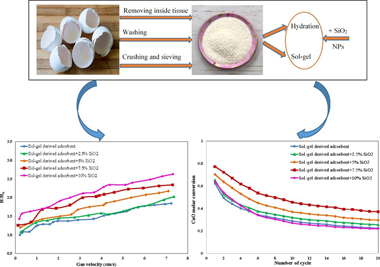
The reduction, storage, and reuse of greenhouse gas carbon dioxide (CO2) is a crucial concern in modern society. Bio-waste adsorbents have recently aroused the investigator's attention as auspicious materials for CO2 capture. However, the adsorption capacity decaying and poor fluidizability during carbonation/calcination cycles of all natural adsorbents used in the calcium-looping process (CaL) are important challenges. The current study ex-plores the performance of a novel SiO2-decorated calcium-based adsorbent recovered from eggshell waste in terms of both CO2 capture capacity and fluidity. Two preparation methods of hydration and sol-gel were used to obtain Ca-based adsorbents with different pore configurations and volumes. Modification of the adsorbents was applied by dry physically mixing with different weight percentages of hydrophobic SiO2 nanoparticles (NPs), in order to maintain stability and fluidity. The adsorbent prepared by the sol-gel method exhibited a fluffier structure with smaller grain sizes and higher porosity than that of prepared by the hydration method, leading to a 6.9 % increase in conversion at the end of the 20th cycle. Also, with the optimal amount of SiO2 nanoparticles, i. e. 7.5 wt%, the amount of CaO conversion obtained by sol-gel derived adsorbent was 27.59 % higher than that by pristine eggshell at the end of the 20th carbonation/calcination cycles. The fluidizability tests showed that the highest bed expansion ratio (2.29) was achieved for sol-gel derived adsorbent in the presence of 7.5 wt% silica nanoparticles which was considerably higher than the amount of 1.8 and 1.6 belonged to sol-gel derived adsorbent and pristine eggshell without silica at the gas velocity of approximate to 6.5 cm/s, respectively. The high adsorption capacity and proper fluidity of this novel and green calcium-based adsorbent promise its wide application.
Enero, 2023 | DOI: 10.1016/j.seppur.2022.122523 http://hdl.handle.net/10261/354722
Reactividad de Sólidos
Low Temperature Magnetic Transition of BiFeO3 Ceramics Sintered by Electric Field-Assisted Methods: Flash and Spark Plasma Sintering
Manchon-Gordon, AF; Perejon, A; Gil-Gonzalez, E; Kowalczyk, M; Sanchez-Jimenez, PE; Perez-Maqueda, LAMaterials, 16 (2023) 189
Low temperature magnetic properties of BiFeO3 powders sintered by flash and spark plasma sintering were studied. An anomaly observed in the magnetic measurements at 250 K proves the clear existence of a phase transition. This transformation, which becomes less well-defined as the grain sizes are reduced to nanometer scale, was described with regard to a magneto-elastic coupling. Furthermore, the samples exhibited enhanced ferromagnetic properties as compared with those of a pellet prepared by the conventional solid-state technique, with both a higher coercivity field and remnant magnetization, reaching a maximum value of 1.17 kOe and 8.5 10(-3) emu/g, respectively, for the specimen sintered by flash sintering, which possesses the smallest grains. The specimens also show more significant exchange bias, from 22 to 177 Oe for the specimen prepared by the solid-state method and flash sintering technique, respectively. The observed increase in this parameter is explained in terms of a stronger exchange interaction between ferromagnetic and antiferromagnetic grains in the case of the pellet sintered by flash sintering.
Enero, 2023 | DOI: 10.3390/ma16010189
Reactividad de Sólidos
Nanocrystalline Skinnerite (Cu3SbS3) Prepared by High-Energy Milling in a Laboratory and an Industrial Mill and Its Optical and Optoelectrical Properties
Dutkova, E; Sayagues, MJ; Fabian, M; Balaz, M; Kovac, J; Kovac, J; Stahorsky, M; Achimovicova, M; Bujnakova, ZLMolecules, 28 (2023) 1
Copper, antimony and sulfur in elemental form were applied for one-pot solid-state mechanochemical synthesis of skinnerite (Cu3SbS3) in a laboratory mill and an industrial mill. This synthesis was completed after 30 min of milling in the laboratory mill and 120 min in the industrial mill, as corroborated by X-ray diffraction. XRD analysis confirmed the presence of pure monoclinic skinnerite prepared in the laboratory mill and around 76% monoclinic skinnerite, with the secondary phases famatinite (Cu3SbS4; 15%), and tetrahedrite (Cu11.4Sb4S13; 8%), synthesized in the industrial mill. The nanocrystals were agglomerated into micrometer-sized grains in both cases. Both samples were nanocrystalline, as was confirmed with HRTEM. The optical band gap of the Cu3SbS3 prepared in the laboratory mill was determined to be 1.7 eV with UV-Vis spectroscopy. Photocurrent responses verified with I-V measurements under dark and light illumination and Cu3SbS3 nanocrystals showed similar to 45% enhancement of the photoresponsive current at a forward voltage of 0.6 V. The optical and optoelectrical properties of the skinnerite (Cu3SbS3) prepared via laboratory milling are interesting for photovoltaic applications.
Enero, 2023 | DOI: 10.3390/molecules28010326
Reactividad de Sólidos
ICTAC Kinetics Committee recommendations for analysis of thermal decomposition kinetics
Koga, N; Vyazovkin, S; Burnham, AK; Favergeon, L; Muravyev, NV; Perez-Maqueda, LA; Saggese, C; Sánchez-Jiménez, PEThermochimica Acta, 719 (2023) 179384
In this review article, the Kinetics Committee of the International Confederation for Thermal Analysis and Calorimetry (ICTAC) delivers a collection of recommendations for the kinetic analysis of thermal decomposition processes. These recommendations specifically focus on the thermal decomposition processes in inorganic, organic, and polymeric materials, as well as biomass and solid fuels. A general introduction to the kinetic analysis of thermal decompositions studied by thermal analysis techniques is followed by individual sections that discuss thermal decomposition of specific classes of materials and respective kinetic approaches. In each section, various kinetic analysis procedures are introduced with regard to specific features of the reactions and explained pro-gressively from simple to complex reactions with examples of practical kinetic analysis. These recommendations are expected to provide a guidance for performing reliable and meaningful kinetic analysis in terms of practical usefulness and physico-chemical significance of the results.
Enero, 2023 | DOI: 10.1016/j.tca.2022.179384
Materiales Avanzados
New Types and Dosages for the Manufacture of Low-Energy Cements from Raw Materials and Industrial Waste under the Principles of the Circular Economy and Low-Carbon Economy
Martinez-Martinez, S; Perez-Villarejo, L; Eliche-Quesada, D; Sanchez-Soto, PJMaterials, 16 (2023) 802
The cement manufacturing industry is one of the main greenhouse gas emission producers and also consumes a large quantity of raw materials. It is essential to reduce these emissions in order to comply with the Paris Agreement and the principles of the circular economy. The objective of this research was to develop different types of cement clinker blends using industrial waste and innovative design to produce low-energy cement. Several types of waste have been studied as alternative raw materials. Their main characteristics have been analyzed via X-ray fluorescence (XRF), X-ray diffraction (XRD), Attenuated total reflectance Fourier trans-form infrared spectroscopy (ATR-FTIR), thermal analysis (TG-DTG-DSC) and scanning electron microscopy and energy dispersive X-ray spectroscopy analysis (SEM-EDS). The results obtained from the experimental work carried out in this research focused on the study of crude blends for low-energy cement created from industrial waste. The effect of the addition of different industrial waste types, as a substitution for raw materials, in the production of low-energy cement with high dicalcium silicate content has been investigated. Thus, the dosage design has been performed using modified Bogue equations and quality indexes (LSF, AM, and SM). The calculations of both the modified Bogue equations and quality indexes necessitate knowledge of the weight percentages of CaO, SiO2, Al2O3, and Fe2O3, determined via XRF. In this theoretical design of the different blends, it has been established that a dicalcium silicate ratio of 60-65 wt % and an LSF of 78-83% as the limit are values common to all of them. The calculation basis for the crude blends has been based on calcined materials. Therefore, the chemical composition was established, following this premise. Thus, it was possible to develop cement clinker blends with compositions of 50 wt % and 100 wt % using industrial wastes. This research has shown that the clinkerization process is one of the main options for the valorization of waste and its consideration for inclusion as a raw material within the circularity of the cement industry's production process. Thus, waste is used as a raw material for the production of a more useful substance, taking into account the fundamental principles of the circular economy.
Enero, 2023 | DOI: 10.3390/ma16020802
Reactividad de Sólidos
A national data-based energy modelling to identify optimal heat storage capacity to support heating electrification
Lizana, J; Halloran, CE; Wheeler, S; Amghar, N; Renaldi, R; Killendahl, M; Perez-Maqueda, LA; McCulloch, M; Chacartegui, REnergy, 262 (2023) 125298
Heating decarbonisation through electrification is a difficult challenge due to the considerable increase in peak power demand. This research proposes a novel modelling approach that utilises easily accessible national-level data to identify the required heat storage volume in buildings to decrease peak power demand and maximises carbon reductions associated with electrified heating technologies through smart demand-side response. The approach assesses the optimal shifting of heat pump operation to meet thermal heating demand according to different heat storage capacities in buildings, which are defined in relation to the time (in hours) in which the heating demand can be provided directly from the heat battery, without heat pump operation. Ten scenarios (S) are analysed: two baselines (S1-S2) and eight load shifting strategies (S3-S10) based on hourly and daily demand-side responses. Moreover, they are compared with a reference scenario (S0), with heating currently based on fossil fuels. The approach was demonstrated in two different regions, Spain and the United Kingdom. The optimal heat storage capacity was found on the order of 12 and 24 h of heating demand in both countries, reducing additional power capacity by 30-37% and 40-46%, respectively. However, the environmental benefits of heat storage alternatives were similar to the baseline scenario due to higher energy consumption and marginal power generation based on fossil fuels. It was also found that load shifting capability below 4 h presents limited benefits, reducing additional power capacity by 10% at the national scale. The results highlight the importance of integrated heat storage technologies with the electrification of heat in highly gas-dependent regions. They can mitigate the need for an additional fossil-based dispatchable generation to meet high peak demand. The modelling approach provides a high-level strategy with regional specificity that, due to common datasets, can be easily replicated globally. For reproducibility, the code base and datasets are found on GitHub.
Enero, 2023 | DOI: 10.1016/j.energy.2022.125298 http://hdl.handle.net/10261/355520
Reactividad de Sólidos
Thermal arrest analysis of the reverse martensitic transformation in a Ni55Fe19Ga26 Heusler alloy obtained by melt-spinning
Vidal-Crespo, A; Manchon-Gordon, AF; Blazquez, JS; Ipus, JJ; Svec, P; Conde, CFJournal of Thermal Analysis and Calorimetry, (2023)
Ni55Fe19Ga26 ribbons obtained by melt-spinning technique exhibit a martensitic transformation from L2(1) cubic austenite phase to 14 M martensite phase above room temperature. We have taken advantage of the existence of thermal hysteresis of the martensitic phase transition (similar to 11 K) to analyze the effect of isothermal treatments on the reverse martensitic transformation, which has been analyzed by means of interrupted heating using differential scanning calorimetry. The experimental findings clearly indicate a time-depending effect in the martensitic transformation at temperatures between the austenite start and finish temperatures. Moreover, it has been observed that two successive martensitic transformations take place after the isothermal arrest was performed.
Enero, 2023 | DOI: 10.1007/s10973-022-11889-1
2022
2022
Reactividad de Sólidos
Theoretical Analysis of Polynuclear Zinc Complexes Isolobally Related to Hydrocarbons
Ayala, R; Galindo, AInternational Journal of Molecular Sciences, 23 (2022) 14858
Based on the isolobal analogy of ZnCp (Cp = eta(5)-C5H5) and ZnR (R = alkyl or aryl group) fragments with hydrogen atom and fragment [Zn(CO)(2)] with a CH2 carbene, the following complexes [(ZnCp)(2){mu-Zn(CO)(2)}], 1, [(ZnPh)(2){mu-Zn(CO)(2)}], 2, [(ZnPh){mu-Zn(CO)(2)}(ZnCp)], 3, [(ZnCp)(2){mu-Zn-2(CO)(4)}], 4, [(ZnPh)(2){mu-Zn-2(CO)(4)}], 5, [(ZnPh){mu-Zn(CO)(2)}(2)(ZnCp)], 6, [Zn-3(CO)(6)], 7 and [Zn-5(CO)(10)], 8, were built. These polynuclear zinc compounds are isolobally related to simple hydrocarbons (methane, ethane, cyclopropane and cyclopentane). They have been studied by density functional theory (DFT) and quantum theory of atoms in molecules (QTAIM) to compare the nature and topology of the Zn-Zn bond with previous studies. There are bond critical points (BCPs) between each pair of adjacent Zn centers in complexes 1-8 with Zn-Zn distances within the range 2.37-2.50 angstrom. The nature of the Zn-Zn bond in these complexes can be described as polar rather than pure covalent bonds. Although in a subtle way, the presence of different ligands and zinc oxidation states introduces asymmetry and polarity in the Zn-Zn bond. In addition, the Zn-Zn bond is delocalized in nature in complex 7 whereas it can be described as a localized bond for the remaining zinc complexes here studied.
Diciembre, 2022 | DOI: 10.3390/ijms232314858
Reactividad de Sólidos
Supercooled sodium acetate aqueous solution for long-term heat storage to support heating decarbonisation
Lizana, J; Sanchez-Jimenez, PE; Chacartegui, R; Becerra, JA; Perez-Maqueda, LAJournal of Energy Storage, 55 (2022) 105584
Heating decarbonisation through electrification requires the development of novel heat batteries. They should be suitable for the specific application and match the operation conditions of domestic renewable energy sources. Supercooled liquids, often considered a drawback of phase change materials, are among the most promising technologies supporting heating decarbonisation. Although some studies have shed light on stable supercooling, the fundamentals and stability remain open problems not always accompanied by relevant experimental in-vestigations. This research critically analyses the physic and chemistry of sodium acetate (SA, NaCH3COO) aqueous solution, a low-cost, non-toxic, and abundant compound with stable supercooling for long-term heat storage. It has an appropriate phase change temperature for high-density heat storage using heat pumps or solar thermal technologies in residential applications. The existing discrepancies in literature are critically discussed through a systematic experimental evaluation, providing novel insights into efficient material design and appropriate boundary conditions for reliable material use in long-term heat batteries. Despite previous studies showing that the thermal reliability and stability of sodium acetate aqueous solution as a supercooled liquid for heat storage cannot be guaranteed, this study demonstrates that through an appropriate encapsulation and sealing method, the peritectic composition of sodium acetate solution (p-SA 58 wt%) can be used as a super-cooled liquid for long-term heat storage with a stable melting temperature of 57 degrees C, appropriate for domestic heat technologies. It is demonstrated that energy storage efficiency can be maintained under cycling, with a constant latent heat storage capacity of 245 kJ/kg and a volumetric storage density of 314 MJ/m3. It was confirmed that the material should achieve a fully-melted state for stable supercooling. Finally, local cooling and retaining seed crystals through high pressure were highlighted as the most suitable basic principles for successful crystallization and heat release. This promising material can store energy for long periods without latent heat losses due to its stable subcooling. Latent heat can be released when required at any selected time and tem-perature just by a simple activation process.
Noviembre, 2022 | DOI: 10.1016/j.est.2022.105584
Reactividad de Sólidos
Reactive flash sintering of SrFe12O19 ceramic permanent magnets
Manchon-Gordon, AF; Sanchez-Jimenez, PE; Blazquez, JS; Perejon, A; Perez-Maqueda, LAJournal of Alloys and Compounds, 922 (2022) 166203
Reactive flash-sintering technique has been used in order to obtain strontium ferrite magnets from a mixture of SrCO3 and Fe2O3 commercial powders. This technique allows preparing sintered SrFe12O19 at a furnace temperature of just 973 K during just 2 min by applying a modest field of 40 V cm(-1), instead of the conventional sintering process employed in ferrite magnet manufacturing that demands high temperature and long dwell times. Analysis of structural and magnetic properties were performed as a function of time in which the flash event was held. Mossbauer spectra show the existence of five different kinds of local environments, confirming the formation of strontium hexaferrite. The resulting samples exhibit comparable magnetic properties to the state-of-the-art ferrite magnets. In particular, produced samples reach a coercivity of 0.4 T and a specific saturation magnetization of 70 Am-2 kg(-1).
Noviembre, 2022 | DOI: 10.1016/j.jallcom.2022.166203
Reactividad de Sólidos
Improvement in cyclic CO2 capture performance and fluidization behavior of eggshell-derived CaCO3 particles modified with acetic acid used in calcium looping process
Imani, M; Tahmasebpoor, M; Sanchez-Jimenez, PE; Valverde, JM; Moreno, VJournal of CO2 Utilization, 65 (2022) 102207
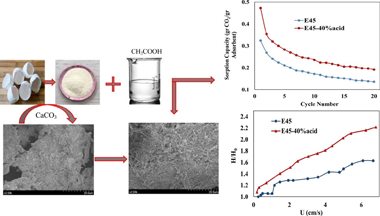
Although calcium-based materials are the most promising adsorbents used in calcium looping process for carbon dioxide removing, their CO2 capture capacity decaying besides poor fluidization, still are the important challenges. In the present investigation, eggshell as a cheap, easily available and unpolluted source of calcium carbonate was used for CO2 capturing in calcium looping process. Eggshell particles were treated with various volume concentrations of acetic acid to improve its sorption capacity. According to the TGA results after 20 carbonation/calcination cycles, the effective carbonation conversion of modified eggshell with 5%, 20%, 30% and 40%. v/v acetic acid was 21.33%, 24.26%, 25.97% and 28.97%, respectively, which is considerable compared to 20.54% for untreated eggshell. The effect of initial eggshell particle size on the adsorption behavior of final adsorbent was also investigated by using two different sizes including dp < 45 mu m and dp > 320 mu m. The results showed that the effective conversion of the adsorbent containing 40%. v/v acetic acid derived from small particle size eggshells was 9.32% higher than that from larger particle size eggshells. In terms of fluidization behavior, surprisingly the addition of acetic acid to the eggshell particles also increased the bed expansion ratio as 8% and 36.2% at gas velocities of 0.27 and 6.67 cm/s, respectively. Further improvement in the fluidity of eggshell modified with 40% acid was performed by manually mixing of SiO2 nanoparticles at different weight percentages. According to the results, adding 7.5 wt% SiO2 leaded to the homogeneous and agglomerate particulate fluidization.
Noviembre, 2022 | DOI: 10.1016/j.jcou.2022.102207
Reactividad de Sólidos
Comparative study of alkali activated cements based on metallurgical slags, in terms of technological properties developed
Gomez-Casero, MA; Perez-Villarejo, L; Sanchez-Soto, PJ; Eliche-Quesada, DSustainable Chemistry and Pharmacy, 29 (2022) 100746
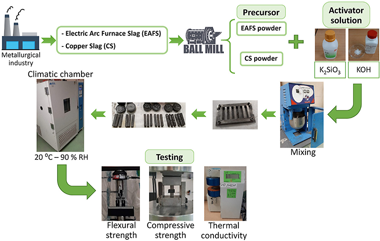
In this work, an investigation on the use of two slags from different origins (electric arc furnace slag (EAFS) and copper slag (CS)) as raw materials in the manufacture of alkali-activated cements has been carried out. A comparison of the different mechanical properties developed by the alkaline activation of each raw material has been studied. Combination of 35 wt% potassium hydroxide (KOH) solution with different concentration (5, 8, 12 and 15 M) and 65 wt% potassium silicate (K2SiO3) solution was used as activating solution to manufacture alkali activated cements. The pastes were cured 24 h in a climatic chamber at 20 ºC at 90% of relative humidity, subsequently demoulded and cured at same condition during 1, 7, 28 and 90 days. Alkali activated materials have been characterized using Fourier transform infrared spectroscopy (FTIR), X-ray diffraction (XRD) and scanning electron microscopy (SEM). The physical properties: bulk density, water absorption and apparent porosity, mechanical properties, flexural strength and compressive strength and thermal properties: thermal conductivity have been determined. The results indicate that two types of slags studied are a suitable source of aluminosilicates that can be activated for the manufacture of alkali-activated materials. These precursors are capable of developing high values of flexural and compressive strength and low values of thermal conductivity when optimal concentration of KOH was used. The optimal composition was developed when CS was utilized. Binders with CS and 12 M M ratio achieved compressive strength values up to 70 MPa.
Octubre, 2022 | DOI: 10.1016/j.scp.2022.100746
Reactividad de Sólidos
Highly efficient electrical discharge machining of yttria-stabilized zirconia ceramics with graphene nanostructures as fillers
Muñoz-Ferreiro, C; Lopez-Pernia, C; Moriche, R; Gommeringer, A; Kern, F; Poyato, R; Gallardo-Lopez, AJournal of the European Ceramic Society, 42 (2022) 5943-5952
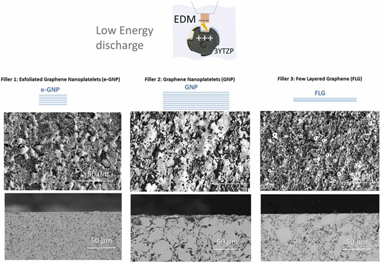
Electrical-discharge machining (EDM) of advanced ceramics allows the miniaturization of parts with complex shapes. Since electrical conductivity is required, non-conductive ceramics need a conductive second phase. This work assesses the feasibility of industrial EDM in advanced yttria-stabilized tetragonal zirconia (3YTZP) composites with 20 vol% graphene nanostructures with different morphology using different EDM energies. The structural integrity of the graphene nanostructures, the roughness of the machined surfaces and the geometrical tolerances have been evaluated by Raman spectroscopy, confocal microscopy and scanning electron microscopy, showing that it is possible to obtain a stable and efficient EDM process in these composites using low electrode energies. The use of the largest and thickest graphene nanostructures led to the best performance in terms of EDM machinability, the smallest nanostructures produced the best surface finish for low electrode energy and the thinnest nanostructures allowed the highest material removal rate at medium energy in the composites.
Octubre, 2022 | DOI: 10.1016/j.jeurceramsoc.2022.06.037
Materiales Avanzados
Pre-Roman and Republican amphorae (III-I centuries b.C.) from production contexts of the Guadalquivir Basin: technical and compositional characterization
Moreno-Megías, V.; García-Fernández, F.J.; Martín-del-Río, J.J.; Borreguero-Cid, M.; Sánchez-Soto, P.J.Boletín de la Sociedad Española de Cerámica y Vidrio, 61 (2022) 498-515
The present work consists of an archaeometric investigation concerning ceramic samples, mostly unpublished, of the III-I centuries b.C. They were found in connection with kilns of the city of Sevilla (Archbishop's Palace) and the countryside (Arrabal zone, Carmona). They are identified with evolved variations of Iron Age amphorae of Punic and Turdetanian tradition, or already Roman typologies. The main objectives of this research include their technological and compositional characterization as well as the comparison of the characteristics of each manufacture tradition.
An assemblage of 13 samples has been studied through petrographic analysis of thin sections, chemical analysis (X-ray fluorescence) and mineralogical analysis (X-ray diffraction). The chemical results showed the silico-aluminous and calcitic character of the samples, with variable contents of iron oxide as well as other minor elements and traces. The statistical treatment of the data by multivariant analysis has differentiated 3 conglomerates and one sample as an outsider. The mineralogical analysis has identified 8 crystalline phases, several of them already present in the raw materials and others formed by thermal treatment. It is interesting to note the illite, identified as dehydroxylated phase, anorthite, diopside and gehlenite. The petrographical analysis has identified 3 different petro-groups, which are correlated by a compositional point of view with the original context of the samples. Thus, according to these results, it has been possible to distinguish the manufactures of Sevilla from the Roman shapes, the common ware and the imitation types of Carmona.
It has been discussed the possible solid-state reactions which yielded the crystalline phases identified by X-ray diffraction, besides an estimation of firing temperatures between 820-850 degrees C in an oxidant atmosphere. Finally, the possible sources for the raw materials used in the fabrication of these amphorae have been proposed in the Guadalquivir River valley, considering their illitic-calcitic characteristics.
Septiembre, 2022 | DOI: 10.1016/j.bsecv.2021.03.008
Reactividad de Sólidos
Oxygen production routes assessment for oxy-fuel combustion
Garcia-Luna, S; Ortiz, C; Carro, A; Chacartegui, R; Perez-Maqueda, LAEnergy, 254 (2022) 124303
Oxyfuel combustion is a promising alternative to decarbonize the power sector. However, the main barrier to commercial deployment of the technology is the high energy consumption associated with oxygen production (-200-300 kWh per ton of O-2), which penalizes the thermal-to-electric efficiency of 8.5-12% compared to traditional air combustion plants. Typically, oxygen is obtained from a cryogenic air separation process. However, other technologies have been gaining momentum in recent years, such as membrane technologies, chemical looping air separation, and renewable-driven electrolysis. The present work evaluates all these options for O-2 production to retrofit a 550 MWe coal-fired power plant with oxyfuel combustion. A techno-economic assessment is carried out to estimate the energy penalty, the O-2 production cost (V/ton) and the Levelized Cost of Electricity. The best results are obtained by combining oxygen transport membranes and electrolysis since the energy consumption has been reduced to 98.56 kWh/ton of O(2, )decreasing by 59.31% the cryogenic distillation energy consumption (242.24 kWh/ ton O2), reducing the overall energy penalty compared to cryogenic air separation from 8.88% points to 7.56%points. The oxygen transport membrane presents the lowest cost of electricity in retrofitting cases, 51.48 $/MWh, while cryogenic distillation estimated cost is 52.7 $/MWh. Their costs of avoided CO2 are 31.79 $/ton CO2 and 34.15 $/ton CO2 respectively.
Septiembre, 2022 | DOI: 10.1016/j.energy.2022.124303
Reactividad de Sólidos
Low-pressure calcination to enhance the calcium looping process for thermochemical energy storage
Ortiz, C; Carro, A; Chacartegui, R; Valverde, JM; Perejon, A; Sánchez-Jiménez, PE; Pérez-Maqueda, LAJournal of Cleaner Production, 363 (2022) 132295
The Calcium-Looping (CaL) process, based on the multicyclic calcination-carbonation of CaCO3/CaO, is considered a promising Thermochemical Energy Storage (TCES) technology to be integrated into Concentrating Solar Power (CSP) plants. This work proposes a novel CaL integration that operates at low-pressure calcination under pure CO2 and a moderated temperature. Low-pressure calcination (0.01 bar) provides a suitable solution to mitigate CaO sintering and its consequent loss of reactivity in the carbonation stage. Since the temperature for quick calcination in a pure CO2 atmosphere is decreased (from around 950 °C at 1 bar to 765 °C at 0.01 bar), the energy losses at the receiver are minimised. In addition, a reduced calcination temperature allows for the use of metallic receivers already tested at the MW-scale, which significantly increases the CSP-CaL integration reliability. Moreover, multicycle CaO reactivity is promoted in short residence times, allowing the use of a simpler reactor design. Furthermore, there is an increase of 85% in the energy storage density of the system. The proposed plant proposes a smooth integration of the CaL process in CSP plants, with a moderate storage level and supported by a natural gas backup system (solar share higher than 50%). The results show that the solar thermal-to electric efficiency is above 30%.
Agosto, 2022 | DOI: 10.1016/j.jclepro.2022.132295
Reactividad de Sólidos
On the adsorption properties and applications of mixed-linker MOFs based on HKUST-1
Puerto-Rodríguez, M; López-Cartes, C; Ayala, RJournal of Solid State Chemistry, 312 (2022) 123260
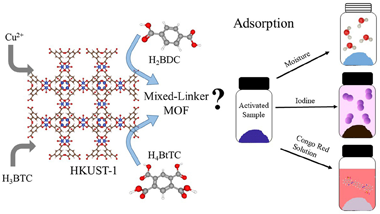
Different mixed-linker MOFs based on HKUST-1 have been successfully synthesized using BtTC (1,2,4,5-benzenetetracarboxylate) and BDC (1,4-benzenedicarboxylate) as modulator ligands. These MOFs maintain the HKUST-1 structure up to 25% and 50% of trimesic acid replacing with BtTC and BDC ligands, respectively. A low percentage of modulator ligand provokes an increasing of the MOF surface area keeping its microporosity whereas a higher content of BtTC induces mesoposority in the samples. The adsorption of moisture ambient or vapour iodine reveals that there is a relation between the surface area and the capacity of adsorption of the samples. However, this relation is not found in the experiments of Congo Red removal from aqueous and ethanol solutions. The pH of the solutions has a significant effect on the adsorption capacity of the samples.
Agosto, 2022 | DOI: 10.1016/j.jssc.2022.123260
Materiales Avanzados
Chemical, Radiometric and Mechanical Characterization of Commercial Polymeric Films for Greenhouse Applications
Franco, JE; Rodríguez-Arroyo, JA; Ortiz, IM; Sánchez-Soto, PJ; Garzón, E; Lao, MTMaterials, 15 (2022) 5532
In the agricultural sector, companies involved in the production of plastic greenhouses are currently searching for a suitable covering adapted for every climate in the world. For this purpose, this research work has determined the chemical, radiometric and mechanical properties of 53 polymeric films samples from Europe and South America. The chemical tests carried out with these samples were elemental analysis (C, H and N) and FT-IR spectrometry. The radiometric properties here studied were the transmission, absorption and reflection coefficients along the spectrum between 300 and 1100 nm. For the mechanical properties, tensile strength, tear strength and dart impact strength, tests were carried out. Finally, all these data were collected, and a multivariate statistical analysis was carried out using the SPSS statistical to group the samples into statistical groups adapted to specific climatic regions. The elemental analysis and FT-IR spectrometry allowed group the samples into nine groups. The samples were grouped according to their chemical (elemental analysis), radiometric and mechanical properties by multivariate analysis. The dendrogram separated five very different groups in terms of number of samples. These groups have specific chemical, radiometric and mechanical characteristics that separate them from the rest. These groups make it possible to narrow down the applications and correlate with the radiometric properties to see in which geographical area of the world they are most effective in increasing yields and achieving higher quality production.
Agosto, 2022 | DOI: 10.3390/ma15165532
Materiales Avanzados
Assessment of construction and demolition wastes (CDWs) as raw materials for the manufacture of low-strength concrete and bases and sub-bases of roads
Garzon, E; Martinez-Martinez, S; Perez-Villarrejo, L; Sanchez-Soto, PJMaterials Letters, 320 (2022) 132343
A chemical (XRF) and mineralogical (XRD) characterisation has been carried out, as well as the determination of the main properties, of construction and demolition wastes (CDWs). This waste has been applied as recycled aggregate. The objective was to search for its reuse for the manufacture of concrete and road bases and sub-bases. Chemical analysis revealed the presence of SiO2 (39.13 wt%) and Al2O3 (9.55 wt%) from quartz and some silicates, and gypsum. The content of CaO (21.42 wt%) was associated with calcite and dolomite. The materials' properties have suggested that the particle sizes are not inside the typical interval fixed in the Spanish normative. It can be reused as esplanades or sub-bases of roads and highways, since it is a granular material with a very high California Bearing Ratio (CBR value is 36). It was concluded that the use of CDWs as a substitute of sand for the manufacture of concrete can only be used in percentages lower than 10 wt% producing low-strength concrete.
Agosto, 2022 | DOI: 10.1016/j.matlet.2022.132343
Reactividad de Sólidos
Overlooked pitfalls in CaO carbonation kinetics studies nearby equilibrium: Instrumental effects on calculated kinetic rate constants
Arcenegui-Troya, J; Duran-Martin, JD; Perejon, A; Valverde, JM; Maqueda, LAP; Jimenez, PESAlexandria Engineering Journal, 61 (2022) 6129-6138
Due to its technological applications, such as CO2 capture, CaO carbonation kinetics has been extensively studied using a wide array of methods and experimental conditions. A complete understanding of carbonation kinetics is key to optimizing the operating conditions as well as to correctly design the carbonation reactor. However, there is yet no consensus on the reaction model and kinetic parameters that can best describe the CaO carbonation reaction. For instance, the value of the activation energy proposed in different works can vary up to 300%. In this work, we demonstrate that the strong influence of the thermodynamic equilibrium on CaO carbonation kinetics demands careful control of the experimental conditions to obtain meaningful kinetic parameters. Specifically, we explore the influence of three experimental parameters on carbonation kinetics: the gas flow rate, the CO2 partial pressure and the time required to fill the reactor after a gas change. We demonstrate that disregarding these aspects may lead to bogus conclusions on reaction kinetics, which could partly explain the considerable discrepancies found in the literature. The conclusions of this work are not only applicable to the process and experimental setup studied here but also to any study that involves the use of gas flow to drive a reaction.
Agosto, 2022 | DOI: 10.1016/j.aej.2021.11.043
Reactividad de Sólidos
Steam-enhanced calcium-looping performance of limestone for thermochemical energy storage: The role of particle size
Arcenegui-Troya, J.; Sánchez-Jiménez, PE; Perejon, A; Valverde, JM; Pérez-Maqueda, LAJournal of Energy Storage, 51 (2022) 104305
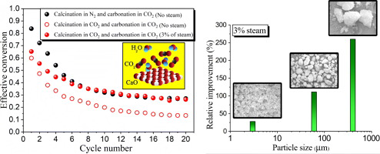
Steam injection has been proposed to attenuate the decay of CaO reactivity during calcium looping (CaL) under operating conditions compatible with carbon capture and storage. However, it is yet unknown whether the perceived advantages granted by steam hold under the distinct operating conditions required for the integration of the CaL process as a thermochemical energy storage system in Concentrating Solar Power Plants (CaL-CSP). Here, we study the influence of steam in conditions compatible with a CaL-CSP scheme and assess its impact when injected only during one stage; either calcination or carbonation, and also when it is present throughout the entire loop. The results presented here demonstrate that steam boosts the CaO multicycle performance in a CO2 closed loop to attain residual conversion values similar to those achieved at moderate temperatures under inert gas. Moreover, it is found that the enhancement in multicycle activity is more pronounced for larger particles.
Julio, 2022 | DOI: 10.1016/j.est.2022.104305
Reactividad de Sólidos
Albero: An alternative natural material for solar energy storage by the calcium-looping process
Moreno, V; Arcenegui-Troya, J; Sanchez-Jimenez, P; Perejon, A; Chacartegui, R; Valverde, JM; Perez-Maqueda, LAChemical Engineering Journal, 440 (2022) 135707
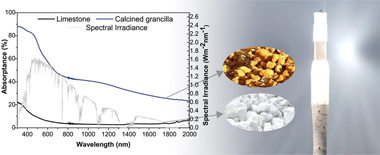
Large-scale thermochemical energy storage (TCES) is gaining relevance as an alternative to current thermal energy storage systems in Concentrated Solar Power plants. Among the different systems, the reversible reaction between CaO and CO2 stands out due to the wide availability and low cost of the raw material: limestone. Direct solar absorption of the storage media would improve the efficiency of solar-to-thermal energy storage due to reduced thermal transfer barriers, but the solar optical absorption of CaCO3 is poor. In this work, we propose the use of a Ca-rich calcarenite sedimentary rock so-called albem as an alternative to limestone. We demonstrate that this reddish material exhibits an average solar absorptance that is approximately ten times larger than limestone. Moreover, the multicycle carbonation/calcination performance under different experimental conditions has been studied by thermogravimetry, and similar values to those exhibited for limestone have been obtained. Besides, the material is cheap (6 Elton), and simulations showed that the use of this material would significantly improve the overall CaL-CSP efficiency at the industrial level.
Julio, 2022 | DOI: 10.1016/j.cej.2022.135707
Materiales Avanzados
Vitrification rate and estimation of the optimum firing conditions of ceramic materials from raw clays: A review
Garzon, E; Perez-Villarejo, L; Eliche-Quesada, D; Martinez-Martinez, S; Sanchez-Soto, PJCeramics International, 48 (2022) 15889-15898
The present work is a review concerning the previous investigations on the vitrification behaviour of clays containing kaolinite, feldspars, muscovite (illite/sericite) and pyrophyllite. These clays are silico-aluminous and have interesting properties as raw materials for structural ceramics. The mineralogical and chemical composition were determined. Then, the vitrification in these clay samples using pressed bodies was investigated by few researchers in the temperature range 800-1350 degrees C with 0.5-5.5 h of soaking times. The effect of heat treatments on the degree of vitrification in these clays was characterized by bulk densities of the ceramic bodies at the fired stage. It was found some variations of bulk density values for all these clays fired in the range 1000-1150 degrees C, with marked decreases of the values obtained at 1200 degrees C and 1300 degrees C. A first order reaction kinetics was applied to the analysis of vitrification of the ceramic bodies under isothermal heating. The method is based on experi-mental data of bulk densities, being proposed for the estimation of the relative degree of vitrification resulting from different firing schedules. The analysis considered the temperature dependence of the rate of vitrification following Arrhenius behaviour. Thus, the vitrification activation energy can be obtained. The activation energies for the physical process of vitrification in these clays ranged from 45 to 151 kJ/mol. The relative rates of vitrification or degree of vitrification attained during heating and soaking were calculated. The results suggested that the contribution of vitrification due to heating in all these clays was relatively small compared to the vitrification during soaking. However, it was evidenced that the influence of the particle sizes in the thermal behaviour of these clays cannot be neglected. The vitrification rate equations, as deduced in these previous studies, can be useful tools to estimate the optimum firing conditions of these clays, allowing the extension of this method to other clay types.
Junio, 2022 | DOI: 10.1016/j.ceramint.2022.02.129
Reactividad de Sólidos
Thermal behavior of ammonium fluorosilicates complexes: Obtaining and kinetic analysis
Resentera, AC; Perejon, A; Esquivel, MR; Perez-Maqueda, LA; Rodriguez, MHChemical Engineering Research amd Design, 182 (2022) 490-501
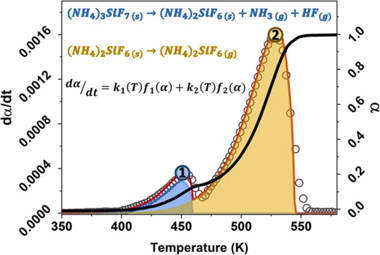
In this work, a mixture of (NH4)3SiF7/(NH4)2SiF6 powders was obtained as a by-product of the Li extraction process from alpha-spodumene aluminosilicate with NH4HF2. The thermal behavior of the powders was analyzed by non-isothermal thermogravimetric experiments. The kinetic parameters that describe the processes involved were obtained using mathematical deconvolution, Friedman's method, combined kinetic analysis, and nonlinear regression optimization. The results show that the process occurs in two partially overlapping steps, the thermal decomposition of (NH4)3SiF7 into (NH4)2SiF6 and the subsequent sublimation of (NH4)2SiF6. The apparent activation energies were 72.6 and 79.8 kJ/ mol for steps 1 and 2, respectively. The apparent pre-exponential factors were 1.19 x 106 and 2.50 x 105 s-1, respectively. The kinetic models indicated that Step 1 follows an A2 model, while Step 2 follows an F0 model. Finally, the resulting kinetic parameters allowed the reconstruction of the original experimental curves and obtaining predictions of curves recorded under other heating programs.
Junio, 2022 | DOI: 10.1016/j.cherd.2022.04.021
Materiales Avanzados
Thermal behaviour of the different parts of almond shells as waste biomass
Garzon, E; Arce, C; Callejon-Ferre, AJ; Perez-Falcon, JM; Sanchez-Soto, PJJournal of Thermal Analysis and Calorimetry, 147 (2022) 5023-5035
The main aim of this study is to investigate the thermal behaviour of the different parts of almond shells produced in an almond industry as a waste biomass. For this purpose, several experiments have been conducted under laboratory conditions. After removing the mature almonds, the waste raw materials subject of this study were treated with distilled water (10 min) and separated in several parts. Taking into account their physical characteristics, they were: (a) complete shells: exocarp, mesocarp and endocarp without grinding (Sample C); (b) ground samples of complete shells, sieved under 0.2 mm (Sample M); (c) hard layers of the endocarp (Sample E); (d) internal layers of the endocarp (Sample I); and (e) mature drupes (Sample P) or skin, being constituted by the flexible part of green colour (fresh form) or yellow (after drying). The thermal behaviour of all these sample materials has been investigated using a laboratory furnace, with determination of ash contents and mass loss by progressive heating (120 min of holding time). Elemental and DTA-TG/DTG analyses of selected sample materials have been carried out. Although a complete study can be very complex, a first approach has been performed in this investigation. Results on thermal decomposition of this biomass waste have been presented to emphasize the main differences between sample materials of almond shells. These results have demonstrated the influence of several parameters, such as the particle size, and previous treatments in the thermal behaviour of the different parts of the almond shells, as showed in this investigation. Structural analysis of almond shells allowed to determine lignin, cellulose and hemicellulose. From the lignin content, it has been predicted the higher heating value (18.24 MJkg(-1)) of this waste as by-product of industrial interest. Other linear correlations to calculate this parameter have been applied with similar results in all these samples.
Junio, 2022 | DOI: 10.1007/s10973-021-10940-x
Materiales Avanzados
Synthesis and characterization of alkali-activated materials containing biomass fly ash and metakaolin: effect of the soluble salt content of the residue
Jurado-Contreras, S; Bonet-Martínez, E; Sánchez-Soto, PJ; Gencel, O; Eliche-Quesada, DArchives of Civil and Mechanical Engineering, 22 (2022) 121
The present study investigates the production and characterization of alkali-activated bricks prepared with mixing metakaolin (MK) and biomass fly ash from the combustion of a mix of pine pruning, forest residues and energy crops (BFA). To use this low cost and high availability waste, different specimens were prepared by mixing MK with different proportions of BFA (25, 50 and 75 wt%). Specimens containing only metakaolin and biomass fly ash were produced for the purpose of comparison. Effects of the alkali content of biomass fly ash, after a washing pretreatment (WBFA), as well as the concentration of NaOH solution on the physical, mechanical and microstructural properties of the alkali-activated bricks were studied. It was observed that up to 50 wt% addition of the residue increases compressive strength of alkali-activated bricks. Alkalinity and soluble salts in fly ash have a positive effect, leading materials with the improved mechanical properties. Concentration of NaOH 8 M or higher is required to obtain optimum mechanical properties. The compressive strength increases from 23.0 MPa for the control bricks to 44.0 and 37.2 MPa with the addition of 50 wt% BFA and WBFA, respectively, indicating an increase of more than 60%. Therefore, the use of biomass fly ash provides additional alkali (K) sources that could improve the dissolution of MK resulting in high polycondensation. However, to obtain optimum mechanical properties, the amount of BFA cannot be above 50 wt%.
Mayo, 2022 | DOI: 10.1007/s43452-022-00444-2
Reactividad de Sólidos
The SrCO3/SrO system for thermochemical energy storage at ultra-high temperature
Amghar, N; Ortiz, C; Perejon, A; Valverde, JM; Maqueda, LP; Jimenez, PESSolar Energy Materials and Solar Cells, 238 (2022) 111632
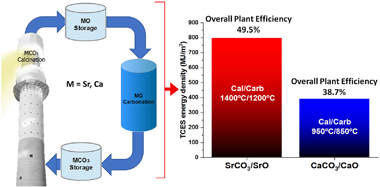
Thermochemical energy storage (TCES) has attracted interest in the last years due to the possibility of attaining high energy densities, seasonal storage capacity and greater efficiencies than currently commercial thermal energy storage systems using molten salts. This work analyses the potential of an ultra-high temperature TCES system based on the SrCO3/SrO system. The process relies upon the reversible decomposition of SrCO3 into SrO and CO2. As proposed in previous works for the integration of the Ca-Looping process to store energy in CSP plants, both the calcination (endothermic) and carbonation (exothermic) reactions are carried out in a closed CO2 loop. At these conditions, the required temperature to attain full calcination in short residence times is around 1400 degrees C whereas carbonation takes place at about 1200 degrees C. Using this process, the energy density potentially achievable by the storage material is very high (around 2000 MJ/m(3)) while the ultra-high carbonation temperature would improve thermoelectric efficiency. The enhancement of the multicycle performance of the SrCO3/SrO system using refractory additives is also explored. Even though current commercial CSP plants with tower technology cannot yet operate at these ultra-high temperatures, recent advances in the development of high-temperature solar receivers could allow operation at 1400 degrees C in the medium term. Finally, a conceptual model of the integration of the SrCO3/SrO system in a CSP plant supports higher overall efficiency and energy density, but lower solar-to-electric efficiency due to thermal losses.
Mayo, 2022 | DOI: 10.1016/j.solmat.2022.111632
Reactividad de Sólidos
Ageing-resistant zirconia/graphene-based nanostructures composites for use as biomaterials
Morales-Rodriguez, A; Gonzalez-Orellana, C; Perez-Garcia, AA; Lopez-Pernia, C; Munoz-Ferreiro, C; Poyato, R; Gallardo-Lopez, AJournal of the European Ceramic Society, 42 (2022) 1784-1795
This work explores the incorporation of graphene-based two-dimensional nanostructures as moisture barriers to delay hydrothermal ageing of yttria-stabilized zirconia and strengthen its use in biomedical applications. Two sets of highly dense zirconia composites incorporating multilayered graphene with very different lateral dimensions, few layer graphene and exfoliated graphene nanoplatelets, were prepared. The effect of the addition of graphene nanostructures on zirconia ageing was investigated by conducting accelerated hydrothermal degradation experiments in an autoclave. An improved resistance to low-temperature degradation and a high tolerance to damage were achieved in the composites compared to those of monolithic zirconia. The incorporation of 1 vol% multilayered graphene was very effective in restricting the hydrothermal degradation. In particular, the composite incorporating exfoliated graphene nanosheets exhibited outstanding resistance to ageing because of their fine dispersion throughout the matrix, which effectively seemed to restrict grain growth and slow the propagation of the transformation front to the ceramic bulk.
Abril, 2022 | DOI: 10.1016/j.jeurceramsoc.2021.11.060
Reactividad de Sólidos
A novel Multi-Phase Flash Sintering (MPFS) technique for 3D complex-shaped ceramics
Molina-Molina, S; Gil-Gonzalez, E; Duran-Olivencia, FJ; Valverde, JM; Perejon, A; Sanchez-Jimenez, PE; Pérez-Maqueda, LAApplied Materials Today, 26 (2022) 101274
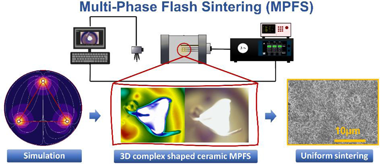
This work demonstrates the first proof-of-concept of Multi-Phase Flash Sintering (MPFS). This novel technique essentially consists of applying a rotating electric field to the sample by means of a multi-phase voltage source as furnace temperature increases. Several ceramic materials with different types of electrical conductivities are sintered within seconds at furnace temperatures much lower than those used for traditional DC flash sintering due to the higher power densities administered by a multi-phase power supply. Thus, ceramic materials are flashed at relatively lower applied voltages which minimizes undesired phenomena such as localization and preferential current pathways. Furthermore, MPFS allows diverse electrode configurations to promote a more uniform electric field distribution, enhancing the sintering of 3D complex-shaped specimens. MPFS could be a true breakthrough in materials processing, as 3D complex-shaped specimens are homogeneously sintered at reduced temperatures, while keeping all the advantages of conventional flash sintering.
Marzo, 2022 | DOI: 10.1016/j.apmt.2021.101274
Reactividad de Sólidos
Predictions of polymer thermal degradation: relevance of selecting the proper kinetic model
Sanchez-Jimenez, PE; Perejon, A; Arcenegui-Troya, J; Perez-Maqueda, LAJournal of Thermal Analysis and Calorimetry, 147 (2022) 2335-2341
Making predictions, such as lifetime estimations, is one of the main objectives of kinetic studies. Thus, from conventional thermal analysis experiments, the behavior of polymeric materials under processing or application conditions, usually far away from those used in the laboratory experiments, could be estimated. Conventional prediction procedures usually make use of oversimplified equations based on simple approaches. One of the most common approaches is the assumption of a first, or n-order, kinetic model for the process. However, recent studies have shown, for a number of polymers, that random scission kinetic models are not only physically sound, but more reliable in terms of describing the degradation kinetics. In this paper, the consequences of selecting an erroneous kinetic model on lifetime predictions is discussed. It is demonstrated, using both simulated and experimental data, that any kinetic analysis of a chain scission driven reaction performed assuming a first-order model entails enormous deviations in predictions. This occurs despite the fact that the first-order kinetic model can fit experimental data from chain scission driven reactions with significant correlation coefficients, and even lead to a reasonably good reconstruction of the original experimental curves.
Febrero, 2022 | DOI: 10.1007/s10973-021-10649-x
Reactividad de Sólidos
Effect of the Processing Parameters on the Porosity and Mechanical Behavior of Titanium Samples with Bimodal Microstructure Produced via Hot Pressing
Chavez-Vasconez, R; Lascano, S; Sauceda, S; Reyes-Valenzuela, M; Salvo, C; Mangalaraja, RV; Gotor, FJ; Arevalo, C; Torres, YMaterials, 15 (2022) 136
Commercially pure (c.p.) titanium grade IV with a bimodal microstructure is a promising material for biomedical implants. The influence of the processing parameters on the physical, microstructural, and mechanical properties was investigated. The bimodal microstructure was achieved from the blends of powder particles with different sizes, while the porous structure was obtained using the space-holder technique (50 vol.% of ammonium bicarbonate). Mechanically milled powders (10 and 20 h) were mixed in 50 wt.% or 75 wt.% with c.p. titanium. Four different mixtures of powders were precompacted via uniaxial cold pressing at 400 MPa. Then, the specimens were sintered at 750 degrees C via hot pressing in an argon gas atmosphere. The presence of a bimodal microstructure, comprised of small-grain regions separated by coarse-grain ones, was confirmed by optical and scanning electron microscopies. The samples with a bimodal microstructure exhibited an increase in the porosity compared with the commercially available pure Ti. In addition, the hardness was increased while the Young's modulus was decreased in the specimens with 75 wt.% of the milled powders (20 h).
Enero, 2022 | DOI: 10.3390/ma15010136
Materiales Avanzados
Study of a Waste Kaolin as Raw Material for Mullite Ceramics and Mullite Refractories by Reaction Sintering
Sanchez-Soto, PJ; Eliche-Quesada, D; Martinez-Martinez, S; Perez-Villarejo, L; Garzon, EMaterials, 15 (2022) 583
A deposit of raw kaolin, located in West Andalusia (Spain), was studied in this work using a representative sample. The methods of characterization were X-ray diffraction (XRD), X-ray fluorescence (XRF), particle size analysis by sieving and sedimentation, and thermal analysis. The ceramic properties were determined. A sample of commercial kaolin from Burela (Lugo, Spain), with applications in the ceramic industry, was used in some determinations for comparison purposes. The kaolin deposit has been produced by alteration of feldspar-rich rocks. This raw kaolin was applied as an additive in local manufactures of ceramics and refractories. However, there is not previous studies concerning its characteristics and firing properties. Thus, the meaning of this investigation was to conduct a scientific study on this subject and to evaluate the possibilities of application. The raw kaolin was washed for the beneficiation of the rock using water to increase the kaolinite content of the resultant material. The results indicated that the kaolinite content of the raw material was 20 wt % as determined by XRD, showing ~23 wt % of particles lower than 63 mu m. The kaolinite content of the fraction lower than 63 mu m was 50 wt %. Thus, an improvement of the kaolinite content of this raw kaolin was produced by wet separation. However, the kaolin was considered as a waste kaolin, with microcline, muscovite and quartz identified by XRD. Thermal analyses by Thermo-Dilatometry (TD), Differential Thermal Analysis (DTA) and Thermo-Gravimetry (TG) allowed observe kaolinite thermal decomposition, quartz phase transition and sintering effects. Pressed samples of this raw kaolin, the fraction lower than 63 mu m obtained by water washing and the raw kaolin ground using a hammer mill were fired at several temperatures in the range 1000-1500 & DEG;C for 2 h. The ceramic properties of all these samples were determined and compared. The results showed the progressive linear firing shrinkage by sintering in these samples, with a maximum value of ~9% in the fraction lower than 63 mu m. In general, water absorption capacity of the fired samples showed a decrease from ~18-20% at 1050 & DEG;C up to almost zero after firing at 1300 & DEG;C, followed by an increase of the experimental values. The open porosity was almost zero after firing at 1350 & DEG;C for 2 h and the bulk density reached a maximum value of 2.40 g/cm(3) as observed in the ground raw kaolin sample. The XRD examination of fired samples indicated that they are composed by mullite, from kaolinite thermal decomposition, and quartz, present in the raw sample, as main crystalline phases besides a vitreous phase. Fully-densified or vitrified materials were obtained by firing at 1300-1350 & DEG;C for 2 h. In a second step of this research, it was examined the promising application of the previous study to increase the amount of mullite by incorporation of alumina (alpha-alumina) to this kaolin sample. Firing of mixtures, prepared using this kaolin and alpha-alumina under wet processing conditions, produced the increase of mullite in relative proportion by reaction sintering at temperatures higher than 1500 & DEG;C for 2 h. Consequently, a mullite refractory can be prepared using this kaolin. This processing of high-alumina refractories is favoured by a previous size separation, which increases the kaolinite content, or better a grinding treatment of the raw kaolin.
Enero, 2022 | DOI: 10.3390/ma15020583
Reactividad de Sólidos
Effect of Steam Injection during Carbonation on the Multicyclic Performance of Limestone (CaCO3) under Different Calcium Looping Conditions: A Comparative Study
Troya, JJA; Moreno, V; Sánchez-Jiménez, PE; Perejon, A; Valverde, JM; Perez-Maqueda, LAACS Sustanaible Chemistry & Engineering, 10 (2022) 850-859
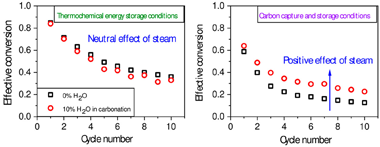
This study explores the effect of steam addition during carbonation on the multicyclic performance of limestone under calcium looping conditions compatible with (i) CO2 capture from postcombustion gases (CCS) and with (ii) thermochemical energy storage (TCES). Steam injection has been proposed to improve the CO2 uptake capacity of CaO-based sorbents when the calcination and carbonation loops are carried out in CCS conditions: at moderate carbonation temperatures (similar to 650 degrees C) under low CO2 concentration (typically similar to 15% at atmospheric pressure). However, the recent proposal of calcium-looping as a TCES system for integration into concentrated solar power (CSP) plants has aroused interest in higher carbonation temperatures (similar to 800-850 degrees C) in pure CO2. Here, we show that steam benefits the multicyclic behavior in the milder conditions required for CCS. However, at the more aggressive conditions required in TCES, steam essentially has a neutral net effect as the CO2 uptake promoted by the reduced CO2 partial pressure but also is offset by the substantial steam-promoted mineralization in the high temperature range. Finally, we also demonstrate that the carbonation rate depends exclusively on the partial pressure of CO2, regardless of the diluting gas employed.
Enero, 2022 | DOI: 10.1021/acssuschemeng.1c06314
Reactividad de Sólidos
Flash Sintering Research Perspective: A Bibliometric Analysis
Gil-Gonzalez, E; Perez-Maqueda, LA; Sanchez-Jimenez, PE; Perejon, AMaterials, 15 (2022) 416
Flash Sintering (FS), a relatively new Field-Assisted Sintering Technique (FAST) for ceramic processing, was proposed for the first time in 2010 by Prof. Rishi Raj's group from the University of Colorado at Boulder. It quickly grabbed the attention of the scientific community and since then, the field has rapidly evolved, constituting a true milestone in materials processing with the number of publications growing year by year. Moreover, nowadays, there is already a scientific community devoted to FS. In this work, a general picture of the scientific landscape of FS is drawn by bibliometric analysis. The target sources, the most relevant documents, hot and trending topics as well as the social networking of FS are unveiled. A separate bibliometric analysis is also provided for Reaction or Reactive Flash Sintering (RFS), where not only the sintering, but also the synthesis is merged into a single step. To the best of our knowledge, this is the first study of this nature carried out in this field of research and it can constitute a useful tool for researchers to be quickly updated with FS as well as to strategize future research and publishing approaches.
Enero, 2022 | DOI: 10.3390/ma15020416
2021
2021
Reactividad de Sólidos
Unravelling the optimization of few-layer graphene crystallinity and electrical conductivity in ceramic composites by Raman spectroscopy
Muñoz-Ferreiro, C; Lopez-Pernia, C; Gallardo-Lopez, A; Poyato, RJournal of the European Ceramic Society, 41 (2021) 290-298
Zirconia composites with few-layer graphene (FLG) were prepared by two powder processing routines-ultrasonic agitation or planetary ball milling-and spark plasma sintered at 1250 and 1300 degrees C. An in-depth study of the crystallinity of FLG, in terms of presence and nature of defects, was performed by Raman spectroscopy, revealing enhanced FLG crystallinity after sintering. This enhancement was more noticeable in the composites sintered at the highest temperature, with lower amount of structural defects and amorphous carbon. However, remaining amorphous carbon was detected in the composites prepared by planetary ball milling even after sintering at the highest temperature, resulting in lower electrical conductivities. Optimum results in terms of electrical conductivity were achieved for the composites prepared by ultrasonic agitation and sintered at 1300 degrees C, with electrical percolation limit below 2.5 vol% FLG and high electrical conductivity (678 S/m for 5 vol% FLG), as result of the enhanced FLG crystallinity after sintering.
Diciembre, 2021 | DOI: 10.1016/j.jeurceramsoc.2021.09.025
Reactividad de Sólidos
Fabrication and characterization of FeCoNiCrMn,(Al) high entropy alloy based (Ti,Ta,Nb)(C,N) cermet
Real, C; Alcala, MD; Trigo, I; Fombella, I; Cordoba, JMInternational Journal of Refractory Metals & Hard Materials, 101 (2021) 105694

From nanostructured mechanically synthesized powder a set of FeCoNiCrMn,(Al) based (Ti,Ta,Nb)(C,N) cermets were fabricated and sintered by a pressureless procedure. Highly dense cermets were obtained, and the nature of chemical change, microstructure, mechanical properties and coarsening kinetic of ceramic phase were characterized by image analysis, microindentation, scanning electron microscopy and X-ray diffraction. The design of the material was performed using a set of three different chemical cermet composition and three different sintering temperatures, or comparative purposes.
Diciembre, 2021 | DOI: 10.1016/j.ijrmhm.2021.105694
Reactividad de Sólidos
Advanced parametrisation of phase change materials through kinetic approach
Lizana, J; Perejon, A; Sanchez-Jimenez, PE; Perez-Maqueda, LAJournal of Energy Storage, 44 (2021) 103441
Phase change materials (PCM) have been widely investigated for heat storage and transfer applications. Numerous numerical simulation approaches have been proposed for modelling their behaviour and predicting their performance in thermal applications. However, simulation approaches do not consider the kinetics of the phase transition processes, compromising the accuracy of their predictions. The phase change is a kinetically driven process in which both the reaction rate and the reaction progress depend on the heating schedule. This work evaluates and parametrises the influence of kinetics in the melting and crystallisation behaviour of a well-known PCM, PEG1500, and compares potential discrepancies with common phase change parametrisation alternatives. The kinetic dependence was experimentally evaluated through differential scanning calorimetry (DSC). The kinetic parameters required for modelling the kinetics of the processes were determined by both model-free and model-fitting procedures following ICTAC (International Confederation for Thermal Analysis and Calorimetry) recommendations. Then, the phase transition was parametrised through a kinetic model and compared with three conventional phase transition models: linear without hysteresis, non-linear without hysteresis, and non-linear with hysteresis. The statistical comparison between models demonstrates the higher accuracy of the kinetic approach to correctly represent the partial enthalpy distribution of latent heat storage materials during alternative phase change rates, obtaining a coefficient of determination (R-2) of 0.80. On the other hand, the accuracy of kinetic-independent models is limited to the range from 0.40 to 0.61. The results highlight the high discrepancies of conventional models compared to the kinetic approach and provide criteria and guidelines for efficient kinetic modelling of phase change in heat transfer evaluations.
Diciembre, 2021 | DOI: 10.1016/j.est.2021.103441
Propiedades mecánicas, modelización y caracterización de cerámicos avanzados
HfB2 ceramic polycrystals: A low-temperature metal-like ceramic at high temperatures?
Zapata-Solvas, E; Moshtaghioun, BM; Gomez-Garcia, D; Dominguez-Rodriguez, A; Lee, WEScripta Materialia, 203 (2021) 114037

Hafnium diboride (HfB2) is a highly refractory (melting above 3000 degrees C) ceramic with many potential applications at high temperatures. To enable its use at temperature for extended periods its high-temperature plasticity must be known. This paper examines the mechanical response at temperatures between 900 degrees C and 2000 degrees C in air and in a reducing atmosphere, interpreting the data in the frame of classical models for the plasticity of compact-packed metals at low temperatures. In particular, the Friedel law and the principle of similitude for dislocation patterning are assessed. This reveals that HfB2 is a singular example of a ceramic material with "metal" mechanical behaviour.
Octubre, 2021 | DOI: 10.1016/j.scriptamat.2021.114037
Reactividad de Sólidos
Pure perovskite BiFeO3-BaTiO3 ceramics prepared by reaction flash sintering of Bi2O3-Fe2O3-BaTiO3 mixed powders
Taibi, A; Chaguetmi, S; Sánchez-Jiménez, PE; Perejón, A; García, JE; Satha, H; Pérez-Maqueda, LACeramics International, 47 (2021) 26947-26954
In this work, the 0.67BiFeO(3)-0.33BaTiO(3) ferroelectric ceramic was prepared by Reaction Flash Sintering (RFS). This preparation technique combines synthesis and sintering in a single Flash experiment. The starting oxides reacted during the flash to produce a stoichiometric well-sintered solid solution at a temperature of 858 degrees C by applying a modest field of 35 V cm(-1). The process takes place in a matter of seconds, which allows obtaining a pure perovskite structure without secondary phases. X-ray diffraction (XRD) results show the mixture of rhombohedral and pseudocubic phases expected for a composition that lies within a morphotropic phase boundary (MPB) region, since a significant splitting is observed in the reflections at 2 theta values of 39 degrees and 56.5 degrees. The microstructure exhibit a peculiar bimodal grain size distribution that determines the electrical properties. As compared with previous results, flash-prepared 0.67BiFeO(3)-0.33BaTiO(3) evidences smaller grain size, as well as slightly lower remanent polarization (P-r) and smaller coercive field (E-c) under similar electric fields. It is also demonstrated that the preparation by RFS provides benefits regarding electrical energy consumption.
Octubre, 2021 | DOI: 10.1016/j.ceramint.2021.06.108
Reactividad de Sólidos
Relevance of Particle Size Distribution to Kinetic Analysis: The Case of Thermal Dehydroxylation of Kaolinite
Arcenegui-Troya, J;Sanchez-Jimenez, PE; Perejon, A; Perez-Maqueda, LAProcesses, 9 (2021) 1852
Kinetic models used for the kinetic analysis of solid-state reactions assume ideal conditions that are very rarely fulfilled by real processes. One of the assumptions of these ideal models is that all sample particles have an identical size, while most real samples have an inherent particle size distribution (PSD). In this study, the influence of particle size distribution, including bimodal PSD, in kinetic analysis is investigated. Thus, it is observed that PSD can mislead the identification of the kinetic model followed by the reaction and even induce complex thermoanalytical curves that could be misinterpreted in terms of complex kinetics or intermediate species. For instance, in the case of a bimodal PSD, kinetics is affected up to the point that the process resembles a reaction driven by a multi-step mechanism. A procedure for considering the PSD in the kinetic analysis is presented and evaluated experimentally by studying the thermal dehydroxylation of kaolinite. This process, which does not fit any of the common ideal kinetic models proposed in the literature, was analyzed considering PSD influence. However, when PSD is taken into account, the process can be successfully described by a 3-D diffusion model (Jander's equation). Therefore, it is concluded that the deviations from ideal models for this dehydroxylation process could be explained in terms of PSD.
Octubre, 2021 | DOI: 10.3390/pr9101852
Reactividad de Sólidos
Scaling-up the Calcium-Looping Process for CO2 Capture and Energy Storage
Ortiz, C; Valverde, JM; Chacartegui, R; Perez-Maqueda, LA; Gimenez-Gavarrell, PKona Powder and Particle Journal, 38 (2021) 189-209
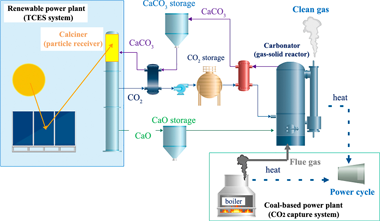
The Calcium-Looping (CaL) process has emerged in the last years as a promising technology to face two key challenges within the future energy scenario: energy storage in renewable energy-based plants and CO2 capture from fossil fuel combustion. Based on the multicycle calcination-carbonation reaction of CaCO3 for both thermochemical energy storage and post-combustion CO2 capture applications, the operating conditions for each application may involve remarkably different characteristics regarding kinetics, heat transfer and material multicycle activity performance. The novelty and urgency of developing these applications demand an important effort to overcome serious issues, most of them related to gas-solids reactions and material handling. This work reviews the latest results from international research projects including a critical assessment of the technology needed to scale up the process. A set of equipment and methods already proved as well as those requiring further demonstration are discussed. An emphasis is put on critical equipment such as gas-solids reactors for both calcination and carbonation, power block integration, gas and solids conveying systems and auxiliary equipment for both energy storage and CO2 capture CaL applications.
Octubre, 2021 | DOI: 10.14356/kona.2021005
Reactividad de Sólidos
Mechanochemical synthesis of ternary chalcogenide chalcostibite CuSbS2 and its characterization
Dutkova, E; Sayagues, MJ; Fabian, M; Kovac, J; Kovat, J; Balaz, M; Stahorsky, MJournal of Materials Science-Materials in Electronics (2021)
In this work, the very rapid one-step mechanochemical synthesis of nanocrystalline ternary chalcogenide chalcostibite CuSbS2 prepared from copper, antimony, and sulfur precursors by high-energy milling for only 30 min in a planetary mill is reported. XRD confirmed the orthorhombic crystal structure of CuSbS2. The crystallite size of CuSbS2 calculated by LeBail refinement of the X-ray powder diffraction data was 25 nm. The nanocrystalline chalcostibite CuSbS2 was also confirmed by transmission electron microscopy. The purity of CuSbS2 was verified by Raman spectroscopy. The synthesized chalcostibite exhibits the specific surface area value of 2.4 m(2)g(-1). UV-Vis spectroscopy showed the optical bandgap of CuSbS2 as 1.54 eV with wide range of absorption in visible region. Photoresponse of CuSbS2 was confirmed by I-V measurements under dark and light illumination. The proposed mechanochemical synthesis provides an alternative approach to prepare also other ternary semiconductor nanomaterials. CuSbS2 semiconductor nanocrystals have the potential to be used as light absorbers in photovoltaics.
Agosto, 2021 | DOI: 10.1007/s10854-021-06767-9
Reactividad de Sólidos
Study of the Influence of Sintering Atmosphere and Mechanical Activation on the Synthesis of Bulk Ti2AlN MAX Phase Obtained by Spark Plasma Sintering
Salvo, C; Chicardi, E; García-Garrido, C; Poyato, R; Jimenez, JA; Mangalaraja, RVMaterials, 14 (2021) 4574
The influence of the mechanical activation process and sintering atmosphere on the microstructure and mechanical properties of bulk Ti2AlN has been investigated. The mixture of Ti and AlN powders was prepared in a 1:2 molar ratio, and a part of this powder mixture was subjected to a mechanical activation process under an argon atmosphere for 10 h using agate jars and balls as milling media. Then, the sintering and production of the Ti2AlN MAX phase were carried out by Spark Plasma Sintering under 30 MPa with vacuum or nitrogen atmospheres and at 1200 degrees C for 10 min. The crystal structure and microstructure of consolidated samples were characterized by X-ray Diffraction, Scanning Electron Microscopy, and Energy Dispersive X-ray Spectroscopy. The X-ray diffraction patterns were fitted using the Rietveld refinement for phase quantification and determined their most critical microstructural parameters. It was determined that by using nitrogen as a sintering atmosphere, Ti4AlN3 MAX phase and TiN were increased at the expense of the Ti2AlN. In the samples prepared from the activated powders, secondary phases like Ti5Si3 and Al2O3 were formed. However, the higher densification level presented in the sample produced by using both nitrogen atmosphere and MAP powder mixture is remarkable. Moreover, the high-purity Ti2AlN zone of the MAX-1200 presented a hardness of 4.3 GPa, and the rest of the samples exhibited slightly smaller hardness values (4.1, 4.0, and 4.2 GPa, respectively) which are matched with the higher porosity observed on the SEM images.
Agosto, 2021 | DOI: 10.3390/ma14164574
Reactividad de Sólidos
Kinetics and cyclability of limestone (CaCO3) in presence of steam during calcination in the CaL scheme for thermochemical energy storage
Arcenegui-Troya, J; Sanchez-Jimenez, PE; Perejon, A; Moreno, V; Valverde, JM; Perez-Maqueda, LAChemical Engineering Journal, 417 (2021) 129194
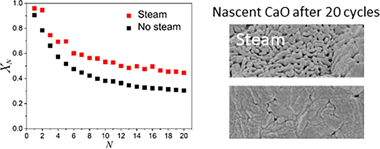
In the present work, we explore the use of steam in the CaCO3 calcination step of the Calcium Looping process devised for thermochemical energy storage (CaL-TCES). Steam produces a double benefit: firstly, it fastens calcination, allowing a reduction of the temperature needed to attain full calcination in short residence times, as those required in practice, resulting in energy savings. This behaviour is justified on the basis of a kinetics study results obtained from a non-parametric kinetic analysis, which demonstrate that the presence of steam during calcination can reduce the apparent activation energy from 175 kJ/mol to 142 kJ/mol with a steam's partial pressure of 29%. In addition, the results obtained for multicycle CaL-TCES tests show that steam alleviates the deactivation of the sorbent, which is one of the main limiting factors of this technology. This behaviour is explained in terms of the effect of steam on the microstructure of the regenerated CaO. Importantly, the values of residual conversion attained by calcining in steam are higher than those without steam.
Agosto, 2021 | DOI: 10.1016/j.cej.2021.129194
Reactividad de Sólidos
Calcination under low CO2 pressure enhances the calcium Looping performance of limestone for thermochemical energy storage
Sarrion, B; Perejon, A; Sanchez-Jimenez, PE; Amghar, N; Chacartegui, R; Valverde, JM; Perez-Maqueda, LAChemical Engineering Journal, 417 (2021) 127922
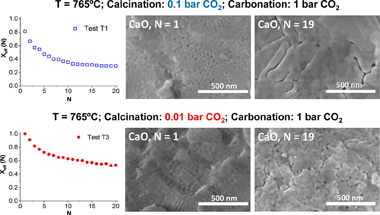
The Calcium Looping performance of limestone for thermochemical energy storage has been investigated under novel favorable conditions, which involve calcination at moderate temperatures under CO2 at low pressure (0.01 and 0.1 bar) and carbonation at high temperature under CO2 at atmospheric pressure. Calcining at low CO2 pressures allows to substantially reduce the temperature to achieve full calcination in short residence times. Moreover, it notably enhances CaO multicycle conversion. The highest values of conversion are obtained for limestone samples calcined under 0.01 bar CO2 at 765 degrees C. Under these conditions, the residual conversion is increased by a factor of 10 as compared to conditions involving calcination under CO2 at atmospheric pressure. The enhancement of CaO conversion is correlated to the microstructure of the CaO samples obtained after calcination. As seen from SEM, BET surface and XRD analysis, calcination under low CO2 pressure leads to a remarkable decrease of pore volume and CaO crystallite size. Consequently, CaO surface area available for carbonation in the fast reaction-controlled regime and therefore reactivity in short residence times is promoted.
Agosto, 2021 | DOI: 10.1016/j.cej.2020.127922
Materiales Avanzados
Geopolymers made from metakaolin sources, partially replaced by Spanish clays and biomass bottom ash
Eliche-Quesada, D; Calero-Rodriguez, A; Bonet-Martinez, E;Perez-Villarejo, L; Sanchez-Soto, PJJournal of Building Engineering, 40 (2021) 102761
The main objective of this investigation is to study the effect of the substitution of metakaolin (MK) (from calcined industrial kaolin) by four different calcined natural Southern Spain clays traditionally used in the brick and tile sector, as well as by the biomass bottom ash residue (BBA) from the combustion of a mix of olive and pine pruning on the synthesis of geopolymer with physical, mechanical and thermal properties comparable to those of classic construction materials. As alkaline activator, a 8 M solution of sodium hydroxide and sodium silicate have been used. Raw materials, metakaolin; Spanish clays: black clay (BC), yellow clay (YC), white clay (WC), red clay (RC) and BBA were characterized by chemical analysis (XRF), mineralogical analysis (XRD), and particle size analysis. Control geopolymers containing only metakaolin, and batch of geopolymers were formulated containing equal proportions of metakaolin, BBA and each of the four types of clay. After the curing period, at 60 degrees C for 1 day geopolymers were demolded and stored 27 days at room temperature. Geopolymers were characterized using Scanning Electron Microscopy coupled with Energy Dispersive Spectroscopy (SEM-EDS), XRD and Attenuated Total Reflectance-Fourier Transform Infrared Spec troscopy (ATR-FTIR). Their physical, mechanical and thermal properties have also been studied. The addition of BBA and different types of calcined clays to metakaolin gives rise to geopolymers with higher mechanical properties increasing the compressive strength of the control geopolymer containing only MK (24.9 MPa) by more than 50% for the GMK-BBA-WC geopolymers (38.5 MP a). The clays act as fillers and/or promote the precipitation of calcium-rich phases (Ca)-A-S-H-G gel that coexists with the (Na)-A-S-H gel type. The relevant results of physical, mechanical and thermal properties obtained in this research demonstrate the potential of Spanish clays and BBA as binders and substitutes for metakaolin.
Agosto, 2021 | DOI: 10.1016/j.jobe.2021.102761
Reactividad de Sólidos
Tuning the excitation wavelength of luminescent Mn2+-doped ZnSxSe1-x obtained by mechanically induced self-sustaining reaction
Aviles, MA; Gotor, FJOptical Materials, 117 (2021) 111121
Mn2+-doped ZnSxSe1-x solid solution samples (Mn:ZnSxSe1-x) were synthesized by the mechanochemical process denoted as mechanically-induced self-sustaining reaction from Mn/Zn/S/Se powder elemental mixtures. The samples were characterized by X-ray diffraction, scanning electron microscopy, diffuse reflectance UV-Vis spectroscopy and emission and excitation photoluminescence measurements. The band-gap energy of samples was controlled by changing the stoichiometry, x, of the solid solution. All samples showed the characteristic Mn2+ 4T1-6A1 emission at -588 nm when exciting the host material, so it was possible to tune the excitation wavelength from 349 nm to 467 nm. However, an efficiency loss was observed with increasing Se content, probably due to the overlap between the absorption and emission spectra that induced self-absorption and emission quenching.
Julio, 2021 | DOI: 10.1016/j.optmat.2021.111121
Reactividad de Sólidos
Kinetic study of complex processes composed of non-independent stages: pyrolysis of natural rubber
Perejon, A; Sánchez-Jiménez, PE; García-Garrido, C; Pérez-Maqueda, LAPolymer Degradation and Stability, 188 (2021) 109590
In this work, it is proposed a method for studying kinetics of complex processes composed of non-independent stages. In this method, the variable contribution of the different stages as a function of the heating schedule is taken into account. The method involves the simultaneous kinetic analysis of a set of experimental data registered under linear heating rate conditions, without any previous assumptions regarding the kinetic models followed by the stages or their corresponding activation energies.
The method has been tested with the kinetic analysis of the pyrolysis of natural rubber, since the kinetics of this process is complex and depends on temperature and heating schedule. It is demonstrated that the behavior of the experimental curves can be accurately predicted with the kinetic parameters calculated by the proposed methodology.
The kinetic analysis presented here could be applied to other complex processes as those found in pyrolysis, without the need of using oversimplified kinetic models that could yield significant errors when used in real applications.
Junio, 2021 | DOI: 10.1016/j.polymdegradstab.2021.109590
Reactividad de Sólidos
Paving the Way to Establish Protocols: Modeling and Predicting Mechanochemical Reactions
Gil-Gonzalez, E; Perez-Maqueda, LA; Sanchez-Jimenez, PE; Perejon, AJournal of Physical Chemistry Letters, 12 (2021) 5540-5546
Parametrization of mechanochemical reactions, or relating the evolution of the reaction progress to the supplied input power, is required both to establish protocols and to gain insight into mechanochemical reactions. Thus, results could be compared, replicated, or scaled up even under different milling conditions, enlarging the domains of application of mechanochemistry. Here, we propose a procedure that allows the parametrization of mechanochemical reactions as a function of the supplied input power from the direct analysis of the milling experiments in a model-free approach, where neither the kinetic model function nor the rate constant equation are previously assumed. This procedure has been successfully tested with the mechanochemical reaction of CH3NH3PbCl3, enabling the possibility to make predictions regardless of the milling device as well as gaining insight into the reaction dynamic. This methodology can work for any other mechanical reaction and definitely paves the way to establish mechanochemistry as a standard synthetic procedure.
Junio, 2021 | DOI: 10.1021/acs.jpclett.1c01472
Reactividad de Sólidos
Unveiling mechanochemistry: Kinematic-kinetic approach for the prediction of mechanically induced reactions
Gil-González, E.; Rodríguez-Laguna, M.d.R.; Sánchez-Jiménez, P.E.; Perejón, A.; Pérez-Maqueda, L.A.Journal of Alloys and Compounds, 866 (2021) 158925
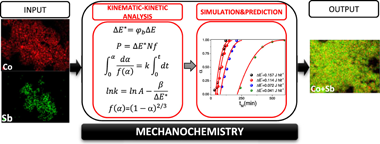
Mechanochemistry has attracted a lot of attention over the last few decades with a rapid growth in the number of publications due to its unique features. However, very little is known about how mechanical energy is converted into chemical energy. Most of the published works using mechanochemistry neglect the required attention to the experimental parameters and their effect over the resulting products, what makes extremely difficult to reproduce the results from lab to lab. Moreover, if it is taken into consideration the broad range of experimental conditions used in different studies, it is quite difficult to compare results and set optimum conditions. As a result, mechanochemistry is generally viewed as a "black box". The aim of this work is to provide some insight into mechanochemistry. Thus, a simple kinematic-kinetic approach that allows the full parametrization of mechanically induced reactions is proposed. In an analogous way to thermally activated process, it is shown that kinetic modeling can serve to parametrize and model mechanically induced reactions as a function of the milling parameters with great reliability, thereby gaining prediction capability. As a way of example, this methodology has been applied for the first time to the mechanochemical reaction of Co and Sb to form CoSb3, a skutterudite-type thermoelectric material. Moreover, the universality of this methodology has also been validated with data from the literature. A key feature of the proposed kinematic-kinetic approach is that it can be extrapolated to other mechanically induced reactions, either inorganic or organic.
Junio, 2021 | DOI: 10.1016/j.jallcom.2021.158925
Materiales Avanzados
Effects of an Illite Clay Substitution on Geopolymer Synthesis as an Alternative to Metakaolin
Eliche-Quesada, D; Bonet-Martinez, E; Perez-Villarejo, L; Castro, E; Sanchez-Soto, PJJournal of Materials in Civil Engineering, 33 (2021) 04021072
In this study, a calcined illite clay from Bailen, Jaen, Spain, was valorized as a substitute of metakaolin in the synthesis of new geopolymeric materials. The raw materials, raw clay and commercial kaolin, were pretreated at 750 degrees C (4 h). Several samples (0%-100% by weight of clay) were activated by mixing NaOH solution and sodium silicate solution. The specimens were cured (60 degrees C and 99% relative humidity) for 24 h, then demolded and kept at ambient conditions for 7, 28, and 90 days. The prepared geopolymers were characterized by X-ray diffraction, Fourier transform infrared spectroscopy, and scanning electron microscopy. Physical, mechanical, and thermal properties were determined. The results indicated that the specimens based on the illite raw clay and metakaolin present an amorphous consolidated appearance, characteristic of the polycondensation reactions. The incorporation of up to 50% by weight of raw clay provided geopolymers with higher mechanical strength (39.6 MPa) and bulk density (1,455 kg/m(3)), lower apparent porosity (19.6%), and similar although slightly higher thermal conductivity (0.25 W/mK) than control geopolymers containing only metakaolin as a precursor after 28 days of curing. Control geopolymers presented compressive strength, bulk density, apparent porosity, and thermal conductivity of 23 MPa, 1,251 kg/m(3), 41.03% and 0.224 W/mk, respectively, at the same age of cured geopolymers. The mechanical properties increased with curing time due to a greater advance of the geopolymerization reaction. Therefore, this illite clay can be thermally activated together with metakaolin to obtain geopolymers with suitable technological properties. The results demonstrate that the finished materials can be used for construction applications.
Mayo, 2021 | DOI: 10.1061/(ASCE)MT.1943-5533.0003690
Reactividad de Sólidos
Synthesis and Characterization of a Nearly Single Bulk Ti2AlN MAX Phase Obtained from Ti/AlN Powder Mixture through Spark Plasma Sintering
Salvo, C; Chicardi, E; Poyato, R; Garcia-Garrido, C; Jimenez, JA; Lopez-Pernia, C; Tobosque, P; Mangalaraja, RVMaterials, 14 (2021) 2217
MAX phases are an advanced class of ceramics based on ternary carbides or nitrides that combine some of the ceramic and metallic properties, which make them potential candidate materials for many engineering applications under severe conditions. The present work reports the successful synthesis of nearly single bulk Ti2AlN MAX phase (>98% purity) through solid-state reaction and from a Ti and AlN powder mixture in a molar ratio of 2:1 as starting materials. The mixture of Ti and AlN powders was subjected to reactive spark plasma sintering (SPS) under 30 MPa at 1200 degrees C and 1300 degrees C for 10 min in a vacuum atmosphere. It was found that the massive formation of Al2O3 particles at the grain boundaries during sintering inhibits the development of the Ti2AlN MAX phase in the outer zone of the samples. The effect of sintering temperature on the microstructure and mechanical properties of the Ti2AlN MAX phase was investigated and discussed.
Mayo, 2021 | DOI: 10.3390/ma14092217
Materiales Avanzados
Synthesis of clay geopolymers using olive pomace fly ash as an alternative activator. Influence of the additional commercial alkaline activator used
Gomez-Casero, MA; Moral-Moral, FJ; Perez-Villarejo, L; Sanchez-Soto, PJ; Eliche-Quesada, DJournal of Materials Research and Technology-JMR&T 12 (2021) 1762-1776
In this research, the use of olive pomace fly ash (OPFA) as an alkaline source for the activation of calcined clays (CC) from Bailen (Jaen, Spain) was studied. The optimal composition was obtained for 70 wt % CC and 30 wt % OPFA. The physical, mechanical and thermal properties of control geopolymers that use water as a liquid medium have been studied and compared with geopolymers that use additional activating solutions as sodium or potassium hydroxide solutions (8 M), or a mixture of alkaline hydroxide and alkaline silicate solution (NaOH-Na2SiO3 or KOH-K2SiO3). The results showed that OPFA can be used as an alkaline activator, showing mechanical properties slightly lower than those obtained when additional alkaline hydroxide activating solutions were used. The best compressive strength was obtained for geopolymers that use alkaline silicates as an activating solution. However, the best thermal insulation properties were obtained for control geopolymers. The microstructural characteristics of the geopolymers were evaluated by means of X-ray diffraction (XRD), Fourier transform infrared (FTIR) spectroscopy and Scanning Electron Microscopy (SEM-EDS) that corroborate the formation of geopolymeric gel in all the specimens, being the amount of gel formed greater in samples using commercial potassium activating solutions. These results demonstrate the feasibility of using this type of waste, OPFA, as activating reagents in the manufacture of geopolymers or alkaline activated materials. The manufactured geopolymers can be used as compressed earth blocks for walls and partitions, since the specimens pursue mechanical properties that comply with current regulations, presenting better thermal insulation properties.
Mayo, 2021 | DOI: 10.1016/j.jmrt.2021.03.102
Reactividad de Sólidos
Mechanochemically synthesized ternary chalcogenide Cu3SbS4 powders in a laboratory and an industrial mill
Dutkova, E; Sayagues, MJ; Fabian, M; Balaz, M; Achimovicova, MMaterials Letters, 291 (2021) 129566
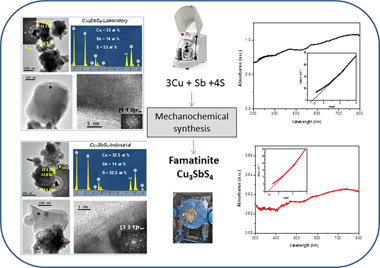
In this work, we demonstrate the use of elemental precursors (Cu, Sb, S) to synthesize famatinite Cu3SbS4 using a laboratory planetary ball milling and an industrial eccentric vibratory milling. Cu3SbS4 was prepared for 120 min and 180 min in laboratory and industrial mill, respectively, with the utilization of protective atmosphere. The Cu3SbS4 prepared in the laboratory and industrial mill with crystallite size 14 nm and 10 nm, respectively, was confirmed by both LeBail refinement of the X-ray powder diffraction data and transmission electron microscopy. The determined band gap energy 1.31 eV and 1.24 eV is blue-shifted relative to the bulk Cu3SbS4. The synthesis of Cu3SbS4 by a scalable milling process represents a prospective route for mass production of material with potential photovoltaic properties. In this work, we demonstrate the use of elemental precursors (Cu, Sb, S) to synthesize famatinite Cu3SbS4 using a laboratory planetary ball milling and an industrial eccentric vibratory milling. Cu3SbS4 was prepared for 120 min and 180 min in laboratory and industrial mill, respectively, with the utilization of protective atmosphere. The Cu3SbS4 prepared in the laboratory and industrial mill with crystallite size 14 nm and 10 nm, respectively, was confirmed by both LeBail refinement of the X-ray powder diffraction data and transmission electron microscopy. The determined band gap energy 1.31 eV and 1.24 eV is blue-shifted relative to the bulk Cu3SbS4. The synthesis of Cu3SbS4 by a scalable milling process represents a prospective route for mass production of material with potential photovoltaic properties.
Mayo, 2021 | DOI: 10.1016/j.matlet.2021.129566
Reactividad de Sólidos
Enhancing the electrical conductivity of in-situ reduced graphene oxide-zirconia composites through the control of the processing routine
Lopez-Pernia, C; Morales-Rodriguez, A; Gallardo-Lopez, A; Poyato, RCeramics International, 47 (2021) 9382-9391
Graphene oxide (GO) was mixed with 3 mol% yttria tetragonal zirconia polycrystal (3YTZP) using two powder processing routines: a colloidal method in an aqueous solution and a combination of ultrasonication with highenergy planetary ball milling in wet conditions. Highly densified 3YTZP composites with reduced GO (rGO) were consolidated by Spark Plasma Sintering. The in-situ reduction of GO was successfully achieved during the high temperature sintering process and a detailed study of the restoration of the graphene structure in the sintered composites has been made by Raman spectroscopy. Although no differences between the composites prepared by the two processing methods were found in the distribution of the rGO throughout the 3YTZP matrix for high rGO contents (i.e. the composites with 5 and 10 vol% rGO), a better distribution of the graphene phase was found in the composites with 1 and 2.5 vol% rGO prepared by planetary ball milling. This result, together with a better reduction of the GO in these composites, led to the obtaining of rGO/3YTZP composites with a better behavior in terms of electrical conductivity: an electrical percolation threshold below 2.5 vol% rGO and a high electrical conductivity value (-610 S/m for 10 vol% rGO).
Abril, 2021 | DOI: 10.1016/j.ceramint.2020.12.069
Propiedades mecánicas, modelización y caracterización de cerámicos avanzados
Cation-driven electrical conductivity in Ta-doped orthorhombic zirconia ceramics
Moshtaghioun, BM; Laguna-Bercero, MA; Pena, JI; Gomez-Garcia, D; Dominguez-Rodriguez, ACeramics International, 47 (2021) 7248-7522
This paper is devoted to the study of the electrical conductivity of tantalum-doped zirconia ceramics prepared by spark plasma sintering. In this study, the temperature dependence of conductivity in as-prepared specimens and in those previously annealed in air is determined and compared. A semi-empirical model, which is based on the oxidation states of the cations, has been developed and successfully assessed. According to this, the conductivity is basically controlled by the diffusion of tetravalent zirconium cations in both cases, although the concentration of these species varies drastically with the amount of induced oxygen vacancies. This is a quite unexpected fact, since conductivity is normally controlled by anionic diffusion in zirconia ceramics. This option is forbidden here due to the presence of substitutional pentavalent cations. Therefore, conductivity values are much lower than those reported in trivalent or divalent substitutional cation doped zirconia ceramics.
Marzo, 2021 | DOI: 10.1016/j.ceramint.2020.10.227
Reactividad de Sólidos
EGFR-targeting antitumor therapy: Neuregulins or antibodies?
de Lavera, I; Merkling, PJ; Oliva, JM; Sayagues, MJ; Cotan, D; Sanchez-Alcazar, JA; Infante, JJ; Zaderenko, A.P.European Journal of Pharmaceutical Sciences, 158 (2021) 105678
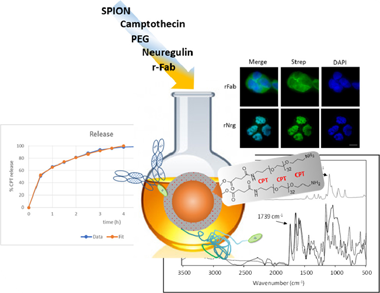
Malignancies such as lung, breast and pancreatic carcinomas are associated with increased expression of the epidermal growth factor receptor, EGFR, and its role in the pathogenesis and progression of tumors has made this receptor a prime target in the development of antitumor therapies. In therapies targeting EGFR, the development of resistance owing to mutations and single nucleotide polymorphisms, and the expression of the receptor ligands themselves are very serious issues. In this work, both the ligand neuregulin and a bispecific antibody fragment to EGFR are conjugated separately or together to the same drug-delivery system to find the most promising candidate. Camptothecin is used as a model chemotherapeutic drug and superparamagnetic iron oxide nanoparticles as a delivery system. Results show that the lowest LD50 is achieved by formulations conjugated to both the antibody and the ligand, demonstrating a synergy. Additionally, the ligand location in the nucleus favors the antitumor activity of Camptothecin. The high loading capacity and efficiency convert these systems into a good alternative for administering Camptothecin, a drug whose use is otherwise severely limited by its chemical instability and poor solubility. Our choice of targeting agents allows treating tumors that express ErbB2 (Her2+ tumors) as well as Her2- tumors expressing EGFR.
Marzo, 2021 | DOI: 10.1016/j.ejps.2020.105678
Reactividad de Sólidos
A first insight into the microstructure and crack propagation in novel boron nitride nanosheet/3YTZP composites
Munoz-Ferreiro, C; Morales-Rodriguez, A; Gallardo-Lopez, A; Poyato, RBoletin de la Sociedad Española de Cerámica y Vidrio, 60 (2021) 128-136
In this work, novel 3 mol% yttria tetragonal zirconia polycristalline (3YTZP) ceramic composites with boron nitride nanosheets (BNNS) are investigated for the first time. Highly densified composites with 1 and 4 vol% BNNS were obtained by spark plasma sintering (SPS) after BNNS synthesis using a solution exfoliation method and BNNS dispersion into the ceramic powder by ultrasonication. The BNNS presented homogeneous distribution throughout the ceramic matrix and preferential alignment in the plane perpendicular to the pressing axis during SPS. The BNNS incorporation had practically no effect on the Vickers hardness of the material nor on the Young's modulus. Anisotropy in crack development was found in the composite with 4% vol BNNS, together with a mechanism of extensive microcracking. Several energy-absorbing mechanisms during crack propagation, such as crack deflection, crack bridging, crack branching, BNNS pull-out and BNNS debonding, were identified in the composites by a close observation of the indentation-induced fracture paths.
Marzo, 2021 | DOI: 10.1016/j.bsecv.2020.02.003
Materiales Avanzados
Mining Wastes of an Albite Deposit as Raw Materials for Vitrified Mullite Ceramics
Sanchez-Soto, PJ; Garzon, E; Perez-Villarejo, L; Angelopoulos, GN; Eliche-Quesada, DMinerals, 11 (2021) 232
In this work, an examination of mining wastes of an albite deposit in south Spain was carried out using X-ray Fluorescence (XRF), X-ray diffraction (XRD), particle size analysis, thermodilatometry and Differential Thermal Analysis (DTA) and Thermogravimetric (TG) analysis, followed by the determination of the main ceramic properties. The albite content in two selected samples was high (65-40 wt. %), accompanied by quartz (25-40 wt. %) and other minor minerals identified by XRD, mainly kaolinite, in agreement with the high content of silica and alumina determined by XRF. The content of Na2O was in the range 5.44-3.09 wt. %, being associated with albite. The iron content was very low (<0.75 wt. %). The kaolinite content in the waste was estimated from similar to 8 to 32 wt. %. The particle size analysis indicated values of 11-31 wt. % of particles <63 mu m. The ceramic properties of fired samples (1000-1350 degrees C) showed progressive shrinkage by the thermal effect, with water absorption and open porosity almost at zero at 1200-1250 degrees C. At 1200 ffiC, the bulk density reached a maximum value of 2.38 g/cm(3). An abrupt change in the phase evolution by XRD was found from 1150 to 1200 degrees C, with the disappearance of albite by melting in accordance with the predictions of the phase diagram SiO2-Al2O3-Na2O and the system albite-quartz. These fired materials contained as main crystalline phases quartz and mullite. Quartz was present in the raw samples and mullite was formed by decomposition of kaolinite. The observation of mullite forming needle-shape crystals was revealed by Scanning Electron Microscopy (SEM). The formation of fully densified and vitrified mullite materials by firing treatments was demonstrated.
Marzo, 2021 | DOI: 10.3390/min11030232
Reactividad de Sólidos
A Novel, Simple and Highly Efficient Route to Obtain PrBaMn2O5+δ Double Perovskite: Mechanochemical Synthesis
Garcia-Garcia, FJ; Sayagues, MJ; Gotor, FJNanomaterials, 11 (2021) 380
In this work, a mechanochemical route was proposed for the synthesis of the PrBaMn2O5+δ (PMBO) double layered perovskite phase. The mechanochemical reaction between Pr6O11, BaO2, and MnO powders with cationic stoichiometric ratios of 1/1/2 for Pr/Ba/Mn was performed using high-energy milling conditions in air. After 150 min of milling, a new phase with perovskite structure and cubic symmetry consistent with the A-site disordered Pr0.5Ba0.5MnO3 phase was formed. When this new phase was subsequently annealed at a high temperature in an inert Ar atmosphere, the layered PrBaMn2O5+δ phase was obtained without needing to use a reducing atmosphere. At 1100 °C, the fully reduced layered PrBaMn2O5 phase was achieved. A weight gain was observed in the 200–300 °C temperature range when this fully reduced phase was annealed in air, which was consistent with the transformation into the fully oxidized PrBaMn2O6 phase. The microstructural characterization by SEM, TEM, and HRTEM ascertained the formation of the intended PrBaMn2O5+δ phase. Electrical characterization shows very high electrical conductivity of layered PBMO in a reducing atmosphere and suitable in an oxidizing atmosphere, becoming, therefore, excellent candidates as solid oxide fuel cell (SOFC electrodes).
Febrero, 2021 | DOI: 10.3390/nano11020380
Propiedades mecánicas, modelización y caracterización de cerámicos avanzados
The Possible Detriment of Oxygen in Creep of Alumina and Zirconia Ceramic Composites Reinforced with Graphene
Cano-Crespo, R; Rivero-Antunez, P; Gomez-Garcia, D; Moreno, R; Dominguez-Rodriguez, AMaterials, 14 (2021) 984
This paper aims to give an answer to the following question: is the oxidation of graphene a critical issue for high-temperature plasticity in graphene-reinforced ceramics? To give a convincing reply, we will focus on two very different graphene-based ceramic composites: reduced graphene oxide (rGO)-reinforced alumina (alpha-Al2O3) and reduced graphene oxide (rGO)-reinforced yttria tetragonal zirconia (t-ZrO2). The processing of the powders has been made using a colloidal route, and after that, a spark plasma sintering process was performed in order to densify the samples. Creep tests were performed at temperatures between 1200-1250 degrees C in an argon atmosphere. The microstructure obtained by SEM of the sintered and tested specimens was characterized quantitatively to elucidate the deformation mechanism. Raman spectroscopy was carried out to check the integrity of the graphene. The average grain size was in the order of 1 mu m and the shape factor was 0.7 for all the studied materials. The integrity of the graphene was checked before and after the creep experiments. The careful analysis of the creep tests shows that graphene oxide or its reduced version are not efficient phases for creep resistance improvement in general, contrary to what is reported elsewhere. However, the results permit the suggestion of a creep improvement in nanocomposites at a very high temperature regime due to an enhanced reactivity of oxygen between carbon and alumina interfaces. In the case of zirconia, the results give us the conclusion that the oxidation of graphene is a highly detrimental issue regarding the improvement of high-temperature plasticity.
Febrero, 2021 | DOI: 10.3390/ma14040984
Reactividad de Sólidos
Influence of Successive Chemical and Thermochemical Treatments on Surface Features of Ti6Al4V Samples Manufactured by SLM
Gonzalez, JE; de Armas, G; Negrin, J; Beltran, AM; Trueba, P; Gotor, FJ; Peon, E; Torres, YMetals, 11 (2021) 313
Ti6Al4V samples, obtained by selective laser melting (SLM), were subjected to successive treatments: acid etching, chemical oxidation in hydrogen peroxide solution and thermochemical processing. The effect of temperature and time of acid etching on the surface roughness, morphology, topography and chemical and phase composition after the thermochemical treatment was studied. The surfaces were characterized by scanning electron microscopy, energy dispersive X-ray spectroscopy, X-ray diffraction and contact profilometry. The temperature used in the acid etching had a greater influence on the surface features of the samples than the time. Acid etching provided the original SLM surface with a new topography prior to oxidation and thermochemical treatments. A nanostructure was observed on the surfaces after the full process, both on their protrusions and pores previously formed during the acid etching. After the thermochemical treatment, the samples etched at 40 °C showed macrostructures with additional submicro and nanoscale topographies. When a temperature of 80 °C was used, the presence of micropores and a thicker anatase layer, detectable by X-ray diffraction, were also observed. These surfaces are expected to generate greater levels of bioactivity and high biomechanics fixation of implants as well as better resistance to fatigue.
Febrero, 2021 | DOI: 10.3390/met11020313
Reactividad de Sólidos
Critical Influence of the Processing Route on the Mechanical Properties of Zirconia Composites with Graphene Nanoplatelets
Gallardo-Lopez, A; Munoz-Ferreiro, C; Lopez-Pernia, C; Jimenez-Pique, E; Gutierrez-Mora, F; Morales-Rodriguez, A; Poyato, RMaterials, 14 (2021) 108
Graphene-based nanostructures, used as potential reinforcement in ceramic composites, have a great tendency to agglomerate. This requires the use of homogenization techniques during the powder processing, posing the need to evaluate how these techniques affect the microstructure and the mechanical properties of the resulting composites. The influence of the processing route on the properties of 3YTZP (3 mol % yttria tetragonal zirconia polycrystals) ceramic composites with 10 vol % cost-effective GNP (graphene nanoplatelets) has been addressed. Four different powder processing routines combining ultrasonic powder agitation (UA) and planetary ball milling (PBM) in wet and dry media have been used and all the composites were densified by spark plasma sintering (SPS). The mechanical properties at room temperature in the macroscale have been assessed by Vickers indentations, four-point bending tests and the impulse-echo technique, while instrumented indentation was used to measure the hardness and Young’s modulus at the nanoscale. The application of dry-PBM enhances greatly the mechanical and electrical isotropy of the composites, slightly increases the hardness and lowers the elastic modulus, independently of the application of UA. The combination of UA and dry-PBM enhances the flexure strength by 50%, which is desirable for structural applications.
Enero, 2021 | DOI: 10.3390/ma14010108
2020
2020
Reactividad de Sólidos
Control of experimental conditions in reaction flash-sintering of complex stoichiometry ceramics
Gil-Gonzalez, E; Perejon, A; Sanchez-Jimenez, PE; Roman-Gonzalez, D; Perez-Maqueda, LACeramics International, 46 (2020) 29413-29420
The inherent potential of reaction flash-sintering for the preparation of complex oxides is evidenced by the one-step synthesis and densification of a ceramic of complex stoichiometry. The system Bi0.93La0.07FeO3, a multi-ferroic ceramic with promising technological applications, has been chosen. This system presents three different metals in its composition and it is extremely challenging to prepare by conventional procedures. Non-stoichiometric materials with unwilling secondary phases are usually obtained by conventional methods, due to the high volatility of bismuth oxide at the temperatures required for inducing the solid-solid reactions. Here, it is demonstrated that a careful control of the experimental flash conditions (applied electric field and selected current density limit) is required to obtain a high quality ceramic. Small deviations from the optimum conditions result in either non-stoichometric or poorly densified samples.
Diciembre, 2020 | DOI: 10.1016/j.ceramint.2020.05.091
Materiales Avanzados
Characterization, thermal and ceramic properties of phyllite clays from southeast Spain
Garzon, Eduardo; Perez-Villarejo, Luis; Sanchez-Soto, Pedro J.Journal of Thermal Analysis and Calorimetry, 142 (2020) 1659-1670
The present research studied a set of phyllite clays from several deposits in southeast Spain. These phyllite clays have traditionally been used as sealing material to impermeabilize roofs, embankments, ponds, construction and waste landfill, with recent applications in the preparation of new mortars. However, studies on thermal behaviour and ceramic properties of phyllite clays have been scarce. The present research showed a summary of previous characterization studies on representative phyllite clays from these deposits with additional results. Mineralogical, by X-ray diffraction, and chemical, by X-ray fluorescence characterization of these samples were summarized. Thermal analysis methods (DTA-TG and thermal diffractometry) were applied to achieve a more complete mineralogical characterization. Several phyllite clay samples were selected for a ceramic study by firing pressed powdered samples up to 1300 degrees C. Sintered or vitrified materials, with porosities almost zero, were obtained from these phyllite clays after firing at 1100-1200 degrees C, with apparent densities between 2.1 and 2.4 g cm(-3). Higher firing temperatures (> 1250 degrees C) produced deformation and expansion of the ceramic bodies. These results allowed obtain the vitrification temperature (T-v) and the temperature of the maximum bulk density (T-d). According to the previous mineralogical and chemical characterization and the values of these parameters, the phyllite clay samples were classified in three varieties, as follows: (1)Micaceous, characterized by predominant layer silicates, mainly muscovite or illite, alkaline elements (mainly K2O higher than 3.5 mass%) and lower values of both T(v)and T-d, (2)Quartzitic, with predominant quartz and SiO(2)and intermediate values of T(v)and T-d, and (3)Carbonaceous, characterized by predominant dolomite, medium contents of CaO and MgO and higher values of both T(v)and T-d. These results are interesting for the application of these phyllite clays as ceramic raw materials.
Diciembre, 2020 | DOI: 10.1007/s10973-020-10160-9
Materiales Avanzados
Dust filter of secondary aluminium industry as raw material of geopolymer foams
Eliche-Quesada, D; Ruiz-Molina, S; Perez-Villarejo, L; Castro, E; Sanchez-Soto, PJHournal of Building Engineering, 32 (2020) 101656
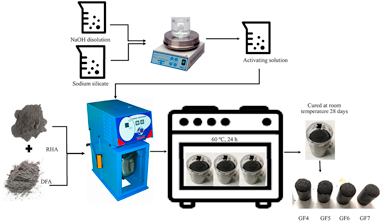
In this work, the use of waste dust filter of secondary aluminum industry (DFA) to obtain geopolymer foams has been studied. The waste was used as source of alumina and foaming agent. As precursor and principal reactive silica supplier rice husk ash was used. Precursors were chemically activated by means of a sodium hydroxide aqueous solution and a commercial sodium silicate solution. The influence of the DFA content or Si/Al molar ratio (4-7) were determined by keeping the Si/Na molar ratio of 0.7 M constant and the concentration of sodium hydroxide in the activating solution equal to 8.5 M. The geopolymer foams obtained were studied by X-ray Diffraction (XRD), adsorption/desorption of nitrogen, infrared spectroscopy (FTIR), and scanning electron microscope (SEM) techniques. The results indicated that geopolymer foams presented low values of bulk density (643-737 kg/m(3)) high values of apparent porosity (62-70%), low, but sufficient values of compressive strength (0.5-1.7 MPa) and good values of thermal conductivity (0.131-0.157 W/mK). Lower values of thermal conductivity were obtained for Si/Al = 4 and 5 M ratios, due to the highest apparent porosity and the highest total pore volume. These geopolymer foam materials have similar properties to other construction materials sector such as gypsum boards, foamed concrete, or insulating materials. In addition, its use in other applications of interest such as catalyst support or gas filtration materials could be investigated.
Noviembre, 2020 | DOI: 10.1016/j.jobe.2020.101656
Reactividad de Sólidos
Graphene-coated Ti-Nb-Ta-Mn foams: A promising approach towards a suitable biomaterial for bone replacement
Lascano, S; Chavez-Vasconez, R; Munoz-Rojas, D; Aristizabal, J; Arce, B; Parra, C; Acevedo, C; Orellana, N; Reyes-Valenzuela, M; Gotor, FJ; Arevalo, C; Torres, YSurface & Coatings Technology, 401 (2020) 126250
The design of bone implants with proper biological and mechanical properties remains a challenge in medical implantology. The use of bioactive coatings has been shown to improve the biocompatibility of the implant surface. In this study, a new approach including porous scaffolds, beta-Ti alloys and nanocoatings to design new bone implants is presented. Porous Ti-Nb-Ta-xMn alloys (x: 2, 4, and 6 wt%) substrates were obtained by powder metallurgy and the effect of the porosity and Mn content on mechanical properties was studied. CVD single-layer graphene was transferred onto the porous substrates that presented the best mechanical response (x: 4 wt%) for further evaluation of in vitro cell behavior (biocompatibility and cell adhesion). Cytotoxicity and biocompatibility tests confirmed that cell adhesion and proliferation were successfully achieved on graphene-coated porous substrates, confirming these systems are potential candidates for using in partial bone tissue replacement.
Noviembre, 2020 | DOI: 10.1016/j.surfcoat.2020.126250
Propiedades mecánicas, modelización y caracterización de cerámicos avanzados
Mg2SiO4-MgAl2O4 directionally solidified eutectics: Hardness dependence modelled through an array of screw dislocations
Moshtaghioun, BM; Gomez-Garcia, D; Pena, JIJournal of The European Ceramic Society, 40 (2020) 4171-4176
Mg2SiO4-MgAl2O4 eutectic ceramics have been fabricated by means of the laser floating zone (LFZ) technique. The microstructure has revealed as an unusual one at lower growth rate, composed of broken lamellae of MgAl2O4 distributed randomly along one matrix, composed of Mg2SiO4. At higher growth rates, a cell structure with intra-cell lamella structure is dominant. Contrary to most eutectic systems, hardness is not dependent upon the inter-spacing, but it does depend on one characteristic length of lamellae: their perimeter. One simple model based upon the dislocation is proposed, which successfully accounts for such extraordinary hardness law. Accordingly, Mg2SiO4-MgAl2O4 eutectic ceramics fabricated at 50 mm/h growth rate with the smallest MgAl2O4 lamella perimeter favorably showed more elevated hardness (13.4 GPa from Vickers indentation and 15.3 GPa from nanoindentation) and strength (430 MPa) than those found in the monolithic Mg2SiO4 matrix.
Septiembre, 2020 | DOI: 10.1016/j.jeurceramsoc.2020.05.015
Reactividad de Sólidos
Synthesis of all equiatomic five-transition metals High Entropy Carbides of the IVB (Ti, Zr, Hf) and VB (V, Nb, Ta) groups by a low temperature route
Chicardi, E; Garcia-Garrido, C; Hernandez-Saz, J; Gotor, FJCeramics International, 46 (2020) 21421-21430
The six possible equiatomic five-transition metal High Entropy Carbides (HECs) of the IVB (Ti, Zr, Hf) and VB (V, Nb, Ta) groups of the periodic table, i.e., TiZrHfVNbC5, TiZrHfVTaC5, TiZrHfNbTaC5, TiZrVNbTaC5, TiHfVNbTaC5 and ZrHfVNbTaC5, were successfully obtained via a powder metallurgy route at room temperature, specifically, by one-step diffusion mechanosynthesis starting from the elemental constituents (using graphite as the carbon source). Three of those HECs, TiZrHfVTaC5, TiZrVNbTaC5 and ZrHfVNbTaC5, were developed for the first time. Their development was possible without any subsequent thermal treatment, in contrast to the usual way (reactive sintering at 1800-2200 degrees C), and in a powder form, make them potential advanced raw ceramics for hard, refractory and oxidation resistance coatings or matrix phase composites.
Septiembre, 2020 | DOI: 10.1016/j.ceramint.2020.05.240
Propiedades mecánicas, modelización y caracterización de cerámicos avanzados
Disclination dipoles are the Holy Grail for high temperature superplasticity in ceramics
Moshtaghioun, BM; Bejarano-Palma, JA; Garcia, DGScripta Materialia, 185 (2020) 21-24

A model for high-temperature plasticity of polycrystals controlled by disclination dipoles is proposed that predict a parabolic dependence of the strain rate versus the applied stress. The presence of a precise stationary disclination density explains the origin of plasticity without microstructural invariance, commonly known as superplasticity. The disclination mechanism is universal, although other processes, such as dislocation glide, are superposed to this one in many systems such as metals or metallic alloys. While, in ceramics it is likely to be the only operative mechanism. Activation of disclination dipoles is a necessary condition for plasticity and sufficient one for superplastic yielding.
Agosto, 2020 | DOI: 10.1016/j.scriptamat.2020.03.049
Reactividad de Sólidos
Calcium-Looping Performance of Biomineralized CaCO3 for CO2 Capture and Thermochemical Energy Storage
Arcenegui-Troya, J; Sanchez-Jimenez, PE; Perejon, A; Valverde, JM; Chacartegui, R; Perez-Maqueda, LAIndustrial & Engineering Chemistry Research, 59 (2020) 12924-12933
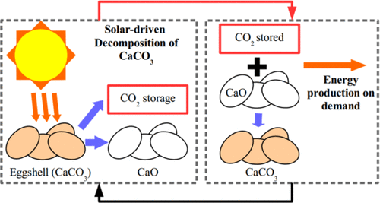
The commercial deployment of calcium-looping (CaL)-based technologies relies on the availability of nontoxic, widely available and cheap CaCO3 rich materials. Biomineralized CaCO3 from waste amply fulfills the aforementioned requirements. In the present work, we study the performance of eggshell and snail shell from food waste as CaO precursors for CaL applications. The results obtained suggest the feasible use of these waste materials. The multicyclic conversion exhibited by biomineralized CaCO3 was comparable to that demonstrated by limestone, which is a commonly proposed material for CaL applications. In addition, the temperature needed to completely calcine biomineralized CaCO3 in short residence times is lower than that required to fully calcine limestone. This would mitigate the energy cost of the technology.
Julio, 2020 | DOI: 10.1021/acs.iecr.9b05997
Reactividad de Sólidos
ICTAC Kinetics Committee recommendations for analysis of multi-step kinetics
Vyazovkin, S; Burnham, AK; Favergeon, L; Koga, N; Moukhina, E; Perez-Maqueda, LA; Sbirrazzuoli, NThermochimica Acta, 689 (2020) 178597
The present recommendations have been developed by the Kinetics Committee of the International Confederation for Thermal Analysis and Calorimetry (ICTAC). The recommendations provide guidance on kinetic analysis of multi-step processes as measured by thermal analysis methods such as thermogravimetry (TGA) and differential scanning calorimetry (DSC). Ways of detecting the multi-step kinetics are discussed first. Then, four different approaches to evaluation of kinetic parameters (the activation energy, the pre-exponential factor, and the reaction model) for individual steps are considered. The approaches considered include multi-step model-fitting as well as distributed reactivity, isoconversional, and deconvolution analyses. For each approach practical advice is offered on its effective usage. Due attention is also paid to the typical problems encountered and to the ways of resolving them. The objective of these recommendations is to help a non-expert with efficiently performing multi-step kinetic analysis and interpreting its results.
Julio, 2020 | DOI: 10.1016/j.tca.2020.178597
Reactividad de Sólidos
Electrochemically Exfoliated Graphene-Like Nanosheets for Use in Ceramic Nanocomposites
Poyato, R; Verdugo, R; Munoz-Ferreiro, C; Gallardo-Lopez, AMaterials, 13 (2020) 11
In this work, the synthesis of graphene-like nanosheets (GNS) by an electrochemical exfoliation method, their microstructural characterization and their performance as fillers in a ceramic matrix composite have been assessed. To fabricate the composites, 3 mol % yttria tetragonal zirconia (3YTZP) powders with 1 vol % GNS were processed by planetary ball milling in tert-butanol to enhance the GNS distribution throughout the matrix, and densified by spark plasma sintering (SPS). According to a thorough Raman analysis and SEM observations, the electrochemically exfoliated GNS possessed less than 10 graphene layers and a lateral size lower than 1 mu m. However, they contained amorphous carbon and vacancy-like defects. In contrast the GNS in the sintered composite exhibited enhanced quality with a lower number of defects, and they were wavy, semi-transparent and with very low thickness. The obtained nanocomposite was fully dense with a homogeneous distribution of GNS into the matrix. The Vickers hardness of the nanocomposite showed similar values to those of a monolithic 3YTZP ceramic sintered in the same conditions, and to the reported ones for a 3YTZP composite with the same content of commercial graphene nanosheets.
Junio, 2020 | DOI: 10.3390/ma13112656
Reactividad de Sólidos
Development of a high-pressure thermobalance working under constant rate thermal analysis
Perejon, A; Sanchez-Jimenez, PE; Criado, JM; Perez-Maqueda, LAJournal of Thermal Analysis ande Calorimetry, 142 (2020) 1329-1334
A thermogravimetric instrument that works at high pressure of different gases has been designed and assembled. The instrument has been devised to work in a temperature range from room temperature to 1000 degrees C in various controlled pressures of selected gas up to 15 bar, and under conventional rising temperature and constant rate thermal analysis (CRTA) modes. CRTA method allows an intelligent control of the reaction temperature using a feedback system that monitors the mass gain or mass loss of the sample in such a way that the reaction rate is maintained constant all over the process at a preselected value. CRTA method provides a significant advantage for studying processes under high pressure as it reduces heat and mass transfer phenomena that are very relevant under these high-pressure experimental conditions. The thermal oxidation of Ni at 8 bar of pure oxygen has been used for testing the performance of the instrument under both linear heating rate and CRTA conditions.
Abril, 2020 | DOI: 10.1007/s10973-020-09644-5
Reactividad de Sólidos
Influence of the Test Configuration and Temperature on the Mechanical Behaviour of WC-Co
Gonzalez, LM; Chicardi, E; Gotor, FJ; Bermejo, R; Llanes, L; Torres, YMetals, 10 (2020) 322
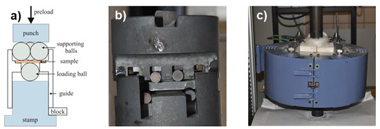
In this work, the effect of the test configuration and temperature on the mechanical behaviour of cemented carbides (WC-Co) with different carbide grain sizes (d(WC)) and cobalt volume fractions (V-Co), implying different binder mean free paths (lambda (Co)), was studied. The mechanical strength was measured at 600 degrees C with bar-shaped specimens subjected to uniaxial four-point bending (4PB) tests and with disc specimens subjected to biaxial ball-on-three-balls (B3B) tests. The results were analysed within the frame of the Weibull theory and compared with strength measurements performed at room temperature under the same loading conditions. A mechanical degradation greater than 30% was observed when the samples were tested at 600 degrees C due to oxidation phenomena, but higher Weibull moduli were obtained as a result of narrower defect size distributions. A fractographic analysis was conducted with broken specimens from each test configuration. The number of fragments (N-f) and the macroscopic fracture surface were related to the flexural strength and fracture toughness of WC-Co. For a given number of fragments, higher mechanical strength values were always obtained for WC-Co grades with higher K-Ic. The observed differences were discussed based on a linear elastic fracture mechanics (LEFM) model, taking into account the effect of the temperature and microstructure of the cemented carbides on the mechanical strength.
Marzo, 2020 | DOI: 10.3390/met10030322
Reactividad de Sólidos
Role of particle size on the multicycle calcium looping activity of limestone for thermochemical energy storage
Duran-Martin, JD; Jimenez, PES; Valverde, JM; Perejon, A; Arcenegui-Troya, J; Trinanes, PG; Maqueda, LAPJournal of Advanced Research, 22 (2020) 67-76
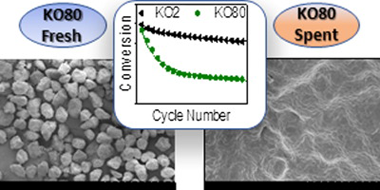
The calcium looping process, based on the reversible reaction between CaCO3 and CaO, is recently attracting a great deal of interest as a promising thermochemical energy storage system to be integrated in Concentrated Solar Power plants (CaL-CSP). The main drawbacks of the system are the incomplete conversion of CaO and its sintering-induced deactivation. In this work, the influence of particle size in these deactivation mechanisms has been assessed by performing experimental multicycle tests using standard limestone particles of well-defined and narrow particle size distributions. The results indicate that CaO multicycle conversion benefits from the use of small particles mainly when the calcination is carried out in helium at low temperature. Yet, the enhancement is only significant for particles below 15 μm. On the other hand, the strong sintering induced by calcining in CO2 at high temperatures makes particle size much less relevant for the multicycle performance. Finally, SEM imaging reveals that the mechanism responsible for the loss of activity is mainly pore-plugging when calcination is performed in helium, whereas extensive loss of surface area due to sintering is responsible for the deactivation when calcination is carried out in CO2 at high temperature.
Marzo, 2020 | DOI: 10.1016/j.jare.2019.10.008
Reactividad de Sólidos
Development by Mechanochemistry of La0.8Sr0.2Ga0.8Mg0.2O2.8 Electrolyte for SOFCs
Garcia-Garcia, FJ; Tang, YQ; Gotor, FJ; Sayagues, MJMaterials, 13 (2020)

In this work, a mechanochemical process using high-energy milling conditions was employed to synthesize La0.8Sr0.2Ga0.8Mg0.2O3-δ (LSGM) powders from the corresponding stoichiometric amounts of La2O3, SrO, Ga2O3, and MgO in a short time. After 60 min of milling, the desired final product was obtained without the need for any subsequent annealing treatment. A half solid oxide fuel cell (SOFC) was then developed using LSGM as an electrolyte and La0.8Sr0.2MnO3 (LSM) as an electrode, both obtained by mechanochemistry. The characterization by X-ray diffraction of as-prepared powders showed that LSGM and LSM present a perovskite structure and pseudo-cubic symmetry. The thermal and chemical stability between the electrolyte (LSGM) and the electrode (LSM) were analyzed by dynamic X-ray diffraction as a function of temperature. The electrolyte (LSGM) is thermally stable up to 800 and from 900 °C, where the secondary phases of LaSrGa3O7 and LaSrGaO4 appear. The best sintering temperature for the electrolyte is 1400 °C, since at this temperature, LaSrGaO4 disappears and the percentage of LaSrGa3O7 is minimized. The electrolyte is chemically compatible with the electrode up to 800 °C. The powder sample of the electrolyte (LSGM) at 1400 °C observed by HRTEM indicates that the cubic symmetry Pm-3m is preserved. The SOFC was constructed using the brush-painting technique; the electrode–electrolyte interface characterized by SEM presented good adhesion at 800 °C. The electrical properties of the electrolyte and the half-cell were analyzed by complex impedance spectroscopy. It was found that LSGM is a good candidate to be used as an electrolyte in SOFC, with an Ea value of 0.9 eV, and the LSM sample is a good candidate to be used as cathode
Marzo, 2020 | DOI: 10.3390/ma13061366
Reactividad de Sólidos
Synthesis of Mn2+-doped ZnS by a mechanically induced self-sustaining reaction
Aviles, MA; Cordoba, JM; Sayagues, MJ; Gotor, FJJournal of Materials Science, 55 (2020) 1603-1613
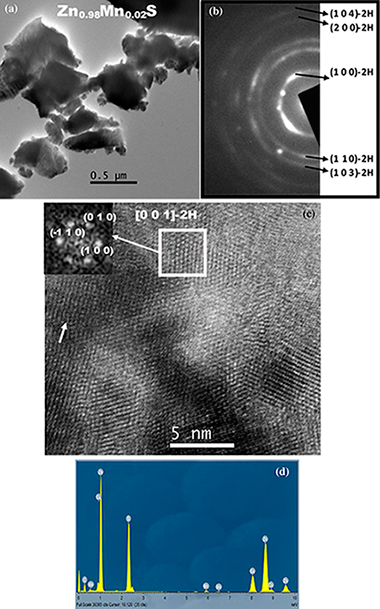
The mechanochemical process denoted as a mechanically induced self-sustaining reaction was successfully applied in obtaining Mn-doped ZnS samples with Mn content between 0 and 5 mol%. The process consists in milling Zn/Mn/S powder elemental mixtures with the appropriate stoichiometry, which promotes after approximately 80 min the induction of a combustion reaction. The doping level was properly adjusted by controlling the atomic ratio of the starting mixture. A complete characterization of samples was carried out, including X-ray diffraction, high-resolution transmission electron microscopy, selected area electron diffraction, energy-dispersive X-ray spectroscopy, Raman spectroscopy, diffuse reflectance UV-Vis spectroscopy and emission and excitation photoluminescence measurements. A wurtzite structure, in which Mn2+ replaces Zn2+, was obtained with a nanometric character. The photoluminescence of samples showed the characteristic (Mn2+T1)-T-4-(6)A(1) emission that was highly dependent on the doping level. The maximum luminescence efficiency through the ZnS excitation was found for a doping value of 1 mol%. The photoluminescence showed virtually no contribution from the host emission, which confirmed that samples were properly doped.
Febrero, 2020 | DOI: 10.1007/s10853-019-04138-8
Materiales Avanzados
New waste-based clinkers for the preparation of low-energy cements. A step forward toward circular economy
Martinez-Martinez, S; Perez-Villarejo, L; Eliche-Quesada, D; Sanchez-Soto, PJ; Christogerou, A; Kanellopoulou, DG; Angelopoulos, GNInternational Journal of Applied Ceramic Technology, 17 (2020) 12-21
This paper describes the use of industrial wastes arising from different production processes of the ceramic and marble industries as raw materials for the design and formulation of new cement clinkers with a high content of dicalcium silicate (Belite). The aim was to reintroduce these wastes in the industrial sector and take advantage of them for a greater environmental benefit, as indicated by the principles of the circular economy. Formulations containing 2.5, 5 and 10 wt% of chamotte and marble sludge, respectively, and a waste-free formulation have been designed to obtain clinkers with a content of dicalcium silicate higher than 60 wt%. The different blends have been studied up to a maximum temperature of 1390 degrees C by Thermal Analysis. Other techniques such as XRD, XRF, Modified Bogue Equation, Quality Indexes (LSF, AM, SM) and Optical Microscopy have been used for the study and characterization of industrial wastes, the raw materials and the high belite-type cement dosages. The results indicate that this type of cements can be designed using different types of wastes and in this way reduce the environmental impacts caused by the extraction of raw materials and the deposition of the wastes in landfills, improving the circular economy of the construction industry.
Enero, 2020 | DOI: 10.1111/ijac.13390
Reactividad de Sólidos
Processing and properties of Bi0.98R0.02FeO3 (R = La, Sm, Y) ceramics flash sintered at similar to 650 degrees C in <5 s
Gil-Gonzalez, E; Perejon, A; Sanchez-Jimenez, PE; Raj, R; Perez-Maqueda, LAJournal of the American Ceramic Society, 103 (2020) 136-144

We show that flash sintering produces single‐phase, nanograin‐sized polycrystals of isovalent‐substituted multiferroic ceramics of complex compositions. Single‐phase polycrystals of Bi0.98R0.02FeO3 (R = La, Sm, Y) were produced at a furnace temperature of ~650°C in a few seconds by the application of an electric field of 50 V cm−1, with the current limit set to 40 mA mm−2. The dielectric and insulating properties compared favorably with expected values. Impedance spectroscopy suggests electrically homogenous microstructure, except for the sample Bi0.98La0.02FeO3 that shows a small grain boundary contribution to the impedance. These results reinforce the enabling nature of flash sintering for ceramics which pose difficulties in conventional sintering because they contain low melting constituents or develop secondary phases during the sintering protocol.
Enero, 2020 | DOI: 10.1111/jace.16718
Reactividad de Sólidos
Obituary: Prof. José Manuel Criado
Perez-Maqueda, LA; Real, C; Gotor, FJ; Alcala, MD; Malek, J; Koga, NJournal of Thermal Analysis and Calorimetry, (2020)
Reactividad de Sólidos
Development of Ti(C,N)-based cermets with (Co,Fe,Ni)-based high entropy alloys as binder phase
de la Obra, AG; Sayagues, MJ; Chicardi, E; Gotor, FJJournal of Alloys and Compounds, 814 (2020) 152218
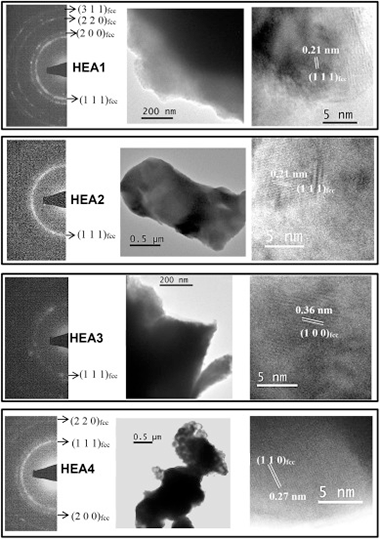
High entropy alloys have been proposed as novel binder phases in cemented carbides and cermets. Many aspects related to the stability of these alloys during the liquid phase sintering process are still unclear and were addressed in this work. Consolidated Ti(C,N)-based cermets using four different (Co,Fe,Ni)based high entropy alloys as the binder phase were obtained. The chosen alloys - CoCrCuFeNi, CoCrFeNiV, CoCrFeMnNi and CoFeMnNiV - were previously synthesized through mechanical alloying and a single alloyed solid solution phase with fcc structure and nanometric character was always obtained. The powdered alloys and the consolidated cermets were analyzed by X-ray diffraction, scanning electron microscopy, X-ray energy dispersive spectrometry and transmission electron microscopy. Differential thermal analysis was employed to determine the melting point of the four high entropy alloys that ranged between 1310 degrees C and 1375 degrees C. Although a high temperature of 1575 degrees C was required to obtain the highest cermet densification by pressureless sintering, porosity still remained in most of the cermets. Best densification was achieved when CoCrFeNiV was used as the binder phase. During liquid phase sintering, different compositional changes were observed in the ceramic and binder phases. A core-rim microstructure was observed in cermets containing V in the alloys (CoCrFeNiV and CoFeMnNiV), since this element was incorporated to the carbonitride structure during sintering. A slight Cr segregation was detected in cermets containing Cr, leading to CrTi-rich alloys in small binder regions. However, a great Cu segregation was produced when CoCrCuFeNi was used, and the formation of two different fcc alloys -a Cu-rich and a Cu-depleted- was observed. Finally, a loss of Mn was also evidenced in CoCrFeMnNi and CoFeMnNiV, probably due to its sublimation at the sintering temperature.
Enero, 2020 | DOI: 10.1016/j.jallcom.2019.152218
Reactividad de Sólidos
Influence of DSC thermal lag on evaluation of crystallization kinetics
Svoboda, R; Maqueda, LP; Podzemna, V; Perejon, A; Svoboda, OJournal of Non-Crystalline Solids, 528 (2020) 119738
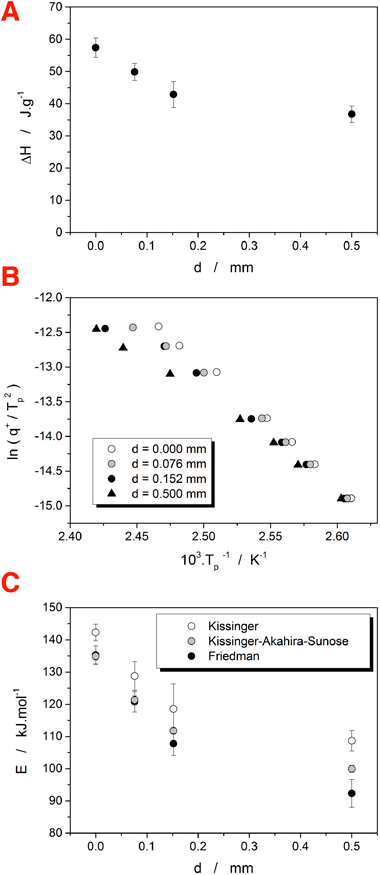
Influence of added thermal resistance on crystallization kinetics, as measured by differential scanning calorimetry (DSC), of the Se70Te30 glass was studied. The increase of thermal resistance was achieved by adding polytetrafluorethylene discs of different thicknesses (up to 0.5 mm) in-between the DSC platform and the pan with sample. Increase of the thermal resistance led to an apparent decrease (by more than 30%) in the crystallization enthalpy. Significant change of model-free kinetics occurred: apparent activation energy E of the crystallization process decreased (by more than 20%) due to the DSC data being progressively shifted to higher temperatures with increasing heating rate. The model-based kinetics was changed only slightly; the DSC peaks retained their asymmetry and the choice of the appropriate model was not influenced by the added thermal resistance. The temperature shift caused by added thermal lag was modeled for the low-to-moderate heating rates.
Enero, 2020 | DOI: 10.1016/j.jnoncrysol.2019.119738
2019
2019
Reactividad de Sólidos
Low temperature synthesis of an equiatomic (TiZrHfVNb)C5 high entropy carbide by a mechanically-induced carbon diffusion route
Chicardi, E; Garcia-Garrido, C; Gotor, FJCeramics International, 45 (2019) 21858-21863
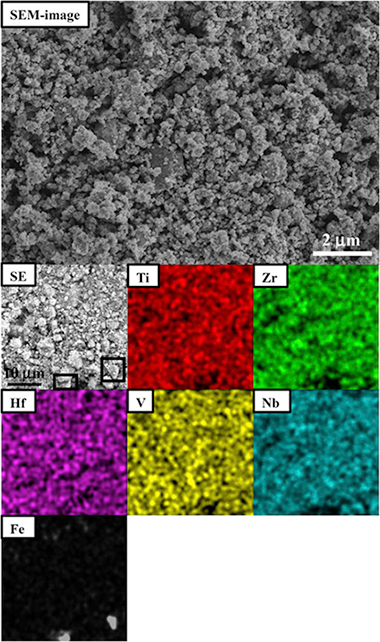
A novel, homogeneous, nanostructured and equiatomic (TiZrHfVNb)C-5 High Entropy Carbide (HEC) was successfully synthesised in a powder form by a mechanosynthesis process from the elemental mixture. This synthesis method for HECs, not previously reported, is simple, reproducible and carried out at room temperature. During milling, the transition metals (Ti, Zr, Hf, V and Nb) alloying and the diffusion of carbon (introduced as graphite) into the alloy structure are simultaneously induced, obtaining the expected (TiZrHfVNb)C-5 HEC. The room temperature method employed contrasts with those reported in the bibliography from binary carbides that are carried out at a very high temperature (1800-2200 degrees C), with the consequent energy savings.
Diciembre, 2019 | DOI: 10.1016/j.ceramint.2019.07.195
Reactividad de Sólidos
Design of highly stabilized nanocomposite inks based on biodegradable polymer-matrix and gold nanoparticles for Inkjet Printing
Begines, Belen; Alcudia, Ana; Aguilera-Velazquez, Raul; Martinez, Guillermo; He, Yinfeng; Wildman, Ricky; Sayagues, Maria-Jesus; Jimenez-Ruiz, Aila; Prado-Gotor, RafaelScientific Reports, 9 (2019) 16097
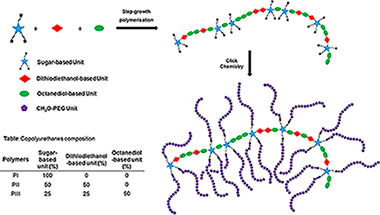
Nowadays there is a worldwide growing interest in the Inkjet Printing technology owing to its potentially high levels of geometrical complexity, personalization and resolution. There is also social concern about usage, disposal and accumulation of plastic materials. In this work, it is shown that sugar-based biodegradable polyurethane polymers exhibit outstanding properties as polymer-matrix for gold nanoparticles composites. These materials could reach exceptional stabilization levels, and demonstrated potential as novel robust inks for Inkjet based Printing. Furthermore, a physical comparison among different polymers is discussed based on stability and printability experiments to search for the best ink candidate. The University of Seville logo was printed by employing those inks, and the presence of gold was confirmed by ToF-SIMS. This approach has the potential to open new routes and applications for fabrication of enhanced biomedical nanometallic-sensors using stabilized AuNP.
Noviembre, 2019 | DOI: 10.1038/s41598-019-52314-2
Reactividad de Sólidos
Graphene nanoplatelets for electrically conductive 3YTZP composites densified by pressureless sintering
Lopez-Pernia, C; Gallardo-Lopez, A; Morales-Rodriguez, A; Poyato, RJournal of the European Ceramic Society, 39 (2015) 4435-4439
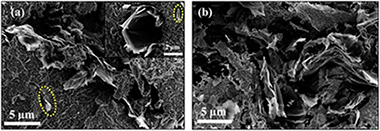
3 mol% yttria tetragonal zirconia polycrystalline (3YTZP) ceramic composites with 2.5, 5 and 10 vol% graphene nanoplatelets (GNP) were pressureless sintered in argon atmosphere between 1350 and 1450 degrees C. The effects of the GNP content and the sintering temperature on the densification, microstructure and electrical properties of the composites were investigated. An isotropic distribution of GNP surrounding ceramic regions was exhibited regardless the GNP content and sintering temperature used. Electrical conductivity values comparable to the ones of fully dense composites prepared by more complex techniques were obtained, even though full densification was not achieved. While the composite with 5 vol% GNP exhibited electrical anisotropy with a semiconductor-type behaviour, the composite with 10 vol% GNP showed an electrically isotropic metallic-type behaviour.
Noviembre, 2019 | DOI: 10.1016/j.jeurceramsoc.2019.05.067
Materiales Avanzados
Phyllite clays as raw materials replacing cement in mortars: Properties of new impermeabilizing mortars
Arce, Carolina; Garzon, Eduardo; Sanchez-Soto, Pedro J.Construction and Building Materials, 224 (2019) 348-358
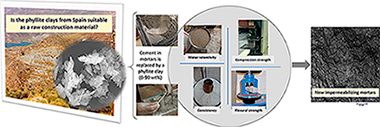
The aim of this investigation was to determine the suitability of phyllite clays as a raw construction material. For that purpose, the cement in mortars was replaced by a phyllite clay (0–90 wt%) making this study the first of its kind to be performed. These materials were prepared with different water proportions according to the water content and water/cement and water/binder (cement plus phyllite clay) relationships. A comparative study of the most important properties of the resulting experimental mortars was carried out, such as apparent density, water retentivity, consistency and mechanical strength (flexural and compressive strength), along with an evaluation of the pozzolanic activity and permeability. The results showed that the increase of phyllite decreases the apparent density, the consistency and mechanical properties of the mortar, while water retentivity fluctuates. Good correlations (R2 > 0.84) were obtained between flexural and compressive strength for the mortars after 28 days of curing. Pozzolanic activity was observed at cement replacement of 80 wt% of phyllite. Moreover, new impermeabilizing mortars constituted by phyllite clay and cement have been obtained according to the low coefficients of permeability. Taking into account the findings of this research, phyllite clays can be applied as raw construction materials with savings derived from replacing cement in mortars and the low energy consumption involved in their production. However, the present study concluded that the use of phyllite clays did not improve the mechanical strength of these new mortars but, in contrast, they can be applied for impermeabilization purposes in Construction and Civil Engineering.
Noviembre, 2019 | DOI: 10.1016/j.conbuildmat.2019.07.081
Reactividad de Sólidos
Influence of pre-deformation on the precipitation hardening in Cu-Ni-Si alloy
Donoso, E; Dianez, MJ; Criado, JMRevista de Metalurgia, 55 (2019) e157
The effects of pre-deformation on the precipitation processes in a Cu-2.8 Ni-1.4 Si (at.%) alloy were studied using differential scanning calorimetric (DSC), transmission electron microscopy (TEM) and microhardness measurements. The calorimetric curves shows the presence of one exothermic reaction attributed to the formation of delta-Ni2Si precipitates in the copper matrix that was confirmed by TEM. In addition it can be observed that the temperature of the maximum of the DSC peak decreases with the increase of the pre-deformation to the aging treatments. The activation energies calculated for the precipitation of by the Kissinger method, were similar to those calculated by an Arrhenius function, from the maximum hardening of the matrix due to aging treatments (saturation of the hardness during isothermal aging). The analysis of the microhardness measurements together with the calorimetric curves and the TEM micrographs confirm, on the one hand, that the formation of the delta-Ni2Si phase, during the aging treatments, are responsible for the hardening of the copper matrix, and on the other hand that the deformation prior to the aging treatment partially inhibits the formation of the precipitates.
Octubre, 2019 | DOI: 10.3989/revmetalm.157
Reactividad de Sólidos
The influence of mechanical activation process on the microstructure and mechanical properties of bulk Ti2AlN MAX phase obtained by reactive hot pressing
Salvo, C; Chicardi, E; Garcia-Garrido, C; Jimenez, JA; Aguilar, C; Usuba, J; Mangalaraja, RVCeramics International, 45 (2019) 17793-17799

The effect of mechanical activation process on the microstructure and mechanical properties of bulk nanostructured Ti2AlN compound has been investigated in this work. The mixture of Ti and AlN powders was prepared in a 2:1 molar ratio, and a part of this powder was subjected to a high-energy milling process under argon atmosphere for 10 h using agate as grinding media. Finally, the densification and formation of the ternary Ti2AlN MAX phase through solid state reaction of both unmilled and milled powders were carried out by hot pressing under 15 or 30 MPa at 1200 degrees C for 2 h. The microstructure of precursor powder mixtures and the consolidated samples was characterized by using X-ray diffraction (XRD) and a scanning electron microscope equipped with an energy dispersive X-ray spectroscopy (SEM/EDS). The X-ray diffraction patterns were fitted using the Rietveld refinement for phase quantification and to determine their most important microstructural parameters. Microstructure and mechanical properties of the consolidated samples were correlated with the load used for the hot pressing process. The substantial increase of hardness, the higher densification and the lower grain sizes observed in the samples prepared from the activated powders were attributed to the formation of second phases like Ti5Si3 and Al2O3.
Octubre, 2019 | DOI: 10.1016/j.ceramint.2019.05.350
Propiedades mecánicas, modelización y caracterización de cerámicos avanzados
Sintering kinetics, defect chemistry and room-temperature mechanical properties of titanium nitride prepared by spark plasma sintering
Chavez, JMM; Moshtaghioun, BM; Hernandez, FLC; Garcia, DGJournal of Alloys and Compounds, 807 (2019) 151666
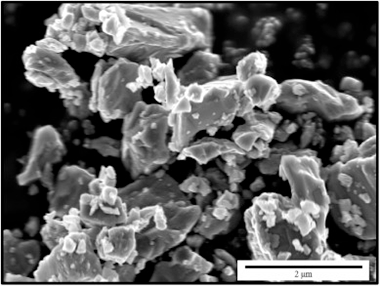
Fully dense titanium nitride polycrystals have been prepared by spark plasma sintering. The kinetics of the sintering process and the optimized conditions for SPS processing have been put forward. Microstructural analyses of the resulting samples have unambiguously shown the coexistence of titanium as Ti2+, Ti3+ and Ti4+, thus driving the presence of cation vacancies. This fact is a new ingredient which is shown to influence the mechanical properties of this strategic ceramic.
Octubre, 2019 | DOI: 10.1016/j.jallcom.2019.151666
Reactividad de Sólidos
The Calcium-Looping (CaCO3/CaO) process for thermochemical energy storage in Concentrating Solar Power plants
Ortiz, C; Valverde, JM; Chacartegui, R; Perez-Maqueda, LA; Gimenez, PRenewable & Sustanaible Energy Reviews, 113 (2019) 109252

Energy storage based on thermochemical systems is gaining momentum as a potential alternative to molten salts in Concentrating Solar Power (CSP) plants. This work is a detailed review about the promising integration of a CaCO3/CaO based system, the so-called Calcium-Looping (CaL) process, in CSP plants with tower technology. The CaL process relies on low cost, widely available and non-toxic natural materials (such as limestone or dolomite), which are necessary conditions for the commercial expansion of any energy storage technology at large scale. A comprehensive analysis of the advantages and challenges to be faced for the process to reach a commercial scale is carried out. The review includes a deep overview of reaction mechanisms and process integration schemes proposed in the recent literature. Enhancing the multicycle CaO conversion is a major challenge of the CaL process. Many lab-scale analyses carried out show that residual effective CaO conversion is highly dependent on the process conditions and the CaO precursors used, reaching values in a wide range (0.07–0.82). The selection of the optimal operating conditions must be based on materials performance, process integration, technology and economics aspects. Global plant efficiencies over 45% (without considering solar-side losses) show the interest of the technology. Furthermore, the technological maturity and potential of the process is assessed. The direction towards which future works should be headed is discussed.
Octubre, 2019 | DOI: 10.1016/j.rser.2019.109252
Reactividad de Sólidos
A QTAIM and DFT study of the dizinc bond in non-symmetric [CpZn2Ln] complexes
Ayala, R; Galindo, AJournal of Organometallic Chemistry, 898 (2019) UNSP 120878
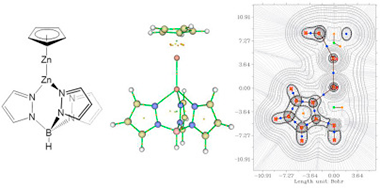
Several [Zn2L2] and [CpZn2Ln] dizinc compounds have been studied by density functional theory (DFT) and quantum theory of atoms in molecules (QTAIM) in order to compare the nature and topology of the Zn-Zn bond in symmetrical and non-symmetrical complexes. The stability of these complexes have been evaluated on the basis of the formation energies. The disproportionation reaction has also been analysed indicating that symmetric complexes are less stable than non-symmetric ones. To certain extent, the properties of the [CpZn2Ln] complexes are between those of the [Zn2L2] and [Zn2Cp2] compounds. The asymmetry of the [CpZn2Ln] compounds is illustrated in terms of the topological properties, especially in the Source Function (SF) and Natural Bond Orbital (NBO) analysis.
Octubre, 2019 | DOI: 10.1016/j.jorganchem.2019.120878
Reactividad de Sólidos
Mechanically induced combustion synthesis and thermoelectric properties of nanostructured strontium hexaboride (SrB6)
Jalaly, M; Khosroshahi, BK; Gotor, FJ; Sayagues, MJ; Yamini, SA; Failamani, F; Mori, TCeramics International, 45 (2019) 14426-14431

The nanoparticles of strontium hexaboride (SrB6) were synthesized by a mechanically induced magnesiothermic combustion in the Mg/B2O3/SrO system. Ignition time in this system was recorded to be 23 min of milling. X-ray diffraction(XRD), X-ray photoelectron spectroscopy (XPS), and high-resolution transmission electron microscopy (HRTEM) techniques were used to characterize the combustion product. Thermal analysis was employed to assess the formation mechanism. It was revealed that Mg initially reduced B2O3 in a combustive manner to generate elemental boron and a large amount of heat, resulting in the reduction of SrO by Mg at high temperature. The in-situ formed elemental Sr and B react immediately to generate SrB6. Thermoelectric properties of consolidated SrB6, including thermal conductivity, Seebeck coefficient, electrical conductivity, and figure-of-merit were evaluated at the temperature range of 300–873 K.
Agosto, 2019 | DOI: 10.1016/j.ceramint.2019.04.163
Química de Superficies y Catálisis - Reactividad de Sólidos
Influence of the preparation method in the metal-support interaction and reducibility of Ni-Mg-Al based catalysts for methane steam reforming
Azancot, L; Bobadilla, LF; Santos, JL; Cordoba, JM; Centeno, MA; Odriozola, JAInternational Journal of Hydrogen Energy, 44 (2019) 19827-19840
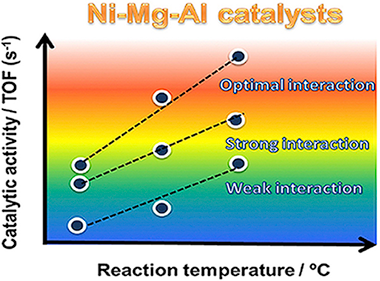
Ni-Mg-Al based catalysts were prepared using different preparation methods (impregnation, impregnation-coprecipitation and coprecipitation) and tested in steam reforming of methane. The differences observed in catalytic activity were directly correlated to the physicochemical properties and the different degree of Ni-Mg-Al interaction. The reducibility results showed that the catalyst prepared by the impregnation-coprecipitation method presented the most optimal metal-support interaction to reduce the NiO preserving the Ni-0 particles highly dispersed on the support surface. These results demonstrate that the structure and catalytic performance of Ni-Mg-Al based catalysts can be tuned by controlling the metal-support interaction through of the preparation method.
Julio, 2019 | DOI: 10.1016/j.ijhydene.2019.05.167
Reactividad de Sólidos
Effects of Boron Addition on the Microstructure and Mechanical Properties of (Ti,Ta)(C,N)-Co Based Cermets
Chicardi, E; Martinez, FJGMetals, 9 (2019) art. 787
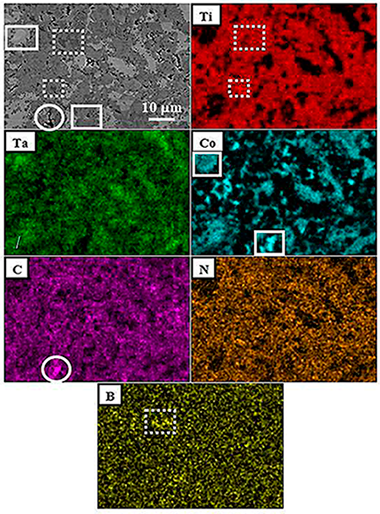
In this work, a titanium-tantalum carbonitride based cermet, with cobalt as the binder phase and boron as a sintering additive, was developed by a mechanically induced self-sustaining reaction process using two different methodologies. The boron additive was added to prevent the formation of brittle intermetallic compounds generally formed during the liquid phase sintering step due to the excessive ceramic dissolution into the molten binder phase. A systematic study was carried out to understand the effects of boron addition on the nature of the phases, microstructure, and mechanical properties of cermets. With the boron addition, the formation of two different boride solid solutions, i. e., (Ti, Ta)B-2 and (Ti, Ta)(3)B-4, was observed. Moreover, the nature of the binder was also modified, from the (Ti, Ta)Co-2 brittle intermetallic compound (for cermets without boron addition) to ductile and tough (Ti, Ta)Co-3 and alpha-Co phases (for cermets with boron addition). These modifications caused, as a general trend, the increase of hardness and toughness in cermets.
Julio, 2019 | DOI: 10.3390/met9070787
Propiedades mecánicas, modelización y caracterización de cerámicos avanzados
Does grain size have an influence on intrinsic mechanical properties and conduction mechanism of near fully-dense boron carbide ceramics?
Moshtaghioun, BM; Laguna-Bercero, MA; Gomez-Garcia, D; Pena, JIJournal of Alloys and Compounds, 795 (2019) 408-415
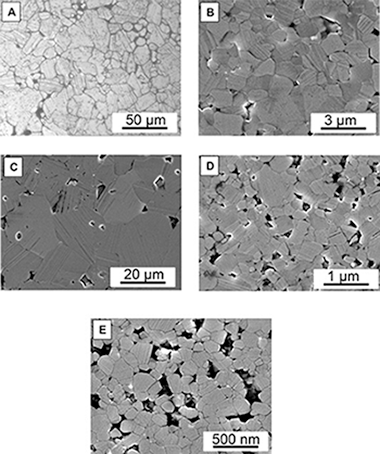
This work is concentrated on getting a reply to the following question: how does the grain size of boron carbide specimens influence on their mechanical and electrical response? It is a common issue that both essential properties are usually affected by the grain boundaries. To this purpose, a set of near fully-dense boron carbide specimens were prepared by spark plasma sintering. In order to reduce residual porosity and grain-size effects, nanoindentation tests at room temperature were conducted. DC conductivity was measured through four-point test technique from room temperature up to 800 °C. The results show that hardness can reach values as high as ∼60 GPa and plasticity onset takes place at around 23 GPa by dislocation nucleation. Regarding the conductivity, it is found that grain boundaries can block the mobility of bipolarons in an effective way. A simple additive law is provided to account for the resistivity of boron carbide polycrystals.
Julio, 2019 | DOI: 10.1016/j.jallcom.2019.05.037
Laboratory multi-technique study of Spanish decorated leather from the 12th to 14th centuries
Franquelo, ML; Duran, A; Perez-Rodriguez, JLSpectrochimica Acta Part A: Molecular and Biomolecular Spectroscopy, 218 (2019) 331-341
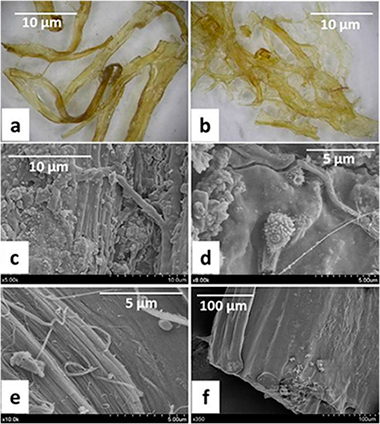
This work comprises an exhaustive study of Spanish decorative leathers dating from the 12th to 14th centuries. These paintings are considered a key example of a crucible of artistic styles: Gothic, Islamic and Florentine Trecento. The goal of this work was to use the scientific information provided by a number of experimental techniques – namely EDX, micro-FTIR, micro-Raman and micro-XRD – to assess the dating of the wooden vault, leather preparation and filling fibres. Another goal was to assess the artistic technique based on the characterization of pigments and the differentiation between original materials and those added throughout its history. Gypsum was the original preparation layer extended over the leather. A new preparation stratum was added in further interventions with the artwork. The original pictorial materials and those used during refurbishments have been identified. Original pigments were: red lead, Mars red, red lake, cinnabar, lapis lazuli, red ochres, raw sienna, white lead and charcoal black. Gilding was also found. Pigments added during restoration were: barite, emerald green, rutile, anatase, Mars red, cadmium red, lithopone, cadmium yellow, charcoal black and orpiment.
Julio, 2019 | DOI: 10.1016/j.saa.2019.04.012
Materiales Avanzados
Microbiological induced carbonate (CaCO3) precipitation using clay phyllites to replace chemical stabilizers (cement or lime)
Morales, L; Garzon, E; Romero, E; Sanchez-Soto, PJApplied Clay Science, 174 (2019) 15-28

The objective of the present study is to develop a biotechnological tool for a new application of clay phyllites as stabilized materials in linear works replacing chemical stabilizer (e.g. cement or lime) by natural cement, formed by precipitated calcium carbonate generated by microorganisms of the Bacillaceae family (Bacilluspasteurii). Part of the development process conducting a chemical and mineralogical characterization and an examination of physical and hydromechanical properties. The results of this study show that the effect of bacteria on clay phyllites increases the calcium carbonate content, specific surface area and plasticity values. These increased values are caused by the addition of a non-plastic component to clay phyllites resulting in a more aggregated structure through the precipitation of calcium carbonate from the bacteria, ultimately filling the pores of this material. Microbiological treatments on clay phyllites tends to aggregate the original particles, creating aggregates that are partially associated with the formation of calcium carbonate. Said process is influenced by the curing and compaction procedures conducted on samples, which also cause breakage of carbonated structures formed during treatment. As a result of this breaking process of aggregates, some compaction energy is lost and the treated samples do not reach the maximum dry density of the natural state for the same level of compaction energy applied. Treated samples display a slightly larger friction angle with no cohesion, consistent with filling properties and denser condition. Compressibility is consistently lower than that of the natural state. Comparison of collapse data showsthat the occurrence and amount of collapse are controlled by the as-compacted dry density. It is also determined that higher compaction effort is even more effective than increasing the amount of bacteria introduced to stabilize the sample for the filling of pores (size ranges 3–50 μm) with calcium carbonate. However, the post-ageing compaction destroys the initial binding/cementation effect.
Junio, 2019 | DOI: 10.1016/j.clay.2019.03.018
Reactividad de Sólidos
Manufacturing optimisation of an original nanostructured (beta plus gamma)-TiNbTa material
Garcia-Garrido, C; Gutierrez-Gonzalez, C; Torrecillas, R; Perez-Pozo, L; Salvo, C; Chicardi, EJournal of Materials Research and Technology-JMR&T, 8 (2019) 2573-2585
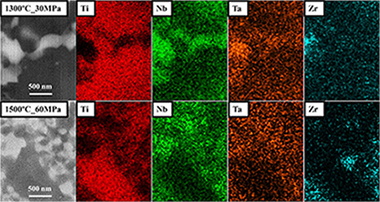
An original (beta + gamma)-TiNbTa material was manufactured by an optimised powder metallurgy treatment, based on a mechanical alloying (MA) synthesis, carried out at low energy, and a subsequently field assisted consolidation technique, the pulsed electric current sintering (PECS). The successful development of this (beta + gamma)-TiNbTa material was possible by the optimisation of the milling time (60 h) for the MA synthesis and the load and sintering temperature for the PECS (30 MPa and 1500 degrees C), as key parameters. Furthermore, the selected heating and cooling rates were 500 degrees C min(-1) and free cooling, respectively, to help maintain the lowest particle size and to avoid the formation of a detrimental high stiffness, hexagonal (alpha)-Ti alloy. All these optimised experimental conditions enabled the production of a full densified (beta + gamma)-TiNbTa material, with partially nanostructured areas and two TiNbTa alloys, with a body centred cubic (beta) and a novel face-centred cubic (gamma) structures. The interesting microstructural characteristics gives the material high hardness and mechanical strength that, together with the known low elastic modulus for the beta-Ti alloys, makes them suitable for their use as potential biomaterials for bone replacement implants.
Mayo, 2019 | DOI: 10.1016/j.jmrt.2019.03.004
Reactividad de Sólidos
Effect of heat treatment on apatite coatings deposited on pre-calcified titanium substrates
Beltran, AM; Martin-Santana, Y; Gonzalez, JE; Montealegre-Melendez, I; Gonzalez, E; Peon-Aves, E; Gotor, FJ; Torres, YInternational Journal of Materials Research, 110 (2019) 351-358
Titanium and its alloys are considered interesting materials for endosseous implants. However, they still present drawbacks related to their in-vivo behavior that can be overcome by coatings, such as apatite. This work focuses on the deposition of apatite coatings on commercially pure titanium (grade II) substrates previously pre-calcified. The influence of the temperature used in the thermal treatment on the microstructure and tribo-mechanical surface properties was analyzed. The coatings were structurally and chemically characterized and their tribo-mechanical behavior was evaluated. The nano-apatite coatings were only formed on surfaces with successive treatments in NaOH and CaCl2 solutions. In addition, scratch tests showed that after the heat treatment the nanoapatite coatings had high bond strength to the substrate.
Abril, 2019 | DOI: 10.3139/146.111746
Reactividad de Sólidos
Tribological behavior of graphene nanoplatelet reinforced 3YTZP composites
Gutierrez-Mora, F; Morales-Rodriguez, A; Gallardo-Lopez, A; Poyato, RJournal of the European Ceramic Society, 39 (2019) 1381-1388
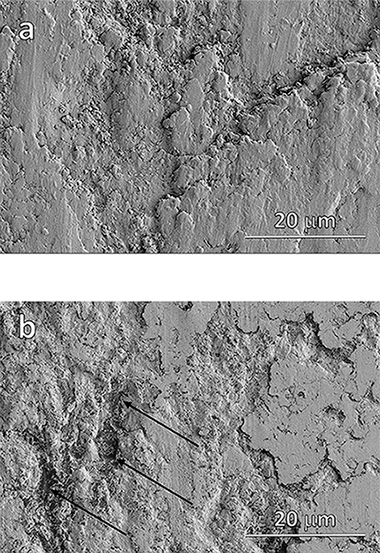
The tribological behavior of graphene nanoplatelet (GNP) reinforced 3 mol% yttria tetragonal zirconia polycrystals (3YTZP) composites with different GNP content (2.5, 5 and 10 vol%) was analyzed and discussed. Their dry sliding behavior was studied using a ball-on-disk geometry with zirconia balls as counterparts, using loads between 2 and 20 N at ambient conditions and compared to the behavior of a monolithic 3YTZP ceramic used as a reference material. The composites showed lower friction coefficients and higher wear resistance than the monolithic 3YTZP. An outstanding performance was achieved at 10 N, where the friction coefficient decreased from 0.6 to 0.3 and the wear rates decreased 3 orders of magnitude in comparison with the monolithic ceramic. A layer adhered to the worn surface was found for all the composites, but it did not acted as a lubricating film. The composites with the lowest GNP content showed an overall improved tribological behavior.
Abril, 2019 | DOI: 10.1016/j.jeurceramsoc.2018.11.005
Reactividad de Sólidos
A theoretical study of the bonding capabilities of the zinc-zinc double bond
Ayala, R; Galindo, AInternational Journal of Quantum Chemistry, 119 (2019) e25823
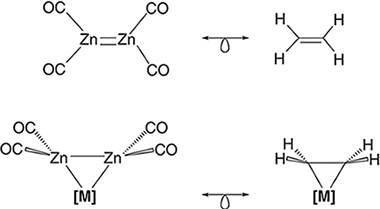
The theoretical knowledge about the zinc-zinc bond has been recently expanded after the proposal of a zinc-zinc double bond in several [Zn-2(L)(4)] compounds (Angew. Chem. Int. Ed.2017, 56, 10151-10155). Prompted by these results, we have selected the [Zn-2(CO)(4)] species, isolobally related to ethylene, and theoretically investigated the possible (2)-Zn-2-coordination to several first-row transition metal fragments. The [Zn-2(CO)(4)] coordination to the metal fragment produces an elongation of the dizinc bond and a concomitant pyramidalization of the [Zn(CO)(2)] unit. These structural parameters are indicative of -backdonation from the metal to the coordinated dizinc moiety, as occurred with ethylene ligand. A quantum theory of atoms in molecules study of the ZnZn bond shows a decrease of (BCP), delta(2)(BCP) (ZnZn) and delocalization indexes (Zn,Zn), relative to corresponding values in the parent [Zn-2(CO)(4)] molecule. The ZnZn and MZn bonds in these [((2)-Zn-2(CO)(4))M(L)(n)] complexes can be described as shared interactions with an important covalent component where the ZnZn bond is preserved, albeit weakened, upon coordination.
Marzo, 2019 | DOI: 10.1002/qua.25823
Degradation processes of historic metal threads used in some Spanish and Portuguese ornamentation pieces
Duran, A; Perez-Maqueda, R; Perez-Rodriguez, JLJournal of Cultural Heritage, 36 (2019) 135-142

The degradation processes that occurred on metal threads applied in the embroidery used for clothing and in the ornamentation of sculptures, the Sevillian Holy Week processions, and Portuguese and Spanish palace and museum are thoroughly analyzed. Some threads from the 14th and 18–19th centuries were considered. In the metal threads, sulphur- and chlorine-based compounds were detected either individually or together, depending on the degradation process. Basic silver carbonate, sodium bicarbonate and copper-based compounds were also observed. The different degradation processes were attributed to different factors, such as environmental contamination, degradation of the fibrous cores, and inadequate cleaning and/or mechanical treatments.
Marzo, 2019 | DOI: 10.1016/j.culher.2018.09.006
Reactividad de Sólidos
Sample-Controlled analysis under high pressure for accelerated process studies
Perejon, A; Sanchez-Jimenez, PE; Soria-Hoyo, C; Valverde, JM; Criado, JM; Perez-Maqueda, LAJournal of the American Ceramic Society, 102 (2019) 1338-1346
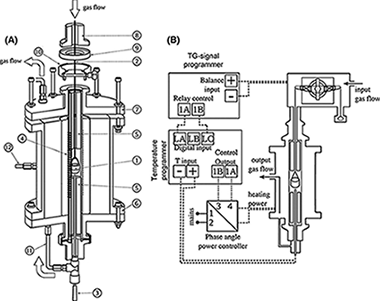
The potential of controlled rate thermal analysis (CRTA) for studying high-pressure gas-solid processes has been evaluated. CRTA is a type of smart temperature program based on a feedback system that uses any experimental signal related to the process evolution for commanding the temperature evolution. In this work, an instrument that uses the gravimetric signal for CRTA control has been designed and used for the study of two high-pressure gas-solid reactions: the highly exothermic thermal oxidation of TiC under high pressure of oxygen and the reduction in Fe2O3 under high pressure of hydrogen. Advantages of CRTA for discriminating overlapping processes and appraising kinetic reaction mechanisms are shown.
Marzo, 2019 | DOI: 10.1111/jace.15960
Technological evolution of ceramic glazes in the renaissance: In situ analysis of tiles in the Alcazar (Seville, Spain)
de Viguerie, Laurence; Robador, Maria D.; Castaing, Jacques; Perez-Rodriguez, Jose L.; Walter, Philippe; Bouquillon, AnneJournal of the American Ceramic Society, 102 (2019) 1402-1413
The Alcazar Palace (Seville, Spain) is famous for its ceramic decorations; 16th century wall tiles of different typologies have been analyzed in order to relate the manufacturing process of their colored glazes to the evolving technologies of the Renaissance. Chemical and mineralogical compositions have been determined in situ by nondestructive X-ray fluorescence and X-ray diffraction on arista ceramics in the Cenador de Carlos Quinto, and majolica ceramics in the Palacio Gotico and the Royal oratory. The arista style belongs to the local Hispano-Moresque ceramic tradition. Majolica tiles have the complex microstructures of glazes from Italy. The two types are clearly differentiated by their typology, morphology (curved vs flat surface), and also microstructure (single vs multi-layers), glaze chemistry, and use of different coloring agents. Moreover, we found different glaze chemistries in the investigated majolicas, which correspond to different artists and/or practices.
Marzo, 2019 | DOI: 10.1111/jace.15955
Reactividad de Sólidos - Tribología y Protección de Superficies
Microstructure, interfaces and properties of 3YTZP ceramic composites with 10 and 20 vol% different graphene-based nanostructures as fillers
Munoz-Ferreiro, C; Morales-Rodriguez, A; Rojas, TC; Jimenez-Pique, E; Lopez-Pernia, C; Poyato, R; Gallardo-Lopez, AJournal of Alloys and Compounds, 777 (2019) 213-224
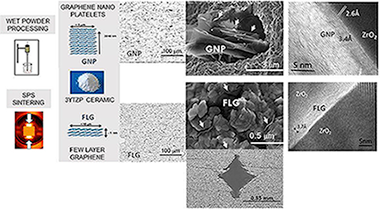
The graphene family comprises not only single layer graphene but also graphene-based nanomaterials (GBN), with remarkably different number of layers, lateral dimension and price. In this work, two of these GBN, namely graphene nanoplatelets (GNP) with n similar to 15-30 layers and few-layer graphene (FLG) with n < 3 layers have been evaluated as fillers in 3 mol% yttria stabilized tetragonal zirconia (3YTZP) ceramic composites. Composites with 10 and 20 vol% GNP or FLG have been fabricated by wet powder processing and spark plasma sintering (SPS) and the influence of the content and number of layers of the graphene-based filler has been assessed. For both graphene-based fillers, an intermediate zirconia oxycarbide has been detected in the grain boundaries. The lower stacking degree and much more homogeneous distribution of the FLG, revealed by transmission electron microscopy (TEM), can improve load transfer between the GBNs and the ceramic matrix. However, high FLG contents lower densification of the composites, due partly to the larger FLG interplanar spacing also estimated by TEM. The hardness (both Vickers and nanoindentation) and the elastic modulus decrease with increased GBN content and with improved graphene dispersion. The FLG greatly inhibit the crack propagation that occur perpendicular to their preferential orientation plane. The composites with thinner FLG have higher electrical conductivity than those with GNP. The highest electrical conductivity is achieved by composites with 20 vol% FLG in the direction perpendicular to the compression axis during sintering, sigma(perpendicular to) = 3400 +/- 500 Sm-1.
Marzo, 2019 | DOI: 10.1016/j.jallcom.2018.10.336
Reactividad de Sólidos
Anisotropic lattice expansion determined during flash sintering of BiFeO3 by in-situ energy-dispersive X-ray diffraction
Wassel, MAB; Perez-Maqueda, LA; Gil-Gonzalez, E; Charalambous, H; Perejon, A; Jha, SK; Okasinski, J; Tsakalakos, TScripta Materialia, 162 (2019) 286-291
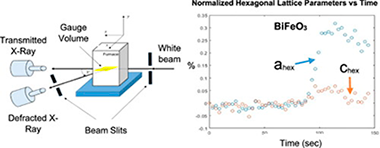
BiFeO3 has a Curie temperature (T-c) of 825 degrees C, making it difficult to sinter using conventional methods while maintaining the purity of the material, as unavoidably secondary phases appear at temperatures above T-c Flash sintering is a relatively new technique that saves time and energy compared to other sintering methods. BiFeO3 was flash sintered at 500 degrees C to achieve 90% densification. In-situ energy dispersive X-ray diffraction (EDXRD) revealed that the material did not undergo any phase transformation, having been sintered well below the Tc. Interestingly, anisotropic lattice expansion in the material was observed when the sample was exposed to the electric field.
Marzo, 2019 | DOI: 10.1016/j.scriptamat.2018.11.028
Reactividad de Sólidos
High-performance and low-cost macroporous calcium oxide based materials for thermochemical energy storage in concentrated solar power plants
Jimenez, PES; Perejon, A; Guerrero, MB; Valverde, JM; Ortiz, C; Maqueda, LAPApplied Energy, 235 (2019) 543-552
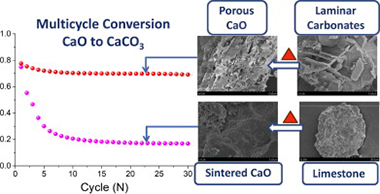
High energy density, cycling stability, low cost and scalability are the main features required for thermochemical energy storage systems to achieve a feasible integration in Concentrating Solar Power plants (CSP). While no system has been found to fully satisfy all these requirements, the reversible CaO/CaCO3 carbonation reaction (CaL) is one of the most promising since CaO natural precursors are affordable and earth-abundant. However, CaO particles progressively deactivate due to sintering-induced morphological changes during repeated carbonation and calcinations cycles. In this work, we have prepared acicular calcium and magnesium acetate precursors using a simple, cost-effective and easily scalable technique that requires just the natural minerals and acetic acid, thereby avoiding expensive reactants and environmentally unfriendly solvents. Upon thermal decomposition, these precursors yield a stable porous structure comprised of well dispersed MgO nanoparticles coating the CaO/CaCO3 grains that is resistant to pore-plugging and sintering while at the same time exhibits high long term effective conversion. Process simulations show that the employment of these materials could significantly improve the overall CSP-CaL efficiency at the industrial level.
Febrero, 2019 | DOI: 10.1016/j.apenergy.2018.10.131
Reactividad de Sólidos
Multicycle CO2 capture activity and fluidizability of Al-based synthesized CaO sorbents
Azimi, B; Tahmasebpoor, M; Sanchez-Jimenez, PE; Perejon, A; Valverde, JMChemical Engineering Journal, 358 (2019) 679-690

CaO-based materials have been identified as promising sorbents for highly efficient pre-combustion and post-combustion CO2 capture in fluidized beds operated at high temperatures by means of the Calcium Looping (CaL) process. However, Ca-based sorbents suffer from a decline of the capture capacity over multiple sorption/desorption cycles, mainly due to sintering, and from a markedly heterogeneous fluidization behavior due to the strength of interparticle attractive forces as compared to particle weight. The present study is focused on the development of novel synthetic CaO/Al2O3 sorbents for CO2capture with enhanced CaL performance and fluidizability by dry mixing with flow conditioner nanopowders. The influence of initial precursors on the sorbents multicycle activity at realistic CaL conditions has been investigated. The formation of a stable Ca9Al6O18 mixed-phase during the preparation of the sorbents promotes the multicycle capture capacity. The type of Ca and Al precursors, either soluble or insoluble, can significantly affect the dispersion of this stabilizer (Ca9Al6O18) in the sorbent matrix and, consequently, may affect the carbonation activity of the materials. The sorbent prepared from soluble aluminum nitrate and calcium nitrate precursors by sol-gel method exhibits a very stable multicycle capture capacity with a capture capacity around 0.2 g of CO2/g of sorbent after 21 cycles keeping a 72% of its initial capture capacity. The fluidizability of this promising sorbent was also investigated as affected by the addition of three different flow conditioners. Fluidization experiments confirmed the positive effect of using hydrophilic alumina and hydrophobic silica nanoparticles on improving the fluidizability of the synthesized sorbents.
Febrero, 2019 | DOI: 10.1016/j.cej.2018.10.061
Reactividad de Sólidos
Tailoring the Band Gap in the ZnS/ZnSe System: Solid Solutions by a Mechanically Induced Self-Sustaining Reaction
Aviles, MA; Cordoba, JM; Sayagues, MJ; Gotor, FJInorganic Chemistry, 58 (2019) 2565-2575
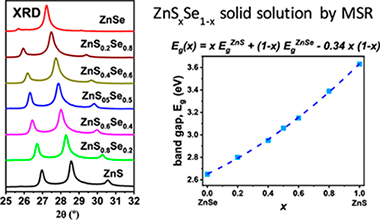
The complete ZnSxSe1-x solid solution was successfully obtained by the mechanochemical process denoted as a mechanically induced self-sustaining reaction. Excellent control of the chemical stoichiometry of the solid solution was possible by adjusting the atomic ratio of the starting Zn/S/Se elemental mixture subjected to milling. A mixture of both wurtzite-2H (hexagonal) and zinc blende (cubic) structures was always obtained, although for a similar milling time the proportion of the zinc blende structure increased with the Se content in the solid solution. However, wurtzite was the major phase for S-rich compositions when milling was stopped just after ignition. It was demonstrated that milling induces the wurtzite-to-zinc blende phase transition. The 8H hexagonal polytype was also observed in samples subjected to long milling times. Variation of the lattice parameters for both structures with the x value in the solid solution presented an excellent linearity, confirming the validity of Vegard's law. However, variation of the band-gap energy (E-g) with x was not perfectly linear, and a small bowing parameter of 0.34 was obtained. It was possible to tune the E-g value between those of the end members of the solid solution in a continuous manner by adjusting the stoichiometry of the solid solution. The morphology and crystalline domain size can also be controlled by adjusting, in this case, the postignition milling time of the mechanochemical process.
Febrero, 2019 | DOI: 10.1021/acs.inorgchem.8b03183
Reactividad de Sólidos
Insight into the BiFeO3 flash sintering process by in-situ energy dispersive X-ray diffraction (ED-XRD)
Perez-Maqueda, LA; Gil-Gonzalez, E; Wassel, MA; Jha, SK; Perejon, A; Charalambous, H; Okasinski, J; Sanchez-Jimenez, PE; Tsakalakos, TCeramics International, 45 (2019) 2828-2834

The sintering mechanism of BiFeO3 has been investigated in-situ by energy dispersive X-ray diffraction (ED-XRD) using a high-energy white collimated X-ray beam from the Advanced Photon Source (Argonne National Laboratories). Such radiation is very penetrating thereby allowing measurements of the sample even when placed inside the flash sintering set up. Additionally, the fast ED-XRD measurements permit monitoring the flash sintering process by providing information about phase composition and sample temperature in real time. Moreover, profile scans, obtained by moving the stage vertically while recording the ED-XRD spectra, permit investigating the homogeneity of the flash for the entire length of the sample. All experiments have been complemented by ex-situ studies. It has been concluded that flash sintering of BiFeO3 is a homogeneous process without any directionality effects. Furthermore, flash sintering takes place at quite low temperatures (below the Tc ≈ 830 °C), which may be related to the high quality of the samples, as pure, highly insulating ceramics without evidence of secondary phases with a homogenous nanostructured grain size distribution are obtained by this technique. Moreover, it is also evidenced that the rapid heating of the sample does not seem to justify, at least by itself, the densification process. Therefore, it appears that the electric current should play a role in the enhanced mobility during the sintering process.
Febrero, 2019 | DOI: 10.1016/j.ceramint.2018.07.293
Reactividad de Sólidos
Production of Ag-ZnO powders by hot mechanochemical processing
Guzman, D; Aguilar, C; Rojas, P; Criado, JM; Dianez, MJ; Espinoza, R; Guzman, A; Martinez, CTransactions of nonferrous metals society of China, 29 (2019) 365-373
Ag-CdO composites are still one of the most commonly used electrical contact materials in low-voltage applications owing to their excellent electrical and mechanical properties. Nevertheless, considering the restriction on using Cd due to its toxicity, it is necessary to find alternative materials that can replace these composites. In this study, the synthesis of Ag-ZnO alloys from Ag-Zn solid solutions was investigated by hot mechanochemical processing. The hot mechanochemical processing was conducted in a modified attritor mill at 138 degrees C under flowing O-2 at 1200 cm(3)/min for 3.0 h. The microstructure and phase evolution were investigated using X-ray diffractometry, field emission gun scanning electron microscopy and transmission electron microscopy. The results suggest that it is possible to complete the oxidation of Ag-Zn solid solution by hot mechanochemical processing at a low temperature and short time. This novel synthesis route can produce Ag-ZnO composites with a homogeneous distribution of nanoscale ZnO precipitates, which is impossible to achieve using the conventional material processing methods. Considering the fact that the fundamental approach to improving electric contact material performance resides in obtaining uniform dispersion of the second-phase in the Ag matrix, this new processing route could open the possibility for Ag-ZnO composites to replace non-environmentally friendly Ag-CdO.
Febrero, 2019 | DOI: 10.1016/S1003-6326(19)64946-0
Reactividad de Sólidos
Synthesis of a cubic Ti(BCN) advanced ceramic by a solid-gas mechanochemical reaction
Chicardi, E; Garcia-Garrido, C; Beltran, AM; Sayagues, MJ; Gotor, FJCeramics International, 45 (2019) 3878-3885
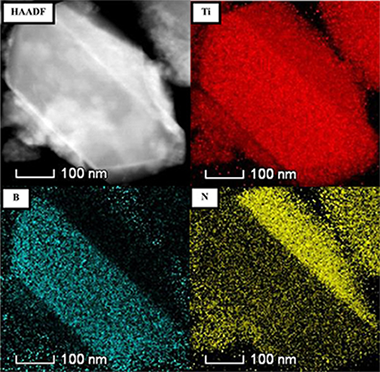
In this work, a titanium boron carbonitride advanced ceramic was successfully synthesised by a solid-gas mechanochemical reaction in a planetary ball mill from a mixture of elemental Ti, B, and C under nitrogen atmosphere. This material, with a general formula of Ti(BCN), exhibits a face-centred cubic structure (NaCl type) that is analogous to Ti(CN). This phase was gradually formed with sufficient milling time as a result of diffusional processes, which were permitted by the reduction of the energy in the system caused by the decrease in the spinning rate of the planetary ball mill. In contrast, under more energetic milling conditions, a mechanically induced self-sustaining reaction (MSR) took place, leading to the formation of a TiB2-Ti(CN) ceramic composite. The microstructural characterisation revealed that Ti(BCN) was composed of ceramic particles constituted of misoriented nanocrystalline domains. B, C and N were optimally distributed in the Ti(BCN) phase. The TiB2-Ti (CN) ceramic composite was composed of micrometric and nanometric particles homogeneously distributed. Additionally, the nitrogen content obtained for Ti(BCN) was higher than for the Ti(CN) phase in the composite material.
Febrero, 2019 | DOI: 10.1016/j.ceramint.2018.11.060
Reactividad de Sólidos
Mechanochemical combustion synthesis of vanadium carbide (VC), niobium carbide (NbC) and tantalum carbide (TaC) nanoparticles
Jalaly, M; Gotor, FJ; Sayagues, MJInternational Journal of Refractory Metals & Hard Materials, 79 (2019) 177-184

The nanoparticles of vanadium, niobium, and tantalum carbides were synthesized by a mechanically induced magnesiothermic combustion in the separate Mg/V2O5/C, Mg/Nb2O5/C, and Mg/Ta2O5/C systems. Initial materials in these systems ignited after short milling times of 10, 10, and 23 min, respectively. X-ray diffraction (XRD), X-ray photoelectron spectroscopy (XPS), energy-dispersive X-ray spectroscopy (EDS), high-resolution transmission electron microscopy (HRTEM) and elemental mapping techniques were employed to characterize the combustion products. In this process, magnesium reduces initial oxides to generate elemental V/Nb/Ta to react with carbon, forming the carbide phases.
Febrero, 2019 | DOI: 10.1016/j.ijrmhm.2018.12.011
Reactividad de Sólidos
Effects of the speed ratio on the efficiency of planetary mills
Real, C; Gotor FJHeliyon, 5 (2019) e01227

The ignition time (tig) of the mechanically induced self-sustaining reaction (MSR) process involving the formation of TiB2 from Ti/2B elemental mixtures was used to study the influence of the ratio (k = -ωv/ωd) between the rotational speed of the supporting disc (ωd) and vials (ωv) on the milling efficiency of a Pulverisette 4 planetary mill. The variation of the inverse of the ignition time (1/tig), which is directly related to the milling power provided by the planetary mill, with the process conditions has shown that it is not possible to find a single k value as optimal independently of the experimental conditions used (ωd and the ball-to-powder ratio, BPR). Moreover, it was observed that the lowest milling efficiency (longer tig values) was found for k = 1, which is the usual value employed in routine laboratory works. The best efficiencies were found for the larger k values (2.5 or 3). At lower ωd, the shortest tig was obtained for k = 2.5 and at higher ωd for k = 3, independently of BPR.
Febrero, 2019 | DOI: 10.1016/j.heliyon.2019.e01227
Reactividad de Sólidos
Electrical properties of bismuth ferrites: Bi2Fe4O9 and Bi25FeO39
Perejon, A; Gil-Gonzalez, E; Sanchez-Jimenez, PE; West, AR; Perez-Maqueda, LAJournal of the European Ceramic Society, 39 (2019) 330-339

Bi2Fe4O9 was prepared by solid-state reaction and the electrical properties measured by impedance spectroscopy. After annealing in O-2 at 900 degrees C, Bi2Fe4O9 is an electrically-homogeneous insulator. Its high frequency permittivity is constant (similar to 14.1) over the temperature range 300-400 degrees C and shows no evidence of incipient ferroelectricity at lower temperatures. On annealing in N-2 at 900 degrees C, the pellets gradually decompose.
Bi25FeO39 was prepared by both solid-state reaction and mechanosynthesis. It showed a modest amount of mixed conduction of both oxide ions and holes. Impedance analysis showed a complex response that best fitted an equivalent circuit consisting of a parallel combination of long-range conduction and short range dielectric relaxation elements.
The electrical conductivity of both Bi-2 Fe4O9 and Bi25FeO39 is less than that of BiFeO3 prepared by solid-state reaction, which indicates that any leakage conductivity of BiFeO3 is not due to the possible presence of small amounts of these secondary phases.
Febrero, 2019 | DOI: 10.1016/j.jeurceramsoc.2018.09.008
Reactividad de Sólidos
La0.59Li0.24TiO3 ceramics obtained by spark plasma sintering: Electric behavior analysis
Pereira, JS; Guerrero, F; Romaguera-Barcelay, Y; Anglada-Rivera, J; Sales, JCC; Silva, RS; Zulueta, Y; Poyato, R; Gallardo, A; Almeida, A; Moreira, JA; Leyet, YMaterials Research Express, 6 (2019) art. 015504
This work describes the electric study of Lithium lanthanum titanate (La0.59Li0.24TiO3) ceramics performed by Complex Impedance Spectroscopy. The nanoparticle powders have been synthesized through high energy ball milling and sintered via Spark Plasma Sintering technique. The experimental impedance data have been analyzed using the equivalent circuit model, the Extended Jonscher universal law and the derivative method. From these models, we have determined the dielectric response as well as the grain and grain boundary conductivity. The samples show ionic conductivity values between 10(-5) to 10(-4) S cm(-1) in the studied temperature range, and activation energy values 0.24 eV and 0.48 eV for grain and grain boundary, respectively. These results confirm the Li+ ions mobility through the crystalline structure of the material.
Enero, 2019 | DOI: 10.1088/2053-1591/aae496
2018
2018
Propiedades mecánicas, modelización y caracterización de cerámicos avanzados
Elusive super-hard B6C accessible through the laser-floating zone method
Moshtaghioun, BM; Cumbrera, FL; Gomez-Garcia, D; Pena, JIScientific Reports, 9 (2019) art. 13340
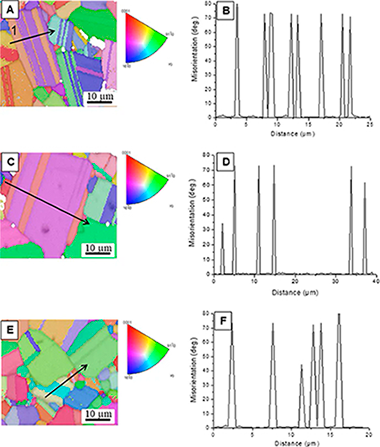
Boron carbide is among the most promising ceramic materials nowadays: their mechanical properties are outstanding, and they open potential critical applications in near future. Since sinterability is the most critical drawback to this goal, innovative and competitive sintering procedures are attractive research topics in the science and technology of this carbide. This work reports the pioneer use of the laser-floating zone technique with this carbide. Crystallographic, microstructural and mechanical characterization of the so-prepared samples is carefully analysed. One unexpected output is the fabrication of a B6C composite when critical conditions of growth rate are adopted. Since this is one of the hardest materials in Nature and it is achievable only under extremely high pressures and temperatures in hot-pressing, the use of this technique offers a promising alternative for the fabrication. Hardness and elastic modulus of this material reached to 52 GPa and 600 GPa respectively, which is close to theoretical predictions reported in literature.
Septiembre, 2019 | DOI: 10.1038/s41598-019-49985-2
Reactividad de Sólidos
Role of calcium looping conditions on the performance of natural and synthetic Ca-based materials for energy storage
Sarrion, B; Perejon, A; Sanchez-Jimenez, PE; Perez-Maqueda, LA; Valverde, JMJournal of CO2 utilization, 28 (2018) 374-384
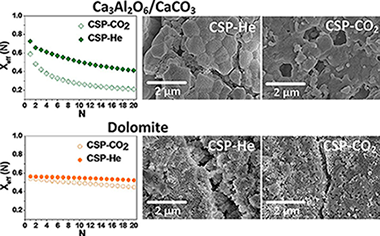
In this work, the multicycle activity of natural CaO precursors (limestone and dolomite) and Ca-based composites (Ca3Al2O6/CaCO3 and ZrO2/CaCO3 mixtures) has been studied for Thermochemical Energy Storage (TCES) in Concentrated Solar Power (CSP) plants by means of the Calcium-Looping process (CaL), using two integration schemes proposed elsewhere that differ in the calcination stages. Under CSP-He conditions, calcination for CaO regeneration is performed under pure He at low temperatures (725 degrees C) while under CPS-CO2 conditions calcination is carried out under pure CO2 at high temperatures (950 degrees C). The latter avoids the use of selective membranes to separate He from CO2 even though it requires the use of more expensive materials for solar receptors. Carbonation/calcination conditions drastically affect the multicycle CO2 uptake of the materials tested. Effective multicycle conversion is higher in CSP-He tests due to the mild conditions employed for calcination, which mitigates CaO sintering. On the other hand, the harsh calcination conditions used in CSP-CO2 tests enhance sintering of CaO derived from limestone and the Ca3Al2O6/CaCO3 composite due to the low Tammann temperature of Ca3Al2O6. CaO sintering is hindered by the presence of inert oxides with high Tammann temperatures, such as ZrO2 in the ZrO2/CaCO3 composite and MgO in dolomite. Dolomite derived CaO shows high effective conversion values along the carbonation/calcination cycles when tested under both types of conditions, as compared to limestone and the composites, which suggests that the integration scheme based on CSP-CO2 conditions would be a feasible alternative to CSP-He if natural dolomite were used as CaO precursor.
Diciembre, 2018 | DOI: 10.1016/j.jcou.2018.10.018
Materiales Avanzados
Degradation of a LDPE film applied as a greenhouse cover design material: the effect of ageing and mechanical modelling
Garzon, Eduardo; Ortiz Rodriguez, Isabel Maria; Castillo, Jose; Jose Sanchez-Soto, PedroRevista de la Construcción, 17 (3) (2018) 457-464
In this work, we studied the mechanical performance of an LDPE film (0.22 mm in thickness) used as a material in the design of greenhouse covers. We investigated the effects of ageing at different periods of its service life and applying chemical substance treatments used as pesticides on greenhouse crops and after breakage using mechanical traction. Numerical simulations were performed using the finite element method. For this purpose, one section of the complete geometry of the greenhouse cover and different load conditions (1-5 kPa) were considered for the modelling. The performance of the polymer was assumed to be linearly elastic to simplify the governing equations. The study demonstrated that the LDPE film used was no longer effective as a greenhouse cover film due to the degradation of its mechanical properties. It was shown that the general performance of this film was in the plastic zone and its performance was non-linear. The results deduced from the present study are of interest because they show the material failure process of greenhouse covers in relation to the degradation process.
Diciembre, 2018 | DOI: 10.7764/RDLC.17.3.457 DEC 2018
Reactividad de Sólidos
Molten carbonate salts for advanced solar thermal energy power plants: Cover gas effect on fluid thermal stability
Fereres, S; Prieto, C; Gimenez-Gavarrell, P; Rodriguez, A; Sanchez-Jimenez, PE; Perez-Maqueda, LASolar Energy Materials and Solar Cells, 188 (2018) 119-126
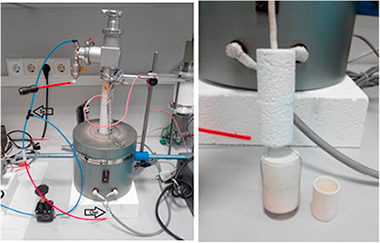
The eutectic mixture Li2CO3-Na2CO3-K2CO3 is investigated as a high temperature heat transfer fluid and storage medium alternative for molten salt solar thermal power plants. This salt has an operating temperature range of 400–700 °C, enabling the use of higher temperature/efficiency power cycles. However, this carbonate mixture is known to thermally decompose in air. This study evaluates the thermal stability of the salt mixture under different cover gases: air, nitrogen, carbon dioxide, and an 80/20 carbon dioxide/air mixture. Initial characterization is performed through thermogravimetric analysis (TGA), followed by larger scale testing in a custom-made reactor to simulate conditions closer to its practical use. The results show improved thermal stability with a CO2 atmosphere. The decomposition kinetics under different cover gases are estimated from TGA data. However, larger-scale, longer duration experiments show much slower decomposition rates compared to the classical TGA approach. These findings indicate that the main contribution to mass loss in TGA is due to vaporization rather than thermal decomposition. Thus, a proper evaluation of the molten salt´s thermal stability can only be obtained from reactor experiments where vaporization is inhibited. Very long induction periods (of the order of days) are observed, suggesting that the kinetic decomposition mechanism is a nucleation and growth type. Other considerations for future plants incorporating these high temperature salts are discussed.
Diciembre, 2018 | DOI: 10.1016/j.solmat.2018.08.028
Reactividad de Sólidos
Mechanically induced combustion synthesis of niobium carbonitride nanoparticles
Jalaly, M; Gotor, FJ; Sayagues, MJJournal of Solid State Chemistry, 267 (2018) 106-112
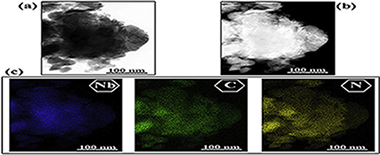
Niobium carbonitride [Nb(C,N)] nanoparticles were synthesized by a combustive mechanochemical reaction in the Mg/Nb2O5/C3H6N6 system. High-energy ball milling was used to promote a mechanically induced self-sustaining reaction (MSR). Combustion occurred after a very short milling period of 5 min. X-ray diffraction (XRD), X-ray photoelectron spectroscopy (XPS), energy-dispersive X-ray spectroscopy (EDS) and electron energy loss spectroscopy (EELS) analyses revealed that the nature of the product is an intermixed carbonitride material. The formation mechanism of Nb(C,N) resulted from the magnesiothermic reduction of niobium oxide to generate elemental Nb, which then reacted with the species generated from the melamine decomposition.
Noviembre, 2018 | DOI: 10.1016/j.jssc.2018.08.027
Propiedades mecánicas, modelización y caracterización de cerámicos avanzados
Exotic grain growth law in twinned boron carbide under electric fields
Moshtaghioun, BM; Gomez-Garcia, D; Rodriguez, ADJournal of the European Ceramic Society, 38 (2018) 4590-4596
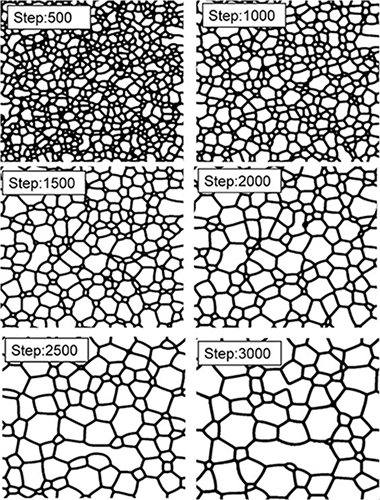
Grain growth is a ubiquitous phenomenon in all materials, and it affects both structural and functional properties. Despite its intrinsic importance, a full comprehension of grain growth from a fundamental point of view-i.e., from the nanoscale to the macroscale-is still a pending issue. In practical terms, our knowledge relies on the classical kinetic laws reported sixty years ago.
This paper reports the violation of such classical laws in boron carbide ceramics consolidated by spark plasma sintering. The conjunction of high temperature gradients with large compressive stress when a pulse electric current passes through the ceramic powders gives rise to an intense twinning-detwinning formation. These forming steps at the grain boundaries change the grain mobility drastically. Therefore, a new 'exotic' law for grain-growth kinetics is found and validated at different temperatures and dwell times.
Noviembre, 2018 | DOI: 10.1016/j.jeurceramsoc.2018.06.029
Reactividad de Sólidos
Scalable synthesis of potential solar cell absorber Cu2SnS3 (CTS) from nanoprecursors
Hegedus, M; Balaz, M; Tesinsky, M; Sayagues, MJ; Siffalovic, P; Krulakova, M; Kanuchova, M; Briancin, J; Fabian, M; Balaz, PJournal of Alloys and Compounds, 768 (2018) 1006-1015
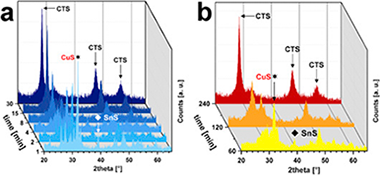
The present paper demonstrates an easy and scalable mechanochemical synthesis of ternary sulfide Cu2SnS3 (CTS) as a promising solar cell absorber. For the synthesis, pre-milled nanoparticles of CuS and SnS were used. The pure CTS phase was readily obtained after 60 min of milling in a laboratory planetary ball mill and 240 min in an industrial eccentric vibration industrial mill, respectively. The reaction progress of laboratory scale synthesis was studied by the quantitative Rietveld analysis. The reaction speed reaches its maximum at 4.6 min and the reaction is completed at approximately 60 min, according to the fitted data. The products of the syntheses were further characterized by X-ray powder diffractometry, Raman spectroscopy, scanning electron microscopy, X-ray photoelectron spectroscopy and UV-Vis spectroscopy. The results revealed formation of near-stoichiometric CTS nanoparticles with tetragonal I-42m symmetry. An average crystallites size of approximately 10-15 nm was determined for CTS phase. The SEM images support quintessential polydisperse character of the powders obtained by ball-milling approach. The materials seem to be suitable for photovoltaic applications with the band-gap energies of approximately 1.16-1.19 eV.
Noviembre, 2018 | DOI: 10.1016/j.jallcom.2018.07.284
Reactividad de Sólidos
Isosymmetric structural phase transition of the orthorhombic lanthanum gallate structure as a function of temperature determined by Rietveld analysis
Tang, Y. Q.; Lopez-Cartes, C.; Aviles, M. A.; Cordoba, J. M.CRYSTENGCOMM, 20 (2018) 5562-5569
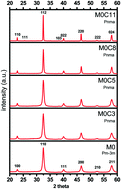
High energy planetary ball milling has been used to synthesize pseudo-cubic highly-pure LaGaO3 in one hour from its oxide components in an air atmosphere. Calcination at different temperatures led to the crystallization of lanthanum gallate in an orthorhombic structure with its local lanthanum coordination number environment changing from 12 to 7 when the temperature was increased. This change was attributed to the thermal expansion of the Ga-O bonds that varied non-monotonically inducing GaO6 tilting. Rietveld analysis, Raman spectroscopy, and transmission electron microscopy were used to elucidate the LaGaO3 structures at different temperatures.
Octubre, 2018 | DOI: 10.1039/c8ce00726h
Spanish and Portuguese Gilding Threads: Characterization Using Microscopic Techniques
Perez-Rodriguez, JL; Albardonedo, A; Robador, MD; Duran, AMicroscopy and Microanalysis, 24 (2018) 574-590
Gilding threads collected from Spanish and Portuguese palaces and from the embroideries and adornments of sculptures of the Virgin and Christ that form part of Sevillian Holy Week were analyzed and compared (20 artifacts were evaluated). The study covered a broad time period with examples from the 13th to 14th centuries, 18th to 20th centuries, and also including modern embroideries. A combination of scanning electron microscopy and energy-dispersive X-ray spectroscopy was used. The knowledge of the layered structures of the threads has provided very valuable information regarding the manufacturing techniques. The different metal threads found in the embroidery studied consisted of gold, silver, copper, and alloys of these metals and aluminium. The fabrication procedures often differed in the different workshops and changed with time. In the modern embroideries, a decrease of precious metal concentration was detected. The threads were wound around a core of silk threads.
Octubre, 2018 | DOI: 10.1017/S1431927618015167
Reactividad de Sólidos
Study of the thermal decomposition of historical metal threads
Perez-Rodriguez, JL; Perez-Maqueda, R; Franquelo, ML; Duran, AJournal of Thermal Analysis and Calorimetry, 134 (2018) 15-22

In this work, it is reported that thermal analysis techniques such as differential thermal analysis and thermogravimetric analysis are very useful for evaluating metals threads and fibres used in the manufacture of historical artifacts. Thermal analysis has been used to characterize the silk, cotton and linen employed as supports and the copper, silver and aluminium as the metallic components in the studied threads. Other organic compounds, mainly added for the conservation of the threads, have also been characterized.
Octubre, 2018 | DOI: 10.1007/s10973-017-6924-x
Reactividad de Sólidos
Optimizing the homogenization technique for graphene nanoplatelet/yttria tetragonal zirconia composites: Influence on the microstructure and the electrical conductivity
Lopez-Pernia, C; Munoz-Ferreiro, C; Gonzalez-Orellana, C; Morales-Rodriguez, A; Gallardo-Lopez, A; Poyato, RJournal of Alloys and Compounds, 767 (2018) 994-1002
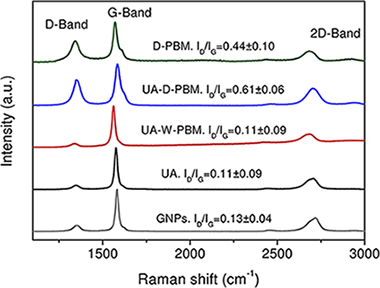
3 mol% yttria tetragonal zirconia polycrystalline (3YTZP) ceramic composite powders with 10 vol% nominal content of graphene nanoplatelets (GNPs) were prepared using four different homogenization routines: dispersion of the powder mixture by ultrasonication in isopropyl alcohol, homogenization in a high-energy planetary ball mill in wet or dry conditions after ultrasonication, and milling of the powders in a high-energy planetary ball mill in dry conditions. A significant effect of the homogenization routine on the powders particle size distribution was revealed by laser granulometry and Raman spectroscopy. Highly densified composites were obtained after spark plasma sintering (SPS) and remarkable differences on the GNP size, shape and distribution throughout the ceramic matrix and also in the electrical conductivity were observed in the four different composites. The composite with the best performance in terms of electrical conductivity was the one prepared after planetary ball milling of the powders in dry conditions as a consequence of the reduced dimensions of the GNPs and their excellent distribution throughout the ceramic matrix.
Octubre, 2018 | DOI: 10.1016/j.jallcom.2018.07.199
Reactividad de Sólidos
The role of carbon nanotubes on the stability of tetragonal zirconia polycrystals
Morales-Rodriguez, A; Poyato, R; Gutierrez-Mora, F; Munoz, A; Gallardo-Lopez, ACeramics International, 44 (2018) 17716-17723
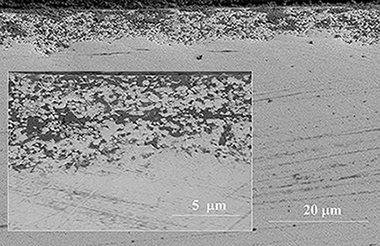
The effect of single walled carbon nanotubes (SWNT) at zirconia grain boundaries on the stability of a tetragonal zirconia polycrystalline matrix has been explored in as-sintered composites and after low temperature hydro thermal degradation (LTD) experiments. For this purpose, highly-dense 3 mol% Y2O3-doped tetragonal zirconia polycrystalline (3YTZP) ceramics and SWNT/3YTZP composites were prepared by spark plasma sintering (SPS). Quantitative X-ray diffraction analysis and microstructural observations point out that an increasing amount of well-dispersed SWNT bundles surrounding zirconia grains decreases the metastable tetragonal phase retention in the ceramic matrix after sintering. In contrast, the tetragonal ceramic grains in composites with SWNTs are less sensitive to the presence of water, i.e. to undergo a martensitic transformation under LTD conditions, than monolithic 3YTZP ceramics. The SWNT incorporation diminishes micro-cracking due to tetragonal to monoclinic ZrO2 phase transformation in the composites.
Octubre, 2018 | DOI: 10.1016/j.ceramint.2018.06.238
Propiedades mecánicas, modelización y caracterización de cerámicos avanzados
Grain-boundary diffusion coefficient in alpha-Al2O3 from spark plasma sintering tests: Evidence of collective motion of charge disconnections
Tamura, Y; Zapata-Solvas, E; Moshtaghioun, BM; Gomez-Garcia, D; Dominguez-Rodriguez, ACeramics International, 44 (2018) 19044-19048
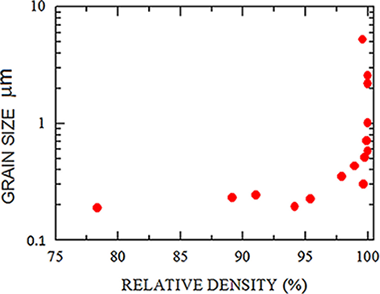
The sintering of fine-grained a-alumina by spark plasma sintering (SPS) was performed to study grain growth under SPS conditions. Grain growth is found to be extensive at relative densities above 95%. A grain growth versus dwell time analysis during SPS allows for the determination of the grain-boundary diffusion coefficient. This study shows that the remarkable enhancement of grain-boundary diffusion derived from a previous analysis could be a consequence of the presence of the recently discovered "disconnections" at the grain boundaries of alpha-alumina. Their presence, together with their electric charge and the external electric field at the boundaries, are the key ingredients for a violation of the typical grain growth kinetic law. When they are introduced appropriately, an updated value of the grain-boundary diffusion coefficient is achieved. A comparison with other values reported previously in the literature through other techniques and a critical analysis are also carried out.
Octubre, 2018 | DOI: 10.1016/j.ceramint.2018.07.073
Materiales Avanzados
Biomass fly ash and aluminium industry slags-based geopolymers
Perez-Villarejo, L; Bonet-Martinez, E; Eliche-Quesada, D; Sanchez-Soto, PJ; Rincon-Lopez, JM; Castro-Galiano, EMaterials Letters, 229 (2018) 6-12
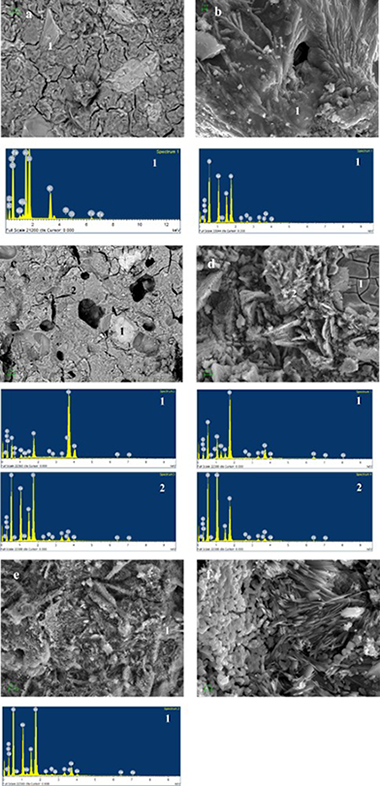
Geopolymers are a new class of non-Portland cements produced using an alumino-silicate material and an activating solution, which is mainly composed of sodium or potassium and waterglass to be subsequently cured at relatively low temperatures. Those can be formulated by adding natural minerals, waste and/or industrial by-products. The study investigates the microstructural properties of geopolymers synthesized from metakaolin (MK) and the admixture of fly ash (FBA) and aluminium industry slags (AIS) at different ages of curing. Five different geopolymer compositions were prepared and characterized by XRD, ATR-FTIR and SEM/EDS. The study revealed that geopolymeric gels are identified, which show mainly glassy microstructures, in agreement with the X-ray amorphous diffraction patterns, broad FTIR features and confirmed by SEM/EDS, with promising results prior to an industrial scale.
Octubre, 2018 | DOI: 10.1016/j.matlet.2018.06.100
Materiales Avanzados
Manufacture of sustainable clay ceramic composite with composition SiO2-Al2O3-CaO-K2O materials valuing biomass ash from olive pomace
Bonet-Martinez, E; Perez-Villarejo, L; Eliche-Quesada, D; Sanchez-Soto, PJ; Carrasco-Hurtado, B; Castro-Galiano, EMaterials Letters, 229 (2018) 21-25
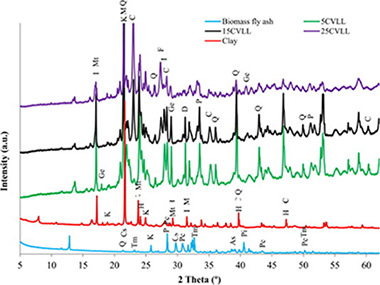
Fly ash is a biomass combustion by-product produced by dragging ash from the base of the furnace. Disposing of ash is a growing economic and environmental burden. Based on physical and chemical properties, fly ash could be used in the manufacture of construction materials. This paper investigates the influence of biomass fly ash from olive pomace as additive to manufacture of clay ceramic composite materials. Fired clay brick at 950 degrees C were prepared containing between 0 and 25 wt% fly ash. Final products are studied by water absorption, bulk density, loss of ignition, linear shrinkage, compressive strength and physisorption N-2. The results reveal that the porosity of the materials increases with the level of fly ash replacement (10% up to 25 wt%) resulting in to increased water absorption and decreased compressive strength. Fired clay brick developed in this study can be used for construction materials based on criteria of the current regulations.
Octubre, 2018 | DOI: 10.1016/j.matlet.2018.06.105
Reactividad de Sólidos
Mesoporous Silica by Solution-Combustion Synthesis Followed by Etching
Salehtash, F; Jalaly, M; Motejadded Emrooz, HB; Gotor, FJ; Sayagués, MJInternational Journal of Self-Propagating High-Temperature Synthesis, 27 (2018) 221–227
Mesoporous silica was synthesized through the solution-combustion process followed by etching with aqueous solution of sodium dodecyl sulfate (SDS). Combustion products were characterized by XRD, FTIR, SEM, TEM, HRTEM, and BET analysis. After etching, the specific surface, mean pore size, and volume of porous space in silica increased up to 390 m(2)/g, 15 nm, and 1.6 cm(3)/g, respectively. The synthesized mesoporous silica exhibited good performance in the tests on elimination of methylene blue from aqueous solution.
Octubre, 2018 | DOI: 10.3103/S1061386218040064
Reactividad de Sólidos
Synthesis, characterization and combined kinetic analysis of thermal decomposition of hydrotalcite (Mg6Al2(OH)(16)CO3 center dot 4H(2)O)
Yahyaoui, R; Jimenez, PES; Maqueda, LAP; Nahdi, K; Luque, JMCThermochimica Acta, 667 (2018) 177-184

Here, a kinetic study of the thermal decomposition of synthesized hydrotalcite, Mg-6 Al-2 CO3(OH)(16)center dot H2O, has been carried out using thermogravimetric experiments in air atmosphere. It is shown that the thermal decomposition occurs in two well differentiated stages. The first one is a single-step dehydration process that comprises the release of four water molecules. On the other hand, the second stage is complex and corresponds to both dehydroxylation and decarbonation processes which occur simultaneously. The kinetic parameters describing all processes were calculated by means of a combined approach comprising isoconversional, model-fitting and deconvolution methods. It was concluded that dehydroxilation and decarbonization cannot be separated by TG experiments and the two stages contributing to the complex process do not apparently match the expected stoichiometry of the process. Therefore, it is proposed that such stages mark a change on the reaction mechanism due to the structural collapse of the laminar double hydroxide.
Septiembre, 2018 | DOI: 10.1016/j.tca.2018.07.025
Materiales Avanzados
An approach to the heating dynamics of residues from greenhouse-crop plant biomass originated by tomatoes (Solanum lycopersicum, L.)
Garzon, E; Morales, L; Ortiz-Rodriguez, IM; Sanchez-Soto, PJEnvironmental Science and Pollution Research, 25 (2018) 25880-25887
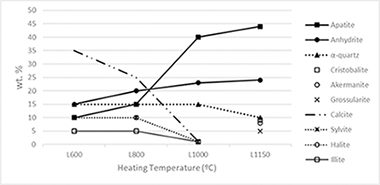
The most representative of greenhouse-crop plant biomass residues of tomatoes (Solanum lycopersicum L.) were selected for this study by using X-ray fluorescence spectrometry (XRF) and X-ray powder diffraction (XRD). The heating dynamics in air in the 600-1150 degrees C range of these residues for the production of renewable energy and the resultant ashes have been investigated. A total of 11 elements were determined by XRF in the biomass ashes and some minor elements. The content of alkaline elements and chlorides decreased as increasing heating temperature and disappeared at 1150 degrees C. Alkaline salts, NaCl and KCl, were volatilized by heating since 800 degrees C. The total contents of S and P in the biomass ashes were associated to CaSO4, and a complex phosphate identified by XRD. CaCO3 present at 600 degrees C was decomposed to CaO with disappearance at 1000 degrees C. By heating, new silicates were formed by solid-state reactions in the biomass residue. The minor elements have been found in a relative proportion lower than 0.9wt.% and they characterized the obtained ashes, with potential use as micronutrients.
Septiembre, 2018 | DOI: 10.1007/s11356-018-2577-y
Reactividad de Sólidos
Combined kinetic analysis of multistep processes of thermal decomposition of polydimethylsiloxane silicone
Garcia-Garrido, C; Perez-Maqueda, LA; Criado, JM; Sanchez-Jimenez, PEPolymer, 153 (2018) 558-564
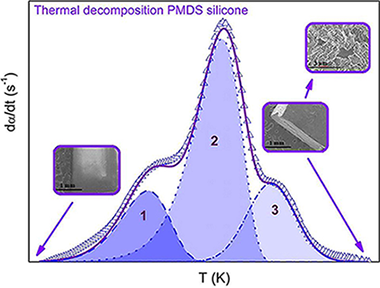
In this work, we studied the thermal decomposition of a widely employed silicone elastomer, polydimethylsiloxane, in an inert atmosphere. This silicone elastomer has several applications due to its high thermal stability such as MEMS (microelectromechanical systems) precursors, microfluidic components, adhesives, lubricants, and precursors for non-porous ceramics. Therefore, a reliable description of the thermal decomposition kinetics is important to prevent or control the decomposition in such applications. While the decomposition has been amply reported as a complex process, most kinetic studies published on this system use simplified methods that avoid the fact that the entire process cannot be described by a single kinetic triplet. Here, we have studied the decomposition process by first separating the overall reaction into its three constituent steps which were subsequently analysed independently. The deconvolution was carried out using Fraser-Suzuki function that is capable of fitting an asymmetric peak fitting function. The resulting kinetic parameters proved to be able to reconstruct the original experimental curves but are also capable of producing accurate predictions of curves recorded at heating schedules different from those employed to record the experimental data used in the kinetic analysis. Finally, it was found that the rate limiting step of all stages is the diffusion of the gases released during the polymer decomposition through the transforming polymeric matrix.
Septiembre, 2018 | DOI: 10.1016/j.polymer.2018.08.045
Propiedades mecánicas, modelización y caracterización de cerámicos avanzados
Graphene or carbon nanofiber-reinforced zirconia composites: Are they really worthwhile for structural applications?
Cano-Crespo, R; Moshtaghioun, BM; Gomez-Garcia, D; Moreno, R; Dominguez-Rodriguez, AJournal of the European Ceramic Society, 38 (2018) 3994-4002
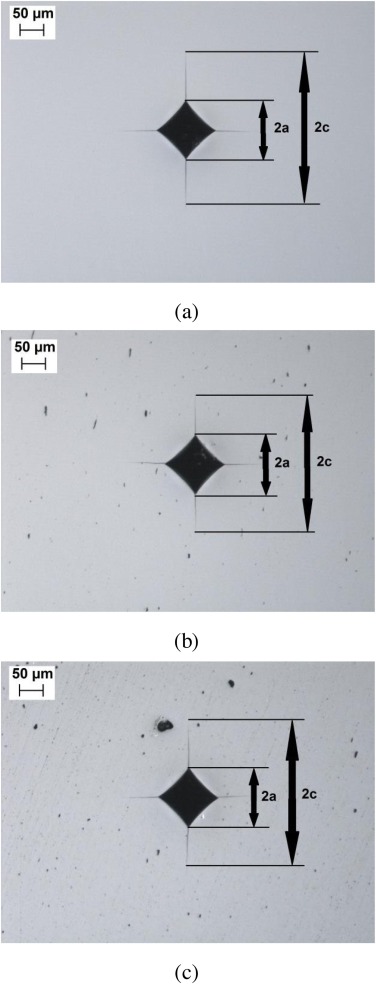
The use of allotropic phases of carbon (i.e. nanotubes, graphene or carbon nanofibers) as second phases to design ceramic composites is a hot topic at present. Researchers try to provide a remarkable improvement of the parent ceramic assuming that some of the outstanding mechanical properties of these phases migrate to the resultant composite. This reasonable idea has been questioned severely in the case of nanotubes addition but there is not any analysis for the other two phases cited previously. To elucidate this question, zirconia was selected as a model ceramic. This paper reports the mechanical properties of zirconia composites reinforced either with graphene or carbon nanofibers, with special emphasis on the high-temperature plasticity.
Septiembre, 2018 | DOI: 10.1016/j.jeurceramsoc.2018.04.045
Reactividad de Sólidos
Mechanosynthesis of Sr1-xLaxTiO3 anodes for SOFCs: Structure and electrical conductivity
Sayagues, MJ; Gotor, J; Pueyo, M; Poyato, R; Garcia-Garcia, FJJournal of Alloys and Compounds, 763 (2018) 679-686
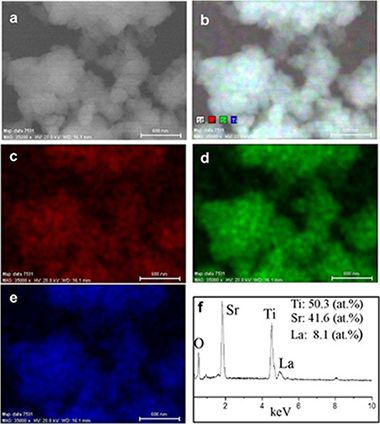
Sr1-xLaxTiO3 (SLT; 0 <= x <= 0.5) powder samples were synthesised at room temperature by a mechanochemical method from SrO, La2O3 and TiO2 mixtures in 90 min. The obtained SLT samples as potential anode materials in solid oxide fuel cells (SOFCs) were investigated. The microstructure, electrical conductivity and chemical compatibility with yttria-stabilised zirconia (YSZ) were studied. The powder samples had a nanometric character after milling. After a subsequently heating at 900 degrees C, the particle size slightly increased, but still remained nanometric. At this high temperature, a good chemical compatibility with YSZ was found. The x = 0.2 sample gave the best electrical conductivity values, i.e. 0.23 W cm(-2). These features make such as-obtained samples good candidates to be used as anodes in SOFCs.
Septiembre, 2018 | DOI: 10.1016/j.jallcom.2018.05.243
Materiales Avanzados
Vitrification and derived glass-ceramics from mining wastes containing vermiculite and lithium aluminium phosphate
Rincon, JM; Callejas, P; Sanchez-Soto, PJ; Jordan, MMMaterials Letters, 227 (2018) 86-89
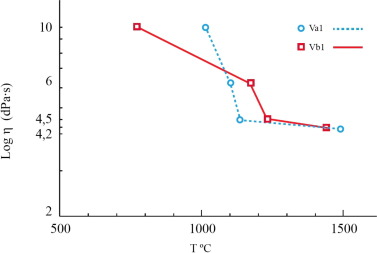
The waste vitrification of abandoned open sky vermiculite deposits has been considered by combining with a natural phosphate mineral residue. Several batches haven been designed from the composition system: Li2O-MgO-Al2O3-P2O5-SiO2 including some Fe2O3 and Fluoride. The resulting glasses are transparent and smooth green coloured, giving rise after TTT treatments to several opal, opaque glass-ceramics with iridescent surface. Full characterization has been carried out by XRD and electron microscopy with EDS, as well as by XPS spectroscopies, concluding that the main crystalline phases formed were alpha-cordierite and beta-spodumene. The surface of these glass-ceramics from vermiculiteamblygonite is enriched in Fe2O3. Compared to the parent glasses, the final glass-ceramics exhibited and improvement in fracture toughness.
Septiembre, 2018 | DOI: 10.1016/j.matlet.2018.05.001
Reactividad de Sólidos
Nanostructured vanadium carbonitride prepared by combustion synthesis during mechanical milling
Jalaly, M; Gotor, FJ; Sayagues, MJJournal of Alloys and Compounds, 763 (2018) 18-24
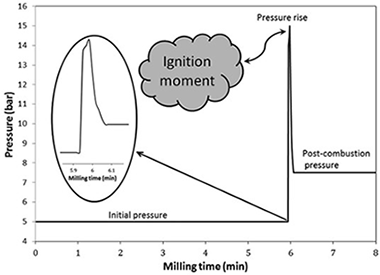
Vanadium carbonitride (VCN) nanoparticles were synthesized by a mechanically induced magnesiothermic combustion in a Mg/V2O5/C3H6N6 system. Initial materials ignited after a short milling time of 6 min. Various characterizations such as X-ray diffraction (XRD), X-ray photoelectron spectroscopy (XPS), energy-dispersive X-ray spectroscopy (EDX), high-resolution transmission electron microscopy (HRTEM) and elemental mapping confirmed that the product of the combustion was a mixed carbonitride. In this process, magnesium reduces vanadium oxide to generate elemental V and a great amount of heat. Melamine decomposes due to the temperature rise, and its decomposed species form the carbonitride compound. The chemical composition of the synthesized product was estimated to be VC0.26N0.36.
Septiembre, 2018 | DOI: 10.1016/j.jallcom.2018.05.352
Química de Superficies y Catálisis - Reactividad de Sólidos
A direct in situ observation of water-enhanced proton conductivity of Eu-doped ZrO2: Effect on WGS reaction
Garcia-Moncada, N; Bobadilla, LF; Poyato, R; Lopez-Cartes, C; Romero-Sarria, F; Centeno, MA; Odriozola, JAApplied Catalysis B-Environmental, 231 (2018) 343-356
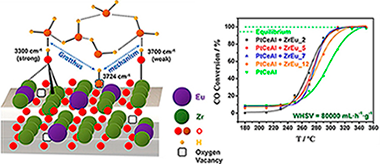
Eu-doped ZrO2 solid solutions have been synthesized in order to prepare proton conductors as water-enhancer additives for the WGS reaction. Elemental characterization has been carried out revealing homogeneous dopant distribution resulting in fluorite-type solid solutions for Eu2O3 contents up to similar to 9 mol.%. Representative samples of the Eu-doped ZrO2 series have been analysed by Impedance Spectroscopy (IS) in inert, oxygen and wet conditions. The solid solution with 5 mol.% of Eu2O3 has presented the highest conductivity values for all tested conditions indicating an optimal amount of dopant. Moreover, the presence of vapour pressure results in an increment of the conductivity at temperatures lower than 300 degrees C, meanwhile at higher temperatures the conductivity is the same than that in inert conditions. To elucidate these results, in situ DRIFTS studies were carried out. These experiments evidenced the existence of water dissociation at oxygen vacancies (band at 3724 cm(-1)) as well as the presence of physisorbed water at temperatures up to similar to 300 degrees C where the band at 5248 cm(-1) characteristic of these species disappeared. These results points to a layer model where the physisorbed water interacts with surface hydroxyls generated by dissociated water that improves the proton conductivity through Grotthuss' mechanism in the RT-300 degrees C temperature range. These samples were successfully tested in WGS reaction as additive to a typical Pt-based catalyst. The presence of the mixed oxide reveals an increase of the catalyst' activity assisted by the proton conductor, since improves the water activation step.
Septiembre, 2018 | DOI: 10.1016/j.apcatb.2018.03.001
Reactividad de Sólidos
Electrical conduction mechanisms in graphene nanoplatelet/yttria tetragonal zirconia composites
Poyato, R; Osuna, J; Morales-Rodriguez, A; Gallardo-Lopez, ACeramics International, 44 (2018) 14610-14616
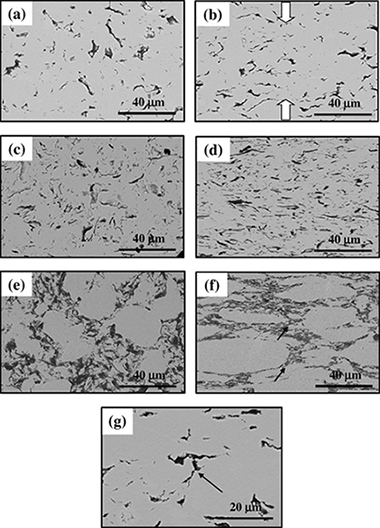
Yttria tetragonal zirconia polycrystalline (3YTZP) ceramic composites with 5, 10 and 20 vol% graphene nano-platelets (GNPs) were prepared by spark plasma sintering (SPS) and their electrical conductivity as a function of temperature was characterized. The composites exhibit anisotropic microstructures so the electrical conductivity studies were carried out in two directions: perpendicular (sigma(perpendicular to)) and parallel (sigma(parallel to)) to the SPS pressing axis. The composites with 5 and 10 GNP vol% showed high electrical anisotropy, whereas the composite with 20 GNP vol % exhibited nearly isotropic electrical behavior. sigma(perpendicular to) shows metallic-type behavior in the composites with 10 and 20 vol% GNP revealing that charge transport takes place through defect-free GNPs. For the composite with 5 vol % GNP the observed semiconductor-type behavior was explained by a two dimensional variable range hopping mechanism. sigma(parallel to)shows metallic-type conductivity in the composite with 20 GNP vol% and positive d sigma(parallel to)/dT slope in the composites with 5 and 10 GNP vol%.
Agosto, 2018 | DOI: 10.1016/j.ceramint.2018.05.082
Reactividad de Sólidos
Mechanochemical synthesis, structural, magnetic, optical and electrooptical properties of CuFeS2 nanoparticles
Dutkova, E; Bujnakova, Z; Kovac, J; Skorvanek, I; Sayagues, MJ; Zorkovska, A; Kovac, J; Balaz, PAdvanced Powder Technology, 29 (2018) 1820-1826

The rapid mechanochemical synthesis of nanocrystalline CuFeS2 particles prepared by high-energy milling for 60 min in a planetary mill from copper, iron and sulphur elements is reported. The CuFeS2 nanoparticles crystallize in tetragonal structure with mean crystallite size of about 38 ± 1 nm determined by XRD analysis. HRTEM study also revealed the presence of nanocrystals with the size of 5–30 nm with the tendency to form agglomerates. The Raman spectrum confirms the chalcopyrite structure. Low temperature magnetic data for CuFeS2 support the coexistence of antiferromagnetic and paramagnetic spin structure. Moreover, the hysteresis loops taken at temperatures from 5 K to 300 K revealed a presence of very small amount of ferromagnetic phase, which seems to be associated with the non-consumed elemental Fe in as-prepared nanoparticles. The optical band gap of CuFeS2nanoparticles has been detected to be 1.05 eV, larger than band gap of the bulk material. The wider gap possibly resulted from the nano-size effect. Photoresponses of CuFeS2nanoparticles were confirmed by I-V measurements under dark and light illumination. It was demonstrated that mechanochemical synthesis can be successfully employed in the one step preparation of nanocrystalline CuFeS2 with good structural, magnetic, optical and electrooptical properties.
Agosto, 2018 | DOI: 10.1016/j.apt.2018.04.018
Reactividad de Sólidos
Effect of milling mechanism on the CO2 capture performance of limestone in the Calcium Looping process
Benitez-Guerrero, M; Valverde, JM; Perejon, A; Sanchez-Jimenez, PE; Perez-Maqueda, LAChemical Engineering Journal, 346 (2018) 549-556
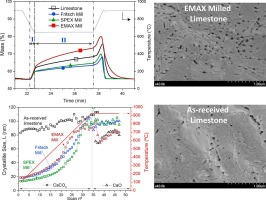
This work analyzes the relevant influence of milling on the CO2 capture performance of CaO derived from natural limestone. Diverse types of milling mechanisms produce contrasting effects on the microstructure of the CaO formed after calcination of the milled limestone samples, which affects crucially the kinetics of carbonation at conditions for CO2 capture. The capture capacity of CaO derived from limestone samples milled using either shear or impact based mills is impaired compared to as-received limestone. After calcination of the milled samples, the resulting CaO porosity is increased while crystallinity is enhanced, which hinders carbonation. Conversely, if the material is simultaneously subjected to intense impact and shear stresses, CaO porosity is promoted whereas CaO cristanillity is reduced, which enhances carbonation in both the reaction and solid-state diffusion controlled regimes.
Agosto, 2018 | DOI: 10.1016/j.cej.2018.03.146
Reactividad de Sólidos
Synthesis and characterization of SiC/Si3N4 composites from rice husks
Real, C; Cordoba, JM; Alcala, MDCeramics International, 44 (2018) 14645-14651
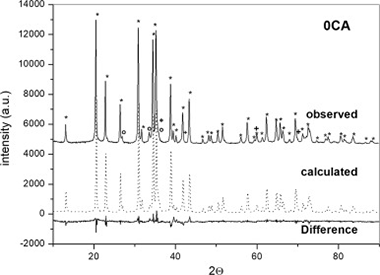
SiC-Si3N4 composites have been obtained by carbothermal reduction of rice husk under a nitrogen-argon atmosphere at 1450 degrees C, which is a lower temperature than those used by other authors. On the other hand, tailoring the argon/nitrogen ratio led to the obtained of SiC-Si3N4 composites across the whole range of compositions. Phosphoric acid treatment permited the synthesis of the composite without a pyrolysis step. The final products were characterized by X-ray diffractometry, IR spectroscopy and scanning electron microscopy.
Agosto, 2018 | DOI: 10.1016/j.ceramint.2018.05.090
Reactividad de Sólidos
Synergy achieved in silver-TiO2 nanocomposites for the inhibition of biofouling on limestone
Becerra, J; Zaderenko, AP; Sayagues, MJ; Ortiz, R; Ortiz, PBuilding and Environment, 141 (2018) 80-90
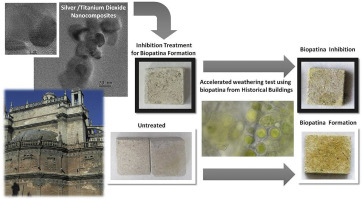
Biodeterioration of stone monuments is estimated to be as high as 20-30% of the total degradation suffered by Cultural Heritage constructions. With regard to this problem, bactericidal treatments are mainly based on cleaning. These processes, while effective in the short term, require frequent reapplications increasing potential damages to the monument. Silver nanoparticles offer many advantages over traditionally employed products, such as their prolonged biocide efficacy and their low toxicity to humans and environment. The aim of this study was to evaluate the applicability and effectiveness of seven nanocomposite treatments based on titanium dioxide and/or silver nanoparticles to prevent biodeterioration of limestone monuments. These nanocomposites were characterized by UV Visible spectrophotometry, Dynamic Light Scattering and Electron Microscopy. To assess their bactericidal activity, accelerated weathering tests were performed on limestones from the quarry of Utrera, a source widely employed in such iconic monuments as the Cathedral of Seville (Spain). Furthermore, the samples of biopatina employed in our assays stemmed from the fa ades of historical buildings from Seville. Our results show that silver and titanium dioxide nanocomposites stabilized by citrate achieve a high biocide effect while maintaining color alterations at a low level.
Agosto, 2018 | DOI: 10.1016/j.buildenv.2018.05.020
Reactividad de Sólidos
Surface modification of Ti-6Al-4V alloys manufactured by selective laser melting: Microstructural and tribo-mechanical characterization
Torres, Y; Sarria, P; Gotor, FJ; Gutierrez, E; Peon, E; Beltran, AM; Gonzalez, JESurface & Coatings Technology, 348 (2018) 31-40
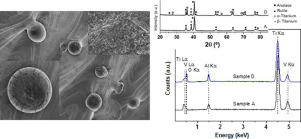
Medical grade of both titanium (Ti) and Ti6A14V alloy are recognized as the metallic biomaterials with the better outcomes for clinical repair of bone tissue thanks to their suitable mechanical properties and corrosion resistance. However, those Ti advantages are not enough to avoid failure risks of bone implants; between 5 and 10% of Ti implants fail due to a deficient osseointegration, within 5 years of post-implantation. Most of these failures indicate the necessity of getting a better biomechanical-biofunctional balance. Microstructural and tribo-mechanical characterizations were performed on Ti6A14V samples obtained by selective laser melting and subjected to different surface treatments (thermal stress relief, acid etching, chemical treatment and thermochemical treatment). Scanning electron microscopy and X-ray diffraction were used for detailed characterization of the elemental composition, phase analysis and surface morphology. Micro-hardness and scratch tests were employed to evaluate the tribo-mechanical properties, which were improved after consecutive surface treatments. Protuberances with spherical morphology, as a remainder of the original powder, were present on the surface. The resulting modified surfaces were constituted by rutile (major phase) and anatase (minor phase). Submicro-nano-topographies were obtained after the chemical and thermochemical treatments.
Agosto, 2018 | DOI: 10.1016/j.surfcoat.2018.05.015
Reactividad de Sólidos
On the determination of thermal degradation effects and detection techniques for thermoplastic composites obtained by automatic lamination
Martin, MI; Rodriguez-Lence, F; Guemes, A; Fernandez-Lopez, A; Perez-Maqueda, LA; Perejon, AComposites part A-Applied science and manufacturing, 111 (2018) 23-32

Automatic lay-up and in-situ consolidation with thermoplastic composite materials is a technology under research for its expected use in the profitable manufacturing of structural aeronautical parts. This study is devoted to analysing the possible effects of thermal degradation produced by this manufacturing technique.
Rheological measurements showed that there is negligible degradation in PEEK for the temperatures reached during the process. Thermogravimetric analysis under linear heating and constant rate conditions show that thermal degradation is a complex process with a number of overlapping steps. A general kinetic equation that describes the degradation of the material with temperature has been proposed and validated. Attenuated total reflectance Fourier transform infrared spectroscopy and X-ray photoelectron spectroscopy confirmed that there is no remarkable degradation. The use of a combination of in-situ and ex-situ experimental techniques, including kinetic modelling, not only provides reliable information about degradation but also allows setting optimal processing conditions.
Agosto, 2018 | DOI: 10.1016/j.compositesa.2018.05.006
Materiales Avanzados
The effect of vitreous phase on mullite and mullite-based ceramic composites from kaolin wastes as by-products of mining, sericite clays and kaolinite
Sanchez-Soto, PJ; Eliche-Quesada, D; Martinez-Martinez, S; Garzon-Garzon, E; Perez-Villarejo, L; Rincon, JMMaterials Letters, 223 (2018) 154-158
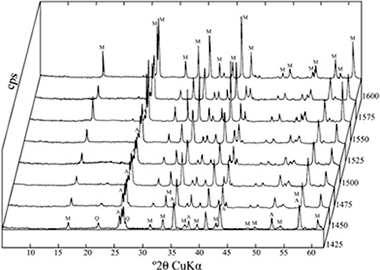
Mullite precursors were prepared using kaolin waste, sericite clay containing kaolinite and industrial kaolin with addition of alumina in a wet medium to synthesize mullite (72 wt% Al2O3 and 28 wt% SiO2). Uniaxial pressed bars of the powdered mullite precursors were fired in the range 1400-1600 degrees C with soaking times 30-120 min. The resultant materials were studied by XRD and SEM-EDX. Bulk densities, apparent porosities and flexural strengths in four points were determined in the fired bars at 1500, 1550 and 1600 degrees C. It was concluded that the thermal behaviour of these mullite precursors was influenced by the presence of impurities in the raw materials. These impurities originate a liquid phase forming a glassy phase which produces a progressive and enhanced densification of the mullite materials by reaction sintering at 1500-1600 degrees C. The technical properties were also influenced by the relative proportion of vitreous phase. The microstructure of characteristic mullite crystals was revealed by SEM. It was emphasized the use of kaolin waste by-products of mining and sericite clays as valuable raw materials for mullite preparation.
Julio, 2018 | DOI: 10.1016/j.matlet.2018.04.037
Reactividad de Sólidos
Effects of milling time, sintering temperature, Al content on the chemical nature, microhardness and microstructure of mechanochemically synthesized FeCoNiCrMn high entropy alloy
Alcala, MD; Real, C; Fombella, I; Trigo, I; Cordoba, JMJournal of Alloys and Compounds, 749 (2018) 834-843

FeCoNiCrMn(Al)-based powdered high entropy alloys were synthesized by a short time mechanical alloying process in a high energy planetary ball milling from mixtures of elemental powders, and subsequently sintered by a pressureless procedure. The composition and microstructure of the HEA phases before and after the sintering process were studied by X-ray diffraction, energy dispersive X-ray analysis (EDX) and scanning electron microscopy. The microhardness and tensile strength values for Fe1,8Co1,8Ni1,8Cr1,8Mn1,8Al1,0 HEA sintered at 1400 degrees C sample were 3,7 GPa and 1011 MPa, respectively. Statistical Fisher-Pearson coefficient of skewness and kurtosis were played to determine the optimum synthesis milling time. The use of NaCl as additive led on to a reduction of the as-milled grain size. After sintering, SEM study confirmed a segregation of the initial HEA phase directly related to the melting temperature of the elements. Three melting temperature groups were described (Cr, FeCoNi and Mn) and they agree with the observation in the elemental mapping study. The presence of Al favored the segregation of Cr.
Junio, 2018 | DOI: 10.1016/j.jallcom.2018.03.358
Reactividad de Sólidos
Pressure Effect on the Multicycle Activity of Natural Carbonates and a Ca/Zr Composite for Energy Storage of Concentrated Solar Power
Sarrion, B; Sanchez-Jimenez, PE; Perejon, A; Perez-Maqueda, LA; Valverde, JMACS Sustainable Chemistry & Engineering, 6 (2018) 7849-7858

This work is focused on the use of the Calcium-Looping process (CaL) in Concentrated Solar Power (CSP) plants for Thermochemical Energy Storage (TCES). Cheap, abundant and nontoxic natural carbonate minerals, such as limestone and dolomite, can be employed in this application to store energy through the cyclic calcination/carbonation of CaCO3. In a recent work, a closed CO2 cycle has been proposed for an efficient CaL-CSP integration in which the CO2 in excess effluent from the carbonator is used to generate electricity by means of a gas turbine. Process simulations show that the thermoelectric efficiency is enhanced as the carbonator pressure and temperature are increased provided that the multicycle CaO conversion is not affected. On the other hand, the use of just one reactor for both calcination and carbonation has been suggested to reduce capital cost. However, the experimental results shown in the present work indicate that sintering is notably enhanced as the pressure in the reactor is increased. Such an adverse effect is mitigated for a ZrO2/CaCO3 composite with a low Zr content as compared to natural carbonates. These results are relevant to process simulations for better assessing the global efficiency of the CaL-CSP integration.
Junio, 2018 | DOI: 10.1021/acssuschemeng.8b00981
Reactividad de Sólidos
Crystallization Kinetics of Nanocrystalline Materials by Combined X-ray Diffraction and Differential Scanning Calorimetry Experiments
Gil-Gonzalez, E; Perejon, A; Sanchez-Jimenez, PE; Medina-Carrasco, S; Kupcik, J; Subrt, J; Criado, JM; Perez-Maqueda, LACrystal Growth & Design, 18 (2018) 3107-3116
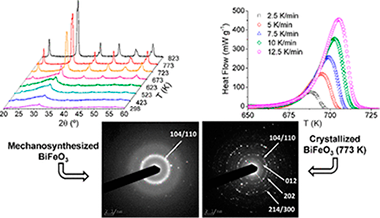
Crystallization is one key aspect in the resulting properties of nanocrystalline functional materials, and much effort has been devoted to understanding the physical mechanisms involved in these processes as a function of temperature. The main problems associated with crystallization kinetic studies come from the limitations of the employed techniques, and the obtained results may vary significantly depending on the choice of the measurement method. In this work, a complete description of the thermal crystallization event of nanocrystalline BiFeO3 has been performed by combining the information obtained from three different experimental techniques: in situ high-temperature X-ray diffraction, transmission electron microscopy, and differential scanning calorimetry. Interestingly, the kinetic analysis of the X-ray diffraction and differential scanning calorimetry data yields almost identical results, although the physical properties measured by both techniques are different. This allows the unambiguous determination of the kinetic parameters. The importance of a proper definition of the conversion degree, which is limited by the employed measurement technique, is also highlighted.
Mayo, 2018 | DOI: 10.1021/acs.cgd.8b00241
Gildings from Andalusia: Materials used in different types of artworks along centuries
Perez-Rodriguez, JL; Robador, MD; Albardonedo, A; Duran, AJournal of Cultural Heritage, 31 (2018) 112-121
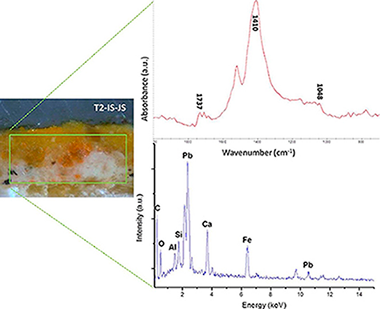
The majority of the studied artworks were altarpieces, sculptures and/or wood-based works from different periods. Non-traditional gilding techniques have been first described in this paper, such as those that employ materials as oil in the gilding on bole, glue and bole with lead white in mordant gilding, vermilion in the preparation layers; and brass gilding or those with aluminium, lead chromate, mica or corla trying to imitate the golden hue in restoration or repaint processes. For the determination of the composition of the different gilded layers, spectroscopic techniques, such as FTIR and micro-Raman, and SEM-EDX elemental chemical analyses were successfully used.
Mayo, 2018 | DOI: 10.1016/j.culher.2017.11.009
Reactividad de Sólidos
Carbonation of Limestone Derived CaO for Thermochemical Energy Storage: From Kinetics to Process Integration in Concentrating Solar Plants
Ortiz, C; Valverde, JM; Chacartegui, R; Perez-Maqueda, LAACS Sustainable Chemistry & Engineering, 6 (2018) 6404-6417
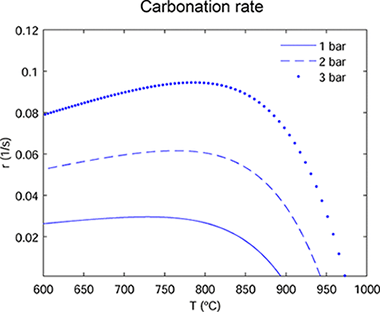
Thermochemical energy storage (TCES) is considered as a promising technology to accomplish high energy storage efficiency in concentrating solar power (CSP) plants. Among the various possibilities, the calcium-looping (CaL) process, based on the reversible calcination–carbonation of CaCO3 stands as a main candidate due to the high energy density achievable and the extremely low price, nontoxicity, and wide availability of natural CaO precursors such as limestone. The CaL process is already widely studied for CO2 capture in fossil fuel power plants or to enhance H2 production from methane reforming. Either one of these applications requires particular reaction conditions to which the sorbent performance (reaction kinetics and multicycle conversion) is extremely sensitive. Therefore, specific models based on the conditions of any particular application are needed. To get a grip on the optimum conditions for the carbonation of limestone derived CaO in the CaL-CSP integration, in the present work is pursued a multidisciplinary approach that combines theoretical modeling on reaction kinetics, lab-scale experimental tests at relevant CaL conditions for TCES, process modeling, and simulations. A new analytic equation to estimate the carbonation reaction rate as a function of CO2 partial pressure and temperature is proposed and validated with experimental data. Using the kinetics analysis, a carbonator model is proposed to assess the average carbonation degree of the solids. After that, the carbonator model is incorporated into an overall process integration scheme to address the optimum operation conditions from thermodynamic and kinetics considerations. Results from process simulations show that the highest efficiencies for the CaL-CSP integration are achieved at carbonator absolute pressures of ∼3.5–4 bar, which leads to an overall plant efficiency (net electric power to net solar thermal power) around 41% when carbonation is carried out at 950 °C under pure CO2
Mayo, 2018 | DOI: 10.1021/acssuschemeng.8b00199
Propiedades mecánicas, modelización y caracterización de cerámicos avanzados
High-temperature compressive creep of novel fine-grained orthorhombic ZrO2 ceramics stabilized with 12 mol% Ta doping
Sponchia, G; Moshtaghioun, BM; Riello, P; Benedetti, A; Gomez-Garcia, D; Dominguez-Rodriguez, A; Ortiz, ALJournal of the European Ceramic Society, 38 (2018) 2445-2448
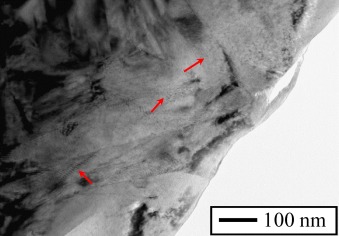
A novel fine-grained orthorhombic ZrO2 ceramic stabilized with 12 mol% Ta doping was fabricated by spark plasma sintering from home-made powders, and its high-temperature mechanical properties evaluated for the first time by compressive creep tests in both Ar and air. It was found that the high-temperature plasticity of the ceramic deformed in Ar, under which the Ta-doped orthorhombic ZrO2 is a black suboxide with abundant oxygen vacancies in its crystal structure, is controlled by grain boundary sliding (stress exponent similar to 2, and activation energy similar to 780-800 kJ/mol). However, the high-temperature plasticity of the ceramic deformed in air, under which the Ta-doped orthorhombic ZrO2 is a white oxide due to the elimination in situ of oxygen vacancies, is controlled by recovery creep (stress exponent 3, and activation energy similar to 750 kJ/mol). It was also observed that black Ta-doped orthorhombic ZrO2 is more creep resistant than its white counterpart with the same grain size, and that the former deforms as the more conventional Y2O3-stabilized ZrO2 does.
Mayo, 2018 | DOI: 10.1016/j.jeurceramsoc.2017.12.055
Reactividad de Sólidos
Development of a novel TiNbTa material potentially suitable for bone replacement implants
Chicardi, E; Gutierrez-Gonzalez, CF; Sayagues, MJ; Garcia-Garrido, CMaterials & Design, 145 (2018) 88-96
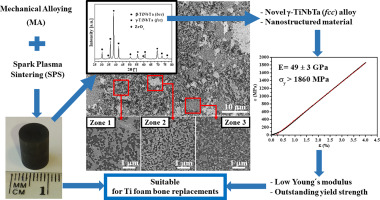
A novel (beta + gamma)-TiNbTa alloy has been developed by a combined low energy mechanical alloying (LEMA) and pulsed electric current sintering process (PECS). Microstructurally, this material presents interesting characteristics, such as a submicrometric range of particle size, a body-centered phase (beta-TiNbTa) and, mainly, a novel face-centered cubic Ti-based alloy (gamma-TiNbTa) not previously reported. Related to mechanical performance, the novel (beta + gamma)-TiNbTa shows a lower E (49 +/- 3 GPa) and an outstanding yield strength (sigma(y) 1860 MPa). This combination of original microstructure and properties makes to the (beta + gamma)-TiNbTa a novel material potentially suitable as biomaterial to fabricate bone replacement implants, avoiding the undesirable and detrimental stressshielding problem and even the usual damage on the mechanical strength of Ti-based foams biomaterials.
Mayo, 2018 | DOI: 10.1016/j.matdes.2018.02.042
Reactividad de Sólidos
Effects of additives on the synthesis of TiCxN1-x by a solid-gas mechanically induced self-sustaining reaction
Chicardi, E; Gotor, FJ; Alcala, MD; Cordoba, JMCeramics International, 44 (2018) 7605-7610
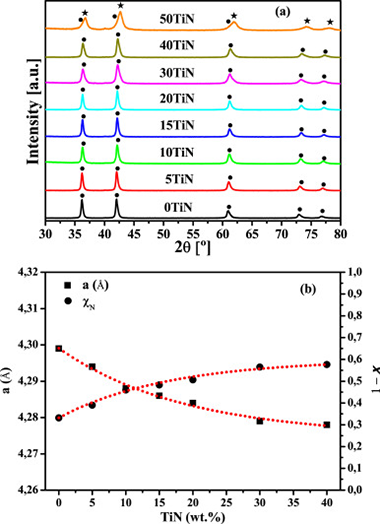
The synthesis of TiCxN1-x from Ti/C mixtures in a N-2 atmosphere performed in a high-energy planetary mill was used as example to study the influence of the use of additives in mechanically induced self-sustaining reaction (MSR) processes. In particular, the effect of the addition of TiN, TiC, Si3N4 and SiC was analyzed. The self-sustaining reaction was extinguished when additive contents of 50, 40, 40 and 30 wt% for TiN, TiC, Si3N4 and SiC, respectively, were employed. These additives cannot be regarded as real inert since they served as an extra solid source for nitrogen and carbon, modifying the final stoichiometry of the TiCxN1-x phase. The adiabatic temperature (T-ad) determined for the mixtures with no MSR effect was well above the empirical limit value of 1800 K adopted as criterion for the occurrence of the self-propagating high-temperature synthesis (SHS) process. The ignition time (t(ig)) of the MSR process was practically invariant for low additive contents (approximately 50 min) and tended to increase up to maximum values of 85-95 min for the larger additive contents.
Mayo, 2018 | DOI: 10.1016/j.ceramint.2018.01.179
Materiales Avanzados
Thermal behaviour of sericite clays as precursors of mullite materials
Gonzalez-Miranda, FD; Garzon, E; Reca, J; Perez-Villarejo, L; Martinez-Martinez, S; Sanchez-Soto, PJJournal of Thermal Analysis and Calorimetry, 132 (2018) 967-977

Thermal analysis of some sericite clays, from several deposits in Spain, which are not exploited at this time, has been studied. The samples have been previously characterized by mineralogical and chemical analysis. Sericite clays have interesting properties, with implications in ceramics and advanced materials, in particular concerning the formation of mullite by heating. According to this investigation by differential thermal and thermogravimetric analysis (DTA-TG), the sericite clay samples can be classified as: Group (I), sericite-kaolinite clays, with high or medium sericite content, characterized by an endothermic DTA peak of dehydroxylation of kaolinite with mass loss, which overlapped with dehydroxylation of sericite, and Group (II), sericite-kaolinite-pyrophyllite clays, with broader endothermic DTA peaks, in which kaolinite is dehydroxylated first and later sericite and pyrophyllite with the main mass loss, appearing the peaks overlapped. X-ray diffraction analysis of the heated sericite clay samples evidenced the decomposition of dehydroxylated sericite and its disappearance at 1050 A degrees C, with formation of mullite, the progressive disappearance of quartz and the formation of amorphous glassy phase. The vitrification temperature is similar to 1250 A degrees C in all these samples, with slight variations in the temperatures of maximum apparent density (2.41-2.52 g mL(-1)) in the range 1200-1300 A degrees C. The fine-grained sericite content and the presence of some mineralogical components contribute to the formation of mullite and the increase in the glassy phase by heating. Mullite is the only crystalline phase detected at 1400 A degrees C with good crystallinity. SEM revealed the dense network of rod-shaped and elongated needle-like mullite crystals in the thermally treated samples. These characteristics are advantageous when sericite clays are applied as ceramic raw materials.
Mayo, 2018 | DOI: 10.1007/s10973-018-7046-9
Reactividad de Sólidos
Fabrication and characterization of WC-HEA cemented carbide based on the CoCrFeNiMn high entropy alloy
Velo, IL; Gotor, FJ; Alcala, MD; Real, C; Cordoba, JMJournal of Alloys and Compounds, 746 (2018) 1-8

A high entropy alloy (HEA, CoCrFeNiMn) synthesized by mechanical alloying was used as the binder for the densification of WC by a pressureless high temperature procedure. Three different WC were used by modifying its microstructure with a high energy ball milling treatment. The alloy content in the HEA-WC mixture was varied from 10 to 30% vol. The microstructure and properties of the sintered composites were studied by X-ray diffraction, scanning electron microscopy and microindentation.
Mayo, 2018 | DOI: 10.1016/j.jallcom.2018.02.292
Reactividad de Sólidos
Influence of the Mn content on the TiNbxMn alloys with a novel fcc structure
Chicardi, E; Aguilar, C; Sayagues, MJ; Garcia-Garrido, CJournal of Alloys and Compounds, 746 (2018) 601-610

This work studies the structural evolution of TiNbxMn alloys (x: 0-12 wt%) synthetized by mechanical alloying in a planetary ball mill with different milling times between 1 h and 120 h. The specimens were characterized by X-ray diffraction patterns, scanning and transmission electron microscopies and Energy-dispersive X-ray spectroscopy. It was observed an evolution of the alloys developed from the raw Ti, Nb and Mn elements to bcc-TiNbxMn alloys and, finally, novel fcc-TiNbxMn alloys, with Fm3m space group symmetry, not previously observed. The presence of Mn promotes other interesting effects: a) the decreasing of the crystallite and the particle sizes, reaching values close to 4 nm and 400 nm, respectively, b) the partial amorphization of the fcc-TiNbxMn alloys due to the combined effect of the Mechanical Alloying and the difference of Mn atomic size in comparison with Ti and Nb and c) the presence of Mn that decreases the Fe amount (from milling media) in the as-milled powders.
Mayo, 2018 | DOI: 10.1016/j.jallcom.2018.02.306
Reactividad de Sólidos
Obituary Note: Prof. Jose Manuel Criado
Perez-Maqueda, L; Koga, N; Malek, JThermochimica Acta, 663 (2018) A1

The late Prof. Jose Manuel Criado (1944.6.13–2018.2.27)
It is with the profoundest regret that we must report the passing of Prof. José Manuel Criado on February 27, 2018 at the age of 73. We express our most sincere condolences to his family, colleagues and friends.
Prof. Criado was born in Sevilla, Spain, on June 13th, 1944. He studied chemistry at the University of Seville and recieved his PhD from the same university under the supervision of Prof. Francisco González García and Prof. José María Trillo. He held a position as assistant professor at the Department of Inorganic Chemistry of the University of Seville from 1968 until 1972. Then, he joined the Consejo Superior de Investigaciones Científicas (CSIC) or National Research Council of Spain. In this institution he was junior researcher, senior researcher and, from 1986, full professor. Moreover, he has been visiting professor in a number of international institutions such as Stanford University (USA), CNRS Thermodynamics and Microcalorimetry Center in Marseille (France), University of Salford (UK), Macaulay Research Institute (UK), Institute of Inorganic Chemistry (Czech Republic), University of Chile (Chile). He had long-lasting collaborations with scientists from all over the world and visited labs in many countries. For many years, he used to spend some weeks abroad in the frame of collaboration projects with a number of international research groups, of special importance where his projects with the Czech Republic or Chile that lasted for over 20 years. He also served as an editorial board member of Thermochimica Acta for a long time and contributed largely to the further development of our academic field.
First research works of Prof. Criado were done within the field of heterogeneous catalysis, but very soon, he got interested in reactivity of solids and thermal analysis. Thus, most of his scientific career has been devoted to the study of kinetics of solid-state processes and mechanochemisty. He published about 240 papers in international journals. In the field of kinetics of solid-state processes, he made significant contributions, such as showing the limitations of using single linear heating rate experiments for extracting kinetic parameters, the proposal of master curves for discerning the kinetic model followed by the process or the combined analysis of experimental data obtained under different heating schedules. Moreover, after learning about the sample controlled thermal analysis (SCTA) method directly from Prof. Rouquerol in Marseille (France) and Profs. Paulik brothers in Budapest (Hungary), he constructed several of these instruments and extended the use of SCTA to the kinetic analysis of heterogeneous reactions, highlighting its advantages over conventional heating. Additionally, he used the kinetic control of solid-state processes by SCTA for the preparation of a number of functional and structural materials with controlled microstructures and properties. In the field of mechanochemistry, he made substantial contributions to the preparation of materials by gas–solid reaction using high energy planetary ball mills specially modified by him to work under controlled gas atmosphere.
Probably, the main contribution of Prof. Criado as a scientist has been as teacher and mentor for many of us. Despite of spending most of his scientific career in a research center rather than in a university, his laboratories were always full of students, postdocs and visitors from all over the world. He devoted a great effort to motivate and stimulate young people to pursue a career in science. His enthusiasm for science was sincere, as he loved science and research. Thus, he worked until the very last days and, even, when he could not go to the institute because he did not feel well, he worked in a small lab at home. He was very generous and always shared his knowledge with others. Thus, he expended long hours teaching about kinetics, making the complex equations easy to understand. Only those with a deep knowledge have this ability! It is not rare that many of his former students, postdocs and coworkers have permanent positions as professors and scientist in a number of international institutions. Another significant feature of Prof. Criado was his hospitality. He and his wife Maria Jesús Dianez, who joined his research group few years ago, has always his home doors open to any coworker or visitor.
We will all miss him not only as a scientist with a deep knowledge but as a friend we loved so much.
Mayo, 2018 | DOI: 10.1016/j.tca.2018.05.004
Propiedades mecánicas, modelización y caracterización de cerámicos avanzados
Spark plasma sintering of titanium nitride in nitrogen: Does it affect the sinterability and the mechanical properties?
Moshtaghioun, BM; Gomez-Garcia, D; Dominguez-Rodriguez, AJournal of the European Ceramic Society, 38 (2018) 1190-1196
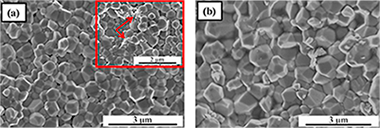
Titanium nitride ceramics have an intrinsic interest due to its optical and structural applications. However, the conditions for sintering of dense pieces are not still clarified. This research work is focused on the spark plasma sintering (SPS) of near-fully dense fine-grained TiN. The main goal is giving a response to a longstanding debate: can the external atmosphere favor sintering? Different sintering atmospheres, either vacuum or a nitrogen flow, have been used during SPS heating to this purpose. X ray diffraction analysis has showed the presence of TiN as the main phase with traces of Ti4O7 in optimal SPS conditions (1600 °C, one minute dwell time). Our results show that the use of a nitrogen flow while heating can improve sinterability very slightly, but mechanical properties are essentially unaltered within the experimental uncertainty. The hardness reaches values as high as 20GPa whereas fracture toughness can be evaluated around 4 MPam1/2.
Abril, 2018 | DOI: 10.1016/j.jeurceramsoc.2017.12.029
Reactividad de Sólidos
Phase-pure BiFeO3 produced by reaction flash-sintering of Bi2O3 and Fe2O3
Gil-Gonzalez, E; Perejon, A; Sanchez-Jimenez, PE; Sayagues, MJ; Raj, R; Perez-Maqueda, LAJournal of Materials Chemistry A, 6 (2018) 5356-5366
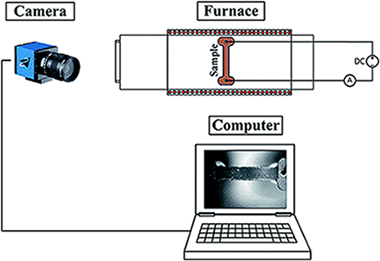
Mixed powders of Bi2O3 and Fe2O3 are shown to yield single-phase, dense nanostructured polycrystals of BiFeO3 in reaction flash sintering experiments, carried out by applying a field of 50 V cm(-1) and with the current limit set to 35 mA mm(-2). The furnace was heated at a constant rate with the reaction sintering taking place abruptly upon reaching 625 degrees C. Remarkably, an intermediate bismuth-rich phase of the oxide that forms just before reaching the flash temperature transforms, and at the same time sinters, into singlephase BiFeO3 within a few seconds after the onset of the flash. The BiFeO3 so produced is electrically insulating, a property that is critical to its applications. This one-step synthesis of single-phase polycrystals of complex oxides from their basic constituents, by reaction flash sintering, is a significant development in the processing of complex oxides, which are normally difficult to sinter by conventional methods.
Abril, 2018 | DOI: 10.1039/c7ta09239c
Materiales Avanzados
Synthesis of vaterite CaCO3 as submicron and nanosized particles using inorganic precursors and sucrose in aqueous medium
Perez-Villarejo, L; Takabait, F; Mahtout, L; Carrasco-Hurtado, B; Eliche-Quesada, D; Sanchez-Soto, PJCeramics International, 44 (2018) 5291-5296
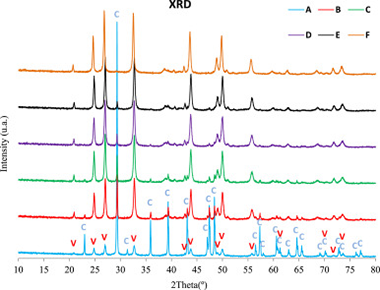
It is reported the synthesis of CaCO3 vaterite as stable nanoparticles and submicron-sized by a simple and relatively rapid procedure. XRD, SEM and FTIR techniques have been used to characterize the precipitated products. The synthesis is based on chemical precipitation of inorganic salt precursors, calcium nitrate tetra hydrate and sodium bicarbonate, and using the disaccharide sucrose as an additive in aqueous medium. The role of the disaccharide sucrose is to control the vaterite precipitation after nucleation and growth. It has been found that an increase in sugar concentration promotes the crystal precipitation of vaterite with spherulitic morphology, as revealed by SEM, and changed the surface of the precipitated particles. There is a significant difference between CaCO3 precipitation in the absence and presence of sucrose. Addition of 0% of sucrose leads to 83% of calcite as identified by XRD methods. In contrast, addition of 67% of sucrose in aqueous medium produces 100% vaterite. The present results may be useful to provide a quick, simple, inexpensive and novel method for the controlled synthesis of new advanced biomaterials based on vaterite particles without hazardous chemicals and inert atmosphere, with great possibilities for industrial scale production.
Abril, 2018 | DOI: 10.1016/j.ceramint.2017.12.142
Reactividad de Sólidos
Self-propagating mechanosynthesis of HfB2 nanoparticles by a magnesiothermic reaction
Jalaly, M; Gotor, FJ; Sayagues, MJJournal of the American Ceramic Society, 101 (2018) 1412-1419
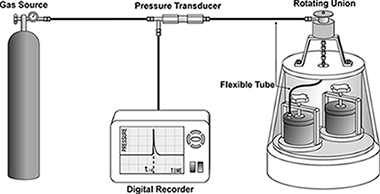
A mechanically induced self-sustaining reaction (MSR) was used to synthesize hafnium diboride nanoparticles. Along this route, magnesium was selected as a robust reducing agent for co-reduction in boron and hafnium oxides in a combustive manner. Combustion occurred after a short milling period of 12 minutes. The hafnium diboride nanoparticles had a polygonal faceted morphology and were 50-250 nm in diameter. The assessment of the processing mechanism revealed that the initial combustive reduction in B2O3 to elemental B by Mg was the major step for progressing the overall reaction. After that, HfO2 can be reduced to elemental Hf, followed by the synthesis of HfB2 phase.
Abril, 2018 | DOI: 10.1111/jace.15297
Propiedades mecánicas, modelización y caracterización de cerámicos avanzados
Is an alumina-whisker-reinforced alumina composite the most efficient choice for an oxidation-resistant high-temperature ceramic?
Tamura, Y; Moshtaghioun, BM; Zapata-Solvas, E; Gomez-Garcia, D; Dominguez-Rodriguez, A; Cerecedo-Fernandez, C; Valcarcel-Juarez, VJournal of the European Ceramic Society, 38 (2018) 1812-1818

The search of a competitive ceramic material for structural applications demands several requisites: a simple microstructure with easy reproducibility, good intrinsic mechanical properties and most of all, an optimal oxidation resistance. This later point is a challenging point for most ultrahigh refractory materials.
In this work an alumina (Al2O3) whisker-reinforced Al2O3 composite prepared by spark plasma sintering (SPS) is studied. It will be shown that, although the microstructure is quite similar to that of pure monolithic one, there is a notorious enhancement of the high-temperature deformation resistance, reaching up to one order of magnitude over the pure Al2O3 specimen. On the other hand, the activation energy of these composites increases notably. The results are explained in terms of an original model. A comparison with reported data shows that such composite is as efficient as a SiC-whisker-reinforced Al2O3 composite, with the advantage of its oxidation resistance and much less fabrication cost.
Abril, 2018 | DOI: 10.1016/j.jeurceramsoc.2017.10.006
Materiales Avanzados
Investigation of use of coal fly ash in eco-friendly construction materials: fired clay bricks and silica-calcareous non fired bricks
Eliche-Quesada, D; Sandalio-Perez, JA; Martinez-Martinez, S; Perez-Villarejo, L; Sanchez-Soto, PJCeramics International, 44 (2018) 4400-4412
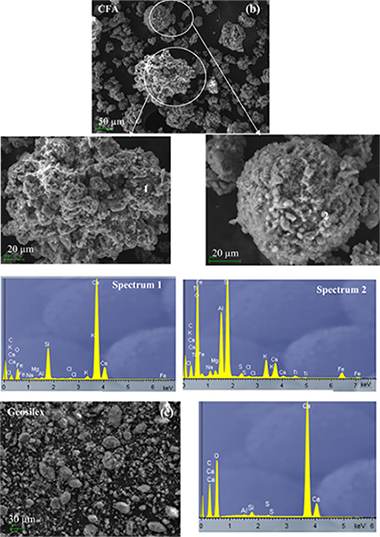
The use of coal fly ash (CFA) as raw material for the manufacture of two construction materials, fired clay bricks and silica-calcareous non-fired bricks, was investigated. Fired clay bricks were manufactured using a commercial clay and different waste ratios (0-50 wt%), moulded at 10 MPa and fired at 1000 degrees C (4 h). Silica-calcareous non fired bricks were prepared using two wastes as raw material: CFA and "geosilex"(G), a hidrated lime residue which comes entirely from acetylene industry waste. Different proportions CFA (80-30 wt%) G (20-70 wt%) were investigated. Raw materials were moulded at 10 MPa and cured in water at room temperature during 28 days. The results indicated that the incorporation of up to 20 wt% of CFA produced fired clay bricks with physical and mechanical properties similar to control bricks without waste. However, additions of a higher amount (30-50 wt%) of residue resulted in a more pronounced decrease in mechanical properties (between 25-50%) due to an increase in open porosity. The technological characterization of the silica-calcareous non fired bricks showed a reduction in the values of bulk density and water absorption when the coal fly ash content decreases. Silica-calcareous non-fired bricks containing between 40 and 60 wt% of CFA had the highest values of compressive strength in the range 46-43 MPa. These silica-calcareous non-fired bricks, 60CFA-40 G, 50CFA-50 G and 40CFA-60 G, presented the optimum amount of pozzolanic materials (SiO2 and Al2O3) in the coal fly ash and calcium hydroxide in the geosilex to give rise to the formation of calcium silicate hydrates and calcium aluminate hydrates, the phases responsible for the mechanical resistance increase of the construction materials. Therefore, CFA-clay fired bricks and silica-calcareous CFA-Geosilex non-fired bricks presented optimal technological properties that attain the quality standards.
Marzo, 2018 | DOI: 10.1016/j.ceramint.2017.12.039
Reactividad de Sólidos - Fotocatálisis Heterogénea: Aplicaciones
High {0 0 1} faceted TiO2 nanoparticles for the valorization of oxygenated compounds present in aqueous biomass-derived feedstocks
Fernández-Arroyo, A.; Lara, M.A.; Domine, M.E.; Sayagués, M.J.; Navío, J.A.; Hidalgo, M.C.Journal of Catalysts, 358 (2018) 266-276

{0 0 1} faceted TiO2 catalysts are hydrothermally synthesized by using titanium(IV) isopropoxide and butoxide precursors (ISO and BUT TiO2samples) together with HF addition. Their activity and stability are evaluated in the catalytic condensation of light oxygenated organic compounds present in an aqueous model mixture simulating a real bio-refinery effluent, under moderate operation conditions. High {0 0 1} faceted TiO2 catalysts show organic products yields superior to those attained with other TiO2 samples (anatase, rutile, and P25). This enhanced catalytic activity relates to their physico-chemical and textural properties, such as high surface area (≈100 m2/g), regular morphology (platelets conformed by partially agglomerated TiO2 nanoparticles), and adequate Lewis acidity. XRD and Raman measurements evidence the unique presence of anatase crystalline phase in both ISO and BUT materials, in which the use of HF during synthesis produces the preferential growth of TiO2 crystals mainly exposing the {0 0 1} plane. This effective {0 0 1} facet exposition directly determines catalytic results. Moreover, TiO2 ISO catalyst shows outstanding stability under reaction conditions, maintaining practically unaltered their activity after several re-uses. In particular, Lewis acid sites present in TiO2 faceted materials are more stable in the presence of organic acids under aqueous environments. This opens new possibilities for the application of these materials in the valorization of light oxygenated compounds present in biomass-derived aqueous effluents.
Febrero, 2018 | DOI: 10.1016/j.jcat.2017.12.018
Reactividad de Sólidos
Calcium-Looping performance of mechanically modified Al2O3-CaO composites for energy storage and CO2 capture
Benitez-Guerrero, M; Valverde, JM; Sanchez-Jimenez, PE; Perejon, A; Perez-Maqueda, LAChemical Engineering Journal, 334 (2018) 2343-2355

This work reports the Calcium-Looping (CaL) multicycle performance under energy storage and CO2 capture conditions of different Al-composites prepared by milling mixtures of nanoalumina and natural limestone powders. The micro-and nanostructure of the composites have been analyzed by X-ray diffraction, scanning electron microscopy and high-resolution transmission electron microscopy as affected by the type of CaL conditions employed, either for energy storage in Concentrated Solar Power (CSP) plants or for post-combustion CO2 capture. Two types of calcium aluminates are formed under these diverse CaL conditions. A calcium aluminate with ratio Ca/Al < 1 (Ca4Al6O13) is formed under CaL-CSP conditions, which helps stabilize the CaO microstructure and mitigate pore-plugging. On the other hand, a crystalline phase Ca3Al2O6 is formed (Ca/Al > 1) under CaL-CO2 capture conditions presumably due to the higher calcination temperature, which withdraws from the sorbent a relatively higher amount of active Ca. Moreover, the addition of nano-alumina, and the consequent generation of calcium aluminate, affects in a diverse way the microstructure and morphology of the CaO particles as depending on the CaL application, which critically modifies the performance of the composites.
Febrero, 2018 | DOI: 10.1016/j.cej.2017.11.183
Reactividad de Sólidos
Effect of Basicity on the Hydrolysis of the Bi(III) Aqua Ion in Solution: An Ab Initio Molecular Dynamics Study
Ayala, R; Martinez, JM; Pappalardo, RR; Refson, K; Marcos, ESJournal of Physical Chemistry A, 122 (2018) 1905-1915

Hydrolysis of the Bi(III) aqua ion under a range of solution conditions has been studied by means of ab initio molecular dynamics simulations. While the Bi(III) aqua ion is stable in pure water, there is an increasing degree of hydrolysis with the number of hydroxide anions in the medium. This is accompanied by a monotonic decrease of the total coordination number to an asymptotic value of similar to 6, reached under extreme basicity conditions. Comparison of the simulated Bi(III) hydrolyzed species with the experimental species distribution at different degrees of basicity suggests that, at the PBE/DFT level of theory here employed, liquid water shows an overly acidic character. Predictions of theoretical EXAFS and XANES spectra were generated from the AIMD trajectories for different Bi hydrolyzed species, [Bi(HO)(m)(H2O)(n)](3-m+), m = 0-3 and n = 7-2. Comparison with available experimental spectra is presented. Spectral features joined to the degree of hydrolysis and hydration are analyzed.
Febrero, 2018 | DOI: 10.1021/acs.jpca.7b12402
Reactividad de Sólidos
Influence of temperature on the biaxial strength of cemented carbides with different microstructures
Chicardi, E; Bermejo, R; Gotor, FJ; Llanes, L; Torres, YInternational Journal of Refractory Metals & Hard Materials, 71 (2018) 82-91
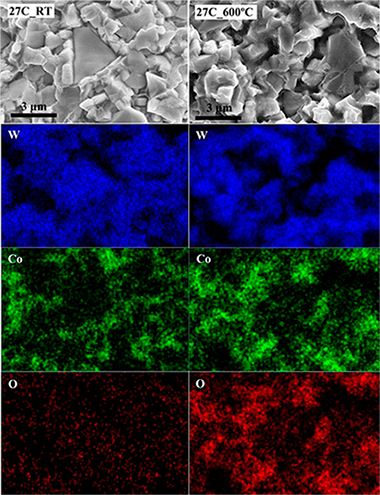
The effect of the temperature on the mechanical strength of WC-Co cemented carbides with different microstructures (grain size and binder content) was evaluated. Biaxial flexural tests were performed on three cemented carbide grades at 600 °C using the ball-on-three-balls (B3B) method. Results were interpreted by Weibull statistics and compared to biaxial strength results at room temperature. A detailed fractographic analysis, supported by Linear Elastic Fracture Mechanics, was performed to differentiate the nature and size of critical defects and the mechanism responsible for the fracture. A significant decrease in the mechanical strength (around 30%) was observed at 600 °C for all grades of cemented carbides. This fact was ascribed to the change in the critical flaw population from sub-surface (at room temperature) to surface defects, associated with the selective oxidation of Co. Additionally, an estimation of the fracture toughness at 600 °C was attempted for the three cemented carbides, based upon the B3B strength results, the corresponding number of the tested specimens fragments and the macroscopic area of the B3B fracture surfaces. The fracture toughness was not affected by the temperature, at least up to 600 °C. In addition, the good agreement with the Single Edge Notch Beam toughness data suggests the possibility of employing this approach for fracture toughness evaluation of brittle materials under different testing conditions.
Febrero, 2018 | DOI: 10.1016/j.ijrmhm.2017.11.003
Reactividad de Sólidos - Fotocatálisis Heterogénea: Aplicaciones
A facile shape-controlled synthesis of highly photoactive fluorine containing TiO2 nanosheets with high {001} facet exposure
Lara, M.A.; Sayagués, M.J.; Navío, J.A.; Hidalgo, M.C.Journal of Materials Science, 53 (2018) 435-446
Surface-fluorinated TiO2 materials with high {001} facet exposure were prepared by a simple and high-yield preparation procedure. Faceted/fluorinated samples showed a high photocatalytic performance not only in oxidation processes, tested in phenol and methyl orange degradation, but also in a reduction process as Cr(VI) photoreduction. Reaction rates for these materials greatly exceeded the ones obtained for materials prepared without fluorine addition and for commercial TiO2 Degussa (Evonik) P25 used as reference photocatalyst. A broad characterisation of the samples allowed us to estimate the percentages of different facets and the amount and form in which the fluorine is found on the surfaces. Good photocatalytic behaviour can be ascribed to both high {001} facet exposure and adsorbed fluorine on the photocatalysts surfaces.
Enero, 2018 | DOI: 10.1007/s1085
Reactividad de Sólidos
Core-rim structure formation in TiC-Ni based cermets fabricated by a combined thermal explosion/hot-pressing process
Lemboub, S; Boudebane, S; Gotor, FJ; Haouli, S; Mezrag, S; Bouhedja, S; Hesser, G; Chadli, H; Chouchane, TInternational Journal of Refractory Metals & Hard Materials, 70 (2018) 84-92

TiC-Ni-based cermets were obtained by thermal explosion from different elemental mixtures (Ti, C, Ni and X, where X = Cr, Mo or W) and subsequently densified by hot-pressing under a cyclic load. The whole process was performed in a single stage in the same experimental device according to the following thermal and pressure procedure: a heating rate ramp up to 1573 K without applying any load followed by an isothermal dwelling under a compressive cyclic load of 32 MPa. The thermal explosion synthesis occurred during the heating ramp at a temperature close to 1273 K that was practically independent of the starting nominal composition. The influence of different refractory elements on the chemical composition and microstructure of cermets was studied. SEM characterization showed that only with Mo and W, the cermets developed the characteristic core-rim structure. A high densification was achieved, but decreased when the refractory elements were added. Nevertheless, in these cases higher hardness values were obtained.
Enero, 2018 | DOI: 10.1016/j.ijrmhm.2017.09.014
Reactividad de Sólidos
A new combustion route for synthesis of TaB2 nanoparticles
Jalaly, M; Gotor, FJCeramics International, 44 (2018) 1142-1146
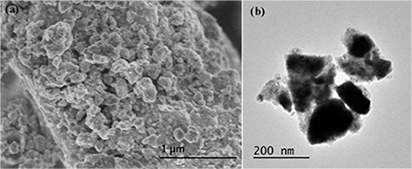
Tantalum diboride (TaB2) nanoparticles were synthesized through a mechanically induced self-sustaining reaction (MSR). In this method, the ternary system of Mg/Ta2O5/B was employed in which, magnesium was used as a reducing agent for reduction of tantalum oxides in a combustive regime. The processing route of TaB2 by the solid-state combustion was very short-term and the product purification was extremely easy and rapid. The synthesis mechanism was studied and revealed that magnesiothermic reduction of tantalum oxide is the initiator of the total reaction, while borothermic reduction of the oxide may occur in parallel.
Enero, 2018 | DOI: 10.1016/j.ceramint.2017.10.074
Reactividad de Sólidos
The dizinc bond as a ligand: A computational study of elongated dizinc bonds
Ayala, R; Carmona, E; Galindo, AInorganic Chimica Acta, 470 (2018) 197-205

Following the synthesis of [Zn-2(eta(2)-C5Me5)(2)] (in short [Zn2Cp*(2)]) many complexes of the directly bonded Zn-Zn unit were prepared and characterized, leading to the recognition of an isolobal analogy between the Zn-Zn bond and the molecule of dihydrogen. Prompted by these results, we have investigated eta(2)-eta(2)-coordination of [Zn2Cp2] and [Zn2Ph2] (Cp = C5H5, Ph = C6H5) to several selected transition metal fragments and report herein the results of a QTAIM study of complexes [(ZnR)(2)Fe(CO)(4)], [(eta(2)-Zn2R2)M(CO)(5)]] and [(eta(2)-Zn2R2)Pd(PR'(3))(2)] (for R = Cp, Ph; M = Cr, Mo, W; and R' = F, H, Me). A decrease of rho(BCP), Delta(2) rho(BCP) and delocalization indexes delta(Zn, Zn), relative to corresponding values in the parent molecules of [Zn2Cp2] and [Zn2Ph2], accompanied dizinc coordination. In most cases the computed d(Zn, Zn) parameters were indicative of significant electron density sharing between the two Zn atoms. Nevertheless, the interaction with [Fe(CO)(4)] resulted in oxidative cleavage of the coordinated Zn-Zn bond, due to high pi backdonation to the sigma* Zn-2 MO as deduced from the delta(M, O-CO) index. The Zn-Zn bond critical points identified in our study are discussed. The computed Zn-Zn contacts concentrate in the range 2.44-2.58 angstrom, and we propose that this interval corresponds to elongated dizinc bonds.
Enero, 2018 | DOI: 10.1016/j.ica.2017.06.008
Reactividad de Sólidos
Corrigendum to “Dense graphene nanoplatelet/yttria tetragonal zirconia composites: Processing, hardness and electrical conductivity” [Ceram. Int. 43 (2017) 11743–11752]
Gallardo-Lopez, A; Marquez-Abril, I; Morales-Rodriguez, A; Munoz, A; Poyato, RCeramics International, 44 (2018) 1225-1225
Reactividad de Sólidos
Low-cost Ca-based composites synthesized by biotemplate method for thermochemical energy storage of concentrated solar power
Benitez-Guerrero, M; Valverde, JM; Perejon, A; Sanchez-Jimenez, PE; Perez-Maquecla, LAApplied Energy, 210 (2018) 108-116
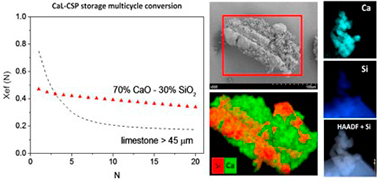
An ever more environmentally conscious society demands the use of green, sustainable and high-efficiency renewable energy resources. However, large-scale energy storage remains a challenge for a deep penetration of power produced from renewables into the grid. The Calcium-Looping (CaL) process, based on the reversible carbonation/calcination of CaO, is a promising technology for thermochemical energy storage (TCES) in Concentrated Solar Power (CSP) plants. Natural limestone to be used as CaO precursor is cheap, non-toxic and abundant. Nevertheless, recent works have shown that carbonation of CaO derived limestone at optimum conditions for TCES is limited by pore-plugging, which leads to severe deactivation for large enough particles to be employed in practice. In our work, we have synthesized inexpensive CaO/SiO2 composites by means of a biotemplate method using rice husk as support. The morphological and compositional features of the biomorphic materials synthesized help improve the CaO multicycle activity under optimum CSP storage conditions and for particles sufficiently large to be managed in practical processes.
Enero, 2018 | DOI: 10.1016/j.apenergy.2017.10.109
Reactividad de Sólidos
Development of a novel fcc structure for an amorphous-nanocrystalline Ti-33Nb-4Mn (at.%) ternary alloy
Chicardi, E; Garcia-Garrido, C; Sayagues, MJ; Torres, Y; Amigo, V; Aguilar, CMaterials Characterization, 135 (2018) 46-56
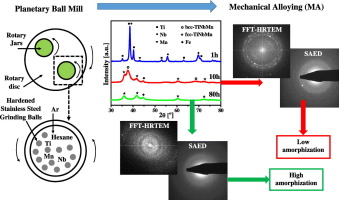
In this work, a novel amorphous-nanocrystalline titanium-niobium-manganese solid solution ternary alloy with a Ti-33Nb-4Mn (at.%) nominal composition was developed by a High-Energy Mechanical Alloying. Nb and Mn were added to the elemental Ti as a beta-phase (bcc) stabilizer and an amorphization promoter, respectively. The system evolved from the elemental Ti, Nb and Mn raw materials to a body centred cubic (bcc) TiNbMn alloy and, finally, to the formation of an original and stable face centred cubic (fcc) nanocrystalline TiNbMn alloy, not reported until now, at short milling time (20 h). This alloy remains invariant until 120 h. In turn, the partial amorphization of the system occurs and increases until at intermediate milling time (80 h). The production of both original fcc and the amorphous TiNbMn alloy may be beneficial for reducing the Young's modulus and improving the mechanical strength pursued for the Ti alloy. The optimal milling time respect to the amorphization, nanocrystalline size and Fe mount from milling media was 60 h and 80 h (TiNbMn60h and TiNbMn80h), with > 50 wt% of an amorphous phase and a crystalline domain size of approximately 5 nm.
Enero, 2018 | DOI: 10.1016/j.matchar.2017.11.021
Propiedades mecánicas, modelización y caracterización de cerámicos avanzados
High temperature creep of 20 vol%. SiC-HfB2 UHTCs up to 2000 degrees C and the effect of La2O3 addition
Zapata-Solvas, E; Gomez-Garcia, D; Dominguez-Rodriguez, A; Lee, WEJournal of the European Ceramic Society. 38 (2018) 47-56
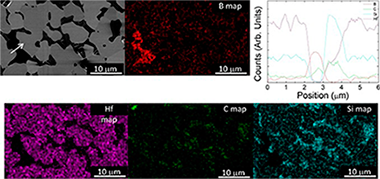
High temperature compressive creep of SiC-HfB2 UHTCs up to 2000 °C has been studied. Microstructural analysis after deformation reveals formation of new phases in the Hf-B-Si and Hf-B-Si-C systems, which are responsible for the poor creep resistance. RE oxide additions have a negative effect reducing the creep resistance of SiC-HfB2 UHTCs. A simplistic analysis for the required creep resistance is described, indicating that only SiC-HfB2 UHTCs could withstand re-entry conditions for 5 min in a single use. However, RE oxide addition to SiC-HfB2UHTCs does not provide the required creep resistance for them to be candidate materials for hypersonic applications.
Enero, 2018 | DOI: 10.1016/j.jeurceramsoc.2017.08.028
2017
2017
Reactividad de Sólidos
Chalcogenide Quaternary Cu2FeSnS4 Nanocrystals for Solar Cells: Explosive Character of Mechanochemical Synthesis and Environmental Challenge
Balaz, P; Balaz, M; Sayagues, MJ; Eliyas, A; Kostova, NG; Kanuchova, M; Dutkova, E; Zorkovska, ACrystals, 7 (2017) art. 367
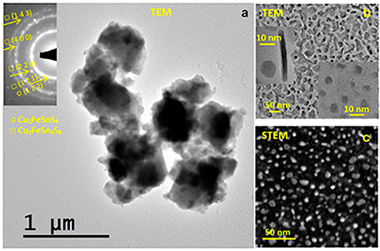
In this study we demonstrate the synthesis of quaternary semiconductor nanocrystals of stannite Cu2FeSnS4/rhodostannite Cu2FeSn3S8 (CFTS) via mechanochemical route using Cu, Fe, Sn and S elements as precursors in one-pot experiments. Methods of X-ray diffraction (XRD), nitrogen adsorption, high-resolution transmission electron microscopy (HRTEM), scanning transmission electron microscopy (STEM), energy-dispersive X-ray spectroscopy (EDX) and X-ray photoelectron spectroscopy (XPS) were applied to characterize properties of the unique nanostructures. Mechanochemical route of synthesis induced new phenomena like explosive character of reaction, where three stages could be identified and the formation of nanostructures 5-10 nm in size. By using XPS method, Cu(I), Fe(II), Sn(IV) and S(-II) species were identified on the surface of CFTS. The value of optical band gap 1.27 eV is optimal for semiconductors applicable as absorbers in solar cells. The significant photocatalytic activity of the CFTS nanocrystals was also evidenced. The obtained results confirm the excellent properties of the quaternary semiconductor nanocrystals synthesized from earth-abundant elements.
Diciembre, 2017 | DOI: 10.3390/cryst7120367
Reactividad de Sólidos
Effect of acid-treatment and colloidal-processing conditions on the room temperature mechanical and electrical properties of 3YTZP/MWNT ceramic nanocomposites
Poyato, R.; Morales-Rodríguez, A.; Gutiérrez-Mora, F.; Muñoz, A.; Gallardo-López, A.Ceramics International, 43 (2017) 16560-16568
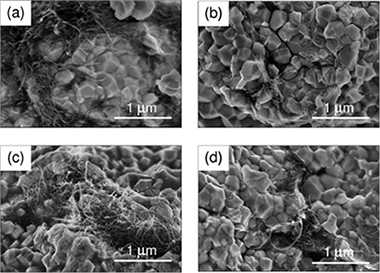
Different colloidal powder processing routines have been used to prepare composites of 3 mol% Y2O3 -ZrO2 (tetragonal zirconia polycrystals, 3YTZP) with 2.5 vol% multiwall carbon nanotubes (MWNT) with the aim of achieving a homogeneous distribution of the MWNTs in the ceramic, eliminating agglomerates but also minimizing carbon nanotube (CNT) damage during processing. Modifications of the acid treatment applied to the nanotubes, including subjecting them to stirring or ultrasonic agitation, and use of acid or basic pH during composite powder mixing have been approached.
No MWNT damage during processing was detected by Raman spectroscopy. CNT bundles were found in all the composites forming different patterns depending on the processing route. Similar values of hardness were obtained for all the composites, while different anisotropy in fracture propagation was found when studying parallel and perpendicular directions to the sintering pressing axis on the cross sections of the composites due to the MWNT preferential alignment. The CNT bundles were found to act as fracture short paths. A similar anisotropic behavior was observed for the electrical conductivity. These results have been correlated to the different microstructures obtained in the composites prepared with different processing routines.
Diciembre, 2017 | DOI: 10.1016/j.ceramint.2017.09.043
Reactividad de Sólidos
Calcium-Looping performance of steel and blast furnace slags for thermochemical energy storage in concentrated solar power plants
Valverde, JM; Miranda-Pizarro, J; Perejon, A; Sanchez-Jimenez, PE; Perez-Maqueda, LAJournal of CO2 Utilization, 22 (2017) 143-154
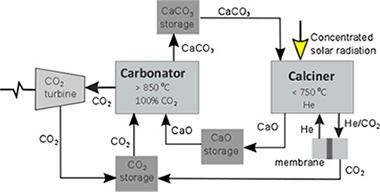
The Calcium Looping (CaL) process, based on the carbonation/calcination of CaO, has been proposed as a feasible technology for Thermochemical Energy Storage (TCES) in Concentrated Solar Power (CSP) plants. The CaL process usually employs limestone as CaO precursor for its very low cost, non-toxicity, abundance and wide geographical distribution. However, the multicycle activity of limestone derived CaO under relevant CaL conditions for TCES in CSP plants can be severely limited by pore plugging. In this work, the alternative use of calcium-rich steel and blast furnace slags after treatment with acetic acid is investigated. A main observation is that the calcination temperature to regenerate the CaO is significantly reduced as compared to limestone. Furthermore, the multicycle activity of some of the slags tested at relevant CaL conditions for TCES remains high and stable if the treated samples are subjected to filtration. This process serves to remove silica grains, which helps decrease the porosity of the CaO resulting from calcination in the mesoporous range thus mitigating pore plugging.
Diciembre, 2017 | DOI: 10.1016/j.jcou.2017.09.021
Materiales Avanzados
Characterization of ashes from greenhouse crops plant biomass residues using X-ray fluorescence analysis and X-ray diffraction
Garzon, E; Morales, L; Martinez-Blanes, JM; Sanchez-Soto, PJX-ray spectrometry, 46 (2017) 569-578
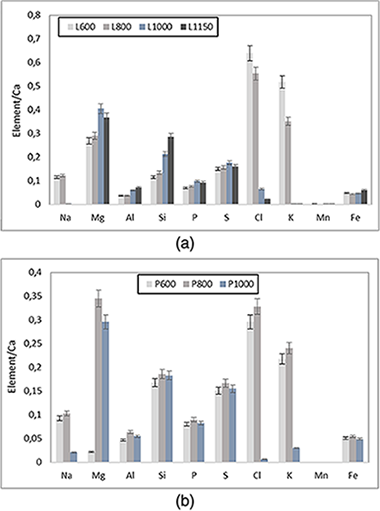
A characterization of ashes obtained by thermal treatments on greenhouse crops plant biomass residues is presented. The chemical analysis, by X-ray fluorescence (wavelength-dispersive X-ray fluorescence), and phase analysis, by X-ray diffraction, of the resultant ashes are reported. Thermal treatments of selected samples of these residues increase the relative amounts of inorganic Mg, Si, P, and S in the ashes, being these amounts as high as increasing temperature. As an opposite effect, Na, Cl, and K contents decrease as increasing temperature by a volatilization process of the chlorides, as confirmed by X-ray diffraction. The crystalline phase analysis of the ashes demonstrates the formation of inorganic constituents of the biomass, including alkaline chlorides and calcium salts (calcite, anhydrite, and apatite). Progressive thermal treatments induce the formation of new silicate phases (akermanite and grossularite) and silica (-quartz and cristobalite). Furthermore, the particle size of the starting biomass samples does not influence the evolution of the crystalline phases by thermal treatments. In contrast, a previous leaching using water and subsequent heating at 1,000 degrees C produces the formation of periclase (MgO), lime (CaO), and the silicate gehlenite, without the presence of anhydrite. This study is interesting for future investigations on the residues as a profitable biomass source for energy production and sustainable large-scale management. Some potential applications of the resultant ashes can be proposed.
Noviembre, 2017 | DOI: 10.1002/xrs.2801
Reactividad de Sólidos
Defect chemistry and electrical properties of BiFeO3
Schrade, M; Maso, N; Perejon, A; Perez-Maqueda, LA; West, ARJournal of Materials Chemistry C, 5 (2017) 10077-10086
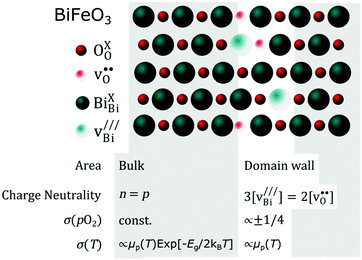
BiFeO3 attracts considerable attention for its rich functional properties, including room temperature coexistence of magnetic order and ferroelectricity and more recently, the discovery of conduction pathways along ferroelectric domain walls. Here, insights into the defect chemistry and electrical properties of BiFeO3 are obtained by in situ measurements of electrical conductivity, sigma, and Seebeck coefficient, a, of undoped, cation-stoichiometric BiFeO3 and acceptor-doped Bi1-xCaxFeO3-delta ceramics as a function of temperature and oxygen partial pressure pO(2). Bi1-xCaxFeO3-delta exhibits p-type conduction; the dependencies of s and a on pO(2) show that Ca dopants are compensated mainly by oxygen vacancies. By contrast, undoped BiFeO3 shows a simultaneous increase of s and a with increasing pO(2), indicating intrinsic behavior with electrons and holes as the main defect species in almost equal concentrations. The pO(2)-dependency of s and a cannot be described by a single point defect model but instead, is quantitatively described by a combination of intrinsic and acceptor-doped characteristics attributable to parallel conduction pathways through undoped grains and defect-containing domain walls; both contribute to the total charge transport in BiFeO3. Based on this model, we discuss the charge transport mechanism and carrier mobilities of BiFeO3 and show that several previous experimental findings can readily be explained within the proposed model.
Octubre, 2017 | DOI: 10.1039/c7tc03345a
Reactividad de Sólidos
Dense graphene nanoplatelet/yttria tetragonal zirconia composites: Processing, hardness and electrical conductivity
Gallardo-Lopez, A; Marquez-Abril, I; Morales-Rodriguez, A; Munoz, A; Poyato, RCeramics International, 43 (2017) 11743-11752
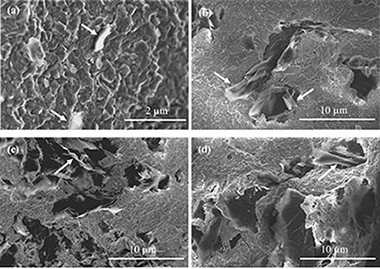
Yttria tetragonal zirconia ceramic composites with 1, 2.5, 5 and 10 vol% nominal contents of graphene nanoplatelets (GNPs) were fabricated and characterized. First, the GNP dispersion in isopropanol was optimized to de-agglomerate the GNPs without damaging their structure. Then, submicrometric fully dense composites were obtained via spark plasma sintering (SPS) at 1250 degrees C with a 5 min holding time. The processing routine produced a nearly homogeneous GNP dispersion in the ceramic matrix, and the GNPs preferential orientation was perpendicular to the sintering compression axis. A ceramic grain refinement due to the GNPs was also detected. The Vickers hardness measured on the plane perpendicular to the sintering compression axis (basal plane) was lower than on the cross sections. This anisotropy increased with the increasing GNP content, while the average hardness decreased. The electrical conductivity was also highly anisotropic, up to seven times higher for the basal planes. The electrical percolation threshold for these composites was estimated to be between 2.2 and 4.4 vol% of the GNP measured content.
Octubre, 2017 | DOI: 10.1016/j.ceramint.2017.06.007
Reactividad de Sólidos
Microstructure characterization of multifunctional As4S4/Fe3O4 nanocomposites prepared by high-energy mechanical milling
Shpotyuk, O; Bujnakova, Z; Sayagues, MJ; Balaz, P; Ingram, A; Shpotyuk, Y; Demchenko, PMaterials Characterization, 132 (20187) 303-311
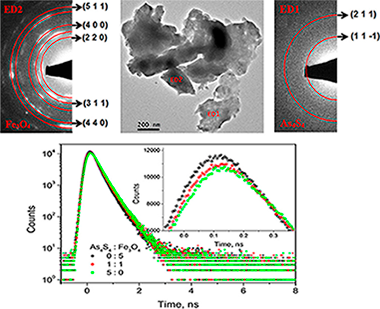
Multifunctional As4S4/Fe3O4 nanocomposites prepared by high-energy mechanical milling are probed by complementary methods of positron annihilation lifetime (PAL) spectroscopy, supported by microstructure characterization using X-ray powder diffraction (XRPD) with analysis applied to the first sharp diffraction peak (FSDP), morphology studies by transmission electron microscopy (TEM) with energy-dispersive spectroscopy (EDS) and high-resolution TEM (HRTEM).
These nanocomposites are shown to consist of Fe3O4 crystallites with particle sizes of 8-21 nm, and far separated beta-As4S4 crystallites surrounded by amorphous As-S phase. In respect to PAL data, the effect of milling is identified as possible conversion from Ps traps to positron-trapping sites depending on preferential chemistry of atomic surrounding. So, the interfacial triple junctions at the intersections of Fe3O4 crystallites are identified as principal positron traps in As4S4/Fe3O4 nanocomposites with competitive influence from free-volume defects of amorphous As-S phase.
Octubre, 2017 | DOI: 10.1016/j.matchar.2017.08.028
Reactividad de Sólidos
Multicycle activity of natural CaCO3 minerals for thermochemical energy storage in Concentrated Solar Power plants
Benitez-Guerrero, M; Valverde, JM; Sanchez-Jimenez, PE; Perejon, A; Perez-Maqueda, LASolar Energy, 153 (2017) 188-199
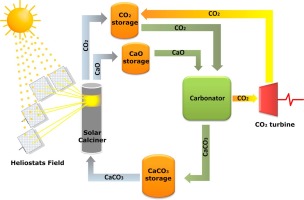
Thermochemical energy storage in Concentrated Solar Power plants by means of the Calcium-Looping process is a promising novel technology that would allow for a higher share of renewables. A main benefit of this technology is the use of widely available, non-toxic and environmentally friendly calcium carbonate minerals as raw materials to store energy. Efficient integration of the Calcium-Looping process into Concentrated Solar Power plants involves the endothermic calcination of CaCO3 in the solar receiver while the exothermic carbonation of CaO is carried out at high temperature under high CO2 partial pressure. The heat released by this reaction is carried out by the excess CO2 and employed for power generation by means of a closed CO2 cycle. This work explores the multicycle Calcium-Looping performance of naturally occurring CaCO3 minerals such as limestone, chalk and marble for thermochemical energy storage in Concentrated Solar Power plants. Despite their similar composition (almost pure CaCO3), these minerals exhibit a significant difference in their Calcium-Looping multicycle activity, which may be attributed to differences in particle size and microstructure. Pore plugging at the Calcium-Looping conditions for thermochemical energy storage tested in our work is a main limiting mechanism on the multicycle CaO carbonation activity.
Septiembre, 2017 | DOI: 10.1016/j.solener.2017.05.068
Propiedades mecánicas, modelización y caracterización de cerámicos avanzados
Carbon nanofibers replacing graphene oxide in ceramic composites as a reinforcing-phase: Is it feasible?
Cano-Crespo, Rafael; Malmal Moshtaghioun, Bibi; Gomez-Garcia, Diego; Dominguez-Rodriguez, Arturo; Moreno, RodrigoJournal of the European Ceramic Society, 37 (2017) 3791-3796
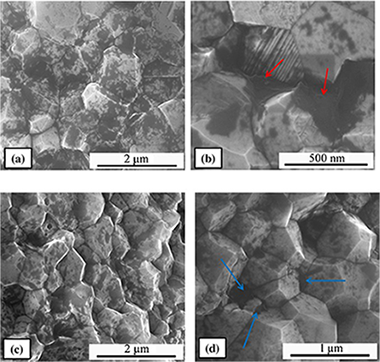
In recent years, the interest of graphene and graphene-oxide has increased extraordinarily due to the outstanding properties concurring in this material. In ceramic science, the possibility of combining excellent electrical conductivities together with an enhancement of mechanical properties has motivated the research in fabrication of graphene oxide-reinforced ceramic composites despite the intrinsic difficulties for sintering. In this work a comparison is made between graphene oxide-reinforced alumina composites and carbon nanofiber-reinforced alumina ones. It will be concluded that the improvement of mechanical properties is scarce, if any. Since carbon nanofibers have also a good electrical conductivity their importance for future applications as a replacement of more sophisticated but expensive graphene-based ceramic composites will be stressed.
Septiembre, 2017 | DOI: 10.1016/j.jeurceramsoc.2017.03.027
Reactividad de Sólidos
Influence of milling parameters on the solid-gas synthesis of TiCxN1-x by mechanically induced self-sustaining reaction
Chicardi, E; Gotor, FJ; Alcala, MD; Cordoba, JMPowder Technology, 319 (2017) 12-18
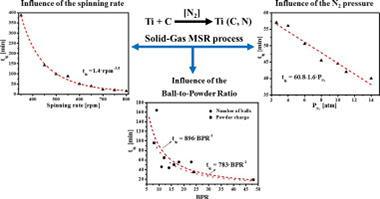
The synthesis of a titanium carbonitride solid solution (TiCxN1 − x) performed in a high-energy planetary mill by a solid-gas Mechanically induced Self-sustaining Reaction (MSR) was used to study the influence of a full set of experimental milling parameters on the ignition time (tig) as a measure of the mechanical dose rate provided by the mill. The highly exothermic Ti-C-N mixture was selected to ensure no competitiveness between MSR and diffusion-controlled routes under the milling conditions employed. The results showed that the dependence of tig on the spinning rate followed a potential function, with a potential factor higher than the value of 3 that would be obtained if a perfect collision model is assumed. The scalability of milling processes performed using planetary mills was confirmed. The results suggested that to define a milling experiment, it is necessary to provide not only the Ball-to-Powder mass Ratio (BPR) and spinning rate values, as is usually performed, but also the full set of milling parameters including the nature of the milling media (vial and balls), the number and size of balls, the mass of the powder charge, the pressure of the reactive gas and even the volume of the vial.
Septiembre, 2017 | DOI: 10.1016/j.powtec.2017.06.035
Reactividad de Sólidos
Simultaneous adsorption and photocatalytic behavior of hybrid mesoporous ZnS-SiO2 nanocomposite
Emrooz, HBM; Gotor, FJMaterials Research Express, 4 (2017) art. 085037
Mesoporous ZnS-SiO2 nanocomposite was synthesized with a facile process. At first a large pore volume (1.86 cm(3).g(-1)), moderate pore size (about 12.8 nm) and moderate surface area (586 m(2).g(-1)) mesoporous SiO2 was synthesized in an acidic PH using cationic surfactant. ZnS nanoparticles were infiltrated in the porosities of the synthesized SiO2, with a room temperature post grafting method. The synthesized particles have been characterized with transmission electron microscopy (TEM), x-ray diffraction (XRD), x-ray photoelectron spectroscopy (XPS), Brunauer-Emmett-Teller (BET), furrier transformation infrared spectroscopy (FTIR) and diffuse reflectance spectroscopy (DRS). Results confirm the mesoporous characteristics of ZnS-SiO2 nanocomposite with specific surface area as high as 248 m(2).g(-1), pore volume of 0.89 cm(3).g(-1) and average pore diameter of about 14.4 nm. Simultaneous adsorption-photocatalytic behavior of this hybrid mesoporous nanocomposite for degradation of methylene blue (MB) was investigated. The efficiency of this material was compared with that of mesoporous SiO2 and also lone ZnS nanoparticles. Results showed that by using ultraviolet irradiation, ZnS-SiO2 can degrade greater than 85% of MB only after 3 min. The case for lone ZnS is less than 5% after 30 min. Degradation mechanism of MB using ZnS-SiO2 and ultraviolet radiation was explained with simultaneous adsorption and photocatalytic phenomena. Ultraviolet irradiation can degrade adsorbed MB of mesoporous SiO2 which can prevent it from saturation.
Agosto, 2017 | DOI: 10.1088/2053-1591/aa85cf
Reactividad de Sólidos
Large-scale high-temperature solar energy storage using natural minerals
Benitez-Guerrero, Monica; Sarrion, Beatriz; Perejon, Antonio; Sanchez-Jimenez, Pedro E.; Perez-Maqueda, Luis A.; Manuel Valverde, JoseSolar Energy Materials and Solar Cells, 168 (2017) 14-21

The present work is focused on thermochemical energy storage (TCES) in Concentrated Solar Power (CSP) plants by means of the Calcium-Looping (CaL) process using cheap, abundant and non-toxic natural carbonate minerals. CaL conditions for CSP storage involve calcination of CaCO3 in the solar receiver at relatively low temperature whereas carbonation of CaO is carried out at high temperature and high CO2 concentration to use the heat of reaction for power production by means of a CO2 closed power cycle. Under these conditions, large CaO particles derived from limestone to be used in industrial processes are rapidly deactivated due to pore plugging, which limits the extent of the reaction. This is favored by the relatively small pores of the CaO skeleton generated by low temperature calcination, the large thickness of the CaCO3 layer built upon the CaO surface and the very fast carbonation kinetics. On the other hand, at CaL conditions for CSP storage does not limit carbonation of CaO derived from dolomite (dolime). Dolime is shown to exhibit a high multicycle conversion regardless of particle size, which is explained by the presence of inert MgO grains that allow the reacting gas to percolate inside the porous particles.
Agosto, 2017 | DOI: 10.1016/j.solmat.2017.04.013
The epigraphic stela of Montoro (Cordoba): the earliest monumental script in Iberia?
Sanjuan, LG; Diaz-Guardamino, M; Wheatley, DW; Barra, JPV; Rodriguez, JAL; Rogerio-Candelera, MA; Erbez, AJ; Barker, D; Strutt, K; Ariza, MCAntiquity, 91 (2017) 916-932
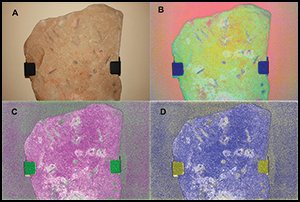
A remarkable stela from Montoro, southern Spain, is unique in its morphology, epigraphic traits and landscape context. A programme of chemical characterisation, digital imaging, and geo-lithological and epigraphic analyses were conducted to determine its age and significance, and the results were integrated with data from archaeological investigations of the surrounding area. This multi-faceted approach allowed the stela to be interpreted within the context of early interactions between literate Mediterranean societies of the Late Bronze Age and Iron Age and non-literate Iberian societies. A key outcome of this research is a wider understanding of the complex patterns in the use and perception of early scripts.
Agosto, 2017 | DOI: 10.15184/aqy.2017.86
Materiales Avanzados
Thermal study of residues from greenhouse crops plant biomass
Morales, Laura; Garzon, Eduardo; Maria Martinez-Blanes, Jose; Jose Sanchez-Soto, PedroJournal of Thermal Analysis and Calorimetry, 129 (2017) 1111-1120
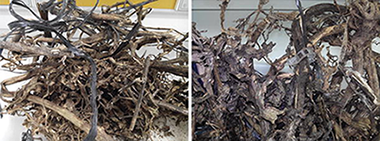
The principal aim of this work is to examine the effect of thermal treatments using a muffle furnace (static heating) and by simultaneous TG/DTA (dynamic heating) on selected greenhouse crops plant biomass investigated here as the first time. The effect of fractionation by sieving (<25 and <2.5 mm), preheating at 150 °C for 48 h and leaching with water on the thermal behavior has been studied. The observation of similar profiles of mass variation corresponding to several samples heated in air up to 1150 °C allows to conclude that particle size did not influence the thermal evolution, but the effect of heating cycle is evidenced. Thermal analysis in air of a representative sample showed the several mass variation steps and DTA exothermic effects produced by the complex thermal decomposition and pyrolysis of the organic matter. Elemental analysis (CHNS and O) of the starting samples and thermally treated revealed the effect of the temperature, with formation of ashes with lower C content from 44.37 to 0.70 mass% as a minimum after elimination of organic matter by heating. Leaching increased the thermal mass variation as an effect of elimination of water-soluble components. According to the present results, the size fractionation of the greenhouse crops biomass did not influence the results of elemental composition. The present study has provided results of interest concerning this biomass source of renewable energy originated by the remains of tomato (Solanum lycopersicum L.), being estimated the highest of all the biomass produced by the greenhouse crops agricultural industry in Almería (SE Spain).
Agosto, 2017 | DOI: 10.1007/s10973-017-6243-2
Reactividad de Sólidos
Lead-Free Polycrystalline Ferroelectric Nanowires with Enhanced Curie Temperature
Datta, Anuja; Sanchez-Jimenez, Pedro E.; Al Orabi, Rabih Al Rahal; Calahorra, Yonatan; Ou, Canlin; Sahonta, Suman-Lata; Fornari, Marco; Kar-Narayan, SohiniAdvanced Functional Materials, 27 (2017) 1701169
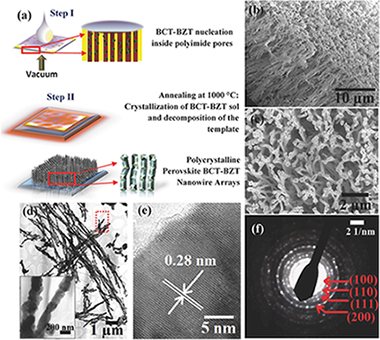
Ferroelectrics are important technological materials with wide-ranging applications in electronics, communication, health, and energy. While lead-based ferroelectrics have remained the predominant mainstay of industry for decades, environmentally friendly lead-free alternatives are limited due to relatively low Curie temperatures (T-C) and/or high cost in many cases. Efforts have been made to enhance T-C through strain engineering, often involving energy-intensive and expensive fabrication of thin epitaxial films on lattice-mismatched substrates. Here, a relatively simple and scalable sol-gel synthesis route to fabricate polycrystalline (Ba0.85Ca0.15)(Zr0.1Ti0.9)O-3 nanowires within porous templates is presented, with an observed enhancement of T-C up to similar to 300 degrees C as compared to similar to 90 degrees C in the bulk. By combining experiments and theoretical calculations, this effect is attributed to the volume reduction in the template-grown nanowires that modifies the balance between different structural instabilities. The results offer a cost-effective solution-based approach for strain-tuning in a promising lead-free ferroelectric system, thus widening their current applicability.
Agosto, 2017 | DOI: 10.1002/adfm.201701169
Reactividad de Sólidos
Flash sintering of highly insulating nanostructured phase-pure BiFeO3
Perez-Maqueda, LA; Gil-Gonzalez, E; Perejon, A; Lebrun, JM; Sanchez-Jimenez, PE; Raj, RJournal of the American Ceramic Society, 100 (2017) 3365-3369
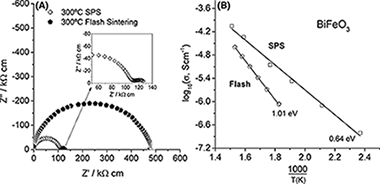
We show that BiFeO3, that is electrically homogeneous, is a good insulator, and has a low dielectric constant (the properties desired in its applications), can be produced by flash sintering, which is nominally difficult to achieve by conventional and spark plasma sintering processes. The flash-sintered specimens had a uniform microstructure with a nanometric grain size of similar to 20 nm.
Agosto, 2017 | DOI: 10.1111/jace.14990
Reactividad de Sólidos
Characterization of of mechanosynthesized Bi1-xSmxFeO3 samples unencumbered by secondary phases or compositional inhomogeneity
Gil-Gonzalez, E; Perejon, A; Sanchez-Jimenez, PE; Hayward, MA; Criado, JM; Sayagues, MJ; Perez-Maqueda, LAJournal of Alloys and Compounds, 711 (2017) 541-551
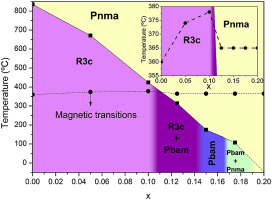
High-quality samples, in terms of phase purity and dielectric properties, of composition Bi1-xSmxFeO3 (0.05 <= x <= 0.20) have for the first time been prepared by mechanosynthesis. Close inspection of the powder diffraction data, analysis via Rietveld refinement and TEM microscopy demonstrates that the Bi1-xSmxFeO3 samples contain only perovskite phases. Additionally, by a combination of Rietveld analysis, TEM, DSC, temperature-dependent XRD and permittivity data a tentative phase diagram has been proposed where the high temperature paraelectric phase Pnma has been confirmed for samarium substituted BiFeO3. Regarding the physical properties, the samples resulted to be electrically homogenous and highly insulating at room temperature, suggesting that other sources of conductivity, such as mixed valence of Fe associated with possible oxygen non-stoichiometry, have been avoided during the samples synthesis. In spite of the high quality of the samples, the dielectric and magnetic behaviour of the Bi1-xSmxFeO3 samples change only modestly on Sm substitution, with neither a great change in the resistivity or remnant magnetisation of Sm substituted samples in comparison with BiFeO3.
Julio, 2017 | DOI: 10.1016/j.jallcom.2017.03.289
Reactividad de Sólidos
A novel, simple and rapid route to the synthesis of boron cabonitride nanosheets: combustive gaseous unfolding
Jalaly, Maisam; Jose Gotor, Francisco; Semnan, Masih; Jesus Sayagues, MariaScientific Reports, 7 (2017) art. 3453
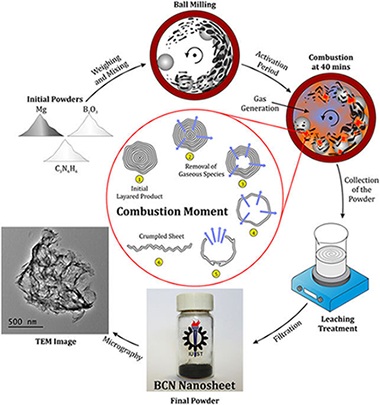
The ternary compound boron carbonitride (BCN) was synthesized in the form of few-layer nanosheets through a mechanically induced self-sustaining reaction (MSR). Magnesium was used to reduce boron trioxide in the presence of melamine in a combustive manner. The process to form the nanostructured material was very rapid (less than 40 min). The prepared powder was investigated by various techniques such as X-ray diffraction (XRD), Fourier Transform infrared (FTIR), Micro-Raman spectroscopy, X-ray photoelectron spectroscopy (XPS), high-resolution transmission electron microscopy (HRTEM), and electron energy loss spectroscopy (EELS). The thermal stability and the optical behavior of the BCN nanosheets were also studied by thermal analysis and UV-vis spectroscopy, respectively. The formation mechanism of the nanosheet morphology was described in detail.
Junio, 2017 | DOI: 10.1038/s41598-017-03794-7
Reactividad de Sólidos
Effect of the impact energy on the chemical homogeneity of a (Ti,Ta,Nb)(C,N) solid solution obtained via a mechanically induced self-sustaining reaction
de La Obra, AG; Gotor, FJ; Chicardi, EJournal of Alloys and Compounds, 708 (2017) 1008-1017
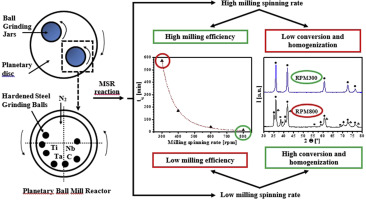
A titanium-tantalum-niobium carbonitride solid solution, (Ti,Ta,Nb)(C,N), was synthesised in a planetary mill via a mechanochemical process that involves a mechanically induced self-sustaining reaction (MSR) from stoichiometric Ti/Ta/Nb/C mixtures that are milled under a nitrogen atmosphere. The influence of the spinning rate of the planetary mill, which determines the impact energy of the milling process, on the ignition time (t(ig)) of the MSR process as well as the chemical homogeneity of the final product was analysed. The results indicated that the dependence of tig on the spinning rate followed a potential function with a potential factor of 4.85, implying a remarkable reduction in the milling time required to induce the self-sustaining reaction at increasing spinning rates (i.e., from 4200 min at 200 rpm to 15 min at 800 rpm). However, the chemical and structural characterisation of the obtained products at ignition without any extra milling treatment indicated that a single solid solution phase was only obtained at the lowest spinning rates (i.e., less than 300 rpm). At increasing rates, the relative amount of the intended solid solution phase continuously decreased, and new undesirable secondary phases were formed. Despite the long milling times required for the milling experiments that were performed at the slowest spinning rates, iron contamination from the milling media was negligible due to the low intensity milling regime.
Junio, 2017 | DOI: 10.1016/j.jallcom.2017.03.109
Propiedades mecánicas, modelización y caracterización de cerámicos avanzados
High-temperature creep of carbon nanofiber-reinforced and graphene oxide-reinforced alumina composites sintered by spark plasma sintering
Cano-Crespo, Rafael; Malmal Moshtaghioun, Bibi; Gomez-Garcia, Diego; Dominguez-Rodriguez, Arturo; Moreno, RodrigoCeramics International, 43 (2017) 7136-7141
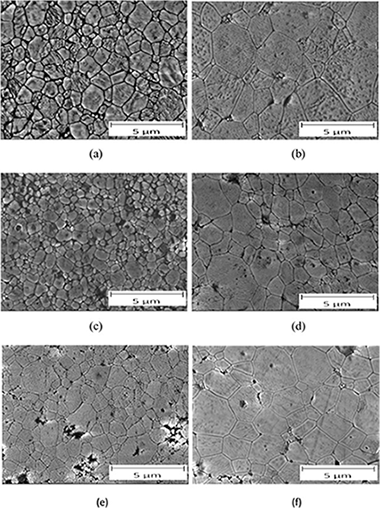
Alumina (Al2O3) ceramic composites reinforced with either graphene oxide (GO) or carbon nanofibers (CNFs) were prepared using Spark Plasma Sintering. The effects of GO and CNFs on the microstructure and in consequence on their mechanical properties were investigated. The microstructure of the sintered materials have been characterized quantitatively prior to and after the creep experiments in order to discover the deformation mechanism. Graphene-oxide reinforced alumina composites were found to be more creep resistant than carbon nanofibers-reinforced alumina ones or monolithic alumina with the same grain size distribution. In all the cases, grain boundary sliding was identified as the deformation mechanism
Junio, 2017 | DOI: 10.1016/j.ceramint.2017.02.146
Reactividad de Sólidos
Non-isothermal Characterization of the Precipitation Hardening of a Cu-11Ni-19Zn-1Sn Alloy
Donoso, E; Dianez, MJ; Criado, JM; Espinoza, R; Mosquera, EMetallurgical and Materials Transactions A-Physical Metallurgy and Materials Science, 48A (2017) 3090-3095

The precipitation hardening of a Cu-11Ni-19Zn-1Sn alloy has been studied by means of Differential Scanning Calorimetry (DSC), High-Resolution Transmission Electron Microscopy (HRTEM), and hardness measurements. The calorimetric curves, in the range of temperatures analyzed, show the presence of one exothermic reaction followed by an endothermic one. The exothermic DSC peak is due to the segregation of Cu2NiZn precipitates and it is associated to a noticeable improvement of the mechanical properties of the alloy. The endothermic effect is associated to the dissolution of the Cu2NiZn precipitates into the copper matrix for restoring the starting Cu-11Ni-19Zn-1Sn homogeneous solid solution. The reaction mechanisms of these processes have been proposed from the kinetic analysis of the exothermic and endothermic DSC signals. The results obtained point out that tin plays a decisive role on the precipitation hardening of the alloy, because age hardening is not observed in the case of a Cu-Ni-Zn ternary alloy of similar composition.
Junio, 2017 | DOI: 10.1007/s11661-017-4063-4
Reactividad de Sólidos
The Oxy-CaL process: A novel CO2 capture system by integrating partial oxy-combustion with the Calcium-Looping process
Ortiz, C; Valverde, JM; Chacartegui, R; Benitez-Guerrero, M; Perejon, A; Romeo, LMApplied Energy, 196 (2017) 1-17

This paper proposes a novel CO2 capture technology from the integration of partial oxy-combustion and the Calcium -Looping capture process based on the multicycle carbonation/calcination of limestone derived CaO. The concentration of CO2 in the carbonator reactor is increased by means of partial oxycombustion, which enhances the multicycle CaO conversion according to thermogravimetric analysis results carried out in our work, thus improving the CO2 capture efficiency. On the other hand, energy consumption for partial oxy-combustion is substantially reduced as compared to total oxy-combustion. All in all, process simulations indicate that the integration of both processes has potential advantages mainly regarding power plant flexibility whereas the overall energy penalty is not increased. Thus, the resulting energy consumption per kilogram of CO2 avoided is kept smaller than 4 MI/kg CO2, which remains below the typical values reported for total oxy-combustion and amine based CO2 capture systems whereas CO2 capture efficiency is enhanced in comparison with the Calcium -Looping process.
Junio, 2017 | DOI: 10.1016/j.apenergy.2017.03.120
Reactividad de Sólidos
CO2 capture performance of Ca-Mg acetates at realistic Calcium Looping conditions
Miranda-Pizarro, J; Perejon, A; Valverde, JM; Perez-Maqueda, LA; Sanchez-Jimenez, PEFuel, 196 (2017) 497-507

The Calcium Looping (CaL) process, based on the cyclic carbonation/calcination of CaO, has emerged in the last years as a potentially low cost technique for CO2 capture at reduced energy penalty. In the present work, natural limestone and dolomite have been pretreated with diluted acetic acid to obtain Ca and Ca-Mg mixed acetates, whose CO2 capture performance has been tested at CaL conditions that necessarily imply sorbent regeneration under high CO2 partial pressure. The CaL multicycle capture performance of these sorbents has been compared with that of CaO directly derived from limestone and dolomite calcination. Results show that acetic acid pretreatment of limestone does not lead to an improvement of its capture capacity, although it allows for a higher calcination efficiency to regenerate CaO at reduced temperatures (similar to 900 degrees C) as compared to natural limestone (>similar to 930 degrees C). On the other hand, if a recarbonation stage is introduced before calcination to reactivate the sorbent, a significantly higher residual capture capacity is obtained for the Ca -Mg mixed acetate derived from dolomite as compared to either natural dolomite or limestone. The main reason for this behavior is the enhancement of carbonation in the solid-state diffusion controlled phase. It is argued that the presence of inert MgO grains in the mixed acetate with reduced segregation notably promotes solid state diffusion of ions across the porous structure created after recarbonation.
Mayo, 2017 | DOI: 10.1016/j.fuel.2017.01.119
Reactividad de Sólidos
New findings on thermal degradation properties of fluoropolymers
Liu, SE; Zhou, WL; Yan, QL; Qi, XF; An, T; Perez-Maqueda, LA; Zhao, FQJournal of Thermal Analysis and Calorimetry, 128 (2017) 675-685
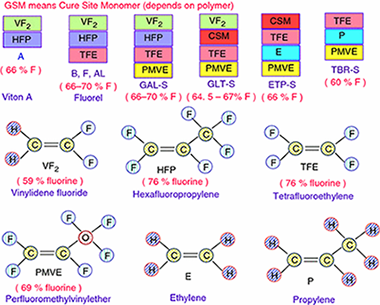
In this paper, the thermal degradation properties of Viton A and Fluorel are investigated by both isoconversional and combined kinetic analysis methods using non-isothermal thermogravimetry technique. It has been found that the heating rate has little affect on the degradation residue of Fluorel and Viton A, where around 1.3% char was formed for Fluorel and 3.5% for Viton A. Different from the literature, the decomposition of Viton A should be considered as an overlapped dehydrofluorination and carbon chain scission process, with activation energy of 214 +/- 11 and 268 +/- 13 kJ mol(-1), respectively. The effect of dehydrofluorination on degradation of Fluorel is not so significant due to low content of H, and hence, it could be considered as a single-step mechanism with average activation energy of 264 +/- 14 kJ mol(-1). The thermal stability of Fluorel is much better than that of Viton A, and the predicted half-life is around 218 min for Fluorel and 49 min for Viton A at 420 A degrees C, which are consistent with experimental values. If using a single-step model as in the literature for Viton A, its half-life at 420 A degrees C would be underestimated for > 20%.
Mayo, 2017 | DOI: 10.1007/s10973-016-5963-z
Reactividad de Sólidos
Synthesis, Characterisation, and Photocatalytic Behaviour of Mesoporous ZnS Nanoparticles Prepared Using By-Product Templating
Emrooz, HBM; Rahmani, AR; Gotor, FJAustralian Journal of Chemistry, 70 (2017) 1099-1105
High surface area mesoporous ZnS nanoparticles (MZN) were obtained with the aid of the by-product of the synthesising reaction. This by-product, namely NaNO3, can be considered as a soft template responsible for the formation of pores. Ethanol and water were chosen as the synthesis media. Ultrasonic waves were used as an accelerator for the synthesis of MZNs. Photocatalytic activities of the synthesised samples for the degradation of methylene blue (MB) were investigated under ultraviolet irradiation. Synthesised specimens were characterised using field emission scanning electron microscopy, transmission electron microscopy, powder X-ray diffraction, diffuse reflectance spectroscopy, N-2-physisorption, and FT-IR spectroscopy. Results indicated that the synthesis media has a pronounced effect on the surface properties of the final porous particles by several mechanisms. The specific surface area of the MZN samples synthesised in water and ethanol were determined to be 53 and 201m(2)g(-1), respectively. The difference in the specific surface area was attributed to the weak solvation of S2- ions (Na(2)S5H(2)O in ethanol) and also to the by-product of the synthesis reaction. The photocatalytic behaviour of the mesoporous ZnS nanoparticles synthesised in these two media were investigated and the results have been interpreted with the aid of effective surface area, pore volume, and bandgap energy of the specimens.
Mayo, 2017 | DOI: 10.1071/CH17192
Reactividad de Sólidos
Structure evolution in the LaMn1 − xFexO3 + δ system by Rietveld analysis
Cordoba, J. M.; Ponce, M.; Sayagues, M. J.Solis State Ionics, 303 (2017) 132-137
The synthesis of LaMn1 − xFexO3 + δ (0 ≤ x ≤ 1) solid solutions perovskite powder was carried out using high-energy milling from the constituent oxides, and further crystallization by high temperature treatment. The compositions of the crystalline phases as a function of x were determined by X-ray powder diffraction using a Rietveld refinement. The relationship between composition and structure was covered. This showed that LaMn1 − xFexO3 + δ exists with the rhombohedral structure (R-3c, 167) only below x = 0.3 and with the orthorhombic structure (Pnma, 62) over x = 0.7. The rhombohedral phase coexists with the orthorhombic phase between 0.4 < x < 0.6.
Mayo, 2017 | DOI: 10.1016/j.ssi.2017.02.020
Reactividad de Sólidos
Mechanochemical Solvent-Free Synthesis of Quaternary Semiconductor Cu-Fe-Sn-S Nanocrystals
Balaz, Peter; Balaz, Matej; Sayagues, Maria J.; Skorvanek, Ivan; Zorkovska, Anna; Dutkova, Erika; Briancin, Jaroslav; Kovac, Jaroslav; Kovac, Jaroslav, Jr.; Shpotyuk, YaroslavNanoscale Research Letters, 12 (2017) art. 256
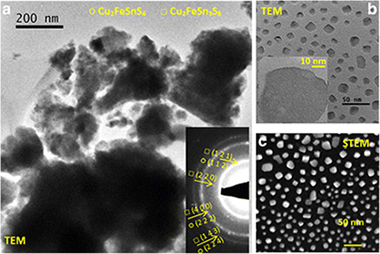
In this study, we demonstrate a one-pot mechanochemical synthesis of the nanocomposite composed of stannite Cu2FeSnS4 and rhodostannite Cu2FeSn3S8 nanocrystals using a planetary ball mill and elemental precursors (Cu, Fe, Sn, S). By this approach, unique nanostructures with interesting properties can be obtained. Methods of XRD, Raman spectroscopy, UV-Vis, nitrogen adsorption, SEM, EDX, HRTEM, STEM, and SQUID magnetometry were applied. Quaternary tetragonal phases of stannite and rhodostannite with crystallite sizes 18-19 nm were obtained. The dominant Raman peaks corresponding to the tetragonal stannite structure corresponding to A-symmetry optical modes were identified in the spectra. The bandgap 1.25 eV calculated from UV-Vis absorption spectrum is very well-acceptable value for the application of the synthesized material. The SEM micrographs illustrate the clusters of particles in micron and submicron range. The formation of agglomerates is also illustrated on the TEM micrographs. Weak ferromagnetic properties of the synthesized nanocrystals were documented.
Abril, 2017 | DOI: 10.1186/s11671-017-2029-5
Reactividad de Sólidos
Effect of Thermal Pretreatment and Nanosilica Addition on Limestone Performance at Calcium-Looping Conditions for Thermochemical Energy Storage of Concentrated Solar Power
Valverde, Jose Manuel; Barea-Lopez, Manuel; Perejon, Antonio; Sanchez-Jimenez, Pedro E.; Perez-Maqueda, Luis A.Enery & Fuels, 31 (2017) 4226-4236
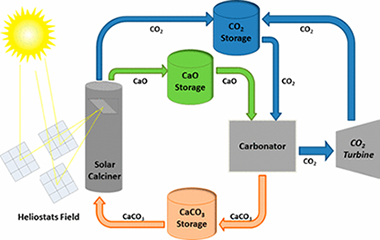
The share of renewable energies is growing rapidly, partly in response to the urgent need for mitigating CO2 emissions from fossil fuel power plants. However, cheap and efficient large-scale energy storage technologies are not yet available to allow for a significant penetration of renewable energies into the grid. Recently, a potentially low-cost and efficient thermochemical energy storage (TCES) system has been proposed, based on the integration of the calcium-looping (CaL) process into concentrated solar power plants (CSPs). The CaL process relies on the multicycle carbonation/calcination of CaO, which can be derived from calcination of widely available, cheap, and nontoxic natural limestone (CaCO3). This work explores the effect on the multicycle activity of limestone-derived CaO of thermal pretreatment under diverse atmospheres and the addition of nanosilica, which would be expected to hinder CaO grain sintering. Importantly, optimum CaL conditions for CSP energy storage differ radically from those used in the application of the CaL process for CO2 capture. Thus, calcination should be ideally carried out under low CO2 partial pressure at moderate temperature (below 750 degrees C), whereas CO2 concentration and temperature should be high for carbonation in order to maximize thermoelectric efficiency. When limestone is subjected to carbonation/calcination cycles at these conditions, its performance is critically dependent on the type of pretreatment. Our results indicate that the multicycle CaO activity is correlated with the size of the particles and the CaO pore size distribution. Thus, CaO activity is impaired as particle size is increased and/or CaO pore size is decreased. These observations suggest that pore plugging poses a main limitation to the multicycle performance of limestone-derived CaO at the optimum CaL conditions for TCES in CSPs, which is supported by scanning electron microscopy analysis. Strategies to enhance the performance of natural limestone at these conditions should be therefore oriented toward minimizing pore plugging rather than CaO grain sintering, which stands as the main limitation at CaL conditions for CO2 capture.
Abril, 2017 | DOI: 10.1021/acs.energyfuels.6b03364
Reactividad de Sólidos
Mechanochemically Synthesized CuFeSe2 Nanoparticles and Their Properties
Dutkova, E; Skorvanek, I; Sayagues, MJ; Zorkovska, A; Kovac, J; Balaz, PActa Physica Polonica A, 131 (2017) 1156-1158
The mechanochemical synthesis of nanocrystalline CuFeSe2 particles prepared by high-energy milling in a planetary mill in an argon atmosphere from copper, iron, and selenium for 60 min is reported for the first time. The CuFeSe2 nanoparticles crystallize in tetragonal structure with mean crystallite size of about 32 +/- 1 nm. High resolution transmission electron microscopy measurements confirmed the presence of agglomerates which are formed by small nanocrystalline domains (5-40 nm). The magnetic data revealed that paramagnetic CuFeSe2 nanoparticles coexist with a small amount of ferromagnetic impurities at room temperature. The magnetic transition towards a weak ferromagnetic or ferrimagnetic behavior occurs in CuFeSe2 at approximately 79 K. The band gap of the CuFeSe2 particles is 0.95 eV which is wider than the band gap in bulk materials (0.16 eV), which could be in many aspects of application more beneficial.
Abril, 2017 | DOI: 10.12693/APhysPolA.131.1156
Reactividad de Sólidos
Large-Scale Storage of Concentrated Solar Power from Industrial Waste
Perejon, Antonio; Valverde, Jose Manuel; Miranda-Pizarro, Juan; Sanchez-Jimenez, Pedro E.; Perez-Maqueda, Luis A.ACS Sustainable Chemistry & Engineering, 5 (2017) 2265-2272

Deep penetration of renewable energies into the grid relies on the development of large-scale energy storage technologies using cheap, abundant, and nontoxic materials. Concentrated solar power (CSP) is particularly suitable to massively store thermal energy for dispatchable electricity generation. This is currently accomplished in a few demonstration plants by using molten salts albeit in a not competitive way yet. Process simulation studies indicate that thermochemical energy storage of CSP by means of the calcium looping (CaL) technology would reduce the cost of storage and increase the flexibility of energy supply provided that widely available and cheap CaO precursors with high and stable multicycle activity are used. In this work, we investigate the behavior of calcium rich steel slag at CaL conditions that would expectedly maximize the efficiency of CSP energy storage and power production. When treated with acetic acid, this nontoxic widely abundant waste yields a CaO rich solid with stable conversion near 0.8 over successive carbonation/calcination cycles at these CaL conditions
Marzo, 2017 | DOI: 10.1021/acssuschemeng.6b02576
Reactividad de Sólidos
A Promising approach to the kinetics of crystallization processes: The sample controlled thermal analysis
Perejon, A; Sanchez-Jimenez, PE; Criado, JM; Perez-Maqueda, LAJournal of the American Ceramic Society, 100 (2017) 1125-1133

Constant Rate Thermal Analysis (CRTA) method implies controlling the temperature in such a way that the reaction rate is maintained constant all over the process. This method allows determining simultaneously both the kinetic parameters and the kinetic model from a single experiment as the shape of the CRTA -T curves strongly depends on the kinetic model. CRTA method has been developed in the market only for thermogravimetric and thermodilatometric systems and, therefore, its use has been limited until now to the kinetic study of processes involving changes in mass or size of the samples, respectively. To overcome this obstacle, a method has been developed in this work for using the DSC signal for controlling the process rate in such a way that CRTA would be applied to the kinetic analysis of either phase transformations or crystallizations. The advantages of CRTA for performing the kinetics of crystallization processes have been here successfully demonstrated for the first time after selecting the crystallization of zirconia gel as test reaction.
Marzo, 2017 | DOI: 10.1111/jace.14604
Propiedades mecánicas, modelización y caracterización de cerámicos avanzados
Ceramics of Ta-doping stabilized orthorhombic ZrO2 densified by spark plasma sintering and the effect of post-annealing in air
Sponchia, G; Moshtaghioun, BM; Benedetti, A; Riello, P; Gomez-Garcia, D; Dominguez-Rodriguez, A; Ortiz, ALScripta Materialia, 130 (2017) 128-132
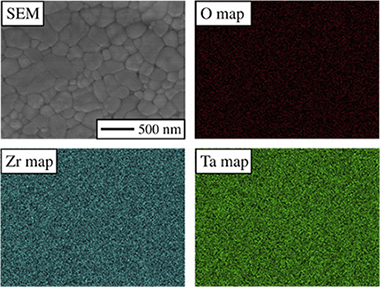
16 mol% Ta-doped ZrO2 powders were synthesized and densified by spark-plasma sintering (SPS) in vacuum, followed by post-SPS annealing in air, thus obtaining two ultrafine-grained ceramics consisting of Ta-doping stabilized orthorhombic ZrO2. The as-SPSed ceramic is black because it is actually a suboxide essentially with reduced cations and abundant oxygen vacancies, whereas the post-annealed ceramic is white because it is an oxide without vacancies and with only partially reduced cations. Both ceramics are relatively hard and brittle, but the as-SPSed ceramic was slightly more so, attributable to crystallographic and microstructural differences. Implications of interest for the ceramics community are discussed.
Marzo, 2017 | DOI: 10.1016/j.scriptamat.2016.11.021
Reactividad de Sólidos
Preparation of ytterbium substituted BiFeO3 multiferroics by mechanical activation
Gil-Gonzalez, E; Perejon, A; Sanchez-Jimenez, PE; Hayward, MA; Perez-Maqueda, LAJournal of the European Ceramic Society, 37 (2017) 945-954
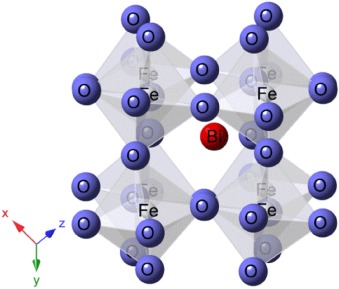
Samples in the system Bi1-xYbxFeO3 (0.02 <= x <= 0.07) have for the first time been prepared by mechanical activation followed by sintering. XRD and DSC measurements show that the solubility limit of ytterbium in the R3c Bi1-xYbxFeO3 system is reached at x similar to 0.03. Higher ytterbium contents lead to a two-phase mixture of a main R3c phase of approximate composition Bi0.97Yb0.03FeO3 and ytterbium enriched secondary phases that cannot be readily indexed or quantified due to their small amount. DSC and temperature-dependent XRD showed that while the magnetic ordering temperature, T-N, was unaffected by Yb substitution, the ferroelectric ordering, T-C, declined. Temperature-dependent XRD patterns show that all samples exhibit rhombohedral R3c to orthorrhombic Pnma phase transitions. Diffuse reflectance spectroscopy suggests the potential use of the samples in photocatalytic applications due to their low band gap energy. Impedance spectroscopy and magnetic measurements show that samples are electrically homogenous and highly insulating, exhibiting antiferromagnetic behaviour at room temperature.
Febrero, 2017 | DOI: 10.1016/j.jeurceramsoc.2016.09.014
Reactividad de Sólidos
A new family of cermets: Chemically complex but microstructurally simple
de la Obra, AG; Aviles, MA; Torres, Y; Chicardi, E; Gotor, FJInternational Journal of Refractory Metals & Hard Materials, 63 (2017) 17-25
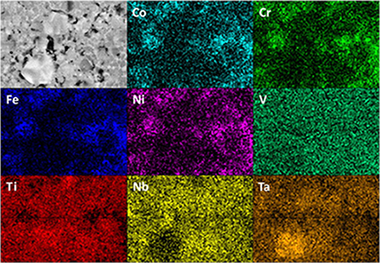
Cermets based on Ti(C,N) have interesting properties, such as high wear resistance, high chemical stability and good mechanical strength at high temperature, but to become a viable alternative to cemented carbides, the fracture toughness and damage tolerance must be significantly improved. Complete solid-solution cermets (CSCs) have been proposed to further improve the mechanical properties of these materials. However, to develop this family of cermets with a high level of quality and reliability, using pre-fabricated complex carbonitrides is necessary instead of unalloyed mixtures as the raw ceramic material. A mechanochemical process called mechanically induced self-sustaining reaction (MSR) is suitable to obtain these complex carbonitrides with high stoichiometric control. On the other hand, high entropy alloys (HEAs), which can also be obtained by mechanochemical processes, are a good candidate to replace the current binder phase in cermets because they exhibit high strength and ductility at high temperature and good resistance to both wear and corrosion. In this work, a new family of CSCs based on (Ti,Ta,Nb)CxN1-x, with HEAs belonging to the Fe-Co-Ni-Cr-Mn-V system as the binder phase is developed by mechanochemical processes. With only two constituent phases, these cermets have a simple microstructure but a high compositional complexity because both the ceramic and binder phases are complex solid solutions with at least five components.
Febrero, 2017 | DOI: 10.1016/j.ijrmhm.2016.04.011
Reactividad de Sólidos
Processing and characterization of surrogate nuclear materials with controlled radial porosity
Torres, Y; Garcia-Ostos, C; Arevalo, C; Gotor, FJ; Pavon, JJ; Trueba, P; Rodriguez-Ortiz, JAJournal of Nuclear Science and Technology, 54 (2017) 167-173

Irradiated fuel pellets present radial gradient porosity. CeO2 has been proven as a surrogate material to understand irradiated mixed oxide (MOX) due to its similar structural and mechanical properties. A novel compaction device was developed to produce CeO2 cylindrical pellets with controlled radial porosity. Three blends of CeO2 with different binder contents (0.5, 3 and 7.5 vol.% of ethylene-bis-stearamide, EBS) were prepared and used to obtain three different porosities for the core, intermediate and outer rings of pellets, respectively. Different compaction pressures were employed in each region to get the intended porosities. The whole pellet was subjected to a heating rate up to 500 degrees C to remove the EBS binder. Finally, a pressureless sintering step was performed at 1700 degrees C for 4 h. A microstructural characterization was performed in the three areas, including grain size and porosity. Mechanical properties like hardness, fracture toughness and tribo-mechanical response, as scratch resistance, were also determined. Pellets fabricated from this device have shown microstructural and mechanical properties with a good correlation to those of irradiated nuclear fuel.
Febrero, 2017 | DOI: 10.1080/00223131.2016.1222918
Analytical investigation of Mudejar polychrome on the carpentry in the Casa de Pilatos palace in Seville using non-destructive XRF and complementary techniques
Garrote, MA; Robador, MD; Perez-Rodriguez, JLSpectrochimica Acta Part A-Molecular and Biomolecular Spectroscopy, 173 (2017) 279-291
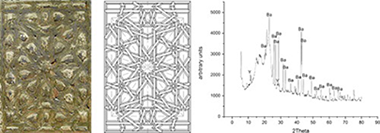
The pigments, execution technique and repainting used on the polychrome wood ceilings and doors in the Casa de Photos (Seville, Spain) were studied using portable X-ray fluorescence equipment. Cross-sections of small samples were also analysed by optical microscopy, SEM with EDX analysis, micro-Raman and micro-infrared spectroscopy and X-ray diffraction. These carpentry works are magnificent examples of the Mudejar art made in Spain in the early 16th century. Portable X-ray fluorescence gave good information on the different components of the polychrome. The SEM-EDX study of the surfaces of small samples gave information on their components and also characterized the compounds that had been deposited or formed by environmental contamination or by the alteration of some pigments. The SEM-EDX study of cross-sections facilitated the characterization of all layers and pigments from the support to the most external layer. The following pigments were characterized: red (cinnabar/vermillion, lead oxide, iron oxides and orpiment/realgar), black (carbon black), white (white lead and titanium barium white), yellow-orange-red-brown (orpiment/realgar and iron oxides), green (chromium oxide), blue (indigo blue and ultramarineblue), and gilding (gold leaf on bole). False gold, bronze and brass were also found. The pigments were applied with the oil painting technique over a support layer that had been primed with animal glue. This support layer was gypsum in some cases and white lead in others. This study is essential to the polychrome conservation of the studied artwork, and it will help clarify uncertainties in the history and painting of Mudejar art.
Enero, 2017 | DOI: 10.1016/j.saa.2016.09.027
Propiedades mecánicas, modelización y caracterización de cerámicos avanzados
Spark plasma sintering of fine-grained alumina ceramics reinforced with alumina whiskers
Tamura, Y; Moshtaghioun, BM; Gomez-Garcia, D; Rodriguez, ADCeramis International, 43 (2017) 658-663
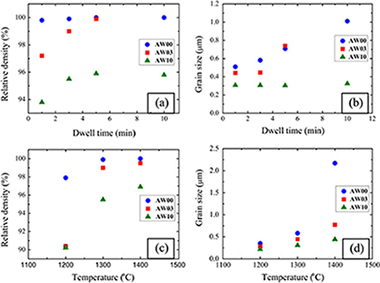
Densification of alumina whisker-reinforced alumina ceramics by spark plasma sintering (SPS) has been investigated with the aim of obtaining a fine-grained microstructure and also studying the effect of whisker addition on the room-temperature mechanical properties. It was found that whisker addition retards slightly the sinterability of alumina by whisker hindering of particle rearrangement. Besides, the internal stress on the alumina matrix particles reduced due to the presence of a whisker network structure of strong rigid boundaries. Nevertheless near fully-dense and fine-grained alumina ceramics with alumina whisker content between 3 wt% and 10 wt% could be obtained under appropriate SPS conditions. The hardness of alumina ceramics with 3 wt% was comparable to that of pure alumina ceramics (similar to 26 GPa) whereas its fracture toughness (5.6 MPa m(1/2)) was higher (4.2 MPa m(1/2)). Crack bridging by well-dispersed whiskers and whiskers pull-out were identified as the main toughening mechanisms.
Enero, 2017 | DOI: 10.1016/j.ceramint.2016.09.210
Fotocatálisis Heterogénea: Aplicaciones - Reactividad de Sólidos
Outstanding visible photocatalytic activity of a new mixed bismuth titanatate material
Zambrano, P; Sayagues, MJ; Navio, JA; Hidalgo, MCApplied Surface Science, 394 (2017) 16-24
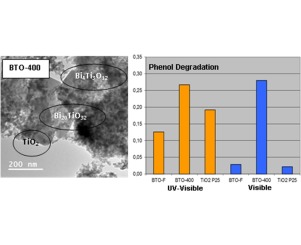
In this work, a new photocatalyst based on bismuth titanates with outstanding visible photocatalytic activity was prepared by a facile hydrothermal method. The synthesised material showed visible activity as high as UV activity of commercial TiO2 P25 under the same experimental conditions for phenol degradation. A wide characterisation of the photocatalyst was performed. The material was composed of three phases; majority of Bi20TiO32 closely interconnected to Bi4Ti3O12 and amorphous TiO2. The high visible activity showed by this material could be ascribed to a combination of several features; i.e. low band gap energy value (2.1 eV), a structure allowing a good separation path for visible photogenerated electron-holes pairs and a relatively high surface area. This photocatalyst appeared as a promising material for solar and visible applications of photocatalysis.
Enero, 2017 | DOI: 10.1016/j.apsusc.2016.10.042
Reactividad de Sólidos
Structural and Chemical Characteristics of Sisal Fiber and Its Components: Effect of Washing and Grinding
Benitez-Guerrero, M; Perez-Maqueda, LA; Artiaga, R; Sanchez-Jimenez, PE; Pascual-Cosp, JJournal of Natural Fibers, 14 (2017) 26-39
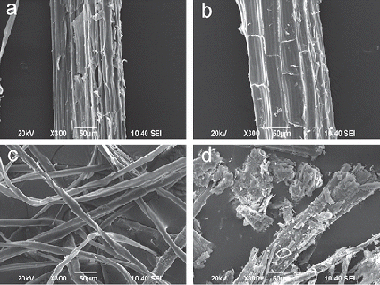
This work covers the study of microstructural changes of natural sisal fibers induced by different conditioning pre-treatments: mechanical grinding, cryogenic grinding, and hot waterwashing. The aim of the work is to clarify the effects of the pre-treatments on crystallinity and infrared spectra of sisal. Scanning electron microscopy results allowed to identify morphological changes on the fiber surface. Deeper changes of chemical origin were studied by attenuated total reflectance/Fourier transform infrared spectroscopy (FTIR) and focused on the main components of cellular walls: cellulose, lignin, and xylan. The work was complemented with crystallinity index (I-c) data determined by two very different methods: the widely used for lignocellulosic fibers Segal equation based on X-ray diffraction measurements, and the other based on FTIR through the 1430/900 cm(-1) band intensity ratio, which is mostly used with cellulosic samples.
Enero, 2017 | DOI: 10.1080/15440478.2015.1137529
Reactividad de Sólidos
Microcalorimetry: A powerful tool for quantitative analysis of aging hardening response of Cu-Ni-Sn alloys
Donoso, E; Dianez, MJ; Perejon, A; Sanchez-Jimenez, PE; Perez-Maqueda, LA; Sayagues, MJ; Criado, JMJournal of alloys and compounds, 694 (2017) 710-714

The method for the deconvolution of overlapping DSC peaks here proposed has been used by the first time for the quantitative determination of the enthalpies associated to the phase transitions undergone during the aging of an alloy. They have been determined the enthalpies evolved along the first and the second overlapping DSC traces of Cu-10 wt%Ni-5.5 wt%Sn alloy, which are associated, respectively, to the spinodal decomposition of the alloy and the segregation of a DO22 (CuxNi1-x)(3)Sn tetragonal phase. The fraction of the DO22 phase (responsible of the aging hardening of this alloy) has been successfully determined from DSC as a function of the annealing treatment, while TEM and XRD failed for this purpose. It has been demonstrated that a threshold higher than 50% of crystallization of the DO22 phase is required for achieving a significant increase of the hardness as a function of the crystallization percentage. These results suggest that microcalorimetric measurement can be a powerful tool to establish quantitative relationships between the mechanical, electrical or functional properties of alloys and their structural changes undergone by aging.
Enero, 2017 | DOI: 10.1016/j.jallcom.2016.10.060
2016
2016
Reactividad de Sólidos
The calorimetric analysis as a tool for studying the aging hardening mechanism of a Cu-10wt%Ni-5.5wt%Sn alloy
Dianez, MJ; Donoso, E; Sayagues, MJ; Perejon, A; Sanchez-Jimenez, PE; Perez-Maqueda, LA; Criado, JMJournal of Alloys and Compounds, 688 (2016) 288-294
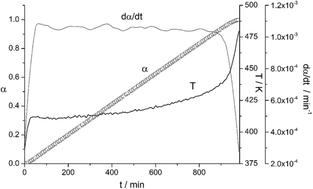
The transformations of a Cu-10wt%Ni-5.5wt%Sn alloy as a function of the aging time in the range from room temperature up to 600 degrees C have been followed by Differential Scanning Calorimetry (DSC). The results obtained have shown that this alloy undergone two overlapping exothermic phase transitions with DSC peaks at 208 degrees C and 305 degrees C, respectively, followed by an endothermic phase transformation with a DSC peak at 526 degrees C. The structural analysis by TEM, ED, EDX and XRD of the intermediates phases previously discriminated by DSC suggests that the first exothermic peak is associated to the spinodal decomposition of the sample, while the second one is associated to the segregation of a DO22 (Cu-x-Ni1-x)(3)Sn tetragonal phase coherent with the alpha-Cu structure of the starting alloy. The endothermic peak has been associated to the precipitation of cubic DO3 nanocrystals from the DO22 phase previously formed. The microhardness measurements carried out in combination with the structural characterization demonstrate that the aging hardening of the alloy under study is exclusively due to the formation of the coherent DO22 phase. The DO22/DO3 transition leads to a dramatic drop of the hardness of the alloy.
Diciembre, 2016 | DOI: 10.1016/j.jallcom.2016.07.021
Materiales Avanzados
Surface functionalization of a lipid nanosystem to promote brain targeting: step-by-step design and physico-chemical characterization
Cózar-Bernal, MJ; García-Esteban, E; Sánchez-Soto, PJ; Rabasco, AM; González-Rodríguez, MLPharmaceutical Development and Technology, 21 (7) (2016) 823-831
The use of lipid nanosystems as drug delivery to the central nervous system may be advantageous over the current strategies. The aim of this study was to develop and characterize functionalized liposomes for treatment of brain diseases. The covalent method of coupling IgG to liposomes via the derivatized lipid 1,2-dioleoyl-sn-glycero-3-phosphoethanolamine-N-[4-(p-maleimidophenyl)butyramide](MPB-PE) was investigated. Optimized coupling conditions are shown to result in the efficient conjugation of IgG to liposomes containing low concentrations of MPB-PE (3/1 SH:IgG). The qualitative analysis has shown that after the extrusion process, more homogeneous populations of vesicles have been obtained with a nanometric size suitable to be effective to further anchor the protein. Negative values of zeta potential demonstrate that they are stable systems. Lyophilization was used to maintain the stability of the formulation. These very interesting results encourage further investigations to formulate peptide- and protein-loaded immunoliposomes, making targeting of liposomes as an attractive approach for brain drug delivery.
Noviembre, 2016 | DOI: 10.3109/10837450.2015.1063651
Reactividad de Sólidos
Combined TGA-MS kinetic analysis of multistep processes. Thermal decomposition and ceramification of polysilazane and polysiloxane preceramic polymers
Garcia-Garrido, C; Sanchez-Jimenez, PE; Perez-Maqueda, LA; Perejon, A; Criado, JMPhysical Chemistry Chemical Physics, 18 (2016) 29348-29360
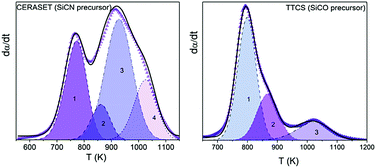
The polymer-to-ceramic transformation kinetics of two widely employed ceramic precursors, 1,3,5,7-tetramethyl-1,3,5,7-tetravinylcyclotetrasiloxane (TTCS) and polyureamethylvinylsilazane (CERASET), have been investigated using coupled thermogravimetry and mass spectrometry (TG-MS), Raman, XRD and FTIR. The thermally induced decomposition of the pre-ceramic polymer is the critical step in the synthesis of polymer derived ceramics (PDCs) and accurate kinetic modeling is key to attaining a complete understanding of the underlying process and to attempt any behavior predictions. However, obtaining a precise kinetic description of processes of such complexity, consisting of several largely overlapping physico-chemical processes comprising the cleavage of the starting polymeric network and the release of organic moieties, is extremely difficult. Here, by using the evolved gases detected by MS as a guide it has been possible to determine the number of steps that compose the overall process, which was subsequently resolved using a semiempirical deconvolution method based on the Frasier-Suzuki function. Such a function is more appropriate that the more usual Gaussian or Lorentzian functions since it takes into account the intrinsic asymmetry of kinetic curves. Then, the kinetic parameters of each constituent step were independently determined using both model-free and model-fitting procedures, and it was found that the processes obey mostly diffusion models which can be attributed to the diffusion of the released gases through the solid matrix. The validity of the obtained kinetic parameters was tested not only by the successful reconstruction of the original experimental curves, but also by predicting the kinetic curves of the overall processes yielded by different thermal schedules and by a mixed TTCS-CERASET precursor.
Noviembre, 2016 | DOI: 10.1039/c6cp03677e
Reactividad de Sólidos
Influence of Ball Milling on CaO Crystal Growth During Limestone and Dolomite Calcination: Effect on CO2 Capture at Calcium Looping Conditions
Sanchez-Jimenez, PE; Valverde, JM; Perejon, A; de la Calle, A; Medina, S; Perez-Maqueda, LACryst. Growth Des., 16 (2016) 7025–7036
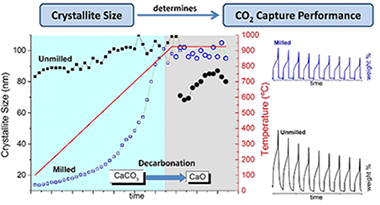
Under Calcium-Looping “realistic” operation conditions (high CO2 concentration and temperature), the multicycle CO2 capture capacity performance of CaO derived from limestone and dolomite is inversely related to its crystallite size. Ball-milling the raw sorbents results in the formation of larger nascent CaO nanocrystals during the calcination. Constraint sintering effect due to inert compounds such as dolomitic MgO mitigates the inactivation.
Noviembre, 2016 | DOI: 10.1021/acs.cgd.6b01228
Materiales Avanzados
Surface functionalizing of a lipid nanosystem to promote brain targeting: step-by-step design and physico-chemical characterization
Cozar-Bernal, MJ; Garcia-Esteban, E; Sanchez-Soto, PJ; Rabasco, AM; Gonzalez-Rodriguez, MLPharmaceutical Development and Technology, 21 (2016) 823-831
The use of lipid nanosystems as drug delivery to the central nervous system may be advantageous over the current strategies. The aim of this study was to develop and characterize functionalized liposomes for treatment of brain diseases. The covalent method of coupling IgG to liposomes via the derivatized lipid 1,2-dioleoyl-sn-glycero-3-phosphoethanolamine-N-[4-(p-maleimidophenyl)butyramide](MPB-PE) was investigated. Optimized coupling conditions are shown to result in the efficient conjugation of IgG to liposomes containing low concentrations of MPB-PE (3/1 SH:IgG). The qualitative analysis has shown that after the extrusion process, more homogeneous populations of vesicles have been obtained with a nanometric size suitable to be effective to further anchor the protein. Negative values of zeta potential demonstrate that they are stable systems. Lyophilization was used to maintain the stability of the formulation. These very interesting results encourage further investigations to formulate peptide- and protein-loaded immunoliposomes, making targeting of liposomes as an attractive approach for brain drug delivery.
Noviembre, 2016 | DOI: 10.3109/10837450.2015.1063651
An innovative combination of non-invasive UV–Visible-FORS, XRD and XRF techniques to study Roman wall paintings from Seville, Spain
Garofano, Isabel; Luis Perez-Rodriguez, Jose; Dolores Robador, Maria; Duran, AdrianJournal of Cultural Heritage, 22 (2016) 1028-1039
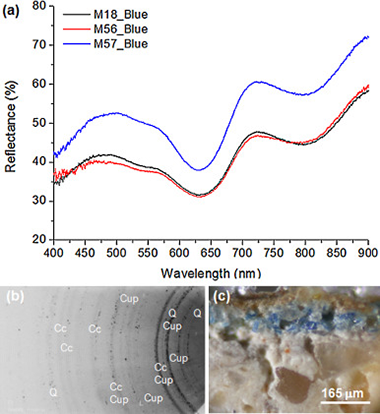
This study attempts to establish the advantages and limitations of the combined use of portable UV–Vis-FORS and XRF-XRD portable equipment for the non-invasive characterisation of pigments from Roman wall paintings from Seville, Spain, dated to the first and second century AD. XRD revealed the presence of calcite, dolomite and aragonite, indicating the colour white. Egyptian blue was identified using FORS and XRF, and additional information was obtained with XRD. For the colour green, FORS and mainly FTIR and colorimetry enabled the distinction between glauconite and celadonite, although other techniques were necessary to classify all components of the green areas by determining the presence of cuprorivaite, chlorite and chromium. For the colours yellow and red, the presence of goethite, yellow ochre, cinnabar and haematite was confirmed using FORS and XRF in some cases; the results were corroborated by XRD. Chromatic characterisation and the values of inflection points of FORS spectra enabled a better differentiation between reddish colours (orange, brown, purple and pink). The XRD and XRF techniques revealed that violet was created by mixing red haematite and Egyptian blue and slight variations in FORS spectra confirmed this.
Noviembre, 2016 | DOI: 10.1016/j.culher.2016.07.002
Reactividad de Sólidos
Enhanced carbon nanotube dispersion in 3YTZP/SWNTs composites and its effect on room temperature mechanical and electrical properties
Gallardo-Lopez, A; Morales-Rodriguez, A; Vega-Padillo, J; Poyato, R; Munoz, A; Dominguez-Rodriguez, AJournal of Alloys and Compounds, 682 (2016) 70-79
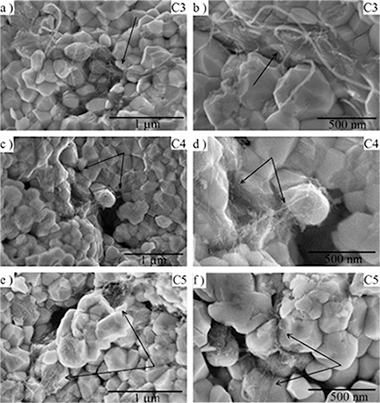
In this work, several modifications of the colloidal processing technique and spark plasma sintering (SPS) to prepare yttria tetragonal zirconia composites (YTZP) with single walled carbon nanotubes (SWNT) have been tested with the aim of eliminating SWNT agglomerates. These modifications include high versus low energy ultrasonic agitation during colloidal processing, lyophilization of the 3YTZP/SWNT slurry and electrical insulation during sintering of the composites. Semi-quantitative microstructural characterization of the carbon nanotube distribution in the sintered composites showed that high energy ultrasonic agitation reduces drastically agglomerate size. Lyophilization of the mixed suspensions avoids SWNT bundle size growth. Combination of both produces an enhanced carbon nanotube network distribution along the grain boundaries (GB) due to the absence of carbon nanotube agglomerates and to a limited SWNT bundle size. This results in an increase of the real SWNT content in the GBs up to nominal SWNT content and therefore an enhanced SWNT efficiency in the composites. The agglomerate-free highly-dispersed composites exhibit a decrease in density together with grain size refinement, a decrease in room temperature hardness, an increase in flexural strength and a most significant increase in room temperature electrical conductivity. Improved SWNT distribution also lowers electrical percolation threshold to a very low level in SWNT ceramic composites, <1 vol% SWNT.
Octubre, 2016 | DOI: 10.1016/j.jallcom.2016.04.262
Reactividad de Sólidos
Magnesium hydride for energy storage applications: The kinetics of dehydrogenation under different working conditions
Perejon, A; Sanchez-Jimenez, PE; Criado, JM; Perez-Maqueda, LAJournal of Alloys and Compounds, 681 (2016) 571-579

A new approach to the kinetics of magnesium hydride dehydrogenation is considered. A model able to predict the dehydrogenation under different experimental conditions has been proposed. A new combined kinetic analysis method, which considers the thermodynamic of the process according to the microreversibility principle, has been used for performing the kinetic analysis of data obtained under different thermal schedules at hydrogen pressures ranging from high vacuum up to 20 bar.
The kinetic analysis shows that the dehydrogenation mechanism of magnesium hydride depends on the experimental conditions. Thus, the reaction follows a first order kinetics, equivalent to an Avarmi-Erofeev kinetic model with an Avrami coefficient equal to 1, when carried out under high vacuum, while a mechanism of tridimensional growth of nuclei previously formed (A3) is followed under hydrogen pressure. An explanation of the change of mechanism is given. It has been shown that the activation energy is closed to the Mg-H bond breaking energy independently of the hydrogen pressure surrounding the sample, which suggests that the breaking of this bond would be the rate limiting step of the process. The reliability of the calculated kinetic parameters is tested by comparing simulated and experimental curves.
Octubre, 2016 | DOI: 10.1016/j.jallcom.2016.04.191
Reactividad de Sólidos
On the relevant role of solids residence time on their CO2 capture performance in the Calcium Looping technology
Perejon, A; Miranda-Pizarro, J; Perez-Maqueda, LA; Valverde, JMEnergy, 113 (2016) 160-171

The multicycle CO2 capture performance of CaO derived from natural limestone and dolomite has been investigated by means of thermogravimetry under realistic Calcium-Looping conditions, which necessarily involve high CO2 concentration and high temperatures in the calcination stage and fast transitions between the carbonation and calcination stages. Natural dolomite allows reducing the calcination temperature as compared to limestone while high calcination efficiency is maintained. This could help reducing the energy penalty of the CaL process thus further enhancing the industrial competitiveness for the integration of this technology into fossil fuel power plants. Importantly, the CO2 capture capacity of the sorbents is critically affected by the solids residence time in the carbonation and calcination stages within the feasible range in practice. Thus, carbonation/calcination residence times play a critical role on the multicycle CO2 capture performance, which has been generally dismissed in previous studies. A main observation is the enhancement of carbonation in the solid-state diffusion controlled phase, which is against the commonly accepted conception that the only relevant phase in the carbonation stage is the fast reaction-controlled stage on the surface of the solids. Thus, the CO2 capture efficiency may be significantly enhanced by increasing the solids residence time in the carbonator.
Septiembre, 2016 | DOI: 10.1016/j.energy.2016.07.028
Materiales Avanzados
Preparation of calcium carbonate as nanoparticles from inorganic precursors and sucrose as additive with potential application as biomaterial
Takabait, F; Mahtout, L; Villarejo, LP; Hurtado, BC; Soto, PJSBoletin de la Sociedad Española de Cerámcia y Vidrio, 55 (2016) 179-184
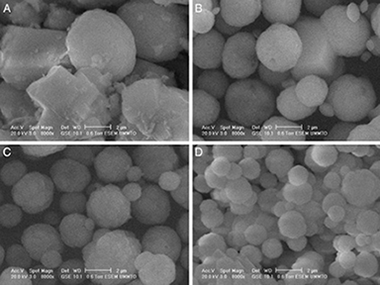
En esta comunicación se presentan unos primeros resultados de interés relevante sobre la obtención de carbonato de calcio precipitado como nanopartículas de los polimorfos vaterita y calcita. Se parte de precursores inorgánicos, nitrato de calcio tetrahidratado y bicarbonato de sodio, en presencia de sacarosa empleada como aditivo orgánico en disolución acuosa. Las fases cristalinas formadas se estudian mediante difracción de rayos X con un método cuantitativo y la morfología de las partículas obtenidas, mediante microscopia electrónica de barrido. Cuando no se emplea el aditivo orgánico se consigue la precipitación de calcita, polimorfo más estable termodinámicamente, como fase nanocristalina predominante (83%) mezclada con vaterita. Con una alta concentración del aditivo (67%) se obtiene vaterita como fase mayoritaria (> 98%). La utilización del aditivo en distinta proporción produce la formación de los 2 polimorfos de carbonato de calcio, siendo vaterita la fase predominante. La morfología de las partículas obtenidas muestra la formación de partículas nanoesféricas uniformes con contornos irregulares que se asocian a vaterita, así como partículas romboédricas de calcita cuando está presente, con potencial interés por su biocompatibilidad para su aplicación como biomateriales en implantes óseos.
Septiembre, 2016 | DOI: 10.1016/j.bsecv.2016.01.006
Reactividad de Sólidos
On the Multicycle Activity of Natural Limestone/Dolomite for Thermochemical Energy Storage of Concentrated Solar Power
Sarrion, B; Valverde, JM; Perejon, A; Perez-Maqueda, L; Sanchez-Jimenez, PEEnergy Technology, 4 (2016) 1013-1019
Cheap, efficient, and non-toxic energy storage technologies are urgently needed to handle the rapidly increasing penetration of intermittent renewable energies into the grid. This work explores the use of limestone and dolomite for energy storage in concentrated solar power (CSP) plants by means of the calcium looping (CaL) process based on the multicycle carbonation/calcination of CaO. An efficient integration of the CaL process into CSP plants involves high temperature carbonation and calcination at moderate temperatures in a close CO2 cycle for power generation. These conditions differ from those of the CaL process for CO2 capture, which lead to CaO deactivation as extensively reported in recent years. In contrast, we show that limestone- and dolomite-derived CaO give rise to a high residual conversion at CaL-CSP conditions and in short residence times, which would facilitate the development of a competitive and clean CSP technology with permanent energy storage.
Agosto, 2016 | DOI: 10.1002/ente.201600068
Reactividad de Sólidos
Assessment of the performance of commonly used DFT functionals vs. MP2 in the study of IL-Water, IL-Ethanol and IL-(H2O)(3) clusters
López-López, A., Ayala, R.Journal of Molecular Liquids, 220 (2016)
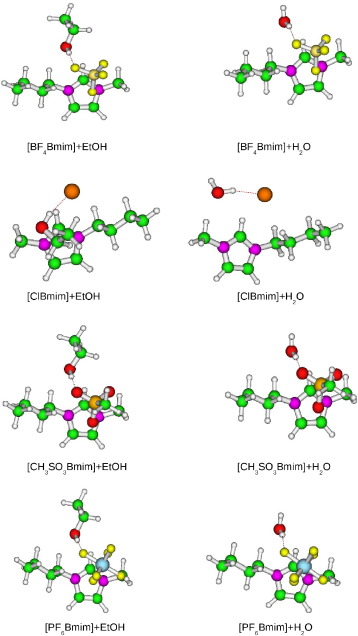
We present a comparative study of the accuracy of different DFT approaches vs. MP2 for evaluating ionic liquids (ILs) + cosolvent. Namely, we are interested in [XBmim] + cosolvent (X being Cl-, BF4-, PF6-, and CH3SO3- anions and cosolvent being water or ethanol) and [XBmim] + (H2O)(3) clusters. In this study the B3LYP, B3LYP-D3, M06, M06-2X and M06-HF functionals with Pople and Dunning basis sets are considered. We find that the influence of the basis sets is a factor to take into consideration. As already seen for weakly bonded systems when the basis set quality is low the uncorrected counterpoise (unCP) or averaging counterpoise (averCP) energies must be used due to cancellation errors. Besides, the inclusion of extra diffuse functions and polarization is also required specially in the case of ILs interacting with water clusters. The B3LYP functional does not reproduce either the structure or the interaction energies for ILs + H2O and ILs + EtOH aggregates, the energetic discrepancies being more significant than the structural ones. Among the dispersive corrected functionals, M06-2X results resemble to a great extent the reference data when the unCP interaction energies are considered for both water and ethanol. In turn, M06 and B3LYP-D3 functionals are the best option for ILs containing polar and non-polar anions, respectively, whether the averCP interactions energies are taking into consideration. From the structural point of view, B3LYP and M06 functionals describe more open structures whereas B3LYP-D3, M06-2X and M06-HF structures resemble quite well MP2 results. When the number of water molecules increases the H bonding motif gains importance and the effect depends on the underlying functional. Only M06-2X and M06-HF behaviour is similar to that observed for one water molecule. This is important because to describe ILs-cosolvent solutions is not only necessary to take into account the ILs-cosolvent interactions but also the cosolvent-cosolvent ones in the ensemble of the system.
Agosto, 2016 | DOI: 10.1016/j.molliq.2016.05.037
A new approach to the determination of the synthetic or natural origin of red pigments through spectroscopic analysis
Franquelo, ML; Perez-Rodriguez, JLSpectrochimica Acta Part A: Molecular and Biomolecular Spectroscopy, 166 (2016) 103-111

This work suggests a way of differentiation between the natural or synthetic origin of inorganic materials that were historically used in the Cultural Heritage field. An exhaustive review of different reported procedures of synthesis of pigments was conducted, as well as a review of the accompanying minerals in case of natural pigments. The natural or synthetic origin of the pigments studied in this work was performed through the characterization of the accompanying minerals, in the case of the natural pigments, or the trace elements that are present as part of synthesis by-products or washing/purifying reagents and/or reactants that have only been partly removed in the final steps of these processes. This work characterized red pigments due to their wide variety, complexity and possibility of use in different mixtures. The following pigments were studied: cinnabar-vermilion, red lead and iron pigments. Also mixtures of these pigments between them and with red lake were also studied. Natural cinnabar was accompanied by silicon oxide (opal, chalcedony or quartz), calcite, clay minerals and, sometimes, pyrite. K together with S indicated a synthetic pigment (vermilion) obtained through the wet method. Nevertheless, K has not been found in layers containing only vermilion in our samples. The presence of Sn in some cases indicated vermilion that came from the dry process. K from the synthesis always appeared in the red lead pigment. The red natural ochre was confirmed by presence of clay minerals and iron. It should be said that Ca and S, and sometimes Al and K, were usually found in Mars red pigment. The presence of Al and Ca allowed the identification of carmine lake.
Agosto, 2016 | DOI: 10.1016/j.saa.2016.04.054
Materiales Avanzados
Correlation between chemical and mineralogical characteristics and permeability of phyllite clays using multivariate statistical analysis
Garzon, E; Romero, E; Sanchez-Soto, PJApplied Clay Science, 129 (2016) 92-101
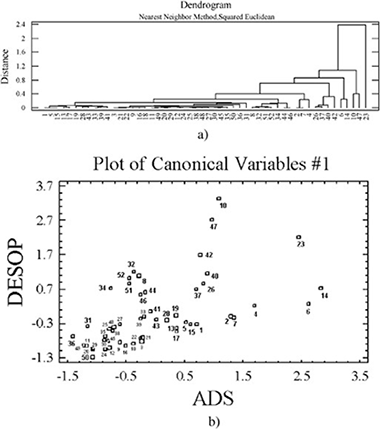
Phyllite clays are applied as a layer on a surface to be waterproofed and subsequently compacted. For this purpose, phyllite clays deposits can be grouped by their chemical and mineralogical characteristics, and these characteristics can be connected with their properties, mainly permeability, in order to select those deposits with the lowest permeability values. Several deposits of phyllite clays in the provinces of Almeria and Granada (SE Spain) have been studied. The results of applying a multivariate statistical analysis (MVA) to the chemical data analysed from 52 samples determined by XRF, mineralogical analysis by XRD and permeability are reported. Permeability, a characteristic physical property of phyllite clays, was calculated using the results for experimental nitrogen gas adsorption and nitrogen adsorption-desorption permeability dependence. According to the results, permeability values differentiated two groups, i.e. group 1 and group 2, with two subgroups in the latter. The influence of chemical as well as mineralogical characteristics on the permeability values of this set of phyllite clays was demonstrated using a multiple linear regression model. Two regression equations were deduced to describe the relationship between adsorption and desorption permeability values, which support this correlation. This was an indication of the statistical significance of each chemical and mineralogical variable, as it was added to the model. The statistical tests of the residuals suggested that there was no serious autocorrelation in the residuals.
Agosto, 2016 | DOI: 10.1016/j.clay.2016.05.008
Reactividad de Sólidos
Constant rate thermal analysis of a dehydrogenation reaction
Perejon, A; Perez-Maqueda, LA; Sanchez-Jimenez, PE; Criado, JM; Murafa, N; Subrt, JRSC Advances, 6 (2016) 81454-81460
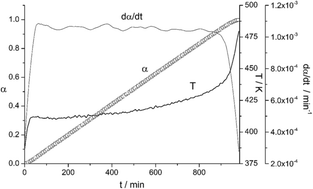
The Constant Rate Thermal Analysis (CRTA) procedure has been employed for the first time to study the kinetics of MgH2 dehydrogenation by thermogravimetry under high vacuum. CRTA implies controlling the temperature in such a way that the decomposition rate is maintained constant all over the process, employing the mass change as the experimental signal proportional to the reaction rate. The CRTA curves present a higher resolution power to discriminate the kinetic model obeyed by the reaction in comparison with conventional heating rate curves. The combined kinetic analysis has been applied to obtain the kinetic parameters, which show that MgH2 decomposition under high vacuum obeys first-order kinetics (F1). It has been proposed that the dehydrogenation of MgH2 under high vacuum takes place by instantaneous nucleation in the border line of the bidimensional crystallites followed by the growth of the nuclei.
Julio, 2016 | DOI: 10.1039/C6RA10157G
Reactividad de Sólidos
Targeted multifunctional tannic acid nanoparticles
Aguilera, J. R.; Venegas, V.; Oliva, J. M.; Sayagues, M. J.; de Miguel, M.; Sanchez-Alcazar, J. A.; Arevalo-Rodriguez, M.; Zaderenko, A. P.RSC Advances, 6 (2016) 7279-7287
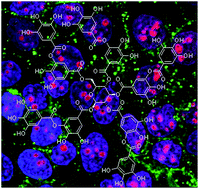
Tannic acid (TA) has multiple effects against cancer, being especially promising in those types that overexpress the epidermal growth factor receptor (EGFR), as TA modulates its activation and downstream signaling pathways, triggering apoptosis. Nonetheless, despite the important role of this receptor in the pathogenesis and progression of a wide variety of tumors, no TA systems targeted to this receptor have been described yet. In this work, we synthesize, characterize by physico-chemical techniques and study the cytotoxic effect and cell uptake of TA nanoparticles targeted to EGFR in both tumoral and normal human skin cells. Our nanoparticles exhibited an extremely high entrapment efficiency, and were only toxic for the tumoral cells. The uptake assay demonstrated that nanoparticles are able to enter the cells through a receptor-mediated mechanism. Furthermore, we have included fluorescent markers in these nanoparticles to combine imaging and therapeutic applications, thus building effectively a multifunctional tool for biomedicine.
Junio, 2016 | DOI: 10.1039/C5RA19405A
Reactividad de Sólidos
Mechanochemically synthesized nanocrystalline ternary CuInSe2 chalcogenide semiconductor
Dutkova, E; Sayagues, MJ; Kovac, J; Kovac, J; Bujnakova, Z; Briancin, J; Zorkovska, A; Balaz, P; Ficeriova, JMaterials Letters, 173 (2016) 182-186

The synthesis of nanocrystalline ternary CuInSe2 particles prepared by high-energy milling in a planetary mill in an argon atmosphere from copper, indium and selenium was reported. CuInSe2 particles crystallize in the tetragonal structure with the crystallite size of about 30.5 nm. The Raman spectrum of CuInSe2 nanoparticles shows a strong peak at 176 cm−1 corresponds to the A1 phonon mode of tetragonal CuInSe2 chalcopyrite. HRTEM measurements also revealed the presence of nanocrystals with the size of 10–20 nm with the tendency to form agglomerates. The optical absorption study shows that nanoparticles have direct optical band gap energy of 1.8 eV. The quantum size effect of the particles was confirmed also by PL measurement.
Junio, 2016 | DOI: 10.1016/j.matlet.2016.03.051
Reactividad de Sólidos
Use of steel slag for CO2 capture under realistic calcium-looping conditions
Miranda-Pizarro, J; Perejon, A; Valverde, JM; Sanchez-Jimenez, PE; Perez-Maqueda, LARSC Advances, 6 (2016) 37656-37663

In this study, CaO derived from steel slag pretreated with diluted acetic acid has been tested as a dry sorbent for CO2 capture under realistic Ca-Looping (CaL) conditions, which necessarily implies calcination under high CO2 partial pressure and fast transitions between carbonation and calcination stages. The multicycle capture performance of the sorbent has been investigated by varying the precalcination time, carbonation/calcination residence times and with the introduction of a recarbonation stage. Results show that the sorbent can be regenerated in very short residence times at 900 °C under high CO2 partial pressure, thus reducing the calciner temperature by about 30–50 °C when compared to limestone. Although the introduction of a recarbonation stage to reactivate the sorbent, as suggested in previous studies for limestone, results in a slightly enhanced capture capacity, the sorbent performance can be significantly improved if the main role of the solid-state diffusion-controlled carbonation is not dismissed. Thus, a notable enhancement of the capture capacity is achieved when the carbonation residence time is prolonged beyond just a few minutes, which suggests a critical effect of solids residence time in the carbonator on the CO2 capture efficiency of the CaL process when integrated into a power plant.
Junio, 2016 | DOI: 10.1039/C6RA03210A
Reactividad de Sólidos
A hybrid silver-magnetite detector based on surface enhanced Raman scattering for differentiating organic compounds
Caro, C; Sayagues, MJ; Franco, V; Conde, A; Zaderenko, P; Gamez, FSensors and Actuators B: Chemical, 228 (2016) 124-133
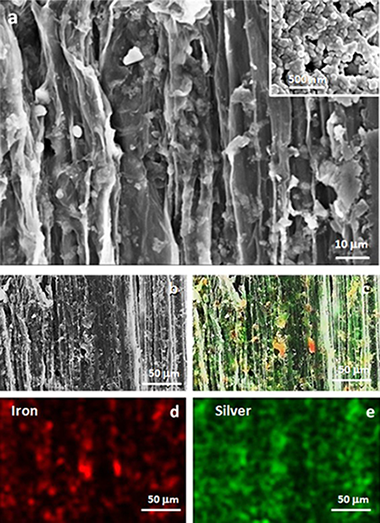
In this work a cheap detector of organic molecules is developed. It comprises a cellulose fiber doped with a mixture of magnetite and reduced silver nanoparticles, the latter ones synthesized anew. The nanoparticles and the fiber were characterized with well-established spectroscopic, microscopic and magnetic techniques, namely infrared, UV–vis spectroscopies, vibrating sample magnetometry and electronic microscopies. The so-obtained doped-fibers were tested as surface enhanced Raman spectroscopy detector in aqueous samples with a diluted mixture of two pollutant models (rhodamine 6G and picric acid), being able to differentiate between both organic compounds. Hence, the nanoparticle-impregnated fiber is proposed as a reliable preliminary qualitative and semiquantitative test of the presence of specific organic molecules in solutions. Moreover, the magnetite nanoparticles provide the detector with a saturation magnetization value that enables the separation of the fiber from the solution with the aid of a commercial magnet.
Junio, 2016 | DOI: 10.1016/j.snb.2016.01.003
Reactividad de Sólidos
Targeted multifunctional tannic acid nanoparticles
Aguilera, J. R.; Venegas, V.; Oliva, J. M.; Sayagues, M. J.; de Miguel, M.; Sanchez-Alcazar, J. A.; Arevalo-Rodriguez, M.; Zaderenko, A. P.RSC Advances, 9 (2016) 108611-108620

Tannic acid (TA) has multiple effects against cancer, being especially promising in those types that overexpress the epidermal growth factor receptor (EGFR), as TA modulates its activation and downstream signaling pathways, triggering apoptosis. Nonetheless, despite the important role of this receptor in the pathogenesis and progression of a wide variety of tumors, no TA systems targeted to this receptor have been described yet. In this work, we synthesize, characterize by physico-chemical techniques and study the cytotoxic effect and cell uptake of TA nanoparticles targeted to EGFR in both tumoral and normal human skin cells. Our nanoparticles exhibited an extremely high entrapment efficiency, and were only toxic for the tumoral cells. The uptake assay demonstrated that nanoparticles are able to enter the cells through a receptor-mediated mechanism. Furthermore, we have included fluorescent markers in these nanoparticles to combine imaging and therapeutic applications, thus building effectively a multifunctional tool for biomedicine.
Junio, 2016 | DOI: 10.1039/c5ra19405a
Reactividad de Sólidos
Template-Assisted Hydrothermal Growth of Aligned Zinc Oxide Nanowires for Piezoelectric Energy Harvesting Applications
Ou, C; Sanchez-Jimenez, PE; Datta, A; Boughey, FL; Whiter, RA; Sahonta, SL; Kar-Narayan, SACS Applied Materials & Interfaces, 8 (2016) 13678-13683

A flexible and robust piezoelectric nanogenerator (NG) based on a polymer-ceramic nanocomposite structure has been successfully fabricated via a cost-effective and scalable template assisted hydrothermal synthesis method. Vertically aligned arrays of dense and uniform zinc oxide (ZnO) nanowires (NWs) with high aspect ratio (diameter similar to 250 nm, length similar to 12 mu m) were grown within nanoporous polycarbonate (PC) templates. The energy conversion efficiency was found to be similar to 4.2%, which is comparable to previously reported values for ZnO NWs. The resulting NG is found to have excellent fatigue performance, being relatively immune to detrimental environmental factors and mechanical failure, as the constituent ZnO NWs remain embedded and protected inside the polymer matrix.
Junio, 2016 | DOI: 10.1021/acsami.6b04041
Reactividad de Sólidos
Hot-pressing of (Ti,Mt)(C,N)-Co-Mo2C (Mt = Ta,Nb) powdered cermets synthesized by a mechanically induced self-sustaining reaction
Chicardi, E; Gotor, FJ; Medri, V; Guicciardi, S; Lascano, S; Cordoba, JMChemical Engineering Journal, 292 (2016) 51-61
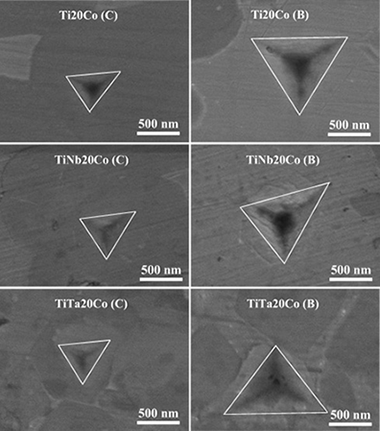
A mechanically induced self-sustaining reaction (MSR) has been successfully employed for manufacturing powdered cermets based on Ti, Ti–Ta and Ti–Nb carbonitrides using Co as the binder phase and Mo2C as the sintering additive. The powders were sintered by hot-pressing, and complete chemical, microstructural and mechanical characterizations were performed on the densified cermets. When elemental Ta, Nb and/or Mo2C were added to the initial raw mixture submitted to the MSR process, smaller ceramic grains were observed after sintering, which suggested that ceramic particle growth was hindered by the presence of Ta, Nb and/or Mo in the host titanium carbonitride structure. Nanoindentation measurements enabled the determination of the hardness of the ceramic and binder phases, and values in the range of 26–29 GPa and 14–16 GPa were found, respectively. The high hardness values of the binder were related to the formation of intermetallic phases.
Mayo, 2016 | DOI: 10.1021/acsami.6b00232
Reactividad de Sólidos
Obtention of Li3xLa2/3−xTiO3 ceramics from amorphous nanopowders by spark plasma sintering
Leyet, Y.; Guerrero, F.; Anglada-Rivera, J.; Martinez, I.; Amorin, H.; Romaguera-Barcelay, Y.; Poyato, R.; Gallardo-Lopez, A.Ferroelectrics, 498 (2016) 62-66
In this work, Li3xLa2/3-xTiO3 powder with nominal lithium content (x = 0.08) was synthesized by mechano synthesis method. Spark plasma sintering (SPS) was employed to prepare lithium lanthanum titanium oxide solid-state ceramic. The techniques of X-ray diffraction, high resolution scanning electron microscopy, and Raman spectroscopy were used to characterize the composition and microstructure of samples. The results showed that fine-grained ceramics with relative density of 95.5% were obtained by sintering the oxide powders at 1100 degrees C for only 5min.
Mayo, 2016 | DOI: 10.1080/00150193.2016.1167538
Reactividad de Sólidos
Electrical properties of reduced 3YTZP ceramics consolidated by spark plasma sintering
Poyato, R; Macias-Delgado, J; Garcia-Valenzuela, A; Gonzalez-Romero, RL; Munoz, A; Dominguez-Rodriguez, ACeramics International, 42 (2016) 6713-6719

3 mol% Yttria doped zirconia ceramics were consolidated by spark plasma sintering (SPS) at two sintering temperatures with the aim of achieving two different reduction levels. Microstructural characterization of the ceramics was performed by scanning electron microscopy (SEM). Electrical properties were investigated by means of impedance spectroscopy from room temperature up to 500 degrees C. The two ceramics presented a remarkably different electrical behavior. The effect of the extra electrons introduced by reduction during SPS on both the bulk and the grain boundary conductivity was analyzed and discussed.
Mayo, 2016 | DOI: 10.1016/j.ceramint.2016.01.040
Reactividad de Sólidos
Effect of dolomite decomposition under CO2 on its multicycle CO2 capture behaviour under calcium looping conditions
Martos, AD; Valverde, JM; Sanchez-Jimenez, PE; Perejon, A; Garcia-Garrido, C; Perez-Maqueda, LAPhysical Chemistry Chemical Physics, 18 (2016) 16325-16336
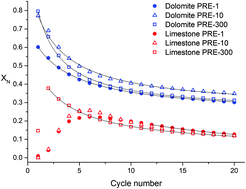
One of the major drawbacks that hinder the industrial competitiveness of the calcium looping (CaL) process for CO2 capture is the high temperature (∼930–950 °C) needed in practice to attain full calcination of limestone in a high CO2 partial pressure environment for short residence times as required. In this work, the multicycle CO2 capture performance of dolomite and limestone is analysed under realistic CaL conditions and using a reduced calcination temperature of 900 °C, which would serve to mitigate the energy penalty caused by integration of the CaL process into fossil fuel fired power plants. The results show that the fundamental mechanism of dolomite decomposition under CO2 has a major influence on its superior performance compared to limestone. The inert MgO grains resulting from dolomite decomposition help preserve a nanocrystalline CaO structure wherein carbonation in the solid-state diffusion controlled phase is promoted. The major role played by the dolomite decomposition mechanism under CO2 is clearly demonstrated by the multicycle CaO conversion behaviour observed for samples decomposed at different preheating rates. Limestone decomposition at slow heating rates yields a highly crystalline and poorly reactive CaCO3 structure that requires long periods to fully decarbonate and shows a severely reduced capture capacity in subsequent cycles. On the other hand, the nascent CaCO3 produced after dolomite half-decomposition consists of nanosized crystals with a fast decarbonation kinetics regardless of the preheating rate, thus fully decomposing from the very first cycle at a reduced calcination temperature into a CaO skeleton with enhanced reactivity as compared to limestone derived CaO.
Mayo, 2016 | DOI: 10.1039/c6cp01149g
Materiales Avanzados
Effect of lime on stabilization of phyllite clays
Garzon, E; Cano, M; O'Kelly, BC; Sanchez-Soto, PJApplied Clay Science, 123 (2016) 329-334

This paper represents a new advance in the study of engineering properties and material applications of phyllite clays. Considering their potential use as construction materials for structures subjected to low stress levels, this laboratory research investigated the stabilization and improvement in engineering properties of a Spanish phyllite clay achieved by the addition of 3, 5 and 7 wt.% lime. Geotechnical properties investigated include the consistency limits, compaction, California Bearing Ratio, swelling potential and water-permeability. The phyllite clay–lime mixtures had good compaction properties and very to extremely low permeability-coefficient values, with a semi-logarithmic correlation between increasing permeability and increasing proportion of lime additive. The addition of 3 wt.% lime was sufficient to reach the index of capacity amble specified in the Sheet of Technical General Prescriptions for Works of Roads and Bridges PG–3 (Spanish Highways Agency, 2008), significantly reducing the plasticity index value, with the compacted mixture undergoing no swelling under soakage. The required pavement thicknesses for the raw phyllite–clay material and the phyllite clay–lime mixtures are compared and discussed. Potential applications for phyllite clay–lime mixtures include for pavements/road subgrade, earth construction, building materials and for impermeabilization purposes.
Abril, 2016 | DOI: 10.1016/j.clay.2016.01.042
The Structure and Chemical Composition of Wall Paintings From Islamic and Christian Times in the Seville Alcazar
Robador, MD; De Viguerie, L; Perez-Rodriguez, JL; Rousseliere, H; Walter, P; Castaing, JArchaeometry, 58 (2016) 255-270
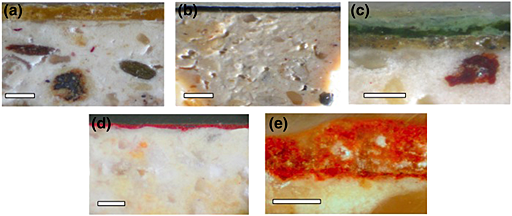
Wall paintings from the Islamic epoch (10th to 12th centuries) and the Christian monarchy (14th to 16th centuries) have been recovered in discarded materials and on walls after reconstruction works in the Seville Alcazar. These paintings have spent centuries underground or under a plaster coat. Portable X-ray fluorescence (XRF) and combined XRF/X-ray diffraction (XRD) were employed in situ, as well as scanning electron microscopy (SEM-EDX), grazing angle incidence XRD and micro-Raman spectroscopy, on cross-section samples to fully characterize the materials in the wall paintings. Using these methods, the fresco technique was demonstrated, and many kinds of pigments were identified in accordance with the various periods of the history of the Alcazar, thus assessing the authenticity of all the wall paintings studied here.
Abril, 2016 | DOI: 10.1111/arcm.12218
Materiales Avanzados
Ceramics from clays and by-product from biodiesel production: Processing, properties and microstructural characterization
Martinez-Martinez, S; Perez-Villarejo, L; Eliche-Quesada, D; Carrasco-Hurtado, B; Sanchez-Soto, PJ; Angelopoulos, GNApplied Clay Science, 121 (2016) 119-126

The production of biodiesel generates a by-product called glycerine which contains glycerol that cannot be reintegrated into the same manufacturing process. The ceramic bricks are an interesting option to set in their structure a wide range of by-products and residues materials and composites, sometimes serving only as a reservoir for the inert residue, and other, having a positive effect on the ceramic material or process. In the present work, the incorporation of this waste in raw clays has been studied. The raw materials: clay and glycerine was characterized by XRD, XRF, CNHS analysis, higher heating value and thermal analysis and after, using conventional moulding and sintering processing methods to prepare clay-glycerine composites, the influence of the amount of waste added to clay has been evaluated. To do this, percentages of glycerine were added to the clay from 5% to 20% and evaluated by a series of technological properties such as compressive strength, absorption and suction of water, bulk density, the study of porosity generated by adsorption-desorption isotherms of N-2, thermal conductivity and finally by the compressive strength after freezing-thaw, it was considered as the maximum permissible rate of addition of glycerol 10-15% in weight, because higher additions have a strong effect on the properties of the obtained materials such as compression strength and bulk density which descending dramatically due to the large amount of porosity generated as reflected by high values of absorption and suction experiments. It was concluded that adding 5% glycerol to the ceramic paste generated plasticity in clay to achieve be moulded, with values of compressive strength of 84 MPa while gets to reduce the density apparent by almost.
Marzo, 2016 | DOI: 10.1016/j.day.2015.12.003
Reactividad de Sólidos
Fabrication and characterization of CeO2 pellets for simulation of nuclear fuel
Garcia-Ostos, C; Rodriguez-Ortiz, JA; Arevalo, C; Cobos, J; Gotor, FJ; Torres, YNuclear Engineering and Design, 298 (2016) 160-167

Cerium Oxide, CeO2, has been shown as a surrogate material to understand irradiated Mixed Oxide (MOX) based matrix fuel for nuclear power plants due to its similar structure, chemical and mechanical properties. In this work, CeO2 pellets with controlled porosity have been developed through conventional powder-metallurgy process. Influence of the main processing parameters (binder content, compaction pressure, sintering temperature and sintering time) on porosity and volumetric contraction values has been studied. Microstructure and physical properties of sintered compacts have also been characterized through several techniques. Mechanical properties such as dynamic Young's modulus, hardness and fracture toughness have been determined and connected to powder-metallurgy parameters. Simulation of nuclear fuel after reactor utilization with radial gradient porosity is proposed.
Marzo, 2016 | DOI: 10.1016/j.nucengdes.2015.12.026
Química de Superficies y Catálisis - Reactividad de Sólidos
Intensification of hydrogen production by methanol steam reforming
Sanz, O; Velasco, I; Perez-Miqueo, I; Poyato, R; Odriozola, JA; Montes, MInternational Journal Hydrogen Energy, 41 (2016) 5250-5259
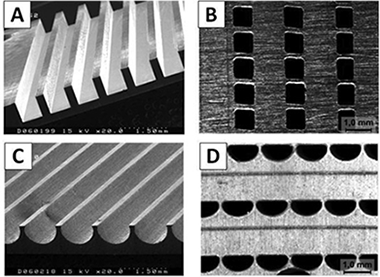
This paper studies the methanol steam reforming intensification to enhance the hydrogen production in a multi-channel block type micro-reformer. The effects of operating parameters such as reforming temperature, space velocity and catalyst layer thickness on reforming performance are investigated. For optimized design and operating conditions, the 8 cm(3) reformer unit produced 170 LH2/h containing on dry basis 75.0% H-2, 23.5% CO2, 0.06% CH3OH and 1.44% CO at 648 K allowing the production of 218-255 Win a commercial PEMFC with 80% hydrogen utilization. This study shows that high methanol conversion can be achieved with high Pd/ZnO catalyst loading at 648 K with very low CO content (<1.5%) in the outlet stream.
Marzo, 2016 | DOI: 10.1016/j.ijhydene.2016.01.084
Reactividad de Sólidos
Synthesis and characterization of CuInS2 nanocrystalline semiconductor prepared by high-energy milling
Dutkova, E; Sayagues, MJ; Briancin, J; Zorkovska, A; Bujnakova, Z; Kovac, J; Kovac, J; Balaz, P; Ficeriova, JJournal of Materials Science, 51 (2016) 1978-1984

Nanocrystalline CuInS2 particles have been synthesized from copper, indium, and sulfur powders by high-energy milling in a planetary mill in an argon atmosphere. Structural characterization of the prepared nanoparticles, including phase identification, Raman spectroscopy, specific surface area measurement, and particle size analysis were performed. The optical properties were studied using UV-Vis absorption and photoluminescence (PL) spectroscopy. The production of CuInS2 (JCPDS 027-0159) particles with a crystallite size of about 17.5-23.5 nm was confirmed by X-ray diffraction. The crystal structure has a tetragonal body-centered symmetry belonging to the I-42d space group. The Raman spectra also proved the formation of pure CuInS2 nanoparticles. TEM and HRTEM measurements revealed the presence of nanoparticles of different dimensions (10-20 nm) and their tendency to form agglomerates. The nanoparticles tend to agglomerate due to their large specific surface area. The average size of the synthesized particles was determined by photon cross-correlation spectroscopy to be in the range of 330-530 nm (bimodal size distribution). The band gap of the CuInS2 particles is 2 eV which is wider than that in bulk materials. The decrease in size leads to the blue-shift of the PL spectra. Therefore, CuInS2 nanoparticles are promising candidates for optical applications, and they have high potential in solar energy conversion.
Febrero, 2016 | DOI: 10.1007/s10853-015-9507-x
Reactividad de Sólidos
Study by DSC and HRTEM of the aging strengthening of Cu-Ni-Zn-Al alloys
Dianez, MJ; Donoso, E; Criado, JM; Sayagues, MJ; Diaz, G; Olivares, LMaterials & Design, 92 (2016) 184-188
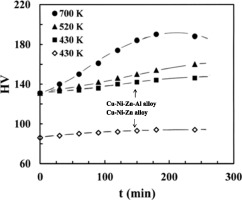
The structural changes of a Cu-12 wt.% Ni-17 wt.% Zn-1.7 wt% Al alloy as a function of the aging temperature have been studied by means of Differential Scanning Calorimetry (DSC), high resolution transmission electron microscopy (HRTEM) and hardness measurements. It has been proposed a hardening mechanism that implies the crystallization of a Ll(0) Cu2NiZn phase coherent with the matrix a phase followed, firstly, by its transformation into a Ll(2) coherent phase and, secondly, by the precipitation of this phase. It has been shown that aluminum play an important role in the precipitation hardening process because Cu2NiZn precipitates are not formed by aging a ternary Cu-Ni-Zn alloy of similar composition. It has been shown by the first time that DSC could be a powerful tool for discriminating the whole set of phase transformations undergone by alloys as a function of the annealing temperature from a single heating run.
Febrero, 2016 | DOI: 10.1016/j.matdes.2015.12.030
Reactividad de Sólidos
High temperature oxidation resistance of (Ti,Ta)(C,N)-based cermets
Chicardi, E; Cordoba, JM; Gotor, FJCorrosion Science, 102 (2016) 125-136
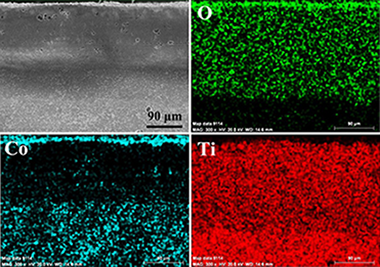
Cermets based on titanium-tantalum carbonitride were oxidized in static air between 800 degrees C and 1100 degrees C for 48 h. The thermogravimetric and microstructural study showed an outstanding reduction in the oxidation of more than 90% when the Ta content was increased. In cermets with low Ta content, the formation of a thin CoO/Co3O4 outer layer tends to disappear by reacting with the underlying rutile phase, which emerges at the surface. However, in cermets with higher Ta content, the formation of an external titanate layer, observed even at a low temperature, appears to prevent the oxygen diffusion and the oxidation progression.
Enero, 2016 | DOI: 10.1016/j.corsci.2015.10.001
Reactividad de Sólidos
The Calcium-Looping technology for CO2 capture: On the important roles of energy integration and sorbent behavior
Perejon, A; Romeo, LM; Lara, Y; Lisbona, P; Martinez, A; Valverde, JMApplied Energy, 162 (2016) 787-807
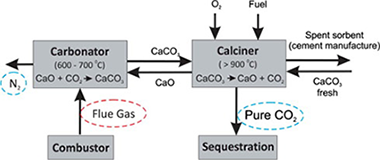
The Calcium Looping (CaL) technology, based on the multicyclic carbonation/calcination of CaO in gas-solid fluidized bed reactors at high temperature, has emerged in the last years as a potentially low cost technology for CO2 capture. In this manuscript a critical review is made on the important roles of energy integration and sorbent behavior in the process efficiency. Firstly, the strategies proposed to reduce the energy demand by internal integration are discussed as well as process modifications aimed at optimizing the overall efficiency by means of external integration. The most important benefit of the high temperature CaL cycles is the possibility of using high temperature streams that could reduce significantly the energy penalty associated to CO2 capture. The application of the CaL technology in precombustion capture systems and energy integration, and the coupling of the CaL technology with other industrial processes are also described. In particular, the CaL technology has a significant potential to be a feasible CO2 capture system for cement plants. A precise knowledge of the multicyclic CO2 capture behavior of the sorbent at the CaL conditions to be expected in practice is of great relevance in order to predict a realistic capture efficiency and energy penalty from process simulations. The second part of this manuscript will be devoted to this issue. Particular emphasis is put on the behavior of natural limestone and dolomite, which would be the only practical choices for the technology to meet its main goal of reducing CO2 capture costs. Under CaL calcination conditions for CO2 capture (necessarily implying high CO2 concentration in the calciner), dolomite seems to be a better alternative to limestone as CaO precursor. The proposed techniques of recarbonation and thermal/mechanical pretreatments to reactivate the sorbent and accelerate calcination will be the final subjects of this review.
Enero, 2016 | DOI: 10.1016/j.apenergy.2015.10.121
Reactividad de Sólidos
Influence of tin additions on the precipitation processes in a Cu-Ni-Zn alloys
Donoso, EC; Dianez, MJ; Criado, JM; Espinoza, R; Mosquera, ERevista de Metalurgia, 52 (2016) e060
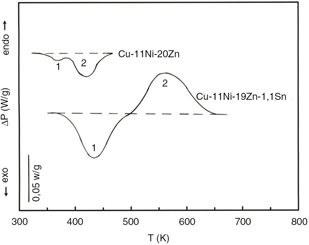
Influence of tin additions on the precipitation processes in a Cu-Ni-Zn alloys. The influence of 1.1 wt% tin additions on the precipitation hardening of Cu-11 wt% Ni-20 wt% Zn alloy was studied by Differential Scanning Calorimetry (DSC), microhardeness measurements and High Resolution Transmission Electron Microscopy (HRTEM). The calorimetric curves, in the range of temperatures analyzed, show the presence of two exothermic reactions in the ternary alloy, associated to the short-range-order development assisted by migration of excess vacancies. On the other hand, one exothermic and one endothermic reaction are observed in the quaternary alloy, associated to the formation and dissolution of Cu2NiZn precipitates, respectively. It has been show that an addition of 1.1% tin plays an important role in the formation of Cu2NiZn precipitates, responsible for the precipitation hardening of the ternary alloy.
Enero, 2016 | DOI: 10.3989/revmetalm.060
Reactividad de Sólidos
Kinetics of high-temperature oxidation of (Ti,Ta)(C,N)-based cermets
Chicardi, E; Cordoba, JM; Gotor, FJCorrosion Science, 102 (2016) 168-177
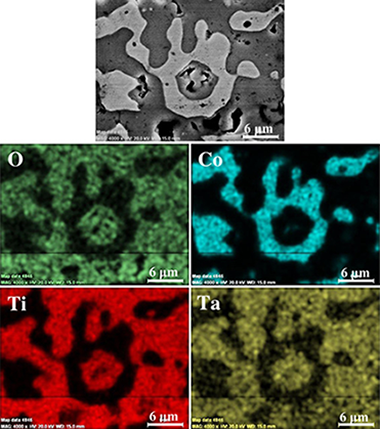
The kinetics of the high-temperature oxidation of titanium–tantalum carbonitride-based cermets with different Ti/Ta ratios was studied. Isothermal oxidation tests were conducted under static air for 48 h at temperatures between 700 °C and 1200 °C. The oxidation satisfied the parabolic kinetics, characteristic of the existence of a protective oxide layer. The apparent activation energy suggests the rate-controlling process during oxidation is the simultaneous inward and outward diffusion of oxygen and titanium, respectively, through the formed protective layer, consisting mainly of a rutile phase. A higher Ta(V) content in the rutile decreased the oxygen diffusivity due to the reduction of oxygen vacancy concentration.
Enero, 2016 | DOI: 10.1016/j.corsci.2015.10.006
2015
2015
Ceramics from the Alcazar Palace in Seville (Spain) dated between the 11th and 15th centuries: Compositions, technological features and degradation processes
Garofano, I; Robador, MD; Perez-Rodriguez, JL; Castaing, J; Pacheco, C; Duran, AJournal of the European Ceramic Society, 35 (2015) 4307-4319
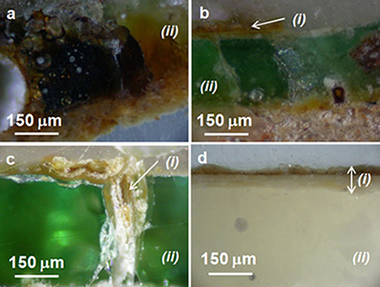
For the purpose of chemical characterization, a selection of 29 ceramic fragments from the 11th to 15th century has been made from materials excavated in the Seville Alcazar Palace. The PIXE elemental analysis results indicated that the ceramic bodies can be divided into four groups. The XRD identification of the phases present in the bodies revealed differences in the firing temperatures. The PIXE analysis of the glazes revealed variable PbO and SnO2 contents. The latter component was not detected in all the glazes. Cu, Co, Mn, Fe and Sb elements were associated with green, blue, black and yellow colours, respectively. Some glazes were covered by iridescent layers constituted by lead carbonate and phosphates due to alteration of the glazes. It was also possible to detail the microstructure and composition of the ultimate surface layers responsible for the lustre effect observed in two of the ceramic samples using PIXE and Rutherford backscattering spectrometry (RBS).
Diciembre, 2015 | DOI: 10.1016/j.jeurceramsoc.2015.07.033
Propiedades mecánicas, modelización y caracterización de cerámicos avanzados
High-temperature deformation of fully-dense fine-grained boron carbide ceramics: Experimental facts and modeling
Moshtaghioun, BM; Garcia, DG; Rodriguez, ADMaterials & Design, 88 (2015) 287-293
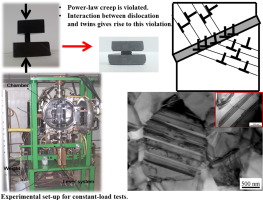
Boron carbide ceramics are the hardest material in Nature after diamond and the cubic phase of boron nitride. Due to this fact, their room-temperature fracture properties are the object of intense research. Paradoxically, high-temperature deformation is essentially unknown, because very high temperatures and stresses are necessarily required and high-quality specimens have not been available until recently. In this paper, the high-temperature compressive creep of fine-grained boron carbide polycrystals is reported. The breakdown of the classical power-law for high-temperature plasticity in ceramics is found. An analytical model is proposed. The model assumes that deformation is produced by dislocation glide. However, since the formation of twins is energetically favorable in this material and they act as strong barriers for dislocation glide, their motion turns to become progressively more difficult as elongation proceeds. The combination of increasing twin barriers and dislocations in mutual interaction is proposed to be the mechanism for high-temperature plasticity in this material. The model is validated with the experimental results. Final elongation of boron carbide specimens is reported to be over 100%, although this material cannot be described as a superplastic ceramic.
Diciembre, 2015 | DOI: 10.1016/j.matdes.2015.08.134
Reactividad de Sólidos
Microstructure and impedance spectroscopy of 3YTZP/SWNT ceramic nanocomposites
Poyato, R; Macias-Delgado, J; Gallardo-Lopez, A; Munoz, A; Dominguez-Rodriguez, ACeramics International, 41 (2015) 12861-12868

This work provides new insights on microstructure and electrical properties of 3 mol% Y2O3-ZrO2 (3YTZP) composites with 0.5, 1, and 1.5 vol% single walled carbon nanotubes (SWNTs). The composites were spark plasma sintered (SPS) in identical conditions at 1250 degrees C from powder prepared by two different processing routines, with the aim of optimizing the SWNTs dispersion throughout the ceramic matrix. High densification and submicrometric grain size were achieved in all the composites. Electrical properties of the composites were characterized in a wide temperature range, and modeling of the impedance properties was approached by means of an equivalent circuit that allows separation of the individual SWNT bundles contribution to resistance from the resistance due to junctions between bundles. Effects of the homogeneous distribution of SWNTs at the ceramic grain boundaries on the crystalline phases, percolation threshold, total conductivity and evolution of junctions' resistivity with temperature were analyzed and discussed.
Diciembre, 2015 | DOI: 10.1016/j.ceramint.2015.06.123
Reactividad de Sólidos
A new model of the carbonator reactor in the calcium looping technology for post-combustion CO2 capture
Ortiz, C; Chacartegui, R; Valverde, JM; Becerra, JA; Perez-Maqueda, LAFuel, 160 (2015) 328-338

The Ca-Looping (CaL) process is considered as a promising technology for CO2 post-combustion capture in power generation plants yielding a minor penalty on plant performance as compared with other capture technologies such as conventional amine-based capture systems. This manuscript presents a new carbonator reactor model based on lab-scale multicyclic CaO conversion results, which take into account realistic CaO regeneration conditions that necessarily involve calcination under high CO2 partial pressure and high temperature. Under these conditions, CaO conversion in the diffusion controlled stage is a relevant contribution to the carbonation degree during typical residence times. The main novelty of the model proposed in the present work is the consideration of the capture efficiency in the diffusion controlled phase of carbonation. It is demonstrated that increasing the residence time by a few minutes in the carbonator yields a significant improvement of the capture efficiency. Model predictions are shown to agree with experimental results retrieved from pilot-scale tests. The new model allows a more accurate evaluation and prediction of carbonator’s performance over a wider range of residence times. The results obtained may be relevant for the optimization of CaL operation parameters to be used in real power plants.
Noviembre, 2015 | DOI: 10.1016/j.fuel.2015.07.095
Green pigments of Roman mural paintings from Seville Alcazar
Perez-Rodriguez, JL; de Haro, MDJ; Siguenza, B; Martinez-Blanes, JMApplied Clay Science, 116 (2015) 211-219
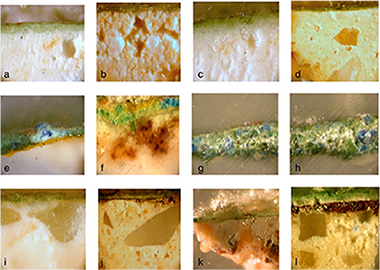
We report here a study of 30 fragments of green wall paintings from Roman times found in the Patio de Banderas excavation in Seville Alcazar. The sample characterisation was realised using optical microscopy, colourimetry, infrared and micro-Raman spectroscopy, X-ray diffraction, and scanning electron microscopy equipped with energy dispersive X-ray spectroscopy. The study of these pigments is important because it can help determine the source or the pictorial technique used. The samples studied in this work have been divided into two groups, according to the composition of their green pigments. In the first group, celadonite has been characterised as the primary component of the green colour; chlorite was also detected. Particles constituted by chromium accompanied by aluminium, iron and zinc were found in all studied samples of this group. Chlorite and chromium oxide could also be responsible for the green colour. The presence of chromium suggested the presence of green colour pigment from Verona. In the second group, a mixture of celadonite and glauconite was detected and could be responsible for the green colour observed. The addition of refracting material such as Egyptian blue was also used. A mixture of Egyptian green and Egyptian blue together with celadonite and glauconite was also found. Four classes of intonaco were recognised and classified based upon the composition of the aggregates.
Noviembre, 2015 | DOI: 10.1016/j.clay.2015.03.016
Materiales Avanzados
An improved method for determining the external specific surface area and the plasticity index of clayey samples based on a simplified method for non-swelling fine-grained soils
Garzon, E; Sanchez-Soto, PJApplied Clay Science, 115 (2015) 97-107
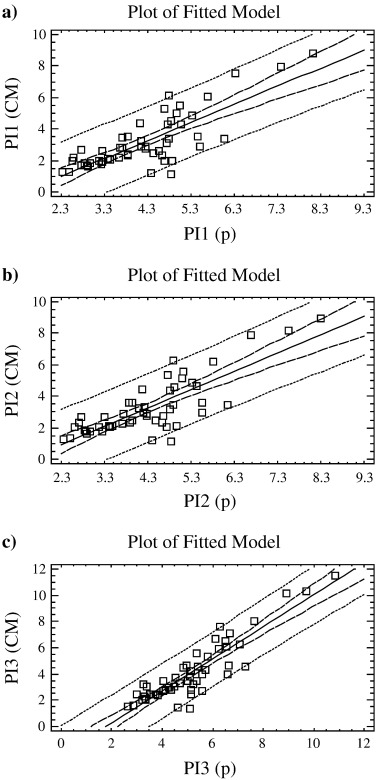
Previous studies have used the clay content of soils for estimating the specific surface areas and different correlations have been found, including plasticity-value correlations. Based on several assumptions, Dolinar (2012) proposed a simplified method for determining the external specific surface area of non-swelling fine-grained soils. An equation relates the external specific surface area (BET-nitrogen) with percentage of clay fraction (< 2 μm), determined by hydrometer method, and plasticity index (Atterberg).
In this work, based on that simplified method, the authors have developed an improved method for determining the external specific surface area of fine-grained clay samples. Instead of percentage of clay fraction, it was proposed to use the clay mineral content estimated by XRD methods. From an analysis of previous Dolinars results, the calculated and measured values of external specific surface area were studied for a group of non-swelling and fine-grained soil samples (Dolinar's samples), five non-swelling clayey samples and data samples from the literature. Additionally, an estimation of the plasticity index (Atterberg) has been also considered in this improved method. Both these methods, simplified and improved, were tested and compared using all these samples. It demonstrated the practical application of both these methods for an estimation of external specific surface area and plasticity index. However, in the present research two models were considered to determine the specific surface areas (BET and Langmuir) and the influence of several sources of errors in these predictions was discussed. The predictions were found more accurate when specific surface area from Langmuir's model is considered. It is concluded that the present research will be useful for the prediction of external specific surface area and plasticity index of non-swelling clayey materials and to dispose of theoretical practical relationships between clay mineralogy and geotechnical properties of valuable interest.
Octubre, 2015 | DOI: 10.1016/j.clay.2015.07.015
Reactividad de Sólidos
Structural, Optical, and Electrical Characterization of Yttrium-Substituted BiFeO3 Ceramics Prepared by Mechanical Activation
Perejon, A; Gil-Gonzalez, E; Sanchez-Jimenez, PE; Criado, JM; Perez-Maqueda, LAInorganic Chemistry, 54 (2015) 9876-9884
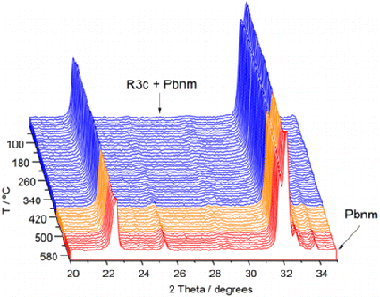
Ceramics of Bi1-xYxFeO3 solid solutions (x = 0.02, 0.07, and 0.10) have been prepared by mechanical activation followed by sintering. The effect of yttrium content on the structural, electrical, and optical properties of the materials has been studied. Thus, single-phase solid solutions with rhombohedral R3c structure have been achieved for x = 0.02 and 0.07, while for x = 0.10 the main R3c phase has been detected together with a small amount of the orthorhombic Pbnm phase. Multiferroic properties of the samples, studied by differential scanning calorimetry (DSC), showed that both T-N and T-C (temperatures of the antiferromagnetic paramagnetic and ferroelectric-paraelectric transitions, respectively) decrease with increasing yttrium content. The nature of the ferroelectric paraelectric transition has been studied by temperature-dependent X-ray diffraction (XRD), which revealed rhombohedral R3c to orthorhombic Pbnm phase transitions for x = 0.07 and 0.10. On the other hand, for x = 0.02 the high-temperature phase was indexed as Pnma. Optical properties of the samples, as studied by diffuse reflectance spectroscopy, showed low optical band gap that decreases with increasing yttrium content. Prepared ceramics were highly insulating at room temperature and electrically homogeneous, as assayed by impedance spectroscopy, and the conductivity increased with x.
Octubre, 2015 | DOI: 10.1021/acs.inorgchem.5b01654
Materiales Avanzados
Phyllite clay-cement composites having improved engineering properties and material applications
Garzon, E; Cano, M; O'Kelly, BC; Sanchez-Soto, PJApplied Clay Science, 114 (2015) 229-233
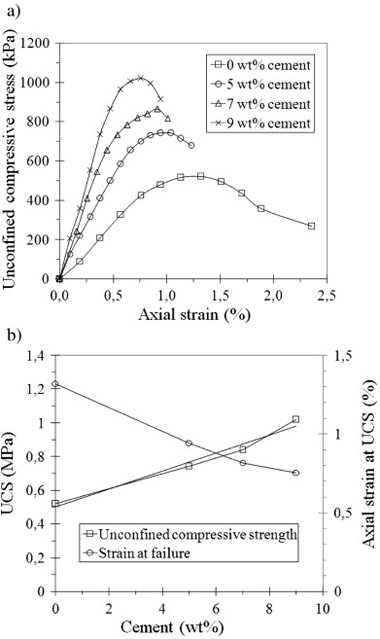
Phyllite clays contain clay minerals (chlorite, illite and mixed-layer illite smectite), quartz and feldspars. In this experimental laboratory study, new composites of phyllite clay and cement (5, 7 and 9 wt.%) were prepared and tested to determine their Atterberg limits, dry density and optimum water content for modified Proctor (MP) compaction, California Bearing ratio, swelling potential after soakage in water, unconfined compressive strength (UCS) and water-permeability coefficient. From the mixes investigated, the composite with 5 wt.% cement was deemed most suitable for certain construction material applications, having a plasticity index of 10.5%, maximum dry density of 2.17 Mg/m3 and optimum water content of 8% for MP compaction (undergoing no swelling under soakage), a UCS of 0.74 MPa, and a very low permeability coefficient value of 7.4 × 10− 11 m/s. Potential material applications for these new composites include for building construction, roofs, and flexible pavements.
Septiembre, 2015 | DOI: 10.1016/j.clay.2015.06.006
Reactividad de Sólidos
Photocatalytic Properties of TiO2 Thin Films Modified with Ag and Pt Nanoparticles Deposited by Gas Flow Sputtering
Maicu, M; Gloss, D; Frach, P; Hecker, D; Gerlach, G; Cordoba, JMJournal of Nanoscience and Nanotechnology, 15 (2015) 6478-6486
In this work, a gas flow sputtering (GFS) process which allows the production and deposition of metal nanoparticles (NPs) in a vacuum environment is described. Aim of the study is to prove the potential of this technology for the fabrication of new TiO2 films with enhanced photocatalytic properties. For this purpose, Ag and Pt NPs have been produced and deposited on photocatalytic float glass coated with TiO2 thin films by magnetron sputtering. The influence of the process parameters and of the metal amount on the final properties of the particles (quantity, size, size distribution, oxidation state etc.,) was widely investigated. Moreover, the effect of the NPs on the photocatalytic activity of the resulting materials was evaluated for the case of the decomposition of stearic acid (SA) during UV-A irradiation. The reduction of the water contact angle (WCA) during the irradiation period was measured in order to test the photo-induced super-hydrophilicity (PSH).
Septiembre, 2015 | DOI: 10.1166/jnn.2015.10873
Reactividad de Sólidos
Preparation of phase pure, dense fine grained ceramics by conventional and spark plasma sintering of La-substituted BiFeO3 nanoparticles
Perejon, Antonio; Sanchez-Jimenez, Pedro E.; Poyato, Rosalia; Maso, Nahum; West, Anthony R.; Criado, Jose M.; Perez-Maqueda, Luis A.Journal of the European Ceramic Society, 35 (2015) 2283-2293

High density ceramics of the system Bi1-xLaxFeO3, 0 <= x <= 0.15, have been prepared starting from nanoparticles obtained by mechanosynthesis. The ceramics have been sintered conventionally at 850 degrees C and by spark plasma sintering (SPS). Sintering conditions have been optimized to obtain single phase ceramics, and the microstructure of the ceramics has been compared. Ceramics prepared conventionally present grain sizes from 5 mu m to less than 1 mu m, whereas grain sizes by SPS are in the range from 50 to 100 nm, which demonstrates that it is possible to obtain nanostructured ceramics of La-substituted BiFeO3 using mechanosynthesis followed by SPS at low temperature (625-650 degrees C). The as-prepared SPS ceramics show low resistivity, indicating some reduction in the samples. However, after an oxidative anneal in air, ceramics are highly insulating at room temperature and electrically homogeneous. The high quality of the ceramics has also been demonstrated by XRD, EDX, Raman and DSC.
Agosto, 2015 | DOI: 10.1016/j.jeurceramsoc.2015.01.030
Reactividad de Sólidos
Mechanical and electrical properties of low SWNT content 3YTZP composites
Poyato, R; Macias-Delgado, J; Garcia-Valenzuela, A; Gallardo-Lopez, A; Morales-Rodriguez, A; Munoz, A; Dominguez-Rodriguez, AJournal of the European Ceramic Society, 35 (2015) 2351-2359
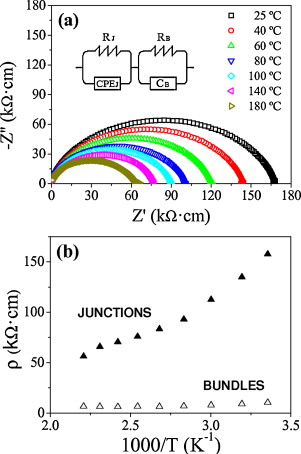
Fully dense 3 mol% Y2O3-ZrO2 (3YTZP) composites with low single wall carbon nanotube content (0.5, 1 and 1.5 vol% SWNT) were prepared by colloidal processing and spark plasma sintering (SPS). SWNT were distributed at ceramic grain boundaries and also into agglomerates. Characterization of SWNT agglomerates indicated that increase in SWNT vol% does not imply an increase in agglomeration. SWNT agglomerate density was related to the evolution of hardness and fracture toughness with SWNT vol%. Electrical properties of the composites were characterized in a wide temperature range, and percolation threshold was estimated. A model allowing separation of the individual SWNT bundles contribution to resistance from the resistance due to junctions between bundles was proposed for composites with a percolating SWNT network.
Agosto, 2015 | DOI: 10.1016/j.jeurceramsoc.2015.02.022
Study of coatings by thermal analysis in a monument built with calcarenite
Luisa Franquelo, Maria; Dolores Robador, Maria; Luis Perez-Rodriguez, JoseJournal of Thermal Analysis and Calorimetry, 121 (2015) 195-201

In this research, characterization of materials either added during restoration or formed by environmental contamination in the Seville City Hall, built with calcarenite stone, was investigated by thermal methods. Three different mortars for restoration have been characterized: (a) lime micro-mortar for internal consolidation of mortar itself, (b) mortar for reconstruction of deteriorated areas and (c) mortar with Portland cement. Acrylate polymer as consolidant and protection used was characterized. Addition of gypsum or “white cement” has been also applied in the restoration. Altered materials as black crusts constituted by gypsum, calcite and organic compound were determined by thermal analysis. Patina with high concentration of hydrated calcium oxalate, and the transformation mechanism of calcium oxalate into calcium carbonate and formation of calcium oxide produced by decomposition of the calcite were also characterized in the studied monument by thermal analysis. The patina with hydrated calcium oxalate produced by high biological activity was also studied.
Julio, 2015 | DOI: 10.1007/s10973-015-4432-4
Reactividad de Sólidos
In Situ Synthesis of a ZrB2-Based Composite Powder Using a Mechanochemical Reaction for the Zircon/Magnesium/Boron Oxide/Graphite System
Jalaly, M; Bafghi, MSS; Tamizifar, M; Gotor, FJInternational Journal of Applied Ceramic Technology, 12 (2015) 551-559

A ZrSiO4/B2O3/Mg/C system was used to synthesize a ZrB2-based composite through a high-energy ball milling process. As a result of the milling process, a mechanically induced self-sustaining reaction (MSR) was achieved in this system. A composite powder of ZrB2-SiC-ZrC was prepared in situ by a magnesiothermic reduction with an ignition time of approximately 6min. The mechanism for the formation of the product was investigated by studying the relevant subreactions, the stoichiometric amount of B2O3, and thermal analysis.
Mayo, 2015 | DOI: 10.1111/ijac.12202
Reactividad de Sólidos
Toughening of complete solid solution cermets by graphite addition
Chicardi, E; Torres, Y; Sayagues, MJ; Medri, V; Melandri, C; Cordoba, JM; Gotor, FJChemical Engineering Journal, 267 (2015) 297-305
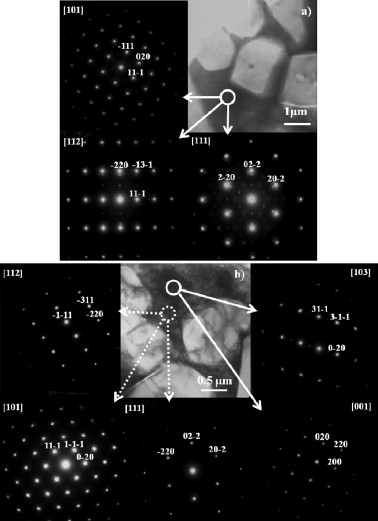
(Ti0.95Ta0.05)(C0.5N0.5)-Co complete solid solution cermets (CSCs) were developed by a mechanochemical synthesis process and a pressureless sintering method. The effect of different percentages of graphite used as a sintering additive on the nature of the binder phase and the mechanical properties of the cermets was investigated. Microstructural and mechanical characterisations were carried out by X-ray diffraction, optical microscopy, scanning electron microscopy, transmission electron microscopy, energy-dispersive X-ray spectroscopy, Vickers hardness, indentation fracture toughness and nanoindentation. The addition of graphite modified the carbon activity during sintering, reducing the dissolution of carbonitride ceramic particles into the molten binder. The amount of Ti and Ta remaining in the binder after sintering gradually decreased as the amount of graphite added increased, which induced a change in the nature of the binder phase. When no graphite was added, the binder consisted of the brittle TixTa1−xCo2 intermetallic phase. With the increase in the amount of graphite added, the formation of more ductile phases, such as TixTa1−xCo3 and α-Co, was observed, causing a significant improvement in the toughness of the cermets.
Mayo, 2015 | DOI: 10.1016/j.cej.2015.01.022
Reactividad de Sólidos
Morphological changes on graphene nanoplatelets induced during dispersion into an epoxy resin by different methods
Moriche, R; Prolongo, SG; Sanchez, M; Jimenez-Suarez, A; Sayagues, MJ; Urena, AComposites Part B-Engineering, 72 (2015) 199-205
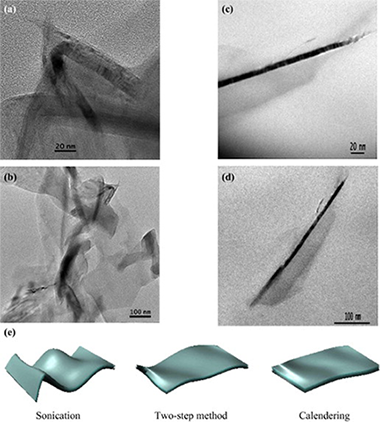
A structural analysis demonstrating how the manufacturing method of graphene nanoplatelets (GNPs) into a polymer matrix can strongly modify the GNPs morphology and, consequently, their properties, was carried out. Three different methods based on sonication and high shear forces were used to elucidate defects induction and possible size diminution. Manufacturing methods including high shear forces caused the extension of the GNPs while sonication induces wrinkling of the sheets. Residual stresses are induced in the nanoplatelets structure showing an increase in the Raman intensities ratios I-D/I-G and I-D/I-G when a major cycles number of calendering are applied.
Abril, 2015 | DOI: 10.1016/j.compositesb.2014.12.012
Reactividad de Sólidos
Mechanically induced self-propagating reaction of vanadium carbonitride
Roldan, MA; Alcala, MD; Real, CCeramics International, 41 (2015) 4688-4695
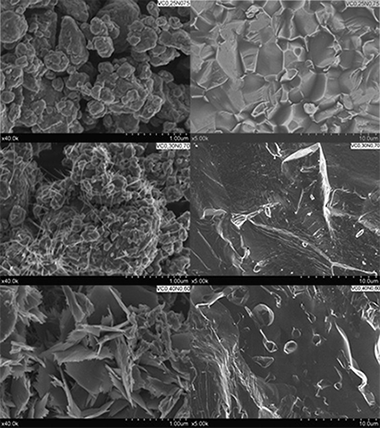
Vanadium carbonitrides (VCxN1-x) were prepared via mechanosynthesis from mixtures of elemental vanadium and carbon with different V/C atomic ratios under a nitrogen atmosphere using a high-energy ball mill. We obtained the full composition range of carbonitrides at room temperature. The products were characterized using X-ray diffraction, scanning electron microscopy and electron energy loss spectroscopy. The results showed particle-sized products with high sinterability and very high microhardness.
Abril, 2015 | DOI: 10.1016/j.ceramint.2014.12.016
Reactividad de Sólidos
Applications of sample-controlled thermal analysis (SCTA) to kinetic analysis and synthesis of materials
Perez-Maqueda, L. A.; Criado, J. M.; Sanchez-Jimenez, P. E.; Dianez, M. J.Journal of Thermal Analysis and Calorimetry, 120 (2015) 45-51
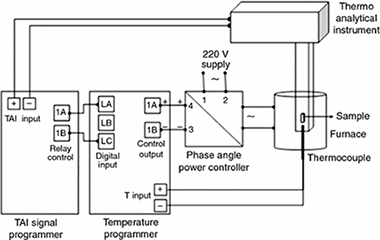
The advantages of the sample-controlled thermal analysis (SCTA) for both the kinetic analysis of solid-state reactions and the synthesis of materials are reviewed. This method implies an intelligent control of the temperature by the solid-state reaction under study in such a way that the reaction rate as a function of the time fits a profile previously defined by the user. It has been shown that SCTA has important advantages for discriminating the kinetic model of solid-state reactions as compared with conventional rising temperature methods. Moreover, the advantages of SCTA methods for synthesising materials with controlled texture and structure are analysed.
Abril, 2015 | DOI: 10.1007/s10973-014-4176-6
Materiales Avanzados
Valorization and inertization of galvanic sludge waste in clay bricks
Perez-Villarejo, L; Martinez-Martinez, S; Carrasco-Hurtado, B; Eliche-Quesada, D; Urena-Nieto, C; Sanchez-Soto, PJApplied Clay Science, 105-106 (2015) 89-99
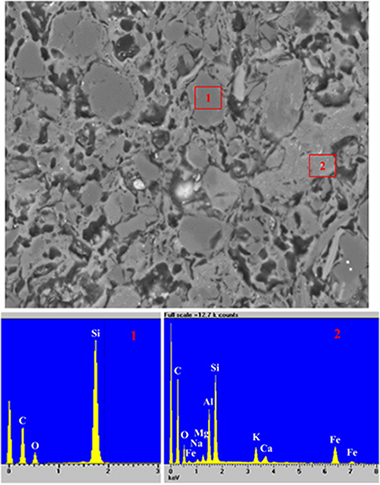
Galvanic sludge wastes (GSW) are produced by the physico-chemical treatments of wastewater generated by electroplating plants. These materials have a significant potential for the production of clay ceramic bricks. This paper focuses on the viability of the inertization of heavy metals from GSW mixed with clays. The original materials were obtained by mixing three types of raw clay (red, yellow and black) in equal parts with GSW. These mixtures were characterized by XRD, XRF, and chemical elemental analysis CHNS. The dosage of GSW in the clay–GSW bricks was up to 5 wt.%. The bricks were then manufactured using conventional processes. The influence of the amount of GSW was evaluated after firing the clay–GSW composites at 950 °C for 1 h. The engineering properties of the fired samples, such as density, water absorption, open porosity, water suction and compressive strength, with and without the GSW, were determined. The incorporation of GSW into the clay mix clearly decreased the linear shrinkage and bulk density of the bricks in comparison with the fired clay used as a control. These GSW–clay composites also showed lower open porosity. According to the results obtained for the bulk density of the bricks, samples with GSW addition showed slightly lower values of open porosity than clay bodies, indicating that the GSW–clay samples had slightly higher closed porosity values. This was also shown by SEM. The open porosity, SEM and pore size distribution tests indicated that the porosity generated by the addition of GSW was mainly closed and, therefore, GSW bricks had excellent mechanical properties. The environmental risks of the incorporation of GSW, rich in heavy metals (Cr, Zn, Ni and others), to a clay matrix were evaluated by leaching tests of the fired products. The results indicated a successful inertization of the pollutants.
Marzo, 2015 | DOI: 10.1016/j.clay.2014.12.022
Reactividad de Sólidos
Nanoindentation of (Ti,Ta)(C,N)-Co cermets prepared by methods of mechanochemistry
Hvizdos, Pavol; Balko, Jan; Manuel Cordoba, Jose; Chicardi, ErnestoInternational Journal of Refractory Metals & Hard Materials, 49 (2015) 219-224
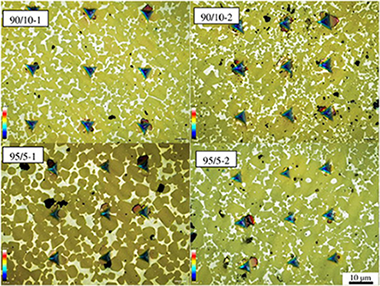
Four materials TixTa(1 - x)C(0.5)N(0.5)-20%Co of two chemical compositions (x = 0.9 and 0.95) and two high energy milling methods (one stage and two stage milling) have been prepared. Nano-hardness and elastic modulus for microstructure as a whole and for individual constituent phases (matrix and carbide grains) were obtained by instrumented indentation. Individual targeted indentations as well as grid nanoindentation technique were used to discern the individual constituents' properties. Maximum loads of 20 mN for individual phases and 300 mN for composite microstructure were applied. Materials with higher amount of Ti had larger grains but the milling procedure had stronger influence on the grain size. The two step milling resulted in finer microstructures but with a much wider grain size distribution. Final composite mechanical properties, however, were very similar. Hardness and indentation elasticity modulus of all materials were comparable within the errors of measurement.
Marzo, 2015 | DOI: 10.1016/j.ijrmhm.2014.07.038
Reactividad de Sólidos
Synthesis of a nanosilica supported CO2 sorbent in a fluidized bed reactor
Soria-Hoyo, C; Valverde, JM; van Ommen, JR; Sanchez-Jimenez, PE; Perez-Maqueda, LA; Sayagues, MJApplied Surface Science, 328 (2015) 548-553
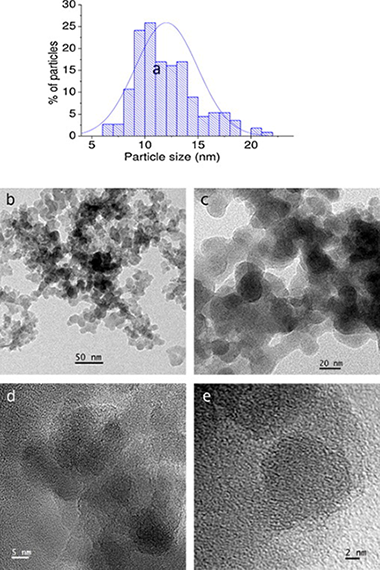
CaO has been deposited on a nanosilica powder matrix by a procedure based on atomic layer deposition (ALD) in a fluidized bed reactor at atmospheric pressure following a potentially scalable process. In previous works ALD in gas fluidized bed has been mostly performed under reduced pressure, which hampers scaling-up the production technology. The material synthesized in the present work is tested as CO2 solid sorbent at calcium looping conditions. Multicyclic thermogravimetric analysis (TGA) shows that the nanosilica support stabilizes the capture capacity of CaO. EDX-STEM analysis illustrates the presence of Ca well distributed on the surface of the SiO2 nanoparticles.
Febrero, 2015 | DOI: 10.1016/j.apsusc.2014.12.106
Reactividad de Sólidos
Ca-looping for postcombustion CO2 capture: A comparative analysis on the performances of dolomite and limestone
Valverde, JM; Sanchez-Jimenez, PE; Perez-Maqueda, LAApplied Energy, 138 (2015) 202-215

The low cost and wide availability of natural limestone (CaCO3) is at the basis of the industrial competitiveness of the Ca-looping (CaL) technology for postcombustion CO2 capture as already demonstrated by similar to 1 Mw(t) scale pilot projects. A major focus of studies oriented towards further improving the efficiency of the CaL technology is how to prevent the gradual loss of capture capacity of limestone derived CaO as the number of carbonation/calcination cycles is increased. Natural dolomite (MgCa(CO3)(2)) has been proposed as an alternative sorbent precursor to limestone. Yet, carbonation of MgO is not thermodynamically favorable at CaL conditions, which may hinder the capture performance of dolomite. In the work described in this paper we carried out a thermogravimetric analysis on the multicyclic capture performance of natural dolomite under realistic regeneration conditions necessarily implying high calcination temperature, high CO2 concentration and fast transitions between the carbonation and calcination stages. Our study demonstrates that the sorbent derived from dolomite has a greater capture capacity as compared to limestone. SEM analysis shows that MgO grains in the decomposed dolomite are resistant to sintering under severe calcination conditions and segregate from CaO acting as a thermally stable support which mitigates the multicyclic loss of CaO conversion. Moreover, full decomposition of dolomite is achieved at significantly lower calcination temperatures as compared to limestone, which would help improving further the industrial competitiveness of the technology.
Febrero, 2015 | DOI: 10.1016/j.apenergy.2014.10.087
Reactividad de Sólidos
Influence of the Processing Route on the Carbon Nanotubes Dispersion and Creep Resistance of 3YTZP/SWCNTs Nanocomposites
Castillo-Rodriguez, M; Munoz, A; Morales-Rodriguez, A; Poyato, R; Gallardo-Lopez, A; Dominguez-Rodriguez, AJournal of the American Ceramic Society, 98 (2015) 645-653
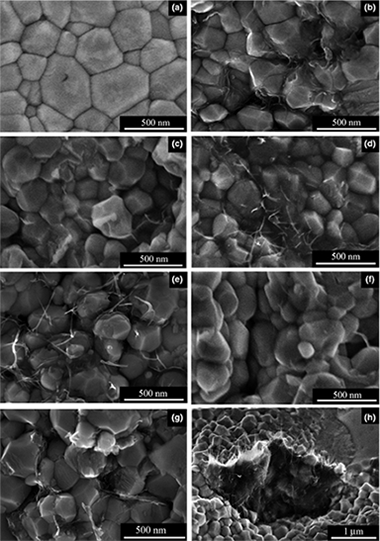
3YTZP matrix composites containing 2.5 vol% of single-walled carbon nanotubes (SWCNT) were fabricated by Spark Plasma Sintering (SPS) at 1250°C, following different processing routines with the aim of optimizing the SWCNTs dispersion throughout the ceramic matrix. Microstructural characterization of the as-fabricated samples has been performed by means of scanning electron microscopy (SEM). The specimens have been crept at 1200°C to correlate creep resistance and SWCNTs distribution. There are no creep experimental results on these nanocomposites reported in literature. Mechanical results show that the incorporation of SWCNTs into a 3YTZP matrix produces an increase in the strain rate at high temperature with respect to monolithic zirconia. The creep resistance of these nanocomposites decreases with the improvement of the SWCNTs dispersion, where a smaller SWCNTs agglomerate size and consequently a higher concentration of carbon nanotubes surrounding the 3YTZP grain boundaries is found. This fact indicates that SWCNTs act as a lubricant making grain-boundary sliding easier during deformation of these composites.
Febrero, 2015 | DOI: 10.1111/jace.13348
Propiedades mecánicas, modelización y caracterización de cerámicos avanzados
Ultra-fast and energy-efficient sintering of ceramics by electric current concentration
Zapata-Solvas, E; Gomez-Garcia, D; Dominguez-Rodriguez, A; Todd, RIScientific Reports, 5 (2015) art n. 8513
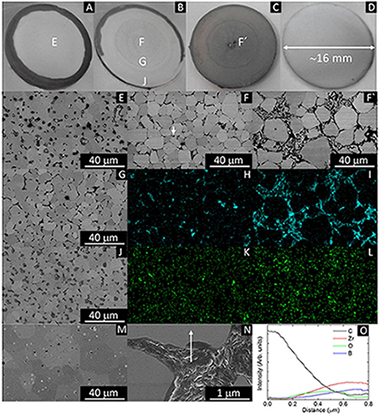
Electric current activated/assisted sintering (ECAS) techniques, such as electrical discharge sintering (EDS) or resistive sintering (RS), have been intensively investigated for longer than 50 years. In this work, a novel system including an electrically insulated graphite die for Spark Plasma Sintering (SPS) is described, which allows the sintering of any refractory ceramic material in less than 1 minute starting from room temperature with heating rates higher than 2000°C/min and an energy consumption up to 100 times lower than with SPS. The system alternates or combines direct resistive sintering (DRS) and indirect resistive sintering (IRS). Electrical insulation of the die has been achieved through the insertion of a film made of alumina fibers between the graphite die and the graphite punches, which are protected from the alumina fiber film by a graphite foil. This system localized the electric current directly through the sample (conductive materials) as in DRS and EDS, or through the thin graphite foil (non-conductive materials) as in IRS, and is the first system capable of being used under EDS or RS conditions independently combining current concentration/localization phenomena.
Febrero, 2015 | DOI: 10.1038/srep08513
Reactividad de Sólidos
New Insights on the Kinetic Analysis of Isothermal Data: The Independence of the Activation Energy from the Assumed Kinetic Model
Sanchez-Jimenez, PE; Perejon, A; Perez-Maqueda, LA; Criado, JMEnergy & Fuels, 29 (2015) 392-397
Isothermal experiments are widely employed to study the kinetics of solid-state reactions or processes to extract essential kinetic information needed for modeling the processes at an industrial scale. The kinetic analysis of isothermal data requires finding or assuming a kinetic function that can properly fit the evolution of the reaction rate with time, so that the resulting parameters, i.e., the activation energy and pre-exponential factor, can be considered reliable. In the present work, we demonstrate using both simulated and experimental data that the kinetic analysis of a set of isothermal plots obtained at different temperatures, considering a single-step solid-state reaction, necessarily leads to the real activation energy, regardless the mathematical function selected for performing the kinetic analysis. This makes irrelevant the election of the kinetic function used to fit the experimental data and greatly facilitates the estimation of the activation energy for any single process.
Enero, 2015 | DOI: 10.1021/ef502269r
Reactividad de Sólidos
Limestone Calcination Nearby Equilibrium: Kinetics, CaO Crystal Structure, Sintering and Reactivity
Valverde, JM; Sanchez-Jimenez, PE; Perez-Maqueda, LAJournal of Physical Chemistry C, 119 (2015) 1523-1541

In this work, we analyze limestone calcination kinetics at environmental conditions involving a CO2 partial pressure P close to the equilibrium pressure Peq by means of in situ X-ray diffraction (XRD) and thermogravimetric (TG) analyses. In contrast with previous empirical observations carried out mostly at conditions far from equilibrium (P/Peq ≪ 1), our results show that the decarbonation rate decreases as the temperature in increased while P/Peq is kept constant, which is explained from a reaction mechanism including desorption of CO2 and the exothermic structural transformation from metastable CaO* nanocrystals to the stable CaO form. The crystal structure and sintering of nascent CaO during calcination has been investigated from in situ XRD analysis, physisorption analysis, and scanning electron microscopy (SEM), which shows that the ratio of the size of polycrystalline CaO grains to crystallite size increases linearly with the CO2 partial pressure in the calcination atmosphere. For high CO2 partial pressures, the size of CaO grains reaches a maximum value of around 1 μm, which leads to a residual surface area of about 1 m2/g, whereas in the limit P → 0 grain size and crystallite size (of the order of 10 nm) would coincide. Accordingly, sintering in the presence of CO2 would be triggered by the agglomeration of CaO crystals enhanced by CO2adsorption, which increases the surface energy. The carbonation reactivity of CaO resulting from calcination scales proportionally to its surface area and is not determined by a growth of the CaO exposed surface along a preferred crystallographic direction wherein carbonation would be unfavorable as suggested in recent works.
Enero, 2015 | DOI: 10.1021/jp508745u
2014
2014
Propiedades mecánicas, modelización y caracterización de cerámicos avanzados
High temperature internal friction measurements of 3YTZP zirconia polycrystals. High temperature background and creep
Simas, P; Castillo-Rodriguez, M; No, ML; De-Bernardi, S; Gomez-Garcia, D; Dominguez-Rodriguez, A; Juan, JSJournal of the European Ceramic Society, 34 (2014) 3859-3863

This work focuses on the high-temperature mechanic properties of a 3 mol% yttria zirconia polycrystals (3YTZP), fabricated by hot-pressureless sintering. Systematic measurements of mechanical loss as a function of temperature and frequency were performed. An analytical method, based on the generalized Maxwell rheological model, has been used to analyze the high temperature internal friction background (HTB). This method has been previously applied to intermetallic compounds but never to ceramics, except in a preliminary study performed on fine grain and nanocrystalline zirconia. The HTB increases exponentially and its analysis provides an apparent activation enthalpy which correlates well with that obtained from creep experiments. This fact shows on the one hand the plausibility of applying the generalized Maxwell model to ceramics, and on the other hand indicates the possibility of using mechanical spectroscopy as a complementary helpful technique to investigate the high temperature deformation mechanism of materials.
Diciembre, 2014 | DOI: 10.1016/j.jeurceramsoc.2014.05.016
Reactividad de Sólidos
Role of precalcination and regeneration conditions on postcombustion CO2 capture in the Ca-looping technology
Valverde, JM; Sanchez-Jimenez, PE; Perez-Maqueda, LAApplied Energy, 136 (2014) 347-356
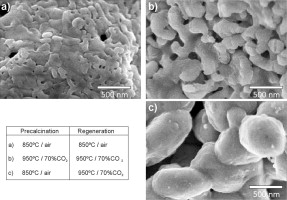
The Ca-looping (CaL) technology is already recognized as a potentially viable method to capture CO2 from postcombustion gas in coal fired power plants. In this process, CO2 is chemisorbed by CaO solid particles derived from precalcination of cheap and widely available natural limestone. The partially carbonated solids are regenerated by calcination under high CO2 concentration. Novel CaL concepts are proposed to further improve the efficiency of the technology such as the introduction of a recarbonation reactor in between the carbonation and calcination stages to mitigate the progressive deactivation of the regenerated CaO. Process simulations aimed at retrieving optimum design parameters and operating conditions to scale-up the technology yield results critically dependent on the multicyclic sorbent performance. Nevertheless, technical limitations usually preclude lab-scale tests from mimicking realistic CaL conditions necessarily involving high CO2 concentration for sorbent regeneration and quick transitions between carbonation and calcination. In this work, a lab-scale experimental analysis is reported on the CaO multicyclic conversion at CaL conditions closely resembling those to be expected in practice. The results presented evidence a relevant role of precalcination conditions. Precalcination in air leads to a strongly adverse effect on the activity of the sorbent regenerated under high CO2 concentration, which is further hindered if a recarbonation stage is introduced. On the other hand, sorbent deactivation is mitigated if precalcination is carried out at conditions similar to those used for sorbent regeneration. In this case, recarbonation helps lessening the loss of multicyclic conversion, which is further enhanced by the synergistic combination with heat pretreatment. Moreover, the present study shows that the kinetics of carbonation is strongly dependent on precalcination and regeneration conditions. The diffusion controlled carbonation phase and recarbonation are intensified if the sorbent is precalcined and regenerated under high CO2 concentration whereas the reaction controlled carbonation phase is notably hampered.
Diciembre, 2014 | DOI: 10.1016/j.apenergy.2014.09.052
Reactividad de Sólidos
Improvement of Vickers hardness measurement on SWNT/Al2O3 composites consolidated by spark plasma sintering
Rodriguez, AM; Lopez, AG; Fernandez-Serrano, A; Poyato, R; Munoz, A; Dominguez-Rodriguez, AJournal of the European Ceramic Society, 34 (2014) 3801-3809
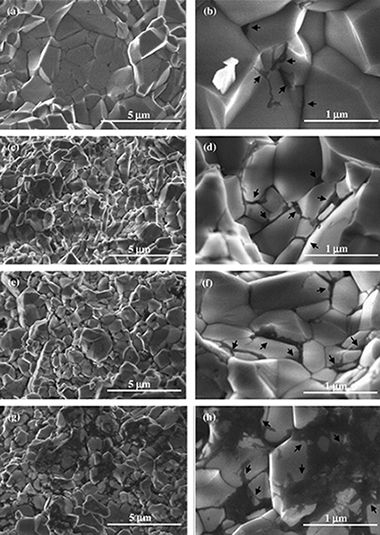
Dense alumina composites with different carbon nanotube content were prepared by colloidal processing and consolidated by Spark Plasma Sintering (SPS). Single-wall carbon nanotubes (SWNTs) were distributed at grain boundaries and also into agglomerates homogeneously dispersed. Carrying out Vickers hardness tests on the cross-section surfaces instead of top (or bottom) surfaces has shown a noticeable increase in the reliability of the hardness measurements. This improvement has been mainly attributed to the different morphology of carbon nanotube agglomerates, which however does not seem to affect the Vickers hardness value. Composites with lower SWNT content maintain the Vickers hardness of monolithic alumina, whereas it significantly decreases for the rest of compositions. The decreasing trend with increasing SWNT content has been explained by the presence of higher SWNT quantities at grain boundaries. Based on the results obtained, a method for optimizing Vickers hardness tests performance on SWNT/Al2O3 composites sintered by SPS is proposed.
Diciembre, 2014 | DOI: 10.1016/j.jeurceramsoc.2014.05.048
Reactividad de Sólidos
Properties of mechanochemically synthesized nanocrystalline Bi2S3 particles
Dutkova, E; Sayagues, MJ; Zorkovska, A; Real, C; Balaz, P; Satka, A; Kovac, JMaterials Science in Semiconductor Processing, 27 (2014) 267-272

Nanocrystalline Bi2S3 particles have been synthesized from Bi and S powders by high-energy milling in a planetary mill. Structural and microstructural characterization of the prepared particles, including phase identification, specific surface area measurement and particle size analysis has been carried out. The optical properties were measured by spectroscopic methods and the structural stability up to 500 °C was studied by thermal analysis. The production of orthorhombic Bi2S3 with crystallite size of about 26 nm was confirmed by X-ray diffraction. The nanocrystals tend to agglomerate due to their large specific surface area. Accordingly, the average hydrodynamic diameter of the mechanochemically synthesized particles is 198 nm. EDS analysis shows that the synthesized material is pure Bi2S3. The band gap of the Bi2S3 nanoparticles is 4.5 eV which is wider than that in bulk materials. The nanoparticles exhibit good luminescent properties with a peak centered at 490 and 390 nm. Differential scanning calorimetry curves exhibit a broad exothermic peak between 200 and 300 °C, suggesting recovery processes. This interpretation is supported by X-ray diffraction measurements that indicate a 10-fold increase of the crystallite size to about 230 nm. The controlled mechanochemical synthesis of Bi2S3 nanoparticles at ambient temperature and atmospheric pressure remains a great challenge.
Noviembre, 2014 | DOI: 10.1016/j.mssp.2014.05.057
Reactividad de Sólidos
Thermal Stability of Multiferroic BiFeO3: Kinetic Nature of the beta-gamma Transition and Peritectic Decomposition
Perejon, A; Sanchez-Jimenez, PE; Criado, JM; Perez-Maqueda, LAJournal of Physical Chemistry C, 118 (2014) 26387-26395
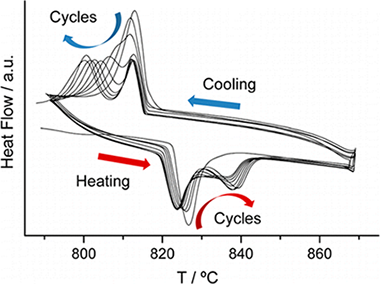
The thermal stability of BiFeO3 prepared by mechanosynthesis and sintered at 850 °C has been studied by DSC as a function of the atmosphere and temperature. It has been found that neither the phase transitions nor the thermal stability of BiFeO3 is affected by the atmosphere in which the heating process is performed. The material is unstable above the α–β transition (TC) and slowly decomposes to produce Bi2O3 and Bi2Fe4O9. The kinetics of this slow process has been studied by performing heating–cooling DSC cycles, concluding it follows an Avrami–Erofeev nucleation and growth kinetic model. The β–γ transition and the peritectic decomposition of BiFeO3 overlap and are kinetically controlled. The kinetics of this complex process has been studied for the first time employing a new kinetic analysis procedure implying the deconvolution and subsequent analysis of the individual contributing stages. Thus, it has been demonstrated that the decomposition of BiFeO3 is accelerated when the sample is heated above the β–γ transition and both processes also follow Avrami–Erofeev kinetic models.
Noviembre, 2014 | DOI: 10.1021/jp507831j
Reactividad de Sólidos
Mechanochemically synthesized nanocrystalline Sb2S3 particles
Dutkova, E; Sayagues, MJ; Real, C; Zorkovska, A; Balaz, P; Satka, A; Kovac, J; Ficeriova, JActa Physica Polonica A, 126 (2014) 943-946
Nanocrystalline Sb2S3 particles have been synthesized from Sb and S powders by high-energy milling in a planetary mill using argon protective atmosphere. X-ray diffraction, particle size analysis, scanning electron microscopy, energy dispersive X-ray spectroscopy, transmission electron microscopy, electron diffraction, high resolution transmission electron microscopy, UV-VIS, and differential scanning calorimetry methods for characterization of the prepared particles were applied. The powder X-ray diffraction pattern shows that Sb2S3 nanocrystals belong to the orthorhombic phase with calculated crystallite size of about 36 nm. The nanocrystalline Sb2S3 particles are constituted by randomly distributed crystalline nanodomains (20 nm) and then these particles are forming aggregates. The monomodal distribution of Sb2S3 particles with the average hydrodynamic parameter 210 nm was obtained. The quantification of energy dispersive X-ray spectroscopy analysis peaks give an atomic ratio of 2:3 for Sb:S. The optical band gap determined from the absorption spectrum is 4.9 eV, indicating a considerable blue shift relative to the bulk Sb2S3. Differential scanning calorimetry curves exhibit a broad exothermic peak between 200 and 300°C, suggesting recovery processes. This interpretation is supported by X-ray diffraction measurements that indicate a 23-fold increase of the crystallite size to about 827 nm as a consequence of application of high temperature process. The controlled mechanochemical synthesis of Sb2S3nanoparticles at ambient temperature and atmospheric pressure remains a great challenge.
Octubre, 2014 | DOI: 10.12693/APhysPolA.126.943
Reactividad de Sólidos
Mechanochemical Processing of CaCu3Ti4O12 with Giant Dielectric Properties
Espinoza-Gonzalez, R; Vega, E; Tamayo, R; Criado, JM; Dianez, MJMaterials and Manufacturing Processes, 29 (2014) 1179-1183
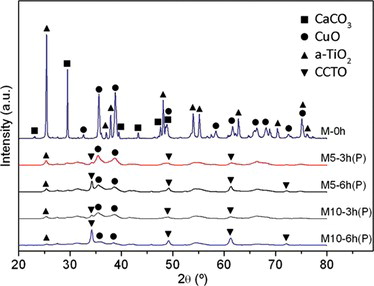
The dielectric properties of CaCu3Ti4O12 (CCTO) ceramic prepared by mechanochemical synthesis (MCS) were investigated. The effect on dielectric properties of ball-to-powder weight ratio and milling time was investigated and compared to the behavior of CCTO prepared by conventional solid state reaction (CSSR). CCTO ceramic was partially obtained after 6h of the milling process, while complete transformation was obtained during the sintering step of milled powders. It was shown that the dielectric properties of CCTO processed by MCS are dramatically improved compared with samples prepared by CSSR.
Octubre, 2014 | DOI: 10.1080/10426914.2014.921702
Reactividad de Sólidos
The Mitigation Effect of Synthetic Polymers on Initiation Reactivity of CL-20: Physical Models and Chemical Pathways of Thermolysis
Yan, QL; Zeman, S; Jimenez, PES; Zhang, TL; Perez-Maqueda, LA; Elbeih, AJournal of Physical Chemistry C, 118 (2014) 22881-22895
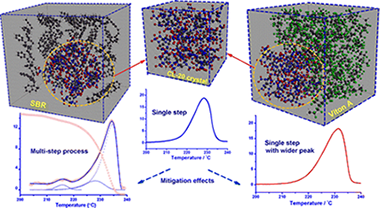
In this paper, the thermal decomposition physical models of different CL-20 polymorph crystals and their polymer bonded explosives (PBXs) bonded by polymeric matrices using polyisobutylene (PIB), acrylonitrile butadiene rubber (NBR), styrene butadiene rubber (SBR), Viton A, and Fluorel binders are obtained and used to predict the temperature profiles of constant rate decomposition. The physical models are further supported by the detailed decomposition pathways simulated by a reactive molecular dynamics (ReaxFF-lg) code. It has been shown that both ε-CL-20 and α-CL-20 decompose in the form of γ-CL-20, resulting in close activation energy (169 kJ mol–1) and physical model (first-order autoaccelerated model, AC1). Fluoropolymers could change the decomposition mechanism of ε-CL-20 from the “first-order autocatalytic” model to a “three-dimensional nucleation and growth” model (A3), while the polymer matrices of Formex P1, Semtex, and C4 could change ε-CL-20 decomposition from a single-step process to a multistep one with different activation energies and physical models. Compared to fluoropolymers, PIB, SBR and NBR may make ε-CL-20 undergo more complete N–NO2 scission before collapse of the cage structure. This is likely the main reason why those polymer bases could greatly mitigate the decomposition process of ε-CL-20 from a single step to a multistep, resulting in lower impact sensitivity, whereas fluoropolymers have only a little effect on that. For ε-CL-20 and its PBXs, the impact sensitivity depends not only on the heat built-up period of their decomposition, but also on the probability of hotspot generation (defects in solid crystals and interfaces) especially when it decomposes in a solid state.
Octubre, 2014 | DOI: 10.1021/jp505955n
Reactividad de Sólidos
Hardness and flexural strength of single-walled carbon nanotube/alumina composites
Gallardo-Lopez, A; Poyato, R; Morales-Rodriguez, A; Fernandez-Serrano, A; Munoz, A; Dominguez-Rodriguez, AJournal of Materials Science, 20 (2014) 7116-7123
This work adds new experimental facts on room temperature hardness and flexural strength of alumina and composites with 1, 2, 5 and 10 vol% single-walled carbon nanotubes (SWNT) with similar grain size. Monolithic Al2O3 and composites were spark plasma sintered (SPS) in identical conditions at 1300 A degrees C, achieving high density, submicrometric grain size and a reasonably homogeneous distribution of SWNT along grain boundaries for all compositions with residual agglomerates. Vickers hardness values comparable to monolithic alumina were obtained for composites with low (1 vol%) SWNT content, though they decreased for higher concentrations, attributed to the fact that SWNT constitute a softer phase. Three-point bending flexural strength also decreased with increasing SWNT content. Correlation between experimental results and microstructural analysis by electron microscopy indicates that although SWNT agglomerates have often been blamed for detrimental effects on the mechanical properties of these composites, they are not the main cause for the reported decay in flexural strength.
Octubre, 2014 | DOI: 10.1007/s10853-014-8419-5
Reactividad de Sólidos
Single phase, electrically insulating, multiferroic La-substituted BiFeO3 prepared by mechanosynthesis
Perejon, A; Sanchez-Jimenez, PE; Perez-Maqueda, LA; Criado, JM; de Paz, JR; Saez-Puche, R; Maso, N; West, ARJournal of Materials Chemistry C, 2 (2014) 8398-8411

Single phase, electrically insulating samples of Bi1−xLaxFeO3 solid solutions have been prepared by mechanosynthesis over the whole compositional range for the first time. Lanthanum substitution influenced the kinetics of the mechanochemical reaction and crystallite size of the products. For 0 ≤ x ≤ 0.15, an increase in the La content produced a significant decrease in the weight-normalized cumulative kinetic energy required to obtain the final product and an increase in the resulting crystallite size. Larger La contents did not affect either the reactivity or the crystallite size. The effect of x on the structure has been identified. Samples in the ranges x ≤ 0.15 and x ≥ 0.45 gave single phase solid solutions with R3c and Pnma space groups, respectively, while for the intermediate range, a non-centrosymetric Pn21a(00γ)s00 super structure was obtained. For 0 ≤ x ≤ 0.30, differential scanning calorimetry showed two endothermic effects corresponding to the Néel temperature (TN, antiferromagnetic–paramagnetic transition) and the Curie temperature (TC, ferroelectric–paraelectric transition), demonstrating their multiferroic character. Compositions with a larger La content only showedTN. Dilatometric and permittivity measurements confirmed the results obtained by DSC for the ferroelectric–paraelectric transition. The composition dependence of TN and TC showed that, at low x, TN < TC, but a cross-over, or isoferroic transition occurred at x [[similar]] 0.28, when TN = TC = 386 °C. Ceramics with 0 ≤ x ≤ 0.15 were highly insulating at room temperature with a resistivity, extrapolated from the Arrhenius plots, of [[similar]] 7 × 1016 to 8 × 1014 Ω cm and an activation energy [[similar]] 1.14–1.20 eV. Magnetization of the samples improved with La substitution.
Octubre, 2014 | DOI: 10.1039/C4TC01426J
Reactividad de Sólidos
Calcium-looping for post-combustion CO2 capture. On the adverse effect of sorbent regeneration under CO2
Valverde, JM; Sanchez-Jimenez, PE; Perez-Maqueda, LAApplied Energy, 126 (2014) 161-171
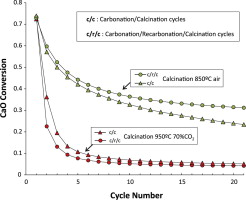
The multicyclic carbonation/calcination (c/c) of CaO solid particles at high temperature is at the basis of the recently emerged Calcium-looping (CaL) technology, which has been shown to be potentially suitable for achieving high and sustainable post-combustion CO2 capture efficiency. Despite the success of pilot plant projects at the MWth scale, a matter of concern for scaling-up the CaL technology to a commercial level (to the GWth scale) is that the CaO carbonation reactivity can be recovered only partially when the sorbent is regenerated by calcination at high temperatures (around 950 °C) as required by the CO2 high concentration in the calciner. In order to reactivate the sorbent, a novel CaL concept has been proposed wherein a recarbonator reactor operated at high temperature/high CO2 concentration leads to further carbonation of the solids before entering into the calciner for regeneration. Multicyclic thermogravimetric analysis (TGA) tests demonstrate the feasibility of recarbonation to reactivate the sorbent regenerated at high calcination temperatures yet at unrealistically low CO2 partial pressure mainly because of technical limitations concerning low heating/cooling rates. We report results from multicyclic c/c and carbonation/recarbonation/calcination (c/r/c) TGA tests at high heating/coling rates and in which the sorbent is regenerated in a dry atmosphere at high CO2 partial pressure. It is shown that at these conditions there is a drastic drop of CaO conversion to a very small residual value in just a few cycles. Moreover, the introduction of a recarbonation stage has actually an adverse effect. Arguably, CaCO3 decomposition in a CO2 rich atmosphere is ruled by CO2 dynamic adsorption/desorption in reactive CaO (1 1 1) surfaces as suggested by theoretical studies, which would preclude the growth of the regenerated CaO crystal structure along these reactive surfaces, and this effect would be intensified by recarbonation. Nevertheless, the presence of H2O in the calciner, which is also adsorbed/desorbed dynamically in CaO reactive planes, would shield CO2 adsorption/desorption thus mitigating the deeply detrimental effect of CO2 on the carbonation reactivity of the regenerated CaO structure. Oxy-combustion, which produces a significant amount of H2O, is currently used in pilot-scale plants to raise the temperature in the calciner. Auxiliary techniques are being explored to help heating the partially carbonated solids since oxyxombustion represents an important penalty to the CaL technology. Our study suggests that steam injection would be necessary in a dry calciner environment to avoid a sharp loss of CaO conversion if the sorbent is regenerated at high CO2 partial pressure.
Agosto, 2014 | DOI: 10.1016/j.apenergy.2014.03.081
Reactividad de Sólidos
Scission kinetic model for the prediction of polymer pyrolysis curves from chain structure
Perez-Maqueda, LA; Sanchez-Jimenez, PE; Perejon, A; Garcia-Garrido, C; Criado, JM; Benitez-Guerrero, MPolymer Testing, 37 (2014) 1-5
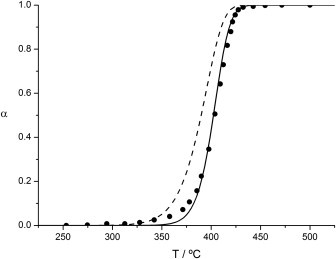
There is a significant interest in correlating polymer structure with thermal degradation behavior. Thus, polymer pyrolysis curves could be predicted from the chemical structure of the polymer. Recent proposals correlate the kinetic temperature function directly with the chemical structure of the polymer by means of the dissociation energy while assuming a semi-empirical first order model for the reaction fraction function. However, a first order model lacks physical meaning and produces significant deviations of the predicted curves, mostly under isothermal conditions. Thus, in this work, an upgrade of the method is proposed by using a new random scission kinetic model. The newly proposed kinetic equation has been checked by fitting the experimental data reported by different authors for the thermal pyrolysis of polystyrene. It has been demonstrated that it accounts for the experimental data of polymer degradation under different heating schedules with considerably higher precision than the previously assumed first order kinetics.
Agosto, 2014 | DOI: 10.1016/j.polymertesting.2014.04.004
Reactividad de Sólidos
Relevant Influence of Limestone Crystallinity on CO2 Capture in The Ca-Looping Technology at Realistic Calcination Conditions
Valverde, JM; Sanchez-Jimenez, PE; Perez-Maqueda, LAEnvironmental Science & Technology, 48 (2014) 9882-9889
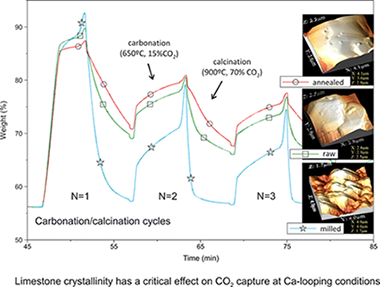
We analyze the role of limestone crystallinity on its CO2 capture performance when subjected to carbonation/calcination cycles at conditions mimicking the Ca-looping (CaL) technology for postcombustion CO2 capture. The behavior of raw and pretreated limestones (milled and thermally annealed) is investigated by means of thermogravimetric analysis (TGA) tests under realistic sorbent regeneration conditions, which necessarily involve high CO2 partial pressure in the calciner and quick heating rates. The pretreatments applied lead to contrasting effects on the solid crystal structure and, therefore, on its resistance to solid-state diffusion. Our results show that decarbonation at high CO2 partial pressure is notably promoted by decreasing solid crystallinity. CaO regeneration is fully achieved under high CO2 partial pressure at 900 °C in short residence times for the milled limestone whereas complete regeneration for raw limestone requires a minimum calcination temperature of about 950 °C. Such a reduction of the calcination temperature and the consequent mitigation of multicyclic capture capacity decay would serve to enhance the efficiency of the CaL technology. On the other hand, the results of our study suggest that the use of highly crystalline limestones would be detrimental since excessively high calcination temperatures should be required to attain full decarbonation at realistic conditions.
Agosto, 2014 | DOI: 10.1021/es5014505
Reactividad de Sólidos
Role of crystal structure on CO2 capture by limestone derived CaO subjected to carbonation/recarbonation/calcination cycles at Ca-looping conditions
Valverde, JM; Sanchez-Jimenez, PE; Perez-Maqueda, LA; Quintanilla, MAS; Perez-Vaquero, JApplied Energy, 125 (2014) 264-275
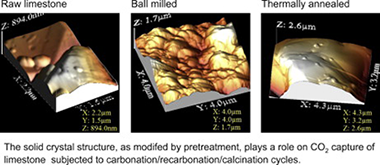
Large scale pilot plants are currently demonstrating the feasibility of the Calcium-looping (CaL) technology built on the multicyclic calcination/carbonation of natural limestone for post-combustion and precombustion CO2 capture. Yet, limestone derived CaO exhibits a drop of conversion when subjected to multiple carbonation/calcination cycles, which lessens the efficiency of the technology. In this paper we analyze a novel CaL concept recently proposed to mitigate this drawback based on the introduction of an intermediate stage wherein carbonation is intensified at high temperature and high CO2 partial pressure. It is shown that carbonation in this stage is mainly driven by solid-state diffusion, which is determined by the solid's crystal structure. Accordingly, a reduction of crystallinity by ball milling, which favors diffusion, serves to promote recarbonation. Conversely, thermal annealing, which enhances crystallinity, hinders recarbonation. An initial fast phase has been identified in the recarbonation stage along which the rate of carbonation is also a function of the crystal structure indicating a relevant role of surface diffusion. This is consistent with a recently proposed mechanism for nucleation of CaCO3 on the CaO surface in islands with a critical size determined by surface diffusion. A further issue analyzed has been the effects of pretreatment and cycling on the mechanical strength of the material, whose fragility hampers the CaL process efficiency. Particle size distribution of samples dispersed in a liquid and subjected to high energy ultrasonic irradiation indicate that milling promotes friability whereas thermal annealing enhances the resistance of the particles to fragmentation even though pretreatment effects become blurred after cycling. Our study demonstrates that recarbonation conditions and crystal-structure controlled diffusion are important parameters to be considered in order to assess the efficiency of CO2 capture in the novel CaL concept.
Julio, 2014 | DOI: 10.1016/j.apenergy.2014.03.065
Reactividad de Sólidos
Enhanced oxidation resistance of Ti(C,N)-based cermets containing Ta
Chicardi, E; Gotor, FJ; Cordoba, JMCorrosion Science, 84 (2014) 11-20
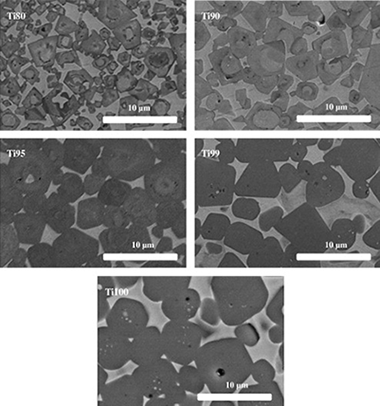
(TixTa1−x)(C0.5N0.5)–Co-based cermets with various Ta contents (x = 0, 0.01, 0.05, 0.1 and 0.2) were oxidized at 900 °C for 48 h in static air. A parabolic rate law, which is indicative of the formation of a protective oxide layer, was observed for all samples. The multi-layered oxide scale and the internal oxidation region that formed as the oxidation progressed toward the interior of the cermet specimens were characterized using XRD, SEM and EDS. The enhanced oxidation resistance achieved in cermets composed by a hard component with stoichiometry Ti0.95Ta0.05C0.5N0.5 may satisfy the optimal requirements for many applications in the field of cutting tools.
Julio, 2014 | DOI: 10.1016/j.corsci.2014.03.007
Reactividad de Sólidos
Multicyclic conversion of limestone at Ca-looping conditions: The role of solid-sate diffusion controlled carbonation
Sanchez-Jimenez, PE; Valverde, JM; Perez-Maqueda, LAFuel, 127 (2014) 131-140
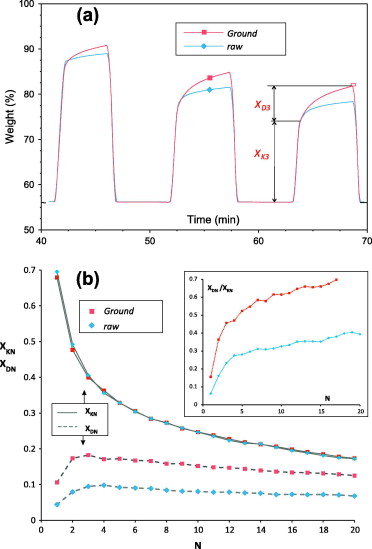
Limestone derived CaO conversion when subjected to multiple carbonation/calcination cycles is a subject of interest currently fueled by several industrial applications of the so-called Ca-looping (CaL) technology. The multicyclic CaO conversion at Ca-looping conditions exhibits two main features as demonstrated by thermogravimetric analysis (TGA). On one hand, carbonation occurs by two well differentiated phases: a first kinetically-driven fast phase and a subsequent much slower solid-state diffusion controlled phase. On the other, carbonation in the fast phase usually shows a drastic decay with the cycle number along the first carbonation/calcination cycles. This trend can be reversed by means of heat pretreatment, which induces a marked loss of fast conversion in the first carbonation but enhances diffusion of CO2 in the solid. Upon decarbonation the regenerated CaO skeleton displays an increased conversion in the fast carbonation phase of the next cycle, a phenomenon which has been referred to as reactivation. Nonetheless, sorbent reactivation is hampered by looping carbonation/calcination conditions as those to be likely found in practice such as carbonation stages characterized by low CO2 concentrations and short duration and calcination stages at high temperatures in a CO2 enriched atmosphere, which causes a sintering and loss of activity of the regenerated CaO skeleton. We analyze in this work sorbent reactivation as affected by heat pretreatment and carbonation/calcination conditions. Aimed at shedding light on the role played by these conditions on reactivation we look separately at the multicyclic evolution of conversion in the kinetic and diffusive phases. Generally, the evolution of multicyclic conversion after the first cycle can be described by a balance between the surface area gain due to diffusive carbonation and the surface area loss as caused by sintering in the calcination stage. A significant gain of relative surface area after the first cycle, which is favored by harshening the heat pretreatment conditions, leads however to a marked decay of it during subsequent cycles, which precludes reactivation for an extended interval of cycles. On the other hand, sorbent grinding, if performed before heat pretreatment, leads to a less marked but more sustainable reactivation along the cycles. A novel observation reported in our work is that pretreatment of limestone in a CO2 atmosphere leads upon a subsequent quick decarbonation to a CaO skeleton with extraordinarily enhanced reactivity in the kinetically-driven carbonation phase and with a high resistance to solid-state diffusion, which can be attributed to annealing of the crystal structure as reported by independent studies.
Julio, 2014 | DOI: 10.1016/j.fuel.2013.09.064
Reactividad de Sólidos
The role of boron oxide and carbon amounts in the mechanosynthesis of ZrB2–SiC–ZrC nanocomposite via a self-sustaining reaction in the zircon/magnesium/boron oxide/graphite system
Jalaly, M; Bafghi, MS; Tamizifar, M; Gotor, FJJournal of Alloys and Compounds, 598 (2014) 113-119
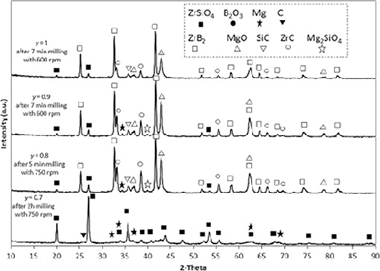
Herein, ZrSiO4/B2O3/Mg/C system was used to synthesize a ZrB2-based composite by means of a high energy ball milling process. A mechanically induced self-sustaining reaction was achieved in this system. A nanocomposite powder of ZrB2–SiC–ZrC was prepared with an ignition time of approximately 6 min of milling. The role of the stoichiometric amounts of B2O3 and carbon was investigated to clarify the governing mechanism for the formation of the product.
Junio, 2014 | DOI: 10.1016/j.jallcom.2014.02.033
Materials characteristics of Roman and Arabic mortars and stuccoes from The Patio de Banderas in the Real Alcazar of Seville (SPAIN)
Garofano, I; Robador, MD; Duran, AArchaeometry, 56 (2014) 541-561
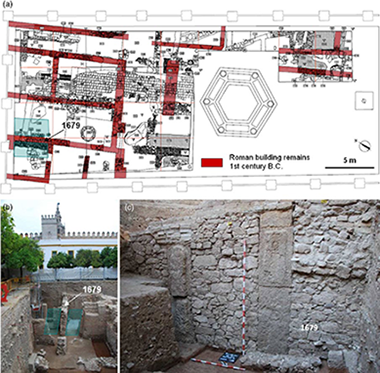
This study discusses the materials and traditional knowledge used in the manufacture and application of lime mortars and stuccoes by Romans and Arabs in Seville (southern Iberian Peninsula). All of the samples studied contain calcite as a binder, combined with aggregates based on river sand from the filling materials of the Guadalquivir River's depression, located in the vicinity of the Real Alcazar Palace in Seville, Spain, where the artefacts were discovered. The Romans used high-quality production technology, as evidenced by the careful selection of raw materials as well as by the adequate binder-to-aggregate ratio and the elevated homogeneity of the mortars and stuccoes. The suitable distribution of aggregates resulted in higher density values for Roman fragments than for Arabic ones. Results derived from Arabic samples suggest a decline in technology manufacture over time. This work provides useful information, particularly regarding the Roman and Arabic periods in the Iberian Peninsula. The analytical techniques employed in this study were X-ray diffraction (XRD), X-ray fluorescence (XRF)—using conventional and portable systems, scanning electron microscopy (SEM), petrographic microscopy, differential thermal analysis/thermogravimetry (DTA/TG), particle-size analysis and mercury intrusion porosimetry.
Junio, 2014 | DOI: 10.1111/arcm.12041
Reactividad de Sólidos
Improvement of the thermal stability of branched poly(lactic acid) obtained by reactive extrusion
Carrasco, F; Cailloux, J; Sanchez-Jimenez, PE; Maspoch, MLPolymer Degradation and Stability, 104 (2014) 40-49
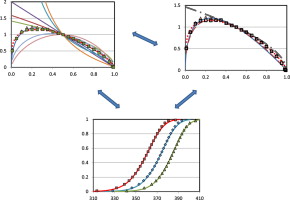
One-step reactive extrusion-calendering process (REX-calendering) has been used in order to obtain sheets of 1 mm from poly(lactic acid) modified with a styrene-acrylic multifunctional oligomeric agent. In a preliminary internal mixer study, torque versus time has been monitored in order to ascertain chain extender ratios and reaction time. Once all the parameters were optimized, reactive extrusion experiments have been performed. An enhanced general analytical equation has been developed in order to evaluate the kinetic parameters of the thermal degradation of PLA sheets manufactured by reactive extrusion. This improvement has consisted of replacing the n-order conversion function by a modified form of the Sestak–Berggren equation f(α) = c (1 − α)nαm that led to a better adjustment of experimental data and also adequately represented the conventional mechanisms for solid-state processes. The kinetic parameters so obtained have been compared to those determined by conventional differential methods and n-order reaction kinetics. Given that the thermal degradation of PLA has been argued to be caused by random chain scission reactions of ester groups, the conversion function f(α) = 2 (α1/2 − α), corresponding to a random scission mechanism for L = 2 (as well as other functions for L values up to 8), has been tested. Once optimized the kinetic model, the thermal degradation kinetics of sheets obtained by REX-calendering process was compared to that of conventional sheets and polymer matrix.
Junio, 2014 | DOI: 10.1016/j.polymdegradstab.2014.03.026
Reactividad de Sólidos
Effect of high SWNT content on the room temperature mechanical properties of fully dense 3YTZP/SWNT composites
Poyato, R; Gallardo-Lopez, A; Gutierrez-Mora, F; Morales-Rodriguez, A; Munoz, A; Dominguez-Rodriguez, AJournal of the European Ceramic Society, 34 (2014) 1571-1579
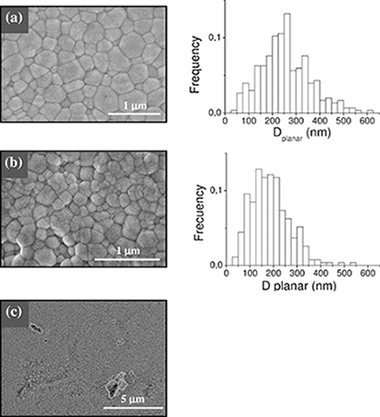
This paper is devoted to correlate the microstructure and room temperature mechanical properties of single-wall carbon nanotube (SWNT) reinforced 3 mol% yttria stabilized tetragonal zirconia with high SWNT content (2.5, 5 and 10 vol%). Fully dense composites were prepared by using a combination of aqueous colloidal powder processing and Spark Plasma Sintering. SWNTs were located at the ceramic grain boundaries and they were not damaged during the sintering process. The weak interfacial bonding between SWNTs and ceramic grains together with the detachment of SWNTs within thick bundles have been pointed out as responsible for the decrease of hardness and fracture toughness of the composites in comparison with the monolithic 3YTZP ceramic.
Junio, 2014 | DOI: 10.1016/j.jeurceramsoc.2013.12.024
Reactividad de Sólidos
Processing and characterisation of cermet/hardmetal laminates with strong interfaces
Gotor, FJ; Bermejo, R; Cordoba, JM; Chicardi, E; Medri, V; Fabbriche, DD; Torres, YMaterials & Design, 58 (2014) 226-233
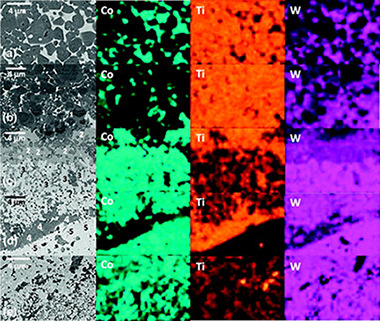
Cemented carbides and cermets are potential materials for high speed machining tools. However, cemented carbides are not chemically stable at high temperature and cermets present poor fracture toughness. Novel cermet/hardmetal multilayer systems show a huge potential for this intended application. It would be possible to achieve the right balance of the required thermomechanical properties using cermet as temperature protective outer layers and hardmetal as reinforcement layers. In this work, preliminary results on the microstructural and mechanical characterisation of a multilayer TiCxN1−x–Co/WC–Co composite densified by hot pressing are presented, with special attention to the properties of the interface. Microstructural observations revealed the existence of strong bonding interfaces between cermet and hardmetal layers due to chemical interaction during the sintering process. As a consequence, owing to the different coefficient of thermal expansion between cermet and hardmetal, a tensile and compressive biaxial residual stress of σres,Cermet ≈ +260 ± 50 MPa and σres,WC–Co ≈ −350 ± 70 MPa was estimated in the corresponding layers. Microindentation cracks introduced in the cermet layers (the less toughness material) and propagated transversely to the layers were arrested at the interface, showing the combined effect of toughness and compressive stresses on crack shielding.
Junio, 2014 | DOI: 10.1016/j.matdes.2014.01.076
Reactividad de Sólidos
Effect of Heat Pretreatment/Recarbonation in the Ca-Looping Process at Realistic Calcination Conditions
Valverde, JM; Sanchez-Jimenez, PE; Perez-Maqueda, LAEnergy & Fuels, 27 (2014) 4062-4067
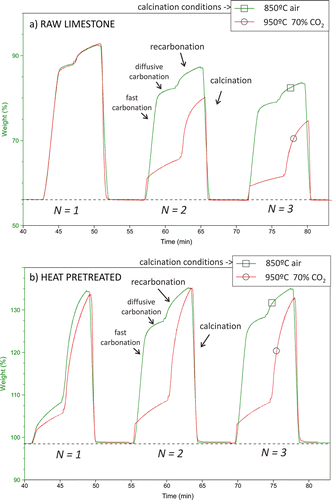
Even though an increasing number of pilot-scale plants are demonstrating the potential efficiency of the Ca-looping technology to capture CO2 at a commercial level, a still standing matter of concern is the loss of carbonation reactivity of the regenerated CaO by calcination, which is expected to be particularly marked at realistic conditions necessarily implying a high CO2 partial pressure in the calciner. In this work, we address the effect of previously reported strategies for sorbent reactivation, namely heat pretreatment and the introduction of a recarbonation stage before regeneration. Both techniques, either combined or separately, are shown to favor the carbonation reactivity, albeit CaO regeneration is usually carried out at low CO2 partial pressure in lab-scale tests. Novel results reported in this paper show the opposite when the sorbent is regenerated by calcination at high CO2 concentration, which is arguably due to the diverse mechanisms that rule decarbonation depending on the CO2 concentration in the calciner atmosphere. Dynamic and reversible adsorption/desorption of CO2 is thought to govern decarbonation during calcination at high CO2 partial pressure, which would be hindered by the introduction of a recarbonation stage before carbonation. Moreover, carbonation in the fast phase is severely hampered as a result of the marked loss of reactivity of the surface of CaO regenerated under high CO2 partial pressure. On the other hand, heat pretreatment and harsh calcination conditions lead to a notable enhancement of diffusion, which would favor the process efficiency. In these conditions, diffusion controlled carbonation becomes a significant contribution to CaO conversion, which is notably increased by prolonging the carbonation stage. Heat pretreatment allows also reducing the calcination temperature at high CO2 partial pressure while still achieving full decarbonation in short residence times.
Junio, 2014 | DOI: 10.1021/ef5007325
Reactividad de Sólidos - Química de Superficies y Catálisis
Phase assembly and electrical conductivity of spark plasma sintered CeO2-ZrO2 ceramics
Poyato, R; Cruz, SA; Cumbrera, FL; Moreno, B; Chinarro, E; Odriozola, JAJournal of Materials Science, 49 (2014) 6353-6362

Cex Zr1−x O2 (x = 0.10, 0.16 and 0.33) nanocrystalline powders were obtained by a two-step synthesis technique and sintered by spark plasma sintering (SPS). As consequence of the reduction of Ce4+ to Ce3+ species by carbon in the graphite environment in SPS, phase assemblies including tetragonal, monoclinic and pyrochlore phases were generated in the ceramics during the sintering process. The electrical conductivity was highly dependent on phase assembly and atmosphere (N2, H2 and O2). A significant decrease in the activation energy was noticed in the ceramics with high pyrochlore content when measuring the conductivity in H2 atmosphere, consequence of the strong reduction promoted in these ceramics during the measurement. Equal conduction behavior with similar activation energy was observed in all the ceramics when measuring in O2 atmosphere.
Junio, 2014 | DOI: 10.1007/s10853-014-8361-6
Reactividad de Sólidos
High and stable CO2 capture capacity of natural limestone at Ca-looping conditions by heat pretreatment and recarbonation synergy
Valverde, JM; Sanchez-Jimenez, PE; Perez-Maqueda, LAFuel, 123 (2014) 79-85
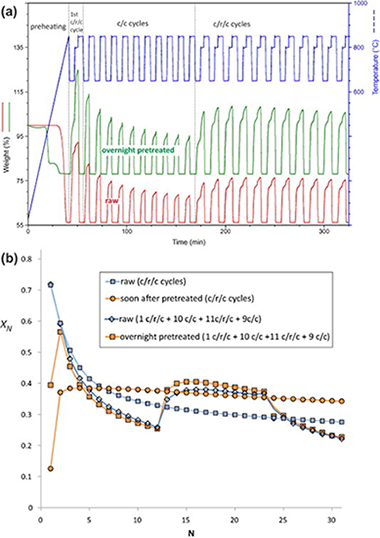
The Ca-looping (CaL) process, based on the multicyclic carbonation/calcination of limestone derived CaO, has emerged recently as a potentially economically advantageous technology to achieve sustainable postcombustion and precombustion CO2 capture efficiencies. Yet, a drawback that hinders the efficiency of the CaL process is the drastic drop of limestone capture capacity as the number of carbonation/calcination cycles is increased. Precalcination of limestone at high temperatures for a prolonged period of time has been proposed as a potential technique to reactivate the sorbent, which is however precluded by regeneration temperatures above 850 degrees C and low CO2 concentrations in the carbonator to be found in the practical situation. Under these conditions, heat pretreatment leads to a stable yet very small CaO conversion. On the other hand, the introduction of a recarbonation stage between the ordinary carbonation and calcination stages has been shown to decelerate the rate of sorbent activity decay even though this favorable effect is not noticeable up to a number of above 10-15 cycles. The present manuscript demonstrates that the synergetic action of heat pretreatment and recarbonation yields a high and stable value for the multicyclic conversion of limestone derived CaO. It is foreseen that recarbonation of heat pretreated limestone would lead to a reduction of process costs especially in the case of precombustion applications. Even though sorbent purging will always be needed because of ash accumulation and sul-phation in postcombustion CO2 capture applications, the stable and high multicyclic CaO conversion achieved by the combination of these techniques would make it necessary to a lesser extent.
Mayo, 2014 | DOI: 10.1016/j.fuel.2014.01.045
Reactividad de Sólidos
Chemical and electrical properties of LSM cathodes prepared by mechanosynthesis
Moriche, R.; Marrero-López, D.; Gotor, F.J.; Sayagués, M.J.Journal of Power Sources, 252 (2014) 43-50
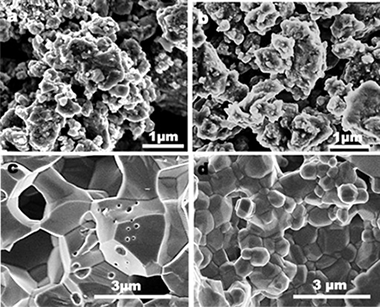
Mechanosynthesis of La1−xSrxMnO3 (x = 0, 0.25, 0.5, 0.75 and 1) was carried out at room temperature from stoichiometric mixtures of La2O3, Mn2O3 and SrO, obtaining monophasic powders with the perovskite structure. Physical properties of these materials and their chemical compatibility with the electrolyte yttria stabilized zirconia (YSZ), which depend strongly on the La/Sr ratio, were evaluated to corroborate availability to be implemented as cathode material in solid oxide fuel cells (SOFCs). Electrical conductivity values in air ranged between 100 and 400 S cm−1 in the temperature range of 25–850 °C. Samples presented low reactivity with YSZ in the working temperature range (600–1000 °C) maintaining the grain size small enough to preserve the catalytic activity for oxygen reduction.
Abril, 2014 | DOI: 10.1016/j.jpowsour.2013.11.093
Reactividad de Sólidos
Self-propagating combustion synthesis via an MSR process: An efficient and simple method to prepare (Ti, Zr, Hf)B2–Al2O3 powder nanocomposites
Sayagues, MJ; Aviles, MA; Cordoba, JM; Gotor, FJPowder Technology, 256 (2014) 244-250
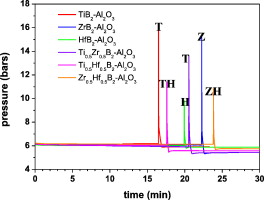
The synthesis of (Ti1 − xZrx)B2–Al2O3, (Ti1 − xHfx)B2–Al2O3 and (Zr1 − xHfx)B2–Al2O3 (x = 0, 0.5 and 1) powder nanocomposites via a mechanochemical method using TiO2, ZrO2, HfO2, HBO2 and Al as the raw materials was investigated. The formation of the nanocomposites proceeds via a mechanically-induced self-sustaining reaction (MSR) process that involves several simultaneous reactions. The aluminothermic reductions of the TMO2 and HBO2 produce Al2O3 and transition metal and boron elements, which in turn react to yield the diboride phase. The ignition of the complex combustion reaction occurred after a short milling time (15–30 min), instantly transforming most of the reactants into products. The sample composition was marked by the stoichiometry of the combustion reaction, and the resulting nanocomposites were analysed using XRD, ED, SEM, TEM and EDX techniques. The X-ray results confirmed the biphasic character of the prepared composite powder (TMB2 and Al2O3 structures); minor amounts of the Zr and Hf oxides were also observed. The achieved microstructure was characterised by the agglomeration of Al2O3 nanocrystallites and diboride crystals with a diffraction domain size ranging between 100 and 300 nm.
Abril, 2014 | DOI: 10.1016/j.powtec.2014.02.031
Reactividad de Sólidos
Nanosilica supported CaO: A regenerable and mechanically hard CO2 sorbent at Ca-looping conditions
Sanchez-Jimenez, PE; Perez-Maqueda, LA; Valverde, JMApplied Energy, 118 (2014) 92-99
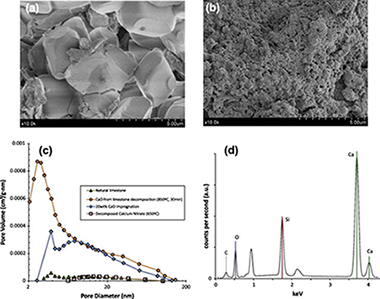
This work presents a CO2 sorbent that may be synthesized from low-cost and widely available materials following a simple method basically consisting of impregnation of a nanostructured silica support with a saturated solution of calcium nitrate. In a first impregnation stage, the use of a stoichiometric CaO/SiO2 ratio serves to produce a calcium silicate matrix after calcination. This calcium silicate matrix acts as a thermally stable and mechanically hard support for CaO deposited on it by further impregnation. The CaO-impregnated sorbent exhibits a stable CaO conversion at Ca-looping conditions whose value depends on the CaO wt% deposited on the calcium silicate matrix, which can be increased by successive reimpregnations. A 10 wt% CaO impregnated sorbent reaches a stable conversion above 0.6 whereas the stable conversion of a 30 wt% CaO impregnated sorbent is around 0.3, which is much larger than the residual conversion of CaO derived from natural limestone (between 0.07 and 0.08). Moreover, particle size distribution measurements of samples predispersed in a liquid and subjected to high energy ultrasonic waves indicate that the CaO-impregnated sorbent has a relatively high mechanical strength as compared to limestone derived CaO.
Abril, 2014 | DOI: 10.1016/j.apenergy.2013.12.024
Química de Superficies y Catálisis
Understanding the Role of the Cosolvent in the Zeolite Template Function of Imidazolium-Based Ionic Liquid
Ayala, R; Ivanova, S; Blanes, JMM; Romero-Sarria, F; Odriozola, JAJournal of Physical Chemistry B, 118 (2014) 3650–3660

In this work, a study for understanding the role played by [ClBmim], [BF4Bmim], [PF6Bmim], and [CH3SO3Bmim] ionic liquids (ILs) in the synthesis of zeolites is presented. The use of [ClBmim] and [CH3SO3Bmim] ILs, as reported earlier [ Chem. Eur. J. 2013, 19, 2122] led to the formation of MFI or BEA type zeolites. Contrary, [BF4Bmim] and [PF6Bmim] ILs did not succeed in organizing the Si–Al network into a zeolite structure. To try to explain these results, a series of quantum mechanical calculations considering monomers ([XBmim]) and dimers ([XBmim]2) by themselves and plus cosolvent (water or ethanol) were carried out, where X ≡ Cl–, BF4–, PF6–, or CH3SO3–. Our attention was focused on the similarities and differences among the two types of cosolvents and the relation between the structure and the multiple factors defining the interactions among the ILs and the cosolvent. Although a specific pattern based on local structures explaining the different behavior of these ILs as a zeolite structuring template was not found, the calculated interaction energies involving the Cl– and CH3SO3– anions were very close and larger than those for BF4– and PF6– species. These differences in energy can be used as an argument to describe their different behavior as structure directing agents. Moreover, the topology of the cosolvent is also an ingredient to take into account for a proper understanding of the results.
Abril, 2014 | DOI: 10.1021/jp410260g
Reactividad de Sólidos
The effect of polymer matrices on the thermal hazard properties of RDX-based PBXs by using model-free and combined kinetic analysis
Yan, QL; Zeman, S; Jimenez, PES; Zhao, FQ; Perez-Maqueda, LA; Malek, JJournal of Hazardous Materials, 271 (2014) 185-195
In this paper, the decomposition reaction models and thermal hazard properties of 1,3,5-trinitro-1,3,5-triazinane (RDX) and its PBXs bonded by Formex P1, Semtex 1A, C4, Viton A and Fluorel polymer matrices have been investigated based on isoconversional and combined kinetic analysis methods. The established kinetic triplets are used to predict the constant decomposition rate temperature profiles, the critical radius for thermal explosion and isothermal behavior at a temperature of 82 C. It has been found that the effect of the polymer matrices on the decomposition mechanism of RDX is significant resulting in very different reaction models. The Formex P1, Semtex and C4 could make decomposition process of RDX follow a phase boundary controlled reaction mechanism, whereas the Viton A and Fluorel make its reaction model shifts to a two dimensional Avrami-Erofeev nucleation and growth model. According to isothermal simulations, the threshold cook-off time until loss of functionality at 82 degrees C for RDX-C4 and RDX-FM is less than 500 days, while it is more than 700 days for the others. Unlike simulated isothermal curves, when considering the charge properties and heat of decomposition, RDX-FM and RDX-C4 are better than RDX-SE in storage safety at arbitrary surrounding temperature.
Abril, 2014 | DOI: 10.1016/j.jhazmat.2014.02:019
Reactividad de Sólidos
Comparison of thermal behavior of natural and hot-washed sisal fibers based on their main components: Cellulose, xylan and lignin. TG-FTIR analysis of volatile products
Benitez-Guerrero, M; Lopez-Beceiro, J; Sanchez-Jimenez, PE; Pascual-Cosp, JThermochimica Acta, 581 (2014) 70-86
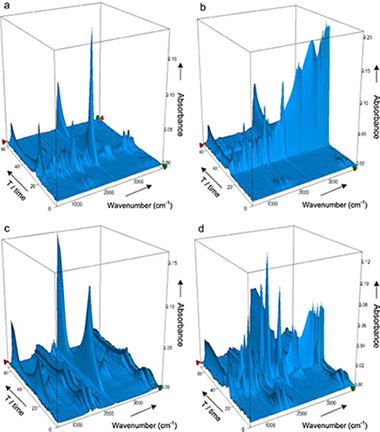
This paper presents in a comprehensive way the thermal behavior of natural and hot-washed sisal fibers, based on the fundamental components of lignocellulosic materials: cellulose, xylan and lignin. The research highlights the influence exerted on the thermal stability of sisal fibers by other constituents such as non-cellulosic polysaccharides (NCP) and mineral matter.
Thermal changes were investigated by thermal X-ray diffraction (TXRD), analyzing the crystallinity index (%Ic) of cellulosic samples, and by simultaneous thermogravimetric and differential thermal analysis coupled with Fourier-transformed infrared spectrometry (TG/DTA-FTIR), which allowed to examine the evolution of the main volatile compounds evolved during the degradation under inert and oxidizing atmospheres. The work demonstrates the potential of this technique to elucidate different steps during the thermal decomposition of sisal, providing extensible results to other lignocellulosic fibers, through the analysis of the evolution of CO2, CO, H2O, CH4, acetic acid, formic acid, methanol, formaldehyde and 2-butanone, and comparing it with the volatile products from pyrolysis of the biomass components. The hydroxyacetaldehyde detected during pyrolysis of sisal is indicative of an alternative route to that of levoglucosan, generated during cellulose pyrolysis.
Hot-washing at 75 °C mostly extracts non-cellulosic components of low decomposition temperature, and reduces the range of temperature in which sisal decomposition occurs, causing a retard in the pyrolysis stage and increasing TbNCP and TbCEL, temperatures at the maximum mass loss rate of non-cellulosic polysaccharides and cellulose decompositions, respectively. However, enriching sisal fibers in cellulose produces a decrease of TbCEL under an oxidizing atmosphere, and furthermore, a delay of the combustion process, displacing TbCOM to higher temperatures.
The results and findings of the paper would help further understanding of thermal processes where Agave fibers are involved, as the decomposition of their composites.
Abril, 2014 | DOI: 10.1016/j.tca.2014.02.013
Mineralogical Characterization of the Polychrome in Cultural Heritage Artifacts (Antiquity to Date) from Southern Spain Using Micro-Raman Spectroscopy and Complementary Techniques
Perez-Rodriguez, JL; Duran, ASpectroscopy Letters: An International Journal for Rapid Communication, 47 (2014) 223-237
This work reports on the use of micro-Raman spectroscopy for the characterization of materials used for producing the polychrome in cultural heritage artifacts from southern Spain. The micro-Raman technique was applied for the characterization of several types of artworks or for cross-sections from these works, which were produced along different historical epochs. This technique was demonstrated to be valuable for the characterization of compounds, which were all detected within the artworks studied. The identification of all of these compounds by micro-Raman was confirmed by other complementary techniques, such as micro-X-ray diffraction and scanning electron microscopy coupled with energy-dispersive X-ray spectroscopy.
Marzo, 2014 | DOI: 10.1080/00387010.2013.791857
Reactividad de Sólidos
An investigation on the formation mechanism of nano ZrB2 powder by a magnesiothermic reaction
Jalaly, M; Bafghi, MS; Tamizifar, M; Gotor, FJJournal of Alloys and Compounds, 588 (2014) 36-41
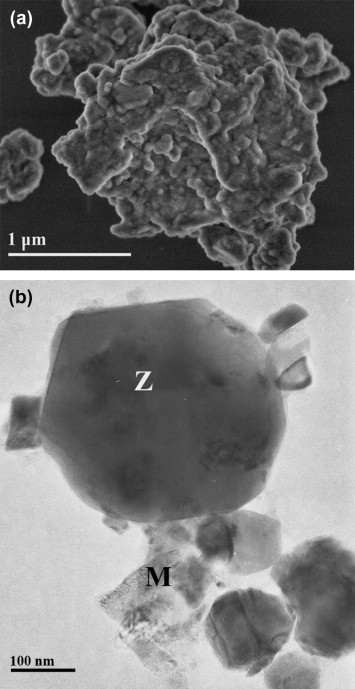
Nanocrystalline zirconium diboride (ZrB2) powder was produced by mechanochemistry from the magnesiothermic reduction in the Mg/ZrO2/B2O3 system. The use of high-energy milling conditions was essential to induce a mechanically induced self-sustaining reaction (MSR) and significantly reduce the milling time required for complete conversion. Under these conditions, it was found that the ignition time for ZrB2 formation was only about a few minutes. In this study, the mechanism for the formation of ZrB2 in this system was determined by studying the relevant sub-reactions, the effect of stoichiometry, and the thermal behavior of the system.
Marzo, 2014 | DOI: 10.1016/j.jallcom.2013.11.050
Propiedades mecánicas, modelización y caracterización de cerámicos avanzados
Additive-free superhard B4C with ultrafine-grained dense microstructures
Moshtaghioun, BM; Cumbrera, FL; Ortiz, AL; Castillo-Rodriguez, M; Gomez-Garcia, DJournal of the European Ceramic Society, 34 (2014) 841-848
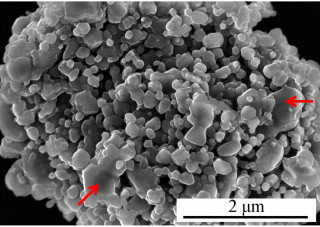
A unique combination of high-energy ball-milling, annealing, and spark-plasma sintering has been used to process superhard B4C ceramics with ultrafine-grained, dense microstructures from commercially available powders, without sintering additives. It was found that the ultrafine powder prepared by high-energy ball-milling is hardly at all sinterable, but that B2O3 removal by gentle annealing in Ar provides the desired sinterability. A parametric study was also conducted to elucidate the role of the temperature (1600–1800 °C), time (1–9 min), and heating ramp (100 or 200 °C/min) in the densification and grain growth, and thus to identify optimal spark-plasma sintering conditions (i.e., 1700 °C for 3 min with 100 °C/min) to densify completely (>98.5%) the B4C ceramics with retention of ultrafine grains (∼370 nm). Super-high hardness of ∼38 GPa without relevant loss of toughness (∼3 MPa m1/2) was thus achieved, attributable to the smaller grain size and to the transgranular fracture mode of the B4C ceramics.
Marzo, 2014 | DOI: 10.1016/j.jeurceramsoc.2013.10.006
Reactividad de Sólidos
Analysis on the mechanical strength of WC-Co cemented carbides under uniaxial and biaxial bending
Torres, Y; Bermejo, R; Gotor, FJ; Chicardi, E; Llanes, LMaterials & Design, 55 (2014) 851-856

The mechanical strength of three WC-Co grades was determined and compared under uniaxial and biaxial bending. Uniaxial four-point bending was conducted on bar-shaped specimens; biaxial testing was performed on discs using the ball-on-three-balls (B3B) method. Strength results were analysed within the frame of the Weibull theory. Differences in characteristic strength between uniaxial and biaxial bending were explained as an effect of the effective surface tested in each case. A higher Weibull modulus was obtained in one grade, independent of the testing method, which was related to its higher fracture toughness. The use and validity of the B3B biaxial test to determine the strength distribution of cemented carbides is discussed.
Marzo, 2014 | DOI: 10.1016/j.matdes.2013.10.051
Reactividad de Sólidos
Enhanced general analytical equation for the kinetics of the thermal degradation of poly(lactic acid)/montmorillonite nanocomposites driven by random scission
Carrasco, F; Perez-Maqueda, LA; Santana, OO; Maspoch, MLPolymer Degradation and Stability, 101 (2014) 52-59
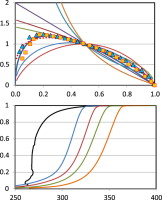
An enhanced general analytical equation has been developed in order to evaluate the kinetic parameters of the thermal degradation of nanocomposites, composed of poly(lactic acid) (PLA) and organo-modified montmorillonite (OMMT) nanoparticles. This improvement has consisted of replacing the n-order conversion function by a modified form of the Sestak–Berggren equation f(α) = c (1 − α)nαm that led to a better adjustment of experimental data and also adequately represented the conventional mechanisms for solid-state processes. The kinetic parameters so obtained have been compared to those determined by conventional differential and isoconversional methods. Given that the thermal degradation of PLA has been argued to be caused by random chain scission reactions of ester groups, the conversion function f(α) = L (L − 1)x(1 − x)L−1, corresponding to a random scission mechanism, has been tested. Once optimized the kinetic model, the thermal degradation kinetics of nanocomposites (0.5 and 2.5% of OMMT) was compared to that of the polymer matrix. Moreover, the thermal stability of nanocomposites was tested and compared to that of the polymer matrix.
Marzo, 2014 | DOI: 10.1016/j.polymdegradstab.2014.01.014
Study and restoration of the Seville City Hall facade
Robador, MD; Arroyo, F; Perez-Rodriguez, JLConstruction and Building Materials, 53 (2014) 370-380
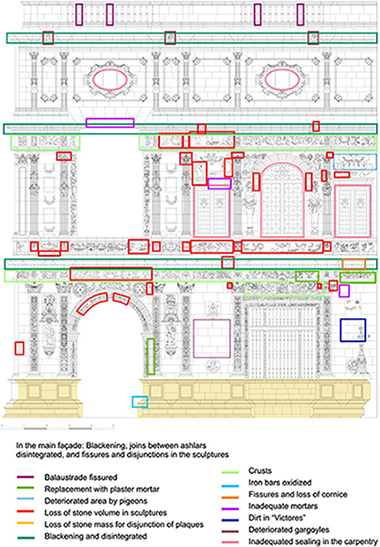
Before restoring the Seville City Hall façade, a study of the original materials and the compounds added or formed was performed. The stone is fine-grained carbonate rock. Gypsum and mortars were used to restore stone fragments. A black crust was also found the wall was covered with an acrylic resin. A layer of lime on the surface was also detected. The restoration was intended to preserve the artistic quality and uniqueness of this building. The cleaning, reinforcing and innovatively consolidating and protecting the stone using suitable materials similar to those used in the original construction are described in this study.
Febrero, 2014 | DOI: 10.1016/j.conbuildmat.2013.11.088
Reactividad de Sólidos - Materiales y Procesos Catalíticos de Interés Ambiental y Energético
Spinodal decomposition and precipitation in Cu–Cr nanocomposite
Sheibani, S; Heshmati-Manesh, S; Ataie, A; Caballero, A; Criado, JMJournal of Alloys and Compounds, 587 (2014) 670-676
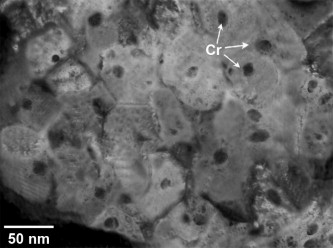
In this study, spinodal decomposition and precipitation mechanism of mechanically alloyed supersaturated Cu–3wt.%Cr and Cu–5wt.%Cr solid solutions was investigated under nonisothermal aging. Decomposition mechanism and kinetics were studied using differential scanning calorimetry (DSC) and X-ray diffraction (XRD) techniques. Also, the microstructure was characterized by transmission electron microscopy (TEM). Effect of Al2O3 reinforcement on the aging kinetics was also evaluated. It was found that Cu–3wt.%Cr and Cu–5wt.%Cr solid solutions undergo spinodal decomposition at initial stages of ageing. However, decomposition mechanism was changed to nucleation and growth by the aging progress. The aging kinetics for the Cu–Cr/Al2O3 composition appeared to be slightly faster than that for Cu–Cr, since the ageing activation energy is decreased in presence of Al2O3 nano-particles. This behavior is probably due to the higher dislocation density and other structural defects previously produced during ball milling. A detailed comparison of the DSC results with those obtained by TEM, showing good consistency, has been presented. The average size of Cr-rich precipitates was about 10 nm in the copper matrix.
Febrero, 2014 | DOI: 10.1016/j.jallcom.2013.11.019
Química de Superficies y Catálisis
Wall paintings studied using Raman spectroscopy: A comparative study between various assays of cross sections and external layers
Perez-Rodriguez, JL; Robador, MD; Centeno, MA; Siguenza, B; Duran, ASpectrochimica Acta Part A: Molecular and Biomolecular Spectroscopy, 120 (2014) 602-609
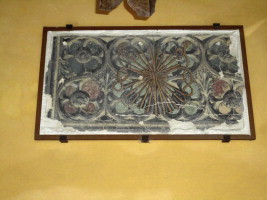
This work describes a comparative study between in situ applications of portable Raman spectroscopy and direct laboratory measurements using micro-Raman spectroscopy on the surface of small samples and of cross sections. The study was performed using wall paintings from different sites of the Alcazar of Seville.
Little information was obtained using a portable Raman spectrometer due to the presence of an acrylic polymer, calcium oxalate, calcite and gypsum that was formed or deposited on the surface. The pigments responsible for different colours, except cinnabar, were not detected by the micro-Raman spectroscopy study of the surface of small samples taken from the wall paintings due to the presence of surface contaminants.
The pigments and plaster were characterised using cross sections. The black colour consisted of carbon black. The red layers were formed by cinnabar and white lead or by iron oxides. The green and white colours were composed of green emerald or atacamite and calcite, respectively. Pb3O4 has also been characterised. The white layers (plaster) located under the colour layers consisted of calcite, quartz and feldspars. The fresco technique was used to create the wall paintings.
A wall painting located on a gypsum layer was also studied. The Naples yellow in this wall painting was not characterised due to the presence of glue and oils.
This study showed the advantage of studying cross sections to completely characterise the pigments and plaster in the studied wall paintings.
Febrero, 2014 | DOI: 10.1016/j.saa.2013.10.052
Reactividad de Sólidos
Characterization of thermally stable gamma alumina fibres biomimicking sisal
Benitez-Guerrero, M; Perez-Maqueda, LA; Sanchez-Jimenez, PE; Pascual-Cosp, JMicroporous and Mesoporous Materials, 185 (2014) 167-178
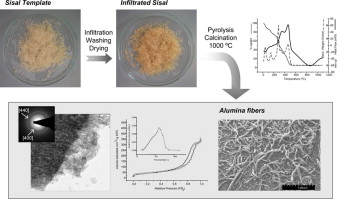
Mesoporous gamma alumina fibres of high surface area, stable up to 1000 °C, were synthesized by bioreplica technique using sisal fibres as templates. Alumina formation during pyrolysis and calcination of fibres infiltrated with aluminium chloride solution has been studied, paying special attention to the interaction between the precursor and sisal fibres, using several experimental techniques such as ATR-FTIR, coupled TG-FTIR and thermo-XRD analysis. The morphology and microstructure of the resulting alumina fibres were characterized using SEM and TEM. The crystallographic analysis of the alumina sample performed by electron and X-ray diffraction suggests that fibres are constituted by η and γ-Al2O3 crystallites, whose chemical structure was confirmed by ATR-FTIR and Al27-MAS-NMR. The specific surface area and porosity of ceramic fibres were determined by N2 and CO2 adsorption–desorption measurements. Resulting alumina fibres retain high specific surface areas of 200 and 150 m2/g even after calcination at 1000 °C for 15 h in dry air and for 4 h in wet air, respectively.
Febrero, 2014 | DOI: 10.1016/j.micromeso.2013.11.012
Reactividad de Sólidos
CdSe@ZnS nanocomposites prepared by a mechanochemical route: No release of Cd2+ ions and negligible in vitro cytotoxicity
Balaz, P; Sayagues, MJ; Balaz, M; Zorkovska, A; Hronec, P; Kovac, J; Kovac, J; Dutkova, E; Mojzisova, G; Mojzis, JMaterials Research Bulletin, 49 (2014) 302-309
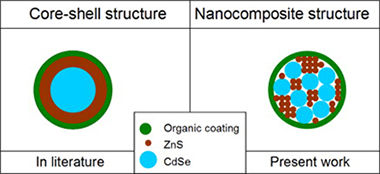
CdSe@ZnS nanocomposites have been prepared by a two-step solid state mechanochemical synthesis. CdSe prepared from Cd and Se elements in the first step was mixed with zinc acetate and sodium sulphide in the second step of milling to prepare a CdSe@ZnS nanocomposite. In the third step, the obtained nanocomposite was coated with l-cysteine to prepare a biocompatible system. The crystallite size of the new type of nanocomposite was 20–35 nm for cubic CdSe and 3–8 nm for hexagonal ZnS as calculated from XRD, TEM and SEM data. The synthesised samples show good crystallinity and have been tested for dissolution and cytotoxicity. The dissolution of cadmium from CdSe@ZnS was less than 0.05 μg mL−1, whereas a value of 0.8 μg mL−1 was measured for CdSe alone. The binding of ZnS with CdSe in the nanocomposite practically eliminated the release of cadmium into solution. As a consequence, a very low cytotoxic activity has been evidenced for CdSe@ZnS. The nanocomposites coated with l-cysteine have a great potential as fluorescent labels in biomedical engineering.
Enero, 2014 | DOI: 10.1016/j.materresbull.2013.08.070
Reactividad de Sólidos
Effect of tantalum content on the microstructure and mechanical behavior of cermets based on (TixTa1−x)(C0.5N0.5) solid solutions
Chicardi, E; Torres, Y; Cordoba, JM; Hvizdos, P; Gotor, FJMaterials & Design, 53 (2014) 435-444

Titanium–tantalum carbonitride, (Ti, Ta)(C, N), based cermets with different Ti and Ta contents were prepared using a mechanically induced self-sustaining reaction and then densified using a pressureless sintering process. Complete microstructural and mechanical characterizations were performed on the materials, which revealed that the size of the carbonitride ceramic particle was significantly reduced when the Ta content was increased. The flexural strength and fracture toughness were measured using the ball on three balls test and the indentation microfracture test, respectively. The strength profile was analyzed under the framework of Weibull theory. The change in the mechanical properties as a function of the Ta content was correlated with the normalized microstructural parameters, such as the binder mean free path. The decrease in toughness and flexural strength was attributed to the presence of intermetallic compounds in the binder phase, which was also corroborated by the nanoindentation tests.
Enero, 2014 | DOI: 10.1016/j.matdes.2013.07.039
2013
2013
Reactividad de Sólidos
Mechanochemical synthesis of ZrB2–SiC–ZrC nanocomposite powder by metallothermic reduction of zircon
Jalaly, M; Tamizifar, M; Bafghi, MS; Gotor, FJJournal of Alloys and Compounds, 581 (2013) 782-787
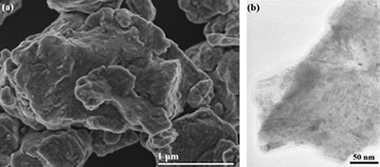
Aluminium and magnesium were used in the M/ZrSiO4/B2O3/C (M = Al, Mg) system to induce a mechanically induced self-sustaining reaction (MSR). Aluminium was not able to reduce the system to the desired products, and the system became amorphous after 10 h milling. However, nanocomposite powder of ZrB2–SiC–ZrC was in situ synthesized by the magnesiothermic reduction with an ignition time of approximately 6 min. The mechanism for the formation of the product in this system was determined by studying the relevant sub-reactions.
Diciembre, 2013 | DOI: 10.1016/j.jallcom.2013.07.142
Reactividad de Sólidos
Bio-inspired mechanochemical synthesis of semiconductor nanomaterial using eggshell membrane
Balaz, M; Balaz, P; Sayagues, MJ; Zorkovska, AMaterials Science in Semiconductor Processing, 16 (2013) 1899-1903
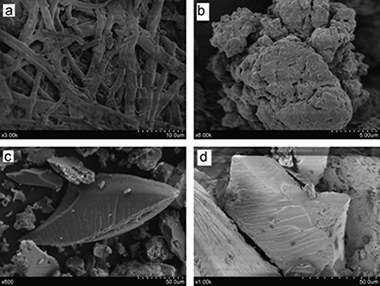
Eggshell membrane and lead acetate were successfully used as precursors for the mechanochemical synthesis of lead sulphide nanocrystals with crystallite sizes ∼8 nm. XRD, specific surface area measurements, SEM and EDX were used to characterise the synthesised material. The mechanochemical synthesis follows three-step mechanism. The “fish-like” grains with sizes around 30 μm were obtained.
Diciembre, 2013 | DOI: 10.1016/j.mssp.2013.06.024
Reactividad de Sólidos
Reversible reactions of Ni and Pd hydroxo pincer complexes [( iPrPCP)M-OH] with CO2: Solid-state study of the decarboxylation of the monomeric bicarbonate complexes [(i PrPCP)M-OCOOH] (M = Ni, Pd)
Martinez-Prieto, LM; Real, C; Avila, E; Alvarez, E; Palma, P; Campora, JEuropean Journal of Inorganic Chemistry, 32 (2013) 5555-5566
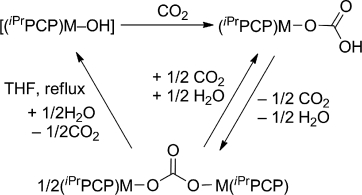
Monomeric Ni and Pd hydroxides stabilized by the iPrPCP pincer ligand react with CO2 to give labile terminal bicarbonate complexes that readily lose CO2 and water to give binuclear carbonate complexes. Differential scanning calorimetry (DSC) has been used to monitor the decomposition of both bicarcabonates in the solid state. When the carbonate complexes are heated under reflux in thf in the presence of water, full decarboxylation takes place, restoring the starting hydroxides and demonstrating that CO2 insertion is a fully reversible process. The decarboxylation of the nickel carbonate complex is completed more readily, suggesting that the reaction of the Pd hydroxide with CO2 is more favourable than that of its nickel counterpart. This is supported by DFT calculations, which also shows that CO2 insertion takes place through a concerted Lipscomb-type mechanism. Monomeric Ni and Pd hydroxides stabilized by the iPrPCP pincer ligand react with CO2 to give labile terminal hydrogen carbonate complexes that readily lose CO2 and water to give binuclear carbonate complexes.
Noviembre, 2013 | DOI: 10.1002/ejic.201300995
Reactividad de Sólidos
Arsenic sorption by nanocrystalline magnetite: An example of environmentally promising interface with geosphere
Bujnakova, Z; Balaz, P; Zorkovska, A; Sayagues, MJ; Kovac, J; Timko, MJournal of Hazardous Materials, 262 (2013) 1204-1212
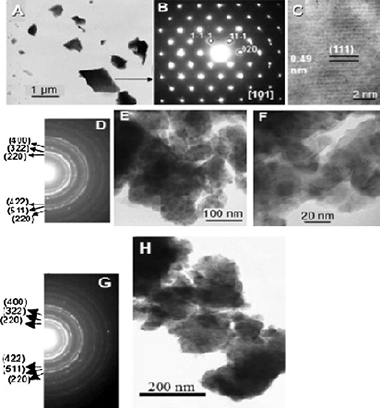
In this paper, the sorption of arsenic onto nanocrystalline magnetite mineral Fe3O4 was studied in a model system. Nanocrystalline magnetite was produced by mechanical activation in a planetary ball mill from natural microcrystalline magnetite. As a consequence of milling, the specific surface area increased from 0.1 m2/g to 11.9 m2/g and the surface site concentration enhanced from 2.2 sites/nm2 to 8.4 sites/nm2. These changes in surface properties of magnetite lead to the enhancement of arsenic removal from model system. The best sorption ability was achieved with magnetite sample activated for 90 min. In this case the sample was able to absorb around 4 mg/g. The structural changes of magnetite were also observed and the new hematite phase was detected after 120 min of milling. A good correlation between the decreasing particle size, increasing specific surface area and reduction of saturation magnetization was found. In desorption study, KOH and NaOH were found as the best eluents where more than 70% of arsenic was released back into the solution. The principal novelty of the paper is that mineral magnetite, truly one nature's gift can be used after “smart” milling (mechanical activation) as an effective arsenic sorbent.
Noviembre, 2013 | DOI: 10.1016/j.jhazmat.2013.03.007
Reactividad de Sólidos
Formation mechanism of ZrB2–Al2O3 nanocomposite powder by mechanically induced self-sustaining reaction
Jalaly, M; Bafghi, MS; Tamizifar, M; Gotor, FJJournal of Materials Science, 48 (2013) 7557-7567
ZrB2–Al2O3 nanocomposite powder was produced by aluminothermic reduction in Al/ZrO2/B2O3 system. In this research, high energy ball milling was used to produce the necessary conditions to induce a mechanically induced self-sustaining reaction. The ignition time of the composite formation was found to be about 13 min. The synthesis mechanism in this system was investigated by examining the corresponding sub-reactions as well as changing the stoichiometry of reactants. Thermal behavior of the system was also studied.
Noviembre, 2013 | DOI: 10.1007/s10853-013-7571-7
Reactividad de Sólidos
Porous Aluminas: The biotemplate method for the synthesis of stable high surface area aluminas
Guerrero, MB; Maqueda, LP; Castro, PP; Cosp, JPBoletin de la Sociedad Española de Cerámica y Vidrio, 52 (2013) 251-267
Development of porous alumina has been the objective of numerous studies in recent decades, due to the intrinsic properties of aluminium oxide, such as high melting point, low thermal conductivity, chemical inertness and corrosion resistance which, in addition to a high surface area and permeability, make aluminas being used for many different industrial and technical applications. The crystallographic and textural stability of alumina acquires significant importance in those processes involving high temperatures; however, most of the synthesis methods yield metastable oxides of little interest in high-temperature processes due to the transformation to alpha phase, with the consequent reduction in surface area. The present article reviews diverse procedures for obtaining porous alumina with high specific surface area, including methods and strategies for preparing high surface alpha-alumina. Within this framework, the paper analyzes the results obtained through bioreplica of lignocellulosic materials. This technology allows preparing aluminas with the complex structural hierarchy of the lignocellulosic templates.
Noviembre, 2013 | DOI: 10.3989/cyv.322013
Reactividad de Sólidos
Evidence of nanograin cluster coalescence in spark plasma sintered α-Al2O3
Morales-Rodriguez, A; Poyato, R; Gallardo-Lopez, A; Munoz, A; Dominguez-Rodriguez, AScripta Materialia, 69 (2013) 529-532

The aim of this study is to elucidate the coarsening kinetics involved during densification of fine-grained pure α-alumina by spark plasma sintering. Low temperature and short dwell time sintering conditions were used to preserve the nanocrystalline structure of the starting commercial powder (about 50 nm). Notwithstanding the above, submicron grain coarsened microstructures have been developed. The microstructure evolution of alumina under different sintering conditions points to a nanograin rotation densification mechanism as being responsible for the fast grain growth observed.
Octubre, 2013 | DOI: 10.1016/j.scriptamat.2013.06.019
Reactividad de Sólidos
The Ozawa’s generalized time concept and YZ-master plots as a convenient tool for kinetic analysis of complex processes
Malek, J; Koga, N; Perez-Maqueda, LA; Criado, JMJournal of Thermal Analysis and Calorimetry, 113 (2013) 1437-1446
The concept of generalized time θ=∫exp(−Ea/RT)dt θ = ∫ exp ( − E a / RT ) d t in non-isothermal kinetics was introduced by Ozawa in 1965, together with the well-known isoconversional plot, i.e., Ozawa plot. The generalized time is the key concept to tie the kinetic data under varying temperature to the kinetic relationship at a constant temperature. It is well known that many processes studied by thermal analysis and calorimetry reveal a complex nature. Therefore, the generalized time concept seems to be very useful for the description of the change in the rate behavior depending on the fractional conversion. Using the concept of θ, three kinds of experimental master plots can be formalized in differential, integral, and multiplied forms. Among others, combination of the differential and multiplied master plots, y(α) = (dα/dθ) and z(α) = (dα/dθ)θ, show a high performance to discriminate the kinetic model based on the maxima condition of y(α y*) and z(α z*). The α y* − α y* kinetic plot is a useful tool to visualize the complexity of the kinetic process and to determine the most suitable kinetic model. The usefulness of α y* − α y* kinetic plot and the YZ-master plots is illustrated as exemplified by the kinetic analyses of complex crystallization processes of the as-prepared, thermally and mechanically treated amorphous zirconia.
Septiembre, 2013 | DOI: 10.1007/s10973-013-2939-0
Reactividad de Sólidos
Hallmarks of mechanochemistry: from nanoparticles to technology
Balaz, P; Achimovicova, M; Balaz, M; Billik, P; Cherkezova-Zheleva, Z; Criado, JM; Delogu, F; Dutkova, E; Gaffet, E; Gotor, FJ; Kumar, R; Mitov, I; Rojac, T; Senna, M; Streletskii, A; Wieczorek-Ciurowa, KChemical Society Reviews, 42 (2013) 7571-7637
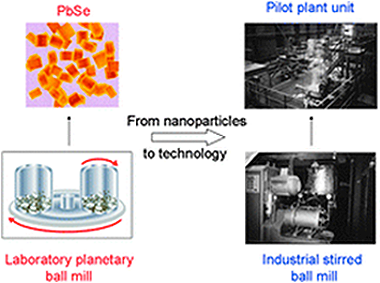
The aim of this review article on recent developments of mechanochemistry (nowadays established as a part of chemistry) is to provide a comprehensive overview of advances achieved in the field of atomistic processes, phase transformations, simple and multicomponent nanosystems and peculiarities of mechanochemical reactions. Industrial aspects with successful penetration into fields like materials engineering, heterogeneous catalysis and extractive metallurgy are also reviewed. The hallmarks of mechanochemistry include influencing reactivity of solids by the presence of solid-state defects, interphases and relaxation phenomena, enabling processes to take place under non-equilibrium conditions, creating a well-crystallized core of nanoparticles with disordered near-surface shell regions and performing simple dry time-convenient one-step syntheses. Underlying these hallmarks are technological consequences like preparing new nanomaterials with the desired properties or producing these materials in a reproducible way with high yield and under simple and easy operating conditions. The last but not least hallmark is enabling work under environmentally friendly and essentially waste-free conditions (822 references).
Septiembre, 2013 | DOI: 10.1039/C3CS35468G
Materiales Avanzados
Planning collection and solid waste flow (construction and demolition, concrete, ceramics and others) by utilizing a computerized tool for sustainable management
Garzon, E; Sanchez-Soto, PJBoletin de la Sociedad Española de Cerámica y Vidrio, 5 (2013) V-XIV (Notas Técnicas)
Se presenta un procedimiento para la planificación de recogida y flujo de los residuos sólidos (de construcción y demolición, hormigón, cerámica, vidrio y otros) basado en la utilización de una herramienta informatizada, para conseguir una optimización de su gestión. Dicho procedimiento parte de normativa establecida según un Plan Director Territorial de la Gestión de Residuos Sólidos Urbanos (RSU) aprobado en una Comunidad Autónoma, en este caso se particulariza a la de Andalucía, tomando como ejemplo el volumen de residuos que se producen en una colectividad de tamaño medio (provincia de Almería), siendo extensible a otras mayores en población y territorio, disponiendo de datos actualizados.
El procedimiento utiliza una herramienta informática de gran difusión en el mundo, como es Google Earth y, de este modo, genera un número de “Centros deTransferencia” con objeto de minimizar el gasto de transporte, partiendo de una premisa previa en cuanto a distancia entre núcleos poblacionales y centros de tratamiento. Los Centros generados con la aplicación del procedimiento se pueden visualizar en un mapa topográfico, con áreas de influencia y vías de acceso a los mismos y se le pueden asociar una serie de datos tabulados con información adicional de utilidad. El procedimiento propuesto se va retroalimentando de manera constante con datos reales e información de campo, permitiendo a las empresas que producen residuos de distinta tipología como son los residuos de construcción y demolición principalmente, pero también hormigón, cerámica, vidrio, mezclas de todos ellos, residuos clasificados como peligrosos e incluso de otros materiales, a la propia administración y a la sociedad, en general, conocer las tasas de cada planta de tratamiento y qué se hace con los residuos entregados para contribuir a la reducción del impacto medioambiental de los mismos y a su gestión sostenible.
Septiembre, 2013 | DOI: 10.3989/cyv.2013.v52.i5
Reactividad de Sólidos
Kinetic studies in solid state reactions by sample-controlled methods and advanced analysis procedures
Perez-Maqueda, LA; Criado, JM; Sanchez-Jimenez, PE; Perejon, AJournal of Thermal Analysis and Calorimetry, 113 (2013) 1447-1453
A comparative study of both conventional rising temperature and sample-controlled methods, like constant rate thermal analysis (CRTA), is carried out after analyzing a set of solid state reactions using both methods. It is shown that CRTA avoids the influence of heat and mass transfer phenomena for a wide range of sample sizes leading to reliable kinetic parameters. On the other hand, conventional rising temperature methods yield α–T plots dependent on experimental conditions, even when using samples sizes smaller than 2 mg. Moreover, it is shown that the discrimination of overlapping processes is dramatically improved using sample-controlled methods instead of conventional heating procedures. An advanced method for performing the kinetic analysis of complex processes from a single CRTA experiment is proposed.
Septiembre, 2013 | DOI: 10.1007/s10973-013-3114-3
Reactividad de Sólidos
Pyrolysis kinetics of ethylene–propylene (EPM) and ethylene–propylene–diene (EPDM)
Perejon, A; Sanchez-Jimenez, PE; Gil-Gonzalez, E; Perez-Maqueda, LA; Criado, JMPolymer Degradation and Stability, 98 (2013) 1571-1577

The thermal degradation kinetics of several ethylene–propylene copolymers (EPM) and ethylene–propylene–diene terpolymers (EPDM), with different chemical compositions, have been studied by means of the combined kinetic analysis. Until now, attempts to establish the kinetic model for the process have been unsuccessful and previous reports suggest that a model other than a conventional nth order might be responsible. Here, a random scission kinetic model, based on the breakage and evaporation of cleavaged fragments, is found to describe the degradation of all compositions studied. The suitability of the kinetic parameters resulting from the analysis has been asserted by successfully reconstructing the experimental curves. Additionally, it has been shown that the activation energy for the pyrolysis of the EPM copolymers decreases by increasing the propylene content. An explanation for this behavior is given. A low dependence of the EPDM chemical composition on the activation energy for the pyrolysis has been reported, although the thermal stability is influenced by the composition of the diene used.
Septiembre, 2013 | DOI: 10.1016/j.polymdegradstab.2013.06.029
Reactividad de Sólidos
Studies of isothermal crystallisation kinetics of sunflower hard stearin-based confectionery fats
Bootello, MA; Hartel, RW; Levin, M; Martinez-Blanes, JM; Real, C; Garces, R; Martinez-Force, E; Salas, JJFood Chemistry, 139 (2013) 184-195
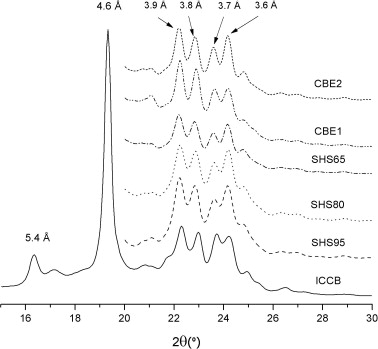
The crystallisation and polymorphic properties of three sunflower hard stearins (SHSs) and cocoa butter equivalents (CBEs) formulated by blending SHSs and palm mid fraction (PMF) were studied and compared with those from cocoa butter (CB), to explore their possibilities as confectionery fats. The isothermal crystallisation kinetics of these fats were examined by pNMR and DSC at three different temperatures. All samples studied displayed a two-step crystallisation profile that could be fitted to an exponential-Gompertz equation. Stop-and-return DSC studies showed that SHSs and CBEs exhibited different crystallisation mechanisms according to their triacylglycerol composition, with a quick formation of metastable crystals, followed by a polymorphic transition to the more stable β or β′ forms. X-ray diffraction (XRD) was used to investigate the polymorphic forms of tempered SHSs and CBEs in the long term. In all cases the resulting fats displayed short spacing patterns associated with β polymorphism. These formulations based on SHSs and PMF met all the requirements to be considered as CBEs; therefore they could be used as an alternative to traditional confectionery fats.
Agosto, 2013 | DOI: 10.1016/j.foodchem.2012.11.141
Materiales Avanzados
Historic preservation, GIS, & rural development: The case of Almería province, Spain
Cano, M; Garzon, E; Sanchez-Soto, PJApplied Geograhpy, 42 (2013) 34-47
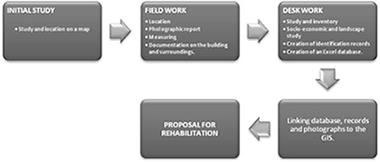
A computerized database was created, based on a Geographic Information System (GIS), with hyperlinks to the website for a Rural Development Association (Almería province, Andalusia, Spain). Thus, a catalogue of traditional rural buildings in this particular area was compiled, identifying and characterizing each one, establishing criteria for a dynamic and rational selection. The purpose to select this example was to facilitate their management by public organizations or private individuals, for their reuse, restoration or both. The cataloguing and promotion of rural architecture will contribute to creating jobs by stimulating new economic activity, such as the promotion of cultural tourism, while preserving a valuable source of information on rural culture, recovering local construction techniques, encouraging a sense of community, and making villages and rural areas more attractive to visitors. The assessment of the rehabilitation potential of rural buildings in this region has helped to establish a priority order for their reuse, and so an intervention map has been devised in terms of a “Decision Index” corresponding to each considered building.
Agosto, 2013 | DOI: 10.1016/j.apgeog.2013.04.014
Propiedades mecánicas, modelización y caracterización de cerámicos avanzados
High temperature plasticity in yttria stabilised tetragonal zirconia polycrystals (Y-TZP)
Dominguez-Rodriguez, A; Gomez-Garcia, D; Wakai, FInternational Materials Reviews, 58 (2013) 399-417
The literature data on the superplastic deformation of high purity yttria stabilised tetragonal zirconia polycrystals is reviewed in detail. It is shown that, based on the existence of a threshold stress, the single mechanism of grain boundary sliding (GBS) accommodated by diffusional processes can explain the superplasticity of these materials over all the ranges of temperature, stress, grain size, and surrounding atmosphere that have been studied. The origin of the threshold stress and its quantitative dependence on temperature and grain size is explained in terms of the segregation of yttrium atoms at the grain boundaries. A new model for GBS accommodated by lattice or grain-boundary diffusion is presented which can explain the transition of the stress exponent from 2 to 1.
Agosto, 2013 | DOI: 10.1179/1743280413Y.0000000018
Reactividad de Sólidos
Constant rate thermal analysis for enhancing the long-term CO2 capture of CaO at Ca-looping conditions
Valverde, JM; Sanchez-Jimenez, PE; Perejon, A; Perez-Maqueda, LAApplied Energy, 108 (2013) 108-120
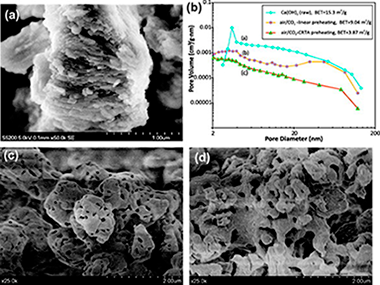
Experimental results are reported on the (Ca-looping) multicyclic CO2 capture of CaO and nanosilica/CaO composites derived from Ca(OH)2 and nanosilica/Ca(OH)2 dry mixtures subjected in situ to linear and constant rate thermal analysis (CRTA) preheating programs in either air or air/CO2 atmospheres. By means of CRTA preheating the rates of the reactions taking place during pretreatment are kept at a constant and small value along the entire process. In agreement with a pore skeleton model, previously proposed in the literature for explaining the behavior of natural limestones thermally pretreated, our results suggest that air/CO2-CRTA pretreatment yields a thermally stable hard skeleton of poorly reactive CaO on which a soft skeleton of reactive CaO would be supported. The sorbent subjected to this preheating program exhibits a reactivation in the very first carbonation/calcination cycles, after which CaO conversion decays slowly with the cycle number. In contrast, linearly or air-CRTA preheated sorbents show a significant decrease of CaO conversion within the first cycles. In the latter case, CaO multicyclic conversion fits well to a model where it is assumed that the progressive reduction of surface area as the number of carbonation/calcination cycles is increased obeys to sintering of the preheated sorbent skeleton as it is subjected to repeated calcinations during cycling. In the former case, CaO conversion data conforms to the prediction by a model in which the loss of surface area is mainly due to sintering of a nascent CaO soft skeleton regenerated in the diffusive carbonation phase, which is enhanced by the air/CO2-CRTA pretreatment. As regards the effect of nanosilica, the results indicate that it slows down CaO sintering during pretreatment, which hinders the development of a stable CaO skeleton thus hampering reactivation and stabilization of conversion. On the other hand, as CaO sintering is also lessened during looping calcination, nanosilica is useful to increase the absolute values of CaO conversion.
Agosto, 2013 | DOI: 10.1016/j.apenergy.2013.03.013
Reactividad de Sólidos
Enhanced general analytical equation for the kinetics of the thermal degradation of poly(lactic acid) driven by random scission
Carrasco, F; Perez-Maqueda, LA; Sanchez-Jimenez, PE; Perejon, A; Santana, OO; Maspoch, MLPolymer Testing, 32 (2013) 937-945
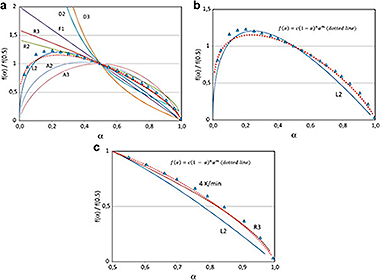
An enhanced general analytical equation has been developed in order to evaluate the kinetic parameters of the thermal degradation of poly(lactic acid) (PLA) at various linear heating rates and at constant rate conditions. This improvement consisted of replacing the n-order conversion function by a modified form of the Sestak-Berggren equation f(α) = c(1−α)nαm, which led to better adjustment of experimental data, and also adequately represented the conventional mechanisms for solid-state processes. The kinetic parameters so obtained have been compared to those determined by conventional differential and isoconversional methods. Given that the thermal degradation of PLA has been argued to be caused by random chain scission reactions of ester groups, the conversion function (α) = 2(α1/2−α), corresponding to a random scission mechanism, has been tested.
Agosto, 2013 | DOI: 10.1016/j.polymertesting.2013.04.013
Reactividad de Sólidos
Spark plasma sintering of TixTa1−xC0.5N0.5-based cermets: Effects of processing conditions on chemistry, microstructure and mechanical properties
Cordoba, Jose M.; Chicardi, Ernesto; Poyato, Rosalia; Gotor, Francisco J.; Medri, Valentina; Guicciardi, Stefano; Melandri, CesareChemical Engineering Journal, 230 (2013) 558-566
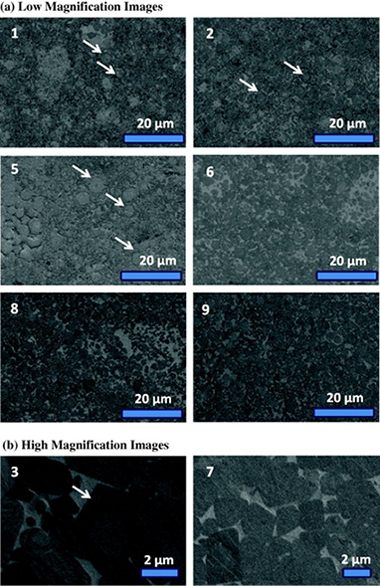
Nanometric powdered TixTa1−xC0.5N0.5-based cermets were fabricated using a mechanically induced self-sustaining reaction and consolidated by spark plasma sintering. Highly dense cermets were obtained, and their chemistry, microstructure and mechanical properties were characterised by X-ray diffraction, scanning electron microscopy, image analysis, microindentation and nanoindentation. The microhardness was found to depend directly on the contiguity and size of the ceramic hard particles. The samples synthesised at the lowest temperature (1150 °C) exhibited more homogeneous microstructures and smaller ceramic particles and the best combination of microhardness and fracture toughness.
Agosto, 2013 | DOI: 10.1016/j.cej.2013.06.104
Reactividad de Sólidos
CO2 multicyclic capture of pretreated/doped CaO in the Ca-looping process. Theory and experiments
Valverde, JM; Sanchez-Jimenez, PE; Perejon, A; Perez-Maqueda, LAPhysical Chemistry Chemical Physics, 15 (2013) 11775-11793

We study in this paper the conversion of CaO-based CO2 sorbents when subjected to repeated carbonation–calcination cycles with a focus on thermally pretreated/doped sorbents. Analytical equations are derived to describe the evolution of conversion with the cycle number from a unifying model based on the balance between surface area loss due to sintering in the looping-calcination stage and surface area regeneration as a consequence of solid-state diffusion during the looping-carbonation stage. Multicyclic CaO conversion is governed by the evolution of surface area loss/regeneration that strongly depends on the initial state of the pore skeleton. In the case of thermally pretreated sorbents, the initial pore skeleton is highly sintered and regeneration is relevant, whereas for nonpretreated sorbents the initial pore skeleton is soft and regeneration is negligible. Experimental results are obtained for sorbents subjected to a preheating controlled rate thermal analysis (CRTA) program. By applying this preheating program in a CO2 enriched atmosphere, CaO can be subjected to a rapid carbonation followed by a slow rate controlled decarbonation, which yields a highly sintered skeleton displaying a small conversion in the first cycle and self-reactivation in the next ones. Conversely, carbonation of the sorbent at a slow controlled rate enhances CO2 solid-state diffusion, which gives rise, after a quick decarbonation, to a highly porous skeleton. In this case, CaO conversion in the first cycle is very large but it decays abruptly in subsequent cycles. Data for CaO conversion retrieved from the literature and from further experimental measurements performed in our work are analyzed as influenced by a variety of experimental variables such as preheating temperature program, preheating exposition time, atmosphere composition, presence of additives, and carbonation–calcination conditions. Conversion data are well fitted by the proposed model equations, which are of help for a quantitative interpretation of the effect of experimental conditions on the multicyclic sorbent performance as a function of sintering/regeneration parameters inferred from the fittings and allow foreseeing the critical conditions to promote reactivation. The peculiar behavior of some pretreated sorbents, showing a maximum conversion in a small number of cycles, is explained in light of the model.
Julio, 2013 | DOI: 10.1039/C3CP50480H
Role of Looping-Calcination Conditions on Self-Reactivation of Thermally Pretreated CO2 Sorbents Based on CaO
Valverde, JM; Sanchez-Jimenez, PE; Perejon, A; Perez-Maqueda, LAEnergy & Fuels, 27 (2013) 3373-3384

The conversion of thermally pretreated CaO along successive carbonation/calcination cycles has been investigated, as affected by looping-calcination conditions, by means of Thermogravimetric Analysis (TGA). Sorbent samples have been subjected in situ to a thermal preheating program based on Constant Rate Thermal Analysis (CRTA) by virtue of which decarbonation is carried out at a low controlled rate, which is able to promote self-reactivation in the first carbonation/calcination cycles. Our observations support a pore-skeleton model according to which solid-state diffusion in the first carbonation stages, which is enhanced by thermal pretreatment, gives rise to a soft skeleton with increased surface area. Yet, the results show that self-reactivation is hindered as looping-calcination conditions are harshened. Increasing the looping-calcination temperature and/or the looping calcination time period favors sintering of the soft skeleton and eventually self-reactivation is precluded. A model is developed that retrieves the main features of multicyclic conversion of thermally pretreated sorbents in the first cycles based on the balance between surface area gain due to promoted solid-state diffusion carbonation and surface area loss due to sintering of the soft skeleton in the looping-calcination stage, which can be useful to investigate the critical looping-calcination conditions that nullify self-reactivation. The proposed model allows envisaging the behavior of the sorbent performance as a function of the pretreatment conditions.
Junio, 2013 | DOI: 10.1021/ef400480j
Reactividad de Sólidos
Direct mechanosynthesis of pure BiFeO3 perovskite nanoparticles: reaction mechanism
Perejon, A; Murafa, N; Sanchez-Jimenez, PE; Criado, JM; Subrt, J; Dianez, MJ; Perez-Maqueda, LAJournal of Materials Chemistry C, 1 (2013) 3551-3562
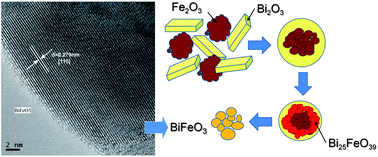
In this work, a mechanochemical procedure is proposed as a simple and fast method to synthesize the pure BiFeO3 perovskite phase as a nanostructured material without the need for purification treatments, while the mechanochemical reaction mechanism has been investigated and correlated with that of the conventional solid-state reaction. Thus, different milling conditions have been used as a tool for tailoring the crystallite size of the resulting BiFeO3 nanoparticles. The materials prepared by the mechanochemical reaction could be annealed or sintered without the formation of undesirable phases. Both the ferroelectric and ferromagnetic transitions were observed by DSC. Finally, the dielectric constants of the prepared material at different frequencies as a function of the temperature have been measured, showing that the material is clearly an isolator below 200 °C, characteristic of a high quality BiFeO3 material.
Junio, 2013 | DOI: 10.1039/C3TC30446A
Materiales Avanzados
Estudio in-situ de la transformación térmica de limonita utilizada como pigmento procedente de Perú
Romero-Gomez, P; Gonzalez, JC; Bustamante, A; Ruiz-Conde, A; Sanchez-Soto, PJBoletin de la Sociedad Española de Cerámica y Vidrio, 52 (2013) 127-131
Se ha realizado un estudio cinético de la transformación térmica de limonita [FeO(OH).nH2O] mediante análisis térmico gravimétrico (TGA), termodifracción de rayos X (DRX) y espectroscopía μ-Raman. La muestra estudiada fue extraída de un yacimiento en el distrito de Taraco, provincia de Huancané, Región de Puno (Perú). La técnica DRX en polvo identificó la fase goetita como el principal componente mineralógico, además de cuarzo. La muestra se sometió a un tratamiento térmico
in-situ en un intervalo de temperaturas de 100 a 500 °C en atmósfera de aire e inerte (nitrógeno) y se estudió por DRX. Los resultados han mostrado que la fase goetita permanece estable desde la temperatura ambiente hasta 200 °C. A partir de los 250 °C se produce una transformación de fase α-FeO(OH)→α-Fe2O3
con un cambio cromático, es decir, el paso de la fase
hidroxilada goetita (amarillo) a la fase oxidada hematites (rojo) con una pérdida de peso de un 8 %, teniendo como evidencia la evolución de los perfiles de difracción y los resultados de ATG. Los espectros μ-Raman del tratamiento térmico in-situ corroboran que se produce también una transición de fase a la temperatura de 290 °C a través de la transformación de las bandas Raman características de la fase goetita hacia la fase hematites en el rango de frecuencias de 200 a 1800cm-1.
Mayo, 2013 | DOI: 10.3989/cyv.162013
Reactividad de Sólidos
Effect of sintering time on the microstructure and mechanical properties of (Ti,Ta)(C,N)-based cermets
Chicardi, E; Torres, Y; Cordoba, JM; Sayagues, MJ; Rodriguez, JA; Gotor, FJInternational Journal of Refractory Metals & Hard Materials, 38 (2013) 73-80
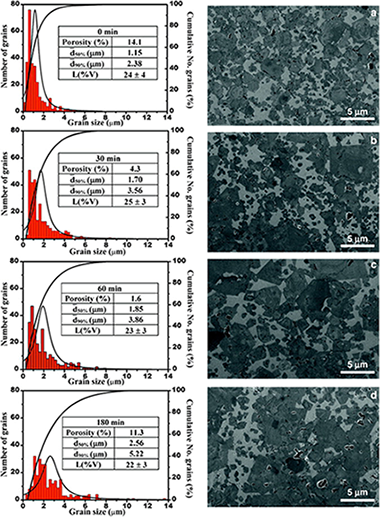
Complete solid-solution cermets based on titanium–tantalum carbonitride using a starting nominal composition with 80 wt.% of (Ti0.8Ta0.2)(C0.5N0.5) and 20 wt.% of Co were performed by pressure-less sintering at 1550 °C for different times (from 0 to 180 min) in an inert atmosphere. Chemical and phase analyses were conducted using X-ray diffraction (XRD), elemental analysis and energy dispersive X-ray spectrometry (EDX). The binder mean free path and the contiguity of the carbonitride particles were used to rationalise the microstructural effects of the mechanical behaviour. Mechanical characterisation included determining the Vickers hardness, the fracture toughness (conventional indentation microfractures, IM), the dynamic Young's modulus (ultrasonic technique), the biaxial strength (ball on three ball) and a detailed fractographic examination. Finally, the experimental findings were combined with a theoretical fracture mechanics analysis to estimate the critical processing flaw sizes. Binder-less carbonitride clusters, pores and coarse carbonitride grains were the main defects observed and were responsible for the fractures.
Mayo, 2013 | DOI: 10.1016/j.ijrmhm.2013.01.001
Reactividad de Sólidos
Limitations of model-fitting methods for kinetic analysis: Polystyrene thermal degradation
Sanchez-Jimenez, PE; Perez-Maqueda, LA; Perejon, A; Criado, JMResources, Conservation and Recycling, 74 (2013) 75-81
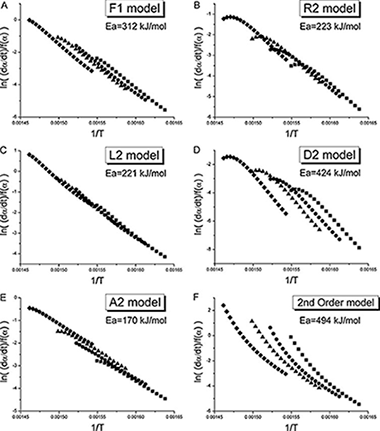
In this paper, some clarifications regarding the use of model-fitting methods of kinetic analysis are provided in response to the lack of plot linearity and dispersion in the activation energy values for the thermal degradation of polystyrene found in the literature and some results proposing an nth order model as the most suitable one. In the present work, two model-fitting methods based on the differential and integral forms of the general kinetic equation are evaluated using both simulated and experimental data, showing that the differential method is recommended due to its higher discrimination power. Moreover, the intrinsic limitations of model-fitting methods are highlighted: the use of a limited set of kinetic models to fit experimental data and the ideal nature of such models. Finally, it is concluded that a chain scission model is more appropriate than first order.
Mayo, 2013 | DOI: 10.1016/j.resconrec.2013.02.014
Reactividad de Sólidos
Liquid-phase sintering of Ti(C,N)-based cermets. The effects of binder nature and content on the solubility and wettability of hard ceramic phases
Cordoba, JM; Chicardi, E; Gotor, FJJournal of Alloys and Compounds, 559 (2013) 34-38
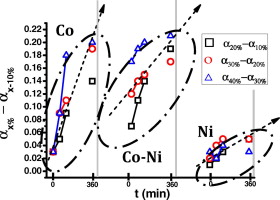
Different commercial TiC–TiN/Co/Ni mixtures were used as raw materials for Ti(C,N) cermets, and the effects of the sintering parameters (binder content, binder nature, sintering time and additives) on the final hard ceramic phase were studied at the sintering temperature of 1400 °C. When Co is used as the binder medium, it is possible to completely convert the starting commercial TiC–TiN mixture into TiCxN1−x. When Ni is used, which exhibits lower solubilising capacity than Co, the total conversion can never be reached and the metallurgical reactions between TiC and TiN during the liquid-phase sintering are more dependent on the sintering time than on the binder content. However, the use of Co–Ni mixtures, showing a synergic effect between the wettability capacity of Ni and the solubilising capacity of Co, enhances the metallurgical reactions at short sintering times.
Mayo, 2013 | DOI: 10.1016/j.jallcom.2013.01.046
Propiedades mecánicas, modelización y caracterización de cerámicos avanzados
Segregation to the grain boundaries in YSZ bicrystals: A Molecular Dynamics study
Gonzalez-Romero, RL; Melendez, JJ; Gomez-Garcia, D; Cumbrera, FL; Dominguez-Rodriguez, ASolid State Ionics, 237 (2013) 8-15
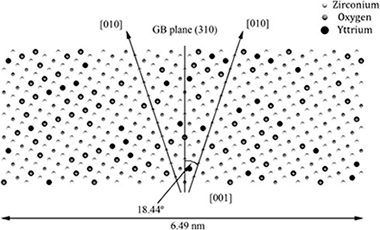
A Molecular Dynamics study about the segregation of yttrium at 1500 K to a Σ5 grain boundary in 8 mol% YSZ has been performed. Segregation has been induced by explicitly taking into account the excess energy associated to the elastic misfit effect for yttrium cations located nearby the grain boundary planes. After an initial transient, a steady regime is reached, in which the number of yttrium cations does not increase with time. Accumulation of yttrium cations is accompanied by that of zirconium ones and oxygen vacancies at some distance of the grain boundary planes. The changes in the radial distribution functions for different ionic pairs are discussed, as also the effect of segregation on oxygen diffusion along the grain boundaries and in volume. Finally, the possibility that segregated yttrium located at available free sites at the grain boundaries is pointed out.
Abril, 2013 | DOI: 10.1016/j.ssi.2013.02.002
Characterization and repair measures of the medieval building materials of a Hispanic–Islamic construction
Pineda, P; Robador, MD; Perez-Rodriguez, JLConstruction and Building Materials, 41 (2013) 612-633
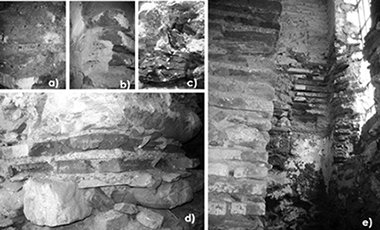
This paper focuses on the physical–chemical and mechanical characterization of the building materials of a precious damaged structure, the Salares tower, a Hispanic–Islamic medieval construction located in the South of Spain, an active seismic area. An exhaustive description of the materials has been obtained, enriching the knowledge on historical construction materials. Sophisticated laboratory tests (XRD, SEM, EDX, FTIR, Micro-Raman spectroscopy, DTA and TG) have provided crucial complementary data to use together with traditional laboratory procedures, especially when the damage processes are the main concern. The experimental investigation has allowed a better understanding of the remote origin and of the failure mechanisms of this damaged structure. On the basis of these results, the most adequate repair materials are selected.
Abril, 2013 | DOI: 10.1016/j.conbuildmat.2012.12.034
Reactividad de Sólidos
Electrical Properties of Stoichiometric BiFeO3 Prepared by Mechanosynthesis with Either Conventional or Spark Plasma Sintering
Perejon, A; Maso, N; West, AR; Sanchez-Jimenez, PE; Poyato, R; Criado, JM; Perez-Maqueda, LAJournal of the American Ceramic Society, 96 (2013) 1220-1227
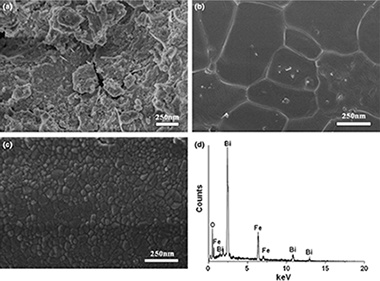
Phase-pure powders of stoichiometric BiFeO3 have been prepared by mechanosynthesis. Ceramics sintered by either conventional heating in air or spark plasma sintering (SPS) followed by oxidative anneal in air are highly insulating at room temperature with resistivity, extrapolated from the Arrhenius plots, of ~1016 Ωcm and activation energy 1.15(2) eV, comparable with those of a good-quality BiFeO3 single crystal. By contrast, the as-prepared SPS sample without the postsinter anneal shows lower resistivity, e.g., ~1010 Ωcm at 25°C and activation energy 0.67(3) eV, indicating some reduction in the sample by the SPS process. The reason for the high conductivity reported for some ceramic samples in the literature remains unclear at present.
Abril, 2013 | DOI: 10.1111/jace.12186
Reactividad de Sólidos
Cystine-capped CdSe@ZnS nanocomposites: mechanochemical synthesis, properties, and the role of capping agent
Balaz, M; Balaz, P; Tjuliev, G; Zubrik, A; Sayagues, MJ; Zorkovska, A; Kostova, NJournal of Materials Science, 48 (2013) 2424-2432

Cystine-capped CdSe@ZnS nanocomposites were synthesized mechanochemically with the aim to prepare a material which could be used in medicine for biosensing applications. Although synthesized CdSe@ZnS nanocomposites were capped with l-cysteine, cystine was formed from l-cysteine during the milling process. It was proven that water plays the key role in this oxidative transformation. The novel material was characterized by the complex of physico-chemical methods (FTIR, XPS, SEM, EDX, surface area measurements) and CHNS analysis. The leakage of Cd2+ and Zn2+ ions into physiological solution was also studied.
Marzo, 2013 | DOI: 10.1007/s10853-012-7029-3
Allochthonous red pigments used in burial practices at the Copper Age site of Valencina de la Concepción (Sevilla, Spain): characterisation and social dimension
Rogerio-Candelera, MA; Herrera, LK; Miller, AZ; Sanjuan, LG; Molina, CM; Wheatley, DW; Justo, A; Saiz-Jimenez, CJournal of Archaeological Science, 40 (2013) 279-290
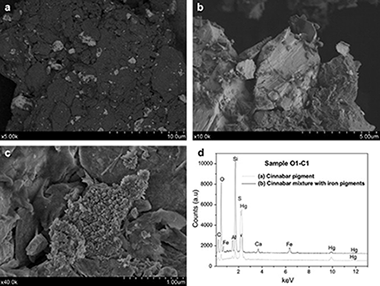
The use of red pigments linked to burial practices is widely documented in the Iberian prehistoric record and very often it has been traditionally interpreted as a ritual practice entailing the utilisation of local raw materials (iron oxides). Some research works, nevertheless, have also detected the use of red pigments which can only be interpreted as allochthonous. The red pigments spread over a single inhumation in a monumental Megalithic tomb surrounding Valencina de la Concepción Copper Age settlement was studied by means of X-ray diffraction, field emission scanning electron microscopy with energy dispersive X-ray spectroscopy, X-ray microfluorescence, micro-Raman and Fourier transform infrared spectroscopies. This approach allowed characterising the red pigments as cinnabar, mixed with tiny amounts of iron oxides. The presence of cinnabar, a product that was necessarily imported, in a context of an exceptional set of grave goods, suggests that the use of cinnabar was linked not only to ritual but also to practices related to the display of social status.
Febrero, 2013 | DOI: 10.1016/j.jas.2012.08.004
Reactividad de Sólidos
Kinetic approach to partially overlapped thermal decomposition processes
Koga, N; Goshi, Y; Yamada, S; Perez-Maqueda, LAJournal of Thermal Analysis and Calorimetry, 111 (2013) 1463-1474
Practical usefulness of the kinetic deconvolution for partially overlapped thermal decomposition processes of solids was examined by applying to the co-precipitated basic zinc carbonate and zinc carbonate. Comparing with the experimental deconvolutions by thermoanalytical techniques and mathematical deconvolutions using different statistical fitting functions, performance of the kinetic deconvolution based on an accumulative kinetic equation for the independent processes overlapped partially was evaluated in views of the peak deconvolution and kinetic evaluation. Two-independent kinetic processes of thermal decompositions of basic zinc carbonate and zinc carbonate were successfully deconvoluted by means of the thermoanalytical measurements in flowing CO2 and by applying sample controlled thermal analysis (SCTA). The deconvolutions by the mathematical curve fittings using different fitting functions and subsequent formal kinetic analysis provide acceptable values of the mass-loss fractions and apparent activation energies of the respective reaction processes, but the estimated kinetic model function changes depending on the fitting functions employed for the peak deconvolution. The mass-loss fractions and apparent kinetic parameters of the respective reaction processes can be optimized simultaneously by the kinetic deconvolution based on the kinetic equation through nonlinear least square analysis, where all the parameters indicated acceptable correspondences to those estimated through the experimental and mathematical deconvolutions. As long as the reaction processes overlapped are independent kinetically, the simple and rapid procedure of kinetic deconvolution is useful as a tool for characterizing the partially overlapped kinetic processes of the thermal decomposition of solids.
Febrero, 2013 | DOI: 10.1007/s10973-012-2500-6
Reactividad de Sólidos
Clarifications regarding the use of model-fitting methods of kinetic analysis for determining the activation energy from a single non-isothermal curve
Sanchez-Jimenez, PE; Perez-Maqueda, LA; Perejon, A; Criado, JMChemistry Central Journal, 7 (2013) 25
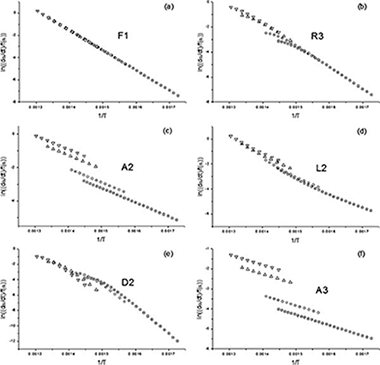
Background
This paper provides some clarifications regarding the use of model-fitting methods of kinetic analysis for estimating the activation energy of a process, in response to some results recently published in Chemistry Central journal.
Findings
The model fitting methods of Arrhenius and Savata are used to determine the activation energy of a single simulated curve. It is shown that most kinetic models correctly fit the data, each providing a different value for the activation energy. Therefore it is not really possible to determine the correct activation energy from a single non-isothermal curve. On the other hand, when a set of curves are recorded under different heating schedules are used, the correct kinetic parameters can be clearly discerned.
Conclusions
Here, it is shown that the activation energy and the kinetic model cannot be unambiguously determined from a single experimental curve recorded under non isothermal conditions. Thus, the use of a set of curves recorded under different heating schedules is mandatory if model-fitting methods are employed.
Febrero, 2013 | DOI: 10.1186/1752-153X-7-25
Reactividad de Sólidos
Comments on “Thermal decomposition of pyridoxine: an evolved gas analysis-ion attachment mass spectrometry study”. About the application of model-fitting methods of kinetic analysis to single non-isothermal curves
Sanchez-Jimenez, PE; Perez-Maqueda, LA; Perejon, A; Criado, JMRapid Communications in Mass Spectrometry, 27 (2013) 500-502
Reactividad de Sólidos
Mechanochemical synthesis of Sb2S3 and Bi2S3 nanoparticles
Dutkova, E; Takacs, L; Sayagues, MJ; Balaz, P; Kovac, J; Satka, AChemical Engineering Science, 85 (2013) 25-29
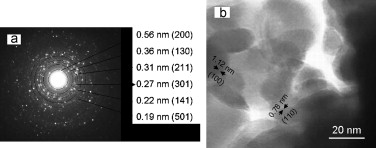
The mechanochemical synthesis of Sb2S3 and Bi2S3 nanoparticles has been studied, starting from the corresponding metals and sulfur and using high-energy mechanochemical processing in a planetary laboratory mill. XRD, specific surface area measurement, SEM and TEM (HRTEM) with ED were used for the characterization of the nanoparticles. The XRD patterns confirmed the production of Sb2S3 (JCPDS 42–1393, orthorhombic) and Bi2S3 (JCPDS 17–320, orthorhombic) nanopowders. The transformation is about three times faster in the Bi–S than in the Sb–S system. The kinetics of the reaction has been determined from XRD line intensities. The grain size is about 30 nm for Sb2S3 and 24 nm for Bi2S3. The particles are highly agglomerated due to their nanometer size consequent large specific surface area. Unlike more conventional methods, mechanochemical synthesis is a simple and fast alternative for the preparation of these nanopowders that can be carried out at ambient temperature and atmospheric pressure.
Enero, 2013 | DOI: 10.1016/j.ces.2012.02.028
Colour and ultrasound propagation speed changes by different ageing of freezing/thawing and cooling/heating in granitic materials
Inigo, AC; Garcia-Talegon, J; Vicente-Tavera, S; Martin-Gonzalez, S; Casado-Marin, S; Vargas-Munoz, M; Perez-Rodriguez, JLCold Regions Science and Technology, 85 (2013) 71-78
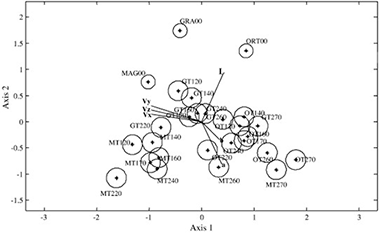
In the present work we determined the chromatic coordinates (L*, a*, b*) and ultrasound propagation speeds on the three spatial planes (Vx, Vy, Vz) of three ornamental granites (Aqueduct of Segovia, Spain) before, during, and after being subjected to 70 cycles of two types of accelerated ageing (typical of cold regions): a) freezing/thawing and cooling/heating (T1), and b) freezing/thawing and cooling/heating + salt crystallization (T2). A multivariate technique (Canonical Biplot) was applied to the data obtained, with the observation of significant variations between the two types of accelerated artificial ageing as compared with those obtained in quarry rock in the three chromatic coordinates (L*, a*, b*). With regard to the ultrasound propagation speed, we only detected differences in the results of the T2 artificial ageing treatment with respect to those of quarry rock. This fact is confirmed by the estimated data of resistance to compression.
Enero, 2013 | DOI: 10.1016/j.coldregions.2012.08.004
Reactividad de Sólidos
Influence of the milling parameters on the mechanical work intensity in planetary mills
Gotor, FJ; Achimovicova, M; Real, C; Balaz, PPowder Technology, 233 (2013) 1-7
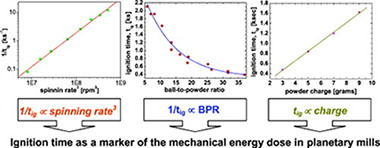
The formation of ZnSe via a mechanically-induced self-sustaining reaction (MSR) from a Zn/Se mixture showed that only size reduction and mixing of the reactants without product formation occurred during the induction period prior to ignition. Therefore, all mechanical energy supplied by the planetary mill during this time, called the ignition time (tig), was used exclusively in the activation of the reactants. This system was chosen to study the dependence of tig on the main parameters characterising the milling intensity of planetary mills. The variation of the ignition time with the process conditions reflected changes in the mechanical dose rate of the planetary mill. A direct relationship between the inverse of the ignition time and the power of the planetary mill was established, which allows the validation of theoretical models proposed in the literature for the energy transfer in milling devices and the comparison of milling equipment efficiencies.
Enero, 2013 | DOI: 10.1016/j.powtec.2012.08.031
Reactividad de Sólidos
Generalized master plots as a straightforward approach for determining the kinetic model: The case of cellulose pyrolysis
Sanchez-Jimenez, PE; Perez-Maqueda, LA; Perejon, A; Criado, JMThermochimica Acta, 552 (2013) 54-59
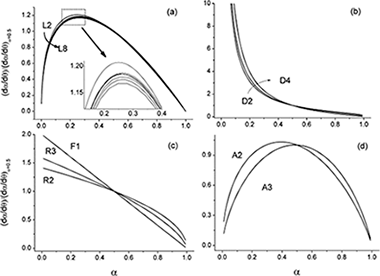
The thermal degradation of cellulose is a complex reaction and, despite the large amount of work by many investigators during the last decades, the actual understanding of the thermal decomposition kinetics is still very limited. Thus, while several mechanisms have been proposed to describe the process, the real model has not yet been clearly identified. In this paper, a set of experimental curves recorded under different heating schedules, i.e., linear heating rate, isothermal and constant rate thermal analysis (CRTA), has been analyzed using isoconversional and master plots methodology to discriminate the kinetic model followed by the reaction.
Enero, 2013 | DOI: 10.1016/j.tca.2012.11.003
2012
2012
Reactividad de Sólidos
Bulk TiCxN1−x–15%Co cermets obtained by direct spark plasma sintering of mechanochemical synthesized powders
Borrell, A; Salvador, MD; Rocha, VG; Fernandez, A; Aviles, MA; Gotor, FJMaterials Research Bulletin, 47 (2012) 4487-4490
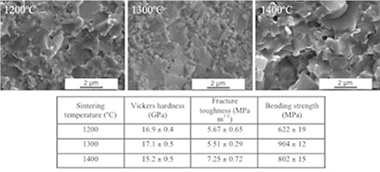
TiCxN1−x–15 wt.%Co cermets were obtained by a mechanically induced self-sustaining reaction (MSR) and sintered by spark plasma sintering (SPS) technique at different temperatures (1200–1400 °C) for 1 min in vacuum under a uniaxial load of 80 MPa. The evolution of microstructure and mechanical properties was investigated. SPS allowed high densification with limited grain growth at a relatively low temperature. Material sintered at 1300 °C showed a good combination of mechanical properties with Vickers hardness of 17.1 ± 0.5 GPa, fracture toughness of 5.51 ± 0.29 MPa m1/2 and bending strength of 904 ± 12 MPa. Lower sintering temperature resulted in a decrease in bending strength due to poor cohesion between the ceramic and binder phases. An increase in sintering temperature would allow tailoring the cermet microstructure and, therefore, adjusting the Vickers hardness/fracture toughness relation.
Diciembre, 2012 | DOI: 10.1016/j.materresbull.2012.09.066
Reactividad de Sólidos
Quantum-Mechanical Study on the Aquaions and Hydrolyzed Species of Po(IV), Te(IV), and Bi(III) in Water
Ayala, Regla; Manuel Martinez, Jose; Pappalardo, Rafael R.; Sanchez Marcos, EnriqueJournal of Physical Chemistry B, 116 (2012) 14903-14914
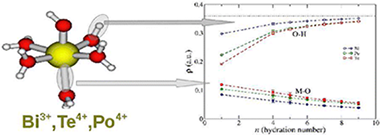
A systematic study of [M(H2O)n(OH)m]q+ complexes of Te(IV) and Bi(III) in solution has been undertaken by means of quantum mechanical calculations. The results have been compared with previous information obtained for the same type of Po(IV) complexes ( J. Phys. Chem. B 2009, 113, 487) to get insight into the similarities and differences among them from a theoretical view. The evolution of the coordination number (n + m) with the degree of hydrolysis (m) for the stable species shows a systematic decrease regardless the ion. A general behavior on the M–O distances when passing from the gas phase to solution, represented by the polarizable continuum model (PCM), is also observed: RM–O values corresponding to water molecules decrease, while those of the hydroxyl groups slightly increase. The hydration numbers of aquaions are between 8 and 9 for the three cations, whereas hydrolyzed species behave differently for Te(IV) and Po(IV) than for Bi(III), which shows a stronger trend to dehydrate with the hydrolysis. On the basis of the semicontinuum solvation model, the hydration Gibbs energies are −800 (exptl −834 kcal/mol), −1580 and −1490 kcal/mol for Bi(III), Te(IV), and Po(IV), respectively. Wave function analysis of M–O and O–H bonds along the complexes has been carried out by means of quantum theory of atoms in molecule (QTAIM). Values of electron density and its Laplacian at bond critical points show different behaviors among the cations in aquaions. An interesting conclusion of the QTAIM analysis is that the prospection of the water O–H bond is more sensitive than the M–O bond to the ion interaction. A global comparison of cation properties in solution supplies a picture where the Po(IV) behavior is between those of Te(IV) and Bi(III), but closer to the first one.
Diciembre, 2012 | DOI: 10.1021/jp309439f
Reactividad de Sólidos
Microcalorimetric study of the annealing hardening mechanism of a Cu–2.8Ni–1.4Si (at%) alloy
Donoso, E; Espinoza, R; Dianez, MJ; Criado, JMMaterials Science and Engineering: A, 556 (2012) 612-616
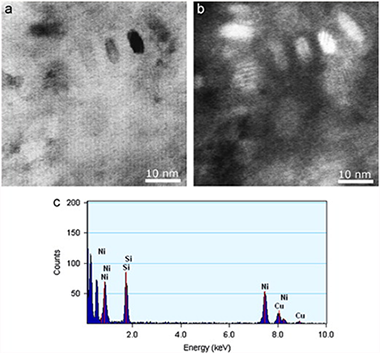
The precipitation processes in a Cu–2.8 at% Ni–1.4 at% Si alloy were studied using differential scanning calorimetry (DSC), transmission electron microscopy (TEM) and microhardeness measurements. The analysis of the calorimetric curves from room temperature to 900 K shows the presence of one exothermic reaction attributed to the formation of δ-Ni2Si particles in the copper matrix that was confirmed by Transmission Electron Microscopy (TEM) and EDS microanalysis. The activation energies calculated for the precipitation of δ-Ni2Si was lower than the ones corresponding to diffusion of nickel and silicon in copper. A correlation between of microhardness of the alloy and the formation of δ-Ni2Si particles has been found.
Octubre, 2012 | DOI: 10.1016/j.msea.2012.07.035
Reactividad de Sólidos
Mechanochemical synthesis and characterization of nanocrystalline BiSe, Bi 2Se 3 semiconductors
Achimovicova, M; Gotor, FJ; Real, C; Daneu, NJournal of Materials Science: Materials in Electronics, 23 (2012) 1844-1850
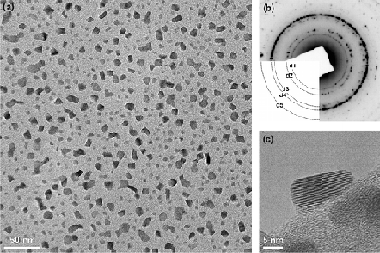
Mechanochemical synthesis of bismuth selenides (BiSe, Bi 2Se 3) was performed by high-energy milling of bismuth and selenium powders in a planetary ball mill. The particle size distribution and the specific surface area of Bi/Se and 2Bi/3Se powder mixtures were analysed at increasing milling time. The products were characterized by X-ray diffraction, differential scanning calorimetry and transmission electron microscopy. The presence of bismuth selenide phases was observed after only 1 min of milling and full conversion into hexagonal BiSe phase (nevskite) and rhombohedral Bi 2Se 3 phase (paraguanajuatite) was reached after 10 min of milling. The nanocrystalline nature of both mechanochemically synthesised bismuth selenides was confirmed and their optical band gap energies were obtained on the basis of the recorded absorption spectra in UV-Vis spectral region.
Octubre, 2012 | DOI: 10.1007/s10854-012-0672-2
Reactividad de Sólidos - Fotocatálisis Heterogénea: Aplicaciones
Obituary: Prof. Andrés Ortega
Luque, JMC; Martinez, FJG; Azana, MM; Perez, CRThermochimica Acta, 543 (2012) 318-319

Prof. Andrés Ortega passed away on last January after a painful and long illness. He was Professor of Inorganic Chemistry at the University of Seville (Spain) and was an outstanding researcher in the field of solid state reaction kinetics, an area to which he devoted his entire career since 1983, when he submitted his PhD thesis entitled ‘Critical study of non-isothermal methods for the kinetic analysis of solid-state reactions’. During his post doc stage and collaboration with Prof. Jean Rouquerol, his interest was raised by the Sample Controlled Thermal Analysis (SCTA) technique and its application to the kinetic study of solid state reactions, this latter one developed in Seville along with Prof. José Manuel Criado. A paper from this period should be highlighted: ‘Correlation between the shape of controlled-rate thermal analysis curves and the kinetics of solid-state reactions’ [Thermochimica Acta 157 (1990) 171], the most cited one in his research career. Most of his scientific production was published in Thermochimica Acta and in the Journal of Thermal Analysis and Calorimetry. A tireless professional, he remained active until a few weeks before dying. Being seriously ill he developed a method for the kinetic analysis of reactions with variable activation energies that notably simplifies the previous one proposed by Vyazovkin. The results were published in Thermochimica Acta under the title ‘A simple and precise linear integral method for isoconversional data’ [Thermochim. Acta 474 (2008) 81]. The high number of citations of this article – according to the ISI WEB of Knowledge – in spite of the short time elapsed since it was published reveals its impact within the scientific community.
He was also very much involved in teaching duties, developing new subjects and applying new teaching methodologies. He chaired two important academic positions at the University of Seville related to his works on teaching and educational sciences, as Director of the Institute of Educational Science and as Chairman of the Committee on Education of the University.
Though he sometimes appeared to be reserved, Andrés was a kind man, always ready to help in any problem that was presented to him. With a critical attitude and many cultural interests, he had a vast knowledge and a great ability to interpret the most diverse questions, frequently presenting a reasoning alternative to those commonly established. This was a continuous source of enrichment for both his friends and colleagues, who never will forget him.
Septiembre, 2012 | DOI: 10.1016/j.tca.2012.06.001
Reactividad de Sólidos
Microstructural Characterization of Silver Nanoparticles for Bioimaging Applications
Zaderenko, AP; Caro, C; de la Mata, M; Sanchez, JA; Sayagues, MJMicroscopy and Microanalysis, 18 (2012) 53-54
Silver nanoparticles are emerging as a powerful tool in bioimaging applications owing to their unique plasmonic properties i.e., extremely high molar extinction coefficients, resonant Rayleigh scattering and enhanced local electromagnetic fields. Through the optimization of these properties, by controlling composition, size, shape, and interparticle spacing of nanoparticles and their assemblies, highly enhanced local electromagnetic fields in the vicinity of nanoparticles are achievable giving rise to IR, Raman and fluorescence surface enhanced spectroscopies (SEIRS, SERS and MEF, respectively).
Agosto, 2012 | DOI: 10.1017/S1431927612012925
Reactividad de Sólidos
Microstructural Characterization of Silver Nanoparticles for Biomedical Applications
A. P. Zaderenkoa1, P. M. Castillo, M. de la Mata, M.J. Sayagués and J. A. SánchezMicroscopy and Microanalysis, 18 (2012) 55-56
There is a growing interest in nanoparticles as carriers of chemotherapeutic agents in order to improve their administration and minimize their side effects. Despite the fact that silver nanoparticles can be conjugated to therapeutic agents, offering additionally advantages due their unique and tunable optical properties, few examples have been described yet.
Agosto, 2012 | DOI: 10.1017/S1431927612012937
Reactividad de Sólidos
Synthesis of a TiCN–SiC polyhedron and elongated crystals nanopowder at low nitrogen concentration
Engstrom, A; Mouzon, J; Cordoba, JM; Tegman, R; Antti, MLMaterials Letters, 81 (2012) 148-150
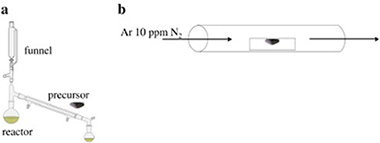
At room temperature diluted TiCl4 and CCl4 were reduced by sodium particles and mixed with a polycarbomethylsilane (PCS) solution to yield a precursor. It was dried and subsequently annealed at 1300 °C, 1400 °C and 1450 °C in a tube furnace using argon with 10 ppm N2. After the 1450 °C annealing a nanocrystalline powder of TiC0.5N0.5–SiC polyhedron and elongated crystals was obtained. At the low nitrogen concentration during annealing a gradual nitration is proposed. It is promoted by carbon gaseous species, precursor oxidation, a sufficient temperature and a summarised nitrogen surplus compared to the titanium and carbon amount.
Agosto, 2012 | DOI: 10.1016/j.matlet.2012.04.071
Reactividad de Sólidos
Mechanochemical Synthesis and Characterization of II-VI Nanocrystals: Challenge for Cytotoxicity Issues
Balaz, P; Jardin, R; Dutkova, E; Sayagues, MJ; Balaz, M; Mojzisova, G; Mojzis, J; Turianicova, E; Fabian, MActa Physica Polonica A, 122 (2012) 224-229
CdSe@ZnS nanocrystals have been prepared by a two-step solid state mechanochemical synthesis. CdSe prepared from elements in the first step is mixed with ZnS synthesized from zinc acetate and sodium sulfide in the second step. The crystallite size of the new type CdSe@ZnS nanocrystals determined by X-ray diffraction Rietveld refined method was 35 nra and 10 Jam for CdSe and ZnS, respectively. Energy dispersive/transmission electron microscopy/energy dispersive spectroscopy methods show good crystallinity of the nanoparticles and scanning electron microscopy elemental mapping illustrate consistent distribution of Cd, Se, Zn and S elements in the bulk of samples. UV-VIS spectra show an onset at 320 urn with calculated bandgap 3.85 eV. This absorption arises from the vibration modes of Zn-S bonds. The nanocrystals show the blue shift from the bandgap of bulk ZnS (3.66 eV). The synthesized CdSe@ZnS nanocrystals have been tested for dissolution, cytotoxicity and L-cysteine conjugation. The dissolution of Cd was less than 0.05 mu g mL(-1) (in comparison with 0.8 mu g mL(-1) which was evidenced for CdSe alone). The very low cytotoxic activity for selected cancer cell lines has been evidenced. CdSe@ZnS nanocrystals coated with L-cysteine are water-soluble and have a great potential in biomedical engineering as fluorescent labels.
Julio, 2012 | DOI: ---
Reactividad de Sólidos
In Situ Synthesis of Ceramic Composite Materials in the Ti-B-C-N System by a Mechanically Induced Self-Sustaining Reaction
Aviles, MA; Chicardi, E; Cordoba, JM; Sayagues, MJ; Gotor, FJJournal of the American Ceramic Society, 95 (2012) 2133-2139
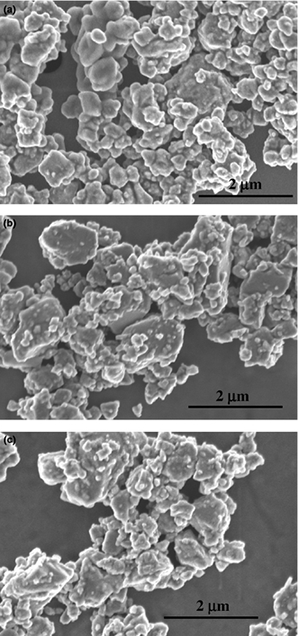
The synthesis of multicomponent ceramic materials in the titanium-diboride-carbide-nitride-carbonitride system by the mechanochemical process known as the mechanically induced self-sustaining reaction (MSR) was investigated. Ceramic composite powders containing TiB 2and TiC, TiN or TiC xN 1-xwere prepared from a blended mixture of the elements by exploiting the highly exothermic nature of the formation reactions. The synthesis of the composite materials was made possible by the ability of the MSR to simultaneously induce independent self-sustaining reactions, generating a mixture of ceramic phases. The composition of the ceramic composites was designed using the initial atomic ratio of the reactants, and the achieved microstructure was characterized by TiB 2particles in the micrometric range, surrounded by submicrometric and nanometric TiC, TiN, or TiC xN 1-xcrystals.
Julio, 2012 | DOI: 10.1111/j.1551-2916.2012.05174.x
Reactividad de Sólidos
Absence of the core-rim microstructure in TixTa1-xCyN1-y-based cermets developed from a pre-sintered carbonitride master alloy
Chicardi, E; Cordoba, JM; Sayagues, MJ; Gotor, FJInternational Journal of Refractory Metals & Hard Materials, 33 (2012) 38-43
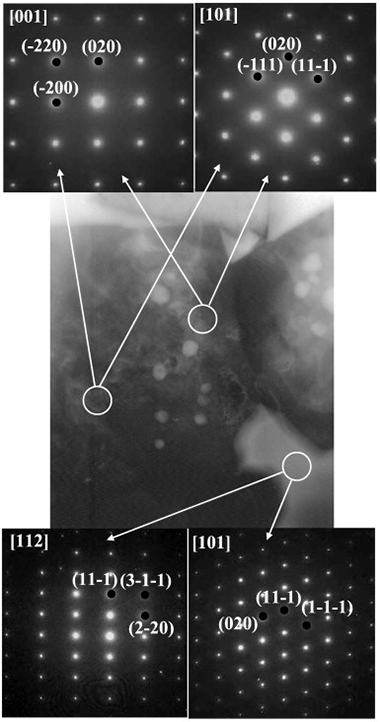
(Ti,Ta)(C,N) solid solution-based cermets with cobalt as the binder phase were synthesised by a two-step milling process. The titanium-tantalum carbonitride solid solution (the ceramic phase) was obtained via a mechanically induced self-sustaining reaction (MSR) process from stoichiometric elemental Ti, Ta, and graphite powder blends in a nitrogen atmosphere. Elemental Co (the binder phase) was added to the ceramic phase, and the mixture was homogenised by mechanical milling (MM). The powdered cermet was then sintered in a tubular furnace at temperatures ranging from 1400°C to 1600°C in an inert atmosphere. The chemical composition and microstructure of the sintered cermets were characterised as ceramic particles grown via a coalescence process and embedded in a complex (Ti,Ta)-Co intermetallic matrix. The absence of the typical core-rim microstructure was confirmed.
Julio, 2012 | DOI: 10.1016/j.ijrmhm.2012.02.005
Reactividad de Sólidos
Rapid carbothermic synthesis of silicon carbide nano powders by using microwave heating
Moshtaghioun, BM; Poyato, R; Cumbrera, FL; de Bernardi-Martin, S; Monshi, A; Abbasi, MH; Karimzadeh, F; Dominguez-Rodriguez, AJournal of the European Ceramic Society, 32 (2012) 1787-1794
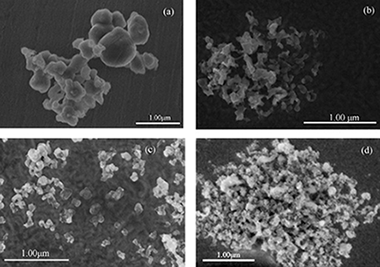
This paper reports an improved procedure for synthesis of silicon carbide nanopowders from silica by carbothermic reduction under fast microwave-induced heating. The powders have been prepared by direct solid-state reaction in a 2.45 GHz microwave field in nitrogen atmosphere after 40 h milling. For the first time, the formation of silicon carbide (beta-SiC) as a major phase can be achieved at 1200 degrees C in 5 min of microwave exposure, resulting in nano sized particles ranging from 10 to 40 nm under optimized synthesis condition. The Rietveld quantitative phase-composition analysis confirmed that the major SiC polytype is cubic SiC (beta-SiC) with 98.5(4) weight fraction and the remained is minor hexagonal SiC polytypic (alpha-SiC) phases. Therefore this method is the most efficient one for SiC powder synthesis in terms of energy and time saving as well as preparation of SiC nano powders.
Julio, 2012 | DOI: 10.1016/j.jeurceramsoc.2011.12.021
Reactividad de Sólidos - Propiedades mecánicas, modelización y caracterización de cerámicos avanzados
Processing of Swnt-Reinforced Yttria Stabilized Zirconia by Spark Plasma Sintering and Microstructure Characterization
S. de Bernardi-Martín, R. Poyato, Diego Gómez García, Arturo Domínguez-RodríguezJournal of Nano Research, 18-19 (2012) 317-323
Single wall carbon nanotube reinforced yttria stabilized zirconia ceramic materials have been obtained by means of spark plasma sintering technique. Single wall carbon nanotubes were treated in an acid solution before mixing with zirconia powders to obtain a uniform distribution of both powders. This method allows obtaining ceramic materials with a grain size between 200 nanometers and 1 micron and with a grain size distribution which depends on processing conditions. This new route opens a new perspective for new ceramic composites tailoring with enhanced mechanical properties as structural materials
Julio, 2012 | DOI: 10.4028/www.scientific.net/JNanoR.18-19.317
Reactividad de Sólidos
Enhancement of Fast CO2 Capture by a Nano-SiO2/CaO Composite at Ca-Looping Conditions
Valverde, JM; Perejon, A; Perez-Maqueda, LAEnvironmental Science and Technology, 46 (2012) 6401-6408

In this paper we show the performance of a new CO 2 sorbent consisting of a dry physical mixture of a Ca-based sorbent and a SiO 2 nanostructured powder. Thermo-gravimetric analysis (TGA) performed at conditions close to the Ca-looping process demonstrate that the rate of CO 2 capture by the mixture is enhanced during the fast carbonation stage of practical interest in applications. Moreover, the residual capture capacity of the mixture is increased. SEM/EDX, physisorption, and XRD analyses indicate that there is a relevant interaction between the nanostructured SiO 2 skeleton and CaO at high temperatures, which serves to improve the efficiency of the transfer of CO 2 to small reactive pores as well as the stability of the sorbent pore structure.
Junio, 2012 | DOI: 10.1021/es3002426
Reactividad de Sólidos
Development of multicomponent-multiphase materials based on (Ti,Ta,Nb)CxN1-x carbonitride solid solutions
Cordoba, JM; Chicardi, E; Gotor, FJChemical Engineering Journal, 192 (2012) 58-66

A set of powdered cermets based on (Ti,Ta,Nb)C xN 1-x carbonitride solid solutions were synthesized from mixtures of elemental powders by a mechanically induced self-sustaining reaction (MSR) method and subsequently sintered using a pressureless method. Differing nominal compositions of the hard phase were used, and the nature of the metallic-binder phase (Co, Ni, or Co-Ni) was varied. For comparative purposes, the design of the material was performed using two different synthesis pathways. The composition and microstructure of the ceramic and binder phases before and after sintering were analyzed and related to the microhardness of the material, which was found to increase with increasing contiguity of the hard phase and with decreasing particle size.The samples synthesized in one step (SERIES 2) showed higher microhardness and a more homogeneous microstructure with smaller particle size of the hard phase due to the presence of Ti, Ta, and Nb in the molten binder that hindered ceramic growth during liquid phase sintering.
Junio, 2012 | DOI: 10.1016/j.cej.2012.03.046
Reactividad de Sólidos
Spark plasma sintering of Ti yNb 1-yC xN 1-x monolithic ceramics obtained by mechanically induced self-sustaining reaction
Borrell, A; Salvador, MD; Garcia-Rocha, V; Fernandez, A; Chicardi, E; Gotor, FJMaterials Science and Engineering A, 543 (2012) 173-179

Nanometer-sized titanium-niobium carbonitride powders (Ti yNb 1-yC xN 1-x) with different Ti/Nb atomic ratios were obtained by a mechanically induced self-sustaining reaction, and sintered by spark plasma sintering technique at 1500°C for 1min in a vacuum atmosphere. Mechanical properties such as hardness and Young's modulus were determined by nanoindentation technique and friction and wear coefficients assessed by ball-on-disk testing using alumina ball in dry sliding conditions. The fracture surface and wear tracks of samples were examined by scanning electron microscopy. Results showed that it is possible to obtain dense monolithic ceramics from the solid solution (Ti yNb 1-yC xN 1-x) with good mechanical properties and excellent wear resistance. The optimum values of nanomechanical properties were found for the Ti 0.3Nb 0.7C 0.5N 0.5 ceramic composition, which exhibited a high hardness over 26.0GPa and Young's modulus around 400GPa.
Mayo, 2012 | DOI: 10.1016/j.msea.2012.02.071
Reactividad de Sólidos
Nanoclay Nucleation Effect in the Thermal Stabilization of a Polymer Nanocomposite: A Kinetic Mechanism Change
Sanchez-Jimenez, PE; Perez-Maqueda, LA; Perejon, A; Criado, JMJournal of Physical Chemistry C, 116 (2012) 11797-11807

The enhanced thermal stability of polymer-clay nanocomposites over the original polymers is one of their most interesting features, and it has been profusely studied within the last decades. Here, a thorough kinetic analysis of polystyrene and a montmorillonite-polystyrene nanocomposite has been performed making use of state-of-the-art kinetic procedures. It has been found that the degradation mechanism changes from a chain scission process for the polymer to a complex two-step nucleation-driven reaction for the nanocomposite. This mechanism change can explain the delayed onset of degradation found in the nanocomposite. Moreover, observation by transmission electron microscopy (TEM) has shown that the clay platelets within the composite could act as nucleation centers for the decomposition.
Mayo, 2012 | DOI: 10.1021/jp302466p
Reactividad de Sólidos
Room temperature mechanosynthesis of the La 1-xSr xMnO 3±δ (0≤x≤1) system and microstructural study
Sayagues, MJ; Cordoba, JM; Gotor, FJJournal of Solid State Chemistry, 188 (2012) 11-16

Monophase nanocrystalline powders belonging to the La1−xSrxMnO3±δ system (0≤x≤1) with a perovskite structure have been obtained by mechanochemistry synthesis using a planetary ball milling equipment from La2O3, SrO, and Mn2O3 mixtures. The solid state reaction was complete after one hour of milling treatment. For all the compositional range, the diffraction domain was very small and the structure appeared as a pseudo cubic perovskite. After annealing at 1100 °C under static air, the symmetry evolution due to the La substitution by Sr was analyzed by X-ray and electron diffraction. Samples with x=0, 0.25, 0.5, and 0.75 were assigned to R-3c space group (1 6 7) in the rhombohedral system and perovskite structure. However, the symmetry of the last term of the system (x=1), SrMnO3±δ sample, changed to P63/mmc space group (1 9 4) in the hexagonal system. The terms with x=0.8, 0.85, and 0.9 presented mainly rhombohedral symmetry.
Abril, 2012 | DOI: 10.1016/j.jssc.2012.01.018
Sonication induced reduction of the Ojen (Andalucia, Spain) vermiculite under air and under nitrogen
Poyato, J; Perez-Rodriguez, JL; Lerf, A; Wagner, FEUltrasonics Sonochemistry, 19 (2012) 373-375
Reactividad de Sólidos - Química de Superficies y Catálisis
Nanostructured Spark Plasma Sintered Ce-TZP Ceramics
Cruz, SA; Poyato, R; Cumbrera, FL; Odriozola, JAJournal of the American Ceramic Society, 95 (2012) 901-906
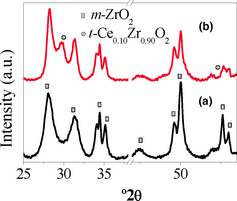
In this work, spark plasma sintering (SPS) of 10 mol% CeO 2-doped ZrO 2 nanocrystalline powders, obtained by a two-step synthesis procedure, allows the preparation of fully densified nanostructured ceramics. The CeO 2-ZrO 2 powders with particle size below 100 nm are obtained after CeO 2 deposition on hydrothermally synthesized ZrO 2 particles by the impregnation method. Tetragonal CeO 2-ZrO 2 ceramics are obtained when sintering at 1200°C without holding time. A graded material containing tetragonal, monoclinic, and pyrochlore phases are obtained when sintering at 1200°C and for 5 min holding time. This is explained in terms of the gradual reduction of Ce 4+ to Ce 3+ species by carbon in the graphite environment during SPS. With the successful combination of the stabilizer coating technique and SPS, we achieve not only the stabilization of the tetragonal phase in the ceramics, but also good control of the grain size, by producing nanostructured ceramics with 40-70 nm grain sizes.
Marzo, 2012 | DOI: 10.1111/j.1551-2916.2011.04978.x
Reactividad de Sólidos
Inverse core-rim microstructure in (Ti,Ta)(C,N)-based cermets developed by a mechanically induced self-sustaining reaction
Chicardi, E; Cordoba, JM; Sayagues, MJ; Gotor, FJInternational Journal of Refractory Metals & Hard Materials, 31 (2012) 39-46
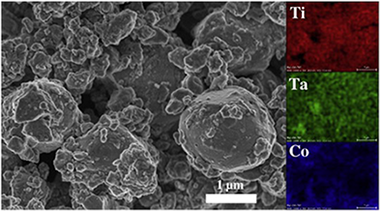
Cermets with a nominal composition (Tia(0.8)Ta(0.2)C(0.5)N(0.5)-20 wt.% Co) were synthesised by a mechanically induced self-sustaining reaction (MSR) process from stoichiometric elemental powder blends. The MSR allowed the production of a complex (Ti,Ta)(C,N) solid solution, which was the raw material used for the sintering process. The pressureless sintering process was performed at temperatures between 1400 degrees C and 1600 degrees C in an inert atmosphere. The microstructural characterisation showed a complex microstructure composed of a ceramic phase with an unusual inverse core-rim structure and a Ti-Ta-Co intermetallic phase that acted as the binder.
Marzo, 2012 | DOI: 10.1016/j.ijrmhm.2011.09.003
Reactividad de Sólidos
Thermal behaviour of ground and unground acid leached vermiculite
Perez-Maqueda, LA; Maqueda, C; Perez-Rodriguez, JL; Subrt, J; Cerny, Z; Balek, VJournal of Thermal Analysis and Calorimetry, 107 (2012) 431-438
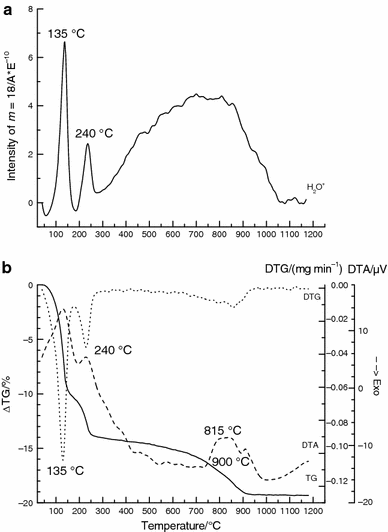
Acid leaching of vermiculite is an interesting procedure to prepare high surface area porous silica. Thermal behaviour of unground and ground vermiculite leached with HCl solutions has been studied by TG, DTA, ETA and high temperature XRD. Important differences have been observed in the thermal behaviour of unground and ground vermiculite after the acid treatments. Thus, for the acid-treated unground vermiculite, dehydrated vermiculite, enstatite and cristobalite were formed during the heating, while for the acid-treated ground vermiculite only iron oxides and cristobalite phases were observed. Structural modifications due to acid treatment were responsible for changes in the transport properties determined by ETA for the vermiculite samples.
Febrero, 2012 | DOI: 10.1007/s10973-011-1480-2
XRF, μ-XRD and μ-spectroscopic techniques for revealing the composition and structure of paint layers on polychrome sculptures after multiple restorations
Franquelo, ML; Duran, A; Castaing, J; Arquillo, D; Perez-Rodriguez, JLTalanta, 89 (2012) 462-469
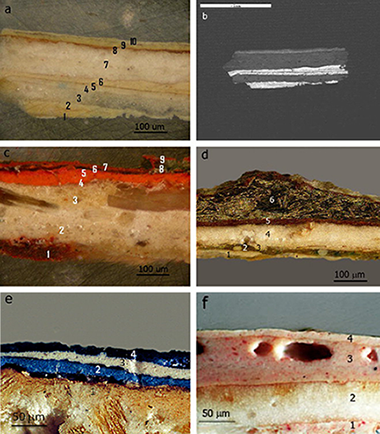
This paper presents the novel application of recently developed analytical techniques to the study of paint layers on sculptures that have been restored/repainted several times across centuries. Analyses were performed using portable XRF, μ-XRD and μ-Raman instruments. Other techniques, such as optical microscopy, SEM-EDX and μ-FTIR, were also used. Pigments and other materials including vermilion, minium, red lac, ivory black, lead white, barium white, zinc white (zincite), titanium white (rutile and anatase), lithopone, gold and brass were detected. Pigments from both ancient and modern times were found due to the different restorations/repaintings carried out. μ-Raman was very useful to characterise some pigments that were difficult to determine by μ-XRD. In some cases, pigments identification was only possible by combining results from the different analytical techniques used in this work. This work is the first article devoted to the study of sculpture cross-section samples using laboratory-made μ-XRD systems.
Enero, 2012 | DOI: 10.1016/j.talanta.2011.12.063
Reactividad de Sólidos
Non-isothermal microcalorimetric evaluations in quenched and in cold-rolled Cu-9Ni-5.5Sn alloys
Donoso, E; Dianez, MJ; Criado, JMRevista de Metalurgia, 48 (2012) 67-75
The thermal aging of both a quenched and a cold rolled homogeneous supersaturated Cu-9 % wt Ni-5.5 wt % Sn alloy has been studied from differential scanning calorimetry (DSC) and microhardness measurements. An increase of the hardness during the aging of the quenched sample, because of the precipitation of a γ' phase, takes place. On the contrary, no hardness increase was observed during the aging of the cold rolled sample. A theoretical analysis of the enthalpy determined from the first DSC exothermic peak suggests that a segregation of the solute towards the dislocations occurs during the aging of the cold rolled alloy. The values of the n Avrami-Erofeev coefficients estimated from the kinetic analysis supports the above interpretations.
Enero, 2012 | DOI: 10.3989/revmetalm.1136
Analysis of the restoration of an historical organ: The case study of the Cavaillé-Coll organ of La Merced Church in Burgos, Spain
Justo-Estebaranz, A; Herrera, LK; Duran, A; Siguenza, B; de Haro, MCJ; Laguna, O; Justo, AStudies in Conservation, 57 (2012) 21-28
The restoration of the Cavaille-Coll Romantic organ housed in La Merced Church of Burgos, Spain is described in this paper. The organ was affected by a fire that took place in the church. The effect of the fire on the pipes differed depending on their location within the instrument. A combination of analytical techniques (X-ray diffraction, scanning electron microscopy with energy-dispersive X-ray analysis, particle-induced X-ray emission, metallography, and specific density) allowed the accurate determination of the microstructures and compositions of the alloys used to make the different pipes of the organ, some of which had a high tin content and others which had a high lead content. The most damaged pipes were replaced by reconstructed pipes made out of metallic sheets of the same composition as the originals, to ensure a historically accurate sound.
Enero, 2012 | DOI: 10.1179/2047058411Y.0000000001
Degradation of Two Historic Buildings in Northern Spain by Formation of Oxalate and Sulphate-Based Compounds
Duran, A; Robador, MD; Perez-Rodriguez, JLInternational Journal of Architectural Heritage, 6 (2012) 342-358
This study focused on the degradation processes for two historic buildings, one in a rural and one in an urban environment. Samples collected from the Romanesque Church of Torme and from two areas of the Cathedral of Burgos were studied by using optical and electron microscopy, x-ray spectrometry, x-ray diffraction, Fourier transform infrared spectroscopy and thermal analysis (TG/DTA/DTG). As result of the action of microorganisms, weddellite and whewellite were found to have formed over the entire external walls of the Church of Torme, built with dolomitic rock. Gypsum, formed by the effects of atmospheric pollution, appeared on lime plasters applied as protective coatings on the external stones of Burgos' Cathedral. Also discussed in this study is the different composition of these plasters, based on the use of calcareous and siliceous aggregates.
Enero, 2012 | DOI: 10.1080/15583058.2010.551447
Reactividad de Sólidos
Characterisation of ternary TixV1-xNy nitride prepared by mechanosynthesis
Roldan, MA; Alcala, MD; Real, CCeramics Intenational, 38 (2012) 687-693
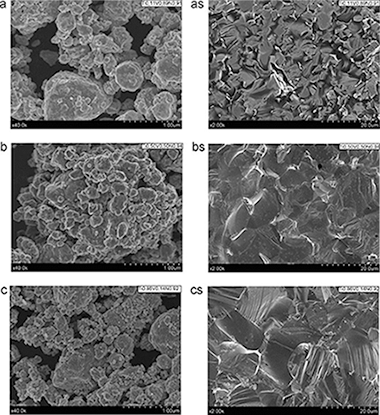
In the present manuscript the authors have systematically investigated the composition and microstructure of a series of ternary nitrides (TixV1-xNy) (0.0 <= x <= 1.0) prepared by mechanosynthesis, using XRD, SEM, EELS, XAS and TGA. The ternary titanium-vanadium nitride (TixV1-xNy) has been obtained in all range of compositions by the mechanical treatment of the two metals under nitrogen pressure in a planetary mill with a maximum milling time of 3 h and without any post-heating treatment. The materials' microhardnesses were measured after sinterisation and compared to those reported in the literature for these types of materials. When compared with the previously reported data for bulk samples, these values are similar or higher for compositions within the range x = 0.5 to x = 0.77 (TixV1-xN).
Enero, 2012 | DOI: 10.1016/j.ceramint.2011.07.057
2011
2011
Reactividad de Sólidos
An improved model for the kinetic description of the thermal degradation of cellulose
Sanchez-Jimenez, PE; Perez-Maqueda, LA; Perejon, A; Pascual-Cosp, J; Benitez-Guerrero, M; Criado, JMCellulose, 18 (2011) 1487-1498
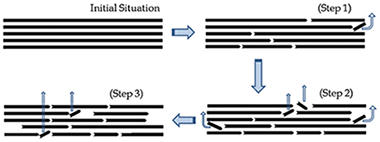
In spite of the large amount of work performed by many investigators during last decade, the actual understanding of the kinetics of thermal degradation of cellulose is still largely unexplained. In this paper, recent findings suggesting a nucleation and growth of nuclei mechanism as the main step of cellulose degradation have been reassessed and a more appropriate model involving chain scission and volatilization of fragments has been proposed instead. The kinetics of cellulose pyrolysis have been revisited by making use of a novel kinetic method that, without any previous assumptions regarding the kinetic model, allows performing the kinetic analysis of a set of experimental curves recorded under different heating schedules. The kinetic parameters and kinetic model obtained allows for the reconstruction of the whole set of experimental TG curves.
Diciembre, 2011 | DOI: 10.1007/s10570-011-9602-3
Compositional and Quantitative Microtextural Characterization of Historic Paintings by Micro-X-ray Diffraction and Raman Microscopy
Julia Romero-Pastor, Adrian Duran, Alejandro Basilio Rodríguez-Navarro, René Van Grieken, Carolina CardellAnalytical Chemistry, 83 (2011) 8420-8428

This work shows the benefits of characterizing historic paintings via compositional and microtextural data from micro-X-ray diffraction (μ-XRD) combined with molecular information acquired with Raman microscopy (RM) along depth profiles in paint stratigraphies. The novel approach was applied to identify inorganic and organic components from paintings placed at the 14th century Islamic University—Madrasah Yusufiyya—in Granada (Spain), the only Islamic University still standing from the time of Al-Andalus (Islamic Spain). The use of μ-XRD to obtain quantitative microtextural information of crystalline phases provided by two-dimensional diffraction patterns to recognize pigments nature and manufacture, and decay processes in complex paint cross sections, has not been reported yet. A simple Nasrid (14th century) palette made of gypsum, vermilion, and azurite mixed with glue was identified in polychromed stuccos. Here also a Christian intervention was found via the use of smalt, barite, hematite, Brunswick green and gold; oil was the binding media employed. On mural paintings and wood ceilings, more complex palettes dated to the 19th century were found, made of gypsum, anhydrite, barite, dolomite, calcite, lead white, hematite, minium, synthetic ultramarine blue, and black carbon. The identified binders were glue, egg yolk, and oil.
Noviembre, 2011 | DOI: 10.1021/ac201159e
Química de Superficies y Catálisis
Influence of Al2O3 reinforcement on precipitation kinetic of Cu–Cr nanocomposite
S. Sheibani, A. Ataie, S. Heshmati-Manesh, A. Caballero, J.M. CriadoThermochimica Acta, 526 (2011) 222-228
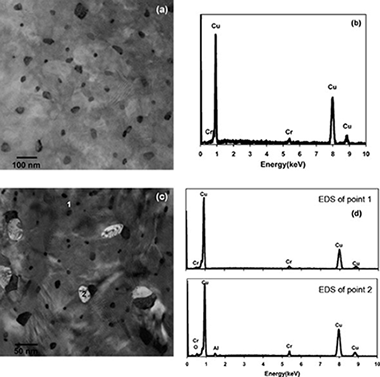
In this paper, the kinetic of precipitation process in mechanically alloyed Cu-1 wt.% Cr and Cu-1 wt.% Cr/3 wt.% Al2O3 solid solution was compared using differential scanning calorimetry (DSC), X-ray diffraction (XRD) and transmission electron microscopy (TEM). The ageing kinetics in Cu–Cr and Cu–Cr/Al2O3 can be described using Johnson–Mehl–Avrami (JMA) and Sestak–Berggren (SB) models, respectively. These different behaviors have been discussed in details. It was found that in presence of Al2O3 reinforcement, the ageing activation energy is decreased and the overall ageing process is accelerated. This behavior is probably due to higher dislocation density previously obtained during ball milling and Al2O3–Cu interface. TEM observations confirm that Al2O3–Cu interface and structural defects act as a primary and secondary nucleation sites, respectively.
Noviembre, 2011 | DOI: 10.1016/j.tca.2011.09.024
Reactividad de Sólidos
Formation of the complete range of Ti5Si3-xGex solid solutions via mechanically induced self-sustained reactions
José M. Córdoba, Ernesto Chicardi, Miguel A. Avilés, Francisco J. GotorIntermetallics, 19 (2011) 1688-1692
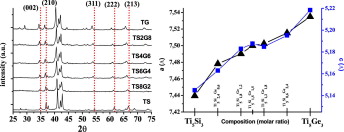
The complete range of Ti5Si3–Ti5Ge3 solid solutions was synthesised from elemental mixtures of Ti, Si, and Ge under an inert atmosphere via mechanically induced self-sustaining reactions (MSR). The stoichiometry of Ti5Si3−xGex solid solutions was controlled by adjusting the Si/Ge ratio of the initial mixture. The chemical composition and lattice parameters of the materials confirmed that Ti5Si3–Ti5Ge3 solid solutions with good chemical homogeneity could be produced via MSR.
Noviembre, 2011 | DOI: 10.1016/j.intermet.2011.07.005
Old and modern pigments identification from a 14th century sculpture by Micro-Raman
M. L. Franquelo, A. Duran, D. Arquillo & J. L. Perez-RodriguezSpectroscopy Letters, 44 (2011) 464-468
The chromatic characterization of the external part of the sculpture showed homogeneity values in the majority of the colored zones. The optical microscopy study showed different layers in the painting cross-sections. The complex polychromy was attributed to several restoration processes carried out along the time. The composition of the different layers of painting cross-sections was studied using the micro-Raman technique. The micro-Raman technique was very useful in characterizing some pigments that are difficult to determine by other experimental techniques. The study showed the presence of several pigments that had been applied in ancient and recent times.
Octubre, 2011 | DOI: 10.1080/00387010.2011.610401
Analytical study of Roman and Arabic wall paintings in the Patio De Banderas of Reales Alcazares' Palace using non-destructive XRD/XRF and complementary techniques
Duran, A., Perez-Rodriguez, J.L., Jimenez de Haro, M.C., Franquelo, M.L., Robador, M.D.Journal of Archaeological Science, 38 (2011) 2366-2377
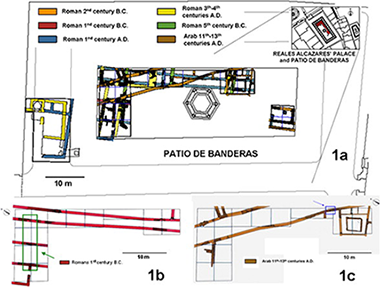
A portable XRD/XRF system and complementary laboratory techniques were employed to improve the knowledge of the procedures used to create Roman and Arabic wall paintings. Integrated physico-chemical investigations were conducted on fragments of artworks collected from the archaeological excavation of the Patio de Banderas in the Reales Alcazares' Palace of Seville (Spain), and a comparative study on the pigments from both historical periods was performed. As a result, pigments such as vermilion, red ochre, yellow ochre, green earth, Egyptian blue, carbon and phosphor-based black pigments were detected in Roman samples; however, in the Arabic fragments, only haematite was observed. In addition, the size and shape of the particles of the wall paintings were studied with an XRD 2-dimensional detector and SEM-EDX.
Septiembre, 2011 | DOI: 10.1016/j.jas.2011.04.021
Reactividad de Sólidos
Mechanochemical synthesis of Ti1−xZrxB2 and Ti1−xHfxB2 solid solutions
M.A. Avilés, J.M. Córdoba, M.J. Sayagués and F.J. GotorCeramics International, 37 (2011) 1895-1904
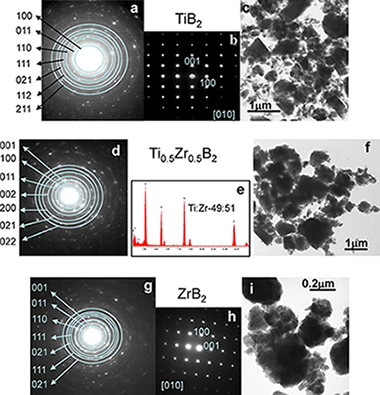
Solid solutions of TiB2-ZrB2 and TiB 2-HfB2 were obtained under an inert atmosphere by high-energy ball-milling mixtures of Ti/Zr/B and Ti/Hf/B, respectively. Milling promoted mechanically induced self-sustaining reactions (MSR), and the ignition time was dependent on the initial composition of the mixture. The stoichiometry of Ti1-xZrxB2 and Ti1-xHf xB2 solid solutions was controlled by adjusting the atomic ratio of the reactants. The solid solutions were characterised by X-ray diffraction, transmission electron microscopy, electron diffraction, and energy dispersive X-ray spectroscopy. The results revealed that TiB2- ZrB2 possessed a nanometric microstructure and good chemical homogeneity. However, in the TiB2-HfB2 system, an inhomogeneous solid solution was obtained when a Ti-rich mixture was employed. The solid solutions showed good thermal stability; thus, can be used as raw materials for the development of technological materials for structural applications.
Agosto, 2011 | DOI: 10.1016/j.ceramint.2011.02.004
Characterization of materials and conservation process of the collection of Arabic manuscript documents of granada archive histórico-provincial
T. Espejo Arias, I. Lazarova Stoytcheva, D. Campillo García, A. Durán Benito, A. Jiménez de HaroAl-Qantara, 32 (2011) 519-532
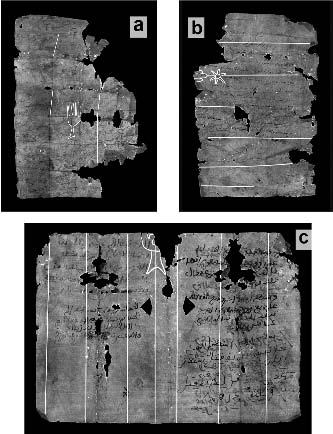
This paper presents the main conclusions of our study of the Arabic documents preserved in the Archivo Histórico Provincial of Granada. The analysis of the contents of each document, the materials and inks used in their support, and also the similarities of the page layout reveals the use of identical production protocols. Furthermore, this research also enables us to establish important similarities between the paper production processes in the latter stages of the Islamic rule in the Iberian Peninsula and the earlier stages of its incorporation in the Crown of Castilla - in particular in relation to how the archival documents were issued, both externally and internally.
Julio, 2011 | DOI:
Natural earth pigments from Roman and Arabic wall paintings revealed by spectroscopic techniques
Garofano, I., Duran, A., Perez-Rodriguez, J.L., Robador, M.D.Spectroscopy Letters, 44 (2011) 560-565
Full identification of pigments used in wall paintings by Romans and Arabs that were recently discovered was achieved by the combined application of several spectroscopy methods. Identification of pigments was provided by the use of micro-Raman and FT-IR spectroscopy, while UV-Visible spectroscopy and chromatic studies permitted the authors to identify slight variations of hue attributed to mixtures of pigments. Natural earths and minerals were detected as the main pigments employed by both civilizations, although some differences were found between them. Red ochre, vermilion, yellow ochre, Egyptian blue, green earth, calcite, carbon, and possibly ivory blacks were identified in the Roman paintings. Only hematite and calcite were observed in the Arabic fragments.
Junio, 2011 | DOI: 10.1080/00387010.2011.610655
Reactividad de Sólidos
Thermal study of unaltered and altered dolomitic rock samples from ancient monuments - The case of Villarcayo de Merindad de Castilla la Vieja (Burgos, Spain)
Perez-Rodriguez, JL; Duran, A; Perez-Maqueda, LAJournal of Thermal Analysis and Calorimetry, 104 (2011) 467-474
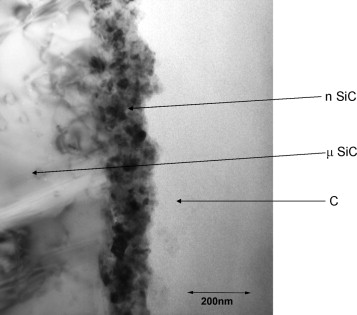
In this study, the decomposition behaviour of unaltered and altered dolomitic rock samples used in Cultural Heritage buildings was studied by simultaneous TG-DTA experiments at different atmospheres, X-ray diffraction in a high-temperature chamber, and evolved gas analysis. The components of dolomite rock samples and hydrated calcium oxalate formed during the alteration processes of the rocks were characterized, and the decomposition mechanisms of these components were determined. The TG-DTA experiments carried out at CO2 atmosphere were used to determine the carbonate compounds in the rock samples. The TG-DTA study characterized the presence of organic compounds formed during the biological degradation of the rock samples, possibly responsible of the hydrated calcium oxalate formation.
Junio, 2011 | DOI: 10.1007/s10973-011-1348-5
Reactividad de Sólidos
ICTAC Kinetics Committee recommendations for performing kinetic computations on thermal analysis data
Vyazovkin, S., Burnham, A.K., Criado, J.M., Pérez-Maqueda, L.A., Popescu, C., Sbirrazzuoli, N.Thermochimica Acta, 520 (2011) 1-19
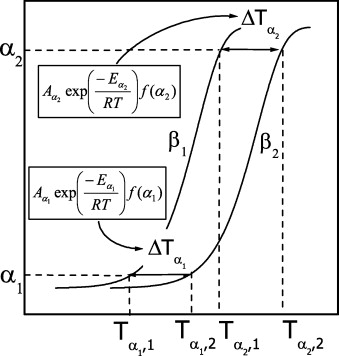
The present recommendations have been developed by the Kinetics Committee of the International Confederation for Thermal Analysis and Calorimetry (ICTAC). The recommendations offer guidance for reliable evaluation of kinetic parameters (the activation energy, the pre-exponential factor, and the reaction model) from the data obtained by means of thermal analysis methods such as thermogravimetry (TGA), differential scanning calorimetry (DSC), and differential thermal analysis (DTA). The recommendations cover the most common kinetic methods, model-free (isoconversional) as well as model-fitting. The focus is on the problems faced by various kinetic methods and on the ways how these problems can be resolved. Recommendations on making reliable kinetic predictions are also provided. The objective of these recommendations is to help a non-expert with efficiently performing analysis and interpreting its results.
Junio, 2011 | DOI: 10.1016/j.tca.2011.03.034
Reactividad de Sólidos - Materiales de Diseño para la Energía y Medioambiente
High-temperature mechanical behavior of polycrystalline yttrium-doped barium cerate perovskite
Vaquero-Aguilar, C; Lopez-Robledo, MJ; Martinez-Fernandez, J; Real, C; Jimenez-Melendo, MJournal of the European Ceramic Society, 31 (2011) 1333-1338
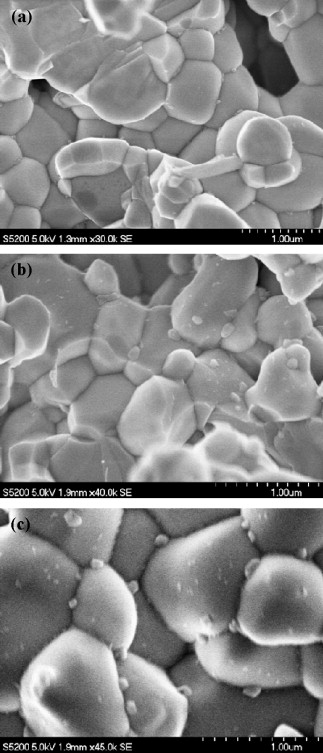
The high-temperature mechanical properties of the mixed ionic-electronic conductor perovskite BaCe0.95Y0.05O3−δ with average grain size of 0.40 μm have been studied in compression between 1100 and 1300 °C in air at different initial strain rates. The true stress–true strain curves display an initial stress drop, followed by an extended steady-state stage. As the temperature decreases and/or the strain rate increases, there is a transition to a damage-tolerant strain-softening stage and eventually to catastrophic failure. Analysis of mechanical and microstructural data revealed that grain boundary sliding is the primary deformation mechanism. The strength drop has been correlated with the growth of ultrafine grains during deformation, already present at grain boundaries and triple grain junctions in the as-fabricated material.
Junio, 2011 | DOI: 10.1016/j.jeurceramsoc.2010.05.023
Reactividad de Sólidos
Constant rate thermal analysis for thermal stability studies of polymers
Sanchez-Jimenez, PE; Perez-Maqueda, LA; Perejon, A; Criado, JMPolymer Degradation and Stability, 96 (2011) 974-981
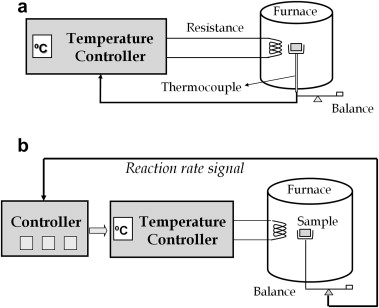
This paper explores the relationship between the shapes of temperature-time curves obtained from experimental data recorded by means of constant rate thermal analysis (CRTA) and the kinetic model followed by the thermal degradation reaction. A detailed shape analysis of CRTA curves has been performed as a function of the most common kinetic models. The analysis has been validated with simulated data, and with experimental data recorded from the thermal degradation of polytetrafluoroethylene (PTFE), poly(1,4-butylene terephthalate) (PBT), polyethylene (PE) and poly(vinyl chloride) (PVC). The resulting temperature-time profiles indicate that the studied polymers decompose through phase boundary, random scission, diffusion and nucleation mechanisms respectively. The results here presented demonstrate that the strong dependence of the temperature-time profile on the reaction mechanism would allow the real kinetic model obeyed by a reaction to be discerned from a single CRTA curve.
Mayo, 2011 | DOI: 10.1016/j.polymdegradstab.2011.01.027
Reactividad de Sólidos
Mechanochemical synthesis of visible light sensitive titanium dioxide photocatalyst
Šubrt, J., Criado, J.M., Szatmáry, L., Diánez-Millán, M.J., Murafa, N., Pérez-Maqueda, L.A., Brezová, V.International Journal of Photoenergy, 2011 (2011) Article number 156941
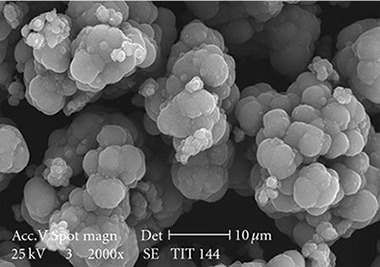
Phase transition of anatase nanoparticles into the phases TiO2-II and rutile under grinding was studied. The addition of ammonium carbamate to the reaction mixture inhibits the phase conversion and the cold welding of particles. The UV-visible absorption spectrum showed narrowing the band gap width after grinding with an ammonium carbamate additive resulting in shift of the light absorption of the ground sample towards the visible region. By EPR, intensive formation of OH• radical at irradiation of the sample with both UV (λ > 300 nm) and visible (λ > 435 nm) light was observed. High photocatalytic activity of the ground sample in visible light region was demonstrated also by measurement of kinetics of the photocatalytic decomposition of 4-chlorophenol.
Marzo, 2011 | DOI: 10.1155/2011/156941
Química de Superficies y Catálisis
Creep behavior of TiCxN1-x-CoTi cermets synthesized by mechanically induced self-sustaining reaction
Morales-Rodriguez, A; Gallardo-Lopez, A; Dominguez-Rodriguez, A; Cordoba, JM; Aviles, MA; Gotor, FJJournal of the European Ceramic Society, 31 (2011) 299-302
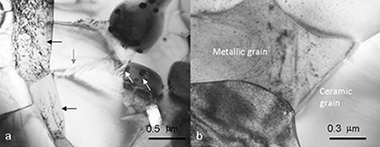
The plastic flow of TiCxN1-x-CoTi cermets has been investigated by uniaxial compression tests carried out in argon atmosphere at temperatures between 1100 and 1200°C. Two different cermets, with 5wt.% W or WC content as sintering additives, have been explored to assess the influence of the sintering additives on creep. The microstructural observations of deformed samples and the mechanical results indicate that the hard phase (ceramic grains) controls the plastic deformation. The stress exponent changes from 1 to 2 with increasing strain rate, suggesting a transition in the deformation mechanism from diffusional creep to grain boundary sliding; both with similar activation energy values of about 400kJ/mol. This value of activation energy agrees with C diffusion in the carbonitride grains as the strain rate controlling mechanism.
Marzo, 2011 | DOI: 10.1016/j.jeurceramsoc.2010.10.007
Reactividad de Sólidos - Química de Superficies y Catálisis
Design and testing of a microchannel reactor for the PROX reaction
Cruz, S; Sanz, O; Poyato, R; Laguna, OH; Echave, FJ; Almeida, LC; Centeno, MA; Arzamendi, G; Gandia, LM; Souza-Aguiar, EF; Montes, M; Odriozola, JAChemical Engineering Journal, 167 (2011) 634-642
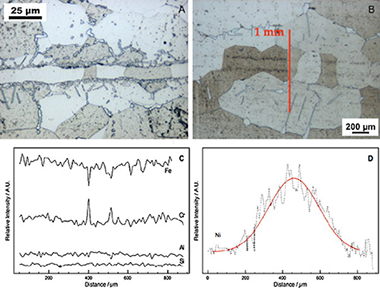
The different steps for manufacturing a microchannel reactor for the PROX reaction are discussed. Transient Liquid Phase bonding (TLP) using a Ni-B-Si amorphous melt spun is used for joining micromilled Al-alloyed ferritic stainless steel plates followed by recrystallization at 1200°C for 5h. A CuOx-CeO2 catalyst synthesized by the coprecipitation method was washcoated on the microchannel block resulting in a homogenous 20-30μm thick layer. The catalytic activity for CO-PROX reaction is similar in both the powder catalyst and the microchannel coated reactor but the selectivity is higher in the microchannel reactor. © 2010 Elsevier B.V.
Marzo, 2011 | DOI: 10.1016/j.cej.2010.08.088
Reactividad de Sólidos
Kinetic Analysis of Complex Solid-State Reactions. A New Deconvolution Procedure
Antonio Perejón, Pedro E. Sánchez-Jiménez, José M. Criado, and Luis A. Pérez-MaquedaJournal of Physical Chemistry B, 2011, 115 (8), pp 1780–1791
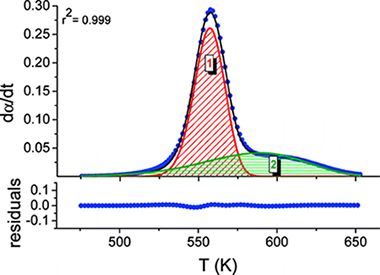
The kinetic analysis of complex solid-state reactions that involve simultaneous overlapping processes is challenging. A method that involves the deconvolution of the individual processes from the overall differential kinetic curves obtained under linear heating rate conditions, followed by the kinetic analysis of the discrete processes using combined kinetic analysis, is proposed. Different conventional mathematical fitting functions have been tested for deconvolution, paying special attention to the shape analysis of the kinetic curves. It has been shown that many conventional mathematical curves such as the Gaussian and Lorentzian ones fit kinetic curves inaccurately and the subsequent kinetic analysis yields incorrect kinetic parameters. Alternatively, other fitting functions such as the Fraser-Suzuki one properly fit the kinetic curves independently of the kinetic model followed by the reaction and their kinetic parameters, and moreover, the subsequent kinetic analysis yields the correct kinetic parameters. The method has been tested with the kinetic analysis of complex processes, both simulated and experimental.
Marzo, 2011 | DOI: 10.1021/jp110895z
Intercalation and dynamics of hydrated Fe2+ in the vermiculites from Santa Olalla and Ojén
Anton Lerf, Friedrich E. Wagner, Juan Poyato and José Luis Pérez-RodríguezJournal of Solid State Electrochemistry, 15 (2011) 223-229
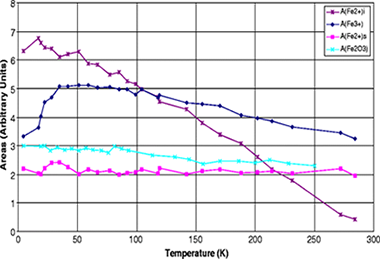
Although the intercalation of Fe3+ into layered phyllosicilicates-especially into smectites-attracted much attention in the past two decades, the information about Fe2+ loaded phyllosilicates is sparse. Here we present an investigation of the Fe2+ exchanged vermiculites from Santa Olalla and Ojén (Andalusia, Spain) by means of Mössbauer spectroscopy. The room temperature Mössbauer spectra are very similar to those of the starting compounds (Na forms) except for a decrease of the contribution of structural Fe3+ and a concomitant increase of the contribution of Fe2+ sites, indicating an internal redox process. The extent of this redox reaction is different for the two vermiculites. Thus, the intercalated Fe2+ acts as an electron mediator from the external medium to the structural Fe3+ ions. A new component attributable to intercalated Fe2+ is practically invisible in the room temperature Mössbauer spectra, but increases strongly and continuously during cooling to 4.2 K, where it is the dominant feature of the Mössbauer patterns. At 4.2 K, its quadruple splitting amounts to 3.31 mm/s, which is in excellent agreement with the quadrupole slitting of Fe2+ coordinated to six water molecules in a highly symmetric octahedral arrangement. The strong decrease of the Mössbauer-Lamb factor of this component with increasing temperature indicates a weak bonding of the Fe 2+ in the interlayer space.
Febrero, 2011 | DOI: 10.1007/s10008-010-1171-0
Study of ground and unground leached vermiculite II. Thermal behaviour of ground acid-treated vermiculite
Perez-Rodriguez, JL; Maqueda, C; Murafa, N; Subrt, J; Balek, V; Pulisova, P; Lancok, AApplied Clay Science, 51 (2011) 274-282
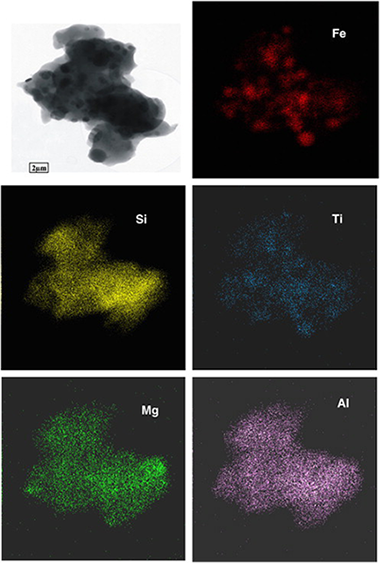
In this study, we examined the annealing effect on the material obtained after acid treatment of ground vermiculite which constituted amorphous silica and β-FeOOH. The XRD patterns of the starting sample measured at temperatures from 30 to 1200°C showed that the crystalline phase was present until ~300°C; whereas the sample heated between 300 and 800°C was practically amorphous. This is in agreement with previous observations that β-FeOOH decomposes to amorphous or poorly crystalline phase, β-Fe2O3, and transforms only slowly to crystalline α-Fe2O3. At 850°C the sample showed the first signs of a crystalline phase which was fully developed at 1050°C. The XRD, HRTEM and Mössbauer spectroscopy showed, after heating at 1050°C, the presence of crystalline phase, consisting of quartz, cristobalite, α-Fe2O3 and ε-Fe2O3. This effect showed in fact that well crystallized iron oxide nanoparticles embedded into the silica matrix are usually formed at relative high temperatures (~1000°C), which is in contrast to silica-free material. Element mapping of one particle of the composite obtained by annealing the sample at the highest temperature showed well-separated Fe2O3 and SiO2 particles in a composite material. Impurities of Al and Mg (from the original vermiculite) accompanied the silica components and TiO2 associated with Fe2O3 grains was also detected.
Febrero, 2011 | DOI: 10.1016/j.clay.2010.11.031
Química de Superficies y Catálisis
Thermal analysis of monument patina containing hydrated calcium oxalates
Perez-Rodriguez, JL; Duran, A; Centeno, MA; Martinez-Blanes, JM; Robador, MDThermochimica Acta, 512 (2011) 5-12
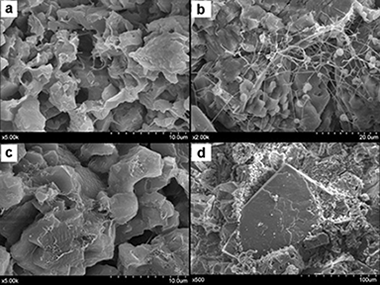
This work describes the thermal transformation of patina samples formed on the surface of dolomitic rocks used to build the Romanesque Torme's Church (Burgos, Spain). Analyses were performed using a combination of high-temperature XRD, simultaneous TG/DTA and gas mass spectrometry. The XRD analysis revealed the presence of hydrated calcium oxalates. The following three steps were proposed for the thermal transformation of the raw material: dehydration of weddellite/whewellite to form calcium oxalate, transformation of calcium oxalate to calcium carbonate, and formation of calcium oxide produced via decomposition of the calcite. DTA/TG and mass spectrometry analyses confirmed this mechanism. In addition, a high proportion of organic compounds was detected and was possibly formed via degradation of products applied for the building's conservation by the action of microorganisms attack. Mass spectrometry analysis revealed CO (and CO2) gas evolved during the transformation of CaC2O4 to CaCO3. The CO2 gas also appears at 765 °C due to the decomposition of calcium carbonate, and it appears over a large range of temperatures due to the decomposition of organic compounds. The TG analyses performed in a CO2 atmosphere were used to determine the percentages of Ca and Mg contained in dolomite, and the calcium carbonate formed by oxalate decomposition. DRIFTS and mass spectrometry results revealed the presence of several aliphatic and/or aromatic compounds containing CO groups.
Enero, 2011 | DOI: 10.1016/j.tca.2010.08.015
Reactividad de Sólidos
Synthesis and characterization of titanium-vanadium ternary nitride (Tix V1-x N)
Roldan, MA; Alcala, MD; Ortega, A; Real, CBoletín de la Sociedad Española de Cerámica y Vidrio, 50 (2011) 31-40
Titanium-Vanadium nitride (TiVN) has been prepared from carbothermal reduction of corresponding oxides and also by direct nitridation of a mix of two metals employing the ATVC method. The characterization of the final product by X-ray diffraction, scanning electron microscopy, electron energy loss (EELS), and X-ray absorption spectroscopy (XAS) is presented. The synthesis of the ternary nitride has been possible in all range of composition and the final product is obtained with nanometric particle size and a high microhardness after sintering.
Enero, 2011 | DOI: 10.3989/cyv.052011
Química de Superficies y Catálisis
Forgery detection on an Arabic illuminated manuscript by micro-Raman and X-ray fluorescence spectroscopy
Duran, A; Franquelo, ML; Centeno, MA; Espejo, T; Perez-Rodriguez, JLJournal of Raman Spectroscopy, 42 (2011) 48-55

An Arabic manuscript, supposed to be from the 14th century, was investigated and its components (pigments and dyestuffs) characterised using micro-Raman and X-ray fluorescence (XRF) spectroscopy, the latter employing a portable XRF/X-ray diffraction (XRD) system. The presence of anatase, rutile, calcite, barite, zinc oxide, carbon black, vermilion, hematite, goethite, β-naphthol, copper phthalocyanine, pigmosol green and a brass-based pigment was detected in the different zones of the illuminated manuscript. The detection of titanium oxides, barite and organic synthetic colourants such as β-naphthol and copper phthalocyanine and derived compounds provides indisputable indication of forging, repainting or retouching after the 19th century in the image of the manuscript.
Enero, 2011 | DOI: 10.1002/jrs.2644
2010
2010
Propiedades mecánicas, modelización y caracterización de cerámicos avanzados
A first study of the high-temperature plasticity of ceria-doped zirconia polycrystals
de Bernardi-Martin, S; Gomez-Garcia, D; Dominguez-Rodriguez, A; de Portu, GJournal of the European Ceramic Society, 30 (2010) 3357-3362
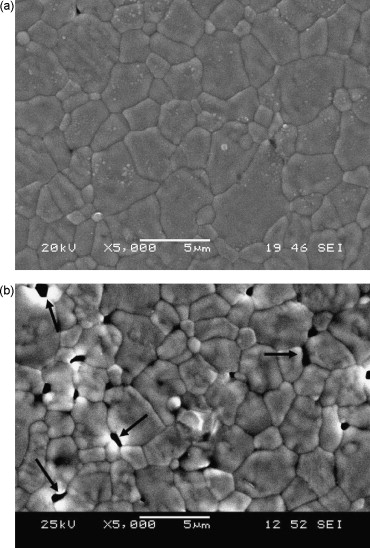
Ceria zirconia ceramic alloys were sintered by high-temperature annealing, considering several synthesis temperatures to obtain a full-dense ceria zirconia ceramic material using a temperature as low as possible. It was found that fully density is achieved at temperatures of 1450 degrees C. Monolithic specimens were crept under compression at high temperatures. The creep results fitted an empirical constitutive equation consistent with a classical Ratchinger mechanism for grain switching. This result was confirmed through microstructural characterization of as-received and post-mortem specimens. Since the conventional Ashby-Verrall model is contrary to the mechanism controlling creep in other zirconia alloys, the results are considered in the framework of a new grain boundary sliding model, with particular discussion of the validity of that model for the ceria zirconia case.
Diciembre, 2010 | DOI: 10.1016/j.jeurceramsoc.2010.07.043
Variscite source and source analysis: testing assumptions at Pico Centeno (Encinasola, Spain)
Odriozola, CP; Linares-Catela, JA; Hurtado-Perez, VJournal of Archaeological Science, 37 (2010) 3146-3157
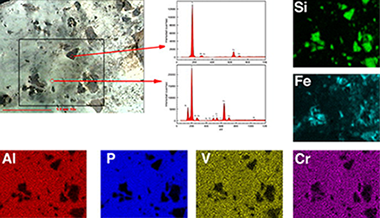
The analysis of trade and their implications for understanding social interaction is a major research question of prehistoric research in Europe. Variscite is a rare mineral that offers an excellent opportunity to study trade and exchange patterns in prehistoric Europe through proveniencing of source material. In this paper we discuss the exploitation and exchange of variscite at Pico Centeno mining district during the Copper Age. XRF, XRD, and FTIR analyses of the mineral recovered at Pico Centeno mining district during archaeological survey provides a baseline mineral signature for the source and sub-sources, which were then compared to other Iberian sources and to 44 green beads from 8 megalithic tombs from two different regions, in order to test ‘provenance postulate’ and distribution models. Mineral sampled during survey at Pico Centeno mining district turned out to be pure variscite phases, while extremely varied for the studied green beads: variscite, muscovite, talc or chlorite. On testing ‘provenance postulate’ we have focused on compositional comparison of Pico Centeno’s variscite with reference from various geological sources of Western Europe. We found that the concentrations of trace elements do not allow us to establish the origin of the beads, as traditionally claimed, due to the strong natural variability on minor and trace elements of the sources. Instead we found after FTIR analysis, that different proportions of phosphate species, which results in P/Al ratios higher than 1, arose during the genesis of the variscite deposits and resulted from the associated pH and nature of the host-rocks, modifying the concentrations of PO43−, H2PO4− and HPO42−. Thus, the P/Al atomic ratio should be an indication of provenance as it is established during mineral genesis. This issue has not been addressed in any of the other studied sources where this ratio seems to be ≈1.
Diciembre, 2010 | DOI: 10.1016/j.jas.2010.07.016
Propiedades mecánicas, modelización y caracterización de cerámicos avanzados
Segregation-induced grain boundary electrical potential in ionic oxide materials: A first principles model
D. Gómez-García, Juan J. Meléndez, Robert L. González-Romero, A. Domínguez-RodríguezActa Materialia, 58 (2010) 6404-6410

A first principles continuum analytical model for cationic segregation to the grain boundaries in complex ceramic oxides is presented. The model permits one to determine the electric charge density and the segregation-induced electric potential profiles through the grain and can be extrapolated to the range of nanostructured grain sizes. The theoretical predictions are compared with existing data for yttria-stabilized tetragonal zirconia polycrystals. The implications for physical properties (mainly high temperature plasticity and hardening behaviour) are then discussed.
Noviembre, 2010 | DOI: 10.1016/j.actamat.2010.08.002
Reactividad de Sólidos
Quantitative Characterization of Multicomponent Polymers by Sample-Controlled Thermal Analysis
Sanchez-Jimenez, PE; Perez-Maqueda, LA; Crespo-Amoros, JE; Lopez, J; Perejon, A; Criado, JMAnalytical Chemistry, 82 (2010) 8875-8880

This paper explores the potential of sample-controlled thermal analysis (SCTA) in order to perform compositional analysis of multicomponent polymeric materials by means of thermogravimetric experiments. In SCTA experiments, the response of the sample to the temperature determines the evolution of the temperature by means of a feedback system; thus, what is controlled is not the temperature time profile, as in conventional analysis, but rather the evolution of the reaction rate with time. The higher resolving power provided by the technique has been used for determining the composition of polymer blends composed of polyvinyl chloride (PVC) and different commercial plasticizers, a system where the individual components have very similar thermal stabilities, thereby rendering useless thermogravimetric experiments run under conventional conditions. Different SCTA procedures, such as constant rate thermal analysis (CRTA), which has received special attention, and high-resolution and stepwise isothermal analysis have been tested, and the results obtained have been compared with linear heating rate technique. It has been proven that CRTA can be used to effectively determine the exact composition of the blend.
Noviembre, 2010 | DOI: 10.1021/ac101651g
Hydraulic structures of the Roman Mithraeum house in Augusta emerita, Spain
Robador, MD; Perez-Rodriguez, JL; Duran, AJournal of Archaeological Science, 37 (2010) 2426-2432

This paper deals with some of the hydraulic structures of Augusta Emerita (Merida, Spain), specifically those found in the Mithraeum House. In particular, we describe and characterise the hydraulic mortars and coatings of the viridarium water channel. The recipient of the channel was covered with two hydraulic mortars and a finishing coating. Hydrated lime was used as binder. Calcite grains with different morphology have been observed in the mortars studied. The siliceous aggregate was composed of quartz, mica and feldspars. Ceramic fragments, which were added to the mortar to improve its hydraulic properties, were composed of quartz, mica, iron oxides, anorthite and an amorphous phase; aluminium-iron silicates were used as raw materials for their manufacture. We discuss the interactions between the hydrated lime and the surface of the ceramics in the mortars.
Octubre, 2010 | DOI: 10.1016/j.jas.2010.05.003
Propiedades mecánicas, modelización y caracterización de cerámicos avanzados
Superplasticity in nanocrystalline ceramics: pure grain boundary phenomena or not?
Dominguez-Rodriguez, A; Gomez-Garcia, D; Castillo-Rodriguez, M; Zapata-Solvas, E; Chaim, RInternational Journal of Materials Research, 101 (2010) 1215-1221
Superplasticity in ceramics has been the subject of intense research activity for the last two decades. Quite recently, the fabrication of fully dense nanocrystalline oxides with grain size below 100 nm enabled examination of their superplastic behaviour. This work presents a critical analysis of the plasticity of two important nanostructured oxide systems: MgO and yttria tetragonal zirconia polycrystals. A thorough comparison of their plastic deformation reveals that nano-structuring may be a necessary, but not a sufficient condition for superplasticity in ceramics as commonly assumed. Instead, the changes in the chemical composition and the transport properties, through the bulk and at grain boundaries, versus temperature and grain size can induce a rich variety of mechanical responses.
Octubre, 2010 | DOI: 10.3139/146.110401
Reactividad de Sólidos
Sintering by SPS of ultrafine TiCxN1-x powders obtained using mechanically induced self sustaining reaction
Borrell, A; Fernandez, A; Torrecillas, R; Cordoba, JM; Aviles, MA; Gotor, FJBoletin de la Sociedad Española de Cerámica y Vidrio, 49 (2010) 357-360
In this work high purity and nanometer character titanium carbonitride TiCxN1-x powders were obtained by mechanically induced self sustaining reaction (MSR) in a high-energy planetary ball mill, from a mixture of titanium with graphite or carbon nanofiber (CNFs) in a nitrogen atmosphere. A promising method for developing these materials is the coupling of the MSR with SPS sintering technique. The product is sintered at 1400 degrees C and 1700 degrees C, obtaining a completely dense monolithic ceramic (>99% t.d). In this work, the influence of SI'S treatment and carbon precursor on material microstructures was studied and the main mechanical properties of the end material were evaluated.
Septiembre, 2010 | DOI: 10.3989/cyv.2010.v49.i5
Reactividad de Sólidos
Mechanochemical synthesis of vanadium nitride
Roldan, MA; Lopez-Flores, V; Alcala, MD; Ortega, A; Real, CJournal of the European Ceramic Society, 30 (2010) 2099-2107
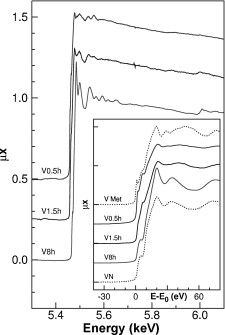
Vanadium nitride (VN) has been prepared by mechanosynthesis from vanadium metal under a pressurized nitrogen atmosphere in a short milling time. The characterization of the final product by X-ray diffraction, scanning electron microscopy, electron energy loss (EELS), and X-ray absorption spectroscopy (XAS) is presented. The final product, VN with 96% of purity, is obtained at room temperature with nanometric particle size and a very high microhardness after sintering. A relationship between microstructure and microhardness as well as a comparison between the VN obtained mechanical and thermal method is also presented.
Agosto, 2010 | DOI: 10.1016/j.jeurceramsoc.2010.04.008
Study of the Dehydroxylation-Rehydroxylation of Pyrophyllite
Perez-Rodriguez, JL; Duran, A; Sanchez-Jimenez, PE; Franquelo, ML; Perejon, A; Pascual-Cosp, J; Perez-Maqueda, LAJournal of the American Ceramic Society, 93 (2010) 2392-2398
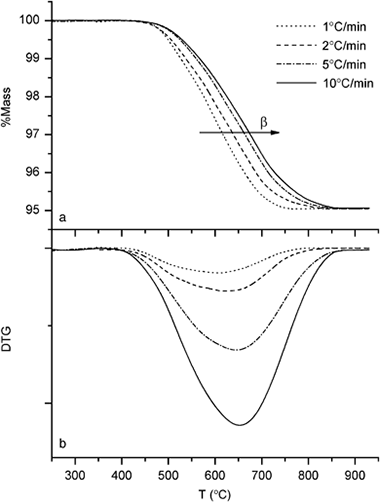
Pyrophyllite is a raw material of significant interest due to its large number of applications. Most of these applications require a thermal transformation of pyrophyllite; this thermal transformation implies the release of structural OH groups and the formation of new phases. In this paper, we report on the dehydroxylation of pyrophyllite and the reversibility of the process. A value of 224 +/- 16 kJ/mol for the dehydroxylation of pyrophyllite was obtained. In addition, it was observed that the partially or totally dehydroxylated pyrophyllite suffered a partial reversible rehydroxylation when cooled to room temperature. This rehydroxylation was substantiated by thermogravimetric measurements, while infrared spectroscopic studies showed that, during the rehydroxylation, the intensity of the OH band at 3675 cm-1 increased as two new bands at 3690 and 3702 cm-1 appeared. This rehydroxylation process was heavily influenced by the particle size of the pyrophyllite. Thus, smaller particles (< 1 mu m) showed a larger rehydroxylation percentage (about 12%), while the larger ones (20-40 mu m) showed a smaller percentage (about 1.6%). The extent of rehydroxylation also depended on the dehydroxylation temperature and reached a maximum value at 750 degrees C.
Agosto, 2010 | DOI: 10.1111/j.1551-2916.2010.03750.x
Reactividad de Sólidos
Kinetic model for thermal dehydrochlorination of poly(vinyl chloride)
Sanchez-Jimenez, PE; Perejon, A; Criado, JM; Dianez, MJ; Perez-Maqueda, LAPolymer, 51 (2010) 3998-4007
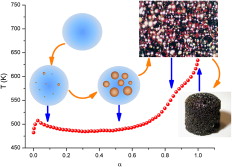
In this paper, a novel method for calculating degradation kinetics is presented. The method has been applied to the thermal dehydrochlorination of two different samples of PVC. It has been observed that this dehydrochlorination is complex and involves two different processes. A model that accounts for the entire dehydrochlorination is proposed. This model involves nucleation and growth and diffusion controlled mechanisms. The kinetic parameters are obtained from linear heating rate, isothermal and sample controlled thermal analysis experiments. Kinetic results obtained from the macroscopic thermal analysis measurements demonstrate the correlation between the kinetics of the thermal dehydrochlorination of PVC and the structure of this macromolecule.
Agosto, 2010 | DOI: 10.1016/j.polymer.2010.06.020
Reactividad de Sólidos
Generalized Kinetic Master Plots for the Thermal Degradation of Polymers Following a Random Scission Mechanism
Sanchez-Jimenez, PE; Perez-Maqueda, LA; Perejon, A; Criado, JMJournal of Physical Chemistry A, 114 (2010) 7868-7876
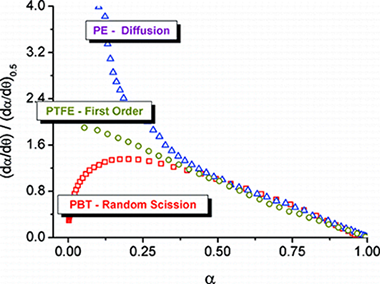
In this paper, the f(alpha) conversion functions for random scission mechanisms have been proposed to allow for the construction of generalized master plots suitable for these kinds of mechanisms. The master plots have been validated by their application to simulated data and to the thermal degradation of poly(butylene terephthalate), polyethylene, and poly(tetrafluoroethylene).
Agosto, 2010 | DOI: 10.1021/jp103171h
Reactividad de Sólidos
Mechanochemical preparation of BaTiO3-Ni nanocomposites with high dielectric constant
Sanchez-Jimenez, PE; Perez-Maqueda, LA; Dianez, MJ; Perejon, A; Criado, JMComposite Structures, 92 (2010) 2236-2240
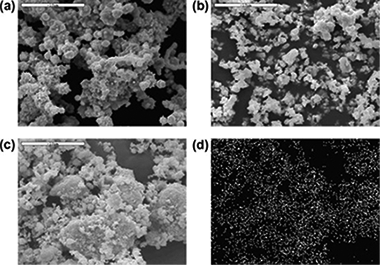
A mechanochemical procedure is proposed for an easy preparation of a BaTiO3-Ni composite in a single step. BaTiO3 and Ni powders available in the market are mixed by dry ball milling producing a decrease of particle size and an evenly distribution of both phases. In the sintered pellets the nickel particles are homogeneously distributed into the BaTiO3 matrix and isolated from others Ni particles. The dielectric constant of the composite is considerably higher than that of the barium titanate. Moreover, the temperature of the ferroelectric <-> paraelectric transition of the BaTiO3-Ni composite here prepared is much lower than the one of the pure BaTiO3 single phase.
Agosto, 2010 | DOI: 10.1016/j.compstruct.2009.08.011
Reactividad de Sólidos - Propiedades mecánicas, modelización y caracterización de cerámicos avanzados
Microstructural Effects on the Creep Deformation of Alumina/Single-Wall Carbon Nanotubes Composites
Gomez-Garcia, D; Poyato, R; Lee, Z; Castillo-Rodriguez, M; Dominguez-Rodriguez, A; Radmilovic, V; Padture, NPJournal of the American Ceramic Society, 93 (2010) 2042-2047
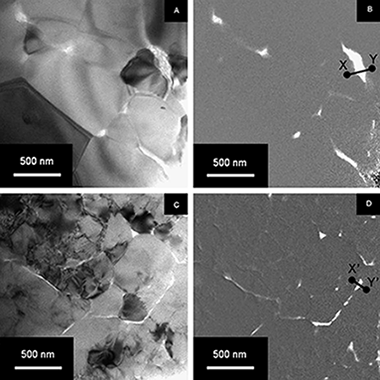
The enhanced high-temperature creep resistance in alumina/single-wall carbon nanotubes (SWNTs) composites has been attributed to the unprecedented grain-boundary structure of these composites, where the SWNTs bundles segregated at the alumina grain boundaries partially impede grain-boundary sliding. In this study, the effect of SWNTs distributions at alumina grain boundaries on the creep behavior of alumina/SWNTs composites has been investigated. Microstructures of two different alumina/10 vol% SWNTs composites, one with heterogeneous and the other with homogenous distributions of SWNTs at grain boundaries, have been characterized quantitatively. The steady-state creep rate (uniaxial compression) in the heterogeneous composite has been found to be over three times higher than that in the homogeneous composite at 1300° and 1350°C (argon atmosphere). It is argued that the less uniform distribution of SWNTs at the alumina grain boundaries in the heterogeneous composite results in less effective obstruction of grain-boundary sliding, and attendant higher creep rate. This also results in more efficient recovery in that composite.
Julio, 2010 | DOI: 10.1111/j.1551-2916.2010.03681.x
Murillo's paintings revealed by spectroscopic techniques and dedicated laboratory-made micro X-ray diffraction
Duran, A; Siguenza, MB; Franquelo, ML; de Haro, MCJ; Justo, A; Perez-Rodriguez, JLAnalytica Chimica Acta, 671 (2010) 1-8

This paper describes one of the first case studies using micro-diffraction laboratory-made systems to analyse painting cross-sections. Pigments, such as lead white, vermilion, red ochre, red lac, lapis lazuli, smalt, lead tin yellow type I, massicot, ivory black, lamp black and malachite, were detected in cross-sections prepared from six Bartolome Esteban Murillo paintings by micro-Raman and micro-XRD combined with complementary techniques (optical microscopy, SEM-EDS, and FT-IR). The use of micro-XRD was necessary due to the poor results obtained with conventional XRD. In some cases, pigment identification was only possible by combining results from the different analytical techniques utilised in this study.
Junio, 2010 | DOI: 10.1016/j.aca.2010.05.004
Reactividad de Sólidos
Nonisothermal calorimetric study of the precipitation processes in a Cu-1Co-0.5Ti alloy
Donoso, E; Zuniga, A; Dianez, MJ; Criado, JMJournal of Thermal Analysis and Calorimetry, 100 (2010) 975-980
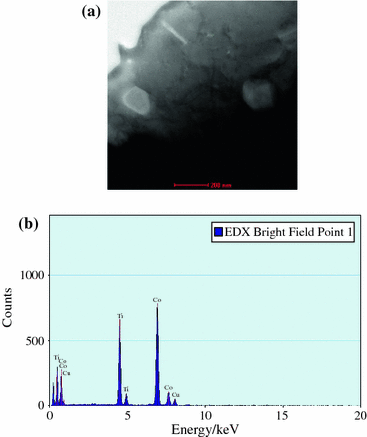
The precipitation processes in a Cu-1.0 at.%Co-0.5 at.%Ti (Cu-1.5 at.%Co2Ti) alloy were studied using differential scanning calorimetry (DSC), transmission electron microscopy (TEM), and microhardeness measurements. The analysis of the calorimetric curves from room temperature to 900 K shows the presence of two exothermic reactions attributed to the formation of CoTi and Co2Ti particles in the copper matrix. On the basis of enthalpy calculations, it was found that the decomposition begins with the precipitation of CoTi, followed by the formation of Co2Ti particles. The activation energies calculated using the modified Kissinger method were lower than the ones corresponding to diffusion of cobalt and titanium in copper. Kinetic parameters were obtained by a convolution method based on the Johnson-Mehl-Avrami (JMA) formalism. The values obtained for the parameter n were indicative of a particle nucleation process from preexistent nuclei. Microhardness measurements and TEM micrographs confirmed the formation of the mentioned phases.
Junio, 2010 | DOI: 10.1007/s10973-009-0642-y
Reactividad de Sólidos
Microstructural characterization of ceramic-intermetallic composites using TEM related techniques
Sayagues, MJ; Aviles, MA; Cordoba, JM; Alcala, MD; Gotor, FJJournal of the European Ceramic Society, 30 (2010) 1765-1774
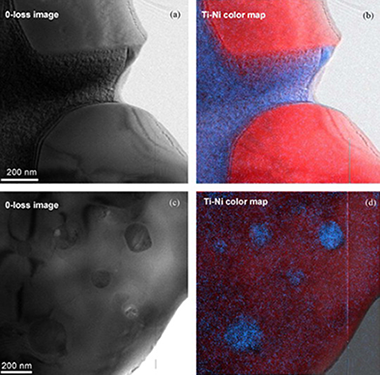
TiCxVy/Ni and TiCxNy/Ti-Co composites formed by ceramic and intermetallic binder phases were produced by pressureless sintering at 1400 degrees C from powders synthesized by a mechanically induced self-sustaining reaction (MSR) process. Four different composites were characterized using high-resolution electron microscopic techniques, in both scanning (SEM, HRSEM) and transmission (TEM, HRTEM, ED, EDS and EELS) modes and using an energy filtered technique (EFTEM) associated with electron energy loss spectroscopy (EELS). The microcharacterization showed that the ceramic phase with an fcc-cubic structure displayed a short-range order in many crystals detected by diffuse scattering in the ED patterns. This was possibly due to a sequence of C, N, and vacancies of both atoms along certain directions in the structure. On the other hand, even though the binder phase was introduced as metal in the reaction process, it was formed by Ni-Ti or Co-Ti known intermetallic compounds (NiTi2, Ni3Ti, and Co3Ti). An unknown Ni-Ti intermetallic structure with a Ni:Ti ratio close to 2:1 was only found in one of the synthesized composites and displayed a cubic structure with a lattice parameter, a, of about 8.7 angstrom.
Junio, 2010 | DOI: 10.1016/j.jeurceramsoc.2010.01.039
Propiedades mecánicas, modelización y caracterización de cerámicos avanzados
On the microstructure of single wall carbon nanotubes reinforced ceramic matrix composites
Zapata-Solvas, E; Gomez-Garcia, D; Dominguez-Rodriguez, AJournal of Materials Science, 45 (2010) 2258-2263
A microstructural modelling of the microstructure in single wall carbon nanotubes reinforced alumina ceramics has been developed. The model accounts for the main microstructural features, being quite useful to describe the carbon nanotube distribution along the ceramic matrix. The microstructural analysis derived from this model is found to give a deeper insight into the high-temperature creep of these composites.
Mayo, 2010 | DOI: 10.1007/s10853-009-4126-z
Identification of cellulose fibres belonging to Spanish cultural heritage using synchrotron high resolution X-ray diffraction
Herrera, LK; Justo, A; Duran, A; de Haro, MCJ; Franquelo, M; Rodriguez, JLPApplied Physics A-Materials Science & Processing, 99 (2010) 391-398
A complete characterisation of fibres used in Spanish artwork is necessary to provide a complete knowledge of these natural fibres and their stage of degradation. Textile samples employed as painting supports on canvas and one sample of unprocessed plant material were chosen for this study. All the samples were investigated by synchrotron radiation X-ray diffraction (SR-XRD). Flax and cotton have the Cellulose I structure. The values of the crystalline index (CI) were calculated for both types of fibres. The structure of Cellulose IV was associated with the unprocessed plant material. The information obtained by SR-XRD was confirmed by laboratory techniques including scanning electron microscopy (SEM) and Fourier transform infrared spectroscopy (FTIR).
Mayo, 2010 | DOI: 10.1007/s00339-010-5626-z
Reactividad de Sólidos
A new model for the kinetic analysis of thermal degradation of polymers driven by random scission
Sanchez-Jimenez, PE; Perez-Maqueda, LA; Perejon, A; Criado, JMPolymer Degradation and Stability, 95 (2010) 733-739

In this paper, a series of f(alpha) kinetic equations able to describe the random scission degradation of polymers is formulated in such a way that the reaction rate of the thermal degradation of polymers that go through a random scission mechanism can be directly related to the reacted fraction. The proposed equations are validated by a study of the thermal degradation of poly(butylene terephthalate) (PBT). The combined kinetic analysis of thermal degradation curves of this polymer obtained under different thermal pathways have shown that the proposed equation fits all these curves while other conventional models used in literature do not.
Mayo, 2010 | DOI: 10.1016/j.polymdegradstab.2010.02.017
Materiales Avanzados
Physical and geotechnical properties of clay phyllites
Garzon, E; Sanchez-Soto, PJ; Romero, EApplied Clay Science, 48 (2010) 307-318
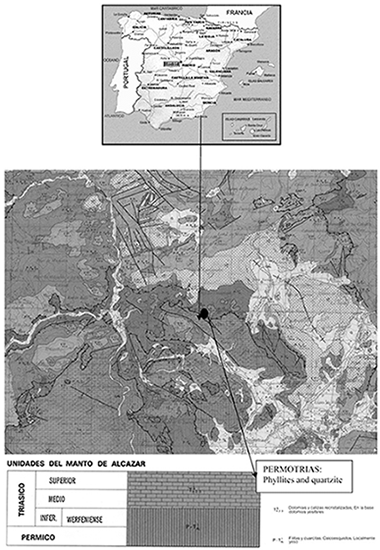
An experimental programme is presented with the aim of characterising - from physical, microstructural and geotechnical perspectives - the main properties of compacted clay phyllites. These clay phyllites are widely used as waterproofing material for roofs in the Alpujarra (Andalusia, Spain), as sealing liners in irrigation ponds, and as core material of small earthen zoned dams. An exhaustive physical-characterisation programme on the powder fraction has been followed using X-ray fluorescence (XRF), X-ray diffraction (XRD), transmission electron microscopy (TEM), scanning electron microscopy (SEM), chemical analysis by energy dispersive X-ray spectroscopy (EDX), thermal analysis, particle-size distribution analysis, consistency limits, and density of solid particles. From a microstructural standpoint, mercury intrusion porosimetry (MIP) tests, as well as nitrogen-adsorption tests, were carried out to characterise the pore network and surface area of the material in both natural and compacted states. The geotechnical characterisation programme on the compacted material was focused on the water-permeability and water-retention properties, the volume change on soaking (swelling or collapse), the compressibility on loading, the shear-strength properties, and the mechanical-penetration properties. In this way, an important physical and hydro-mechanical data base is provided, which could help in evaluating the suitability for using this material in a wide range of earthen constructions (liners, road subgrades, embankments, core material in zoned dams). It has been found that the material contains illite, chlorite and quartz as the main components, and feldspar, iron oxide and interstratified illite-smectite as minor ones. Despite the presence of active clay minerals, the compacted material did not display an important swelling on soaking at low stresses, as a consequence of its low specific surface and low water-retention ability. The material exhibited good compaction properties and, consequently, low water permeability plus a stiff response on loading. Nevertheless, despite the low porosity attained on the dry-side compaction, the material underwent some collapse on soaking at stresses greater than 100 kPa.
Abril, 2010 | DOI: 10.1016/j.clay.2009.12.022
Determination of pigments and binders in Pompeian wall paintings using synchrotron radiation - High-resolution X-ray powder diffraction and conventional spectroscopy-chromatography
Duran, A; De Haro, MCJ; Perez-Rodriguez, JL; Franquelo, ML; Herrera, LK; Justo, AArchaeometry, 52 (2010) 286-307
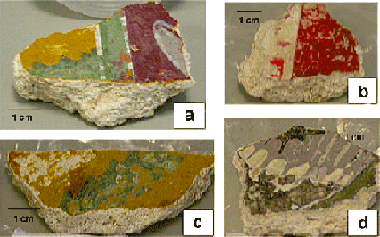
The employment of synchrotron techniques complemented by conventional laboratory systems has allowed us to deepen and improve our knowledge of Roman wall painting procedures. The palette identified in wall paintings from Pompeii and Herculaneum from the second century bc includes goethite, hematite, cinnabar, glauconite, Egyptian blue, and other components such as calcite and aragonite. Proof of the use of organic binders is provided by FTIR and PY-GC/MS. Therefore, the possibility of the use of 'a secco' techniques cannot be ruled out. Pigments in wall paintings are usually found in small percentages and conventional X-ray diffractometers do not detect them. Synchrotron radiation - high-resolution X-ray powder diffraction has allowed identification with only a few micrograms of sample.
Abril, 2010 | DOI: 10.1111/j.1475-4754.2009.00478.x
Reactividad de Sólidos
Microstructural characterization of copper based alloys produced by reactive milling
Palma, R; Sepulveda, A; Zuniga, A; Donoso, E; Dianez, MJ; Criado, JMRevista de Metalurgia, 46 (1010) 197-205
The micro and nanostructure of Cu-Al, Cu-V and Cu-Ti alloys produced by reactive milling were analyzed using X-ray diffraction (XRD) and transmission electron microscopy (TEM). Samples with different milling times (t = 0, 10, 20 and 30 h) were considered. The grain size, dislocation density and residual microstrain were evaluated form the XRD data using the Williamson-Hall and Klug-Alexander methods. The evolution of texture as a function of milling time was also studied using XRD. It was found, using TEM, that the grain size and dispersoid size were nanometric in all three alloys considered.
Marzo, 2010 | DOI: 10.3989/revmetalm.2010.v46.i3
A thermal study approach to roman age wall painting mortars
Duran, A; Perez-Maqueda, LA; Poyato, J; Perez-Rodriguez, JLJournal of Thermal Analysis and Calorimetry, 99 (2010) 803-809
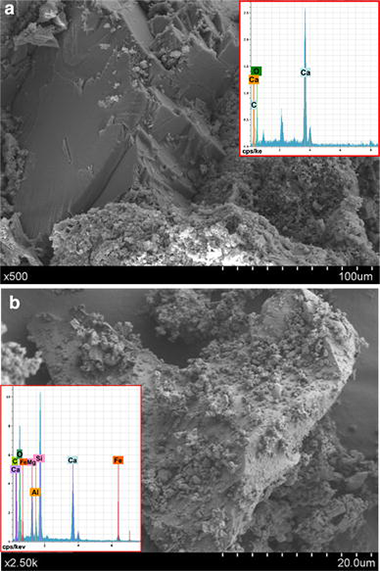
Roman ancient mortars have been widely studied, in connection with both diagnosis and application required for restoring. Thermoanalytical experiments performed on mortars from Pompeii and Herculaneum provided a very good understanding of the technology employed. The mortars from Pompeii were obtained by the proper mixing of lime and marble grains while mortars of Herculaneum by lime and silicates compounds. The position of the endothermic peak of calcite decomposition showed important variations in the different samples studied, which was assigned to the different crystallinity and particle sizes. Experiments under CO2 flow confirmed the presence of magnesium calcium carbonates.
Marzo, 2010 | DOI: 10.1007/s10973-009-0667-2
Reactividad de Sólidos
Mechanosynthesis of Hf1-xZrxB2 Solid Solution and Hf1-xZrxB2/SiC Composite Powders
Aviles, MA; Cordoba, JM; Sayagues, MJ; Alcala, MD; Gotor, FJJournal of the American Ceramic Society, 93 (2010) 696-702
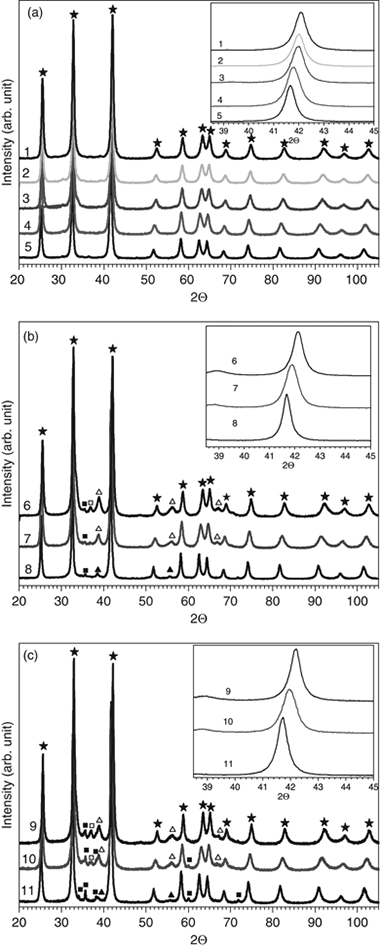
The synthesis of solid solutions in the HfB2-ZrB2 system was conducted by mechanically induced self-sustaining reaction (MSR) processes under an inert atmosphere from elemental mixtures of Hf, Zr, and B. The stoichiometry of the Hf1-xZrxB2 solid solution phase was controlled by adjusting the Hf/Zr/B atomic ratio in the starting mixture. Composite materials with SiC were achieved by adding the required amount of SiC to the Hf/Zr/B reactant mixture. The presence of up to 20 vol% of SiC did not inhibit the MSR process. Longer milling times were required to ignite the mixture. Small amounts of the refractory phases ZrC or HfC were observed in the composite powders. The chemical composition, structure, and microstructure of products were studied by X-ray diffraction, scanning and transmission electron microscopy, electron diffraction, and energy-dispersive X-ray spectroscopy. This complete characterization confirmed the formation of P6/mmm hexagonal diboride phases with a submicrometric microstructure. The determination of the chemical composition and lattice parameters ascertained the formation of solid solutions with good chemical homogeneity in the HfB2-ZrB2 system.
Marzo, 2010 | DOI: 10.1111/j.1551-2916.2009.03484.x
Reactividad de Sólidos
Spark Plasma Sintering of Ultrafine TiCxN1-x Powders Synthesized by a Mechanically Induced Self-Sustaining Reaction
Borrell, A; Fernandez, A; Torrecillas, R; Cordoba, JM; Aviles, MA; Gotor, FJJournal of the American Ceramic Society, 93 (2010) 2252-2256
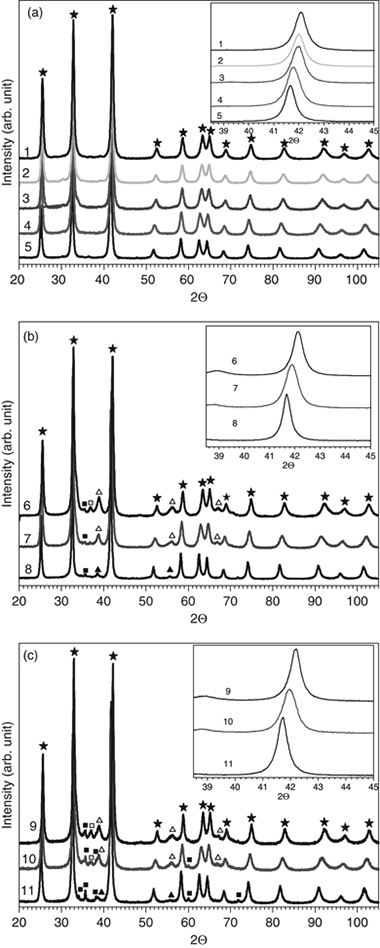
High-purity, nanometer-sized titanium carbonitride powders, TiCxN1-x, were obtained with a mechanically induced self-sustaining reaction (MSR) in a high-energy planetary ball mill from a mixture of titanium and different carbon precursors under a nitrogen atmosphere. A promising method for developing dense TiCxN1-x materials is the coupling of MSR with the spark plasma sintering (SPS) technique. The powders were sintered at different temperatures to provide a completely dense monolithic ceramic (> 99% theoretical density). In this work, the influence of the carbon precursor and SPS treatment on the material microstructures were studied, and the main mechanical properties of the end material were evaluated.
Marzo, 2010 | DOI: 10.1111/j.1551-2916.2010.03735.x
Seville City Hall Chapter Room ceiling decoration
Duran, A; Robador, MD; de Haro, MCJ; Herrera, LK; Gimena, P; Perez-Rodriguez, JLMateriales de Construcción, 60 (2010) 83-95
El objetivo de este trabajo es el estudio de diferentes aspectos, como el color, la composición química y las fases mineralógicas presentes en los diferentes materiales que forman la ornamentación del techo de la Sala Capitular del Ayuntamiento de Sevilla, mediante métodos físicos y químicos. Nuestros resultados muestran que el dorado fue realizado sobre una capa de bol previamente depositada sobre una lámina de blanco de plomo que cubría un estrato de calcita. Posteriormente, y probablemente debido a alteraciones en el dorado original, el techo fue de nuevo dorado usando una técnica similar. En el siglo XIX, casi todo el techo, excepto las zonas con inscripciones, fue blanqueado usando una mezcla de calcita y blanco de plomo. Se empleó plata para cubrir la espada del rey Juan I (casetón 27). Finísimas láminas de oro se usaron para decorar los atributos reales: coronas, cinturones, cetros, espadas y rosarios. En diferentes partes de la decoración fueron detectados pigmentos como azurita, malaquita, bermellón y negro de humo. La composición del mortero de la estructura era a base de cal y dolomita molida.
Febrero, 2010 | DOI: 10.3989/mc.2010.45107
Reactividad de Sólidos - Fotocatálisis Heterogénea: Aplicaciones
The Multistep Nature of the Kaolinite Dehydroxylation: Kinetics and Mechanism
Ortega, A; Macias, M; Gotor, FJJournal of the American Ceramic Society, 93 (2010) 197-203
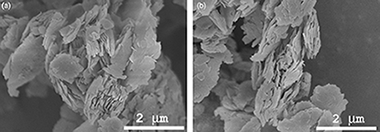
The thermal dehydroxylation of kaolinite has been reexamined using small sample weights, a homogeneous particle size distribution and high-vacuum conditions in order to reduce the influences of heat and mass-transfer phenomena. The controlled rate thermal analysis (CRTA) technique, which was specially developed to minimize the pressure and temperature gradients through the sample, was employed to carry out meaningful kinetic experiments. Two advanced isoconversional methods, the Vyazovkin and the Galwey methods, were used complementarily to determine the dependence of the activation energy on the degree of conversion. For this purpose, the Vyazovkin method has been adapted to CRTA experiments. It was demonstrated that there are at least two different stages, revealing the multistep nature of this reaction. The activation energy for the first step, which is assigned to nucleation and the growth of nuclei, decreases from 100 to 75 kJ/mol. The second stage corresponds to a diffusion process and the activation energy rises to 120 kJ/mol because of the metakaolinite formation, which closes the interlamellar channels and leaves isolated patches of kaolinite from which the water escapes with difficulty.
Enero, 2010 | DOI: 10.1111/j.1551-2916.2009.03328.x
Microscopic and spectroscopic techniques for the study of paper supports and textile used in the binding of hispano-arabic manuscripts from Al-Andalus: A transition model in the 15th century
Espejo, T; Duran, A; Lopez-Montes, A; Blanc, RJournal of Cultural Heritage, 11 (2010) 50-58
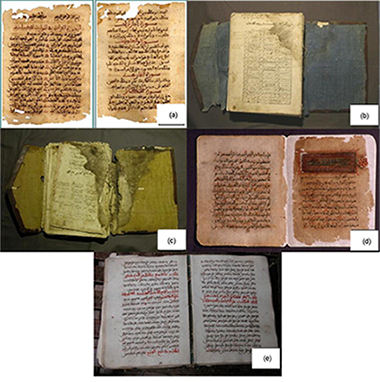
This work focuses on the study of paper and textiles used in the binding of a series of manuscripts that share some specific characteristics that lead us to speculate on the possibility of a transitional codicological typology from the Arabic to the Christian book in Al-Andalus during the 15th century. The books we analyzed belong to the collection of the Historical Archive of Malaga, the Archive of Sacromonte Abbey, in Granada, the School of Arabic Studies and the Library of P.P. Escolapios, also in Granada. Paper physical study was performed by microscopic and spectroscopic techniques. A routine and objective method, Fourier Transform Infrared (FTIR) spectroscopy, was employed and proved to be a useful technique for the characterization of cellulosic fibres, main component of paper from the boards and the envelope flap pasteboards, and the fabric lining from the cover. The results of our research will help us to date, identify and study the evolution of the techniques, proving that the materials and innovations of the Italian paper manufacturing processes were perfectly known in the south of modern day Spain, before the Christian Reconquest.
Enero, 2010 | DOI: 10.1016/j.culher.2009.01.007
2009
2009
Study of metallic components of historical organ pipes using synchrotron radiation X-ray microfluorescence imaging and grazing incidence X-ray diffraction
Herrera, LK; Justo, A; Munoz-Paez, A; Sans, JA; Martinez-Criado, GAnalytical and Bioanalytical Chemistry, 395 (2009) 1969-1975
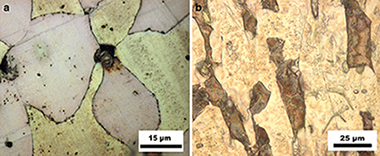
A comparative study of the composition and microstructure of two different brass alloys from reed pipes, one from a Spanish baroque organ and the other from a modern one, was carried out. This study allowed us to determine the procedure followed to produce the brass used to make ancient reed pipes. Moreover the distribution and correlation of lead and other trace elements present into the main component of the brass, the copper and zinc phases, of the historical tongues and shallots were established. This chemical composition was compared with that of a tongue from a twentieth-century organ. The whole study was accomplished using a combination of laboratory and synchrotron radiation techniques. X-ray fluorescence was the technique used to obtain elemental and chemical imaging of the main phases and the trace elements at a sub-micrometer scale.
Diciembre, 2009 | DOI: 10.1007/s00216-009-3075-3
Characterization of illuminated manuscripts by laboratory-made portable XRD and micro-XRD systems
Duran, A; Perez-Rodriguez, JL; Espejo, T; Franquelo, ML; Castaing, J; Walter, PAnalytical and Bioanalytical Chemistry, 395 (2009) 1997-2004
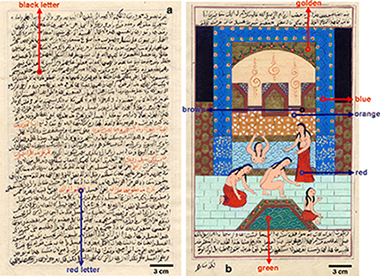
Illuminated Arabic manuscripts have been studied, employing two laboratory-made X-ray diffraction (XRD) systems developed recently in the C2RMF laboratory. The validity of the µ-XRD and XRD portable systems for the study of this type of artworks has been demonstrated. A common observation in all the analyses is the presence of calcite and rutile; also, hematite, goethite, cinnabar, brass, anatase and barite were detected in the various colours. Differences between the results obtained by both techniques due to acquisition mode are discussed. In addition, other techniques such as X-ray fluorescence (XRF) and micro-Raman were used for the complete characterization of the manuscripts.
Diciembre, 2009 | DOI: 10.1007/s00216-009-2992-5
Advanced combined application of μ-X-ray diffraction/μ-X-ray fluorescence with conventional techniques for the identification of pictorial materials from Baroque Andalusia paintings
Herrera, LK; Montalbani, S; Chiavari, G; Cotte, M; Sole, VA; Bueno, J; Duran, A; Justo, A; Perez-Rodriguez, JLTalanta, 80 (2009) 71-83
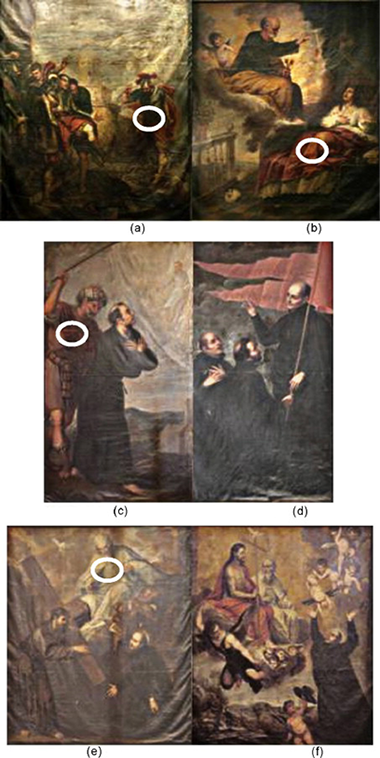
The process of investigating paintings includes the identification of materials to solve technical and historical art questions, to aid in the deduction of the original appearance, and in the establishment of the chemical and physical conditions for adequate restoration and conservation. In particular, we have focused on the identification of several samples taken from six famous canvases painted by Pedro Atanasio Bocanegra, who created a very special collection depicting the life of San Ignacio, which is located in the church of San Justo y Pastor of Granada, Spain. The characterization of the inorganic and organic compounds of the textiles, preparation layers, and pictorial layers have been carried out using an XRD diffractometer, SEM observations, EDX spectrometry, FT-IR spectrometry (both in reflection and transmission mode), pyrolysis/gas chromatography/mass spectrometry and synchrotron-based μ-X-ray techniques. In this work, the advantages over conventional X-ray diffraction of using combined synchrotron-based μ-X-ray diffraction and μ-X-ray fluorescence in the identification of multi-layer paintings is demonstrated.
Noviembre, 2009 | DOI: 10.1016/j.talanta.2009.06.032
Characterization of sepiolite-gel-based formulations for controlled release of pesticides
Maqueda, C; Partal, P; Villaverde, J; Perez-Rodriguez, JLApplied Clay Science, 46 (2009) 289-295
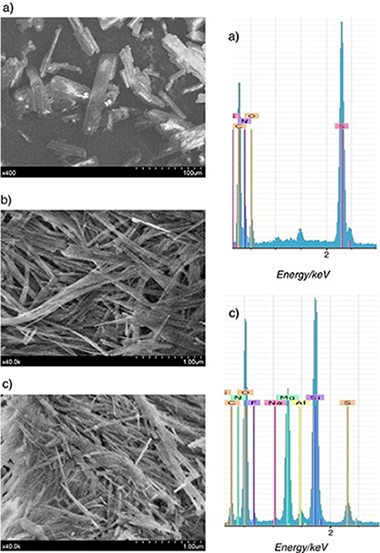
Novel controlled release formulations (CRFs) were developed for reducing leaching of herbicides and contamination of groundwater. The herbicide metribuzin (MTB) was entrapped within a sepiolite-gel matrix using a novel and ultrasound-based technique. Different sepiolite/herbicide matrices (either as a gel or as a powder after freeze-drying) were prepared with pesticide loading between 28.6 and 9.1%. The release of MTB from the control released formulations into water was retarded when compared with commercial formulation (CF), except in the case of the sepiolite-gel-based formulations with lower amounts of sepiolite. The rheological properties and microstructure of these formulations were examined in detail. FTIR spectra showed that there was no evidence of herbicide inside the sepiolite tunnels. The SEM micrograph of the sepiolite-gel-based formulations showed the fibrous morphology typical of sepiolite and no separate particles of MTB were found. However, the chemical analysis by EDX confirmed the presence of S, N, and C, which were attributed to MTB, together with the fibers of sepiolite. Rheological characterization indicated that samples containing MTB develops a microstructure, which is irrespective of concentration above 1 mass % sepiolite. There was a good agreement between the microstructure characteristics and MTB release behavior.
Noviembre, 2009 | DOI: 10.1016/j.clay.2009.08.019
Reactividad de Sólidos
Combined kinetic analysis of thermal degradation of polymeric materials under any thermal pathway
Sanchez-Jimenez, PE; Perez-Maqueda, LA; Perejon, A; Criado, JMPolymer Degradation and Stability, 94 (2009) 2079-2085
Combined kinetic analysis has been applied for the first time to the thermal degradation of polymeric materials. The combined kinetic analysis allows the determination of the kinetic parameters from the simultaneous analysis of a set of experimental curves recorded under any thermal schedule. The method does not make any assumptions about the kinetic model or activation energy and allows analysis even when the process does not follow one of the ideal kinetic models already proposed in the literature. In the present paper the kinetics of the thermal degradation of both polytetrafluoroethylene (PTFE) and polyethylene (PE) have been analysed. It has been concluded, without previous assumptions on the kinetic model, that the thermal degradation of PTFE obeys a first order kinetic law, while the thermal degradation of PE follows a diffusion-controlled kinetic model.
Noviembre, 2009 | DOI: 10.1016/j.polymdegradstab.2009.07.006
Hg/Sn amalgam degradation of ancient glass mirrors
Herrera, LK; Duran, A; Franquelo, ML; Justo, A; Perez-Rodriguez, JLJournal of Non-Crystalline Solids, 355 (2009) 1980-1983
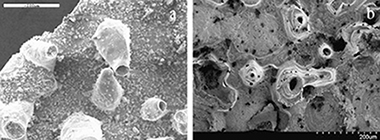
Tin amalgam, which is obtained by pouring mercury onto a sheet of tin, has been used in the production of reflective coatings for mirrors. The corrosion processes of the amalgam layer were investigated in several mirrors from historical buildings located in southern Spain using SEM/EDS, XPS, and GID. Mercury and Sn4+ are present as spheres on the amalgam surface due to the evaporation process (∼5 nm). The profile shows a mixture of Sn2+ and Sn4+. The original amalgam was composed of a binary alloy of tin and mercury (Hg0.1Sn0.9) and metallic tin. In this paper the tin oxidation mechanism of the amalgam is described. Liquid mercury is volatile and evaporates slowly, leaving fine tin particles that oxidize easily, forming tin monoxide (SnO) and tin dioxide (SnO2). The mercury-rich phase accelerates the corrosion of the tin-rich phase.
Octubre, 2009 | DOI: 10.1016/j.jnoncrysol.2008.11.045
Reactividad de Sólidos
High surface area α-alumina preparation by using urban waste
Martin-Ruiz, MM; Perez-Maqueda, LA; Cordero, T; Balek, V; Subrt, J; Murafa, N; Pascual-Cosp, JCeramics International, 35 (2009) 2111-2117
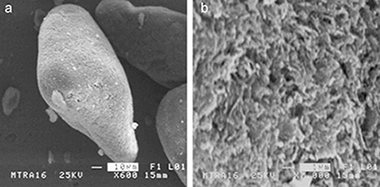
A new method for preparing high surface area α-alumina from urban waste is proposed. The method consists of the precipitation of a precursor that contains bohemite mixed with a linear polymer and subsequently the thermal decomposition of the precursor by heating in nitrogen and air to 1200 °C. The resulting α-alumina consists of nanocrystals of about 100 nm aggregated into larger particles with relatively high surface area (12 m2 g−1) and a significant macropore volume of 0.545 cm3 g. Methods of X-ray diffraction (XRD), scanning electron microscopy (SEM), high-resolution transmission electron microscopy (HRTEM) and selected area electron diffraction (SAED) were used to characterize microstructure of prepared materials. Results of differential thermal analysis, thermogravimetry and emanation thermal analysis characterized the thermal behaviour of α-alumina precursors.
Agosto, 2009 | DOI: 10.1016/j.ceramint.2008.11.011
Reactividad de Sólidos - Fotocatálisis Heterogénea: Aplicaciones
Kinetics of the thermal decomposition of anhydrous cobalt nitrate by SCRT method
Ortega, A; Macias, M; Gotor, FJJournal of Thermal Analysis and Calorimetry, 98 (2009) 441-448
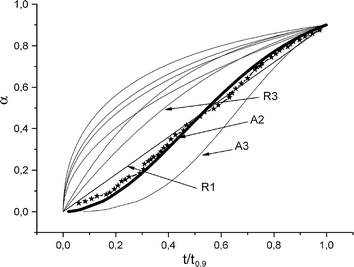
It has been shown the ability of the Sample Controlled Reaction Temperature (SCRT) method for both discriminate the kinetic law and calculate the activation energy of the reaction. This thermal decomposition is best described by a Johnson–Mehl–Avrami kinetic model (with n = 2) with an activation energy of nuclei growth which fall in the range 52–59 kJ mol−1. The process is not a single-step because the initial rate of decomposition is likely to be limited by nucleation. The results reported here constitute the first attempt to use the new SCRT method to study the kinetic of the thermal decomposition of cobalt nitrate.
Agosto, 2009 | DOI: 10.1007/s10973-009-0322-y
Reactividad de Sólidos
Synthesis of complex carbonitride powders TiyMT1−yCxN1−x (MT: Zr, V, Ta, Hf) via a mechanically induced self-sustaining reaction
Cordoba, JM; Aviles, MA; Sayagues, MJ; Alcala, MD; Gotor, FJJournal of Alloys and Compounds, 482 (2012) 349-355
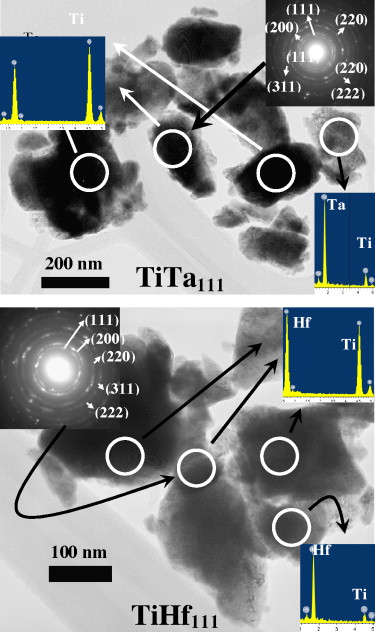
The machinability of materials is a dynamic field with enormous implications in different industrial sectors because manufacturers are constantly looking for improvements that can increase the overall productivity. Manufacturers of cutting tool inserts need to develop products that can perform at higher speeds and last longer under increasingly rigorous operating conditions. It has been revealed that cermets may exhibit better properties and performances when solid solution of multiple hard compounds is added instead of a mixture of several binary ones. In this work, a mechanically induced self-sustaining reaction (MSR) is described as a suitable synthesis method to obtain a wide range of different new quaternary carbonitride systems by milling mixtures of elemental powders of transition metals and graphite in a nitrogen atmosphere. Characterization was carried out using X-ray powder diffraction, elemental analysis, energy dispersive X-ray analysis (EDX), scanning and transmission electron microscopy and electron diffraction (ED).
Agosto, 2009 | DOI: 10.1016/j.jallcom.2009.04.012
Study of degradation processes of metals used in some artworks from the cultural heritage of Andalusia, Spain
Duran, A; Herrera, LK; de Haro, MCJ; Perez-Rodriguez, JL; Justo, ARevista de Metalurgia, 45 (2009) 277-286
The study of the alteration processes of metals, such as lead, bronze, iron and tin-mercury alloys, used in some of the
most important chosen artefacts of Andalusian Cultural Heritage is the main objective of this paper. Hydrocerussite
and cerussite were detected in lead seals stored in a hole of cardboard. Bronze is altered to atacamite by environmental
contamination, which is also responsible for the formation of rust from iron. Corrosion of the tin-mercury surface
of amalgam mirrors produces tin monoxide and tin dioxide and releases liquid mercury from the solid phase.
Julio, 2009 | DOI: 10.3989/revmetalm.0827
Reactividad de Sólidos
A recurrent error which needs to be resolved
Ortega, AThermochimica Acta, 491 (2009) 116-117

The recent paper by Jankovic et al. [B. Janković, B. Adnađevic, J. Jovanović; Thermochimica Acta 452 (2007) 106] and other similar papers have raised a problem which needs to be resolved. These authors use the method of Kennedy and Clark [J.A. Kennedy, S.M. Clark, Thermochimica Acta 307 (1997) 27] which is conceptually erroneous; this is analyzed in this paper.
Julio, 2009 | DOI: 10.1016/j.tca.2009.02.009
Study of the gilding technique used in polychromed stones and ceramics by dedicated laboratory-made micro X-ray diffraction and complementary techniques
Duran, A; Perez-Rodriguez, JL; de Haro, MCJAnalytical and Bioanalytical Chemistry, 394 (2009) 1671-1677
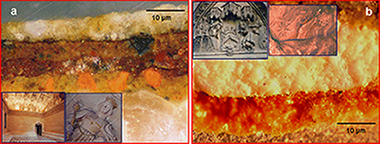
This work describes the use of a new dedicated laboratory-made micro X-ray diffraction system for detecting the phases present in cross-sections of artworks. As an example, the phases present in samples from gilding ceramics and stone sculptures from the heritage of Seville (Spain) were successfully detected using this new system, which takes advantage of various devices developed for synchrotron radiation, and is complemented by the information provided by other techniques.
Julio, 2009 | DOI: 10.1007/s00216-009-2836-3
Sonication induced redox reactions of the Ojén (Andalucía, Spain) vermiculite
Poyato, J; Perez-Rodriguez, JL; Ramirez-Valle, V; Lerf, A; Wagner, FEUltrasonics Sonochemistry, 16 (2009) 570-576
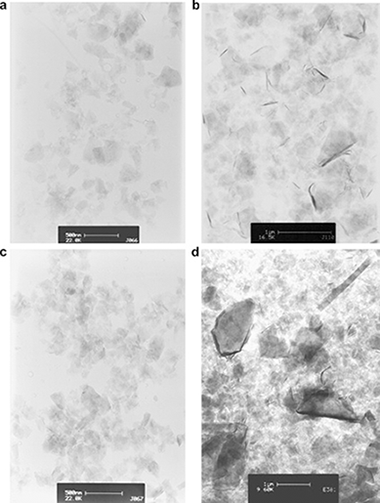
Sonication in a 1:1 mixture (volume ratio) of water and concentrated H2O2 (30%) is a soft method for particle size reduction of phyllosilicate minerals like vermiculites. Repeated sonication causes a particle size reduction to about 70 nm for the Santa Olalla and to 45 nm for the Ojén-vermiculite. In this context the question arises whether the strong oxidising effect of the hydrogen peroxide affects the oxidation state of the iron in the vermiculites. Therefore, the Fe3+/Fetotal ratio before and after sonication was determined by means of Mössbauer spectroscopy. Whereas this ratio was found to remain almost constant in the Santa Olalla vermiculite, it increased from 0.79 to 0.85 in case of the Ojén sample. In the latter case, the oxidation is accompanied by a decrease of the layer charge.
Surprisingly, sonication in pure water leads to a decrease of the Fe3+/Fetotal ratio in the case of the Ojén-vermiculite, i.e., to an increase of the Fe2+ fraction to roughly twice the value before sonication. Again the Fe3+/Fetotal ratio of the Santa Olalla vermiculite remains unchanged. The surface area SBET of the reduced Ojén-vermiculite amounts to 50 m2/g, which is close to the value obtained in the presence of hydrogen peroxide. The results presented should be taken as a warning that particle size reduction by sonication may be accompanied by a change of the redox state and the layer charge of the material.
Abril, 2009 | DOI: 10.1016/j.ultsonch.2008.12.009
Study of ground and unground leached vermiculite
Maqueda, C; Perez-Rodriguez, JL; Subrt, J; Murafa, NApplied Clay Science, 44 (2009) 178-184
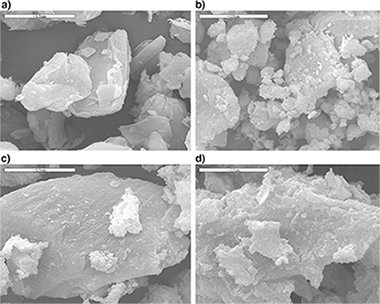
Grinding of clays modifies their surfaces and can significantly affect their leaching behaviour. The acid reaction of vermiculite from Santa Olalla (Huelva, Spain) with HCl at various concentrations was affected by grinding and acid concentration. The acid leaching of ground vermiculite for 3 min with 1 M HCl solution at 80 °C for 24 h removed MgO and Al2O3 almost completely, leaving a residue containing SiO2 and Fe2O3. X-ray diffraction analysis showed the presence of akaganeite (β-FeOOH) and an amorphous phase (silica). Porosity studies showed a very high specific surface area for ground samples compared with unground vermiculite samples, attributed to the presence of iron in the residue coming from structural iron. High resolution transmission electron microscopy (HRTEM) confirmed the presence of iron oxyhydroxides embedded in the silica material. The particle morphology of the iron oxides corresponded well to akaganeite microcrystals precipitated from solution. The leached vermiculite residue also contained Cl− and a small amount of Ti4+, which were accumulated into the akaganeite microcrystals.
Abril, 2009 | DOI: 10.1016/j.clay.2009.01.019
Comparison between micro-Raman and micro-FTIR spectroscopy techniques for the characterization of pigments from Southern Spain Cultural Heritage
Franquelo, ML; Duran, A; Herrera, LK; de Haro, MCJ; Perez-Rodriguez, JLJournal of Molecular Structure, 924-926 (2009) 404-412

An extensive overview of the complementary use of micro-FTIR and micro-Raman spectroscopy in the Cultural Heritage studies is described in this work.
The samples have been prepared using the cross-section technique. This technique allows the examination of a large portion of a single paint layer in its original condition. A variety of pigments from samples belonging principally to the Cultural Heritage of Southern Spain were characterized by micro-Raman spectroscopy using visible excitation sources and micro-FTIR spectroscopy. The pigments studied comprise blue (azurite, ultramarine blue, Prussian blue), red (vermilion, haematite, red ochre, red lead, etc.), ochre and yellow (goethite, orpiment, realgar, etc.), green (malachite, copper resinate), and white (calcite, gypsum, white lead, titanium white, barite, lithopone) pigments, among others. An orientation is given for their appropriate and unequivocal characterization. Characterization by micro-FTIR and micro-Raman presents difficulties with some pigments. In these cases, analysis by EDX solves most of these doubts. The combined use of both spectroscopic techniques, together with SEM–EDX microanalysis, provides one of the most useful methods in the characterization (and possible dating) of materials used in Cultural Heritage.
Abril, 2009 | DOI: 10.1016/j.molstruc.2008.11.041
Materiales Nanoestructurados y Microestructura - Reactividad de Sólidos
Properties of Ti(C,N) cermets synthesized by mechanically induced self-sustaining reaction
Cordoba, JM; Sanchez-Lopez, JC; Aviles, MA; Alcala, MD; Gotor, FJJournal of the European Ceramic Society, 29 (2012) 1173-1182
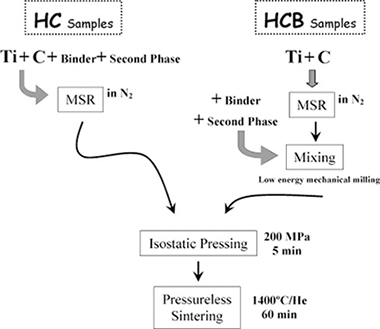
The properties of TiCxN1−x/(Ni or Co) cermets sintered by a pressureless method from powder mixtures, and obtained for the first time by a mechanically induced self-sustaining reaction process (MSR), were studied. The hardness, toughness, friction and wear coefficients, and oxidation resistance were determined. It was shown that cermets obtained from powdered materials synthesized in one single MSR step possessed improved mechanical properties, similar to those obtained in cermets with more complex bulk compositions. Higher wear resistances were observed in cermets whose hard phase was richer in carbon. The oxidation resistance of the cermets depended primarily on the binder composition. This resistance was better for those cermets with cobalt as the binder. Superior oxidation resistance was displayed when small amounts of W or Mo were incorporated into the binder.
Abril, 2009 | DOI: 10.1016/j.jeurceramsoc.2008.08.019
Nanotecnología en Superficies y Plasma
Study by grazing incident diffraction and surface spectroscopy of amalgams from ancient mirrors
Herrera, LK; Duran, A; Franquelo, ML; Gonzalez-Elipe, AR; Espinos, JP; Rubio-Zuazo, J; Castro, GR; Justo, A; Perez-Rodriguez, JLCentral European Journal of Chemistry, 7 (2009) 47-53
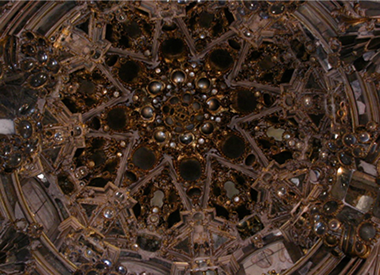
Characterization of four amalgam surfaces, with different alteration degrees from Andalusia historical mirrors, has been carried out by grazing-incidence X-ray diffraction (GIXRD), and other spectroscopic techniques (SEM/EDX, XPS, and REELS). The combination of all these techniques allows determining the corrosion state of the amalgams. The results show that the amalgams are composed in all cases of a binary alloy of tin and mercury. As mercury has high vapour pressure at RT, it slowly segregates and eventually evaporates, it leaves finely divided particles of tin that easily can be oxidize, forming tin monoxide (SnO) and tin dioxide (SnO2). In one of the samples, most of the amalgam remains unoxidized, since Hg0.1Sn0.9 and metallic Sn phases are the major components; in two other samples, Hg0.1Sn0.9 and Sn phases are not detected while SnO2 and SnO phases appear. Finally, in the last studied sample, only SnO2 phase is detected. The surface analyses of these samples by XPS show that, for most of them an unique chemical species (Sn4+) is found.
Marzo, 2009 | DOI: 10.2478/s11532-008-0089-1
Materiales Avanzados
Effect of the grinding mechanical treatment on the pyrophilite textural properties
Sanchez-Soto, PJBoletín de la Sociedad Española de Cerámica y Vidrio, 48 (2009) 59-68
Materiales Avanzados
Application of Geographic Information Systems (GIS) in the search for and characterization of raw materials of interest in ceramics and glass
Garzon, E; Garcia, IG; Ruiz-Conde, A; Sanchez-Soto, PJBoletín de la Sociedad Española de Cerámica y Vidrio, 48 (2009) 39-44
General Quantum-Mechanical Study on the Hydrolysis Equilibria for a Tetravalent Aquaion: The Extreme Case of the Po(IV) in Water
Ayala, R; Martinez, JM; Pappalardo, RR; Paez, AM; Marcos, ESJournal of Physical Chemistry B, 113 (2009) 487-496

A systematic study of the different hydrolyzed species derived from the hydrated Po(IV) in water, [Po(H2O)n(OH)m](4−m) for 1 m 4, and 4 m + n 9, has been carried out by means of quantum mechanical computations. The effects of outer solvation shells have been included using a polarizable continuum dielectric model. For a fixed number of hydroxyl groups, the preferred hydration number for the Po(IV) can be determined in terms of Gibbs energy. It is shown that the hydration number (n) systematically decreases with the increase in the number of hydroxyl groups (m) in such a way the total coordination number (n + m) becomes smaller, being 9 in the aquocomplex and 4 in the neutral hydroxo-complex. Free energies for the hydrolysis processes involving Po(IV) complexes and a different number of hydroxyl groups have been computed, revealing the strong tendency toward hydrolysis exhibited by these complexes. The predominant species of Po(IV) in aqueous solutions are ruled by a dynamical equilibrium involving aggregates containing in the first coordination shell OH− groups and water molecules. Although there is not experimental information to check the theoretical predictions, theoretical computations in solution seem to suggest that the most likely clusters are [Po(H2O)5(OH)2]2+ and [Po(H2O)4(OH)2]2+. The geometry of the different clusters is ruled by the trend of hydroxyl groups to be mutually orthogonal and to promote a strong perturbation of the water molecule in trans-position by lengthening the Po−H2O distances and tilting the corresponding bond angle. A general thermodynamic cycle is defined to compute the Gibbs free energy associated to the formation of the different hydrolyzed forms in solution. From it, the estimates of pKa values associated to the different protolytic equilibria are provided and discussed. Comparison of the relative values of pKa along a hydrolysis series with the experimental values for other tetravalent cations supports its consistency.
Enero, 2009 | DOI: 10.1021/jp804957s
2008
2008
Characterization of iron oxide-based pigments by synchrotron-based micro X-ray diffraction
Herrera, LK; Cotte, M; de Haro, MCJ; Duran, A; Justo, A; Perez-Rodriguez, JLApplied Clay Science, 42 (2008) 57-62
The characterization of iron in microsamples by conventional X-ray diffraction is difficult due to its low concentration in thin layers and its low reflecting power relative to other phases. Synchrotron radiation can provide unique information because of high intensity, sample penetration, small beam diameter and fast data collection. In this study, micro X-ray diffraction (mu-XRD) data were obtained of two samples taken from wall paintings at San Agustin's Church in Cordoba. Crystalline iron phases such as goethite, lepidocrocite and hematite in the cross-section of the painting thin layers were identified. with a good spatial resolution. Conventional XRD only detected hydrocerussite and cerussite rather than the full range of iron phases found in the mu-XRD experiments.
Diciembre, 2008 | DOI: 10.1016/j.clay.2008.01.021
Reactividad de Sólidos
Kissinger kinetic analysis of data obtained under different heating schedules
Sanchez-Jimenez, PE; Criado, JM; Perez-Maqueda, LAJournal of Thermal Analysis and Calorimetry, 94 (2008) 427-432
The dynamic heating rate method developed by TA Instruments (Hi-ResTM) is a kind of sample controlled thermal analysis in which a linear relationship between the logarithm of the heating rate and the rate of mass change is imposed. It is shown in this paper that the reacted fraction at the maximum reaction rate strongly depends on the parameters selected for the Hi-Res heating algorithm, what invalidates the use of the Kissinger method for analysing Hi-Res data unless that the reaction fits a first order kinetic law. Only in this latter case, it has been demonstrated that it is not required that a constant value of the reacted fraction at the maximum reaction rate is fulfilled for determining the activation energy from the Kissinger method. In such a case the Kissinger plot gives the real activation energy, independently of both the heating schedule used and the value of the reacted fraction, alpha(m), at the maximum.
Noviembre, 2008 | DOI: 10.1007/s10973-008-9200-2
Reactividad de Sólidos
New production of TiCxN1-x-based cermets by one step mechanically induced self-sustaining reaction: Powder synthesis and pressureless sintering
Cordoba, JM; Alcala, MD; Aviles, MA; Sayagues, MJ; Gotor, FJJournal of The European Ceramic Society, 28 (2008) 2085-2098
TiCxN1-x-based powdered cermets were synthesized by a one step mechanically induced self-sustaining reaction (MSR) process from mixtures of elemental powders, and subsequently sintered by a pressureless method. The composition and microstructure of the ceramic and binder phases before and after the sintering process were studied by X-ray diffraction, scanning and transmission electron microscopy, and electron diffraction. The powdered cermets showed excellent binder dispersion and a nanometer character for the ceramic and binder particles. The TiCxN1-x stoichiometry was consistently richer in carbon than expected from the raw powder composition. An important amount of titanium was present in the binder after MSR synthesis, and intermetallic Ti-Ni or Ti-Co phases were obtained in some cases. After sintering, the binder phase was always constituted by intermetallic compounds. The morphology of the ceramic phase in the final bodies was dependent on the C/N ratio of TiCxN1-x and its growth primarily occurred through a coalescence process. The presence of titanium in the binder reduced hard particle solubility in the melted binder and its grain growth.
Octubre, 2008 | DOI: 10.1016/j.jeurceramsoc.2008.02.007
Reactividad de Sólidos
Thermal characterization of montmorillonite clays saturated with various cations
Balek, V; Benes, M; Subrt, J; Perez-Rodriguez, JL; Sanchez-Jimenez, PE; Perez-Maqueda, LA; Pascual-Cosp, JJournal of Thermal Analysis and Calorimetry, 92 (2008) 191-197
Emanation thermal analysis (ETA), thermogravimetry and high temperature XRD were used to characterize the thermal behavior during dehydration of natural Na montmorillonite (Upton Wyoming, USA) and homoionic montmorillonite (MMT) samples saturated with different cations, i.e. Li+, Cs+, NH4+, Mg2+ and Al3+. ETA results characterized radon mobility and microstructure changes that accompanied the mass loss of the samples due to dehydration on heating in air. A collapse of interlayer space between the silicate sheets after water release from the MMT samples was characterized by a decrease of the radon release rate, Delta E. Decreases in c-axis basal spacing (d(001)) values determined from XRD patterns for the different montmorillonite samples follow the sequence:
Mg-MMT>AI-MMT>Li-MMT>Na-MMT>NH4-MMT>Cs-MMT
The decrease of the radon release rate (Delta E) determined by ETA that characterized microstructure changes due to collapse of interlayer space corresponded well to differences in the c-axis basal spacing (Delta d(001)) values determined from the XRD patterns before and after samples dehydration.
Septiembre, 2008 | DOI: 10.1007/s10973-007-8761-9
Reactividad de Sólidos
A simple and precise linear integral method for isoconversional data
Ortega, A.Thermochimica Acta, 474 (2008) 81-86
A simple and precise linear integral method to evaluate the activation energy dependence oil the extent of conversion has been proposed. The method leads to consistent results with those from differential and integral non-linear procedure (Vyazovkin method). Moreover, the new procedure yields the pre-exponential factor and the kinetic model. The method was evaluated from isothermal, non-isothermal and non-linear non-isothermal data (CRTA).
Agosto, 2008 | DOI: 10.1016/j.tca.2008.05.003
Reactividad de Sólidos
Nitriding study of titanium silicide intermetallics obtained by mechanical alloying
Cordoba, J. M.; Alcala, M. D.; Sayagues, M. J.; Aviles, M. A.; Real, C.; Gotor, F. J.Intermetallics, 16 (2008) 948-954
Titanium and silicon powder blends were ball-milled under an inert atmosphere and subsequently annealed in a nitrogen atmosphere. Ti62.5Si37.5, Ti55.6Si44.4, and Ti50Si50 mixtures suffered a mechanically induced self-propagating reaction during milling. The products of the combustion were Ti5Si3 for the Ti62.5Si37.5 mixture and a combination of intermetallic phases for the Ti55.6Si44.4 and Ti50Si50 mixtures. The Ti33.3Si66.7 blend did not show an MSR process, but prolonged milling allowed the formation of a mixture of stable C54–TiSi2 and metastable C49–TiSi2 by a diffusion reaction. The nitriding study showed a different behaviour for C54–TiSi2 and Ti5Si3. C54–TiSi2 nitriding took place in a two-step process: the first corresponded to the formation of TiN and Si and the second to the silicon nitriding leading to the formation of α- and β-Si3N4. However, silicon and titanium nitriding primarily occurred simultaneously during the annealing of Ti5Si3, and the final product was a mixture of TiN and α-Si3N4.
Agosto, 2008 | DOI: 10.1016/j.intermet.2008.04.009
Reactividad de Sólidos
Polymorphic transformation from body-centered to face-centered cubic vanadium metal during mechanosynthesis of nanostructured vanadium nitride determined by extended x-ray absorption fine structure spectroscopy
Lopez-Flores, V; Roldan, MA; Real, C; Paez, AM; Castro, GRJournal of Applied Physics, 104 (2008) 023519
The pathway for vanadium nitride (VN) formation obtained by milling treatment has been traced out. At the initial stages of the process, the reactant, vanadium metal, showing body-centered cubic (bcc) structure, becomes highly distorted. Simultaneously, the formation of a small nucleus of the product, VN, takes place. X-ray absorption spectroscopy (XAS) has allowed the quantification of the distortion degree as well as the detection of the VN nucleus in the early stages of their formation, while other standard structural characterization techniques are unable to detect such phenomena. For increasing milling times, apart from the expected increase in the size of the VN nucleus, a polymorphic transformation from bcc to fcc vanadium metal has been recorded. This phase might play a key role in the overall synthesis process and could be a reaction intermediate in other solid state processes involving V metal. The sensitivity of XAS to noncrystalline domains and to highly distorted environments, as well as the use of high resolution x-ray diffraction, has provided the relevant information to understand the whole reaction process.
Julio, 2008 | DOI: 10.1063/1.2958324
Materiales Avanzados
Microanalysis of Gothic mural paintings (15th century) in Slovenia: Investigation of the technique used by the Masters
Kriznar, A; Ruiz-Conde, A; Sanchez-Soto, PJX-Ray Soectrometry, 37 (2008) 360-369
The present article focuses on an interdisciplinary research on cultural heritage concerning the microanalysis of Gothic mural paintings made during the 15th century in Slovenia. The samples were chosen from the churches of Crngrob (1453), Mirna (1463-1465), Mevkuz (1465) and Mate (1467), attributed to two of the most important Gothic painters of that period of time: Master Bolfgang and Master of Mate. The chemical and phase composition of all the mortars, number of their layers and selection of the pigments were of interest. For this purpose, fragments of mural paintings were studied with several instrumental techniques: optical microscopy (OM), SEM-EDX, x-ray powder diffraction (XRD) and Fourier transform infrared spectroscopy (FTIR). In early artworks, the mortar was made using a mixture of lime and more or less clean sand. Later, crushed lime-rock or marble instead of sand was added to lime. The pigments identified by EDX microanalysis of cross sections previously studied by OM, are of earth or mineral origin. Therefore, they are durable in fresco and lime techniques: lime white, yellow and red natural or burned ochres, green earth and azurite. The results confirmed the high technical quality of both painters and the relationships between the teacher and the disciple. Master Bolfgang and Master of Mate combine three basic techniques of mural painting: fresco, secco and lime techniques. This kind of investigation and methodology allow us to know better the Central European Art and the Slovenian Art in the Adriatic zone, as well as the general map of European Art in the 14-15th centuries.
Julio, 2008 | DOI: 10.1002/xrs.1050
Reactividad de Sólidos
Crystallization behavior of (GeS2)(0.1)(Sb2S3)(0.9) glass
Svadlak, D; Zmrhalova, Z; Pustkova, P; Malek, J; Perez-Maqueda, LA; Criado, JMJournal of Non-Crystalline Solids, 354 (2008) 3354-3361
The crystal growth kinetics of antimony trisulfide in (GeS2)(0.1)(Sb2S3)(0.9) glass has been studied by microscopy and DSC. The linear crystal growth kinetics has been confirmed in the temperature range 492 <= T <= 515 K (E-G = 405 +/- 7 kJ mol(-1)). The applicability of standard growth models has been assessed. From the crystal growth rate corrected for viscosity plotted as a function of undercooling it has been found that the most probable mechanism is interface controlled 2D nucleated growth. The non-isothermal DSC data, corresponding to the bulk sample, can be described by the Johnson-Mehl-Avrami equation.equation.
Junio, 2008 | DOI: 10.1016/j.jnoncrysol.2008.01.029
Degradation of gold and false golds used as gildings in the cultural heritage of Andalusia, Spain
Duran, A; Perez-Rodriguez, JL; de Haro, MCJ; Herrera, LKJournal of Cultural Heritage, 9 (2008) 184-188
The causes and degree of alteration of metals such as gold, tin, silver and bronze powders from ornamental implements of Andalusia Cultural Heritage have been studied. The unaltered gold is lost due to the alteration of the material used to adhere the leaf gold on the ceramic. Tin is transformed to romarchite and is lost due to a similar alteration as with the gold leaf adhesive. Silver is altered to Ag2S due to environmental contamination. Part of the bronze powders and silver used in Huercal-Overa altarpiece are altered to atacamite and AgCl, respectively, due to an unsuitable cleaning process.
Abril, 2008 | DOI: 10.1016/j.culher.2007.10.005
Reactividad de Sólidos
Critical study of the isoconversional methods of kinetic analysis
Criado, J. M.; Sanchez-Jimenez, P. E.; Perez-Maqueda, L. A.Journal of Thermal Analysis and Calorimetry, 92 (2008) 199-203
A critical study of the use of isoconversional methods for the kinetic analysis of non-isothermal data corresponding to processes with either a real or an apparent variation of the activation energy, E, with the reacted fraction, alpha, has been carried out using for the first time simulated curves. It has been shown that the activation energies obtained from model-free methods are independent of the heating rate. However, the activation energy shows a very strong dependence of the range of heating rates used for simulating the curves if the apparent change of E with alpha is caused by overlapping processes with different individual activation energies. This criterion perhaps could be used for determining if a real dependence between E and alpha is really occurring.
Abril, 2008 | DOI: 10.1007/s10973-007-8763-7
Reactividad de Sólidos
Transport properties and microstructure changes of talc characterized by emanation thermal analysis
Perez-Maqueda, LA; Balek, V; Poyato, J; Subrt, J; Benes, M; Ramirez-Valle, V; Buntseva, IM; Beckman, IN; Perez-Rodriguez, JLJournal of Thermal Analysis and Calorimetry, 92 (2008) 253-258
Thermal behavior of talc samples (from locality Puebla de Lillo, Spain) were characterized by emanation thermal analysis (ETA), DTA and TG. The ETA, based on the measurement of radon release rate from samples, revealed a closing up of surface micro-cracks and annealing of microstructure irregularities of the talc samples on heating in the range 200-500 degrees C.
For ground talc sample a crystallization of non-crystalline phase formed by grinding, into orthorhombic enstatite was characterized as a decrease of radon mobility in the range 785-825 degrees C and by a DTA exothermal effect with the maximum at 830 degrees C. ETA results characterized the microstructure development of the talc samples on heating and served to evaluate their radon mobility and transport properties on heating and cooling. Transport properties of the talc samples were evaluated by using ETA experimental data measured during heating to 600 and 1300 degrees C, respectively, and subsequent cooling to room temperature.
Abril, 2008 | DOI: 10.1007/s10973-007-8819-8
Reactividad de Sólidos
Thermal Behavior of Ground Talc Mineral
Balek, V; Subrt, J; Perez-Maqueda, LA; Benes, M; Bountseva, IM; Beckman, IN; Perez-Rodriguez, JLJournal of Mining and Metallurgy Section B-Metallurgy, 44 (2008) 7-17
Microstructure development and thermal behavior of ground talc mineral samples (from locality Puebla de Lillo,Spain) was characterized by X-ray diffraction, scanning electron microscopy(SEM),surface area measurements differential thermal analysis, thermogravimetry and emanation thermal analysis (ETA). A vibratory mill and grinding time 5 min. was used to prepare the ground talc sample. It was found that grinding caused an increase in the surface area of the natural talc from 3 m(2)g(-1) to 110 m(2) g(-1). A decrease of particle size after sample grinding was observed by SEM. The increase of structure disorder of the ground sample and the crystallite size reduction from 40 to 10 nm were determined from the XRD results. ETA results revealed a closing up of surface micro-cracks and healing of microstructure irregularities on heating in the range 200 - 500 degrees C of both un-ground and ground talc samples. For the ground talc sample a crystallization of non-crystalline phase into orthorhombic enstatite was characterized as by a decrease of radon mobility in the range 785-825 degrees C and by a DTA exothermal effect with the maximum at 830 degrees C. ETA results were used for the assessment of transport properties of the talc samples on heating.
Enero, 2008 | DOI: 10.2298/JMMB0801007B
Reactividad de Sólidos
Carbothermal synthesis of silicon nitride(Si3N4): Kinetics and diffusion mechanism
Ortega, A.; Alcala, M. D.; Real, C.Journmal of Materials Processing Technology, 195 (2008) 224-231
Sample controlled reaction temperature (SCRT) has been used for the first time to study the kinetics of the carbothermal reduction of silica in nitrogen to obtain silicon nitride (Si3N4). It is noteworthy to point out that SCRT method allows both a good control of pressure in the sample surroundings and the use of reaction rates low enough to keep temperature gradients at a negligible level to avoid any heat or mass transfer phenomena. It has been shown that the carbothermal synthesis of silicon nitride is best described by a two-dimensional diffusion kinetic model with an activation energy of about 306 kJ/mol. Effects of experimental parameters on the activation energy has been investigated. By using SCRT it has been possible to obtain ceramic powder with a determined phase composition and a controlled microstructure.
Enero, 2008 | DOI: 10.1016/j.jmatprotec.2007.05.004
Reactividad de Sólidos
Syntesis by reactive grinding of molibdenum iron bimetallic nitride
Roldan, MA; Ortega, A; Palencia, I; Real, CRevista de Metalurgia, 44 (2008) 13-18
The transition metal nitride ternary show similar properties to the binary nitride and some times this behaviour are improved. In the present work, the molybdenum-iron nitride has been prepared by reactive grinding from the two metals under nitrogen atmosphere at a pressure of 11 bar. The characterization of the compound is presented and it is also shown a study of the stability of the nitride under several atmospheres.
Enero, 2008 | DOI:

Nabil Mohamed Amghar
Directores: Luis Allan Pérez Maqueda y Pedro Enrique Sánchez Jiménez Universidad de Sevilla 13 Marzo 2024
Carmen Muñoz Ferreiro
Directores: Ángela Gallardo López, Rosalía Poyato Galán y Jérôme Chevalier Universidad de Sevilla 22 Septiembre 2023
Cristina López Pernia
Directoras: Ángela Gallardo López y Rosalía Poyato Galán Universidad de Sevilla 1 Octubre 2021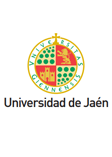
Sergio Martínez Martínez
Directores: Dolores Eliche Quesada (Universidad de Jaén) y Pedro José Sánchez Soto Universidad de Jaén 22 Abril 2021
Beatriz Sarrión Aceytuno
Directores: Luis Allan Pérez Maqueda y José Manuel Valverde Millán Universidad de Sevilla 9 Noviembre 2018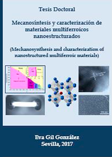
Eva Gil González
Directores: Luis A. Pérez Maqueda y Antonio Perejón Pazo Universidad de Sevilla 6 Octubre 2017
Violeta Moreno Megías
Directores: Pedro José Sánchez Soto y Francisco José García Fernández (US) Universidad de Sevilla 28 Septiembre 2017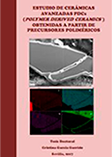
Cristina García Garrido
Directores: Pedro Enrique Sánchez Jiménez y Luis Allan Pérez Maqueda Universidad de Sevilla 3 Julio 2017
Ernesto Chicardi Augusto
Directores: Francisco José Gotor Martínez y José Manuel Córdoba Gallego Universidad de Sevilla 17 Junio 2014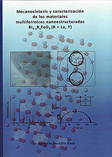
Antonio Perejón Pazo
Directores: Luis A. Pérez Maqueda y Pedro E. Sánchez Jiménez Universidad de Sevilla 26 Noviembre 2012
Mónica Benítez Guerrero
Directores: Dr. José Pascual Cosp, Luis A. Pérez Maqueda Universidad de Málaga 22 Octubre 2012
María Luisa Franquelo Zoffmann
Directores: José Luis Pérez Rodríguez y Adrián Durán Benito Universidad de Sevilla 20 Octubre 2011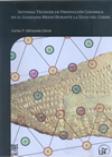
Carlos P. Odriozola Lloret
Directores: Victor Hurtado Pérez y Angel Justo Erbez Universidad de Sevilla 17 Marzo 2010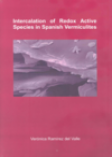
Verónica Ramírez del Valle
Directores: José Luis Pérez Rodríguez y Anton Lerf Universidad de Sevilla 9 Junio 2009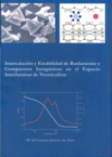
María del Carmen Jiménez de Haro
Director: José Luis Pérez Rodríguez Universidad de Sevilla 4 Mayo 2009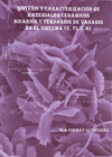
Manuel Alberto Roldán Gutiérrez
Directores: Concepción Real Pérez y Andrés Ortega Romero Universidad de Sevilla 2 Abril 2009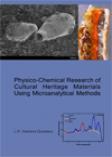
Liz Karen Herrera Quintero
Directores: Angel Justo Erbez y José Luis Pérez Rodríguez Universidad de Sevilla 18 Marzo 2009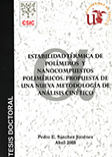
Pedro E. Sánchez Jiménez
Director: Luis Allan Pérez Maqueda Universidad de Sevilla 29 Mayo 2008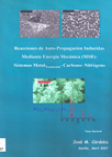
José Manuel Córdoba Gallego
Directores: Francisco José Gotor Martínez y María Dolores Alcalá Universidad de Sevilla 11 Abril 2007
Adrián Durán Benito
Directores: Angel Justo Erbez y José Luis Pérez Rodríguez Universidad de Sevilla 31 Marzo 2006icms












